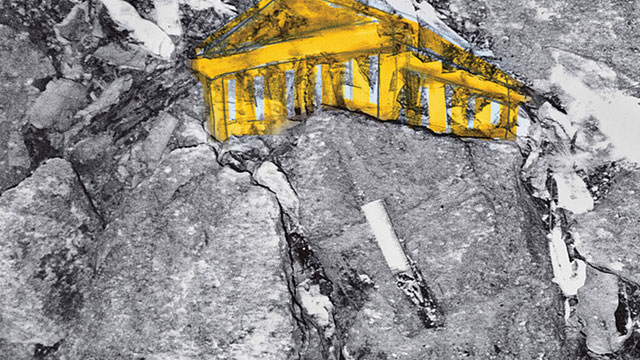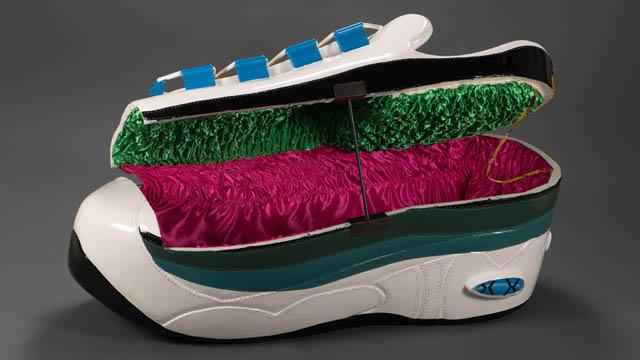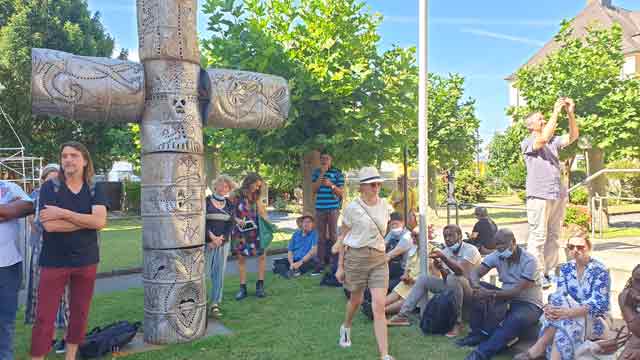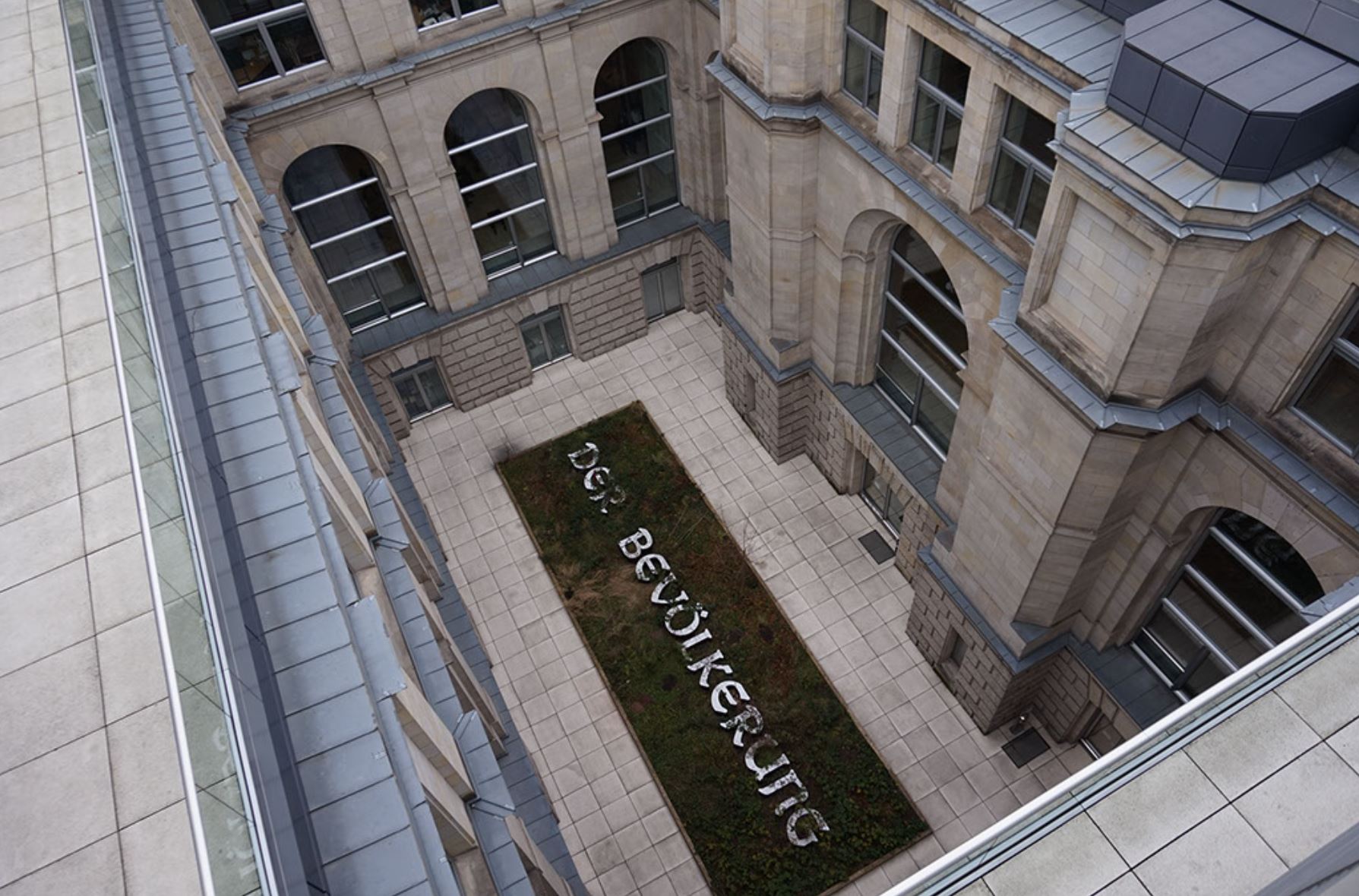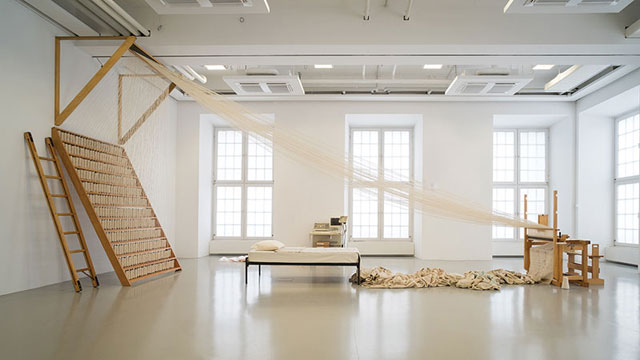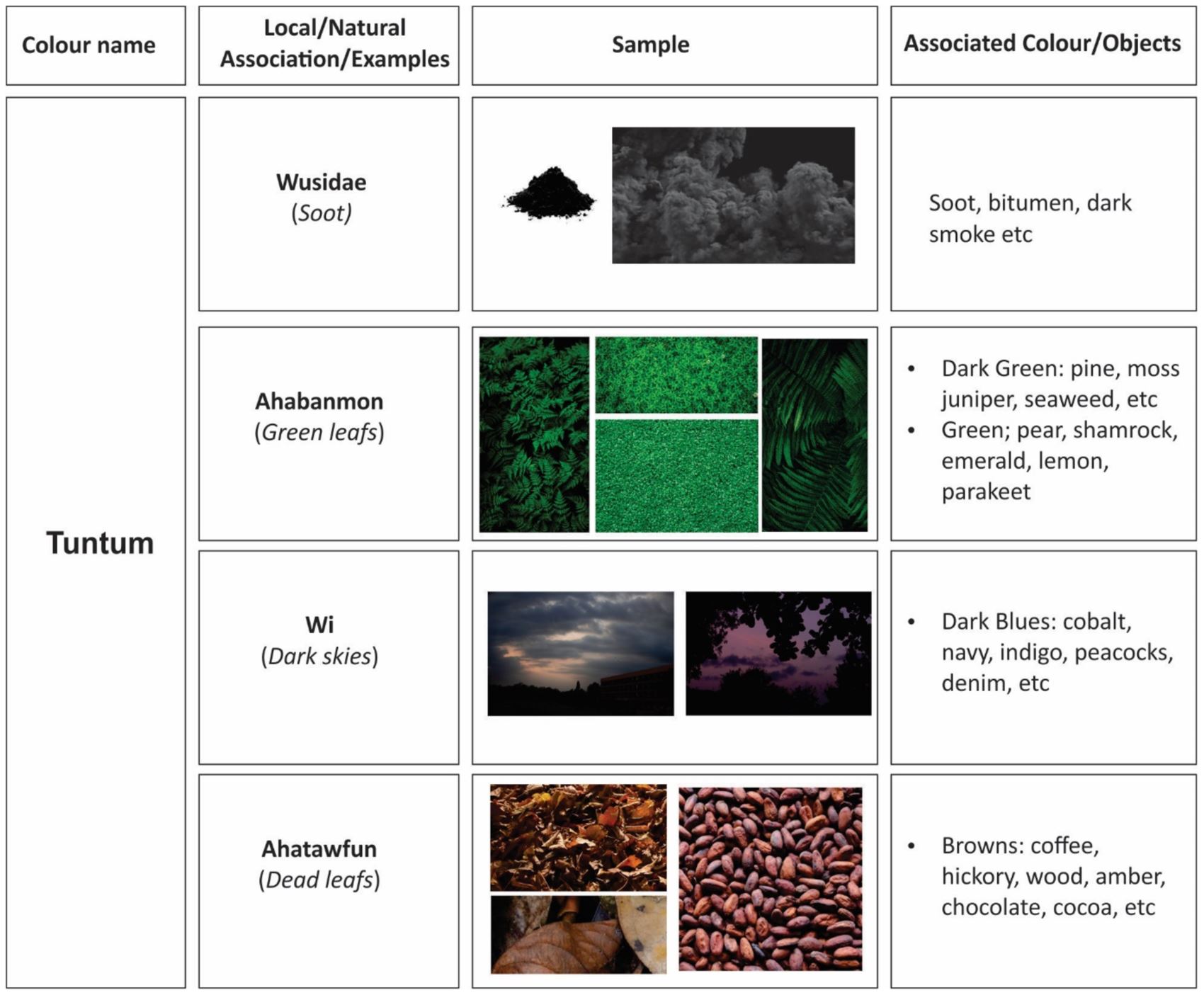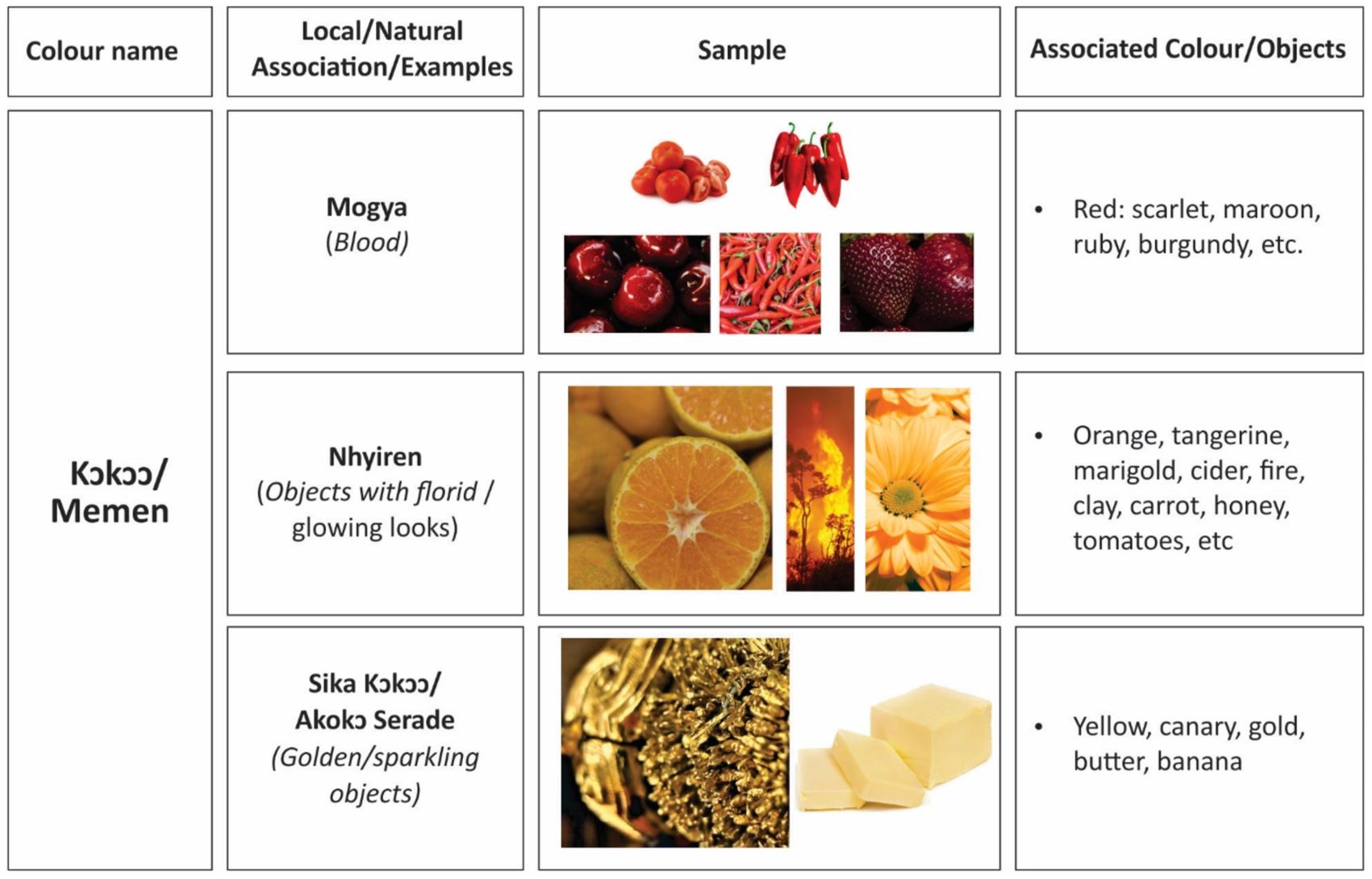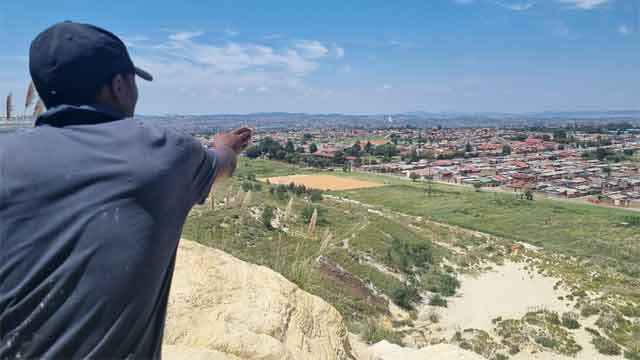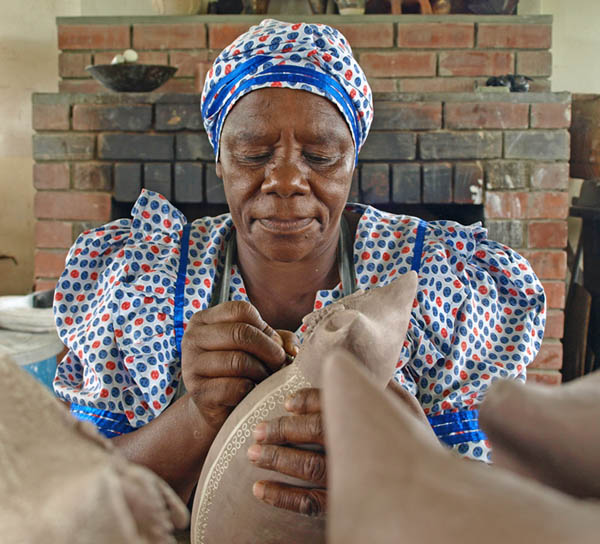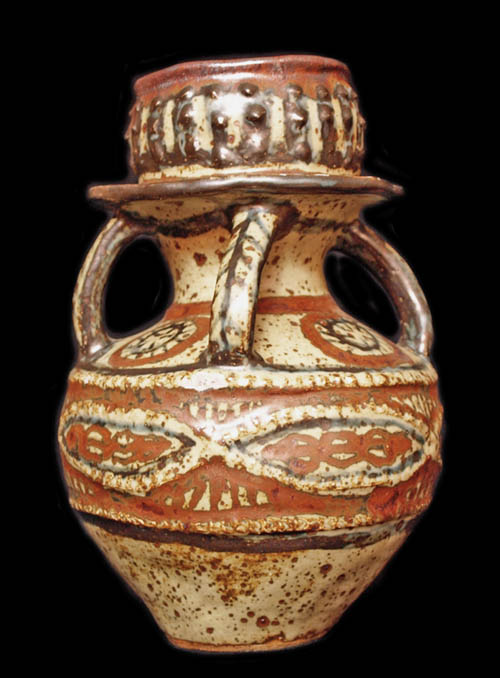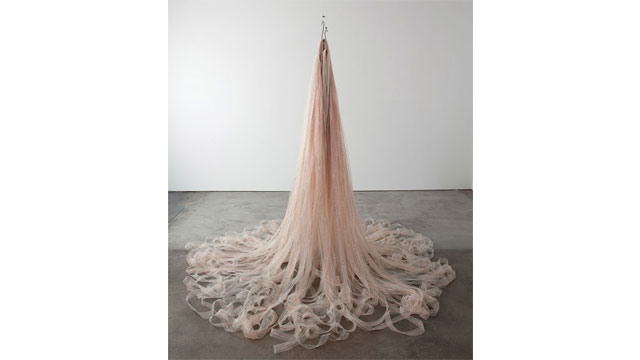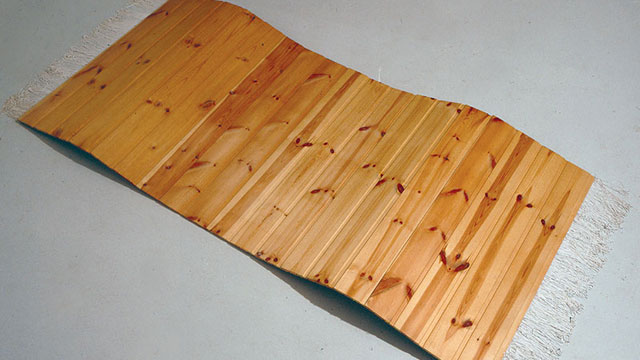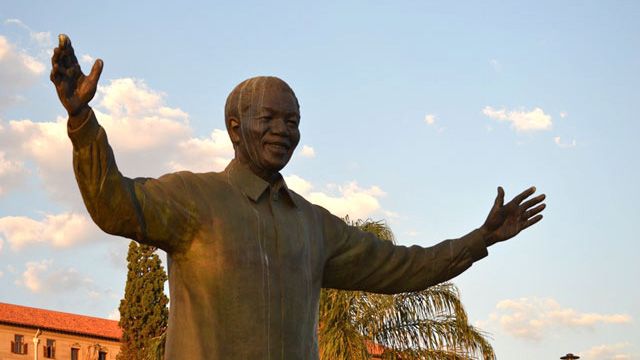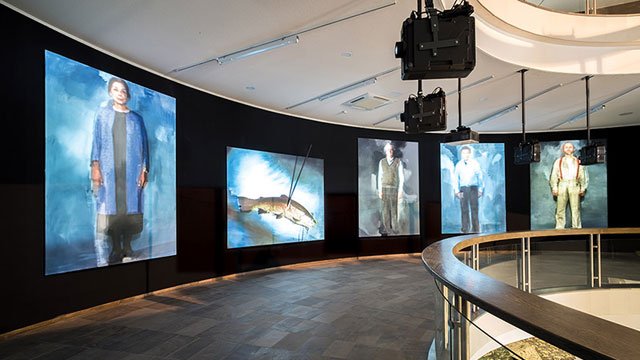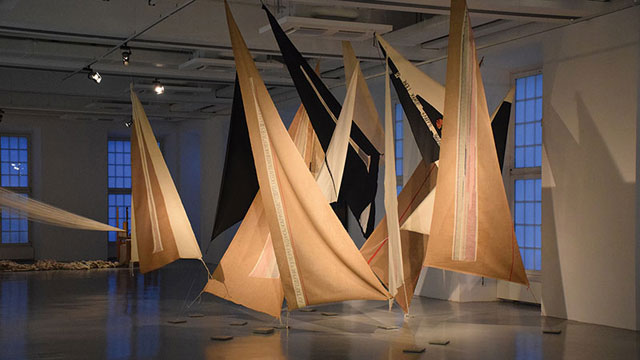Dear user,
This section of our website forms the heart of the EVC project. Here you find a collection of images of objects from different ‘visual cultures’. Our contributors selected and interpreted them in their respective contexts believing that these objects are particularly important for intercultural understanding across boundaries. Each time a user opens this page, the order in which the objects appear changes. In this way we hope to avoid a hierarchical understanding of the collected objects as their entries continue to be accessed in the long run. The constant changing face of the page also reflects the continuous expansion of the collection. As there are already over more than a hundred entries, users may want to form an overview, or to navigate through the growing collection according to their interests. For this purpose, we offer the following search options:

Filter: This enables you to search for objects according to time, place, keywords, etc. / Free title search: If you know the title of an object, you can find it in the free search field. / Lab: In the lab section, objects from the database are grouped under overarching themes. This is an ongoing project and about to be expanded extensively.
Enjoy exploring our database!
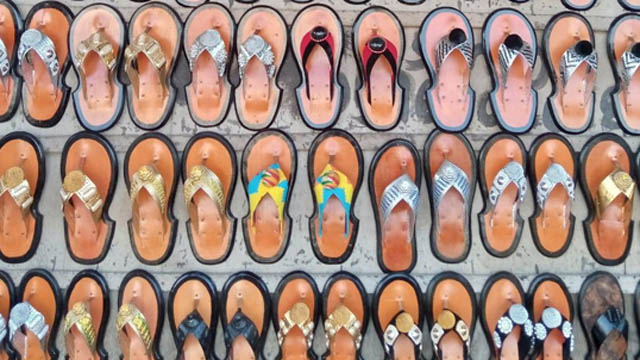
-
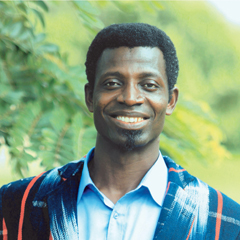 Osuanyi Quaicoo Essel
Osuanyi Quaicoo EsselFashion accessories help in decorating the human body and act as an essential influencer of accessories production and commodification. By decorating the human bodies, fashion accessories heighten the aesthetic aura around its wearers based on the precepts of the standard of beauty held by the society that created such objects. The production and commodification of fashion accessories are universal to different cultures across the globe. It happens in different parts of the world, including Africa. On the continent of Africa, different societies have demonstrated their creative prowess in fashioning accessories for the decoration of human bodies. For example, the Asantes of Ghana are known for their decorative gold weights, pendants, and other jewellery products that served as regalia (Rattary, 1927; Busia, 1951; McLord, 1981; Ross, 1982, Antubam, 1963; Kyeremanten, 1965; Fosu, 1994) for utilitarian and communicative purposes.
The use of artistic fashion accessories such as dresses, fabrics, footwear, headwear, brooches, earrings, belts, bangles, anklets, amongst others, have always had a strong political, social and cultural role in safeguarding the histories, values, and identities of different cultures. It implies that these fashion objects give hints that help to unravel particular histories surrounding their origin, material, tools, semiotics, and creators in society. Of the accessories that served as regalia, one of the commonest, yet essential and inevitable fashion objects for Asante kings/chiefs, and by extension Akan and even non-Akan chiefdoms is ahenema (native sandals). The usage of ahenema goes beyond Ghana. Some kings/chiefs in neighbouring countries such as Togo and Cote D'ivoire also use it as essential regalia for traditional functions. There have been instances where ahenema has seemingly been used as panoplied regalia and an authoritative object of the power of a king/chief. Ghanaweb (2007, August 18) reports of the Asantehene, Otumfuo Osei Tutu II’s destoolment of the Asomfohene, Nana Osei Kwabena, for flouting the chieftaincy orders of the Asante Kingdom. The destoolment process included the removal of his ahenema sandals to signify that the said chief has been destooled under Asante chieftaincy tradition. There were also reports that the Asantehene, Otumfuo Osei Tutu II, in December 2010 destooled the Queen of Atwima, Obaapanin Asamoah Duah II, and two sub-chiefs for taking a bribe (VibeGhana.com, 2010). As part of the destoolment rituals, the ahenema sandals of all the three culprits, which symbolised their office as traditional rulers, were removed from their feet. These instances of destoolment with the ahenema seemingly playing a symbolic role need further investigation. This is because the instances raise questions of the sociocultural relevance of ahenema regalia in Asante chieftaincy culture. Besides, the historical twist to the origin of this fashion object and regalia needs academic attention. This study, therefore, traces the historical origin of ahenema, and investigates its sociocultural relevance in Asante chieftaincy cultural milieu.
The theoretical perspectives that support this study is the object-based theory propounded by Lou Taylor. The study is situated in the object-based theory propounded by Lou Taylor (2002) and Riello’s (2011) methodological model of material culture of fashion. The object-based theory is concerned with materiality which has to do with description and documentation to bring out and classify garments or objects for historical purposes. It also focuses on the contextual attributes of the exhibits, oral history, company history, and design philosophy of fashion production (Taylor, 2002; Skou & Melchior, 2008). Riello’s (2011) methodological model of material culture of fashion which he borrowed from art history, anthropology, and archeology also makes fashion art objects central to historical studies and narratives be it socio-cultural, economic, and other practices of a particular period (Essel, 2017). Informed by object-based theory and material culture of fashion, the study considered the contextual attributes of ahenema, its oral history, design philosophy, description and documentation to bring out its history and sociocultural relevance amongst the Asantes and by extension, the Akan chieftaincy. This theoretical stance took ahenema fashion art object as central to historical studies and narratives in a sociocultural context.
Historical case studies constituted the research designs for the study. The historical case study helps in analyzing cases from the distant past to the present, using eclectic data sources, in generating both idiographic and nomothetic knowledge (Widdersheim, 2018). The use of the historical case study was informed by the fact that although case studies and histories can overlap, the case study’s unique strength lies in its ability to deal with a variety of evidence including documents, artifacts, interviews, and direct observations, as well as participant-observation beyond what might be available in a conventional historical study (Yin, 2018). A total of nine (9) respondents were purposively sampled for the study. They consisted of four (4) ahenema designers and producers with active experience ranging from 20 to 35 years on the job, two (2) chiefs and three (3) elders from chief palaces in Asanteland. Unstructured interview and focus group discussion constituted the method of data collection. Permission was sought from the respondents for face-to-face interview with the agreement to audio-tape for transcription purposes. Historical and narrative analysis tools were the data analysis tools used. With the historical research tool, the study used the heuristic of considering the source and the context of the data and corroborate it to ensure the trustworthiness and authenticity of the data gathered. Historical research concerns itself with identification, analysis, and interpretation of old texts (Špiláčková, 2012), eyewitness accounts, and other oral history and interviews. Using the narrative structure, data analysis was done to accentuate consistency, suppress contradiction, and produce rationally sound interpretation (Holloway & Jefferson, 2000) without truncating the content of the told stories about the lived experiences of the respondents. The historical narration was supported with photographs of ahenema taken with the permission of the creators. The transcribed and analysed data was shared with the respondents for verification purposes. The respondents also provided some pictures and permitted the researcher to use them for academic purposes. To ensure the anonymity and confidentiality of the respondents, pseudonyms were used in place of the original names.
The Akan word ahenema literally means ‘children of kings/chiefs.’ Legend has it that, when it was developed, only kings/chiefs and their families could wear it to show their status as royals. Later, it became permissible for the subjects and all to use. The king/chief belonged to the high class of society because they were the leaders of their flourishing kingdoms and ethnic states respectively. They had creative artists in their courts who produced functional and decorative artworks and fashion accessories used as body adornments. Per the high status of kings/chiefs in the society, the trickle-down theory, where new fashion art usage begins with the top echelon of society and gradually gets to the masses, exemplifies the spread and use of ahenema in Ghanaian society. Ahenema is also called Kyawkyaw. The word Kyawkyaw was derived from the sounds it makes when worn for the usual characteristic majestic walk. Respondent Opanin Kwame explained that:
Ahenema used to be worn by only the chiefs/kings and their families. If you are not a chief … you are not permitted to wear it. When the one who is not a chief is sighted wearing some at a durbar, the elders sent people to remove it from the person’s feet.
Legend has it that, the first ahenema was fashioned out of wood which served as the sole (called aseɛ) while the top (referred to as nsisoɔ or ahenemapɔnkɔ) was made of leather. It developed to a stage where the flat wooden soul was replaced with layers of animal skins, cut out to form the shape of the sandals. The animal skins (for example, okohoma) used as the sole produced the kyawkyaw sound when in use. The sound became the name of the sandals.
Respondent Opanin Antwi and Opanin Kwaku have been in the business of Ahenema production for more than thirty-five years. They make a living from the job, and have trained more than ten 10 and 16 apprentices respectively, some of which have set up their production shops. In a focus group discussion, they revealed that:
There are two basic soles (aseɛ) of ahenema, namely Asansatoɔ and Atenee (Figure 1). Beyond these, producers create new ones which are sometimes suggested by clients. It could be in the shape of animals like crocodiles, lizards, tortoises (Figure 1c) or fish. The soles have symbolic meanings that are usually associated with the animal or objects which influenced its creation. However, it is the top (nsisoɔ) that determines the name of the ahenema.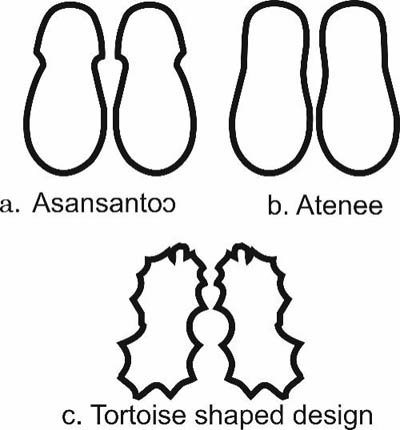
Some of sole pattern designs of ahenema. © Osuanyi Quaicoo Essel
There are different schools of thought on the etymology of ahenema footwear. One legend account traces it to the reign of the fourth Asante king, Otumfuo Osei Kwadwo Okoawia who ruled from 1764 to 1777(‘A Guide to Manhyia Palace Museum’, 2003). This account posits that Asantehema (Queen mothers) had specially made sandals, for they do not walk barefooted in the courtyard of the palace. One of the Asantehema once got injured in the foot while walking without sandals. The wound, according to legend, took long to heal and became a great oath of the Asantehema. Since this account is believed to have occurred during the reign of Otumfuo Osei Kwadwo Okoawia, then, the fourth Asantehema, Nana Konadu Yiadom I (whose tenure began in 1768 – 1809), was the possible beneficiary of the earliest ahenema footwear.
Bodwich’s (1818) narrative accounts of the culture of the Asante people offer some hints on the history of the ahenema footwear. In his description of the regalia of the kings, he pointed out that (p.35) ‘their sandals were of green, red, and delicate white leather …’ In thick description of what the king wore Bodwich said, their royal sandals ‘of a soft white leather, were embossed across the instep band with small gold and silver cases of saphies’ (p.38). Gold pendants and designs of varied symbolism that show the power and wealth of the Asante kings were used to embellish their unique ahenema footwears. Vansina (1982, p.222) offered hints of the period of production and usage of some ahenema. She revealed some of the artefacts including sandals and cast of gold rings had production dates estimated in the range of 1700 to 1900. This confirms the eighteenth century as a possible period ahenema sandals production in Ghana began.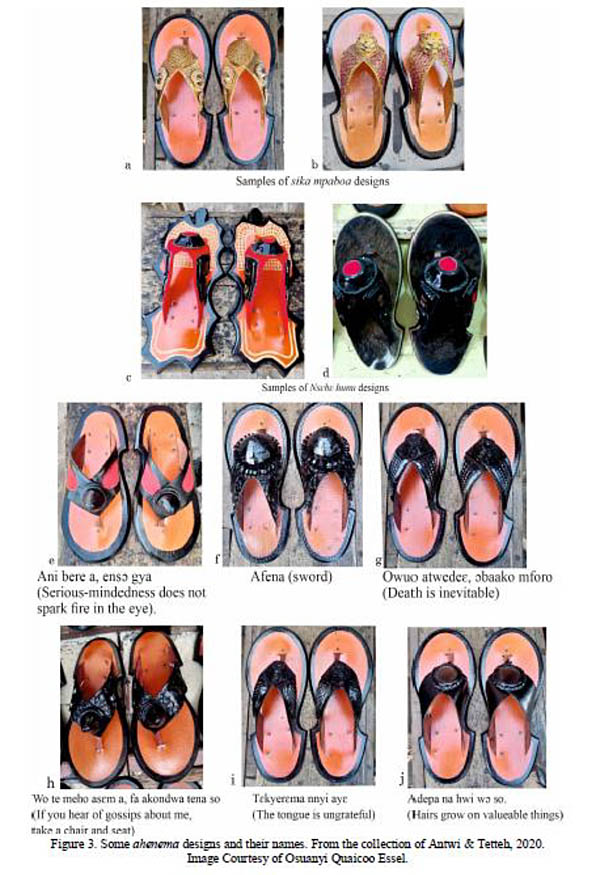
Categories of Ahenema. © Osuanyi Quaicoo Essel
There are categories of ahenema (image above). The categories of ahenema are traditionally informed by the kind of occasion and the purpose for which they are made. There are those used for funerals, durbars and festive occasions (festivals and other merrymaking events), especially, in the customs and traditions of chieftaincy institutions. The red, black and brown coloured ones are usually used for funerals to depict bereavement, sadness and death. In the Akan notion of colours, red, black and brown are associated with decay, death, bereavement and pain (Antubam, 1963; Amenuke et al., 1991), hence, its association with funerals. Those meant for durbar (adwabɔ) are the gold stud sandals (Sika mpaboa), silver and related colours. One of the Akan chiefs commented that:
To complement the wearing of toga style by the chiefdom, they desired to develop footwear to match with it. As a result, they developed ahenema for different occasions. They created ahenema for funerals and durbars. But there are some people who are unaware of the types and, therefore, use them anyhow. This suggests that there are categories of ahenema worn for different occasions but certain factors have caused its improper usage in the traditional cultural milieu. These factors include ignorance of the colour symbolisms as well as the meanings ascribed to the entire design. In one breadth, the users who default the conventional usage in terms of colour schemes and meaning may be doing so for purely aesthetical reasons rather than meaning associated with them.
Amongst the Akans (which form over 70% of Ghana’s population), ahenema is the traditionally sanctioned footwear accessory suitable for traditional gatherings or occasions. Wearing the toga fashion (usually 6- 12 yards of fabric gracefully wrapped on the body) without ahenema is culturally inappropriate in the traditional chieftaincy milieu. Likewise, it is traditionally unethical and unacceptable in Asante customs and traditions for kings or chiefs to wear the toga fashion classic without wearing befitting ahenema. Even for those who are not part of the chiefdom, wearing ahenema that is unsuitable for a particular durbar, funeral and other traditional events of the chiefdom are likely to invite troubles for themselves.
Per the categorisation of ahenema sandals, sika mpaboa (literary translated as ‘golden footwear/sandals) for example, is the highest status-defining type of ahenema footwear amongst the chiefdom. For the chiefdom in the Asanteland, sika mpaboa (Figure 3) is a preserve of the Asante King. No other paramount chief could wear it without his approval. Based on the achievement of chiefs under the rulership of Asantehene, he may honour a chief with sika mpaboa. Such honours remain a great chieftaincy laurel, privilege and meritorious achievement in the Asanteland. Once a chief has bestowed this honour, it implies that that chief has the power to wear sika mpaboa at traditional chieftaincy functions, durbars, or occasions. The sika mpaboa of the Asante king remains distinctive. It may be decorative with cast-gold (Ross, 1982) symbolic animal and geometric figurines that ornament the (top) nsisoɔ of the sandals. Bodwich (1818, p.256) confirms this centuries-old and long-standing tradition of who has the prerogative to wear sika mpaboa (ahenema stud with gold or golden colours). He writes:
The caboceers of Soota [Nsuta], Marmpon [Mampong], Becqua [Bekwai], and Kokofoo [Kokofu], the four large towns built by the Ashantees at the same time with Coomassie [Kumasi], have several palatine privileges; … These four caboceers, only, are allowed, with the King, to stud their sandals with gold.’
A chief who wears Sika mpaboa that is not sanctioned by the Asantehene to durbars and other traditional occasions is slapped with contempt. The act becomes contemptuous because it breaches Asante chieftaincy etiquette, customs and traditions, which is punishable. In support, one of the chiefs commented that: ‘Look, I’m a chief in the Asanteland, but I do not have the right to wear sika mpaboa. Should I wear it, I would be cited for contempt, for it does not show respect to the Asante King.’ There are ranks of chiefs. A subchief could not wear ahenema of a higher status and prestige such as sika mpaboa to a durbar of paramount chiefs. He will be cited for contempt. One elder recounts that:
We attended a durbar in the Asanteland. I wore a particular ahenema as part of my toga fashion. As custom demanded, I was part of the entourage that went to greet the chiefs at the durbar. While greeting, I overheard one of the subjects whispering to one of the chiefs, if I’m traditionally permitted to wear that particular ahenema. The chief sighed in the affirmative in response to his subject due to my status in the traditional area (N. K. Duah, personal communication, October 19, 2020).Ahenema names and Semiotics
As in the case of wax print fabrics, ahenema are given unique symbolic and proverbial names. The names are usually given by the producers. In some cases, the client suggests the preferred name for the producers to fashion the sandals based on that. Respondent Opanin Kwame added that:
We came to meet some of the design names given by some of the earlier ahenema producers. We also create some designs and name them based on Akan symbolism associated with animals, plants, human body parts, adinkra symbols, among others. I have personally created some designs based on periwinkles which are small marine snails. Per its tiny nature, many people usually eat it when they don’t have money to buy fish or meat. People, therefore, consume it in difficult times. Based on this I used the shells of the periwinkles in my ahenema design and named it Me nso meho behia da bi which literally means ‘I will be useful to people one day’.
The names given by the producers or suggested by the clients may cast insinuations, promote peace, warns against the ills of society and show one’s status. Some of the names are presented in Table 1 and Figure 3 respectively. For example, Ani bre a, ensɔ gya design (Figure 3 e), shows red-dyed leather used as in-lay against the black colour scheme to suggest the symbolism of it name. The red parts of the design look seed-like, an abstract representation of reddening eye, which symbolically suggests seriousness. Philosophically, this treatment connotes that no matter the degree of seriousness in pursuing something, it will not cause the eyes to redden. In other words, seriousness, as an attribute does not mean one has to be boisterous or overly expressive. One could be serious and yet show a calm disposition.
In the production of ahenema, some producers specialise in making the sole (called aseɛ) while others specialise in making the top (referred to as nsisoɔ). Both the sole and the top have their unique names. However, when the top is fixed onto the sole, the name of the top becomes the name of the ahenema.
Meaning of some ahenema designsName of ahenema Meaning Ani bre a, ensɔ gya. Serious-mindedness does not spark fire in the eye. Ebididi bi ekyi. There are classes/grades in things Enku me fie, na enkosu me abontene. Do not kill me home and turn to sympathize with me in public. Da bɛn na me nsoroma bepue? When will my star arise? Abuburo nkosua, adea ebɛyɛ yie no, ɛnnsɛe da. Something that is destined to succeed will never fail. Asaase tokru, oibara bewura mu bi. All are susceptible to death. Wo te meho asɛm a, fa akondwa tena so. If you hear of gossips about me, take a chair and seat. Tɛkyerɛma nnyi ayɛ. The tongue is ungrateful. Nsɛbɛ hunu. Powerless talisman Kɔtɔ didi mee a, na ɛyɛaponkyerɛni ya. When the crab is well fed, the frog becomes jealous. Ebusua dɔ funu. The extended family cares overly for the dead body. Ebusua te sɛɛ kwayieɛ. A family is like a forest. Akokɔ nae tia ba, na ennkum ba. The legs of the hen step on its chicks, but it does not kill them.
Ahenema symbolisms in enstoolment and destoolment
Ahenema is considered as irresistible chieftaincy regalia in the scheme of Akan customs and tradition. Without it, the adornment of any Akan king or chief becomes incomplete. This implies that it holds a central position in the chieftaincy diplomacy and culture. As a result of its inevitable role in that regard, it has become symbolic regalia in both enstoolment and destoolment of kings and chiefs. When a chief goes contrary to the etiquettes, rules and regulations, taboos, customs and traditions in his/her role which tantamount to destoolment, the removal of his/her ahenema from his/her feet is a symbolic sign of destoolment. One of the chiefs explained that:
When a chief faulter, the queen mother and the council of elders that throne, removes the ahenema from the feet of the culprit chief to show that s/he has been destooled. The affected chief could seek redress from the paramount chief under which s/he serve.
Likewise, in the enstoolment process, wearing ahenema signifies his/her authority. In both the enstoolment and destoolment process, the sandals connote power, authority and might. Beyond enstoolment and destoolment, the Akan observe some etiquette in the usage of ahenema because of its symbolism to show respect to the elderly or powers that be. One has to negotiate a partial withdrawal of the feet from the ahenema as a sign of respect and demonstration of custom adherence during the greeting of the elderly or chief at durbar or public gathering.
Ahenema occupies a central place in the chieftaincy institution, customs and traditions of the chiefdom and the life of Asante people, and by extension the Akan of Ghana. It has remained essential regalia that is inseparable from the customs and traditions of the Akan. Though the regalia is associated with the Akan, it was developed by the Asante people. As a culturally essential fashion object, its historical origin and socio-cultural relevance in Asante chieftaincy cultural tradition which remains largely uncharted was the focus of this study.
By delving into oral history, supported with available historical documents, the study positioned the root of ahenema (also called Kyawkyaw) regalia designing and production as an eighteenth-century Asante phenomenon during the reign of the fourth Asante king, Otumfuo Osei Kwadwo Okoawia who ruled from 1764 to 1777; and the queenship of Nana Konadu Yiadom I. The Asantehema Nana Konadu Yiadom I, whose tenure began in 1768 – 1809, was the beneficiary of the earliest ahenema regalia. Subsequently, ahenema became regalia for the chiefdom, a tradition which has remained unchanged; and spread to both Akan and non-Akan states and kingdoms till now. Some chiefdom in parts of Togo and Cote d'Ivoire use the regalia. From the chiefdom, the regalia did trickle-down to the masses. To be ablest with the evolving designs of ahenema in the twenty-first century require extensive documentation of existing ones for posterity. Also, the creators of ahenema designs need to be saved from the clouds of anonymity to reveal their creative contributions in fashion accessories production.
Ahenema design and production are informed by the purpose and functions (occasion) for which they are made. There are designs meant for funerals, durbars and festive occasions (festivals and other merrymaking events), by traditional authorities in the observance of the customs and traditions, while there those made for purely utilitarian and aesthetical reasons. The Akan notion of colours applies in the designs for the chiefdom. Of all the ahenema, sika mpaboa (ahenema stud with gold), is regarded as the most prestigious, for it is the preserve of Asantehene. A chief under his reign could be honoured with sika mpaboa. With ahenema assuming a fashion object of huge socio-political and cultural connections and signification, it would be of interest to delve into the power politics of ahenema and how it is used to negotiate self-actualisation among the chiefdom.
The regalia, Ahenema, has unwavering socio-cultural power in the (un)making of kings/chiefs in Akan culture in the realms of enstoolment and destoolment rituals of Asante chiefs as well as Akan chiefs as a whole. Ahenema are given unique symbolic and proverbial names by its original producers and, in some cases clients. The names have philosophical meanings that need decoding to fully understand the language of ahenema. In the traditional sense, failure to understand the language of ahenema, may land one into contempt.
References- A Guide to Manhyia Palace Museum. (2003). Ashanti Region Kumasi. Otumfuo Opoku Ware Jubilee Foundation.
- Bodwich, T. E. (1819). Mission from Cape Coast castle to Ashantee, with a statistical account of that kingdom, and geographical notices of other parts of the interior of Africa. W. Bulmer and Co.
- Busia, K. A. (1951). The position of the chief in the modern political system of Ashanti. Frank Cass.
- Ghanaweb (2007, August 18). Otumfuo sacks chief. http://www.ghanaweb.com/GhanaHomePage/economy/artikel.php?ID=129165
- Essel, O. Q. (2017). Searchlight on Ghanaian iconic creative hands in the world of dress fashion design culture (Unpublished PhD thesis). University of Education, Winneba.
- Fosu, K. (1994). Traditional art of Ghana. Dela Publications and Designs.
- Holloway, W. & Jefferson, T. (2000). Doing qualitative research differently. Sage Publication Ltd.
- Kyerematen, A.A.Y. (1965). Panoply of Ghana. Longmans, Green and co Ltd.
- McLeod, M. D. (1981). The Asante (87 – 111). The Trustees of British Museum.
- McCaskie, T. C. 2000. Asante Identities. History and Modernity in an African Village 1850-1950. Edinburgh University Press.
- Rattray, R. S. (1927). Religion and Art in Ashanti. Oxford University Press.
- Ross, D. H. (1982). The heraldic lion in Akan art: A study of motif assimilation in Southern Ghana. Metropolitan Museum Journal, 16, 165 – 180.
- Špiláčková, M. (2012). Historical research in social work – theory and practice. ERIS Web Journal, 3(2), pp. 22 – 33.
- Vansina, J. (1984). Art history in Africa. Longman Group Limited.
- VibeGhana.com. (2010). Otumfuo destools chiefs for taking bribe. http://vibeghana.com/2010/12/15/otumfuo-destools-chiefs-for-taking-bribe/
- Widdersheim, W. M. (2018). Historical case study: A research strategy for diachronic analysis. Library & Information Science Research, 40(2), 144 – 152.
- Yin, R. K. (2018). Case study research and applications: Designs and methods. Sage.
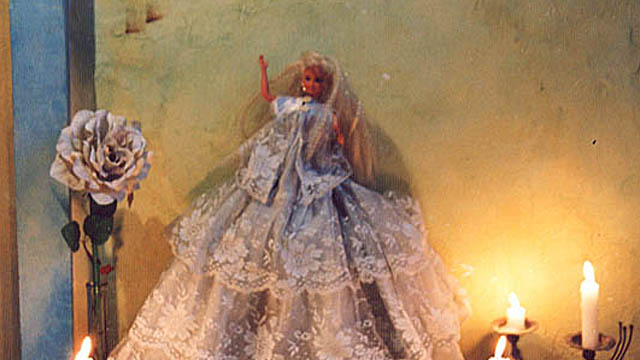
-
 Natalie Göltenboth
Natalie GöltenbothWhen I first entered Anna’s house1, I was surprised to hear that it was a temple of the Afro-Cuban Santería religion, a place determined by the presence of the orichas – the sacred beings of Santería. The objects of the interior did not reveal but seemed to hide their sacred meaning for the uninitiated viewer.
On our way through the house, Anna introduced me to a doll dressed up in white: Obatalá, the paternal oricha of wisdom and justice, with a cream cake on his right and a wide-eyed Bambi on his left. On the sideboard in the corner we greeted Yemayá, the maternal oricha of the sea, represented by a plastic bowl filled with water in which various floating animals swung and a Barbie, whose light blue lace dress complemented the turquoise colored water of the bowl. Finally, in a small wardrobe, the soup tureen of the goddess Ochún was decorated with two elegant Barbies in golden outfits, staring out of the darkness with their always flawless smiles. Two foreigners, charged with western ideals of beauty, who, in this context, had been commissioned with representing Ochún, the oricha of femininity, love and freshwater.
The representation or illustration of sacred powers through everyday objects, such as toys, dolls and knickknacks, have held a strong fascination for me since I literally stumbled upon them in Santero households, and, thus, the question of how this transference of powers and meanings to ultimately mundane objects could occur has long accompanied me on my fieldwork.
How can we interpret the fact that Ochún, the Afro-Cuban goddess of love and freshwater is visualized by a glittering Barbie doll sent to Cuba by Cuban family members living in the USA.
We should take a look back to the beginnings of the history of this religion for a better understanding of these dolls on the altars of Afro-Cuban Santería. Between the 16th and the 19th century, people were moved from one world to another on the sea routes of the transatlantic slave trade, which connected West Africa with the Caribbean (and this, in turn, with Europe), where they would henceforth work as slaves on the plantations of white landowners.
We should consider that people from Nigeria, Togo and Benin who had been deported to Cuba arrived in the New World without any luggage. The carved wooden sculptures of their gods, power objects, masks or costumes were left behind together with the African coastline. The transfer of religious concepts from Africa to Cuba, the Caribbean or Brazil, therefore, took place primarily in the minds of these people and remained dependent on this imaginative reservoir for long periods of time.
Despite the fact that the Cuban social anthropologist Don Fernando Ortiz2 still managed to collect some old carved wood oricha representations which had been produced during the colonial period in the 1930s to 1950s, the tradition of carving sculptures had not been resumed in the new situation in Cuba. The wooden oricha representations of Nigeria and Benin were replaced by smooth porcelain Madonna statues and the serious looking saints of Spanish folk Catholicism. Slaves from West Africa who were forced to worship the statue of Santa Barbara reacted with a phenomenon known as the syncretism of the Caribbean: statues of the Madonna and saints were interpreted as “reservoirs” of African deities and treated as such.
In the course of these syntheses, Santa Barbara is venerated as a representation of the virile oricha Changó, ruler of fire, thunderstorms and lightning. The Virgin of Regla, with her blue and white Madonna robe, is associated with Yemayá, the maternal oricha of the sea, and the Virgen de la Caridad del Cobre, in her church near Santiago de Cuba, is worshipped as Ochún, the oricha of love, creativity and sexuality. This possibility of reinterpretation, of “declaring something to be something else,” is tantamount to breaking the link between form and content and is the precondition for the unusual appearance of Barbies on the Santería altars.
As the colonial supplies in holy figurines diminished, colorful multiples of saints from Cuban mass production are found nowadays instead of the statues. Together with plastic dolls, Barbies or everyday objects, these new assemblages bear witness to the change of time and values, of new desires and new myths that move the people of Cuba today and are visualized on the altars.
Despite the fact that the connection of object and meaning has been blown up in modern Santería arrangements, it remains unclear to what extent new narratives are woven into the conception of the orichas when they are represented by new material objects: how much Madonna can one find in Yemayá, the oricha of the sea, and what is the relationship between a Barbie and an oricha? Referring to Marshall McLuhan’s3 famous statement that the medium is a significant part of the message, we can try a more specific interpretation of Barbies on Santería altars.
Original Barbie dolls are commodities acquired in stores in the USA and sent as gifts by relatives. As commodities and gifts, they mirror family ties that have continued over decades connecting Cuba and the USA, countries that have been politically separated since the Cuban revolution in 1959. In addition, Barbie dolls are not only saturated with the sacred aura of the orichas, they are also simultaneously encrusted with a fine texture of Cuban dreams of consumption and the feverish delirium of departure. Like Catholic saints, Barbies are figurines which are highly charged with their own narrative: the story of Ken and Barbie in the US American glamour world is a story of success, power and consumption. In this sense, Barbies on Afro-Cuban altars represent the fusion of idealized body and lifestyle imaginaries with sacred Afro-Cuban entities and deified ancestors. And, in the end, the forces of the orichas are conjured for reaching exactly these reasons: to provide their adepts with power that enables them to achieve their goals and realize their dreams – be they capitalistic or of another sort.
The reclassification of the Barbie doll from toy to altar object does not happen suddenly. The dolls have to undergo a transition process to become part of an altar installation. The dolls that appear on altars have been subjected to a ritual cleansing ceremony using decoctions of herbs associated with a particular oricha, which allows them to bear the vital power “Aché” of the sacred being. A bundle of herbs and other substances have been placed inside their bodies. Throughout these preparations, nothing has changed the appearance of the doll, which preserves its fashionable style and smile. What has changed is the idea about the object and hence its place – the Barbie is now part of a sacred altar installation.
Barbie dolls watch the strollers from the illuminated doorways that line the dark streets of Havana. Powerful representations of forces, imaginations, places and practices, connecting Africa and Cuba as well as Cuba and the USA, blending boundaries between dolls and gods, toys and power objects, commodities and sacred beings. They connect long-separated families and fragmented religious concepts. They guard the entrances of homes and watch over the desires of their inhabitants, who rely on the power of their Barbie goddesses.
Footnotes
1) Natalie Göltenboth. “Yemayá und der Spielzeugdampfer – Zur Sakralität der Ready-mades auf afrokubanischen Altären.” In Ideen über Afroamerikaner – Afroamerikaner und ihre Ideen. Beiträge der Regionalgruppe Afroamerika auf der Tagung der Deutschen Gesellschaft für Völkerkunde in Göttingen 2001, edited by Lioba Rossbach de Olmos & Bettina Schmidt. Marburg: Curupira, 2003, pp. 107-127.
2) Fernando Ortiz. Hampa Afrocubana: Los Negros Brujos. Miami. Universal, 1973.
3) Marshall McLuhan. Understanding Media: The Extensions of Men. 1st Ed. New York: Mc Graw Hill, 1964
References
- Brown, David H. “Thrones of the Orichas. Afro-Cuban Altars in New Jersey, New York and Havana”, African Arts, Oct. (1993) 44-87.
- Danto, Arthur C. Transfiguration of the Commonplace. A Philosophy of Art. Cambridge, Massachusetts: Harvard University Press, 1981.
- Göltenboth, Natalie.2020. „Invoking the gods – or the apotheosis oft he Barbie doll“ IN: Philipp Schorch, Martin Saxer et al. Exploring Materiality and Connectivity in Anthropology and Beyond. London: UCL
- Göltenboth, Natalie. “Yemayá und der Spielzeugdampfer – Zur Sakralität der Ready-mades auf afrokubanischen Altären.” IN: Ideen über Afroamerikaner – Afroamerikaner und ihre Ideen. Beiträge der Regionalgruppe Afroamerika auf der Tagung der Deutschen Gesellschaft für Völkerkunde in Göttingen 2001, edited by Lioba Rossbach de Olmos and Bettina Schmidt. Marburg: Curupira, 2003, pp. 107-127.
- Holbraad, Martin, and Morten Axel Pedersen. “Things as Concepts.” In The Ontological Turn. An Anthropological Exposition. Cambridge: Cambridge Univ. Press, 2017, pp. 199-238.
- Willie Ramos, Miguel. “Afro-Cuban Orisha Worship.” In Santería Aesthetics in Contemporary Latin Art, edited by Arthuro Lindsay. Washington: Smithsonian Press, 1996, pp. 51-76.

-
 Esther Kibuka-Sebitosi
Esther Kibuka-SebitosiSouth Africa gained its independence in 1994 with Nelson Mandela becoming the first black President on the fall of apartheid. The problem was: Even after the demolition of the apartheid system, social cohesion was a challenge as people still lived and gathered in separate groups, according to their race. Freedom had come but the people still segregated themselves. One of the ways to promote social cohesion is through sport. The hosting of the 2010 World Football cup therefore was a welcome opportunity.
The photograph shows the First National Bank Stadium or simply FNB Stadium. It is also known as the Calabash, because of its resembling an African vase. It is located near Nasrec and bordering Soweto and Johannesburg.
The Department of Arts and Culture defines Social cohesion as “the degree of social integration and inclusion in communities and society at large, and the extent to which mutual solidarity finds expression among individuals and communities”. This means that South African communities or society is cohesive when “ the extent that the inequalities, exclusions and disparities based on ethnicity, gender, class, nationality, age, disability or any other distinctions which engender divisions, distrust and conflict are reduced and/or eliminated in a planned and sustained manner. Thus, with community members and citizens as active participants, working together for the attainment of shared goals, designed and agreed upon to improve the living conditions for all”.
Based on the above understanding, building a nation is a complex process that entails “a society with diverse origins, histories, languages, cultures and religions come together within the boundaries of a sovereign state with a unified constitutional and legal dispensation, a national public education system, an integrated national economy, shared symbols and values, as equals, to work towards eradicating the divisions and injustices of the past; to foster unity; and promote a countrywide conscious sense of being proudly South African, committed to the country and open to the continent and the world“.
The hosting of the World Football Cup therefore was an optune moment in the history of the nation. According to Barolsky, (2011) sport was used as a catalyst to build a non-racial, non-sexist, democratic, prosperous and free South Africa. The FIFA World cup in 2010 referred to it as „African and South African. The Bafana Bafana team received great support from home. The social cohesion was divided into three dimensions: Civic, Social and Economic."
The impact of the FIFA World cup was significant in building social cohesion. There was little doubt that the World cup was an “extraordinarily unifying moment for the country as whole, which broke down social, racial and even gendered barriers as women were increasingly drawn into the fervor around the a game usually predominantly watched by men.” (Barolsky, 2011)
References
- Barolsky, V (2011).Impact of 2010 soccer World Cup on social cohesion and nation-building, Technical Report · January 2011.
- DOI: 10.13140/2.1.2007.5841
- Retrieved from https://www.researchgate.net/publication/271700976
- Department of Arts and Culture statement on Social Cohesion
published April 2020
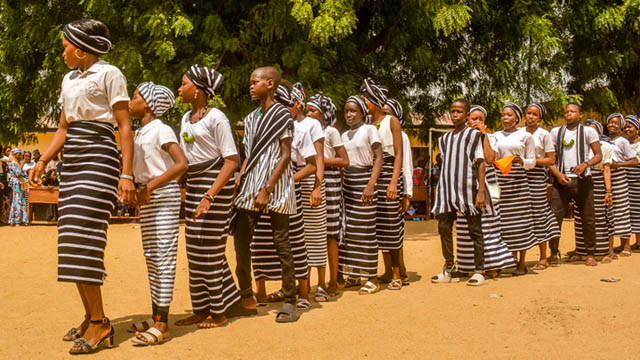
-
 Karimatu Dauda
Karimatu DaudaMany of the group of pupils that were trained on Bura culture and Bansuwe dance in Ruby Springfield College are from this ethnic group, Bura. However, a good number of these pupils did not have prior experience of the Bansuwe dance. Consequently, the facilitator who taught them the dance relied on videos of Bansuwe dance and songs, played through a computer and a portable speaker, to teach them the dance steps from the scratch. This was accompanied by direct demonstrations and direction by the facilitator. Although the facilitator is not a specialised dance teacher, she is from the Bura ethnic group and a skilled Bansuwe dancer who had been performing for many years.
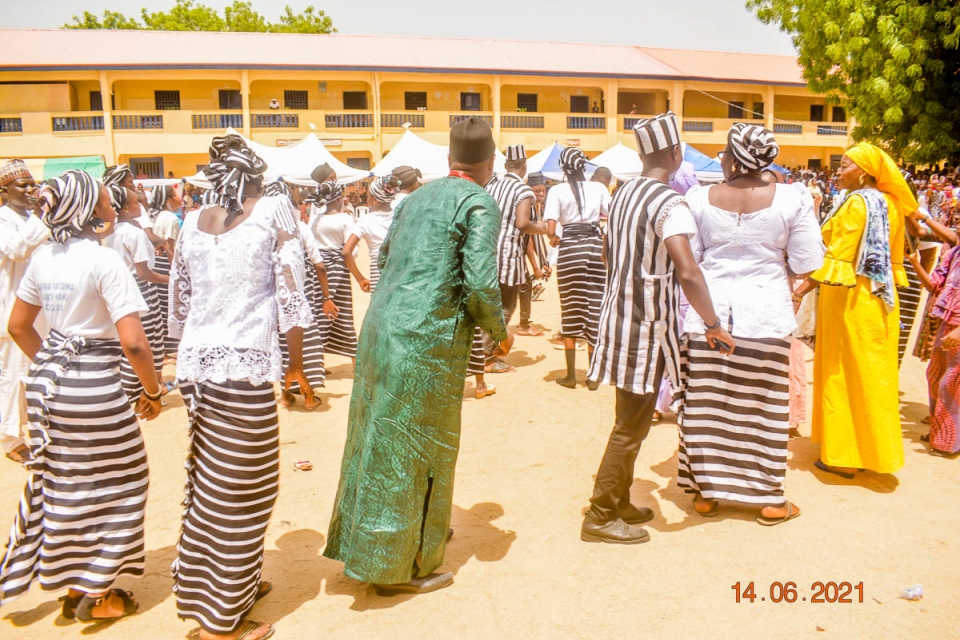
The lady in yellow was a parent of one of the dancers who came to cheer the dancers. The person in green is the principal of the school who also came to cheer the dancers. Cheering of dancers and throwing some money at them is a common practice in Nigeria. It is meant to both encourage and show appreciation to the dancers. (Photo: Karimatu Dauda)
Bansuwe dance is popular among the Bura and is usually the preferred cultural dance at weddings, funerals and other important ceremonies. Yet, the experience in this school shows that there are a good number of Bura people whose children do not know the Bansuwe dance. Part of the reasons for this is that some of the children have never been taken to their villages where cultural practices are better sustained. The Boko Haram conflict in the region also discourages social gatherings which are often potential soft targets of insurgents.
The cultural day events usually involve the presence and participation of pupils’ parents and other guests which makes it a good channel for the sustainability of culture. More girls ended up performing in the dance because many of the boys were unable to pass the final screening for the cultural day. The dancers were dressed in traditional Bura attire called Japta. The audience cheered the dancers and at intervals some would join the dance briefly. This dance was accompanied by traditional Bura music made by drums, xylophone, flutes and vocals.
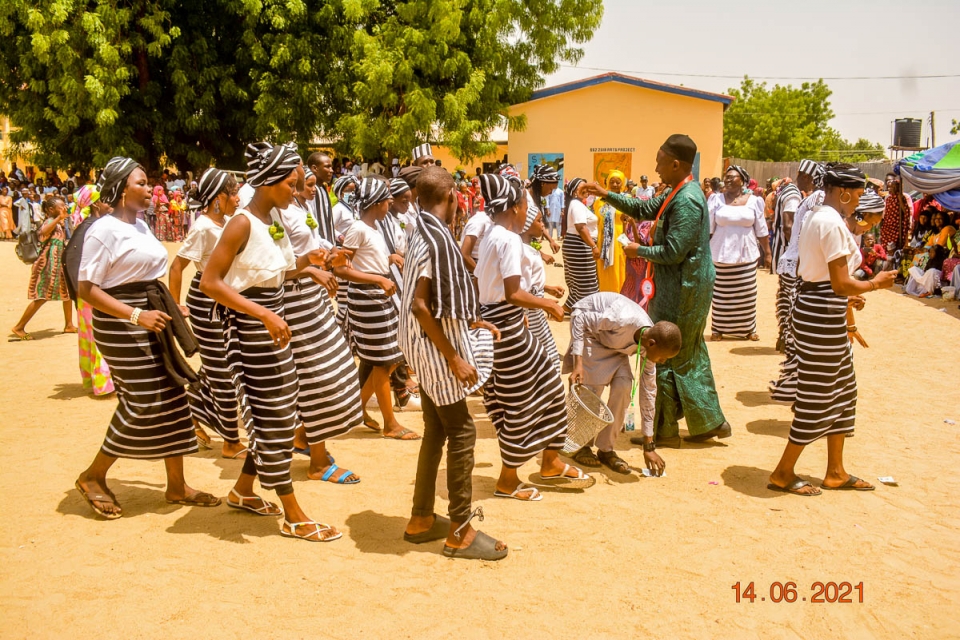
The boy with the basket was picking the money thrown to the dancers by the audience in appreciation of their performance. (Photo: Karimatu Dauda)
The pupils, especially those from Bura, could easily learn more about the Bansuwe dance from their parents and relatives at home. Since dance often carries specific meanings within the social settings it is situated (Pusnik, 2010), there will not be a shortage of what to converse about concerning the Bansuwe dance. Traditional dance in Nigeria is used as a channel for communicating social values, sensitization and even carrying out social sanctions. In addition to these, Bansuwe dance is also used to convey merriment during ceremonies and sadness during funerals and each is reflected by the tone, tempo and messages of the music chosen.
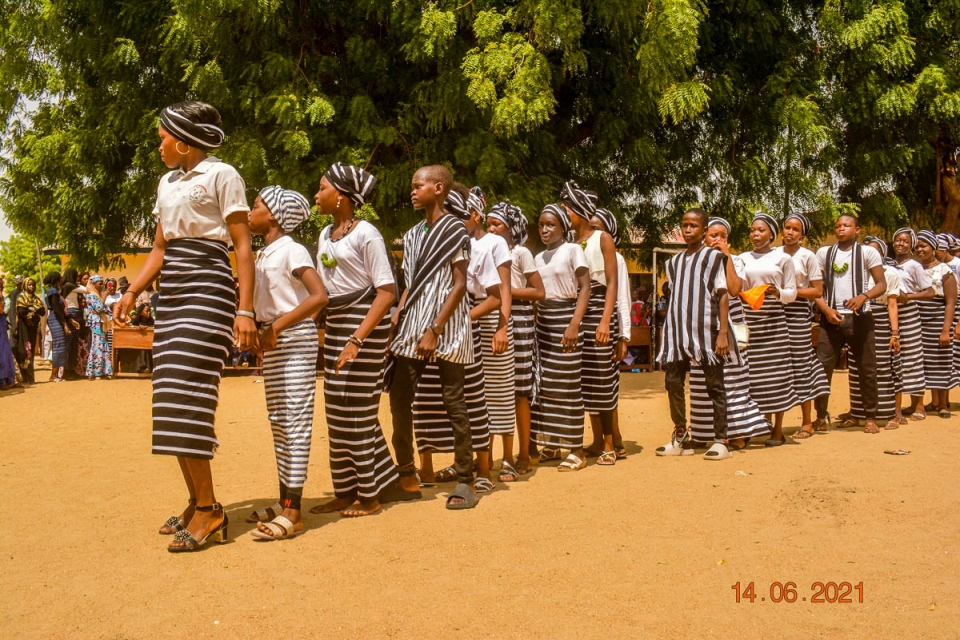
Bansuwe Dance (Photo: Karimatu Dauda)
In the case of the cultural day of Ruby Springfield College, the dance was clearly conveying merriment and the central message of the song was that people should come together as friends and brothers. This message was according to the central purpose of the cultural day which was to encourage mutual cultural understanding among the pupils of the school.
The excitement accompanying the performance of Bansuwe dance by the pupils of Ruby Springfield College is a testimony to the fact that it left a lasting impression on them. This is because, for some pupils, it represented the first time they witnessed and participated in the Bansuwe dance. This enthusiasm by pupils, and even by some parents, is behind the determination by the school to sustain the practice of the cultural day annually. This in turn will ensure that Bansuwe dance is sustained, as younger generations get to learn and participate in it every year at school.
While the annual cultural day cannot be compared to dance subjects formally being taught in the classroom, it is no doubt a contribution to arts education albeit as an extra-curricular activity. It serves as the next best thing in the absence of a dedicated dance subject in the curriculum of schools. In addition, it will be an important space for the sustainability of Bansuwe dance possibly for many generations to come. It is important to sustain this dance because it is one of the few remaining cultural activities which brings together people of all ages, gender, and social status to interact equally on an informal basis. Such a gathering would provide a good space for the conversations on cultural sustainability.
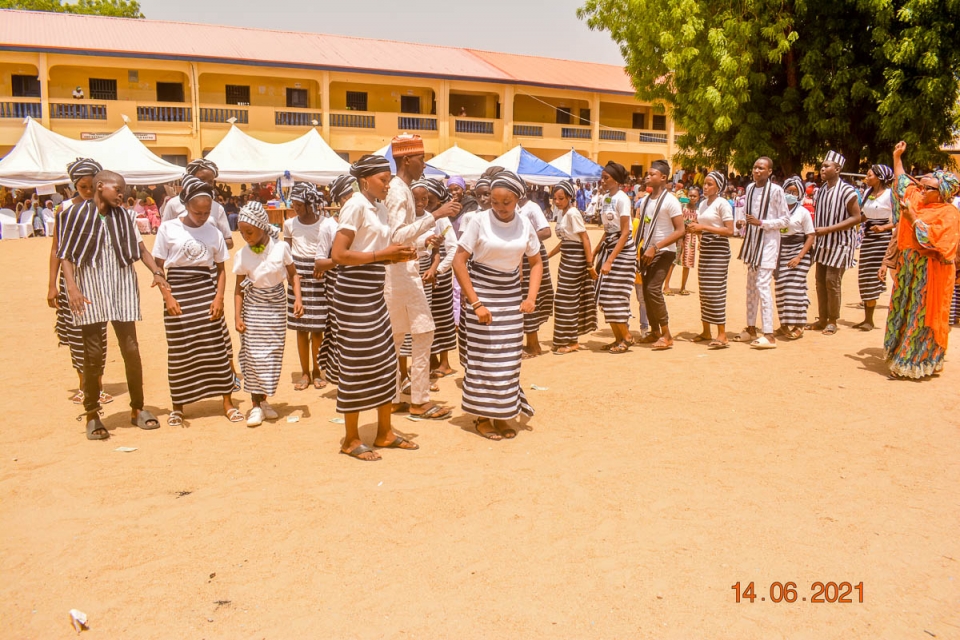
Bansuwe Dance (Photo: Karimatu Dauda)
Arts education is part of the curriculum of primary, secondary and tertiary academic institutions in Nigeria. This does not mean, however, that the teaching of arts is done in every school in the country. The situation is further compounded by the fact that schools offering arts education are often selective about the arts subject they teach. In most schools, fine arts or creative arts make up the totality of their arts education subjects. While their creative arts subject includes lessons in music, dance and theatre, there are also dedicated music and theatre subjects in schools.
In contrast, dance is hardly, if ever, exclusively taught as a subject in formal education settings. Like in many other countries, dance is not taught with the same frequency and depth as painting, theatre or music (Mosko, 2018). Even if there were a dedicated subject for dance education in the country, the hundreds of ethnic groups in Nigeria would make the choice of what dance to teach in formal education settings quite challenging. This is because a typical classroom is made up of learners from diverse cultural and ethnic backgrounds. Generally, arts education in the country is facing a number of challenges, as identified by Enamhe (2013), including the discouragement of children from taking arts subjects by parents, the fear of the perceived difficulty of the creative aspects is arts subjects, and the high cost of materials needed for arts education both for learners and academic institutions.
References
- Enamhe, B. B. (2013). The role of arts education in nigeria. African Journal of Teacher Education, 3(1), 1-7.
- Mosko, S. (2018). Stepping sustainably: The potential partnership between dance and sustainable development. Consilience: The Journal of Sustainable Development, 20(1), 62-87.
- Mtaku, C. Y. (2020). Continuity and change: The significance of the tsinza (xylophone) among the bura of northeast Nigeria. Center for World Music – Studies in Music, Universitätsverlag Hildesheim.
- Pusnik, M. (2010). Introduction: Dance as social life and cultural practice. Anthropological Notebook, 16(3), 5-10.

-
 Esther Kibuka-Sebitosi
Esther Kibuka-SebitosiRainbow Nation
The rainbow in the Bible given in Genesis 9:16 is a reminder that we have a covenant with God not to destroy the earth again by floods. “I set My rainbow in the cloud, and it shall be for the sign of the Covenant between Me and the earth,” says the Lord. God had made a covenant with Noah and his seed for generations. Genesis 9:9. And I, “behold, I establish my covenant with you, and with your seed after you”. Since we are all Abraham’s seed, we are covered in this covenant, although Jesus makes a better covenant in the New Testament. Returning to the rainbow nation, this covenant is saying “ no more destructions”. It is as if God is saying we should no longer fight each other but live together in peace. He made us all people with different colours (rainbow).
The metaphor describes a people with multi-cultures living together. The image of the flag is a symbol of togetherness or unity. The different colours. Adopted in 1994, the red, white and blue were adopted form the colours of the Boer Republic while the yellow, black and green were taken from the ANC (African National Congress) flag. The black colour is a symbol of the people; the green represents fertility of the land while the gold represents the wealth from minerals beneath the soil. The ANC adopted these colours way back in 1925.Associated with the flag is the national anthem. This is unique in that it has many languages:
- Nkosi sikelel’ Afrika
- Maluphakanyisw’ uphondo lwayo,
- Yizwa imithandazo,
- yethu,
- Nkosi sikelela,
- thina,
- lusapho lwayo.
- Morena boloka setjhaba sa heso,
- O fedise dintwa la matshwenyeh
- O se boloke (Ntate)
- O se boloke
- setjhaba sa
- heso,
- Setjhaba sa
- South Afrika
- – South Afrika.
- Uit die blou van onse hemel,
- Uit die diepte van ons see,
- Oor ons ewige gebergtes,
- Waar die kranse antwoord gee,
- Sounds to call to come together,
- And united we shall stand,
- Let us live and strive for freedom,
- In South Africa our land…
Songwriter: Cornelius Jacob Langenhoven
Summary
The Rainbow metaphor is characteristic of a nation that aspires for peaceful living; building a peaceful nation. The symbol taken from the Bible donating the Noahic covenant reminds us that God will no longer send the floods to destroy us.
The flag is a symbol of unity between the Boers and the African National Congress colours, which represents the whole of South Africa. It is a sign of hope and nation building.
Associated with the Flag and the Rainbow nation is the National anthem. It is written in many languages signifying the rainbow nation of multi-cultures.
References
- https://en.wikipedia.org/wiki/Rainbow_nation
- https://www.worldatlas.com/webimage/flags/countrys/africa/soafrica.htm
published January 2020
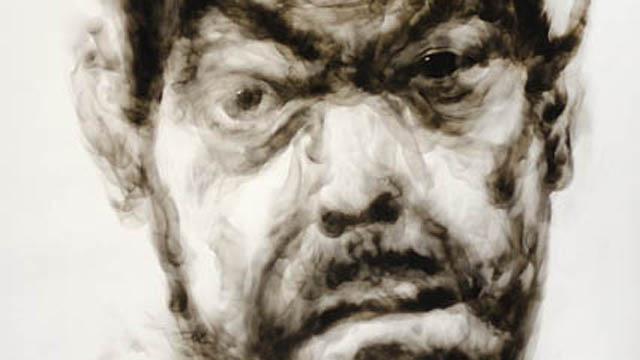
-
 Elfriede Dreyer
Elfriede DreyerThe Richtersveld National Park in South Africa has some of the most beautiful and hardy vegetation in the world. The 'botterboom' ('butter tree') (Tylecodon paniculatus) is but one example hereof. According to Wikipedia (RICHTERSVELD 2008), "The plant appears to have wide tolerance of growing habitats, growing in weathered rock in the north to coastal sands in the south. The plants can reach heights of 2 m making them the largest of the tylecodons. Tylecodon paniculatus is summer deciduous. The plants conserve energy by photosynthesizing through their 'greenish stems' during the hot dry summer months. The yellowish green, papery bark is a very attractive feature of this plant and has given rise to the common name. During the winter, plants are covered with long, obovate, succulent leaves clustered around the apex of the growing tip. [...] In nature the plants tend to grow in groups, making a spectacular show when they flower. [...] The shrub is reported to have a surprisingly weak and shallow root system for its size." This plant is representative of many other African succulents and bulbous plants that have shallow root systems and can therefore easily adjust to desert and other harsh environmental conditions. They change their leaves into thorns and the surface to protect the plant against the loss of water.
The metaphor of the succulent is of particular interest to an engagement with nomadic identity in the context of a continent such as Africa that has been subjected to "wicked, messy problems". Being similarly exposed to a severe environment, African people have accustomed themselves to survive in difficult circumstances and to a large extent have become nomadic as a result. In many cases they have adopted itinerant lifestyles and form groups for protection, safety and cultural coherence. Living on a vast continent, they are accustomed to long journeys; however, poverty, violence, civil wars, colonial and other imperial infiltrations and oppression have resulted in a focused nomadic condition where people are constantly moving and travelling in the search for a better life and even survival. Aligning contemporary culture with nomadism, Polish sociologist and philosopher Zygmunt Bauman (1996) appropriates the stereotype of the pilgrim who is on a teleological journey - ordered, determined and predictable - but cannot come to rest and leave a footprint in the sand. They operate through a 'shallow root system'.
Bulbous succulent plants are essentially botanical rhizomes, a concept that inspired the notion of the rhizome as a philosophical concept, initially developed by Gilles Deleuze (philosopher) and Felix Guattari (psychotherapist) in their Capitalism and schizophrenia (1972 -- 1980) project. Deleuze and Guattari (1987:7) state that the "rhizome itself assumes many diverse forms, from ramified surface extension in all directions to concretion in bulbs and tubers". In "A thousand plateaus" (1987 [1980]) they introduce the concept of the rhizome as follows (assigned to cultural patterning):
1. Principle of connection: any point of a rhizome can be connected to any other
2. Principle of heterogeneity: any point of a rhizome can be connected to any other
3. Principle of multiplicity
4. Principle of a signifying rupture: a rhizome may be broken, but it will start up again on one of its old lines, or on new lines
5. Principle of cartography and
6: Principle of decalcomania: a rhizome is not amenable to any structural or generative model; it is a map and not a tracing.
Deleuze and Guattari's model allows for a cultural view that entertains non-stable relationships, subjectivity, relationalism, multiplicity and volatile positions. Similarly, Italian contemporary philosopher and feminist theoretician Rosi Braidotti (2011:3) views the nomadic predicament and its multiple contradictions have come to age in the third millennium after years of debate on the "'nonunitary' - split, in process, knotted, rhizomatic, transitional, nomadic - so that fragmentation, complexity and multiplicity have become everyday terms in critical theory." Since the 1990s Braidotti has been engaged with the question as to what the political and ethical conditions of nomadic subjectivity are, grounded in a "politically invested cartography of the present condition of mobility in a globalized world" (Braidotti 2011:4).
South Africa has experienced turbulent histories over the last two centuries and nomadic movement was brought on by volatile colonial, postcolonial and global upheavals, leading to political and social displacement and consequently hybrid identities. Having been a British as well as a Dutch colony, South Africa has since 1652 shown cultural patterns of movement in and out of the country, and from place to place. During apartheid non-whites or 'people of colour' were viewed as not belonging and were removed from the city; forcibly established in townships outside the city; only allowed as workers into the city; and had to carry passbooks (identity documents) on them all the time. For many decades now, in postapartheid South Africa, migrants from all over the continent have been flocking to the country in search of a better life and even survival, and they mostly live in temporary shelters. Many other sociological and cultural problems have emanated as a result of the migrant issue, based on subjective racism, xenophobia, crime and fear for the other.
Identity (and subjectivity) in the African modernist context is neither stable nor fixed, and the corporeality of the artist-as body and the artwork-as-process in this specific part of the world henceforth has produced liminalities in many ways. Often rooted in a rural or small-town environment, African artists generally tend to move to multicultural, cosmopolitan cities where gallery and industry networks are in closer proximity. Those in the rural remote parts of Africa make it their business to connect through digital and social media in order to stay connected, current and noticed.
The art of South African artist Diane Victor provides an eminent example of nomadic identity depiction. The artist utilises various ephemeral media in her work, such as ash, crushed charcoal and staining. In Perpetrator 1, 2008, a so-called smoke portrait, she has used the deposits of carbon from candle smoke on white paper to draw with. The work is exceedingly fragile and can be easily damaged, disintegrating with physical contact as the carbon soot is dislodged from the paper, and in this way speaks about the fragility, precariousness and insubstantiality of a nomadic human condition. Although the smoke portraits started with a series on AIDS victims in 2003, Victor continued to depict various other individuals, commenting on ephemeral politics and ideas, and life generally as a temporal entity. In this work she depicts a perpetrator with reference to the previous South African apartheid dispensation and the atrocities of its perpetrators, but also to counter racism and the violence committed in the name of political redress. The Perpetrator's race is indeterminate, but his gender is certain, as well as the cruelty of his dispensation. Severed from the body, the Perpetrator's head becomes a rhizome that is not 'rooted' in a body, but uprooted, derooted, and floating with tubular arteries as corms hanging from it like a beheaded monster.
As an ephemeral, nomadic image, Perpetrator 1 speaks about a decolonial condition that presents the ambivalent Baumanian idea of the pilgrim-tourist who keeps going in circles, driven by an ideological sense of survival. Nomadic identity is essentially rhizomatic, and in Africa, as in many other parts of the world, the drive to belong and the utopian quest for a better life have resulted in identity being redefined, renegotiated, rerooted and sprouting in many directions.
References
- Bauman, Z. ‘From pilgrim to tourist – or a short history of identity’. In Hall, S and Du Gay, P (eds). 1996. Questions of cultural identity. London/New Delhi/Thousand Oaks: SAGE.
- Braidotti, R. 2011. Nomadic subjects: embodiment and sexual difference in contemporary feminist theory. Second edition. Gender and culture: A series of Columbia University Press. New York: University of Columbia Press.
- Deleuze, G. & Guattari, F. 1976. Rhizome: Introduction. Paris: Éditions de Minuit. [based on Gilles Deleuze and Félix Guattari’s Capitalism and schizophrenia project (1972 - 1980)].
- Deleuze, G. & Guattari, F. 1987 [1980, French original]. A thousand plateaus: capitalism and schizophrenia. Translated by Brian Massumi. London: Athlone Press.
- RICHTERSVELD NATIONAL PARK - VEGETATION: BOTTERBOOM (Tylecodon paniculatus). 2008.Available: https://www.richtersveldnationalpark.com/vegetation_botterboom.html (Accessed 3 January 2019).
published April 2020
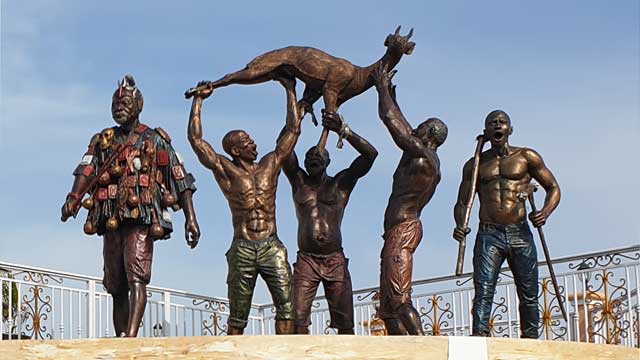
-
 Ebenezer Kow Abraham
Ebenezer Kow AbrahamTheophilus Kwesi Mensah and the Placemaking Paradigm
Within the rebranding and the making of new identity for Winneba as enshrined in the Effutu Dream Project, the name Theophilus Kwesi Mensah cannot be overlooked in this intercourse. This is not only because he engineered the widely talked about installations: the Unity Monument, The Aboakyer Monument, The Fishermen of Akosua Village and the Monument of Ofarnyi Kwegya but the awe-striking aesthetical connotations he incorporated in the aforementioned works. Each of these statues were rendered to mimic the idea of Winneba as a community built on a collective space. Being native of Winneba, heightened his understanding of how the amalgamation of economic, political, and cultural activities in the past, would accord him the impetus to express himself publicly. In so doing, he empowered his sculptures to ventriloquy the unique narratives that define Winneba and redefine this relatively old settlement yet burgeoning municipality as a dwelling place or a place worth visiting.

Figure 1: Theophilus Kwesi Mensah, Ofarnyi Kwegya, 2021. Fibre Reinforced Polymer. Yeepimso Community Centre, Winneba. Courtesy of Edem Dedi Photography.
Through the lens of placemaking, Ofarnyi Kwegya (Figure 1) and the Fishermen of Akosua Village (Figure 2) are two typical statues that has beautified the vernacular space of two historical settlements in the older southern half of Winneba.
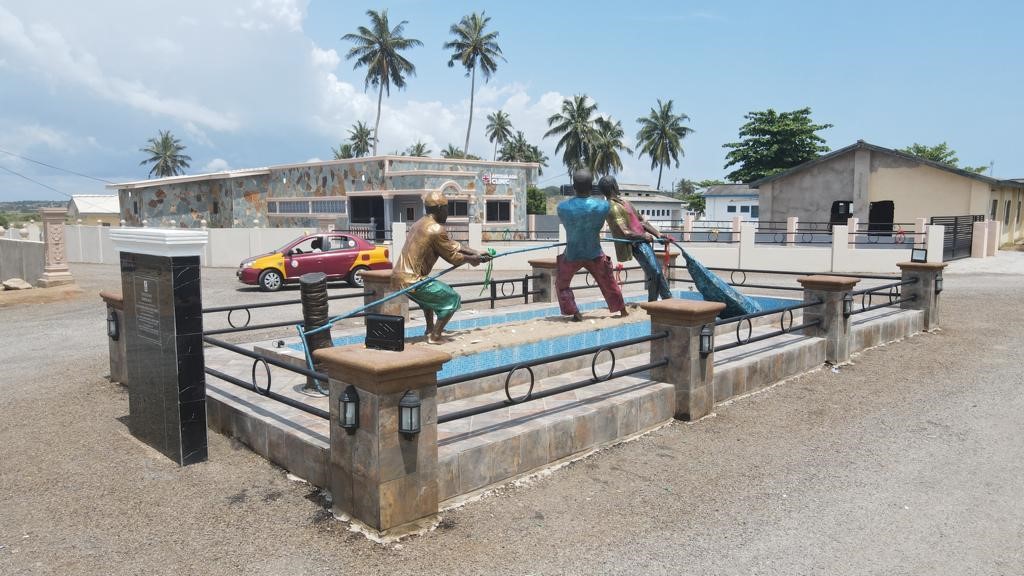
Figure 2: Theophilus Kwesi Mensah, Fishermen of Akosua Village, 2021. Fibre Reinforced Polymer. Akosua Village Community Centre, Winneba. Courtesy of Edem Dedi Photography.
The two statues stand in the middle of Yeepimso and Akosua Village communities respectively as embodiments of vital ingredients helping in creating a sense of community, civic identity, and culture in both spaces. They have both transformed their unique sites as lively and attractive communities with the monumental figures not just becoming legible maps to the sites but turning the spaces into places that support human interactions. The site of the statue has become the most important and attractive places in the two communities. They have become the center of attraction where the community gather for entertainment and trade, especially at night when economic activities in the two communities are at their peak.

Figure 3: Theophilus Kwesi Mensah, Unity Monument, 2021. Fibre Reinforced Polymer. The Unity Square, Winneba. Courtesy of Edem Dedi Photography.
Another compelling monumental statue that has transformed the landscape of its site is the Unity Monument (Figure 3). Before the advent of the monument, the site of the statue (the Y-intersection – Winneba Traffic Light) was a deserted barricaded mere chaparral which displayed all forms of notices including obituaries and political posters (Mensah & Abraham, 2022). Yet, Theophilus Kwesi Mensah’s statue has transformed the space into an ideologically charged space for a deliberative unity and peace agenda in Winneba. The environment is so aesthetically pleasing that people like to visit the site for selfies and sightseeing thereby generating income for the Municipal Assembly.
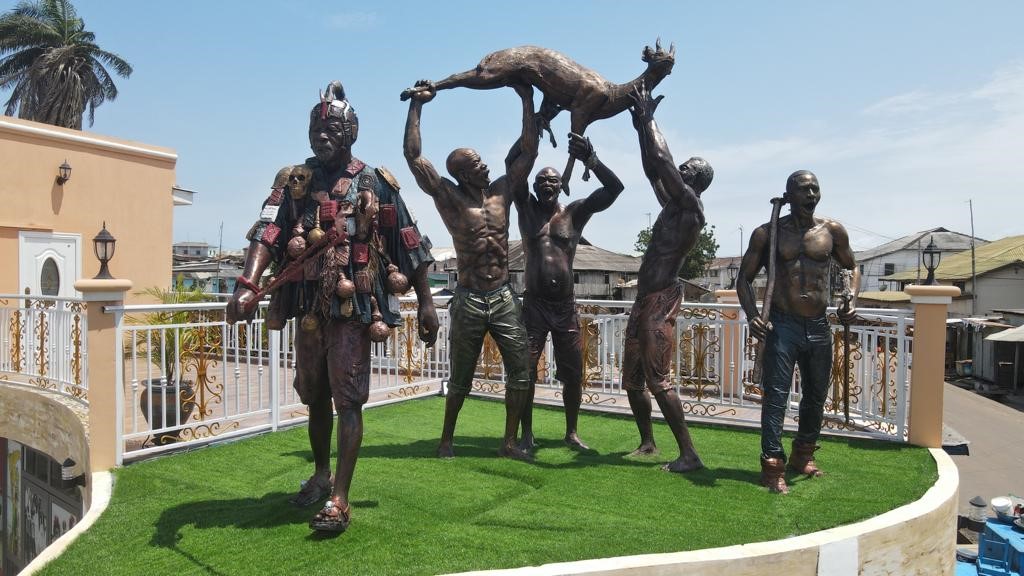
Figure 4: Theophilus Kwesi Mensah, The Aboakyer Monument, 2021. Fibre Reinforced Polymer. Osimpam Museum, Winneba. Courtesy of Edem Dedi Photography.
Theophilus Kwesi Mensah’s ontological orientation of Winneba is multifaceted. Hence, he found significance in the century’s old festival of the people of Winneba, Aboakyer to sculpt a monumental statue to this honour (Figure 4). The Aboakyer Monument mounted on the roof-top of the Osim Pam Museum is at the heart of Winneba as an embodiment of Winneba’s heritage. Owing to the enormous narratives surrounding the Aboakyer Festival, it is seen as one of the most popular and most significant festivals in Ghana (Akyeampong, 2019). The people of Winneba are invariably identified by the Aboakyir Festival. Theophilus Kwesi Mensah captured the very essence of the festival by vividly depicting the most significant characters: the Supi, the Asafo warriors, and their cheer leaders in procession with the catch.
During the 2022 Aboakyer Festival, it was observed that both celebrants and tourist were awe-struck by the aesthetic connotations of the monument. People gathered around the site for various reasons. Whilst some were seen taking tourist photos, others were seen venerating the ancestors who in the past led the festival.
In view of the Effutu Dream Project, Theophilus Kwesi Mensah’s artistic ingenuity to a large extent has contributed to rebranding the Winneba Township by beautifying the place and making it attractive for tourist. However, beyond the beautification agenda, part of the underlining philosophy of the statues was to consciously bring to the fore, some compelling memories of Winneba in relation to the current narratives within the land.
Theophilus Kwesi Mensah and the Collective Memories of Winneba
Theophilus Kwesi Mensah capitalized on his creativity to translate some notable historical events pertaining to his beloved native, Winneba into tangible remnants of the recent past to shape and, indeed, consolidate the Effutu Dream Project. Whilst usurping a storyteller, he equipped his statues to mimic the historiography of Winneba as collective memorials for the publics of Winneba. This is underpinned by his inclination to the truism that cities are built based on their histories and for that matter, Winneba cannot be gentrified without laying claims to the past publicly. Therefore, he ensured that whilst the Effutu Municipal Assembly initiated the Effutu Dream Project, the glorification of the public triumphs of Winneba was not taken for granted. This desire culminated into transforming some important public vernacular spaces into storehouse of memories embedded and inscribed on the landscape of Winneba.
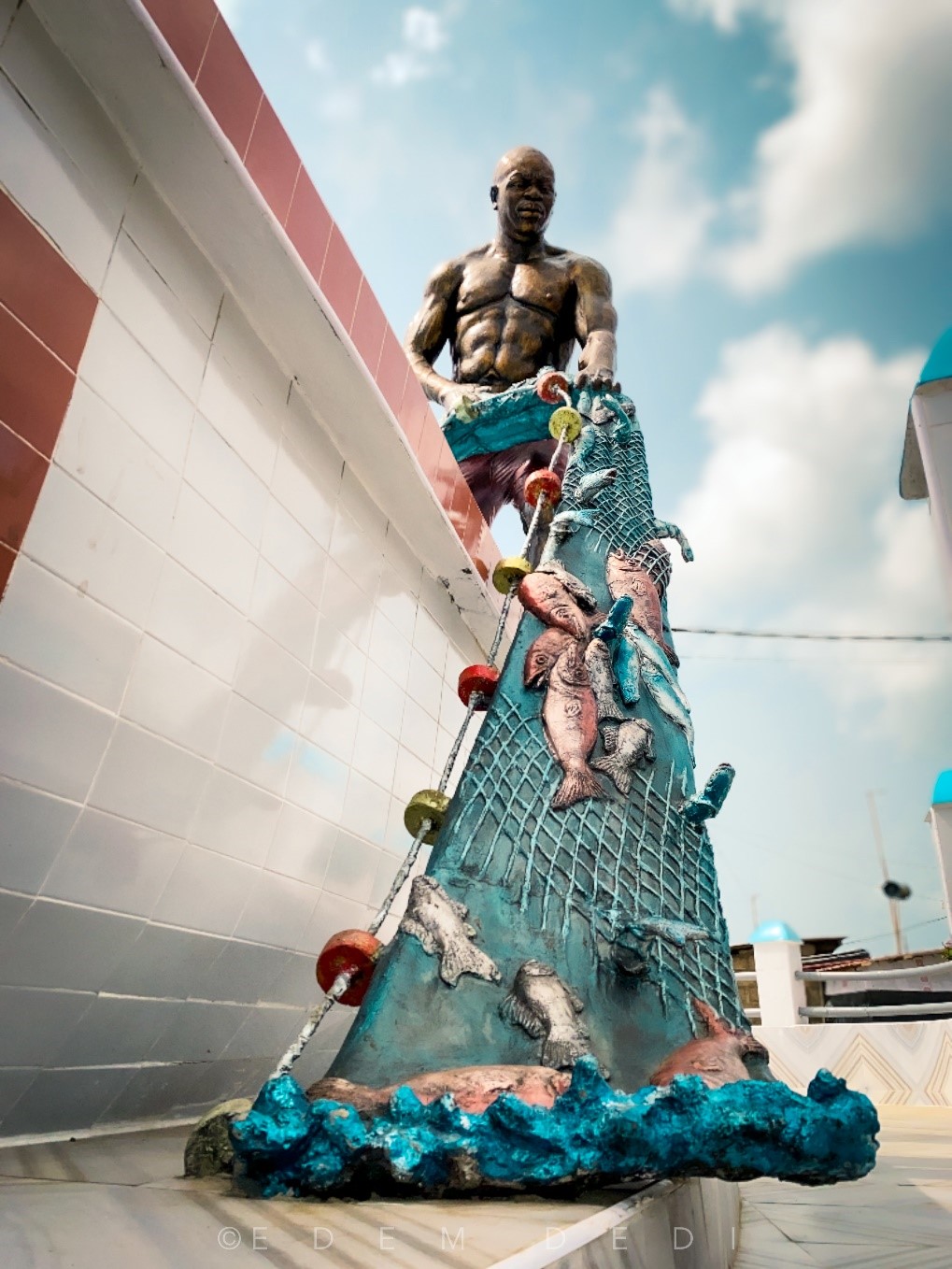
Figure 5: Theophilus Kwesi Mensah, Ofarnyi Kwegya, 2021. Fibre Reinforced Polymer. Yeepimso Community Centre, Winneba. Courtesy of Edem Dedi Photography.
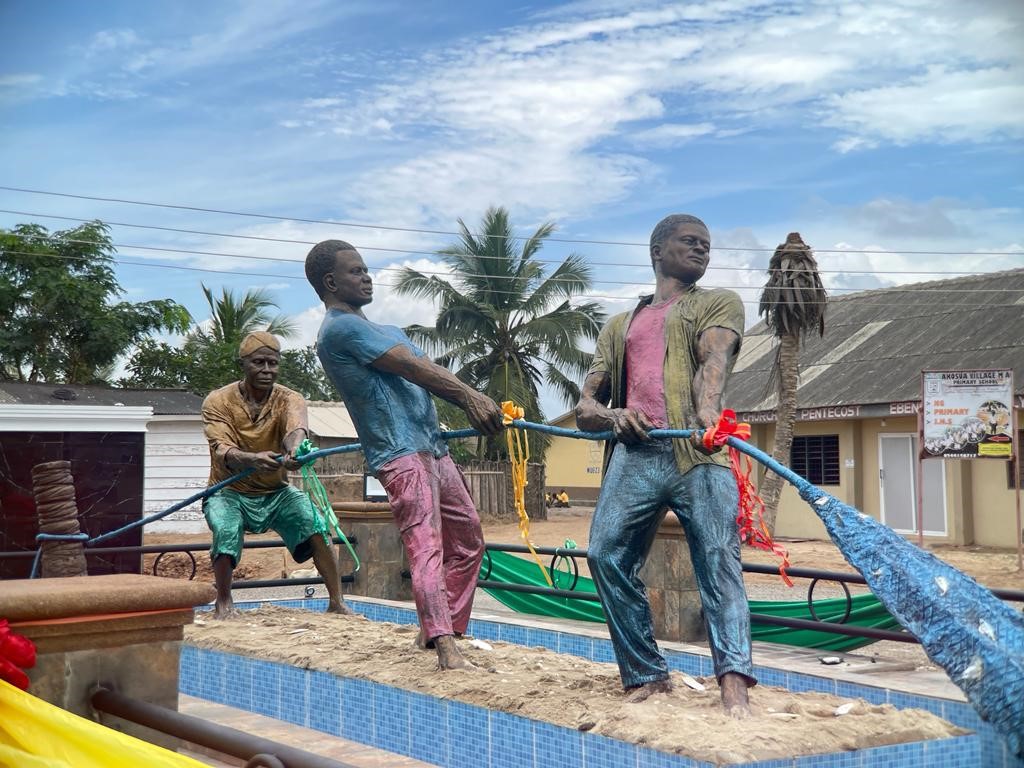
Figure 6: Theophilus Kwesi Mensah, Fishermen of Akosua Village, 2021. Fibre Reinforced Polymer. Akosua Village, Winneba. Courtesy of Edem Dedi Photography.
Knowing Winneba traditionally as a fishing community, Theophilus Kwesi Mensah produced two major monuments, Ofarnyi Kwegya (Figure 5) and the Fishermen of Akosua Village (Figure 6) as a concretized instantiation to the noble trade that has in the past defined what place Winneba is. Ofranyi Kwegya, is the statue of the unheralded giant master fisherman, an exponent of mid water trawling in Winneba who captured huge number of fish whereas the Fishermen of Akosua Village depict the famous trio: Zagada Afadzinu, Kwami Akpade and Sogbka Dagodzo who introduced artisanal fishing or subsistence fishing to Winneba.
Although the fishermen portrayed in these monumental statues have died long ago, they constitute such significant heroes in the historiography of Winneba. In view of their important roles in the socio-economic phenomenology of Winneba, Theophilus Kwesi Mensah aimed at stopping their decay and position them into the realm of the timeless with the erection of their statues as memorials that transmit their archetypal narratives.

Figure 7: Theophilus Kwesi Mensah, Unity Monument, 2021. Fibre Reinforced Polymer. The Unity Square, Winneba. Courtesy of Edem Dedi Photography.
In view of Theophilus Kwesi Mensah’s understanding of the political and dynastic heritage of Winneba, he engineered the construction of the Unity Monument in commemoration of the end of the protracted chieftaincy feud that had ensued in Winneba in the past. Ephraim-Donkor (2019) recount that since the latter part of the nineteenth century, the people of Winneba have clashed in violent struggle for power until 22nd July, 2015 when the Supreme Court of Ghana, finally intervened. The feud was rooted in an uncanny clash of cultures within the same family three, resulting in a political quagmire as to which succession mode to follow, the male or female model. The people of Winneba traditionally follow the patrilineal line of succession, however the Acquahs who are for the female model, tasted power as caretakers but refused to cede power back to the original benefactors, the Otuano Royal Family (Gyatehs or Gharteys) who are for the male model.
The female model became popular in Winneba because of their hospitality which allowed their Akan neighbours to live with them and rendered Winneba as a cosmopolitan community. Theophilus Kwesi Mensah’ depicted the two families, Gharteys and the Acquahs and a third figure representing the non-natives as a united force in the gentrification of Winneba as they erect a flag as signifier to this commitment. The Unity Monument does not only exhibit an aesthetically astute display of Theophilus Kwesi Mensah’s artistic ingenuity but also, it encapsulates the political and dynastic history of Winneba whilst being a crucible of memory to the unity and peace in Winneba presently.
As part of Theophilus Kwesi Mensah’s memorialization agenda with regards to his statues in Effutu Dream, he produced the iconic Aboakyer Monument as a memorial to the Aboakyer Festival of the Effutus of Winneba. The Aboakyer, known throughout Ghana as the "Winneba Deer Hunting Festival," is held annually in early May. It commemorates the founding of Winneba some three centuries ago, when the Effutu, led by one Osim Pam and accompanied by the god Penkye Otu, settled on the coast at the end of their migratory journey from northern Ghana to the present location.
Pedagogical Connotations of Theophilus Kwesi Mensah’s Statues in Effutu Dream
As artist academic, having been under the tutelage of the Emancipatory Art Teaching Project (EATP) by Professor kąrî’kạchä seid’ou, he is an alley of the blaxTARLINES community in Kumasi. Theophilus Kwesi Mensah’s practice ties in with contemporaneity in the arts. In his teaching, he identifies with the philosophy that trainee art educators ought to think and act creatively. He does this by championing their epiphany in the studio as nexus of exploring emerging issues in art education. Through the studio, his statues in Effutu Dream creatively imparts on his students as agents of transformation in addressing the urgent call for equity, diversity, and inclusion in our educational structure and practices.
Whilst his students have the liberty to choose their own masters, he has been readily available, and the doors of his studio was opened to all students who loved art whilst working on his statues in Effutu Dream. After all, he too has absorbed lessons from legendary Ghanaian Artist Academics such as Benjamin Menya, Kwamevi Zewuze Adzraku and Buckner Komla Dogbe. So, students with varied backgrounds are mainstays in his studio beyond the statues in Effutu Dream. He reckons the studio space as a crucible of intellect and a window to add to knowledge as his students pick his brain as apprentices there.
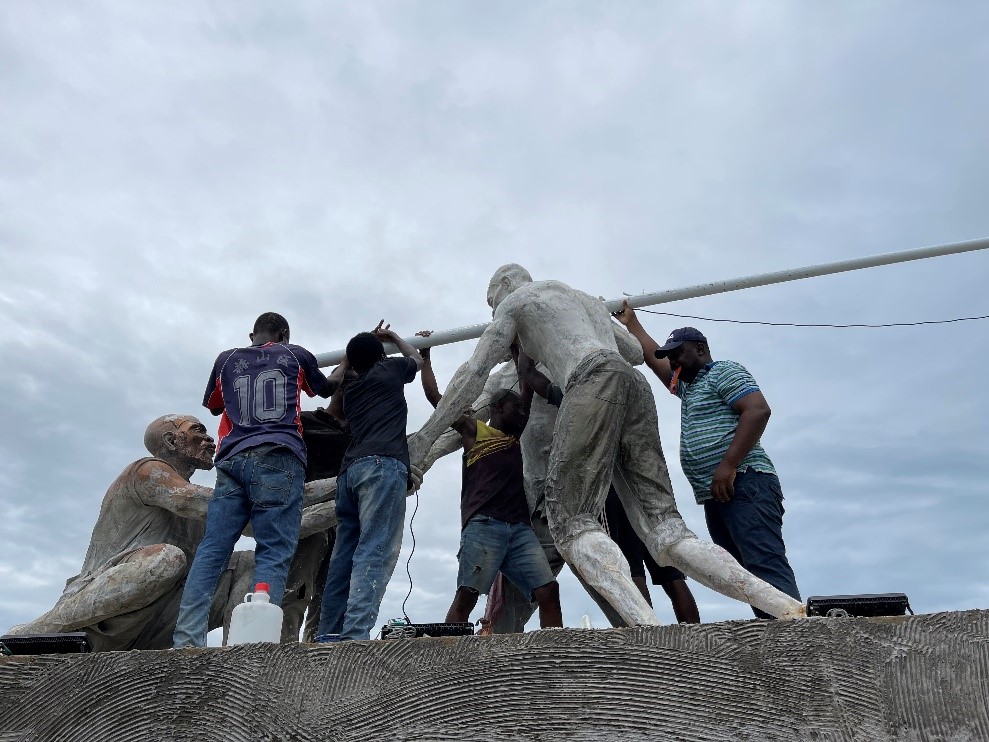
Figure 8: Theophilus Kwesi Mensah working with his students (Courtesy the artist)
Despite his inclination to EATP, he does not sway from being a traditionalist in the sense that he continues to enjoy working from the human figure. His preference to the human figure in his statues in Effutu Dream was informed by the truism that life changes and the language of sculpture evolves. So, it does not really matter if he is being repetitious with a subject that has preoccupied sculptors throughout history. Yet, as didactic symbols, he sought to make explicit what many sculptors make implicit in contemporary memorials in a classical sense with his figurative renditions.
Whilst the public may tend to be passive receptors of his statues in Effutu Dream, his students cannot afford to be indifferent. There are obvious educational imperatives they naturally cannot ignore. As far as they look and see the statues, there are predisposed to learn from them by asking questions. Reis (2010) citing Silva (1984) concerning public art claimed that even if we do not pay any attention to it, daily contact influences our attitude towards the conservation of artworks and our intellectual and sensory appropriation of them. What more do students need to get motivated in their studies aside having the opportunity to see the works of their lecturer installed all over the community? As artist academic, Theophilus Kwesi Mensah thrives to integrate his vast knowledge in the art into the practice of cultivating artistic design talent. His contribution to knowledge is application oriented. His statues in Effutu Dream make meaningful contributions to practical solutions that are at the core of art education. His students garner the nuances of what he says in the classroom when they see his statues in town.
Conclusion
Theophilus Kwesi Mensah’s ingenuity as a sculptor, draftsman and an academician are undeniable, so too is his energy and prolific creative output in the wider Effutu Dream Project. Within a trilogy of paradigms, he displays a profound representation of Winneba as a beautiful place to live and work. He does so by immortalizing four important collective memories of the town whilst using Fibre Reinforced Polymer, a material that stands the test of time and exudes a sense of eternalness. In the process, his students tapped into his creative sense both at his studio and on site.
Whilst Theophilus Kwesi Mensah’s artistic praxis is eclectic, what I have sketched is a heuristic effort to describe his monumental contribution in the Effutu Dream Project in his beloved Winneba where he lives and practice as artist academic. The few details I have carved may at times be minor, but they add up to have a larger impact to his contributions in the effort to redesign and develop Winneba.
References
- Akyeampong, O. A. (2019). Aboakyer: traditional festival in decline. Ghana Social Science Journal, 16(1), 97.
- Farman J (2015). Stories, spaces, and bodies: The production of embodied space through mobile media storytelling. Communication Research and Practice 1(2): 101–116.
- Mensah, T. K. & Abraham, E. K. (2022, June). The unity monument: A hope of the end to the political quagmire in simpa. Paper Presented at The Creative Arts Conference, University of Education, Winneba, Ghana
- Reis, R. (2010). Public art as an educational resource. International Journal of Education through Art, 6(1), 85-96.
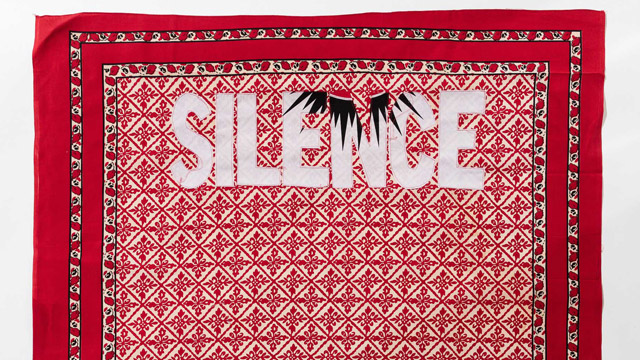
-
 Bernadette Van Haute
Bernadette Van HauteLawrence Lemaoana’s work, entitled SILENCE … FALLS (2017) consists of Kanga fabric with cotton embroidery, measuring 155 x 115 cm. Lemaoana is a South African black male, born in Johannesburg in 1982, who lives and works in Johannesburg. The work serves as an example of the ways in which young black artists in South Africa aim to express a specific South African identity which appeals to the global art world.
The use of Kanga fabric as medium is in itself very significant. Lemaoana states that: "Kanga fabrics [...] are used extensively in my work. Manufactured in the East, and brought to South Africa to be sold in markets and bazaars, the journey of the fabrics speaks of the idiosyncrasies and trade imbalances of globalisation. The textiles themselves though have a wholly different life in South Africa – they are regarded as significant markers of spiritual healing, imbued with great religious and spiritual power, used by diviners and fortune-tellers." (Afronova)
The Kanga cloth is “used specifically in Emandzawe rituals, both as clothing for the sangoma [diviner] performing the ritual and as cloth on the shrine inside the shrine room in which the ritual takes place” (von Veh, 2017, pp. 13-14). The use of this fabric thus establishes Lemaoana’s identification with both global culture and black African culture which does not belong to a mythical past but is still very much alive today. His own familiarity with the sangoma becomes clear when he maintains that the ambiguity of the traditional healer’s utterings parallels that of headlines in the news media. He also exploits the deeper meaning embedded in the three colours white, red and black to heighten the impact of his highly topical messages.
Lemaoana’s work is inspired by current socio-political events and the way in which they are reported in the local media. The composition Silence Falls evokes the #RhodesMustFall movement which began in 2015. This demonstrates the artist’s concern with the plight of the South African youth and his identity as an artist born in the 1980s – the so-called ‘born-frees’ who did not actually experience the ‘struggle’. The works of this generation of artists are described as “symptomatic of the new identity issues of the post-apartheid era. This young generation is appropriating a history that it believes has been confiscated and twisted in order to develop an alternative that takes into account its own subjective experience. Conscious of their responsibilities, these artists are helping to formulate and affirm a specific South African identity” (Pagé and Scherf, 2017, p. 8).
Lemaoana expresses his concern with socio-political issues through a critical engagement with mass media in South Africa. He is particularly concerned by the ability of the local media to shape social consciousness. By isolating news headlines and appropriating political slogans in his very own cynical way he “turns didactic and propagandistic tools on their head” (Afronova). As Lepage (2017, p. 117) states, Lemaoana uses the power of “words as favoured instruments in the political struggle”.
The importance of Lemaoana’s work is vested in his participation in the Fondation Louis Vuitton exhibition in Paris in 2017. The exhibition was divided in three parts; the first one was entitled Being there: South Africa, a contemporary scene and aimed to show South African vitality through the works of 16 artists. In the accompanying catalogue the curators Suzanne Pagé and Angeline Scherf (2017, p. 8) explained that their choice of artists was “based primarily on the action of the artists themselves, on their engagement with the current economic and social institutions, their awareness and conviction that they can act and play a role: BEING THERE”.
Interestingly the curators also comment on the fact that this younger generation of artists, in the context of ongoing economic and social divisions more than two decades after the end of Apartheid, sees it as its mission to transform “disenchantment into the energy for renewal” (Pagé and Scherf, 2017, p. 8). Achille Mbembe (2017, p. 16) elaborates on the current tensions in South African politics and culture which have led to a stalemate. In a society where consumption has become the quintessential state of being, the visual arts are in crisis, characterised by radical fragmentation and dispersion of reality (Mbembe 2017, pp. 23-24). “What is needed in contemporary South African arts”, writes Mbembe (2017, p. 24), “are concepts with which to seek out the real … . This will not happen without a new collective imagination that will help to facilitate the passage from the past and present to the future”.
This is what Lemaoana has achieved in his art. His participation in the show confirms his status as a contemporary South African artist who has managed to decolonise his art by “seeking out the real” and grounding it in a local or national context. Furthermore, in Lemaoana’s works there is no room for, what Mbembe (2017, p. 25) calls, “tropes of pain and suffering” or the injuries inflicted “by the forces of racism and patriarchy” – tropes that are the characteristic traps of postcolonial discourse. His art is decolonised in the sense that all the resources of cultural and artistic modernity – both in terms of medium and narrative – have been mobilised in order to render itself more relevant to a modern Africa and a global humanity (Ekpo, 2017, p. 20).
References
- Afronova. http://www.afronova.com/artists/lawrence-lemaoana-2/ (accessed on September 19, 2017).
- Ekpo, D. (2017). Manifesto for a Post-African art. Unpublished keynote address presented at the SAVAH Conference, Tshwane University of Technology, South Africa, September 21 – 23, 2017.
- Lepage, A. (2017). Lawrence Lemaoana. In S. Pagé & A. Scherf (Eds.), Being there: South Africa, a contemporary scene (pp. 116-21). Paris: Fondation Louis Vuitton and Editions Dilecta.
- Mbembe, A. (2017). Difference and repetition. Reflections on South Africa today. In S. Pagé & A. Scherf (Eds.), Being there: South Africa, a contemporary scene (pp. 15-25). Paris: Fondation Louis Vuitton and Editions Dilecta.
- Pagé, S. & Scherf, A. (Eds.). (2017). Being there: South Africa, a contemporary scene. Exhibition catalogue. Paris: Fondation Louis Vuitton and Editions Dilecta.
- von Veh, K. (2017). Textual Textiles: Gender and Political Parodies in the Work of Lawrence Lemaoana, TEXTILE,1-19. doi: 10.1080/14759756.2017.1337381 (Accessed September 5, 2017).
published March 2020
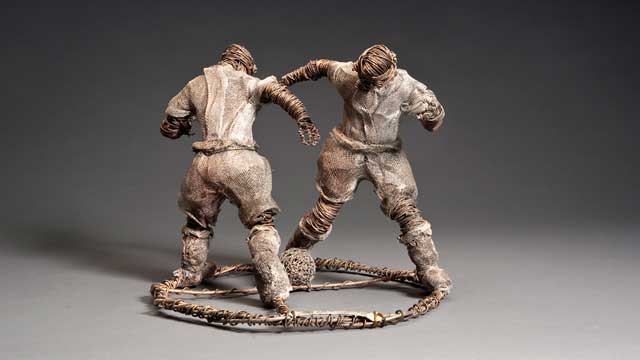
-
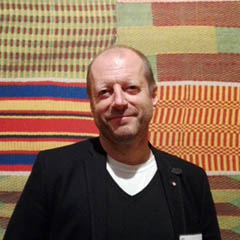 Stefan Eisenhofer
Stefan EisenhoferHis artistic production is informed by the basic concepts of "love", "peace" and "liberty", and he expressly hopes that his works will help to create a better future.
Since 1996, after twenty-five years of working with clay, plaster, stone, cement and wood, Joe Big-Big has mainly used wire, iron nets and barbed wire to produce works with a very characteristic signature. Through the use of metal nets, he produces an effect of lightness and dynamism, even in sculptures several metres high. It was his fondness for big and high sculptures that earned him the nickname Big-Big.
Through his choice of materials he reveals the preoccupations that inform his work: he believes that people are free to decide whether they want to produce or destroy something, to encourage or suppress. In Joe Big-Big's work, wire and barbed wire, commonly symbols of oppression, captivity and division, represent the overcoming of bondage: they stand for prevention and protection. Joe Big-Big plays here with the notion of wire as an everyday material that normally goes unheeded, but which can become an instrument of human creativeness and global understanding through artistic activity. However, in Joe Big-Big's work this metal material seldom loses its ambivalence – for it is also a symbol of human labour and human toil. The artist makes use of these associations in works showing toiling people.
Joe Big-Big is intensely interested in the iconology of his metal materials and the objects he integrates into his works. Padlocks, for instance, symbolize the difficulties we get ourselves into, while keys stand for solving problems, freedom, peace and happiness. Coins represent the money we need to live, and clocks or watches are references to the time we need for solving our problems on the way to a carefree future. The metal materials thus symbolize wealth, strength and power. The artist also deliberately combines old with new metals, as a reminder that one needs to remember the old in order to be able to cope with the present and the future.
The themes taken up by Joe Big-Big come from nearly all areas of human life. His works are concerned with very personal issues as well as with political topics, such as war, poverty, flight, displacement, or the equality of women. He believes that his images speak louder than words, and he intends them to arouse emotions in the viewer, for "art without emotion, feeling or meaning is like a voice or a noise without meaning".
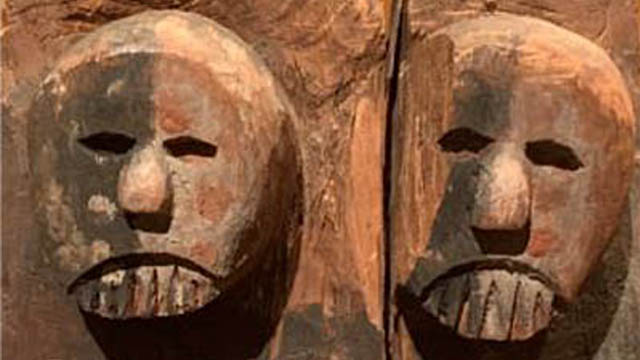
-
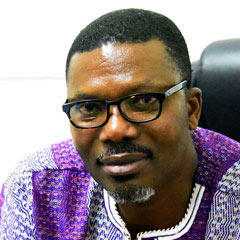 Patrique deGraft-Yankson
Patrique deGraft-YanksonExploring an Enigmatic Piece of Traditional Cameroonian Sculptur
The Veranda Post found in Museum Fünf Kontinente is an exemplification of the extent to which indigenous Africans mutually reinforced socio-religio-cultural existence and expressiveness of form through sculpture. Various examples of these artefacts abound in the collections of African plastic artforms found in many museums across the globe. The beauty in experiencing, analysing and speaking about this artwork (as well as many of its kind), lies within the absence of authenticated historical and analytical literature on them. This makes it possible for the observer to exert complete authority of personal perception and interpretation devoid of any fixed attitude that dictates, interfere or curtails aesthetic enjoyments, interpretations and judgements, as attempted in this presentation.
With the dimensions of 199 x 60 x 50 cm, the Veranda Post found in Museum Fünf Kontinente is one of the numerous examples of the African artistic expressiveness, confirming the artistic prowess of the traditional African. Examples of these artefacts abound in the collections of African plastic artforms which record indigenous religious beliefs, practices and performances that date back from the beginning of African history.
As typical of most indigenous African sculptures, this work is not only uncaptioned, but the artist/creator is not known. What is known, however is that, its peculiar characteristics and style makes it easily identifiable and representative within the milieu of popular African sculptures. According to the Museum Fünf Kontinente records, this work was collected from 'Kamerun'. 'Kamerun' was an African colony of the German Empire between 1884 and 1916, which was located in the region of today's Republic of Cameroon (Wikipedia, 2020). Comparing the characteristic features of this sculpture with similar sculptures described by some art historians as Veranda Posts created as part of ancient African monumental architectures found in the Cameroons Grassland (Willett 1981) therefore, it is not difficult place it within that category. Hence its caption.
As can been seen from similar ‘posts’ and judging from the elaborateness of the images created on them, the major reason for the production of these posts was more to afford the sculptor or sculptors the opportunity to decorate the buildings with stories, rather than serving as supports (see figure 1).

Figure 1: Ancestor statues, carved door-frame and verandah posts (Source: Willett 1981)
As said above, the beauty in analysing and speaking about this artwork (and many of its kind), lies within the absence of historical and analytical literature. The fact that this makes it possible for me (and for that matter any other observer) to exercise personal powers of perception and interpretation without any fixed attitude to direct or curtail their aesthetic interpretations and judgements made it my object of choice for this project at the Museum Fünf Kontinente.
Going by Margaret Trowell’s generalisations about African art, this Veranda Post can be classified under the ‘spirit-regarding’ art. Like many others of its kind, this work, which has front and back views, is flanked with human and other figures, ostensibly those of ancestors and is symmetrically disposed about a vertical axis, rendering it frontal at both sides.
Analyses of the images created on this pole reveal striking similarities between the age old traditional religious practices of the African and the Western religious beliefs and practices brought in by the earlier missionaries.
At the direct look of the object from the front (as it has been positioned at the museum, but actually one of its two sides), a prominent kneeling figure with hands clasped together unto the chest (much like the praying hand) can be seen in a pose that looks very much like the kneeling praying postures at Christian worships. To the African, this posture is not only assumed at prayer sessions as a visual image of submission to God’s authority, but is also exhibited as a sign of respect, humility and total surrender to a superior authority. For the sculptor to present the kneeling man as a central figure and subsequently rendering all other human figures in similar submissive postures therefore makes the theme of prayer, submissiveness and spirituality very strong in the composition.

Figure 2: The kneeling or praying figure
The kneeling man is placed right below two human faces whose prominence and positioning easily pass them for elders, superiors, or better still, ancestors. Before the ancestors, all supplications are made, and through them, request are carried through to the supreme God.
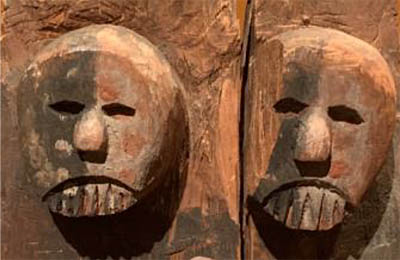
Figure 3: Ancestor figures
The importance of the two faces and emphasis on their superiority is further strengthened by a strong demarcation between them and the kneeling man through a thick rigid contoured line that forms a partition between the elements. This could be interpreted as a spiritual borderline that separate the spiritual world from the physical world. Generally, the African believes in the existence of the physical and the spiritual worlds as separate entities and this demarcation clearly depicts this belief. Also worthy of notice is the orientation of the demarcating border which rhymes with the praying hands of the kneeling figure, thereby visually connecting the figures. This carefully chosen placement of the two faces in the composition alludes to the supremacy of the ancestors and their exclusive existence in the after world as well as their connection with humans.
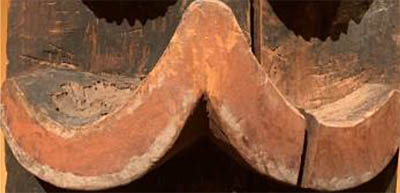
Figure 4: The spiritual borderline
Another striking imagery is created with the placement of a very visible image rendered in concentric circles. Among many African ethnic groups, the circle represents completeness, holiness, perfection and other such attributes ascribed to the supreme being (God). Among the Akan people of Ghana, for instance, the Adinkra symbol called Adinkrahene (king of Adinkra symbols) is presented as concentric circles. This symbol represents authority, leadership and charisma. The sculptor most likely created a bull’s eye of this symbol as an indication of exactly where this particular post belongs. The post could possibly be one of the furnishes for a palace or the abode of a traditional priest. This could also suggest the likelihood of the prominent kneeling figure being the King or the chief priest. Considering the atmosphere created by these symbols, the circle, with the kind of prominence it exudes could also represent the omnipresence of the supreme being, thereby heralding the people’s belief in the iniquitousness of God and His closeness to mankind.
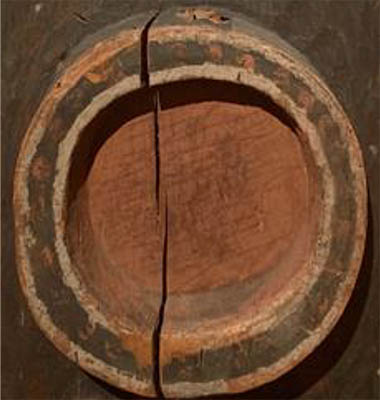
Figure 5: The concentric circles
Other recognizable images of animate and inanimate objects in the work include crocodiles, lizards and geometric shapes. Whilst it is likely that the geometric figures may have been deliberately presented to create balance, simulate a built living environment and arouse aesthetic sensibilities, the images of animals like those of the crocodiles have significant meanings as far as African culture and belief systems are concerned. Among some ethnic groups in Africa, crocodiles are believed to be the souls of ancestors who come back to live with men. Examples are the crocodiles in the Crocodile Pond at Paga in the northern part of Ghana who virtually live peacefully among the people. There are numerous African stories about crocodiles coming to the aid of men to either protect them or lead them to safety. Their inclusion in this particular work therefore is to establish the existence of spirits among men, especially as humans pray to seek their guidance and protection.
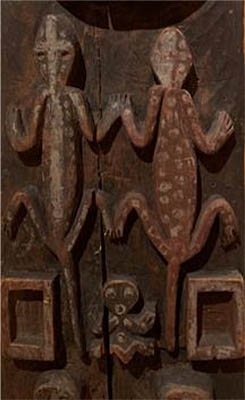
Figure 6: The crocodiles
Considering where it was created and where it is located now, as well as the current effort towards extracting a meaning out of its symbolism, this veranda post and many other such African artefacts in several museums around the globe have demonstrated how images and symbols resonate relationship between cultural practices around the world. The confluence of symbolic interpretations of the icons in the traditional African religions and the Euro-Christian religion, as depicted in this veranda post, gives justification to Africa’s unquestionable acceptance of Euro-Christianity and all the associated visual cultural practices.
For comparison, also read Karin Guggeis' analysis of this object here.
References
- Roy, C. (2019). Signs and Symbols in African Art: Graphic Patterns in Burkina Faso. Signs and Symbols in African Art: Graphic Patterns in Burkina Faso. https://africa.uima.uiowa.edu/topic-essays/show/38?start=13
- Wikipedia. (2020). Kamerun. Kamerun. https://en.wikipedia.org/wiki/Cameroon
- Willett, F. (1981). African Art. London: Thames and Hudson.
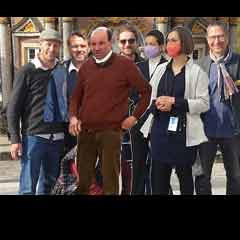 ISB_Team
ISB_TeamThis 'Veranda Post' is variously referred to (mostly in relation to its architectural-functional context) lintel or "te ken dy dye" (in the local Bandjoun language - PHSAA), porch post, house front pillar, post, cult house post (M5K, p. 17), Cameroon post / family crest (Macke at M5K, 13, 24). Post, however, in the sense of sign (post-it) is suggested by PdGY to address the communicative function. Other designations do not address the function, but limit themselves to the given, perhaps to avoid any pre-interpretation: 'sculpted wooden block' (Kecskési 1999 n. 108) or 'large carved square wooden block' (Kecskési 1976, p. 22).
Object biography: The object was taken before 1893 by Max von Stetten during expeditions on the Bamileke Plateau (south-western Cameroon), where it was presumably part of a meeting house of a confederation. Stetten (1860-1925) was German commander of the Kaiserliche Schutztruppe for Cameroon until 1896. Cameroon was a German colony at that time. The exact circumstances of how the object came into Stetten's possession are unknown, as is its original location and context.[2] In 1893, the Royal Ethnographic Collection acquired the pillar as a gift from Stetten.[3] In 1912, a photograph of the pillar was published in the Almanac of the Blaue Reiter. It is currently on display in the permanent exhibition in the Museum Fünf Kontinente Munich in a niche - a mirror allows a view of the second side (see Fig. 2). Along with other objects from the collection, it is currently the subject of a transnational project on their provenance (GI).
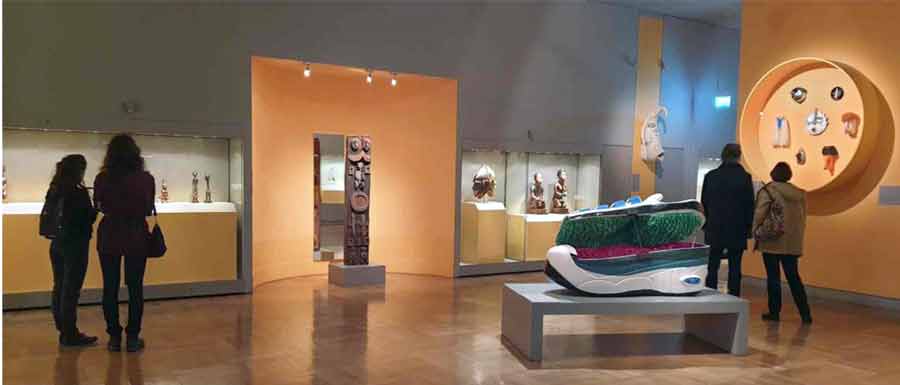
Fig. 2
Status: In comparison with carved mullions on façades of royal residences in the Cameroon grasslands (Fig. 3),[4] other mullions or door frames in the Museum Five Continents (M5K, p. 17, Kecskési 1999 No. 11, 70, 75) or in the Humboldt Forum Berlin, there is a partial similarity of motifs, but a strikingly 'archaic' formal language. Other examples are clearly more 'elaborate'. The multitude suggests that this type of pillar is quite typical of works from this period in this region of West Africa.
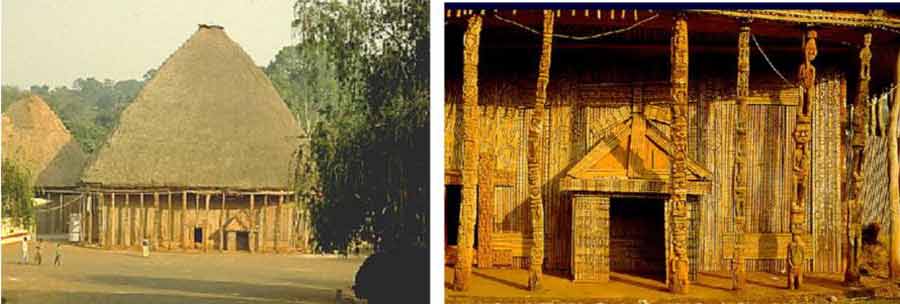
Fig. 3
Interpretation
The current view of the work
For the interpretation, the following questions lend themselves to art lessons: Form, iconography (meaning of the motifs), function, theme (or core idea) of the object, i.e. an interpretation.
With regard to the guiding idea of multi-perspectivity, two positions will be addressed: On the one hand, the view of today on the basis of ascertainable contexts, which seeks to understand the object from its time of origin and its context of origin. On the other hand, the view of the object by the artists of the Blaue Reiter. The comparison of these perspectives seems particularly relevant from an art didactic point of view, even though other perspectives would be conceivable, e.g. from the point of view of museology, provenance research, from the context of current restitution debates, etc. However, these are addressed in the teaching suggestions.
Shape
At first, the pillar develops an immediate physical presence for the visitor: through its sheer size (larger than life, almost square in plan), the materiality of the massive, cracked block of wood (the outline is irregular and probably corresponds to the tree) and the clear, concise, reduced language of form, whose meaning seems inaccessible. The surface treatment is archaic, the wood is more hewn than carved.[5] Thus it appears powerful and at the same time mysterious, which is supported by its presentation in the exhibition on a plinth and without glazing (see Fig. 4).
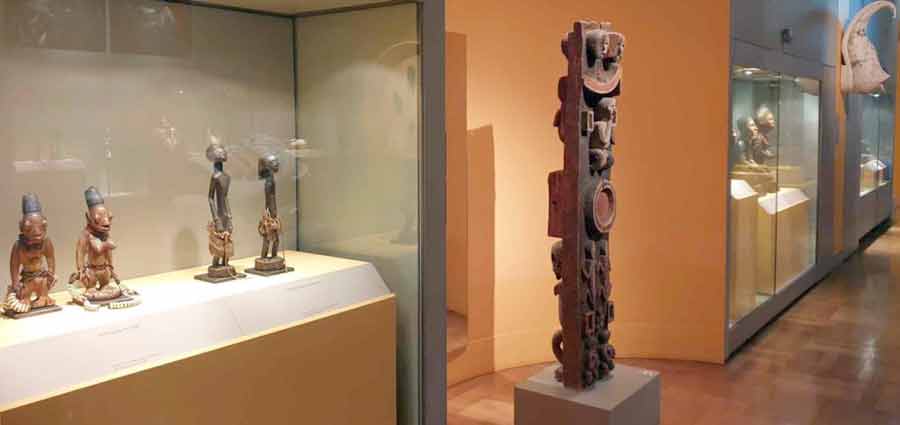
Fig. 4
A closer look reveals how the sculptor interweaves various modes of representation between complete abstraction (circle, rectangle) and representationalism (human figures, animals) in a compositional way[6] , monumentalising the individual motifs through internal symmetry, geometrisation, frontality and statics. This is supported by the painting (see Fig. 5). In this reduction, everything narrative is missing. The representation becomes emblematic, it becomes a symbol.
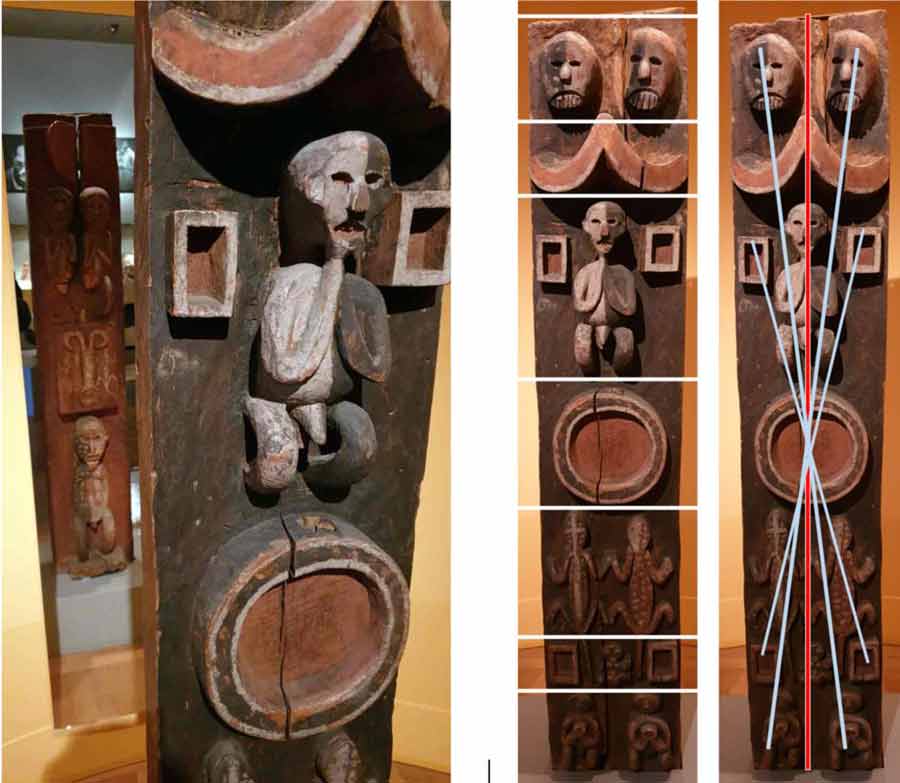
Fig. 5, 6 and 7
This is also supported by the overall composition, which obviously follows a calculated geometric order. It is strictly horizontally divided into individual zones, only once do lizard tails protrude into another zone. However, the separation into individual layers is ingeniously overcome compositionally by the strict axial symmetry in the vertical, but also by the point-symmetrical arrangement around the respective centres. The result is a tension between the contradictory compositional principles (see Figs. 6 and 7) that is decisive for the effect of the pillar.
The lack of any narrative on the one hand and the high creative effort on the other underline once again that it is about a symbolic level. This can perhaps be deciphered, even if its immediate complex order makes it seem above all direct, sensual.
The secure decoding of the iconography (what the individual motifs as well as the arrangement meant in the context of origin) is not possible with today's state of knowledge. Oral culture has left no written sources that could be consulted. Moreover, the oral tradition has been torn down - not least due to colonial destruction. However, since the work obviously has a symbolic language with clear iconography, this level cannot be left out in art lessons. German-language literature and oral experts from West Africa were consulted here. The results contradict each other, but nevertheless yield a court of meaning (see Fig. 8, in which the individual attributions of meaning are named)[7] , which provides a certain direction.
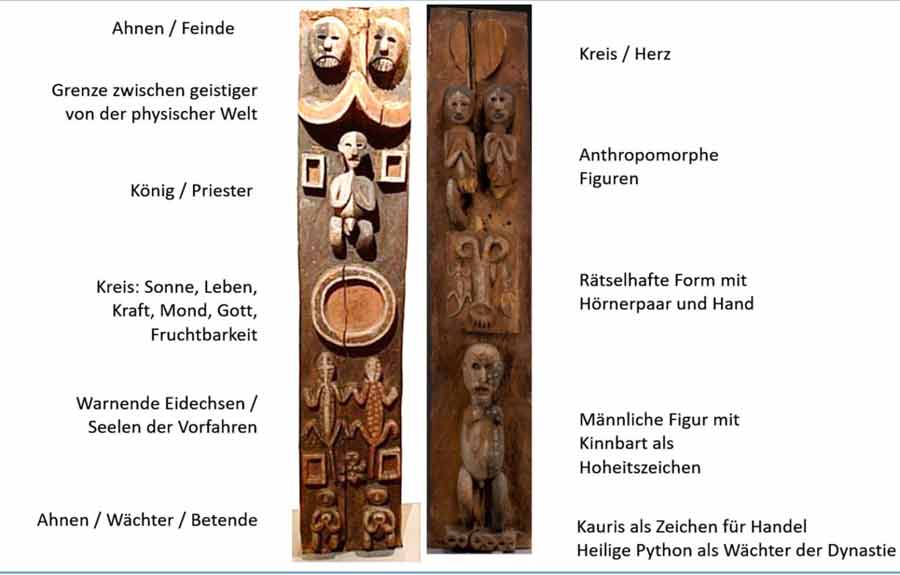
Fig. 8
In addition, the block is painted in three colours. These also carry meanings: Black could symbolise suffering, white could be the colour of the dead and symbolise mystery, red, the colour of blood, symbolises life (PHSAA). The light-dark contrasts themselves symbolise life and death (Kecskési 1999).
Function
PdGY suspects that the pillar - as part of the architecture of the house - stood at the spatial interface with the public (on a path) in order to communicate the significance of the house, presumably a cult house, to the outside. The object could therefore have been part of the façade of a particularly distinguished house[8] , also with a supporting function for the roof. It communicates what happens in the house or who lives or resides there.
Kecskési, on the other hand, considers a free positioning in space (Kecskési 1976, p. 22) and suspects an ancestral tablet. This in turn would fit the following determination by Gouaffo: "The 'Blue Rider Post' is a spiritual object. According to oral traditions, the object was placed in the sacred house like a statue. Caps, chains, bags or skeletons could hang from the object. Secret societies like the 'Losango' used the statue to perform certain rites, for example to cleanse the village of evil spirits." (Albert Gouaffo in GI) KG also suspects the context of a meeting house of such a secret society. Common to all assumptions is that the pillar stood in the context of a house with a sacred or cultic function.
'Theme' of the object: Basically, three different levels can be delimited, some complementary, some contradictory. First, the communication function on the façade or at the entrance to the outside. Then the pictorial formulation of a certain understanding of human being-in-the-world is asserted; man is ultimately embedded cosmologically.[9] At the Humboldtforum Berlin, in turn, such pillars from West Cameroon are also seen as the "architecture of power", power exercised by the rulers or the secret societies through impressing and deterring.[10]
Second perspective
The interpretation provided above can be countered by a second perception of the pillar, as it appears in the almanac "Der Blaue Reiter". This almanac, an artist's book, was published in 1912 by Franz Marc and Wassily Kandinsky. The reception of this book is over a hundred years old, but it is significant for the development of European art, as it is a good example of how artists of this time created a new frame of reference by referring to non-European art. In this respect, the Blaue Reiter clearly differs from Cubism, Expressionism or Dadaism, which were all being developed at the same time.
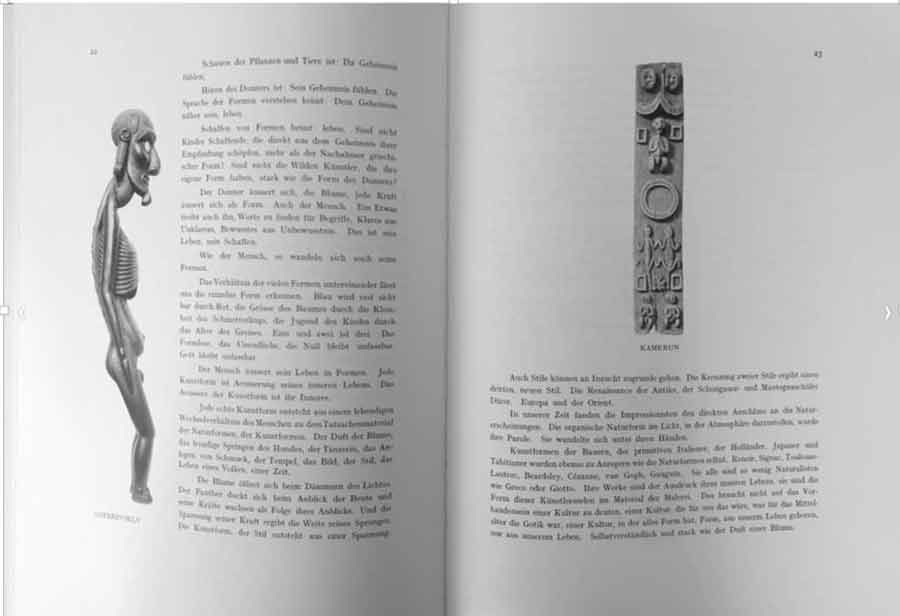
Fig. 9
In the Almanac, on pages 21 to 27, there is an essay by the painter August Macke entitled "Die Masken" (The Masks), in which a relatively small illustration of the pillar in question is embedded (see Fig. 9). Macke's contribution, like all the other texts in the Almanac, was probably written at a joint meeting of Macke, Marc, Münter and Kandinsky in Murnau.[11]
Visits to ethnographic museums are documented above all for Wassily Kandinsky, who was a trained ethnologist, and Franz Marc. Marc had also admired sculptures from Cameroon in particular during his visit to the Berlin Ethnographic Museum in 1911. And it was he who was ultimately responsible for the insertion of the photograph of the post in Macke's article.[12] In his letters to Macke, Marc writes about this. On 14.1.1911 about the objects from Cameroon in the Berlin Ethnological Museum: "I remained amazed and shaken by the carvings of the Cameroonians"; and later that he would furnish Macke's article in the Almanac with "ethnographic wonders" (MW).[13] In the text itself there is a single, very brief reference to "carved and painted pillars in a Negro hut", by which presumably the post was meant.
The text itself represents Macke's conception of art. In it, "intangible ideas", "mysterious forces", an "invisible God" express themselves in the world of appearances and "cultic expressions". The invisible materialises in the visible. This realm of the visible includes not only art, such as that of Giotto or van Gogh, who are classified as 'primitive', but also nature. Children's drawings, the folk art of the 'primitives' and 'savages' or non-European cultural forms are also expressions of the mysteriously invisible. These themselves are - and this is decisive - equal to each other. There is no hierarchy, no distinction between high and low, between high art and popular culture. All forms speak - as Macke characterises it - in "strong language". For Macke, the pillar in the museum is then an example of "the tangible form for an intangible idea, the personification of an abstract concept" (Macke 24). He also calls this the figure of an "idol".
The approach underlying this thinking sounds familiar; we have known it since the Platonic theory of ideas. However, this approach does not justify the selection of this particular post, as other posts from the museum's collection would also have been available.[14] Here one can only assume. I suspect that there are various factors that led to the selection: the archaic power of the forms; the initially wild and carefree-looking, additive combination (or montage) of the various principles of representation in the individual motifs (concrete - abstracted, geometric - organic, symbolising - depicting), which on closer inspection, however, then reveals itself to be consciously composed; or the coarse, physically perceptible materiality of the cracked, thick block of wood in impressive dimensions. PdGY also speaks of "wonderfully composed".
In the work, everything is represented with great sensual power that is the opposite of an "empty" image in European "cultures that have already passed through a thousand-year course, like [...] Italian Renaissance" (Macke 24) and from which Macke renounces: "We must bravely renounce almost everything that has hitherto been dear and indispensable to us as good Central Europeans [...] in order to get out of the fatigue of our European lack of taste". (Macke ibid.)
In art lessons, the question arises to what extent the image that Marc or Macke create of the pillar (as representative of the idea of an idol) goes together with what the object presumably was and is in its original context. Or to put it another way: are they designing a certain, exotic image that does not correspond to the object itself? [15]
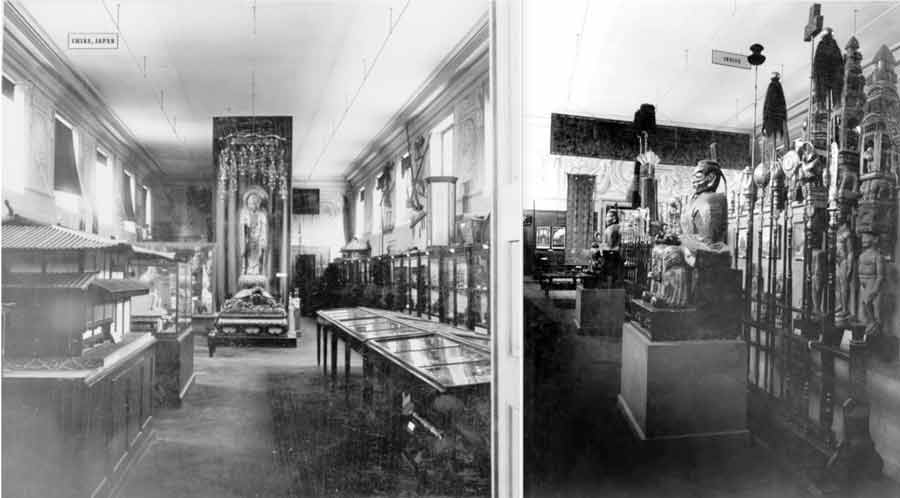
Fig. 10 Historical photos of the exhibition of the India Department in the Munich Museum around 1910 (source M5K)
References
- GI: Juliane Glahn and Marta Krus: CAMERUNS RIGHT TO CULTURAL OBJECTS. https://www.de/prj/zei/de/pos/22656808.html
- Kecskési 1999: Maria Kecskési. Art from Africa - Museum of Ethnology Munich. Munich (Prestel) 1999
- Kecskési 1976: Catalogue for the exhibition African Art. Andreas Lommel (ed.). Munich (Bruckmann) 1976
- M5K: Staatliches Museum für Völkerkunde München (ed.). The Blaue Reiter and the Munich Museum of Ethnology. Munich (Hirmer) 2009
- KG: Karin Guggeis. The Blue Rider Post. (2021): https://www.explore-vc.org/en/objects/expanding-the-canon-of-art-at-the-global-north.html
- PdGY: Patrique deGraft-Yankson. The Veranda Post. (2019) https://www.explore-vc.org/en/objects/the-veranda-post.html and oral interview on 23.4.2022 in Bayreuth, Iwalewahaus.
- PHSAA: Paul-Henri Souvenir Assako Assako. Information by email 20.5.2022
- Wikipedia: Cameroon & Max von Stetten
- MW: Macke Wolfgang (ed.). August Macke - Franz Marc: Briefwechsel, Texte und Perspektiven. 1964. Cologne (DuMont).
- Macke: Macke August. The Masks. In: Almanac "Der Blaue Reiter", 1912, edited by Franz Marc and Wassily Kandinsky, pp. 21-27
Appendix on iconography
- Anthropomorphic figures: ancestral couples / guardians and protectors of the royal residence. These anthropomorphic figures are treated with respect as extraordinary personalities. They are considered ensouled beings, spirits with supernatural powers. (PHSAA) Depiction of all human figures in similar postures: theme of prayer and submission to spirituality. (PdGY)
'Front' side from bottom to top:
- Two people: Ancestral couples / guardians and protectors of the royal residence (PHSAA). People pray for the guidance and protection of the ancestors (PdGY).
- Lizards: The symbol of the lizard warns everyone; it symbolises death. (PHSAA) PdGY sees here two crocodiles (ancestral souls returning to live with humans) instead of lizards.
- Circle: motif of the sun, symbol of life and power; the moon, image of woman and symbol of fertility. (PHSAA) The circle represents completeness, holiness, perfection and other attributes attributed to the supreme being (God). (PdGY)
- Kneeling figure: King or priest (PdGY)
- Line of demarcation between the spiritual and the physical world
- Two heads above: Ancestors (PdGY)
'Back' side from bottom to top:
- Python (geometric frieze at the bottom of the 'back' side): royal totem/sacred python, guardian of the dynasty (PHSAA).
- Male figure with chin beard as emblem of sovereignty (Kecskési 1999)
- Enigmatic form with a pair of horns ending in a hand (?) at the bottom (Kecskési) on a rectangle with two flanking lizards.
- Anthropomorphic figures
- Circular area
Footnotes
[1] The object is variously referred to, mostly in relation to its architectural-functional context: lintel or "te ken dy dye" (in the local Bandjoun language - PHSAA), porch post, house front pillar, post, cult house post (M5K, p. 17), Cameroon post / family crest (Macke at M5K, 13, 24). Post, however, in the sense of sign (post-it) is suggested by PdGY to address the communicative function. Other designations do not address the function, but limit themselves to the given, perhaps to avoid any pre-interpretation: 'sculpted wooden block' (Kecskési 1999 n. 108) or 'large carved square wooden block' (Kecskési 1976, p. 22).
[2] The first German trading posts were established in Cameroon as early as 1868, and in 1891 German military "expeditions" were launched in Cameroon. In 1884, the German Consul General concluded protection treaties with regional rulers and thus proclaimed the protectorate of Cameroon as a German colony. The seizure of the hinterland, which included the grasslands, took place over the course of the following 30 years. (Wikipedia) Even if the provenance is still not clear today, one can certainly share the Humboldt Forum's assessment of such objects that - even if they were not looted through acts of war - they are nevertheless "an expression of unequal power relations and structural, colonial violence". (https://www.smb.museum/nachrichten/detail/ethnologisches-museum-weg-frei-fuer-die-rueckkehr-der-ngonnso-nach-kamerun/)
[3] In the entry book it is noted: "Gr. square block, 1.80 cm high made of heavy wood, carved on both sides with humans and lizards, heavily damaged by termites". (https://onlinedatenbank-museum-fuenf-kontinente.de/) In 1895 Stetten published detailed "Travelogues" in the Deutsches Kolonialblatt.
[4] http://www1.biologie.uni-hamburg.de/b-online/afrika/kamerun/palast.htm; http://www1.biologie.uni-hamburg.de/b-online/afrika/
[5] The block is almost certainly worked with a chisel.
[6] "decorated with geometric, anthropomorphic and zoomorphic forms" (PHSAA)
[7] All performers avoid a complete decoding. They only make suggestions for individual motifs.
[8] It could have been the house of a 'priest' whom one could consult there and through whom or ancestors one could pray to God (PdGY).
[9] "Expression of the cosmogony of the universe of the peoples of the Bamileke plateau; expression of the belief system" (PHSAA).
[10] The assertion of power is also included by PHSAA.
[11] Catalogue: August Macke, Lenbachhaus Munich, 1987, Bruckmann. Munich. S.164
[12] He simply titled the painting "Cameroon", the name of the country of origin (the country whose sculptures he admired).
[13] There are other illustrations in the text: a bird's head from Brazil, a figure from Easter Island (see Fig. 9), one from Mexico, a bird mask from New Caledonia, a cloak from Alaska[13] and a child's drawing entitled "Arabs". Except for the child's drawing, all objects are from the then Royal Ethnographic Collection in Munich (M5K, p.11). They are only titled with the respective country of origin, e.g. Cameroon. Macke was obviously involved in the selection as well as the layout, as his layout sketch shows (M5K 24).
[14] It is not certain what was shown in the presentation at the Royal Ethnographic Collection in Munich at the time, which covered 400 square metres in six rooms in the north wing of the Hofgarten arcades in Munich. The only thing that is certain is that photos of the ten objects depicted, which came from various parts of the world, were lent to the artists for the publication of the Almanac. Photos of the presentation do not exist. "Whether Marc and Macke [actually also] saw the work in the exhibition at that time can be assumed with a high degree of probability, since it is after all very large and thus impressive." (Information Karin Guggeis 26.7.2022)
[15] In this context, it seems of interest that neither Marc nor Macke take up in their own pictorial language the aesthetics of the non-European works they "celebrate" here.
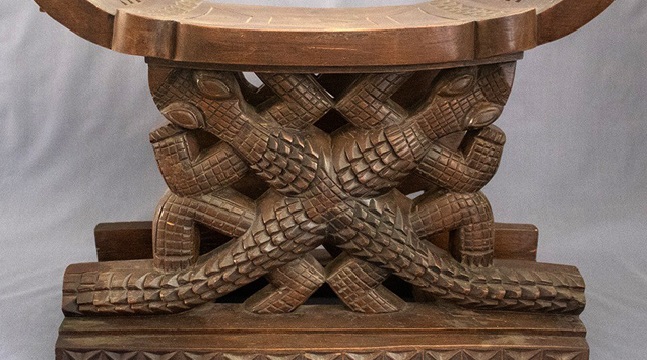
-
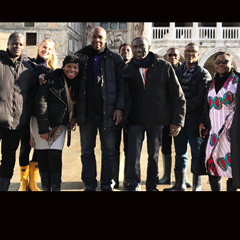 UEW Team
UEW TeamThe Funtumfunefu-Dԑnkyԑmfunefu stool is a carved traditional wooden stool designed with an Akan symbol known as Funtumfunefu-Dԑnkyԑmfunefu (pronounced ‘fuun-tum-fu-ne-fu den-cheem-fu-ne-fu). This type of stool called asԑsԑgua in Fante (a dialect of Akan people from Ghana) is an art-cum-utilitarian object. It is basically composed of three main parts namely the animu (top) which is the seat; the mfinfinin (middle) which bears the design that gives identity to the stool; and the wiabour (base) which is the part that touches the ground and gives stability to the stool (Antubam, 1963; Amenuke, Dogbe, Asare & Ayiku, 1991). In this particular image, the middle portion, which is the focal consideration for this presentation, is created with the Funtumfunefu-Dԑnkyԑmfunefu symbol. The size of the stool is composed of a base that measures 53cm x 28cm, the top arc-shaped seat that gives the stool a length of 55cm and an overall height of 42.5cm.
The stool was presented as a special gift to the Chairman of the Provisional National Defence Council (PNDC), who doubled as the then Head of State, Flight Lieutenant Jerry John Rawlings by the Chiefs and people of Dormaa in the Bono Region of Ghana. It was brought to the Ghana National Museum through the State protocol in 1992. Flight Lieutenant Jerry John Rawlings led Armed Forces Revolutionary Council (A.F.R.C) to power through coup d’état on June 4, 1979 and prepared the grounds for the coming of the third republican constitution. In the same year, Dr. Hilla Limann was inaugurated as the president of the third republic after winning the election. Rawlings returned to power on December 31, 1981 through another military takeover with his Provisional National Defence Council (P.N. D.C) of which he was the chair. Rawlings’ PNDC party stayed in power for almost eleven years before working out for the adoption of the Fourth Republican constitution through a referendum on April 28, 1992 (Essel, 2019). Subsequently, presidential election was held, which he led the National Democratic Congress (NDC) to win. Though the exact date he received the stool as a gift is unknown, it might have been received within 1981 to 1992, judging from the period of his military regimes and constitutional terms of office before the Ghana National Museum received the stool as part of its collections.
The artist who carved this stool is anonymous. Within the context of the Ghanaian traditional creative work productions, this is not strange, since artworks produced in precolonial and traditional Ghanaian societies were hardly signed by the artists who produced them. This was because the artworks were communal, that is, they were produced for use by the community. The chiefs and kings had varied proficient artists in their courts or communities who produced artworks for the community. With the Funtumfunefu-Dԑnkyԑmfunefu stool being a special gift to the then president of the state, it might have been created by a revered and creative carving-artist in the Dormaa community.
The Funtumfunefu-Dԑnkyԑmfunefu symbol falls within tangible artistic creations which takes its name from the Akan expression for Siamese crocodile. Akan is a major Ghanaian language, which is spoken by about 48 percent of Ghana’s total population as first language, and by an additional 35 percent as additional first language or second language (2010 Population and Housing Census). The symbol derives its name from an Akan proverb which suggests that the Siamese crocodiles share a common stomach and yet struggle for food. Semantically, fun means stomach while funtum means ‘put together’ or ‘mixed together’. Funtum also represents the rubber tree that produces a milky sticky substance used to glue items together. Fu-ne-fu (literally, ‘stomach and stomach’) represents two stomachs joined together. Dԑnkyԑm is crocodile. Dԑnkyԑmfunefu, therefore, means ‘two crocodiles with stomachs joined together’. On the other hand, funtum, as verb, also means ‘to stir something up with tension’, generally producing dust. This also draws attention to the struggle or the confusion that comes with the two crocodiles struggling to feed.
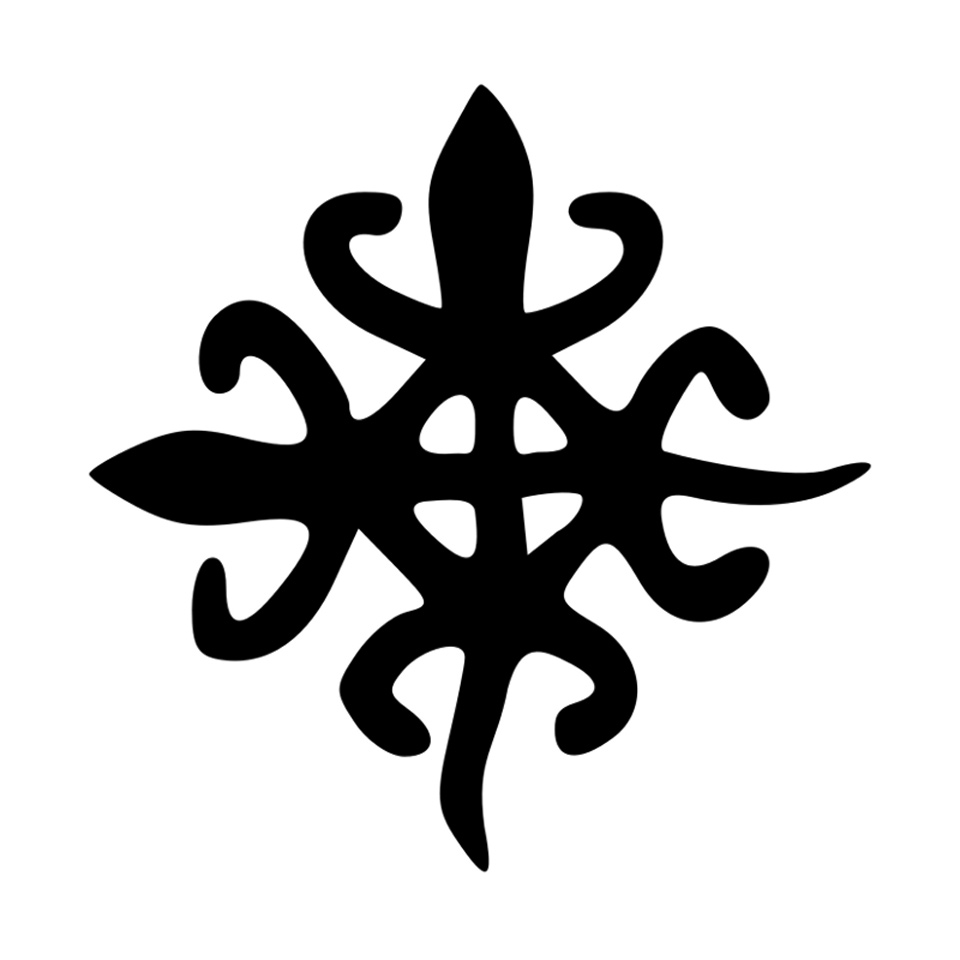
Funtumfunefu-Dԑnkyԑmfunefu symbol (Photo: the author)
The Funtumfunefu-Dԑnkyԑmfunefu symbol (see Figure above), is a graphical representation of two crocodiles rendered in silhouette in a perpendicular orientation with a conjoined and centred stomach, which is a common food receptacle. There are four juxtaposed arc-like lines interspersed and connected by four diagonal lines, creating a rhombic shape at the centre of the symbol. The four arc-shaped lines suggest the limbs, with the prominent sharp-tapered edges attached to the forelimbs placing emphasis on the cephalic regions. At a casual glance, the idealised limbs appear to be same in size, yet a close observation reveals that the forelimbs slightly outsize the hindlimbs. Two tadpole-shaped linearity with sharp-tapered edges placed perpendicularly to fuse with the limbs give a heightened impression of two reptile figures put together.
The Akan expression fun, which is the stomach in the case of the Siamese crocodiles, has two levels of meaning in Akan worldview, the superficial and the hidden. The Siamese crocodiles have a common stomach yet the two heads scramble for food. Each tongue yearns to have a taste of the food, though the gulps of food consumed by each enter a common receptacle. The complexity of this allegorical image could also be found in its multifaceted cultural interpretations.
Criteria for Selection (Educational Relevance & Quality)
The Funtumfunefu-Dԑnkyԑmfunefu symbol belongs to the family of Adinkra symbols. The symbols encapsulate the general Ghanaian philosophical thoughts and ideologies, cultural values, beliefs and practices. Its origin and first usage is traced to the Asante nation state, which is part of present day Ghana (Rattary, 1927). Its usage predates the 19th century as recorded by Bowdich (1819).
The multi-layered meaning of the Funtumfunefu-Dԑnkyԑmfunefu symbol tells its usefulness and educational relevance in the Ghanaian society. Due to its historical, socio-cultural and national importance in Ghana, Adinkra features in the design of decorative and functional artworks. The Funtumfunefu-Dԑnkyԑmfunefu symbol designed into carved wooden stool symbolises unity in diversity, democracy, shared destiny and female-male duality. Giving visual annotation to the idea of unity in diversity, the compositional structure of the Funtumfunefu-Dԑnkyԑmfunefu symbol shows formidable stability, an attribute of unity. There is deliberate inflation of emphasis depicted by the prominent sharp tapered edges attached to the forelimbs, which connotes power, energy and aggressiveness in the process of scrambling for ‘food’ by the Siamese crocodile. Viewers who do not understand the true symbolism of the image sometimes greet the aggressive depiction and the centred common stomach with negative interpretation. However, in the same stable composition, the graceful movement that bedews the tadpole-shaped figures placed at right-angled position creates an impression of diversity.
Methods/Interpretation/Research Questions
The asԑsԑgua (stool) in Ghana symbolises the soul of the society and serves as inoffensive symbolic link between the people or the subjects and their head of state or king (Antubam, 1963). It implies that the stool has both political and nationalistic useful to the citizenry and their ruler. In this instance, the stool reminds its users and observers of the need to engage in activities that will lead to unity rather than divisive tendencies. It teaches the Ghanaian society of shared destiny and the need to strive for oneness irrespective of one’s political affiliation, social standing, physique or race. The integration of the Funtufunefu Denkyemfunefu symbol into the political significations of stool symbolism therefore combines the essence of communal leaving and nationalistic feeling with power and governance. Just as the Funtufunefu Denkyemfunefu stool symbolises unity in diversity, and nationalism, the coat of arms of Germany also symbolises national unity. In this sense, both are thematised on unity and national consciousness. Both designs are abstracted animal figures and play allegorical role in the semiotic interpretations of the symbols.
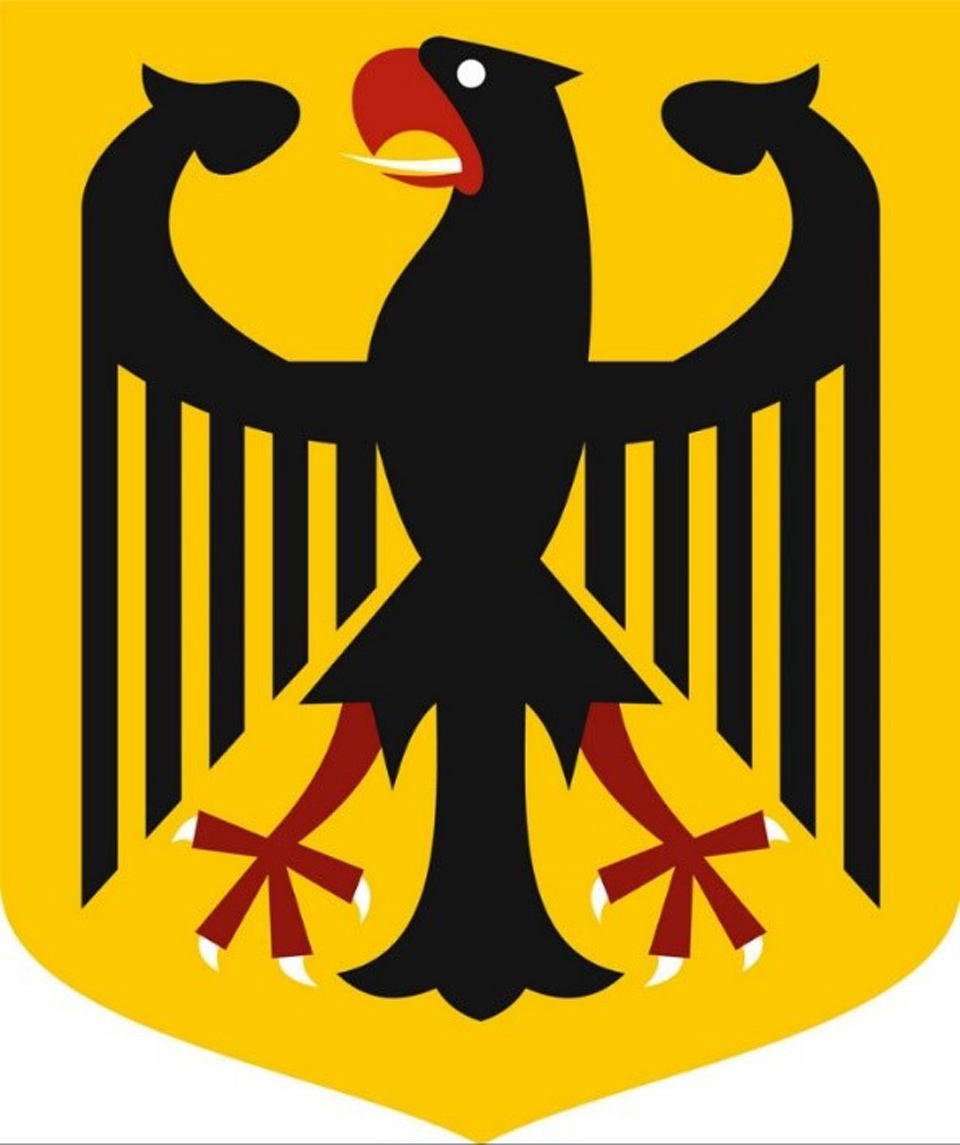
The coat of arms of Germany
https://de.wikipedia.org/wiki/Bundeswappen_Deutschlands [28.010.24]
In terms of artistic presentation, both were rendered in silhouette. The Funtufunefu Denkyemfunefu stool gives expressive meaning to unity by underscoring that individual difference, diverse shades of opinions and social standing that usually operate in the search for unity but must end in oneness of purpose for the national good. The broad vertical lines that conjoin the flanked arc-shaped lines to give impression of the wings of the eagle figure suggest strength, power and authority of the Germany coat of arms (Figure 3).
The common symbolic ideology in both the Germany coat of arms and the Funtufunefu Denkyemfunefu stool is to strive for oneness. Exploring the design concepts, socio-cultural and identity connections between these two images create opportunities for new levels of greater bilateral understanding and integration.
Obviously, interrogating images of this nature and identifying their essence within their traditional setting vis-à-vis other cultures is likely to help to eliminate prejudices about visual cultures among nations and reduce the barriers in visual communication.
References
- Amenuke, S. K., Dogbe, B. K., Asare, F. D. K., Ayiku, R. K., & Baffoe, A. (1991). General
- knowledge in art for senior secondary schools. London: Evans Brothers Ltd.
- Antubam, K. (1963). Ghana’s heritage of culture. Leipzag: Koehler & Amelang.
- Bowdich, T. E. (1819). Mission from Cape Coast Castle to Ashantee. London: Cass.doi: 10.1017/CBO9781107444621.
- Essel, O. Q. (2019). Dress fashion politics in Ghanaian presidential inauguration ceremonies from 1960 to 2017. Fashion and Textiles Review, 1(3), 35-55.
- Rattary, R. S. (1927). Religion and art in Ashanti. . London: Oxford University Press.
published March 2020
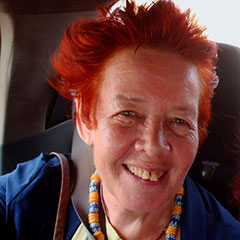 Bea Lundt
Bea LundtI am fascinated by the Ashanti-stool, being a symbol of soul of society, “to house the spirit of the Asante nation - living, dead and yet to be born” (Wikipedia), as it is described in this article. Travelling in Ghana very often, I had been told the background-story of this object again and again, so I know its importance to the people. Additionally, you can find several publications describing its meaning.
The beginnings are rooted in the 17th century when the Asante-confederacy was founded. As the legend tells, the Golden Stool fell from the sky as a religious legitimation of the King Osei Tutu, representing wealth and power of the region. During colonial times the Asante defended the stool against the British. They had been very successful to repulse the European invaders until they were finally beaten. So, for me the Golden Stool is also a symbol of anticolonial defence. People identified with this object as the representative symbol of their culture and protested any robbery of it. The stool as the main symbol of authority of the confederation gives the feeling of security and duration. Every 5th year it is presented to the public during the Akwasidae-Festival in Kumasi. As I read, there is also a Golden Stool of other ethnic groups, Denkyira and Ga. It is very interesting that this object can be constructed in different shapes and can also be decorated in quite different ways with additional meanings.
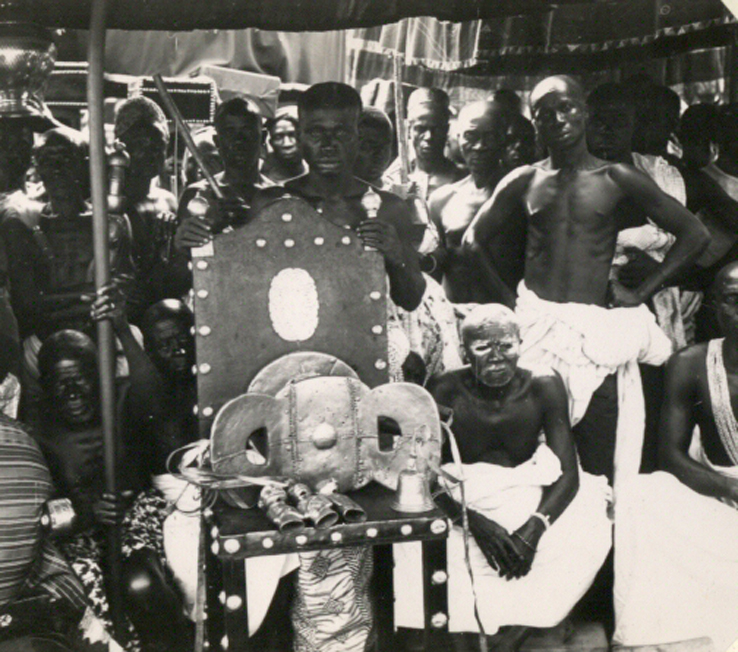
Golden Stool of Asante on its throne, the hwedom dwa, with its immediate caretaker (1935), United Kingdom Government, © public domain
One of the most exciting buildings I have ever seen, is the Golden Jubilee House (Flagstaff House) in Accra, which is the Presidential Palace and office of the President of Ghana (completed in 2009). Its architecture is following the model of the Golden Stool of the Ashanti people.

Golden Jubilee House - Flagstaff House (open access, https://commons.wikimedia.org/wiki/File:Golden_Jubilee_House.jpg)
The example of decoration which is chosen in this article is the Adinkra-symbol for „unity in diversity“. It always remembers me of the European story of Menenius Agrippa and the plebs, a narration which is bequeathed since Greek antiquity. It uses the body as metaphor for the society. The stomach is the symbol for the ruling elite. All the other parts of the body are in a revolt against the stomach, whom they define to be lazy. As the story moves on, they learn that they have to accept the different organs with its different functions because all of them need each other and work together. Also the two crocodiles have to accept that they live with a common belly whilst they both gain different food, which might be the symbol of diversity of the individualistic interests and spiritual goods from outside. They are equal beings which is an important difference to the European story which is used to play down rightful claims of disadvantaged groups.
The comparison of this symbol with the German coat of arms, the eagle: Germany has a quite different history and structure as e.g. Great Britain, France or Spain, countries who have a long tradition being structured centralized. The federal organized structure in Germany makes „diversity“ of the different regions much stronger in our consciousness than the longing for oneness. The state “Germany” just exists since the end of the 19th century; it comprises a hybrid population with many migrants from all over the world. It has to be blamed for two world wars and was divided in 1945; so the centres changed.
The eagle is a very old symbol found in the old Orient, e.g. in Egypt. Today it is also used by other countries like Austria or the USA. So it is not a specific part of the German culture or political tradition. Also, the traditional setting of this figure is joined to problematic contexts and even has a negative meaning as it often represented imperial endeavours, dictatorship, holocaust, state control and militarism. Very often the eagle is designed in a satirical critical way. A collection of this caricatures can be found in the “Haus der Geschichte der Bundesrepublik Deutschland” (House of History of the Federal Republic of Germany) in Bonn. It might be pedagogically interesting to follow these different performances and messages of the original pattern of this bird.
Reference
- Catherine Meredith Hale: Ananse Stools and the Matrilineage. Doctoral Dissertation Harvard University 2013; openly available via https://www.google.com/url?q=https://dash.harvard.edu/bitstream/handle/1/11004913/Hale_gsas.harvard_0084L_11004.pdf?sequence%3D3%26isAllowed%3Dy&source=gmail&ust=1594720839716000&usg=AFQjCNHu7lCXklUnOk2v6aQFdM2GjPKefw"> https://dash.harvard.edu/bitstream/handle/1/11004913/Hale_gsas.harvard_0084L_11004.pdf?sequence=3&isAllowed=y
Published July 2020
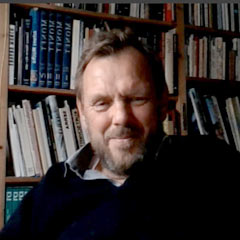 Ernst Wagner
Ernst WagnerThe EVC team from Ghana has chosen this traditional stool that plays a ritual role in the Akan culture. This stool uses a specific symbolic language. The two ravenous and competing crocodiles have a common stomach, i.e. their bodies are fused together. Thus this symbol "represents the idea of unity in diversity, democracy, shared destiny and female-male duality.” But then the text above goes further. It compares the symbol from the Akan culture with the German national coat of arms, which also shows a stylised animal, an eagle. There are many similarities between both symbols, the animal, the shape, the symmetry. Therefore – so the assumption in Ghana – the German coat of arms also has the same meaning as the Akan symbol: national unity. The assumption from Ghana, the equation, triggered an intense discussion in the German team of teachers in 2019. A German historian would say this interpretation is wrong. But, on the other hand, the eagle is definitely used in this sense, e.g. by politically right-wing groups in Germany.
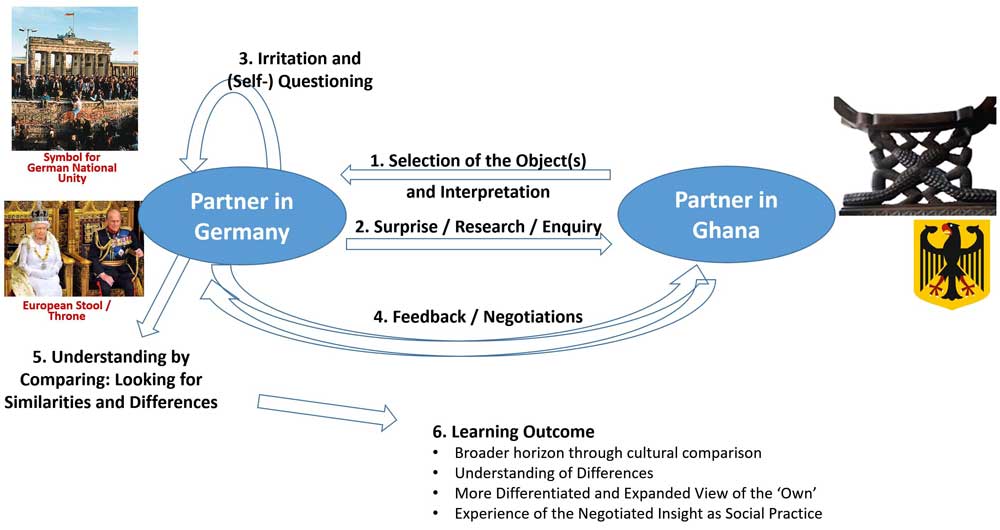
This figure presents a simplified visualisation of an extremely complex dispute that took place over several months - from a German perspective.
- The partners in Ghana selected the stool, interpreted it and made a connection to the German coat of arms.
- The addressees in Germany were very surprised by this, which led to intensive research into the symbols of the Akan culture. Through this, an acquaintance with the unfamiliar form of artistic expression took place.
- But, there was also an examination of the equation of meaning in the German coat of arms. The German team took up various aspects: the idea of the stool as a seat of power with symbolic adornment (as here with the English throne). But, the question of what image could be associated with the theme of "national unity" in Germany led to something quite different: the photo of cheering people on the Berlin Wall in 1989, when the division between the communist-totalitarian part of Germany and the capitalist-democratic part collapsed. This photo is much more anchored in the collective cultural memory than the coat of arms in respect to unity.
- In this way, the interpretations were discussed and negotiated together.
- Similarities and differences between the various cultural symbolisations could be identified,
- In a final reflection, the German team formulated their own learning experiences in this process.
Of course, everything was much more complicated and complex, but for the moment, perhaps the following conclusions can be drawn:
- The team in Ghana presents artefacts that are considered as important for the own context, the team in Germany tries to understand it, but starts a critical discussion when it comes to a German object, the coat of arms.
- The interpretations are negotiated with each other on eye level.
- The objects from Ghana and Germany (the stool and the coat of arms), although obviously completely different at first, are related to each other, come into contact with each other. Complex-entangled interactions of the objects themselves occur.
- What is initially seen as separate from each other becomes entangled in this way. The boundary between ‘one's own’ and ‘the other’ becomes fluid.
- This creates a hybrid intellectual space in which ambiguity becomes a paradigm.
Published August 2022
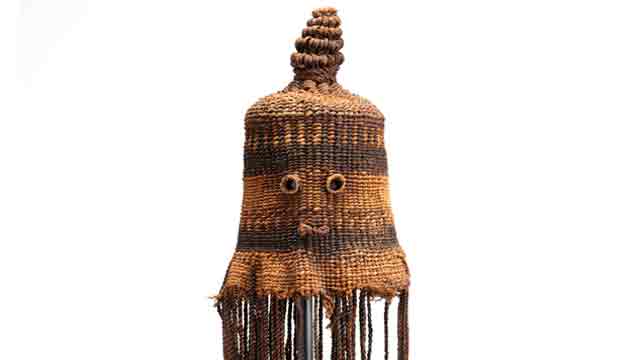
-
 Njeri Gachihi
Njeri GachihiMeaning
Ingolole serves several purposes in the circumcision ritual. It serves to mystify the ritual and more so the initiate. While wearing almost identical masks, the initiates become undisguisable in this full seclusion regalia. It is believed that even evil spirit sent would have a problem identifying the target and hence revert to sender. On the other hand, the masks also serve to wade off and scare women and children who are not supposed to interact with them during the seclusion. Even when they go out of the forest and make processions on major roads singing and dancing, the women and children should stay away. Part of the chants, dance and singing done is meant to break loose ‘childhood/boyhood’ which is symbolized by the breaking of the crown - palm reeds attached on the ingolole. Some do manage to break it which is a sign of physical strength and masculinity as well as spiritual and ritual wellbeing.
The dance that the initiates perform is know as bukhulu/bakhulu which means elder. Bukhulu henceforth, cosmologically viewed, means unity with the ancestors and is also used to symbolize fertility or the life-giving seed (seminal fluid). The effort of breaking the reed henceforth translates into becoming an adult and gaining all the permission to undertake the adult roles and the responsibilities associated with it. This means that this right gives the initiate the ability and power to engage in full conjugal and social responsibility. Last but not least, the initiates spend a lot of time in the open. Ingolole then serves to protect them from the scorching rays of the sun, protect them from sweating too much when dancing and at night serves to protect them from biting cold, wild animals and insects.
 Cutout: Presentation at Nairobi National Museum, Ingolole (Circumcision Mask), Museum Fünf Kontinente and Nairobi National Museum. Photo: Njeri Gachihi.
Cutout: Presentation at Nairobi National Museum, Ingolole (Circumcision Mask), Museum Fünf Kontinente and Nairobi National Museum. Photo: Njeri Gachihi.Is Ingolole an Artwork or a Ritual Object?
The ingolole as a form of ritual art, seems to bear witness to the resilience of the Tiriki culture; what Bakhtin might have called the 'carnivalization of the social order'. A central reason for using this mask, it seems, is to affirm the Africanization of the arena, both public and private, where a culturally appropriate image reigns. The mask usually invests the wearer with signs of power over evil, while modelling him on the norms of masculinity and respectability. The ingolole is one item of art that is yet to be transformed from artefact to curio (or momento). This is apparently so because its mechanism of distinction is yet to mobilize political as well as economic categories. This mask resonates well with the notion that visual art communicates cultural values. It is a complex ideological communication that derives its symbolism and references from culture. Yet it also draws its form and content from the fundamental tenets of the magical appropriation of power through the manipulation of depiction and elucidation.
Therefore, the Tiriki Circumcision mask, Ingolole is not only an artistic representation. It is a ritualistic object that embodies several meanings. It is known to invest the wearer with signs of power over evil - in that the wearer is set apart from his enemies that would intend to inflict harm. It is believed that the evil spirits sent to cause harm on the initiate would find it difficult to positively identify the initiate. At the same time, it causes mystery around the initiates making their looks terrifying and hence keeping off those who are not permitted to come near newly initiates. Physically, it protects the young boys from scorching sun, biting cold and insects while in seclusion. Once ingolole is used, it is kept and passed on from generation to generation. A used one is still valuable to the family and must be kept safely to avoid causing harm to the members of the family. Hence, this is an item of art that cannot be easily transformed from a ritualistic artefact to a simple curio craft.
There are not many Ingolole’s in our Museum in Nairobi. Two are however exhibited in the permanent exhibition, Cycles of life, at the Nairobi National Museum.
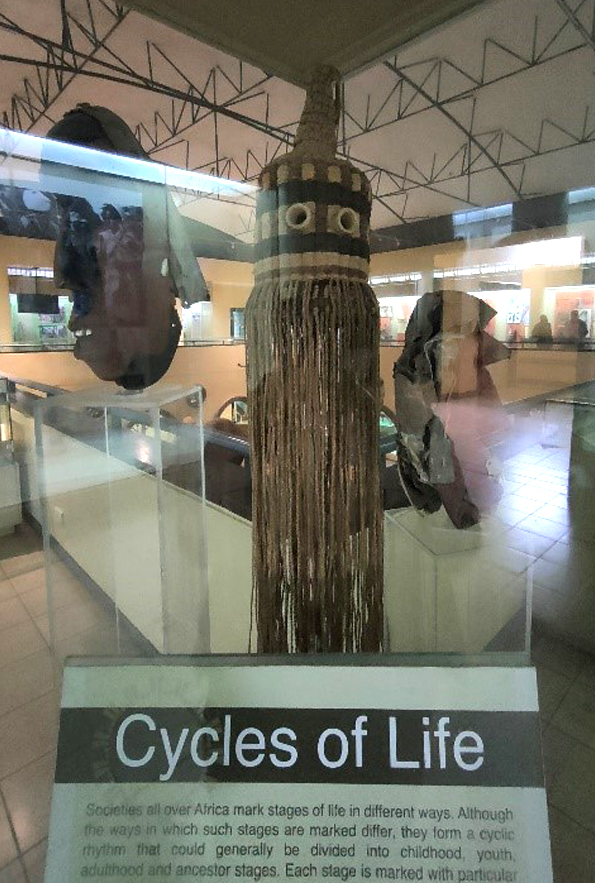 Presentation at Nairobi National Museum, Ingolole (Circumcision Mask), Museum Fünf Kontinente and Nairobi National Museum. Photo: Njeri Gachihi.
Presentation at Nairobi National Museum, Ingolole (Circumcision Mask), Museum Fünf Kontinente and Nairobi National Museum. Photo: Njeri Gachihi.
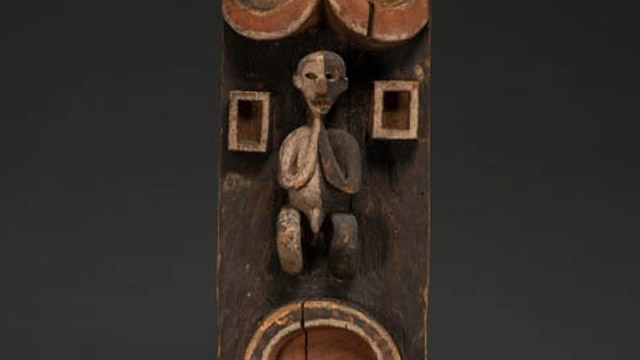
-
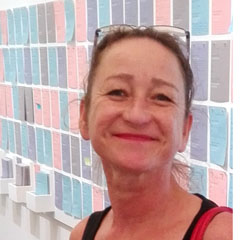 Karin Guggeis
Karin GuggeisObjects from the Global South in early collections of the Global North often lack any information about their specific local context. This is also true for this wooden sculpture made from a single block of hard wood, carved with different figures and forms on two sides and painted with natural colours in red, white and black. It was acquired in 1893 by the “Royal Ethnographic Collection” (Königlich Ethnographische Sammlung) in Munich, today the Museum Fünf Kontinente. No specific information about its geographic origin, its producers, users or use was documented in the inventory book. “Huge four-edged block, 1.80 high made of heavy wood, double-sided carved with human figures and lizards, heavily damaged by termites” is the only information recorded. The wooden block was sent from “Cameroon” (Kamerun) which is therefore documented as its region of origin. It was given to the museum as a present by Max von Stetten, a colonial officer in the German colony.
The post gained a new layer of significance through its inclusion in the almanac “The Blue Rider” (Der Blaue Reiter), one of the most famous and important publications on art in the early 20th century in the Global North. The almanac was edited in 1912 by two artists based in the environs of Munich, Franz Marc and the Russian Wassily Kandinsky. They designed the publication as a starting point for a new epoch of art, rejecting academic art and encouraging new forms of artistic expression. Thus, Kandinsky and Marc included reproductions of different non-canonical art forms, such as artworks from the Middle Ages, folk art, art made by children – and non-Western artworks, in those days called “art of the primitives” (Kunst der Primitiven), among them this sculpted block from Cameroon. In this way, the editors of the almanac aimed to break down the hierarchies between art forms from different times, regions and levels of professional skill, and to expand the canon of art in the Global North.
The editors’ fascination with non-European art had different roots: Wassily Kandinsky was a trained ethnographer and often visited ethnographic museums. Franz Marc, since his visit to the ethnographic museum in Berlin in 1911, especially admired sculptures from Cameroon. Thus Marc included a photograph of this wooden block to illustrate August Macke’s article “The Masks” (Die Masken). Marc captioned the picture simply “Cameroon” (Kamerun), its known geographic origin, and the country whose sculptures he admired.
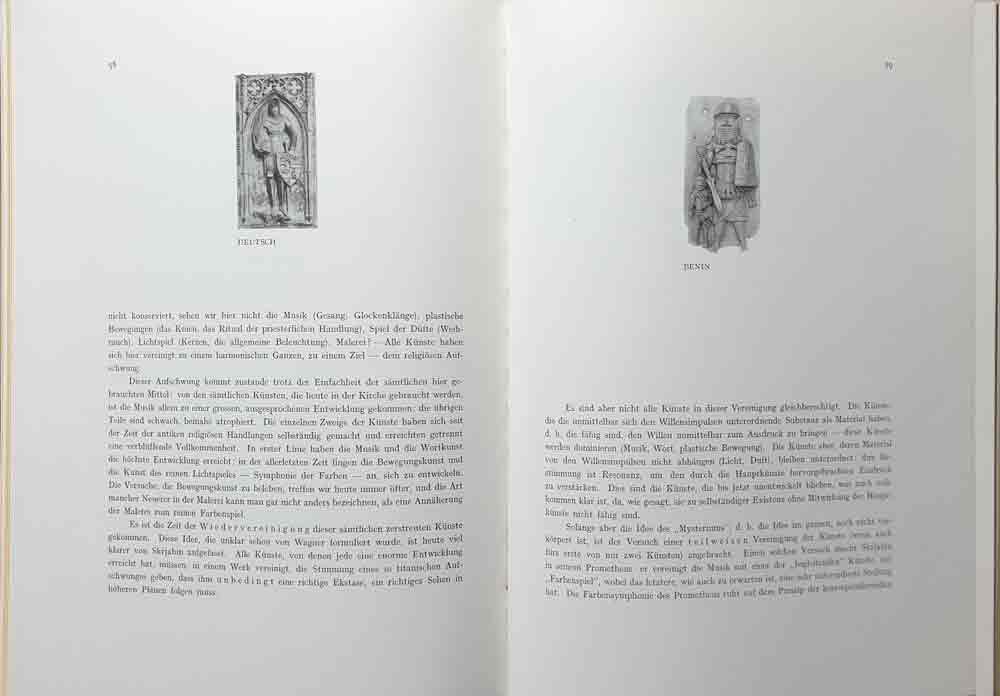
Fig 1: Almanac "Der Blauer Reiter" (page 58-59)
In his article, the artist Macke stressed that for Africans their “idols” (Idole), as he called their sculptures, were a “visible expression of an invisible idea”, “a personification of an abstract term”. He also stressed the equality of the art forms from different times and regions. For example, Macke valued bronze works from the kingdom of Benin, in what is today Nigeria, and other ethnographic works, because they are just as expressive as a grave marker in the cathedral at Frankfurt. To demonstrate this non-hierarchical attitude to art from different regions and times, Marc and Kandinsky placed two photographs side by side on a double page in the almanac – on one side the Gothic figure of a knight, and on the other a bronze plaque showing a soldier from the kingdom of Benin, which also was in the collection of the Munich ethnological museum by then (Fig 1).
The later fame of the almanac, and of its publishers Kandinsky and Marc as artists, led to the wooden sculpture being named “The Blue Rider Post” in the narrative of the museum.
It is significant for global art history dominated by the Global North that, in contrast to our broad knowledge in respect of the European admirers of this object, very little is known about its original local context in the Global South. The state of our knowledge concerning its producer(s), its patron(s), its use, its specific place of origin, the meaning of special forms, colours, figures or gestures sculptured is poor. There are two reasons for this. First, in the Global North, there has been little interest in investigating its local context. Second, it is actually very difficult to carry out such investigations in respect of such badly documented early works in ethnological museums. To unfold these difficulties: the common method used to trace the local context of poorly recorded works is to look for stylistic similarities and ethnological background information concerning comparable objects in other collections or publications. Spending long periods doing fieldwork in the place of origin is too time- and money-consuming, as there are numerous badly recorded objects, especially in the early ethnological collections. Moreover, in the Forest region of East Cameroon, the assumed place of origin, there are numerous small ethnic communities which have been inadequately studied. Thus the poor results of previous research in the Global North are the following: The sculpted post is valued as unique in ethnological and art publications. Only single figures and their gestures show similarities with a few other objects in collections of the Global North. The current suggested origin of this carved work in view of these stylistic similarities is among the Lundu or Mbo people in the Forest region in East Cameroon. There it was probably used in a cult.
A new approach has been made possible by a provenance research project of the Museum Fünf Kontinente, funded by the German Lost Art Foundation and the Bavarian State Ministry for Science and Art. In collaboration with scholars from Cameroun and the presumed source communities, members of the project are exploring the provenance and the local context of this special Cameroonian wooden block, as well as the whole collection from the German colony of Cameroon donated by Max von Stetten to the museum between 1893 and 1896. Hopefully the blank sheet regarding the original context of this wooden block will be filled.
For comparison, also read Patrique deGraft-Yankson's analysis of this object here.
The post in the context of the the repatriation discourse: Link
References
- Eisenhofer, Stefan (2009): Kulthauspfosten (?). In: Bujok, Elke (ed.): Der Blaue Reiter und das Münchner Völkerkundemuseums. Staatliches Museum für Völkerkunde München, Hirmer, München. S. 16-18
- Erling, Katharina (2000): Der Almanach Der Blaue Reiter. In: Hopfengart, Christine (ed.): Der Blaue Reiter. Bremen, Köln. S. 188-240.
- Kecskési, Maria (1999): Skulptierter Holzblock. In: Kecskési, Maria (Hg.): Kunst aus Afrika. Museum für Völkerkunde München. Prestel, Munich, London, New York. S. 116.
- Kecskési, Maria (1982): Zwei beschnitzte Holzblöcke. In: Kecskési, Maria (ed.): Kunst aus dem Alten Afrika. Pinguin, Innsbruck. S. 238-239, 72.
- Macke, August (1912): Die Masken. In: Kandinsky, Wassily/ Marc, Franz: Der Blaue Reiter. Piper, Munich. S. S. 53-59.
- Marc, Franz and Kandinsky, Wassily (eds) (1912): Der Blaue Reiter. Piper. Munich.
published March 2020
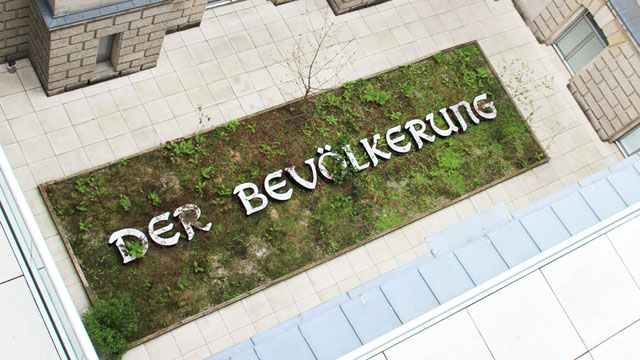
-
 Ernst Wagner
Ernst WagnerBased on the Ghanaian interpretation, it quickly became clear that certain ideological or political positions are immediately connotated with the respective image selection. These in turn are linked to historical and social experiences, which Winkler (2021) recently elaborated on the basis of the history of Germany. In our case, the West German, left-liberal intellectual milieu is of particular interest, since all the German project partners involved in the discussion can probably be assigned to such a milieu. "In the 1970s, the view prevailed among liberal and left-wing intellectuals in former West German, which objectively was not a nation state, did well to see itself as a >post-national democracy<. In the 1980s, this led to the conviction among many that the time of the nation state had passed and that Europe only had a future as a post-national union. [...] The self-destruction of one's own nation-state [in Nazi Germany - author's note] led to the conclusion that the nation-state as such had outlived its usefulness, and the term ‘national’ was equated with nationalist. [...] In Germany the idea that the nations had to merge into a European republic found a broader public echo." (Winkler 2020 p.186)
For art educators, the majority of whom probably feel committed to this idea of Germany as a post-national democracy, the question of a current symbolisation of national unity[1] is therefore obsolete. It cannot therefore be relevant to art education. A consensus in the German team on how at least the general topic could be addressed could be reached by the proposal to deal with the topic on another level, and to use Hans Haacke's installation "Der Bevölkerung" (2000, courtyard of the German parliament in Berlin) to deal with the topic of "national unity" in a contemporary art lesson.
Hans Haacke (*1936) is a German-American artist who has lived and worked in New York since 1965 and whose conceptually influenced works primarily address art-political processes.
Figure 2: View into the courtyard of the Reichstag building. © Hans Haacke / VG Bild-Kunst.
Haacke's installation "Der Bevölkerung" is located in a courtyard of the Reichstag building. This architectural context is part of the work. The building was constructed at the end of the 19th century, during the Second German Empire (1871-1918). In neo-baroque style, it paid homage to the national pomp under emperor Wilhelm II. Damaged by fire in 1933, it was further damaged during the Second World War. Located directly on the Wall to East Berlin, the dome was finally blown up in 1954. In reunified Germany, however, a new function was found for the building. Rebuilt according to plans by Norman Foster in the 1990s, it now serves the German parliament, the Bundestag.
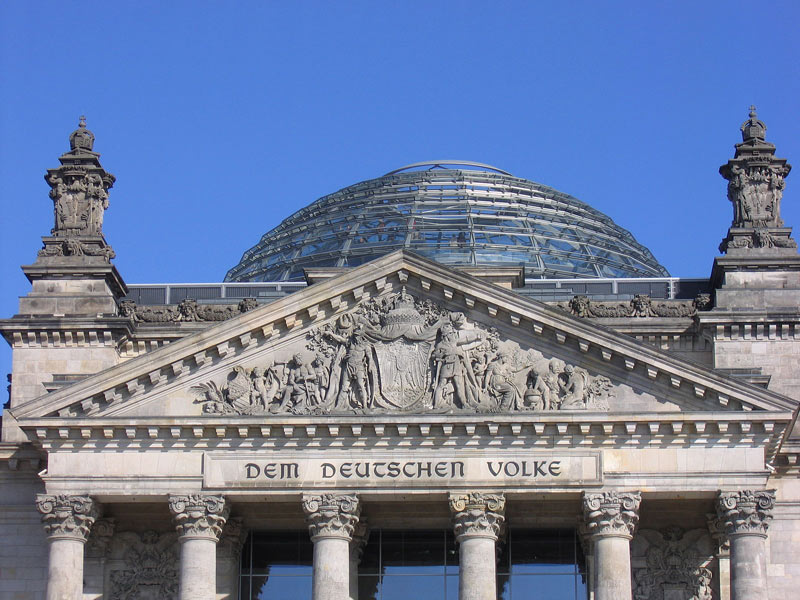
Figure 3: View of the façade of the Reichstag building with the inscription "Dem Deutschen Volke" © Hans Haacke / VG Bild-Kunst.
Hans Haacke built a 21 x 7 metre rectangular, flat wooden enclosure in this building. He then asked the MPs to gradually fill it with soil from their respective home regions. In the middle of the box, the inscription "Der Bevölkerung" (To the People / Population) can be read, in white letters illuminated from the inside. The typeface corresponds to the inscription "Dem Deutschen Volke" (To the German People / Nation), which has been on the outside of the building's west portal since 1916.[2] According to the initiator, the invitation to bring soil from the constituencies is valid as long as members are democratically elected to the German parliament. A webcam, belonging to the installation (www.bundestag.de), takes a picture every day at 2 p.m. and 8 p.m. and thus allows a take a look at the development of the project since 2000 and at the current situation.
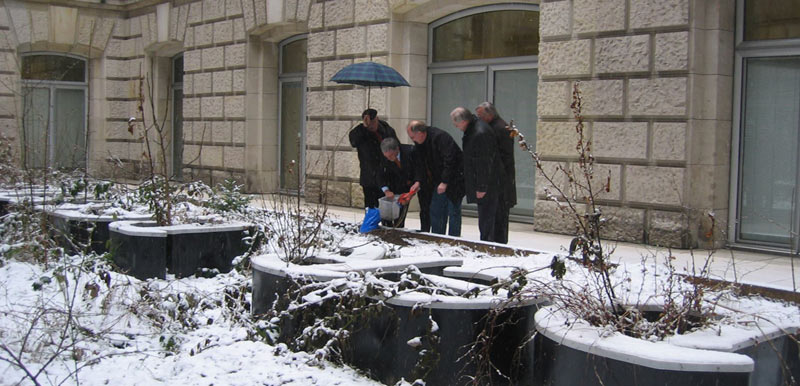
Figure 4: An MP distributes the home soil from his constituency in Haacke's installation. © Hans Haacke / VG Bild-Kunst.
When Haacke proposed to install this large-scale installation in the new parliament in 1999, ten years after German reunification, it triggered a heated public discussion. Many MPs found the words "Der Bevölkerung" (To the People / Population), which appeared to be a dedication, inappropriate and provocative. Haacke was deliberately alluding to the older inscription "Dem deutschen Volke" (To the German People / Nation) on the outer façade. In contrast to this, he used the term " Bevölkerung - population" to refer to all the inhabitants of Germany, including people who do not have German citizenship and live here. According to his own statement, Haacke was inspired by Bertolt Brecht when deciding on the lettering. Brecht had written in 1935 in exile that whoever said population instead of people would avoid many lies (Brecht 1935). Haacke is obviously also concerned with the question of how words can and should be used in the context of a national parliament to designate the basis of this democratically elected representation of the people/population. Does the term "Volk" fit, a traditional, conventional but loaded and perhaps not at all accurate term? Or would be the term "population" better, a word that sounds unfamiliar and strange at first, but perhaps makes more sense. The discussion intended on such questions is part of Haacke's work.
Similar discussions were triggered by the idea of having MPs bring home soil. For many, this was reminiscent of the National Socialist blood-and-soil ideology. Or they criticised it as "kitsch" because of the well-intentioned but overused symbolism. Obviously, the work here plays with this iconographic tradition (“Heimaterde”), but reinterprets it just as it reinterprets the lettering. At the same time, the installation is constantly changing as a result - both through the ever-changing soil and through the growth of the plants over the course of the year.
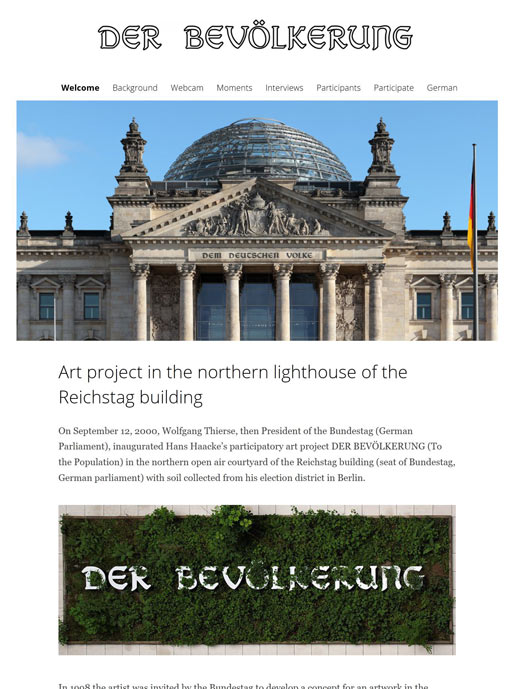
Figure 5: Screenshot of the project's website https://derbevoelkerung.de
© Hans Haacke / VG Bild-Kunst.
The installation is thus in constant dialogue with the population designated in the inscription, tries to involve the MPs and responds as a living piece of nature to the stone surroundings of the parliament building. The work of art is thus never fully completed.
Haacke's art project was particularly controversial in parliament; only by a narrow majority did the MPs finally vote in favour of the realisation of the artwork in 2000 after a specially scheduled debate in the Bundestag. The entire debate is documented on the project's website - as another part of the work (Bundestagsdeabtte 2021).
[1] I.e. a "small German" solution after 1990 and with shifted borders after 1945.
[2] It was designed by the Art Nouveau artist Peter Behrens.
References
- Brecht 1935: Bertolt Brecht. Five Difficulties in Writing the Truth. www.literaturwelt.com/werke/brecht/wahrheit.html (13.10.2021)
- Bundestagsdeabtte 2021: https://derbevoelkerung.de/bundestagsdebatte/
- Kaernbach 2011: Andreas Kaernbach. Projekt „DER BEVÖLKERUNG“ im Reichstagsgebäude. https://www.bundestag.de/besuche/kunst/kuenstler/haacke/haacke-198996 (13.10.2021)
- Winkler 2020: Heinrich August Winkler. Wie wir werden, was wir sind - Eine kurze Geschichte der Deutschen. Munich (Beck)
- Winkler 2021: Heinrich August Winkler. Das widerspruchsvolle Erbe des Otto von Bismarck. In: FAZ of 18.1.2021, p.6
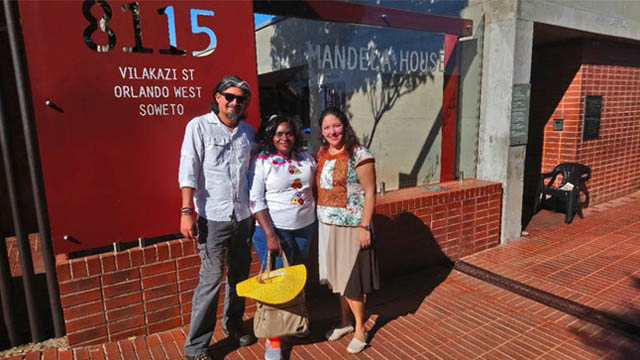
-
 Esther Kibuka-Sebitosi
Esther Kibuka-SebitosiThe Mandela House is located in Vilakazi Street 8115, Orlando West, Soweto. Now a museum, the Mandela House Museum is where the struggle icons Winnie Madikizela Mandela and her husband Nelson Mandela lived. There, they brought up their two daughters Zenani and Zindzi. Nelson Mandela spent little time at the house as he had to go underground during the struggle between 1946 until 1990s. He was arrested in 1962.
Winnie Mandela had to bring up the children while continuing the struggle. She was banished to the Free State town of Brandfort in 1977. Winnie Mandela was born in Mbongweni village, Bizana, Transkei on 26 September, 1936. She married Nelson Mandela in 1958. The marriage to a freedom fighter was a lonely one. The police often raided the Vilakazi Street 8115. Her husband was absent with meetings and amidst the turbulence she had to bring up the girls. In October 1958 she took part in the lady’s march to protest against pass laws. This was similar to the one in 1956 in Pretoria. She was an anti-apartheid activist and politician. She divorced Nelson Mandela in 1996 and was the minister of arts and culture from 1994 to 1996. She led a quiet life and on her 80th birthday, she was honored by family friends and politicians, including Julius Malema and the future President of South Africa, Cyril Ramaphosa, and Patricia de Lille, former mayor of Cape Town. This demonstrated her relationships with all political parties. She passed on 2 April 2018. A true mother of the nation.
Nelson Rolihlahla Mandela was born in Umtata on 18 July 1918. At the famous Rivonia trial, Mandela was brought before the court for his involvement in sabotage and violence in 1962. He was imprisoned for 27 years in total. He was first sent to Robben Island but later transferred to Victor Verster Prison in 1988. He was released from prison after 27 years in 1990 and he came home for only 11 months, after which he moved to a bigger home in Houghton, Johannesburg. The former State President, de Klerk, ordered his release and removed a ban on the political movement the African National Congress. Mandela served as President of the African National Congress (ANC) from 1991 to 1997. His Presidency is known for his legacy in ending racism, trying to fight poverty and inequality. He was dreaming of a nation free of racism with all people living together with all colours; the so-called Rainbow Nation. He wanted freedom without violence but the oppressors started killing his people. He then formed the Umkhonto we Sizwe, a military arm of the ANC. Nelson Mandela received a Nobel Peace Prize in 1993 with former state President of South Africa, Frederik Willem de Klerk.
The Mandela House has four bedrooms and one of them goes down memory lane. It brings both tears and relief, knowing that the Mandelas survived petrol bombs and bullets in the house during riots. The Mandela House Museum contains several honorary degrees awarded to Nelson and Winnie Madikizela-Mandela. It also hosts artefacts, memorabilia and artworks including “Tears of Freedom” by Leonard Katete, a Ugandan living in Kenya. The museum is a monument of history, harbouring family photographs dating back as far as the 1950s.
The Nelson Mandela Museum is open for public tours and photographs are allowed.
Vilakazi Street was also home to Bishop Desmond Mpilo Tutu, who was an Anglican Bishop and theologian well known for his humorous and critical speeches that call to order the freedom fighters. He played a major role during the anti-apartheid and human rights struggle for South Africa. Bishop Desmond Tutu was honoured with a Nobel Peace Prize for his achievements in opposition to South Africa’s brutal apartheid regime. He took a non-violent yet fearless stance against the oppressors, a characteristic that made him stand out amongst the liberation leaders. He articulated the sufferings of ordinary South Africans in clear manner and at the same time spoke up about the oppressive regiment. It is not surprising that Bishop Tutu’s Peace Prize paved the way for strict sanctions against South Africa in the 1980s.
Bishop Tutu chaired the Truth and Reconciliation Commission in 1995. Due to the fact that South Africa had suffered many wounds during apartheid, the many crimes committed by white rulers and atrocities against the black majority, the commission was established to “enable South Africans to come to terms with their past on a morally accepted basis and to advance the cause of reconciliation." The lack of social cohesion mainly due to racial disharmony led the newly elected Government led by Nelson Mandela to put together the Truth and Reconciliation Commission (TRC) under the chairmanship of Bishop Desmond Tutu. Cases such as the Soweto Riots (1976), in which Hector Pieterson was killed, were discussed; the Sharpeville Protests (1960 and 1984) and a number of other prominent cases were dealt with. Forgiveness was recommended as the fundamental condition of healing.
Vilakazi is also known for the Hector Pieterson Memorial and Museum, which were established to remember the Soweto uprising on June 16, 1976. Hector Pieterson was shot during the revolt on the day when schoolchildren demonstrated against the use of Afrikaans as a language of instruction for middle and secondary school.
Vilakazi Street and the Nelson Mandela Museum attract a number of tourists. The street is vibrant with good local food, music and dance. It has created small businesses in the township and is thereby contributing to the local economy.
References
- https://www.sahistory.org.za/people/winnie-madikizela-mandela
- https://www.sahistory.org.za/article/tutu-and-his-role-truth-reconciliation-commission, retrieved 26 January, 2019
- https://www.nobelprize.org/prizes/peace/1993/mandela/biographical/ , retrieved 26 January, 2019
published April 2020
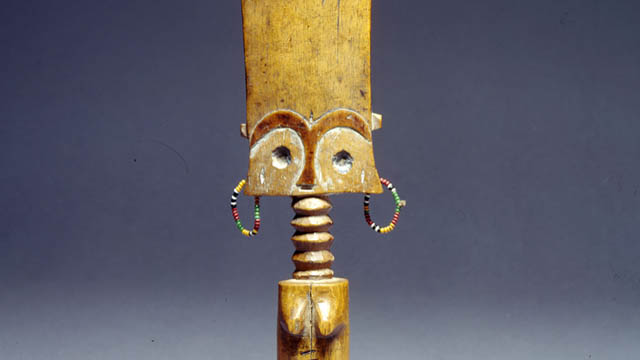
-
 Gertrude Nkrumah
Gertrude NkrumahInversion of Hegemony with Ideas of Femininity
Scholarly works abound on factors and causes of gender inequality in the Ghanaian society and many of these writings address gender inequality solely in terms of women as the victims and thus reinforcing the gender stereotype of female passivity. Although this is true in most cases, such studies do not necessarily address the question of how women have responded to and addressed issues of gender expectations and gender-related roles in African societies. By using the ‘Akuaba’ doll (fertility figurine), this research seeks to explore how the concept of womanhood has been portrayed and represented through time in the Ghanaian society among the Akan ethnic group. It seeks to extend an argument for the interpretation of these images beyond the depiction of women as sexual objects to that of creating an inversion of female hegemony in the society. I argue that instead of considering gender stereotypes as an all-pervasive oppressive tool, we must begin to think of the finer nuances and conceptualize how women have shaped, redefined, and negotiated socio-cultural construction of gender.
The object is widely referred to as the fertility figure, also known as the Akuaba doll among the Akans of Ghana. My reasons for selecting this object are two-fold. Firstly, it speaks to my childhood experiences as a girl growing up in an Akan society and secondly, as someone who is very passionate about gender-related issues either from an intellectual and personal perspectives, I was motivated to choose for this project an object that I can easily relate to, both from a personal and intellectual perspectives.
The object in question is the depiction of a female body, an exhibition of the Akan concept of an ideal woman. The features include a flat forehead with an elongated “ring-like neck shape”1 which reflects Akan standard of beauty. The understanding is that a woman with this type of neck is well-fed, healthy, and strong, a paragon of beauty and affluence. The flat broad forehead also is an embodiment of wisdom, while the accentuated breasts and hips with beads worn arounds the waist is the Akan ideal of womanhood, a depiction of woman as the giver of life. The beads worn around the waist has both aesthetic and symbolical meanings. In terms of beauty, beads were worn as an ornament for beautification, just as portrayed by the wearing of the jewels around her ears. It was also believed that wearing of beads around the waist is sexually appealing, while beads were also worn to broaden the hips and shape the waist for reproductive purposes. It is important to note that in the Akan society, and indeed in most Ghanaian culture, an ideal woman is one that carries and bears children. Clearly, ideas of beauty, sexuality and reproduction were the very essence of womanhood or femininity in the Akan society.
According to a very popular Akan oral tradition, the Akuaba doll is deeply rooted in one’s woman’s quest to overcome her inability in meeting societal ideas and expectation of womanhood.2 Akua, a childless woman, consulted a ritual specialist for a child. She was instructed to go to a woodcarver and make a doll of her choice for a child. Some rituals were then performed on the doll and given back to her to take home and treat and care for as her child. Later she became pregnant and gave birth to a daughter, just as she desired. The Akuaba doll then became symbolic for female reproduction. Amenumey explains that the Akuaba dolls were “…supposed to induce fertility and pregnancy….”.3 Among the Akan, like most precolonial Ghanaian societies, the concept of womanhood was largely defined and shaped by a woman’s ability to give birth to as many children as possible. Childbearing was a blessing from the gods and was usually celebrated with pomp and merrymaking. For instance, the custom was to reward a man whose wife has given birth to ten children with a sheep. The Akan refer to this as “badudwan”4 literally, a sheep for the tenth child. This was usually provided by the wife’s family to the husband to show their appreciation for the replenishing and sustainability of their family.5 In the quest to attain such feat, women worked hard to give birth to at least this number of children as prove of her worth to her husband and the society. This undoubtedly made women who were childless in the society feel undervalued and highly marginalized.
Such ideas and concepts of womanhood and inadvertent marginalisation of women still resonate in contemporary Ghanaian society and indeed in most contemporary societies. A woman’s value and worth continue to be tied with her sexual and reproductive abilities. Although women at present now have access to spaces and engage in works that go beyond the traditionally assigned roles of wife and motherhood (sexual and reproductive values), a woman is still expected to neatly fit in with socio-cultural construct of gender. This underscores the value place on women’s sexuality and reproduction to the detriment of other roles beyond these norms, thus leading to the marginalization of women. It is for these reasons that scholars such as Lerner and Allman have often called for the need to question entrenched patriarchal norms that undermine women’s oppression while it reinforces male- superiority.6
The understanding that women have continually been passive and largely detached from the making of their own history and are mere tools in the hands of a patriarchal society is neatly contested by the history behind the Akuaba doll. While it is true that it was Akua’s desperation to fit into societal expectation of ideals of motherhood that forced her to consult a diviner to help her conceive a child, the knowledge that Akua chose to actively engaged with the process of making the doll; how the doll is carved out, the shape, the physical features, and the aesthetic nature is significant. Additionally, the fact that she chose to carve out a girl child clearly indicates the active role she played in redefining and negotiating power with the matrilineal, yet patriarchal society, thus creating and inverting power in an all-pervasive patriarchal institution. It is also an indication that she did not consider the female as of little value in her society.
Paradoxically then, the history and philosophical ideologies that underpin the concept of the Akuaba doll is a clear exhibition of the nuances and complexities of societal construction of gender roles and status. In a society with a deeply entrenched gender expectations and assigned gender roles, it is remarkable that Akua sought to circumvent, manipulate, and yet conversely acquiesce with existing status quo to her advantage, an inversion of hegemony amidst patriarchal privilege. Therein lies the ambiguities and contradictions of performing gender.
References
- Addo-Fening, R (1973). Asante refugees in Akyem Abuakwa 1875-1912. Transactions of the Historical Society of Ghana. 14, 1. 39-64.
- Akyeampong, E & Obeng, P. (1995). Spirituality, Gender, and Power in Asante History. The International Journal of African Historical Studies. 28, 3. 481-508.
- Allman, Jean. (1996). “Rounding up Spinsters: Gender Chaos and Unmarried Women in Colonial Asante.” Journal of African History, 37, 2, 195-214.
- Amenumey, D. E. K. (2008). Ghana: A concise history from pre-colonial times to the 20th Century. Accra: Woeli Publishing.
- Appiah Anthony K. (1991) “Is the Post- in Postmodernism the Post- in Postcolonial? Critical Inquiry. Vol. 17, No. 2. 336-357.
- Lerner, G. (1994). The creation of feminist consciousness: From the Middle Ages to 1870. Oxford: Oxford University Press.
- Lerner, G. (1986). The creation of patriarchy. New York: Oxford University Press.
Footnotes
1) It is quite common today to hear songs in the Ghanaian society eulogising a woman’s beauty by referring to her ring-shaped neck, together with other physical features. This is an indication that the Akan standard of beauty in the past as enshrined in the Akuaba doll continue to resonate with contemporary Ghanaian societies.
2) This is a popular story among the Akans and was often recounted to young girls especially by an older woman in the family or society. I grew up listening to these stories from my mother and grandmother, among others.
3) D. E K. Amenumey. (2008). Ghana: A concise history from pre-colonial times to the 20th Century. Accra: Woeli Publishing. P. 90. From a spiritual and philosophical perspectives, the use of the Akuaba went beyond just fulfilling the desires of childless women. In most of these Akan societies, when a woman gives birth to twins but in an unlikely situation where one of them dies, she is expected to make a replica of an Akuaba doll in replacing the dead child. Some would also bury the dead child with the Akuaba doll as a way of warding off evil spirit from killing the living child.
4) “Badu” is an Akan name for the tenth born child. ‘Ba’ or ‘ɛba’ is the Twi word for child, while ‘ɛdu’ or ‘du ‘means the number ten in the Akan language. Therefore, the name Badu in Akan usually refers to a tenth born child.
5) It is significant to point out that Akan society, unlike most ethnic groups such as the Mole-Dagbani, Ewe, Ga-Adangbe and Guan, is mostly a matrilineal society. Lineage, inheritance, and chieftaincy succession have always been through the female line. Although precolonial Akan society was not completely immune from patriarchal ideals, women played important roles and and had significant status in society especially in areas of religion, politics and economy. For further details on this, see for example the articles Addo-Fening, R (1973). Asante refugees in Akyem Abuakwa 1875-1912. Transactions of the Historical Society of Ghana. 14, 1. 39-64 & Akyeampong, E & Obeng, P. (1995). Spirituality, Gender, and Power in Asante History. The International Journal of African Historical Studies. 28, 3. 481-508.
6) See for example, Allman, J. (1996). “Rounding up Spinsters: Gender Chaos and Unmarried Women in Colonial Asante.” Journal of African History, 37, 2, 195-214, Lerner, G. (1994). The creation of feminist consciousness: From the Middle Ages to 1870. Oxford: Oxford University Press., & Lerner, G. (1986). The creation of patriarchy. New York: Oxford University Press.
This article is part of a gallery: Perspectives from Ghana on Museum Objects in Germany
published January 2021
 ISB_Team
ISB_TeamA German Perspective on the Akuaba Doll in the Museum Fünf Kontinente Munich
Akuaba Dolls are wooden figures that were and apparently still are in use mainly in rural areas in southern Ghana. Young women hoping for pregnancy or - if they are already pregnant - for the health and beauty of their child, wear these figures on their bodies like real babies and take care of them. That is why they are called 'dolls'.
Akuaba or better Akua-Bà literally means 'child of Akua'. The story tells of "a woman named >Akua< who could not get pregnant and went to a local diviner or priest and commissioned the carving of a small wooden doll. She carried and cared for the doll as if it were her own child, feeding it, bathing it and so on. Soon the people in the village started calling it >Akua< >ba< - meaning >Akuaba's child<, since >ba< means child. She soon became pregnant and her daughter grew up with the doll." (Annor et al., p. 308)
This story also forms the basis for the function of the widespread dolls as aids in a desire for pregnancy. An Akuaba Doll expresses this desire for a child, so the figure is 'cared for' by a girl from puberty onwards. This happens within the family. Outside the family, Akuaba Dolls can be found in shrines under the care of a ritual specialist, where they can be borrowed for their purpose.
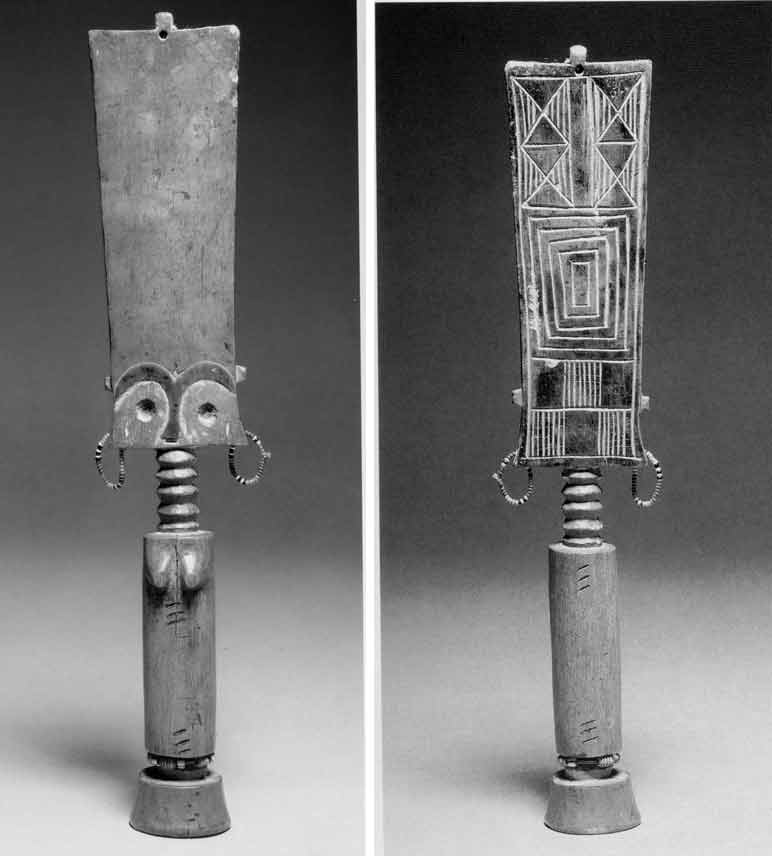
Fig. 1 & Fig. 2 Views of the Akuaba Doll in the Munich Museum Fünf Kontinente
Anonymous artist. Fante Fertility Figure. Early 20th century, Wood. 27,5 cm. Museum Fünf Kontinente. Presentation at Museum Fünf Kontinente.
© Museum Fünf Kontinente
Description
The doll in Munich's Museum Fünf Kontinente (Fig.1) comes from the Fante area. It shows a female figure. The very strongly abstracted forms and proportions symbolise various aspects:
The rectangular shape of the very flat head becomes - seen from the front - somewhat broader in an elegant curve towards the top. A strikingly high forehead, with eyes, eyebrows and nose only indicated, while mouth and ears are missing. The accentuated arch segments of the eyebrows flow together and then form the nose. On the back, the head has geometric patterns (Fig. 2). Added earrings of glass beads give the figure a colourful accent. For Kecskési (p. 38), their daintiness is a sign that the doll has been lovingly treated. At the very top there is another small moulding with a hole where hair was originally attached (compare Fig. 3a).

Fig. 3a: Akuaba Doll from the Linden Museum Stuttgart (Forkl p. 94). Fig. 3b: Use of the doll (drawing by Vanessa Rast - courtesy the artist)
The neck has five rings. It sits on a very slender, round trunk, which in turn stands on a delicate base. Striking are two groups of three diagonal embrasures each, which are repeated on the back. The figure has no arms, the legs are short stumps. The protruding forms in the chest area mark the figure as female. Its strict symmetry is softened by small deviations. One can well imagine taking the cylindrical figure in one's hand.
Material and technique
A ritual specialist to whom a woman who wishes to have a child goes makes the decision about the choice of doll at the respective shrine. If no suitable figures are available there, he instructs the woman to order a new Akuaba Doll from the woodcarver. The craftsmen then visit the tree to obtain the wood and ask the tree's spirits for permission to do so (oral information from the Ghanaian colleagues 2022 in Bayreuth [Link]). The Akuaba Doll in the Munich Museum was carved from softwood. (There are also darker examples made of hardwood, for example among the Ashanti, also an Akan group, as the presentation in the Ghana National Museum in Accra shows - see Fig. 4.) In the example in Munich, eyebrows and nose are darker.
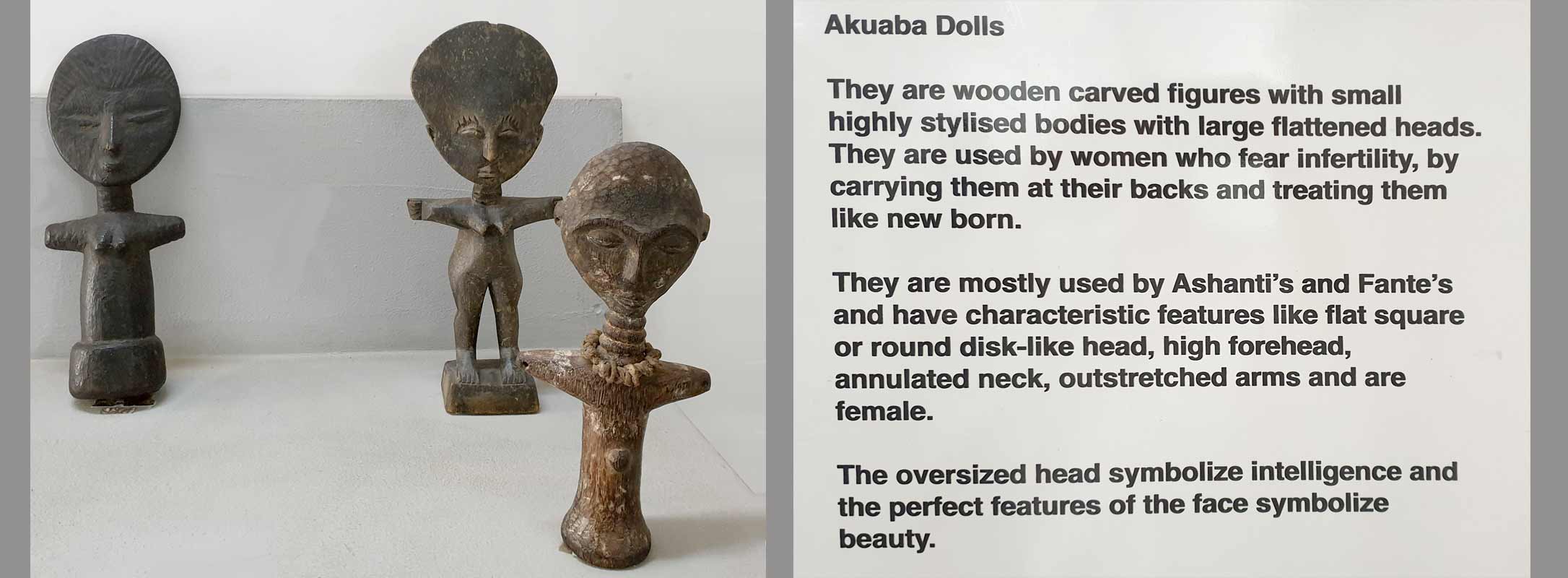
Fig. 4: Presentation of Akuaba Dolls at the Ghana National Museum in Accra (March 2023. Photo: the author)
Interpretation of the Munich figure within the original Ghanaian context
(1) Utility function: The figure is made for the family context. It is meant to lead to fertility, sometimes also to the beauty of a child. The size (height 28 cm), the pleasant material and the weight allow the figure to be carried and cared for like a baby. When an Akuaba Doll has fulfilled its task, it is often returned to the ritual specialist who accompanies the process.
The breasts indicate a female figure, which does not necessarily have to do with a corresponding desire for the sex of the child desired. Forkl (p. 94) assumes, however, that "women desire daughters, on the one hand as progenitors in a matrilineality oriented society, and on the other hand as support in household work." (There are also Akuaba figures with the characteristics of both sexes and probably male specimens; furthermore, breastfeeding examples and those who in turn carry other Akuaba Dolls.)
(2) Body shape: T The conspicuous and disproportionately large rectangular head symbolises the head as the seat of intellect and wisdom in local imagery. Akuaba figures among the Ashanti show round heads (see fig. 4), but they are also proportionally very large. High foreheads and flat faces correspond to the ideal of beauty. Luxuriant bulges on the necks tell that the figure is well-fed and thus refer to happiness and prosperity. There are Akuaba Dolls that show more feminine body shapes, wider hips, possibly emphasised by strings of pearls.
(3) The spiritual context: As Nkrumah writes in her contribution, an Akuaba figure serves as a dwelling place for a soul being, a being that is in a transitional area between the earthly and the spiritual world. Carrying and caring for it is a prerequisite for the entrance of such a soul being, which then sets out to appear on earth as a living being, i.e. to enter the family of the young woman through birth. A ritual specialist is involved in the selection, consecration and regulations for use. After a birth, the figure is returned to the ritual specialist.[1]
(4) The social and cultural context: The figure can also be seen as a sign of the traditional expectation for a woman to bring children into the world. In recent times, where traditional societal expectations of women collide with other worldviews, the ritual use of Akuaba Dolls obviously decreases .

Fig. 5: Souvenir shop at Accra Airport (March 2023. Photo: the author)
In the last decades, an interesting production for tourism has been established - apparently the dolls are seen as 'typical for Ghana'. However, these are not Akuaba Dolls in the traditional sense, but rather 'quotes'.
How can one relate Akuaba Dolls to European visual traditions and experiences?
As familiar as the image of an Akuaba figure may seem in Europe - as a 'typical' example of traditional African art - its traditional meaning is unknown in Europe. Nevertheless, it obviously seems to be attractive to tourists, e.g. as 'airport art' (see Fig. 5), perhaps because its shape somehow corresponds to the cliché idea of 'typically African', the size fits well into the suitcase, or the large head (by means of the Bambi effect) makes it appear 'cute'.
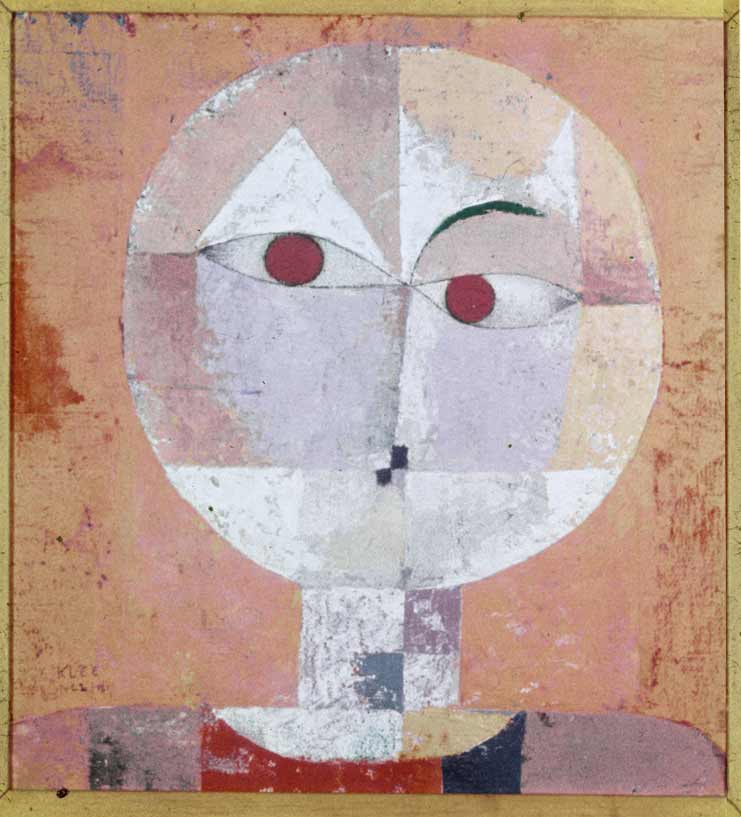
Fig. 6: Paul Klee. Senecio. 1922. Oil on chalk base on gauze on cardboard. 40.3 × 37.4 cm. Kunstmuseum Basel (Wiki Commons)
In the context of art history, the influence of Akuaba Dolls (and many other carved representations from West Africa) on European art of the early 20th century (see Fig. 6) is of interest. [2] The formal similarity to Klee's painting (fig. 6) is striking at first glance, but whether this is a direct reference must first be verified. In the context of art history, it would then be of interest in a next step which aesthetics were of interest to the artists at the time and which they blanked out, i.e. which "image of Africa" they wanted to have and also communicate.
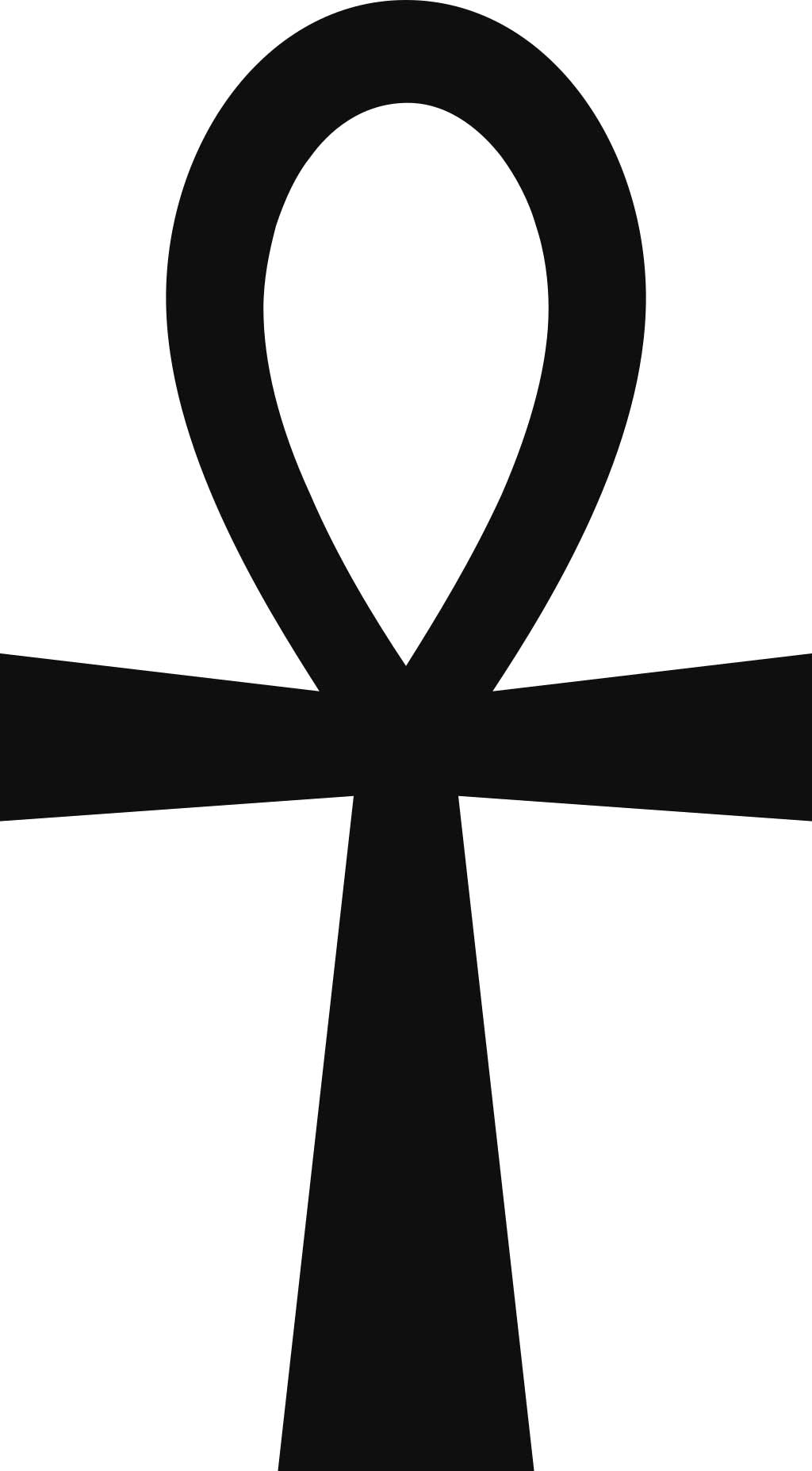
Fig. 7: Hieroglyph Anch
(Photo: https://anthrowiki.at/Anch)
The authors also considered whether the formal similarity of the Akuaba Dolls with the ancient Egyptian hieroglyph ‘Anch’ (the "loop of life" or the "key of life" - see Fig. 7) could have come about through a historical relationship between Egypt and Ghana. This would also correspond to the accentuation of content in Nkrumah's text with regard to the "representation of the woman as the giver of life" (see her chapter). Nevertheless, this association would also have to be examined more closely. To assume a universal archetype in the sense of C. G. Jung appears to be pedagogically misleading in its levelling effect.
In the German educational context, on the other hand, it seems important to link the figure - beyond clarifying its function - to Akua's story and thus include the role of narratives. This prevents another comparison that is also too quick and reductive when it comes to social practices (and not the isolated object), as dolls are also cared for and nurtured in traditional European contexts, but mostly by young children before puberty. So, in Europe, it does not belong to a fertility ritual, even if the child puts itself in the role of a ‘little mother’ or ‘little father’. (Another interesting question, whether Ghanaian women also go to a doctor when they are not pregnant, and whether there are comparable ritualised practices in Central Europe - for example among alternative practitioners or in esoteric circles - would have to be addressed in interdisciplinary approaches.)
Such comparisons appear to be useful, as they can show both similarities and differences, with the aim of better recognising one's own perceptual conventions or stereotypes and thus putting them into perspective. All this still leaves the question of the status of this doll in Munich when it is displayed in a showcase in a European museum (see Lab entry: What is an object? Link). Such a presentation contradicts its ritual and spiritual use. An Akuaba is then no longer an Akuaba. But what is it then?
Sources
This text is based on:
- Contribution by Gertrude Nkrumah: https://explore-vc.org/en/objects/the-akuaba-doll.html
- Talks with the Ghanaian EVC partners in Bayreuth in 2022: https://explore-vc.org/en/activities/archive/april-22-25-2022-joint-workshop-uew-team-and-isb-team.html
- The presentation at the National Museum in Accra, seen in March 2023: Fig. 4.
- Reading: see list of references
References
- Akyeampong, E & Obeng, P. (1995). Spirituality, Gender, and Power in Asante History. The International Journal of African Historical Studies. 28, 3. pp 481-508
- Anderson, Elizabeth L. (1989): The Levels of Meaning of an Ashanti Akua'ba. In: Michigan Academican. 21 205-219
- Annor, I., Dickson, A & Dzidzornu, A. G. (2011): General Knowledge in Art. Accra (Aki-Ola Publications)
- Forkl H. (1997): Healing and body art in Africa. Stuttgart (Lindenmuseum)
- Kecskési, M. (1999): Kunst aus Afrika - Museum für Völkerkunde München. Munich (Prestel)
Footnotes
[1] The number of five neck bulges here (there are also specimens with 3, 8 or 9 bulges) may also be a reference to the sacred number of "Odumankoma", the Akan creator deity, in this context.
[2] On the relationship of the European avant-garde to the aesthetics of West African carvings, see also the discussion of the Blue Rider post on this website (link 1 and 2).
 Christin Winter
Christin WinterMy Encounter with Black Feminism and Womanhood Inspired by the Akuaba Doll
I first came in contact with the Akuaba Doll while reading Bernardine Evaristo’s award winning book Girl, Woman, Other. In the book, the character Nazinga was described as “at least six foot tall with ornamented dreadlocks, large wooden Akuaba fertility doll earrings, red trousers, a cream embroidered caftan and strappy Roman sandals“ (Evarsito 2020, p. 81). I searched for Akuaba fertility doll earrings on the internet, but did not delve further into the topic at this time. A few weeks later, attending a seminar with Dr. Wagner at Friedrich-Alexander University in Erlangen, I stumbled upon the Akuaba Doll again. I knew, I had to take this opportunity to get to know her better. The comment from Gertrude Nkrumah is to be considered my first source of information about the history of origin and the tradition into which the Akuaba Doll is woven.
Through Nkrumah's feminist perspective on the Akuaba Doll, I wanted to dive deeper into the topic of Black Feminism to extend my knowledge in feminist theory. With the Akuaba Doll as my point of departure, I decided to focus on the ability to bear children and the social significance of abortions for Black women.[1]
At this point I move past the Akuaba Doll and her cultural context. Other works of art could have led me to a similar path. I have chosen to look at the Akuaba Doll with categories, which are not directly related to the Akuaba Doll and her cultural context as I questioned whether I have the right to write about the Akuaba Doll considering the colonial past of my own country, Germany. I am a white, European woman, a feminist, who is aware of intersectionality and racist structures within the society I have been socialised in and its way of thinking, but with no cultural connection to the Akuaba Doll other than the colonial impact on African art and culture (cf. Kushinator, Rahman and Dompreh, 2020[2]). Therefore, I chose a topic to which I have access via my role as a student of pedagogy and focus on Black Feminism and Womanhood of Black women living in white-dominated countries.
In white-dominated societies, Black women were excluded from a feminist movement for decades (cf. hooks, p. 216f.). White women systematically utilised the racist hierarchy within women to gain power and thereby forced a specific Black feminist movement to form and uncover the oppression Black women had and still have to face. The prefix “Black” emphases the specific oppression Black women face in white-dominated countries, although, of course, there has been feminist movements in Black-dominated countries before (cf. Roig quoted from Berlin Biennale 2022, 48:00 – 49:50).
In American history, Black women have always had to fight to be seen as women. As bell hooks gets to the heart of it: “the black female was a creature unworthy of the title woman; she was mere chattel, a thing, an animal” (hooks 2015, p. 214). Sojourner Truth[3] had to bare her breasts to prove that she was a woman indeed. Being yelled at “I don’t believe you really are a woman” by a white man represents the contempt and disrespect for Black womanhood (cf. hooks 2015, p. 214). In her famous speech “Ain’ I a Woman” (1851), she argues, that she – as her white women audience too – is indeed a woman. Here she argues with characteristics, that can also be found in the Akuaba Doll. The most important argument is the carrying and bearing of children and the “mother’s grief” (Truth 1851 quoted from hooks 2015, p. 215) she cried out, when her children were sold into slavery.
The ability to bear children has always played an important role in the history of womanhood and was – and still is – utilised to oppress and exploit Black women. In times of slavery, Black women were forced to procreate and bear children, who were worth a lot of money in a perfidious system of human trafficking (cf. Federici 2020, p. 23f.). In the late 20th century, Black men in the U.S. reasserted what they called their “rightful positions as patriarchs” (Taylor 2022) and denounced birth control and abortions as genocide that compromised the future and freedom of Black families by limiting the Black population (cf. Federici, p. 25f.). With the overturn of Roe v. Wade[4] – Black women are specifically affected, as Kwajelyn Jackson, Executive Director of the Feminist Women’s Health Center in Atlanta, Georgia puts it into a nutshell: "Abortion bans are inherently racist because they do not consider the lived experiences of Black people and other communities of colour. Many state policymakers would rather criminalize and endanger Black birthing people than supply them with all of the resources they actually need" (Jackson quoted from Long 2022). Even before the abortion laws were restricted, Black (and other BIPoc) women in the U.S were two to three times more likely to die from pregnancy-related causes than white women (cf. CDC 2019). Being allowed to decide whether you want children or not and furthermore, having access to certain facilities to end a pregnancy or not is still a bound to privileges. It is not only tied to the health care system, but also to cultural beliefs and practices, to the financial and educational background, as well as to class, race and many other factors.
In a world imprinted by patriarchy and privilege, it is important to unravel power structures that dominate our world, uncover where they come from and how different groups are affected differently. As patriarchal patterns of thought are inscribed in nearly all societies of our world, it is a tough task to uncover them in every aspect of our lives and hence require lifelong learning and feminist thought. Nevertheless, it is indispensable in order to build an anti-racist gender-equal society in which every woman can decide herself, if she wants to get children without fearing financial or social consequences.
In this context the Akuaba Doll can be interpreted as an early moment of feminism, where women disrupt the patriarchal system that marginalizes them. As Nkrumah states, by deciding about the gender of her child in a binary system, she chose to bear a girl rather than a boy, which – in the matrilineal line – effects the lineage, inheritance, and chieftaincy succession (cf. Nkrumah 2020). In my eyes, Akua used the power she had to influence her life to her advantage. Yet the worth of women was still tied to her sexual and reproductive abilities, but nevertheless she made a first step by empowering women to stand up for themselves and for their own lives.
References
Berlin Biennale (2022). Panel: Afrofeminism. Bridging the Gap. <https://12.berlinbiennale.de/media/panel-afrofeminisms-bridging-the-gap/> (09/30/2022).
Center for Reproductive Rights (2022). The World’s Abortion Laws. <https://reproductiverights.org/maps/worlds-abortion-laws/> (09/30/2022)
Evaristo, B. (2020). Girl, Woman, Other. UK: Penguin Books.
Federici, S. (2020). Jenseits unserer Haut. Körper als umkämpfter Ort im Kapitalismus. Münster: Unrast.
hooks, b. (2015). Ain’t I a Woman. Black Women and Feminism. New York: Routledge.
Kushiator, G., Rahman, A. and Dompreh, H.-O. (2020). The Influence of Western Culture on Traditional Art Forms and Cultural Practices: ‘Akuaba’ doll among Akan Women in Africa. ADRRI Journal of Arts and Social Sciences, Ghana: Vol. 17, No.6 (5), S.59 – 71.<https://www.researchgate.net/publication/344438737_The_Influence_of_Western_Culture_on_Traditional_Art_Forms_and_Cultural_Practices_%27Akuaba%27_Doll_Among_Akan_Women_in_Africa> (09/30/2022).
Long, S. (2022). Abortion Bans pose a Danger to all Mothers. For Black Women, they’re especially damaging. <https://www.refinery29.com/en-us/2020/10/10015405/abortion-ban-racism-black-women-effects> (09/30/2022).
Nkrumah, G. (2021). Inversion of Hegemony with Ideas of Feminity. <https://www.explore-vc.org/en/objects/the-akuaba-doll.html> (09/30/2022).
Taylor, K.-Y. (2022). How Black Feminists defined Abortion Rights. <https://www.newyorker.com/news/essay/how-black-feminists-defined-abortion-rights> (09/30/2022).
Footnotes
[1] In this context, I will delve into the topic of reproductive abilities and use the term "woman" throughout my text. However, I want to clarify that the ability to bear children is not a defining characteristic of womanhood. Not all women have a uterus, and not all women are able to bear children. Furthermore, one's physical appearance is not a determining factor of one's gender identity. Despite this, the reproductive ability is instrumentalised in our society and can lead to harmful stereotypes, which many women are confronted with at some point in their lives.
[2] In addition to exploring the different forms and cultural backgrounds of Akuaba Dolls, this article delves into the ways in which culture, religion, and artistic expression are intertwined in African cultures. The article points out how the colonization by white, western, and Christian men and women caused a change in function and values of the Akuaba Doll.
[3] Sojourner Truth lived from 1797 to 1883. She was an American abolitionist of New York Dutch heritage and a women’s rights activist. She was born into slavery, but escaped to freedom in 1826. In 1851 she joined George Thompson, an abolitionist and speaker, on a lecture tour through central and western New York State. At the Ohio Women’s Rights Convention in Akron, Ohio, she gave her speech with later became famous as “Ain’t I a Woman?”
[4] Roe v. Wade is a legal case in which the U.S Supreme Court ruled that unduly restrictive state regulation of abortion is unconstitutional and that the Constitution of the United States generally protects a pregnant woman's liberty to choose to have an abortion. This decision from 1973 was overturned by the U.S. Supreme Court in 2022.
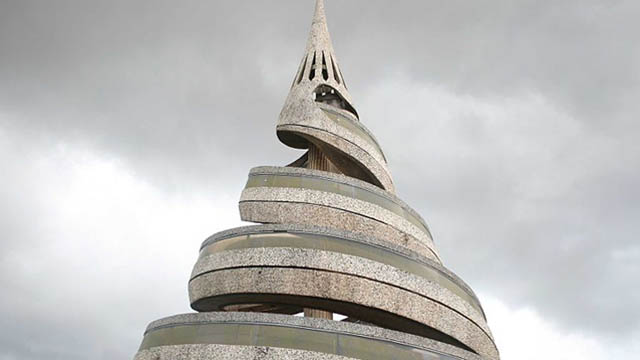
-
 Paul-Henri Souvenir ASSAKO ASSAKO
Paul-Henri Souvenir ASSAKO ASSAKOThe "reunification" is the result of a synergy of different societies willing to modify their way of life and the principles of their socio-cultural organization in order to cope with the vicissitudes of the colonial yoke. These societies are based in the Great West, the Coastline, the Southern Forest, the East and Lake Tchad, the regions that mark Cameroon’s geography. Each of these regions is home to a large number of ethnic groups such as the Bamileké, the Bamun, the Akunakuna, the Babungu, the Duala,the Beti, the Fang, the Peul, the Kirdi, the Fula, the Dourou, the Fali, etc. The date of May 20th, 1972 marks Cameroon’s passage from Federal Republic to United Republic by referendum. This date can be said to be the culmination of the political commitment initiated on the 1st of October 1961 with the reunification. Based on this commitment of 1961, Cameroon continued the construction of a unitary state and the consolidation of national unity encompassing the country's entire population. It can be argued that this unitary state was the only way to protect Cameroon’s sovereignty after Independence and to implement projects of prosperity. In President Ahidjo’s words of 1961: "It is together that we will make our Cameroon finally returned to the borders of our ancestors1, a modern country where it will be good to live in a climate of freedom, fraternity and prosperity." (Mveng 1985, 262).
The Reunification Monument is situated on "Plateau Atemengue", Yaoundé’s political and administrative centre. In this area, the colonial administration had placed institutions for education and administration that were crucial constituents of the new country: the National Assembly, the school of administration and the judiciary, the military headquarters, the Leclerc High School and the University of Yaoundé, to only name a few examples. The large boulevard initially used for the parades commemorating the celebration of the feast of national unity is located on this plateau as well. Placed on top of the city, amongst the republic’s essential institutions the Reunification Monument was obviously meant to become a reminder of the sense of unity amongst the initiatives engaging the Cameroonian republic.
The ensemble of the Reunification Monument consists of an architectural structure and a sculpture. According to Noé Tonye2, its shape emerged from sketches selected by the public authorities following a national and international competition on the theme of reunification launched by the Cameroonian Head of State. However, the identity of the authors of this monument suggests that they might also have been directly commissioned because they appeared qualified for the job due to their previous projects. These artists are Gédéon Mpando and Engelbert Mveng with his “Art Nègre Workshop”, who both used to receive public commissioned in Yaoundé at that time. Annette Schemmel (2015, 66) points out with regard to Engelbert Mveng: “As the author of Cameroon’s first national history, a contributor to ABBIA {Revue}, and a politician in Ahidjo’s service, Mveng enjoyed an excellent reputation among Cameroon’s élites. His social standing also led to secular commissions ». A third partner was the French architect Armand Salomon. His involvement in the realisation of this monument is due to his proximity to the French government, who probably recommended him to the Cameroonian government, according to Noé Tonye.
Although the conditions of the commission are somewhat obscure, Engelbert Mveng is known to be the designer of the spiral tower as well as of the representation of the cultural areas of the new state, while Gédéon Mpando created the monumental statue and Armand Salomon was in charge of the realization of the spiral-shaped building. Arguably, the teaming up of three professionals had a symbolic dimension because building a "merged" nation called for the commitment of society as a whole. Such a vast project required an explosion of research and creative initiatives towards a culture of common values driven by teaching and education. The involvement of several Cameroonian artists and a French architect in the design and the construction of this monument reflects the political will to involve different parts of society and to create mechanisms that are operational and serving the interests of national unity.
The architectural component of the monument to the reunification of Yaoundé has the appearance of a giant cone built of concrete. This cone consists of two spirals which describe a sinusoidal movement, and which unite on the top. The basis of this architecture is a circular structure and each spiral is a form of concrete slide made up of stairs to the top. A high column in the centre and four parallel pillars support the structure as a whole. For these four main pillars, the Art Nègre Workshop has designed reliefs showcasing characteristics of lifestyles, landscapes, cultural and artistic elements from the North, South, East and West of Cameroon. In a similar style, the team has pictured school scenes, construction scenes of modern architecture, scenes of farming, etc. for the decoration of the underground part of the building, thus celebrating the process of transformation and development of both society and land.
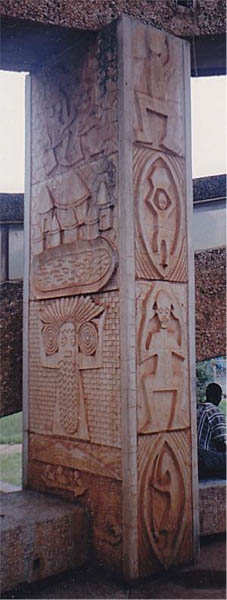
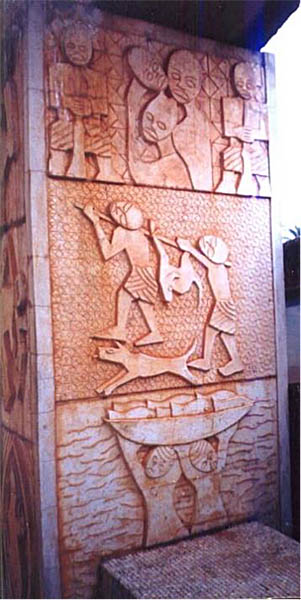
Images: ASSAKO ASSAKO Paul-Henri. 2014. L’art au Cameroun du XXe au début du XXIe siècle : étude des expressions sculpturales en milieu urbain, thèse présentée et soutenue en vue de l’obtention d’un doctorat/Ph.D en Histoire de l’Art, UY1-Cameroun, p. 571.
Details of a pillar cladding representing the diversity in the Cameroonian regions: the cone-shaped architecture and an initiation mask of the Kounga from Cameroon’s West; the abbia motifs and the hunting scene characteristic of the forests on the South Cameroonian plateau and finally the fishing scene which recall the Littoral region.3
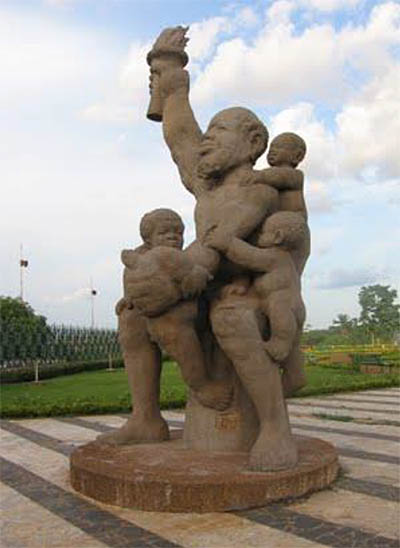
Engelbert Mveng and Atelier Arts Nègre (design, decoration in relief on the architectural structure), Armand Salomon (architecture), Mpando Gédéon (sculpture), 1973 -1976, concrete, H: 7m, Atemengue Plateau Yaoundé, Cameroon. Photo: Paul-Henri Souvenir ASSAKO ASSAKO
The sculpture by Gédéon Mpando that is situated in front of the spiral architecture reinforces the idea of a united nation as a foundation for development, fulfilment and prosperity in its own way. The artist has personified the nation in a figurative sculpture. The composition represents a stocky colossus (53 tons, height of 7m) in a seated posture of great stability. He holds a torch in his right arm while his left hand serves to support the four children who are clutched to him. The children’s visible efforts to climb up the colossus make for a strong vertical tension, echoing the cone-shaped architecture in the background. Mpando’s sculpture reveals a kind of serenity. Its strong expressiveness is due to a harmonious play of masses and volumes in the treatment of forms. Both artists’ contributions translate a vision of the nation that is both poetic and critical and as such essential to the development of a national society. Both components of the monument incorporate the idea of belonging to a nation that is united and hence display the most universal property that an image can acquire in such a context: its true ontological significance (H. Belting, 2004).
Let us come back to the relevance of this monument’s imagery. The inhabitants of the territory of Cameroon have inherited a common history of colonization. This history has forged socio-cultural, symbolic, emotional and political ties between ethnic groups. E. Renam speaks of these ties as the “fusion of populations” (1882). These links constitute the raw material of the national collective memory. It can be argued that it is worthwhile to overcome the obstacles to the consolidation of this nation due to the socio-cultural sedimentation of these ties. Disappointment with the promises of prosperity have resulted in calls to return to regional autonomy, be it in the form of a federal state or in the form of secession. Precaution needs to be preserved, however, because deconstructing the Cameroonian Republic constituted in the 1960s and 70s would imply calling into question the historical heritage, that Cameroon was born from the colonial system developed at the African conference in Berlin in 1884. The consequence would be the restoration of a precolonial environment. Instead, it seems more productive to critically analyse the historical stakes in favour of the development of today’s society.
Overview report on the current political situation in Cameroon (April 2021) - in German: Link https://www.bpb.de/internationales/weltweit/innerstaatliche-konflikte/327306/kamerun?pk_campaign=nl2021-04-07&pk_kwd=327306
References
- RENAN Ernest. “Qu’est-ce qu’une nation?” Bulletin de l’Association Scientifique de France. 26 March 1882.
- BELTING Hans. 2004. Pour une anthropologie des images, Ed. Gallimard
- BAHOKEN J.C. et ATANGANA Engelbert. 1975. La politique culturelle en République unie du Cameroun. Éditions Les Presses de l’Unesco.
- MVENG Engelbert. 1985., Histoire du Cameroun. tom 2. Yaoundé. Ed. CEPER.
- CHEICKH ANTA DIOP. 1079. nations nègres et culture, Ed. Présence Africaine
- SCHEMMEL ANNETTE. 2015. Visual arts in Cameroon - A Genealogy of Non-formal Training 1976-2014, Langaa Research & Publishing CIG, Mankon.
- ASSAKO ASSAKO Paul-Henri.2014. L’art au Cameroun du XXe au début du XXIe siècle: étude des expressions sculpturales en milieu urbain, thèse présentée et soutenue en vue de l’obtention d’un doctorat/Ph.D en Histoire de l’Art. UY1-Cameroun. p. 571.
- https://www.osidimbea.cm/collectivites/centre/monument-reunification/
- www.mbogliaa.com
Footnotes
1) The expression ‘boundaries of ancestors’ refers primarily to the idea of traditional cultural heritage and its appropriation for planning the prosperity of the nation.
2) https://www.osidimbea.cm/collectivites/centre/monument-reunification/
3) Source of images: ASSAKO ASSAKO Paul-Henri. 2014. L’art au Cameroun du XXe au début du XXIe siècle : étude des expressions sculpturales en milieu urbain, thèse présentée et soutenue en vue de l’obtention d’un doctorat/Ph.D en Histoire de l’Art, UY1-Cameroun, p. 571
published February 2021
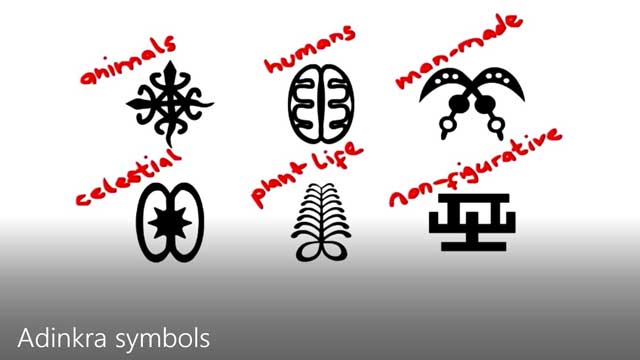
-
 Patrique deGraft-Yankson
Patrique deGraft-YanksonSome of these signs and symbols depict historical events, human behaviour, animal behaviour, attitudes, plant life forms and shapes of objects, many of which have grown to assume recognizable iconographic dimensions. Others carry rich proverbial messages that are traditionally considered a mark of wisdom. These attributes indeed give credence to the need for the preservation and popularization of traditional symbolism and imagery.
Therefore, in this project (which is one of many others in progress) therefore, has made an attempt to repackage Adinkra and other traditional symbols through animated videos. The aim is to make these age-old symbols more accessible and attractive to the modern Ghanaian youth. Presenting traditional symbols digitally would not only appeal to the youth, but would also ensure widespread visibility, presentation and thus, better preservation.
published October 2020

-
 Patrique deGraft-Yankson
Patrique deGraft-YanksonWe may be right to assume that the level of awareness just at a little over four years of its implementation should not be too alarming. However, analyzing such low level of SDGs awareness among a people a country whose president is a Co-Chair of the Eminent Group of Sustainable Development Goals Advocates in Africa leaves some cause to worry.
The good news however is that, not being directly aware of the SDGs in the way they have been blueprinted does not mean the people are insensitive to its calls and claims. The fact is that, most of the demands of the SDGs are already embedded in the culture and belief systems of the people, and I consider this as an important resource to deploy for awareness creation and enthusiastic implementation of the SDGs.
For the realization of UNs commitment to leave no one behind in the mobilization of the citizens of the world to achieve the 2030 agenda (UN, 2020) therefore, I am of the belief that efforts at linking the relevance of the 17 goals to cultural manifestations of the people should be highly considered. The image shown above is a demonstration of how various traditional symbols speaks to the SDGs in a language which is understood by the traditional Ghanaian. These symbols transcend language barriers and their meanings are inherent within their traditional belief systems, making the goals both physically and spiritually relevant to people.
The meanings of the symbols are as follows:
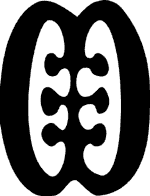
Ese Ne Tekrema (The teeth and the tongue)
Symbol of generosity towards one another. Through the formation of a linear relationship in diversity towards a common goal, both the personal and societal needs of the people will be realized.
Funtumfunafu Denkyemfunafu (Siamese/conjoined crocodiles)
Symbol of brotherly feeling, caring and sharing. The society stays stronger when people coexist in the belief that we all smile and grow together when we feed and enjoy the good things in life together.
Dua Afe (Wooden comb)
Symbol of sanitation, cleanliness and beauty. This symbol reechoes the essence of physical and spiritual wellbeing through personal and environmental cleanliness.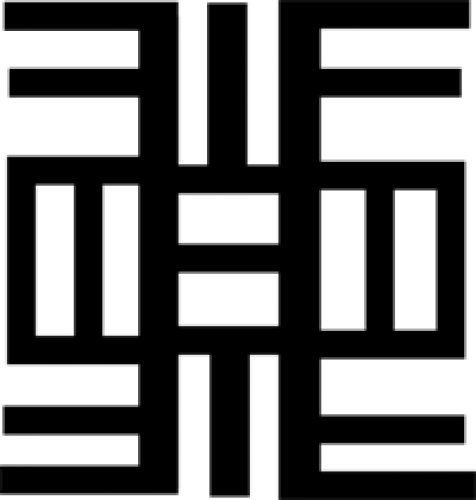
Nea Onnim No Sua a, Ohu (Anyone who does not know is capable of ‘knowing’ through education)
Symbol of educational opportunities. This symbol plays down ignorance by reminding people of their inert capabilities to get educated to any level of their preference. In other words, opportunities for quality education exist for all.
Obi Nka Bi (No one bites the other)
Symbol of equal regard, recognition and treatment for all. No one bites the other as a value ensures that all genders and age groupings have equal rights for existence in the society which allow them to listen and be listened.
Sesa Wo Suban (Change your life)
Symbol of deterrence and admonition towards all unapproved societal behaviors that affect the natural environment. This symbol represents strong advocacy for transformation and dynamic life patterns that affect nature. One of the unacceptable life patterns this symbol is currently addressing is the Ghanaian youth’s preference for wealth through illegal mining which destroys precious water bodies
Pempasie (Sew in readiness)
Symbol of production and sustainability. This symbol emphasizes the importance of societal preparedness and readiness for the future through effective production and management of all resources for posterity.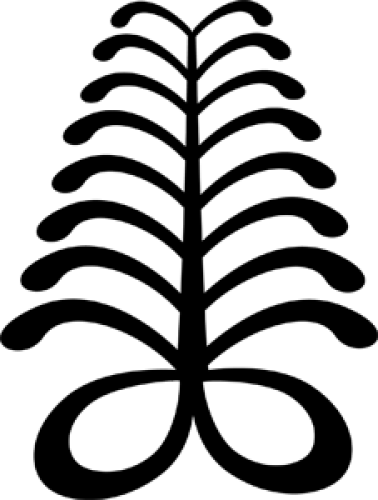
Aya (Fern)
Symbol of resourcefulness through resilience, self-reliance, hard work and judicious engagement of the environment and its resources.

Nkyimkyim (Twisting)
Symbol of collective action towards the building of the human society through initiative, dynamism, versatility, innovation and resilience. Indeed, building a successful society, like life itself, is not a smooth journey. The journey of life is tortuous and it requires a great amount of innovation and creativity to sail through.
Nkonsonkonson (Chain)
A symbol of unity. This symbol, depicting two links in a chain, advocates for the need to heal the componentized society since in unity lies strength.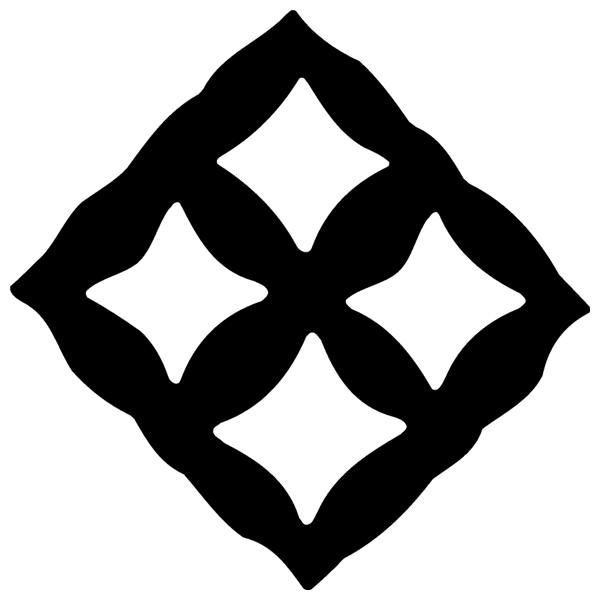
Eban (Fence)
A symbol of love, safety and security. The fence symbolically secures and protects the family from unhealthy activities outside of it.
Hwehwe Mu Dua (Measuring stick)
Symbol of examination and Self/Quality Control. This symbol emphasizes the need for circumspection in all human endeavors. It directs attention to self and quality control in everything including production and consumption. It admonishes against over consumption, over production and all forms of egoistic instincts and behaviors which adversely affect the general good of the society.

Nyame Biribi Wo Soro (God resides in the heavens)
Symbol of reverence to the heavens, the abode of the Supreme Being. Recognition to the ‘heavens’, or the skies as the residence of the supreme being is tied to the belief that all good things come from the heavens – rains, sunshine, fresh air, etc. The ‘heavens’ need to be respected for continuous flow of life-given goodies.
Ananse Ntentan (Spider’s Web)
Symbol of knowledge and wisdom about the complexities of life. This symbol alludes to the intricate personality of Ananse, the spider, a well-known character in Ghanaian/African folktales. In Ananse’s world, all facets of life need to be somehow manipulated, positively or negatively, for good or bad reasons. This sometimes led him to dire situation. Ananse therefore is a character for admonitions and reprimanding. Being conscious about the character of Ananse guides your steps against any unfair treatment to the world around you, be it the skies, on the land, in the waters or below the waters.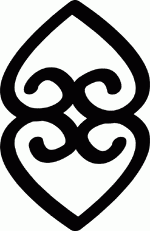
Asase Ye Duru (The Earth/Land is heavy)
Symbol for reverence and recognition to the providence and the divinity of the ‘Earth/Land’ and everything associated with it. The ‘Earth’ is the mother to everything. It carries the entire humanity, trees, water bodies, the sea (and what is in it and beneath it), big and small animals, etc. This why it is described as ‘heavy’. Respect/reverence to the Land is respect/reverence to life.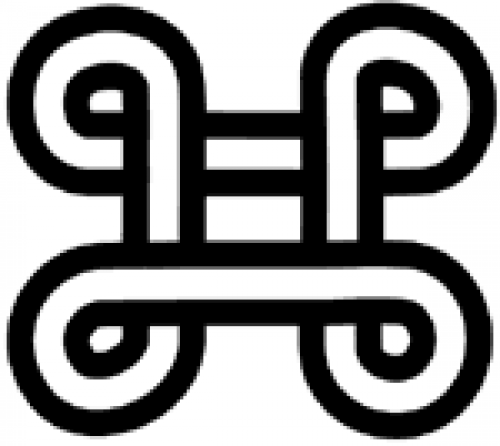
Mpatapo (Knot of Pacification/Reconciliation)
Symbol of bonding and adjudicatory factor which brings back parties in a dispute to a peaceful, harmonious and reconciliatory coexistence to ensure unified and strong societies and institutions.
Ti Koro Nko Agyina (One Head does not forma Council)
Symbol for partnership, collaboration and teamwork. This symbol emphasizes the importance of cooperation and collective efforts in the realization of all goals. Obviously, the attainment of the SDGs is a collective responsibility. No one nation (one head) can make it happen. It takes the concerted efforts of the entire citizenship of the world.Bibliography
- Adinkra Brand, A. (2020, November 15). African adinkra symbols and meanings. Retrieved from Adinkra Brand: https://www.adinkrabrand.com/blog/african-adinkra-symbols-and-meanings/
- Kasahorow Adinkra Library, K. A. (2020, November 15). Adinkra symbols and meanings. Retrieved from Kasahorow Adinkra Library: https://www.adinkrasymbols.org/symbols/nkyinkyim/
- United Nations, U. (2020, December 7). Sustainable Development. Retrieved from Uited Nations: https://www.un.org/sustainabledevelopment/development-agenda-retired/
published January 2021
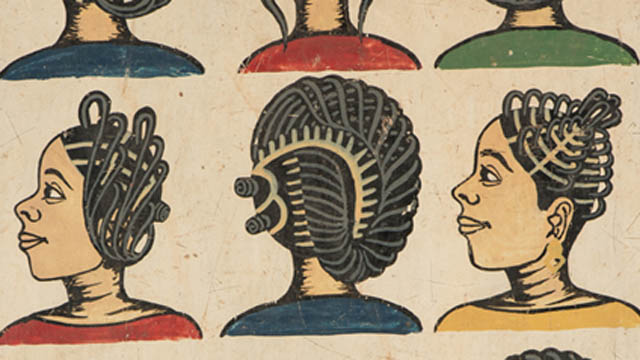
-
 Osuanyi Quaicoo Essel
Osuanyi Quaicoo EsselCatching a glimpse of the feminine hairstyles (re)presentation in rows on a single support, brings to memory the barber salon promotional campaign artworks that served as visual displays to invite potential customers in parts of Africa in the past. Artists in the community were commissioned to create picturesque signages that display plethora of Afrocentric hairstyles on wooden boards and placed in front of hair salons or vantage points to attract potential clients. The artworks served as form of advertisements to the salon operators. Some itinerant hairstylists moved around with these signages in search of customers. The painted images have been replaced with printed catalogue of pictured hairstyles printed on large sheet of papers and flexy materials which are displayed in and outside salons in the communities. The picturesque hairstyles signage presented in this exhibition reminisces the artistic practice of creating these portraits as form of hair salon advertisement in Togo, Ghana, Nigeria and other West African countries.
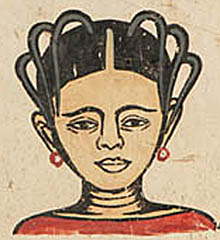
Cutout from anonymous artist, second half of the 20th century, plywood, oilpaint, Image: Osuanyi Quaicoo Essel.
Uniformly arranged on a support, the artist presents fifteen Afrocentric feminine flashy plaited coiffures in portrait orientation. Of the fifteen hairstyles, one occupies the epicentral position of the entire composition in frontality of pose, depicting her full facial details in simple flat tone of brownish colour with the hair stylization rendered in black. Her rigged neck, pronounced eyebrow and bejeweled ears depicts her feminine characteristics. In Togolese culture, wearing of earring is a preserve of females as in the case of Ghana and some West African countries. The artist’s treatment of this centrally placed figure gives hint of Togolese feminine beauty standards. Four of the hairstyles are shown in side view, facing the left. Similar to these four figures in profile are the type-form head, rigged neck details and varying earrings. The rigged neck features found on these four figures also appear on the centrally placed figure in the composition. With this treatment, the artist makes visual notation of feminine beauty culture standards that characterised some West African countries. Rigged neck feature is considered as a marker of beauty ideal, and commonly depicted in West African feminine sculptures. For example, Akuaba (wooden doll, predominantly used as fertility figure), of Ghana is often armoured with rigged neck characteristics. Understanding the beauty culture ideals of Africa depicted in this simple but interesting hairstyles composition offers viewers of African art a better understanding of the art.
To reveal a great deal of the level of sophistication of the hair stylizations, the artist showed ten of the figures in back view posture, three each atop and down in horizontal placement, while four are arranged in a kite-shaped arrangement in the middle portions of the painting. The artist generates visual interest with the arrangement of the figures to create a sense of movement, variety and rhythm. For example, in the depiction of the clothing of the figures, shades of reds were used in a serpentine orderliness that forces the eyes to traverse gracefully upon a gaze from the topmost middle part to the down and vice versa. Similar colour treatment is achieved with shades of blue from the top left, moving in diagonal direction to far right of the middle portion of the painting, and orchestrating another diagonal turn towards the down left part. One striking feature that bedews the ten hairstyles in back view posture, is the skillful use of the negative and positive spatial relations that creates visual curiosity for deeper gaze of the hairstyles. With the exception of the blue-shirted figure on the last row of the composition, the remaining blue-shirted figures wear trumpet-shaped hairstyles with multi-sectional visual interests.
All the hairstyles represented by the artist are a reflection of the Afrocentric standardized beauty ideologies and practices inherent in the social environment of practice. These hairstyles make use of no hair extensions and or wigs; and are also practised in Ghana and other neighbouring countries. Females usually cared for their hair to grow long and plait it with black twine to form long narrow stripes which are then arranged in a particular manner by way of styling. Based on the society that wear them, the hairstyles may be given names and have symbolic meanings. The hairstyles portrayed are usually worn by the youthful and middle-aged females.
Colonialists’ invasion, slavery, Western religion, racial discrimination, amongst others, contributed to Black hair stereotyping which has caused some Black women to resort to hair beauty ideals of the colonialists. Historically, the discrimination resulted in some Black women who found themselves in foreign lands, hiding their hair by using coverings, especially, in public places. Some Black women use artificial chemicals to straighten their hairs to imitate the beauty ideals of the colonialists. Despite the counter-resistance to the stereotyping of Afrocentric hairstyling through civil right movements and visual (re)presentation by its practitioners and artists, many African women now wear extensions and wigs, a trend that raises the question of identity crisis and politics. The work of the artist in this context sheds light on the purely Afrocentric hairstyling culture of Togo and its neighbouring countries, and makes unapologetic statement of turning away from the colonial past.
The work brings into focus the need for fashion art educator and artists to join hands in contributing to institutional restructuring of teaching and learning of African fashion history including standardised beauty ideologies and ideals for reclamation of the past, and impenitent practice of Afrocentric beauty culture. Towards this end, teaching and learning should be focalised on the African cultural reorientation, concept of sankofaism (return to fetch the goodies of the past) and respect for one another irrespective of geography, skin colour, hair type or physique. Learners must be taught to build positive self-esteem and love for their culture, and demonstrate love for individual differences.
This article is part of a gallery: Perspectives from Ghana on Museum Objects in Germany
published January 2021
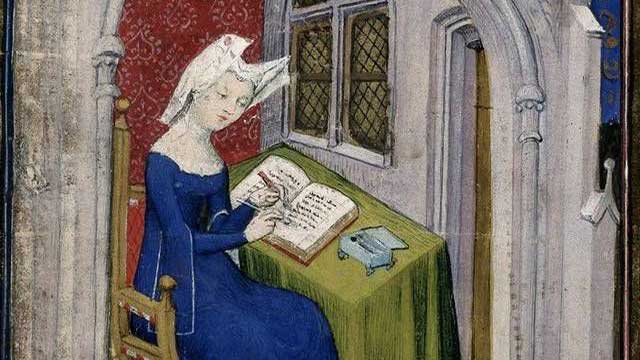
-
 Bea Lundt
Bea LundtThe picture of Christine de Pizan and our knowledge about her life show that this is not true. Christine de Pizan (1364 – c. 1429), born as Cristina da Pizzano in Venice, was a poet and author at the court of King Charles VI of France. Christine produced a large number of vernacular works, in both prose and verse. Her works include political treatises, mirrors for princes, epistles, and poetry.
This very famous miniature is an illustration from a book, handwritten in the years between 1410 and 1414 and preserved at the British Library in London (Harley MS 4431, Vol. 1, fol. 4 r). This manuscript contains texts by Christine de Pizan and is called The Book of the Queen, as it had been produced on behalf of and dedicated to Isabeau of Bavaria, wife of King Charles VI of France. There is another miniature showing Christine on her knees dedicating the book to the French queen. Christine can be identified by her facial features and style of dress.

Detail of: Master of the Cité des Dames and workshop, 1413 - 1414, parchment, 36,5 cm x 28,5 cm, British Library, London. © British Library, London. Photo: the author
In the centre of the aforementioned picture, a woman is shown sitting at a table and writing into a voluminous book. With her left hand, she is erasing coloured letters with a knife and with her right hand correcting them. This dynamic gesture of self-correcting fills her working situation with life. On her head is a headdress typical for a widow, the guimpe/wimple. Around the desk, we see some fictive architecture with a broad symbolic meaning: it shows a room which is specifically tailored to an intellectual working woman but also opens to the outside, as there are windows, an arch, and entryways. The roof of another storey marks the building as a town house. Though the scene is an interior one, the colours on the woman are bright, and there are warm red colours around her. This is different from older pictures showing clerical female authors in the narrow, closed rooms of a cloister.
‘Je, Christine’: An independent author defining her role in society
The picture shows a professional female author in an urban context in the process of writing a book and working for the public, where she is honoured as being part of the highest level of society. There are similar pictures with Christine sitting behind her desk with an open book and people coming and arguing with her in a lively manner. In one, a young man, who has been identified as her son, stands in front of her and speaks to her. Another one shows four men visiting her in her room and discussing her writings with her. Sitting Christine, standing men: the arrangement shows that the guests will leave soon. Such encounters are also atypical for a cloister, which is said to be the usual space for educated women.
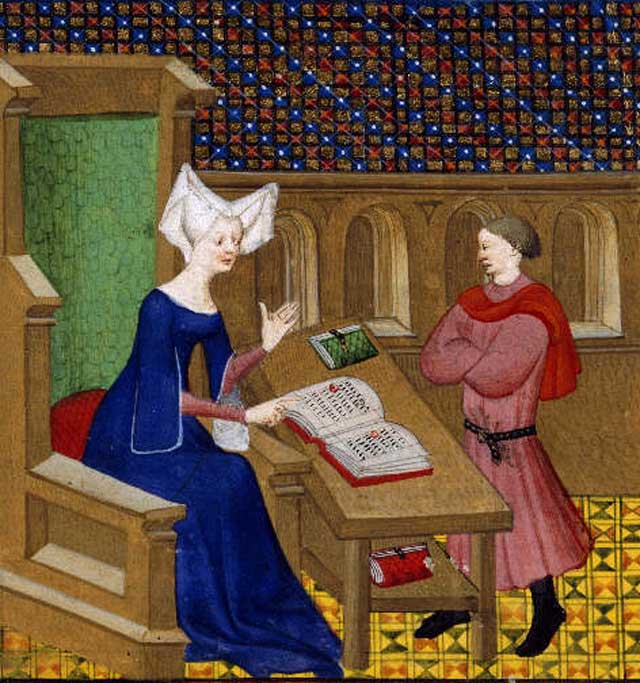
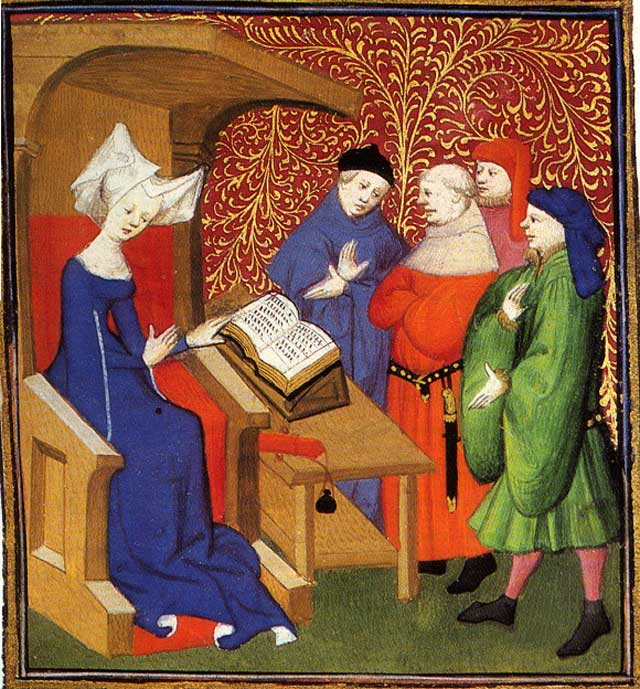
Detail of: Master of the Cité des Dames and workshop, 1413 - 1414, parchment, 36,5 cm x 28,5 cm, British Library, London. © British Library, London. Photo: the author
As experts see it, it was Christine herself who ordered the illustrator to characterise her in this manner. Several autobiographical comments of hers document that she liked to show herself living this individualist intellectual lifestyle. Traditional scholars call this typical for the Renaissance, which began a bit after Christine’s lifetime. Very often in her books we find ‘Je, Christine’ (‘I, Christine’), at the beginning of a chapter.
Christine’s life story
Christine was born in Venice in 1364 as the daughter of a doctor of medicine and astrology. He was called to the French court in Paris. Christine married a royal secretary and had three children. But then her father, her husband, and the king who had supported the family died. Christine was 25 years old and had to care not only for her children but also for her old mother and younger relatives living with her. She decided not to marry again but to support her living by writing. Her oeuvre contains poems alongside utopian, philosophical, historian, didactical, allegorical, and autobiographical texts. Noble families ordered her books and paid her well. In her old age, she escaped from the civil war in Paris to a cloister nearby where she died around 1429.
The first secular female author in Europe
With her Italian-French background, Christine is an example for the migration of intellectuals in southern Europe in the late Middle Ages and early Renaissance. She was not herself noble but came from an academic family and remained near the court. She was privately educated, mostly by her father, and also educated herself using the offer of the erudition centre in France. Living within a totally Christian cosmos with a spiritual way of thinking, she was not a clerical but rather a secular woman. In her books, she fought for gender equality, especially in education, as well as for recognizing the extraordinary performances of women in the past and in her own time. She wanted this knowledge to be part of a new understanding of history. She sharply protested against texts which reduce women to sex objects. With her pugnacious notes, she provoked the first literary quarrel about femininity and masculinity in Europe, the ‘Querelle des Femmes’.
The masculinisation of literacy and education in the modern era
In premodern Europe, competencies in literacy were considered more or less ‘feminine’. Girls learned to read at least the Bible to their families; noblewomen were taught languages and literature to be able to marry into different countries. The ideal for masculinity was fighting strength; sitting with books seemed to be viewed as non-masculine. Many kings and noblemen were illiterate. This changed in modern times. Literacy became part of the public world and school education developed as a privilege of men.
In the colonial period, Europeans attempted to impose this central European order on the African colonies: women were relegated to the private sphere, while men had the privilege of acting in public, which was more valued. The colonisers argued these gender roles were anthropologically fixed constancies, and they had the civilising mission of transferring this pattern to their colonies. But African scholars insist that in precolonial times, polar structures of different worlds for men and women did not exist, exactly as they had not in premodern Europe.
Conclusion: Confirming non-dualistic, fluid gender concepts
As we still need to fight against the discrimination of women and girls in educational systems worldwide, the message of the picture might be encouraging. This visual icon helps to deconstruct a common myth about Europe and to reject static ideas about continuities of bipolar gender structures. Even in the European Middle Ages, independent female authors were shown, combining inside and outside worlds. To see that it was different in history motivates us to see the hybridity of gender structures on both continents, which do not merely follow the dualistic scheme of men working in public professions and women working as housewives.
References:
- Christine de Pizan: Le Livre de la Cité des Dames. Stock 1986 (French).
- Christine de Pizan: The Book of the City of Ladies (Penguin Classics) rev. 2000 (English).
- Christine de Pizan: Das Buch von der Stadt der Frauen. Originally in Middle French. Translated and with commentary and an introduction by Margarete Zimmermann, Orlanda Buchverlag Berlin 1986, dtv 1999 (German).
- Roberta L. Krueger: Towards Feminism: Christine de Pizan, Female Advocacy, and Women’s Textual Communities in the Late Middle Ages and Beyond. In: Judith M. Bennett, Ruth Mazo Karras (eds.): The Oxford Handbook of Women and Gender in Medieval Europe. Oxford University Press 2016, pp. 590-606.
- Henry Kam Kah: The Sacred Forest. Gender and Matriliny in the Laimbwe History (Cameroon), c. 1750-2001. Berlin 2015.
- Oyewumi, Oyeronké: Colonizing Bodies and Minds. Gender and Colonialism. In: ibid (ed.): Invention of Women. Making an African Sense of Western Gender Discourses. Minneapolis, MN 1997, pp. 121-156.
Edited by Kelly Thompson.
published August 2020
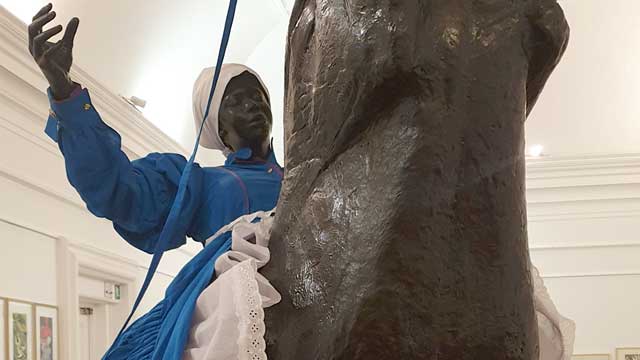
-
 Estelle Vallender
Estelle VallenderMary Sibande’s sculpture The Reign (2010) affects the viewer due to its interplay of bipolarities such as European/African, male/female, past/present, working class/bourgeoisie, private/public, reality/fiction. It forces us to scrutinize our contemporary thinking about the past in relation to the present. The criticism of the colonial era and the rebellion against limitations, that history has placed on identity is inherent in the work, which focuses on African women, historically oppressed as Blacks, as workers, and as women. As a sign of resistance and tribute to all Black women fighting for equal rights it raises questions about race, class and gender.
Vaulting on a boisterous horse, a life-size female figure is displayed in the hyperrealistic sculpture. Rider and mount – both made of fiberglass – are identical in color, creating a consistent medium of presentation for the abundant dress supported by a scaffolding of white and purple undergarments rimmed in Broderie Anglaise, a technique of embroidery, which originated in 16th-century Europe. In addition, the mannequin wears a white apron tied into a voluminous bow at the back and a white headscarf covering her hair. On the one hand, the distinctive elements of the apparel such as puffed sleeves, petticoats and ruffles can be identified as characteristic features of 19th-century Victorian fashion. The style of clothing popular in Great Britain was brought to Africa by the settlers during the unprecedented expansion and consolidation of the British Empire, where it became a symbol of colonial rule. On the other hand, the specific blue color in combination with the white headscarf, collar and apron refers to the uniform of South African maids, that has hardly changed until today. Domestic service – established in the earliest days of European colonisation and later assured by Apartheid – has long been a major sector of the South African labour market. In 2010, the same year the sculpture was created, “the domestic worker industry employed 18% of all women, and 80% of domestic workers were women, with poorly educated Black South Africans making up the vast majority of these women.” (Bosch & McLeod, 2015, p. 135, quoted after Dinkleman & Ranchod, 2010) Readily available at local supermarkets the artist draws on the maid’s uniform and uses the mass product as starting point for her textile hybrids. Born into a line of domestic workers that stretches back three generations, Sibande makes her family history the subject of her art. (Dodd, 2010, p. 467) From silicone casts of her own body she created a fictional character named Sophie [the English name given to her grandmother by her white employer, as Corrigall (2010, p. 155) states]; as alter ego, homage, and representative of former and current domestic workers, she appears here as the protagonist of the work. Through the interplay of the Black body and the dress oscillating between workwear and sublime gown, Sibande performs a subtle manipulation of the semiotics of fashion and their social function as indicators of status, gender, and affiliation (Corrigall, 2015, p. 150). Power relations are explored and the dichotomy of maid and mistress, which implies further bipolarities such as colonist and slave, oppressor and oppressed, European and African, woman of substance and pauper, is deconstructed. “Sophie” occupies the role of the white landlady and thus claims a social position denied to her by repression and racism, whereby her outfit can be read as recovery of autonomy through dispossession of the 'Other'. Regarding the title of the work, the words reign and rein are played on here. In The Reign she is holding the reins both figuratively and metaphorically.
The composition is, also due to its surface property and shade, reminiscent of the European equestrian statue, a portrayal of a sovereign, politician, or commander on horseback, that has functioned since antiquity as a tried and tested means for the demonstration of male power. During colonial rule it was also introduced in South Africa; two well-known examples are the statues of Louis Botha (general in the Second Boer War and first prime minister of the South African Union) in Cape Town and Cecil Rhodes (British entrepreneur and one of the leading players during the high point of imperialism) in Kimberley. Thus, the equestrian statue as a form of representation of white supremacy is anchored in the collective memory of South African society and is here referred to, deconstructed, and reinterpreted by Sibande.
By replacing the idealized male character with a Black female figure, the artist adds an additional layer to the postcolonial debate about South Africans as oppressed Blacks and oppressed workers: women’s limited scope of action in the patriarchal system. Through the usurpation of potentiating positions of power – the mistress first, the sovereign second – Black femininity is calling for an uprising. Dodd (2010) points out that the maid, who is expected to disappear, unseen and unheard, into the background of private life and thus remained socially and culturally invisible for a long time, has assumed the center stage, boldly announcing herself to the world in the gallery room. Her visibility in public space was once again enhanced as the sculpture was featured during the 2010 World Cup within the city of Johannesburg on the side of a building as large, photographic mural. To ensure a dominant and imposing presence, Sibande shows the mount in the so-called pesade: Using the horse's body as a shield and its front hooves as a weapon, the rider is erect according to the movement of the rearing horse and is usually depicted in paintings and sculptures as a battling hero with a sword in his hand and a determined expression on his face. “Sophie” can thus certainly be understood as an insurgent and tribute to all Black women fighting for equal rights. But in my reading the absence of a weapon and the daydreaming character of the human figure, which has her eyes closed as if in trance, break with art historical tradition and expose the scene as an objectification of inner desires and empowering imaginations. The overcoming of class and gender boundaries as well as of limitations, that history has placed on identity, still more of a wishful thinking than an actual condition. This is also evident in the ambivalent figure of the horse, which on the one hand symbolizes the momentum of the protest movement, but on the other hand can also be interpreted as the oppressive system that must be made compliant. While circling the sculpture, it becomes visible, that the dynamics of the animal are not necessarily reflected in the rider’s posture. In a fragile intermediate state, half falling, half vaulting, she presents herself to the viewer from one side as if she were controlling the horse, and from the other as if she would be thrown off at any moment. The Black woman exploring options in the political and social field is thus in a constant balancing act between control and loss of control, combat and lethargy, fiction and reality.
In the large scale work The Reign, Mary Sibande calls on the elaborate attire of the Victorian era to, in some way, refashion our contemporary thinking about the past in relation to the present. She is intent on collapsing binaries around race and power, and alerting us by means of the textile, which is a linchpin of identitarian negotiations, to unexpected interplays between apparently oppositional and asymmetrically related cultures; the plastic body thereby serves in accordance with the functionality of the mannequin as an accessory that reinforces the statement. Clothing is used performatively and, in addition to the cultural reappraisal of national history on the macro level, functions on the micro level as a vehicle of expression and personal search for the artists own postcolonial identity.
References
- Bosch, Tanja / McLeod Caitlin: Dress, Address and Redress. The relationships between female domestic workers and their employers in Cape Town South Africa, in: Global Media Journal African Edition, Vol. 9 (2015), p. 134-155.
- Corrigall, Mary: Sartorial excess in Mary Sibande's “Sophie”, in: Critical Arts 29 (2015), p. 146–164.
- Dodd, Alexandra: Dressed to thrill. The Victorian postmodern and counter archival imaginings in the work of Mary Sibande, in: Critical Arts 24 (2010), p. 467–473.
- Long Live the Dead Queen (Exhibition Catalogue). Gallery MOMO Johannesburg 2010, Johannesburg 2010.
 Avitha Sooful
Avitha SoofulIn my reading of this work, I am tempted to and almost seduced by the immediate crutch of a colonial critique that is rooted in positioning the rider and horse within a Eurocentric frame. Instead, I re-read the words spoken by the artist Mary Sibande in an interview held with Malibongwe Tyilo (2021) from the Daily Maverick that crystalises Sibande’s thinking. “My work is not about complaining about apartheid, or an invitation to feel sorry for me because I am black and my mothers were maids. It is about celebrating what we are as women in South Africa today, and for us to celebrate we need to go back, to see what we are celebrating. To celebrate, I needed to bring this maid” (Tyilo 2021).
In summary, Sibande speaks of celebrating black women today and this is vested in the courage that black women had during apartheid to protest against such experiences. It was my responsibility as a researcher to seek out these celebratory moments that Sibande speaks about in her work. In response to the sculpture The Reign (2010), the artist portrayed Sophie riding a black horse that stands on its hind legs referred to as rearing. The rearing of a horse is associated with aggression, disobedience, or pain that is experienced by the animal and in this case, the horse appears to be a mare rather than a stallion. The rearing can also be caused by an inexperienced rider however, it appears that Sophie is calm and in full control of the horse that she rides. Would this animal not be a metaphor for all black women during apartheid in celebration of their aggression, disobedience and pain endured while facing the inhumanity that was meted out to them? In retaining this thought, would Sophie then not be a symbol for all the black female leaders who led the women’s struggle during apartheid and who were also labourers on the farms and domestic workers in cities?
I think that Sibande deliberately played with the pronunciation of the words reign and rein when she titled the work. On the one hand, the work references the reign of black women who were revered as queens when they marched and protested their abuse. The fact that they were severely undermined by apartheid restrictions made them more militant than men. During the years of abuse under apartheid, anger festered within black women, giving rise to 60 000 women who marched to the Union Buildings in Pretoria in 1956, a protest against the pass laws and the 1957 Public Utility Transport Corporation (PUTCO) bus boycott which began in Alexandra. Women also formed the Natal Organisation of Women (NOW) in 1983, The Federation of Transvaal Women (FEDTRAW) in 1984 and the United Democratic Front Women’s Congress (UDFWC) in 1987. Women as members of these organisations protested and marched against high rents, increased food prices and demanded the release of incarcerated black leaders.
Sibande also references rein in this work that indicates the control that the rider has on the horse or the female leadership over the thousands of women who marched on apartheid via protest marches and the formation of women’s organisations. This idea of control via the use of a rein is indicated by the blue length of the rein attached to the horse that Sophie loosely holds in her hands. This shows that Sophie does not require or impose an aggressive response to the rearing horse but allows the horse to perform as Sophie does sitting on its back. In this paused moment, control is about leadership that is asserted without force.
The Reign (2010) appears to include the seeds of democracy with Sibande’s use of the purple undergarment that the rider wears. This introductory period would be 1989 into the 1990s when the African National Congress and many other anti-apartheid organisations were unbanned, and many political prisoners were released including Nelson Mandela which allows for the greater celebratory moments that Sibande refers to. The year 1989 is significant apart from it being the year when violent protests took place nationally, in schools, universities and on the streets. It was the year when the police used purple dye in water cannons to spray protestors, a dye that did not wash off easily and was referred to as the purple rain.
When one considers the idea of protest during apartheid, it was a performance by a mass of people, a performance that included song, dance, body gestures and movements that emulated, ridiculed, and promoted a different approach to the ‘norm’. The rearing horse is a performance indicative of the protests that fuelled the journey to democracy. A journey that demanded sacrifices from black people of their time, lives and brutality that can only be imagined. In my view, the meters of the blue dress that Sophie wears is a metaphor for the millions of workers who participated in this struggle. The sculpture is a metaphor for the black female struggle during apartheid, her struggle against patriarchy and a demand for equality that was situated within the broader apartheid struggle. These two struggles gave birth to the adoption of the Women's Charter (1954) and the Freedom Charter (1955) in Kliptown, Soweto.
There is no doubt that the work is a critique against colonial rule however, the manner in which Sibande has invented and presented the work, is saturated with the achievements of black women within metaphors of significance that describe the black female struggle without pity. It celebrates black female achievements in eroding the inhumanity imposed by apartheid specifically on women who endured the slurs and oppression of race, class and gender.
The fact that Sophie sits with her eyes closed, allows her to reminisce about the periods that announced the celebration of black women’s victories against the apartheid beast through women’s protests, boycotts, arrests, torture, fragmented family lives and mass marches. The domestic attire is Sibande’s prop for the historical enactments that define black women’s contribution to the struggle against apartheid.
In my view, Sibande’s work The Reign has encapsulated black women’s struggle not only against apartheid but their right to equality within a South African democracy.
References:
- Tyilo, M. 2021 Iconic South African Works: Mary Sibande’s ‘The Reign’. Daily Maverick. 22 June (online)

-
 Natalie Göltenboth
Natalie GöltenbothSir David Adjaye puts his hands on the ochre-coloured earth walls of the pavilion while speaking into the microphone: “We have brought that earth here. This is West Africa, this is Ghanaian soil that was applied by Venetian plasterers." 1
Sir David Adjaye, the renowned British architect with Ghanaian roots, based the design of the Ghana Pavilion on the traditional earth buildings of the Gurunsi from Eastern Ghana. The organically merging ochre room sequences evoke a rural Ghana in which the works of the six artists are presented. All of them have Ghanaian roots, but some live and work in England. In an interview, he describes his understanding of architecture as follows: “Art and Architecture create powerful narratives about our lives. Architecture is a story, it’s a way of marking and talking about our aspirations and hopes. So, in what I do, the methodology to every project I make, is to find a narrative [...].”2
This raises the question of the possible interpretations of the pavilion. Out of a multitude of possible architectural quotations and structures that could represent Ghana, it is rural Ghana that was chosen as the structure and backdrop for the artworks. But it is precisely the Gurunsi and their country that were worn down by the European colonial powers in the course of the conquest of West Africa and were finally divided in two at the end of the 19th century by their geographical affiliation to the French and British administrative districts. In this respect, a connection can be drawn to the all-encompassing motto of the exhibition – dealing with the colonial period that ends with the final cry of triumph “Ghana Freedom”.
In addition to this critical, post-colonial discourse, the pavilion also invites an interpretation in which “Africa” is staged as an earthy, dark and rural-tribal space: as much as you feel comfortable inside, the bright light makes you blink when you step out. The odour design by Ibrahim Mahama from the first honeycomb of the pavilion offers a further sensory component to this impression.
While the conscious use of white cube gallery spaces was a struggle for contemporaneity and belonging to the global art discourse,3 Adjaye has decided on a placemaking, in which “Ghanaian identity” is presented as an imaginary picture of origin and authenticity or a rural cut-out reality. In addition, the multiple experiences of London-based artists, such as Akomfrah and Yiadom Boakye, are, thus, transferred back to their native Ghanaian earthworks.
This raises the question of how much of Ghana’s aesthetic construction is to be seen as a concession to the expectations that the global art world places on the artists of African countries. Just as Edward Said has described this for the Orient4, it remains to be examined whether an imagined “Africa” has not just been created in the global art world, whose multiple requirements put artists from the African continent under pressure to master the balancing act between postmodern, conceptual approaches and African side-specificity or even ethnicity in the form of an aesthetic Africa-specific local flavour. Here in the national pavilion of Ghana, the artists are released from this pressure insofar as the pavilion already provides the aesthetic headline or frame which harmonises all the works exhibited there under the imaginary of Ghana/Africa.
While experiencing the pavilion, it becomes clear how difficult it might be for artists from an African country and its diaspora to position themselves within the global art discourse without falling into one of the numerous traps that lurk there, starting with the simplest chain of associations of clichéd fantasies. Close your eyes for a moment and tell me how you imagine the national pavilion of a West African country: earth, elephants, desert, migrants, sunsets, recycling art and a strong smell of spoiled fish?
That the expectancy of local flavour can also be handled quite differently becomes evident if we consider a young generation of Cuban artists, such as Alejandro Campins, who ask provocatively: “Cuban art, what’s that?”5
Expectations can also be met with confrontation in other respects. As a response to the demand for the adjustment to concepts of art influenced by Europe and North America, the artist collective Atis Rezistans from Haiti launched their own biennial with the programmatic title: "What happens when first world art rubs up against third world art? Does it bleed?"6 With this idea of a clash of art cultures, they are more radical in asserting their own (bloody) concept of art. However, this kind of confrontation is not for everyone. (Link)
Enwezor sums up these expectations clearly when he says that artists of African origin, whose contemporaneity he appreciates, must, in any case, comply “to be deeply located within conceptual and postmodernist matrices”.7 As understandable as this may seem from the perspective of Euro-American contemporary art concepts, it is, nevertheless, clear that it is precisely these “matrices” mentioned by Enwezor that exclude other ways of making and understanding art. That they are able to do so is due to their position of power.
The social anthropologist Thomas Fillitz speaks of the contemporary global art world as a world culture, ultimately a global transnational culture, only to conclude that “this global art world continues to be determined by the discourses of Occidental art history and its affiliated ordering systems of classification”.8 We should ask to what extent the concept of art is one of the last (so far only weakly attacked) bastions of an Eurocentric view of the definition of contemporary art and, thus, a kind of colonial survival. The increasing networking of individual art worlds does not necessarily bring about an equal reciprocal exchange.
In this respect, the Venice Biennale could be understood as the palace of this concept of art – a place where its “Urmeter” (standard) of the art is measured and conveyed in a constantly redefined way by mostly European-North American curators and art theorists.
Now the question is how exactly at this place, the Venice Biennale, as a classical place of westernness and whiteness in Ghana’s National Pavilion (even if it comes along in the manner of the buildings of the Gurunsi corrupted by the colonial system), can a confrontation with Ghana’s colonial past succeed, which in the end would have to be continued as a confrontation with existing power structures. But this does not seem to be the intention. It is too much of a joy to finally get the desired recognition from exactly this system and yet, there remains the stale taste of a paternalistic hierarchy in which Ghana is proud to finally present itself to the art world represented in Venice.
Nevertheless, the debut of the Ghana Pavilion is still a real success story, especially when one considers the representation of other African countries at the Biennale di Venezia. Only four countries of the African continent were represented with a national pavilion in the main exhibitions at the 58th Biennial, the others had to be sought out in sometimes often arduous exploratory walks in the urban area. This shows that participation and the positioning at the Biennial is linked to the political structures in the country, with contacts to European decision makers with financial resources but also with clear goals.
From the outset, Ghana’s national pavilion had a clearly defined mission, which, in turn, is inextricably linked to the nation state and its representation. Taiye Selasi9 in his article “Who is afraid of a National Pavilion?”, after critically reviewing the structure of the Venice Biennial, asks: “Is there any good reason […] to exhibit theses six wildly different artists as Ghanaian?” “Yes there is”, we hear the tourism manager Barbara Oteng Gyasi, the curator Nana Oforiatta Ayim, the Ghanaian Ministry of Tourism Art and Culture and the architect David Adjaye calling. They are all working together on the script of a “bigger book” – the positioning of Ghana on the global stage as one of the African countries that can promote itself with its art and culture,10 in short, as a country to be proud of. And so we are not claiming too much when we state that one of the greatest successes of the Ghana Pavilion at this year's Venice Biennale was that it became a place of pride and identification for its many visitors with African decent.
 Sergio Linhares, student at the Department of Social and Cultural Anthropology, LMU Munich while conducting research on the perception of the Ghana Pavillon at the Venice Biennale, June 2019. Foto: Natalie Göltenboth
Sergio Linhares, student at the Department of Social and Cultural Anthropology, LMU Munich while conducting research on the perception of the Ghana Pavillon at the Venice Biennale, June 2019. Foto: Natalie GöltenbothFootnotes
1 Sir David Adjaye in an Interview with Al Jazeera Journalist Charlie Angela (www.youtube.com/watch?v=6PM5e8NhGFk)
2 Sir David Adjaye – Building Transformative Narratives www.thehourglass.com/video/david-adjaye/
3 “For Kafou: Haiti, Art and Vodou, the gallery walls remain white and the art works are evenly spaced and lit – as is customary in exhibitions of modern and contemporary art. By sticking to type we sought to minimize the distance between Kafou and more mainstream contemporary art, hoping to create the conditions for fresh encounters between the two” (Farquharson 2013: 10).
4 See Edward Said, Deconstruction of Orientalism.
5 Alejandro Campins in an interview with Natalie Göltenboth in Havana 2018, stressed that he doesn’t want to be seen as a Cuban artist, but as a contemporary artist.
6 Leah Gordon. 2017. Ghetto Biennale – Geto Byenal 2009-2015. Port au Prince. See also: www.ghettobiennale.org
7 Enwezor 1998: 34
8 Flillitz 2007: 116
9 Selasi 2019:40
10 See Nana Oforiatta Ayim’s statement during the opening of the Ghana Pavilion www.youtube.com/watch?v=6PM5e8NhGFk
References
- D. Building Transformative Narratives.
- Retreived 15.10.2020 https://www.thehourglass.com/video/david-adjaye/
- C. (2019). Ghana makes Pavilion debut at 2019 Venice Biennale Art Show. Al Jazeera. Retreived 22.7.2020 from: https://www.youtube.com/watch?v=6PM5e8NhGFk
- Enwezor, O. (1998). Between Localism and Wordliness. Art Journal. Vol 57, No 4. Liminalities: Discussions on the Global and the Local. Pp 32-36.
- Farquharson, A. (Ed.). (2013). Kafou – At the Crossroads. IN: Kafou. Hait, Art and Vodou, pp 8-19. Nottingham Contemporary (catalogue).
- Flillitz, T. (2007). Contemporary Art in Africa. Coevalness in the Global World. IN: Hans Belting and Andrea Buddensieg (Eds.) The Gobal Art World. Audiences, Markets and Museums. Ostfildern. Hatje Cantz. Pp 116-134
- Gordon,L. (2017). Ghetto Biennale – Geto Byenal 2009-2015. (catalogue). No Eraser Publishing
- Said, E. (1978/2003). Orientalism. New York: Penguin Books
- Selasi, T. (2019). Who is afraid of a National Pavilion? IN: Ayim. N.O. (Ed.) Ghana Freedom: Ghana Pavilion at the 58th Biennale di Venezia 2019 (catalogue). Koenig Books. Pp:38-43.
published November 2020
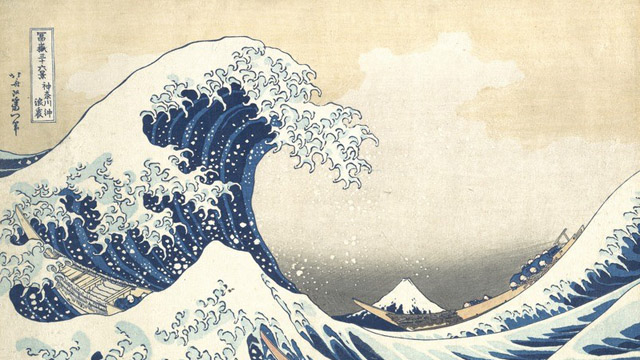
-
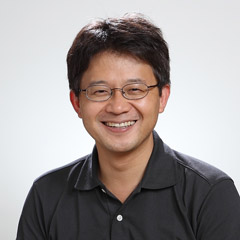 Nobumasa Kiyonaga
Nobumasa KiyonagaKatsushika Hokusai, Nami-ura
Many Japanese feel astounded when they know that Hokusai is considered as the most famous Japanese artist in the Western countries. The art-historical assessment in Japan also turns out differently than one would probably expect from a Western perspective. For example, it was only in 1997 that one of his works was admitted as Japan’s cultural heritage for the first time by the Japanese Ministry of Culture.
In order to understand this understatement, one needs to understand the socio-historical context of the time of the period when Hokusai produced this work: In the Hokusai's lifetime, an ukiyo-e master was considered as a mere craftsman. This, for example, represents a strong contrast to the Kano school artists, whose focus was primarily on Chinese painting. Many of the Kano school artists worked as the shogunate’s official painters, which enabled them to be part of the warrior class. In feudal society there was an unbridgeable clear class difference between those artists and ukiyo-e masters. Moreover, ukiyo-e was considered vulgar, as it was a medium for common people and some were even pornographic. Today “ukiyo-e” specially represents Japanese woodblock prints of the later Edo period. But actually the term ukiyo originally has a Buddhism-originated, rather pessimistic meaning, namely: “transitory world”, which contrasts to the word jōdo as “pure land” or “paradise”. “Ukiyo-e” in this context would mean “images from this world”. However, it was precisely in the Edo period mentioned about the attempt of reinterpretation, especially among townspeople, to perceive, affirm and even enjoy this temporary, worldly world as something positive. Accordingly, despite its originally negative meaning of the word, motifs that came to mean everyday, life-affirming, bourgeois life were often chosen for “ukiyo-e”.
In the Hokusai's lifetime his artistry1 in this sense certainly met with positive response and interest from the townspeople in Edo (today Tokyo). But it was French art critics and modern artists at the end of the 19th century who gave Hokusai “world-class” status. With the style of the so-called Japonisme they hoped to get impulses or artistic suggestions from the color woodcuts or lacquer works to overcome the hopelessly frozen academic European art from their viewpoint; bold, asymmetrical compositions, spontaneous drawing, strong colors, overcoming the central perspective. It seems clear that the view of these Europeans on Japanese works of art was from the beginning selective. And obviously Hokusai was an ideal projection here.
In Hokusai's extensive oeuvre the “Thirty-six Views of Mount Fuji” is regarded as his main work. Among all of Hokusai’s works, “The Great Wave off Kanagawa” particularly has attached special attention in the West until the present day. Already in 1897 Camille Claudel (1864-1943) created her work “La Vague”, which was inspired by “The Great Wave” and in 1888 Vincent van Gogh (1853-1890) pointed out the special nature of this work in a letter to his brother. Eventually “The Great Wave” established itself as an “global icon” as one acknowledged today2. According to the English art historian Christine M. E. Guth, it was decisive for the enormous spread of the picture that in the West, “The Great Wave” was chosen as the title to differ from the original “The Backside of the Wave”. In this way, the image has been separated from the original context3.
The fascination, which this work still holds globally today, certainly lies all in the geometrical or typically Japanese asymmetrical composition and the dynamic representation of the big waves. Thereby the horizon is set unusually low, which additionally serves to increase the effects. The position is actually very unnatural and almost impossible. Here it is important to point out that this perspective representation was a result of Hokusai's attempt to appropriate or interpret the European central perspective. It was in the early 18th century that the Japanese began to deal intensively with this Western style of painting. By directly connecting the foreground and the distant view without a middle ground, they found a particularly effective means of dramatic representation, which in reality deviated from the actual Western painting principles. The Japanese art historian Shigemi Inaga calls this typical Japanese expression “chūkei-datsuraku (falling out of the middle ground)”4. Many ukiyo-e masters liked to make use of this manner. Also in Hokusai's “The Great Wave” it seems to have succeeded impressively. As already expressed in the original title “Nami-ura” (the backside of the wave), the picture draws the viewer's gaze deep into the inner side of the devouring movement of the waves. Thereby a literally sublime feeling is awakened in the observer. In front of this mighty natural phenomenon, the people in the picture look powerless, as if they were merely driven by the waves. The holy Mount Fuji silently watches all this sight from far away.
Mount Fuji, a 3776 meter high volcano, is not only the highest mountain in the country, but has been worshipped as a religious object in ancient Japan. On the one hand, Fuji with its rich water reservoir provided fertility, but on the other hand its eruptions caused great damages to the population. Accordingly, it was always regarded with a certain reverence and in the 9th century the first shrine for the fire god “Asama” was built on it. The mountain then also became a holy place for Buddhists. The Mount Fuji worship became especially popular during the Edo period. The most eloquent example is Hokusai’s “Thirty-six Views of Mount Fuji”. Otherwise Mount Fuji was chosen as subject of the painting again and again since the 11th century at the earliest. Later, at the peak of nationalism in Japan, especially during the second Sino-Japanese War and the Pacific War (1937-1945), the mountain was identified with the nation “Japan” per se and eventually became an authentic “national symbol”. After World War II it was then seen as a symbol of the new, revived Japan. Based on these historical backgrounds it seems obvious that many Japanese perceive something particularly familiar in the depiction of Fuji in the work “Nami-Ura”. In this sense, it is quite significant that Mount Fuji was recognized by UNESCO as a World Cultural Heritage in 2013, as a “sacred place and source of artistic inspiration”.
Today, the image “The Great Wave” is often used for merchandising products of museums, such as coffee mugs, plates, notebooks, ties, T-shirts, wristwatches or umbrellas, and is extremely successful. The Japanese government finally jumped on this trend at the beginning of the 21st century when it developed a state-sponsored marketing strategy based on “Cool Japan”, a neologism created by the American journalist Douglas McGray, in which the Japanese subculture such as manga or anime would play a major role. The motif was also used for the “Cool Japan” project. Guth sees this as the final recognition of Hokusai on the Japanese side5.
Inaga writes that Hokusai was an artist who had gained his unique historical significance in the international context of Japonisme "as a sociological phenomenon“6. The shift in Hokusai's evaluation for over a century makes his creative approach a complex construct of the artistic, cultural and social development of the Edo period. Inaga notes that “many things that today are considered the essence of Japanese aesthetics were actually refined in dealing with imported culture. […] Cultural characteristics are not revealed in isolation, which shields itself from foreign influences, but rather through curiosity about the outside world“7. Especially Hokusai's art is a prime example of this statement.
Footnotes
1 The concept of art with the European sense did not exist in Japan at that time yet. For this reason the author avoids the term “art“ at this point. It was only after the opening of Japan to the Western countries in the 1850s that the term was newly introduced from Europe as a translation word.
2 Christine M. E. Guth (2017): 21 Seiki no Yōroppa · Amerika bunka no naka no “Ōnami” (eng: The Great Wave in Twenty-first Century Euro-American Culture), in: exh.cat. Hokusai and Japonisme, Tōkyō: Kokuritsu seiyō bijutsukan (The National Museum of Western Art) und Yomiuri shinbun Tōkyō honsha, p. 296.
3 Guth (2017): Ibid.
4 Shigemi Inaga (1999): Kaiga no tōhō – Orientarizumu kara Japonisumu e (eng: The Orient of the Painting: Orientalism to Japonisme, Nagoya: The University of Nagoya Press, p. 90ff.
5 Guth (2017): pp. 298-299.
6 Inaga (1999): p. 174.
7 Shigemi Inaga (2018): Nihon-bijutsu-shi no kindai to sono gaibu (eng: The modernity of Japanese art and its outside) Tōkyō: Hōsōdaigaku kyōiku shikōkai, p. 33.
published June 2020
 Ernst Wagner
Ernst WagnerHokusai, The Great Wave off Kangawa
A raging sea, mighty waves, spray falling like snow from their crests. The waves form huge claws that hover precariously over the fishermen in their fragile boats. Adapting to the shape of the mighty waves, the boats’ bows thrust their way ahead towards the left. The energy of the boats speeding forward is compositionally absorbed by the propulsive force of the water pushing to the right. Hypothetically, the viewer is positioned in the water and is in just as much in danger as the oarsmen.
In the centre of the wave trough’s mighty movement, we see the static Mount Fuji diminutive in the distance. Although one could almost overlook it due to its size and similar colour to the water it is the central subject of this woodcut, one in a series of “36 views of Fuji”, completed by Hokusai. Fuji’s peak lies in the golden section and serves as a stabilising element. The mountain, holy in Shintoism[1], appears like a vision, promising (unattainable) security. A pale white cloud above it takes on the shape of the wave adding to the threatening atmosphere. It is somewhat irritating how Mount Fuji and the waves approach each other through colour, form and lines. Even the drops of water coming out of the spray look like snow falling on Fuji’s peak. The small rowers crouching in their boats do not even see the mountain. In comparison with the other pictures in the series, this sheet displays the most dramatic representation in juxtaposition to the calm steadfastness of Fuji. The other 35 sheets mostly depict Fuji in idyllic everyday scenes or in quiet, monumental sublimity. (The great differences in style show that the series was published over a span of several years.)
The composition is like a snapshot of a scene at its dramatic climax. We, the observers perceive it from the distance and, at the same time, we are right in the middle of it. The giant wave is about to crash over the boat on the left, while the other two boats, swift as arrows, are heading right into it as well. According to historical accounts, they are fishing boats that are on their way back with their catch to the mainland, to Kanagawa, a place in the bay of Edo, today's Tokyo. But none of this is visible in the print. Instead, Hokusai illustrates a powerful and dangerous nature in which men must integrate themselves in order to survive. The picture displays the fishermen nestled within the frame of the wave. In this way, Hokusai creates a timeless and emotionally moving metaphor for man at the mercy of nature. He thus takes a specific artistic position that makes him interesting in comparison with European paintings by e.g. Caspar David Friedrich or William Turner who address a similar experience.
The title and Hokusai’s name appear in the upper left corner of the print in Japanese script. The concept of combining image and script is typical for Far Eastern traditions. We can find more features that can be considered as typical for Japanese woodcuts: flatness, reduction of colours, graphic patterns (e.g. the light and dark stripes in the water) and black lines outlining or defining the objects. Hokusai uses these means with expressive exaggerations, which often take on caricature-like features, for example in the representation of the spray or the frightened fishermen in their boats.
However, since Hokusai also uses Western pictorial principles, especially the conception of space and the idea of a dramatic climax, he created his own visual language, based on his reception of Western painting. This is significantly demonstrated by his treatment of spatial depth. Looking through the waves at the central motif – in this case Mount Fuji – from an observer's point of view is committed to the Western concept of perspective formulated in the Renaissance: the picture as a window to the world, which appears in perspective. In Hokusai's work, this European concept of space merges with the traditional Japanese art of colour woodblock prints, which was characterized by emphasized two-dimensionality, contrasting empty spaces, ‘abstract’ pictorial structures, and dynamic linearity. Hokusai's mediation between two culturally different pictorial conceptions ultimately led to his being more popular in the West today than in Japan itself.
The opening of Japan after 1853, forced by US gunboat politics – and supported by European governments – triggered trade between Japan and the world. At first, some Japanese woodblock prints were used as packaging material, which may seem surprising to lovers of this art form today. Fortunately, they were discovered and enthusiastically received by artists in France. Among those were Hokusai’s prints and his popularity grew rapidly throughout Europe and elsewhere. The collecting frenzy of Japanese art (Japonism), which was also triggered by this, influenced Post-Impressionism, Art Deco and Art Nouveau and, in particular, architecture and design such as was taught at Bauhaus. Just as Western visual language came to Japan, Asian visual concepts now influenced art in Europe.
Ukiyo-e
Hokusai, trained in painting and woodblock printmaking, is considered a master of the multi-coloured ukiyo-e woodblock prints. From the early black and white prints, an extremely refined multi-colour printing process with up to fifteen woodblocks was developed during his lifetime. For the production of the plates and complicated printing process there were highly specialized workshops, for which – in our case – Hokusai provided the templates. Compared to other prints, however, relatively few plates were needed for the 'Great Wave': three for the different shades of blue, one each for the colour of the boats and the sky, and black and grey. As some of the prints found today show considerable traces of wear on the plates, we can assume that hundreds or thousands of prints were printed from the same plates. The peaceful Edo period (1603 - 1867) had led to new forms of expression as well as to the mass production of woodblock prints, such as those by Hokusai.
[1] At 3776 m, this volcano is Japan's highest mountain. Its shape is elegant and at the same time monumental, memorable and easy to recognize. In Shintoism it is a holy place. Moreover, as it has repeatedly been a "source of artistic inspiration", not only for Hokusai. It was recognized by UNESCO as a World Heritage Site in 2013.
published September 2020
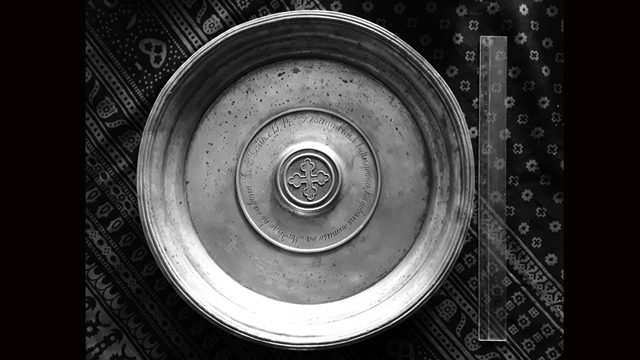
-
 Lize Kriel
Lize KrielA German bowl inscribed in Africa
In the process of finding out more about this baptismal bowl – where it comes from, who used it, and when it was discarded, it becomes a portal into South Africa’s contested past. Methodologically, a cultural-historical approach is taken to investigate the object as multiple signifier, not only as part of a transcontinental network, but also within a local, transcultural, context – what John and Jean Comaroff (1991, p. 200) referred to as the “long conversation” between European missionaries and African Christians.
The bowl was meant to be used with an accompanying, although, in this case, not quite matching, pitcher for the baptism ceremony, in which Christians use water to symbolise the blood of Christ washing away their sins. The Wallmansthal station where the bowl was found, was established by the Berlin Mission Society in 1869. The farm was about thirty kilometres north of Pretoria, today a capital city of South Africa. It became home to African converts gathered from the Kekana-Ndebele and several other pre-colonial northern Sotho polities (Van Rooyen, 1953, pp. 15-20). By the mid-twentieth century, the congregation was approximately 550 people strong (Schulze 2006, p. 456). Together with several other German protestant mission societies, the Berlin Mission contributed to the making of a Christian denomination referred to as “Lutheran” in South Africa today. After a century under white missionary tutelage, the African Church became independent as the Evangelical Lutheran Church of South Africa in the 1970s (Pakendorf, 2011, p. 115).
Knowing that a protestant congregation in Bochum, Germany, donated a church bell to the Wallmansthal Church in 1870 (Van Rooyen, 1954, p. 26), we can deduce that the baptismal bowl may also date from this era. The pitcher bears the mark of Gerhardi & Co. Judged from its Art Nouveau design elements and knowing that this Ludenscheid-based (Gerhardi) company was quite prolific in the production of cast pewter in the Jugendstil (Online Encyclopedia), a post 1890 manufacturing date seems equally probable.
Called Taufgeschirr (Baptismal dishes), bowl-and-pitcher sets of this kind are still being manufactured and used in churches in Germany today. Some congregations include images of old as well as new baptismal bowls on their websites as part of the material markers of their heritage. The exact same design displayed by the Evangelical Church of Illertissen in Germany on their website, is still in use today in the Evangelical Lutheran Church of Masealama (formerly the Kratzeinstein Congregation of the Berlin Mission Church) in South Africa’s Limpopo Province (Joubert, 2015).
Many baptismal bowls were inscribed with verses from the Bible. The quote on the Wallmansthal bowl is a contracted version of Matthew 19:14. What makes this bowl an exceptional object of transculturation, is the fact that its inscription appears in the early orthography of the local African language, Sepedi: “Lesang bana batle gonna, ka gobane mmuso oa Modimo ki oa bona” (NIV: “Let the little children come to me, … for the kingdom of heaven belongs to such as these”).
The bowl was used in church services on mission stations in the same way it would be used in protestant churches in Germany: the pastor would sprinkle the children of African Christians on the forehead with water which had been poured into the bowl from the pitcher. The initial African converts, however, were baptised as adults, only after proving that they had internalised enough knowledge of the Bible and convinced the white missionaries of their commitment to the beliefs and practices of Christianity (which, well into the twentieth century, remained entwined with Western ideas about civilisation).
To these converts, the baptismal bowl was symbolic of their ritual immersion into a foreign way of thinking, living and believing. And yet it was inscribed in their own language, invoking possibilities for cultural translation; for selective appropriation as well as for imbuing the alien culture with own interpretations, relating it to the indigenous and the familiar, and composing new meanings in anticipation of changing circumstances. The baptismal bowl is thus taken as reflective of broader processes of societal, economic and political reconfiguration brought about by the colonial encounter, but with an emphasis on African resilience.
On the site where the Wallmansthal baptismal bowl was used, these processes played themselves out in a series of extraordinary episodes that indirectly also related to broader world-political epochs: Up until the First World War, the Wallmannsthal land sustained an African Christian farming community. In 1936, as an attempt to address their post-war financial crisis, the Berlin Mission sold off a large section of the farm, giving the (exclusively black) African buyers full title deeds for their plots. Until after the Second World War, Wallmannsthal was a bustling African town giving its inhabitants the economic advantage of being close to job opportunities in Pretoria (Van der Merwe, 1987, pp. 69, 135).
In 1967 the Apartheid government forcibly removed all the inhabitants, including the Berlin Mission Christians who had still lived on the retainer of the farm where the Church and other mission station buildings were (Schulze, 2005, p. 458). Wallmannsthal then became a military base and arms depot for the South African Defence Force. During the late 1980s, with the Cold War still dictating international relations and South African whites slowly awakening to the need for political reform, the Defence Force contemplated the restoration of the site. These plans never materialised.
In the early twenty-first century, in a successful land claim, the Wallmannsthal farm was returned to the descendants of its early twentieth century owners. The restitution did not herald a final episode of utopian prosperity. Increasing demands on limited resources seem to be one of the reasons for the reinstated landowners’ current challenges, ranging from obtaining municipal infrastructure, to addressing the status of illegal squatters on their land, and designing the best possible ways of yielding a sustainable livelihood for an increasing population (eNCAnews, 2018).
Today the Evangelical Lutheran Church of South Africa is but only one of several Christian denominations in South Africa with missionary roots. Many more South Africans belong to African independent or African initiated churches – and, increasingly, international churches with their roots elsewhere in the Global South. The process of inscribing Christianity with own meaning and local significance, continues.
References:
- 925-1000.com (2018). Online encyclopedia of silver marks, hallmarks and maker’s marks. Retrieved from https://www.925-1000.com/silverplate_G.html.
- Comaroff, J & Comaroff, J. (1991). Of revelation and revolution. Christianity, colonialism and consciousness in South Africa I. Chicago: Chicago University Press.
- eNCAnews (2018, 27 October). Pretoria land claims. Retrieved from https://www.facebook.com/eNCAnews/videos/pretoria-land-claims/302862580316147/
- Evangelische Kirchengemeinde Illertissen (2019). Die Taufe. Retrieved from https://evang-kirche-illertissen.de/informationen/taufe/
- Gerhardi (2019). Gerhardi – Ein innovatives Traditionsunternehmen. Retrieved from http://www.gerhardi.com/index.php?id=9&L=0
- Joubert, A. (2015). A journey into the life of a mission-ethnographer. doi: 10.6084/m9.figshare.1375528
- Pakendorf, G. (2011). A brief history of the Berlin Mission Society in South Africa, History Compass, 9/2, 106-118.
- Schulze, A. (2005). “In Gottes Namen Hütten Bauen“. Kirchlicher Landbesitz in Südafrika: Die Berliner Mission und die Evangelisch-Lutherische Kirche Südafrikas zwischen 1834 und 2005. Stuttgart: Franz Steiner.
- Van der Merwe, W. (1987). Die Berlynse Sendinggenootskap en Kerkstigting in Transvaal, 1904-1062. Pretoria: Government Printers.
- Van Rooyen, T.S. (1953). Kronieke van Wallmansthal I, Pretoriana: Journal of the Old Pretoria Society 4, 15-20.
- Van Rooyen, T.S. (1954). Kronieke van Wallmansthal III, Pretoriana: Journal of the Old Pretoria Society 2, 24-28.
published February 2020

-
 Osuanyi Quaicoo Essel
Osuanyi Quaicoo EsselThe seated human-like figure is centrally placed with the head occupying almost the centre of the entire composition while the hands rest gently on the laps. The head and the face of the human figure is rendered in planes and cubistic orientation, a style reminiscent in precolonial African wooden sculptures. Hands of the figure received similar cubistic treatment with less details as in realistic depiction. Interestingly, there is a deliberate subtle emphasis on the head size of the figure. In African sculptural renditions, the human head is considered as seat of wisdom and, therefore, presented bigger to defile the realistic canonic proportions and connote its Afrocentric symbolic essence. This concept of head re(presentation) is termed as African proportions (Amenuke et al, 1991).
To create a harmonious contrast of colour and shape, tints of yellow forms an arc-shaped design around the head. This treatment possibly suggests a halo effect characteristic of saintly figural paintings in Western art traditions. It also mimics a turbaned human figure. As an artist who hailed from a predominately Muslim community, this stylistic treatment, perhaps, pays tribute to his religious cultural background. The eyes are presented with dark brown rectangular dabs, with the forehead gently highlighted with bright yellows, a treatment that puts the human figure in a meditative mood and sanctimonious character. Though Uche Okeke presented the work in a portrait orientation, the skilful placement of the human figure, and the peculiar colouration of the head regions creates a triangular effect when imaginary diagonal lines are projected from the bottom corners of the composition to the halo-shaped found on the head. Similarly, the haloed effect on the head and the elongated pharaonic beard creates an imaginary inverted triangle resonating a visual excitement.
Symbolically, yellow depicts riches and royalty in African colour scheme. With this schematic colouration, Okeke gave a clue to the kingly characteristics of the human figure. The white looking garment of the figure also adds to the sanctimonious conjecture of the figure as in African colour symbolism. The artist’s use of luminous chromatic reflection of the tint of yellow and dark shades helped in achieving the sense of depth in the garment. Complementing the overall kingly posture of the human figure is its elongated pharaonic beard and bodily language as found in sculptures of ancient Egyptian kings.
Okeke skilfully deceived viewers of this composition into believing that it is symmetrical per its stylistic tendency, yet an intense observation reveals a psychedelic mutation of the placement of the fingers, padding of the background with tree-shaped figures in rich application of tints and shades of black, yellow and brown to create contrast of colours and shapes. Placement of the trees in colour variations and the sprouting of the branches forms a psychedelic cross and contribute to breaking monotony. The patchy effects of the intense yellow forming the negative spaces adds to creating a perceptual believability that the human figure wears a contemplative mood per the facial looks. There seem to be gentle highlights of the yellow from the shoulders to the halo-shaped object.
Per the compositional portrayal, Okeke showed a kingly and majestic posture of, perhaps, the Christian religious icon in Africanised bodily posture and cultural praxis. This compositional contextualisation feeds into his personal manifesto that he did not subscribe to borrowing Western artistic accent hook, line and sinker. Neither was he comfortable with resorting his Nigerian indigenous artistic traditions without modification. He emphasised in his manifesto that it is ‘… futile copying our old art heritages, for they stand for our old order. Culture lives by change. Today's social problems are different from yesterday's, and we shall be doing grave disservice to Africa and mankind by living in our fathers' achievements’ (Okeke, n.d). For that reason, he appropriated western artistic accents and fused them with Afrocentric artistic concepts and perspectives to achieve a hybrid artistic language which is not purely African nor Western, but yet circumvent the boundaries of artistic cultural traditions in general. The fusion lends itself to exploring the familiar and the unfamiliar to create a renewed breed of art. He called this effect ‘natural synthesis’. Emanating from Nigerian non-conformist artist group named Zaria Rebels, Okeke sought to reinterpret the Western artistic style of realistic depiction, perspectival detailing, accurate proportions and tonal gradation he was exposed to by the Eurocentric-inspired faculty in the so-called formal education setup in art in Ahmadu Bello University, Zaria. As part of the pioneering post-independence artists in Nigeria, Uche Okeke was experimenting for a renewed artistic accent for his creations through the assessment of his Nigerian cultural values and the new artistic training he had been exposed to in order to arrive at the boundary of these two traditions.
Using this painting in teaching and learning in the context of collective memory could inspire relevant competencies in the learners. Gathering inspiration from the artistic pursuit of Okeke, learners could fuse multiple artistic traditions of the artworld to arrive at their individualised artistic accents. Teachers could engage learners in this manner by asking them to borrow and appropriate a foreign artistic style and fuse it with their nationalistic art making techniques to develop a new breed of art or concept. Teachers could also discuss with learners about the fact that gathering artistic inspiration is multicultural with no boundaries. Furnishing learners with links to the biographical account of the artist for them to understand his cultural nuances remains key in the process. It would also be beneficial to guide learners to explore with their own interpretation of the artwork (figure 1). Teachers could also provide learners with printed copy of the painting and ask them to redraw this religious-centred figure to suit their own religious understanding and cultures. This approach addresses the competencies of critical thinking and problem solving; creativity and innovation; cultural identity and global citizenship; and personal development.
References- Amenuke, S. K., Dogbe, B. K., Asare, S. K., Ayiku, F. D. & Bafoe, A. General knowledge in Art for
- senior secondary schools. Evans Brothers Limited.
- Okeke, U. (n.d.). Natural synthesis. final okeke natural synthesis manifesto 1960.doc (live.com)
 Mahmoud Malik Saako
Mahmoud Malik SaakoThe image is presented in a form of a male figure in a seated position with long beard, white turban, white robe, long sleeves and a probably waist band. The painting represents fairly the complexion of a male, black bearded and wearing a face mask, with hands resting on the laps possibly in a meditation mood. The Background is probably a wooded environment or garden with tall trees of two colours (black and yellow). The figure seated probably on a staircase or an amphitheater. The sun ray penetrating through the tree created shaded patches reflected on the image.
An Islamic perspective: I base my interpretation of the painting on Islamic perspective as one of the foreign region that had an early contact in northern Nigeria as early as 15th century long before Christianity and eventual colonization of Nigeria by European power (the British) and its possible independence in the 1960. The emir is mostly male usually dressed with a white robe, long sleeves and a white turban tied around his head to signify his authority. The painting perhaps represents an Emir of the Zaria state at that time sitting in a garden relaxing.
Using an African mask: The use of an African mask to represent the figure was done deliberately or perhaps to avoid revolution from the Muslim community of disrespecting their leader which the author was much familiar in this volatile society especially, the intolerance nature between Muslims and Christians at this era in the Zaria state. The mask as a tradition signature that ubiquitous across many cultures that can be used to represent the religious discourses by appropriating and manipulating them to produce art forms of the past to produce a mythology for the present.
Lessons
- The image portrays the power of the emir in the Zaria state with a possibly palace and vineyard or gardens where he retires to relax. The seat or staircase/amphitheatre is constructed within the park for relaxation.
- It also shows the importance of trees because the natural air and shade provided. It reflects the symbiotic relationship between man and the natural environment or biosphere.
- The long beard is a reflection of the age of the figure, combined with the white turban tied around the head which is a symbol of power and authority of the emir within the context of an Islamic state. Again, the white long robe coupled with black beard and the white turban is a reflection of the dress code of the emir within the states dominated by Muslims. The waist band (blue sea colour) is used to tie the robe for easy movement.
- The facial representation of the figure doesn’t conform with normal human head based on the eyes, nose and mouth. It is probably a mask of an Egyptian pharaoh to imbibe the spirit of the Pharaoh as a kingly figure that wielded much power. A story that is synonymous in both Islam and Christian doctrines except the West Africa Indigenous Religions that do ascribe this myth. The use of the mask also simmer the tension of using identifiable imagery that would have rise tension in this probably consecutive Muslim state. The use of masks within the Africa context show the spiritual powers embedded in them that the wearer or user is mostly possessed and transfigured a situation that can only be explained by adherences to that particular belief system.
- The black and yellow tall trees depict the diverse nature of the ecosystem and the symbiotic relationship mostly exhibited in the environment. This shows the complex nature of the human society with diverse cultural and different colours complexion that need a person with wisdom and patience to rule, like the emir who assumes the position of an Egyptian Pharaoh.
- Uche Okeke, was a revolutionary artist who tried to break away from normal art presentation handed to Africa by the white colonial powers. This diversion was to Africanize the art industry in West Africa and Africa at large. This where Okeke decided to use the Pharaoh mask from Egypt that was considered even among Europeans of the cradle of human civilization in the world.
 Ernst Wagner
Ernst WagnerI argue in the following text from a special position. Firstly, I was present in Bayreuth on 26.4.2022 when the two co-authors, Osuanyi Quaicoo Essel and Mahmoud Malik Saako, discussed the painting in a larger circle. The representatives of the Iwalewa House clearly expressed their doubts about the (traditional) title of the painting "Christ".[1] Perhaps this brought the question of who was depicted in the painting, Christ or another person, to the fore. This question also shapes my discussion of the painting presented here. It became the guiding theme behind which other topics disappeared, such as the question of the painting's function (what was it created for?), its biography (how did it come to Bayreuth?) the role of oil painting (is it a European import), the context of the debates on modern art during the independence movements in Africa (does the painting belong to a global modernism after the Second World War or does it mark a Nigerian path? [2]) - to name just a few.
My own interpretation is therefore less an independent approach to the work than a response to the positions presented with the intention of building bridges between the approaches by introducing a meta-level. Whether this is convincing, whether the bridge is sustainable, is for the reader to decide. But more on that below.
Traps through aesthetic stereotypes that lead to false classifications / interpretations
And a second preliminary remark: I didn't like this picture at the beginning. It reminded me too much of the religious pictures of the 1950/60s of my childhood. They were popular for death pictures back then: A mixture of a bit of Pre-Raphaelite and icon-inspired imagery, soaked in the formal world of a moderate and esoterically inclined modernism (Franz Marc). The intention was easy to see through: To somehow keep alive that which, in my view, was no longer contemporary at all, and to do so through a bland, unconvincing and even less convincing adaptation (a kind of "modern facing"). This is also why, when I saw the picture hanging at the entrance to the Iwalewa House from the corner of my eye, I immediately saw a Christ.
Iconography - inclusion of other perspectives

Detail
In the discussion mentioned at the beginning, the intervention of Mahmoud Malik Saako was really surprising for me - against the background of this perception, which was shaped by my own stereotypes. The halo (which I saw - see detail) was a turban (which Malik saw). But I could not counter his view. There was no argument for the interpretation as a halo. This is also true now when I read Malik's text (like Osuanyi's). So I first had to recognise my stereotype in perception, which had lured me onto a perhaps (?) wrong track, I had to get rid of this, unlearn something, in order to be able to open up to the other perspective.
Why I - retrospectively - still speak of "perhaps wrong", a research on Okeke's work has confirmed as meaningful. After all, there are obviously works in his oeuvre that iconographically quite certainly represent Christ or St Mary, as an internet search reveals (see fig. below). The auction house Bonhams (Abb.1) states - even if for 1963, two years after our work: "in 1963 ... the Passion of Christ was a recurring theme for the artist. He had produced the stained-glass designs of the Fourteen Stations of the Cross in Munich earlier in the year." (www.bonhams.com/auctions/25800/lot/28 accessed 14 Sept 2024)
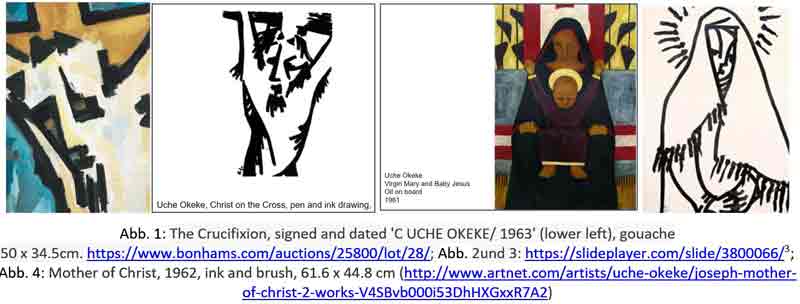
Christian motifs in Uche Okeke's Ouevre between 1962 and 1963 found by the author on the internet (May 22, 2022)
Perhaps this is why the discussion about whether Christ or a Muslim is depicted makes me feel uneasy. In my mind, the question is connected with the attributions or depreciations: To whom / which faith does the work of art belong? Does it belong to the Christians, the Muslims, or the traditional believers in northern Nigeria, if, as Philipp Schramm or Mahmoud Malik Saako suggest, one also discovers a traditional wooden mask?
New approach and reflection on its anchoring
Hence my attempt to think of the painting in a different way, i.e. not from the artist's point of view and what he or she wanted to represent. In doing so, it is clear to me that I am taking a specifically Western approach to a modernist work (where I now place Okeke's painting) with my new approach. This approach is based on the loss of a binding iconography and a fundamental openness / never-quite-unambiguity of 'autonomous' works of art for a Western-oriented, middle-class audience. In addition, my proposal for interpretation is based on a specific position in the interpretation of images, from production theory to reception theory (in the context of constructivist epistemology). The loss of a binding iconography is accompanied by a greater significance of form (which is now itself charged with content to compensate for the loss). In a next step, I therefore try to examine the image - beyond a positioning in the question of whether it is an "Islamic" or a "Christian image" or a "traditional image" - form-analytically.

Analytical composition with auxiliary lines. (c) the author
Form analysis
The dominant, almost penetrating axial symmetry in a very high longitudinal format speaks of high order; the pyramidal structure of the figure also speaks of calm and stability, indeed of sublimity and dignity, of quiet, immovable power. And this dignity is not fed by external insignia or theatrical staging, but by a calm that radiates from within. It is a picture in front of which one can become calm if one trusts the order as a viewer.
The striking human figure contributes to this effect. Although clearly figurative, it does not represent - to the degree of abstraction - a concrete portrait or a human being that can be grasped by the senses. This is most obvious in the geometricised eye area, which is shaded in various dark zones. This makes the gaze ambiguous: is the figure looking at the viewer, is it looking forward, is it looking inwards (contemplatively, with closed eyes)? Together with the geometric rhythm of the picture's surface (the symmetry, but of course above all the parallels that can denote eyelid, tear sac, eyebrow - or not) support the depiction of a human being in an abstracted ideal form that remains open to itself, as in a mask. The latter is also characterised by the fact that the viewer immediately sees what has been made, what has been assembled, as in the case of the moustache, for example.
The figure sits quite classically in front of a middle and a background: at the bottom the zone (again - between two-dimensional and spatial effect - strongly abstracted) is divided into horizontal stripes, which become slightly narrower towards the top. They again suggest something familiar (a wooden bench), but this remains ambiguous. In the upper zones, the tree trunks (without leaves) form the liveliest, least symmetrical, most restless element in the painting, even if the alternation of light and dark again shows the abstracting hand of the artist.
With this spatial layering in clear zones (background, trees, seat, figure), but also the geometric reduction of the forms, the picture looks like a carved relief. The colouring also fits in with this, for example when the "sky" behind the trees as well as the lighter trees have the same colouring as the face, while the beard, eyes and the dark trees form a second colour zone. The lightest zones are formed by the robe and the shape around the head. Despite the large spectrum in the area of light-dark contrast, the picture does not appear colourful, rather like a natural wood relief. An effect that is again particularly evident in one detail: the way the hands are shaped is reminiscent of hands carved out of a piece of wood.
This character is supported by the way Okeke uses oil painting. He clearly outlines the contours of the surfaces. The objects are each assigned a main colour, applied impasto with broad brushstrokes. The modelling creates plasticity, lightly set with internal structures enliven the colour surfaces.
Conclusion
The degree of abstraction, the modelling construction of the figurative out of a colourfulness, the strict symmetry of the composition, the tectonics of the pictorial space unfold a tableau that nevertheless - and this is now decisive - creates zones of ambiguity in the figurative. The viewer must fill these with his or her own ideas. The viewer's gaze is directed towards the picture, but the eyes do not look back. In this respect, the painting is suitable for contemplation, meditation, spiritual experience. In seeing the painting, one's own can come to rest. And so the distinction between the Christian halo, the Muslim turban and the ritual mask can also come to rest in the contemplation of the painting.
This consideration is based on an 'ideal viewer' of the work, i.e. it is reception-aesthetically oriented. If one finally turns it once again to production aesthetics, one could interpret the work as an attempt by the artist in which it experimentally unfolds what a spirituality beyond the distinction traditional - Christian - Muslim could look like.
Footnotes
[1] Philipp Schramm's position becomes clear in his text (https://www.bayfink.uni-bayreuth.de/de/Sommerausstellung-2021_-Not-yet/audio-not-yet---welcome/index.html).
[2] Perrin Lathrop, "Uche Okeke," in Smarthistory, August 9, 2015, accessed May 21, 2022, https://smarthistory.org/uche-okeke/.
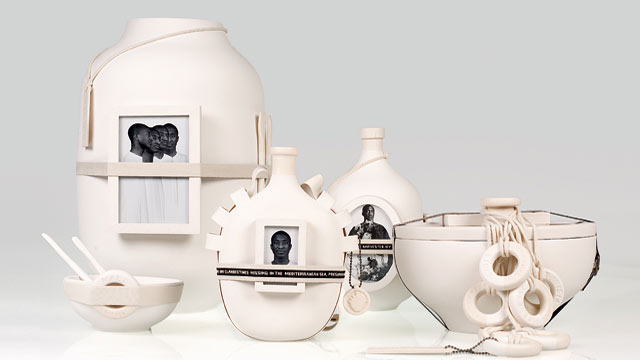
-
 Kerstin Pinther
Kerstin PintherMoulding Tradition (2009) is a work done by the designers Andrea Trimarchi and Simone Farresin of Studio Formafantasma: It consists of a group of five ceramics in different shapes and forms: boat-like bowls of various sizes, vases and bottles. Some of the maiolica objects display special attributes which refer to the sea and to rescue operations on the water such as a pair of paddles and lifebuoys. Others use ribbons, printed with historical and immigration data, to tie framed photographs and other ‘décor’ to the vessels. The project is informed by the tin-glazed maiolica from Caltagirone in Sicily – itself a result of the encounter with (Moorish) Islamic ceramic traditions in the eleventh and twelfth centuries, which in the following centuries triggered a technical and content-related process of adaptation. From the early modern age onwards, maiolica thus became “an excellent indicator and agent of design transmission across the globe” (Ajmar-Wollheim/Molà 2011, 17).
Among the ceramic vessels being produced up till now is the genre of the so-called teste di moro – vases that in a stereotypical, often grotesque and derogative manner depict the faces of people referred to as either ‘African’ or as ‘Arabic.’ In their original form as busts they most probably date back to the seventeenth century, when they were used as flowerpots to decorate balconies and terraces, suggesting an exuberant vegetation. By replacing this generic image with a black-and-white photograph of a known and thus named immigrant from Nigeria, Sofien Adeyemi, Andrea Trimarchi and Simone Farresin update the references and create a link to recent migration movements. A flask with an attached ceramic tile lists the names of the countries Adeyemi has traveled through on his way from West Africa to Italy. His (multiplied) portrait together with written information on present-day migration policies is attached to the ceramic form, thus literally adding a new level of meaning. Yet another wine bottle recalls fruit picking, predominantly done by migrant workers under harsh and exploitative conditions.
By introducing further elements of reality in traditional forms, Formafantasma with Moulding Tradition create complex discourses on the historical and present-day entanglements between Africa and Europe and the imbalance in their economic and political conditions. According to the designers, “contemporary public opinion polls have claimed that 65% of Italians believe that the immigrants are ‘a danger for our culture.’” In this context Moulding Tradition speaks of the blind spots of contemporary culture: Neither the explicit transcultural character of the maiolica which had contributed to – if not established – the fame of Caltagirone’s craft tradition is valued, nor are the descendants of those who once introduced this new ceramic technique welcomed. Moulding Tradition also alludes to the fact that in the most recent age of globalization nearly everything – data, information, images, objects – is free-flowing, but some people’s movements from specific geographies are monitored and restricted. Thus, it questions the ideology of cultural segregation and confronts it with the factual migration of people and goods as well as with the various historical entanglements. Furthermore, Moulding Tradition, for which the designers cooperated with a local craftsperson, can also be read as a comment on the role of craft in contemporary society as well as on the question of how craft is sometimes “locked into a tradition repeating [moulding, author’s note] the same objects over and over again” (Studio Formafantasma 2015). In order to counter this tendency, the designers left their products with a kind of raw surface, since normally maiolica ceramic is painted in bold colors after being dried thoroughly. In the case of Formafantasma’s maiolica, the objects remain ‘unfinished’ – a (blank) space to metaphorically be worked on and to open up a debate. Thus, Moulding Tradition stands for Studio Formafantasma’s conceptual and critical design-thinking approach. In this approach, the duo relies on textual information as well as on the haptic and aesthetic qualities of the substances they use: “[M]aterials are not only functional but also have the ability to evoke memories or to testify historical knowledge” (Studio Formafantasma 2015).
The authors of Global Design History make clear how the most recent phase of globalization not only accelerates flows of people, images, information, commodities and capital, but also contributes to the various types of exclusion and border control regimes (Adamson, et al. 2010, 1f.). At a time when design is becoming increasingly politicized, the question of how designers respond to the hitherto biggest wave of flight and migration in the years 2015/16 becomes obvious. Indeed, similar to Moulding Tradition, there are other design objects as well as works at the interface of design and art which can be seen as tools for reflecting on migration and flight. In using design as a tool, the migrancy reference can often be found on more than only one level. Besides its content-related presence, it is also tangible via the objects’ materiality or techniques, which for their part often bear traces of mobility and cultural transfer. Thus, these objects speak strongly to the historical and cultural migration of forms.
References
- Adamson, Glenn, et al., editors. Global Design History. Routledge, 2011.
- Ajmar-Wollheim, Marta, and Luca Molà. “The Global Renaissance. Cross-cultural Objects in the Early Modern Period.” Global Design History, edited by Glenn Adamson, Giorgio Riello and Sarah Teasly, Routledge, 2011, pp. 11–20.
- Studio Formafantasma. “Studio Formafantasma on Words as a Tool for Design.” Design Indaba Conference, Talk on November 3rd 2015, http://www.designindaba.com/videos/conference-talks/studio-formafantasma-words-tool-design.
published February 2020
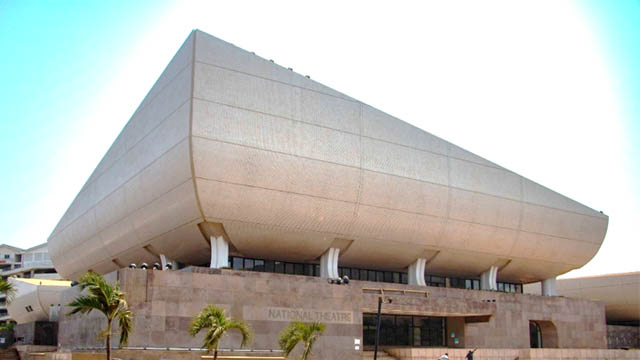
-
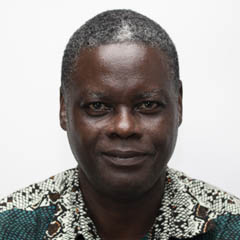 Ebenezer Kwabena Acquah
Ebenezer Kwabena AcquahThis essay seeks to draw readers’ attention to the National Theatre of Ghana in order to recognize its relevance within the country’s visual cultural landscape. The National Theatre is a monumental edifice situated in the nation’s capital, Accra. It is supported by the government, and largely devoted to musical performances and stage productions, among others (Wilson, 1988). Theatrical performances in the National Theatre are part of the nation’s cultural heritage and present the people with creative thoughts and reflections on life. The establishment of the National Theatre of Ghana was, to a large extent, largely supported by the National Theatre Movement of the 1950s by cultural experts like Efua Sutherland and Professor J. H. Kwabena Nketia (Agovi, 1990).
The National Theatre was completed on December 16, 1992, commissioned and handed over by the Peoples Republic of China to the Government of Ghana on December 30, 1992 (www.nationaltheatre.gov.gh/history/ retrieved 2020, August 7). The Theatre was designed to be used by people from all walks of life and diverse age groups. Since its inception, the National Theatre has hosted a number of performances and exhibitions from both local and international communities with the intention of promoting visual culture in a heterogeneous global landscape.
Location, Structure, and Artistic Appreciation
The boat-like building is located near the junction of Liberia Road and Independence Avenue, adjacent to Efua Sutherland Children’s Park, in Accra’s central district.
Three distinct structural forms comprise The National Theatre building, with each structure housing its own performance group/company: the National Theatre Players, National Dance Company, and the National Symphony Orchestra. A closer look at the entire structure reveals three distinct parts aside from the structural forms mentioned earlier. The upper part portrays three boats joined together, supported by rectangular piers with curved outward projections, and a rectangular base with entrance and exit openings. In fact, the entrances and windows seem to be carved out of the rectangular base. All of the entrances are elevated from the ground level with a staircase, which leads up to the glass entrances and into the building (https://3rdworldarchitecture.wordpress.com/2018/02/04/national-theatre-of-ghana/ retrieved 2020, August 7). The base is designed to create a projection at the entrance that provides visitors with the necessary protection from inclement weather.

National Theatre. Aerial view over National Theatre. Photo: Cheng Taining, 1997, link: https://archnet.org/sites/1413/media_contents/15315.
Above the base, there are distinct white forms. They taper upwards from the centre and meet towards the outside of the base. The walls curve inwards and are lifted just above the solid base, with glass in between them, making the base and white forms more distinct and thereby reinforcing the differences between them. Small white tiles cover these forms, giving the building its shape and colour. A closer look at the shape of the National Theatre reveals a display of three boats/canoes or fishing vessels that meet at a central point, which takes the form of a captain's bridge. The entire structure is supported by curvy piers and rests on a rectangular base as presented in the image above.
A careful study of the architectural ‘language’ of the National Theatre reveals a combination of interior and exterior Asian architecture, symbolic Ghanaian forms and boat construction. Generally, Chinese architecture is based on the relevance of influential local cultural traditions and adherence to hierarchy (Lianto, 2020). It prioritizes spatial designs with balanced symmetrical central pivots and a reverence for nature and aesthetics. Additionally, the dominant use of red represents happiness, which is also found throughout the interior of the National Theatre.
The curvy structure of the theatre in general nods towards Asian architecture. The seating space is segmented along stepped floors and the undulating structured ceiling is reminiscent of waves with openings defined by lighting systems. In fact, the use of sculptural forms and other Ghanaian art works effectively combine with the architectural structure to convey the visual cultural landscape of the National Theatre.
Sculptures in Public Space
Sculptural forms executed by Ghanaian artists are carefully displayed outside the National Theatre. The following image shows a sculptural work that depicts a Sankofa, a traditional Ghanaian symbol.
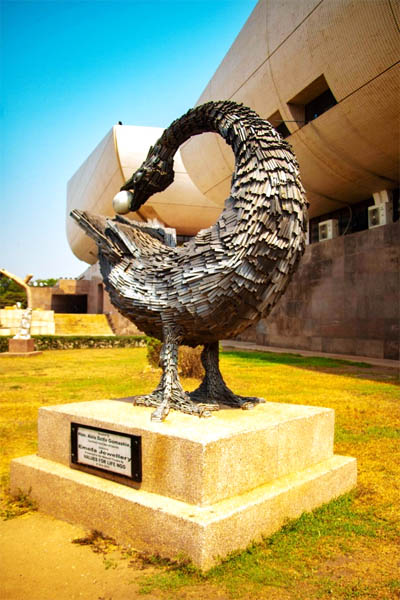
Emefa Jewellery, Sankofa, 2015, H: 11ft., Presented by Values for Life NGO to the National Theatre, Photo: Wisdom Dzigbordi.
The Sankofa represents taking the opportunity to reflect upon the past and applying significant and relevant ideas to current developments. Thus, the past has something relevant that must be considered and utilized as part of contemporary practice.
Education and Cultural Relevance
The National Theatre of Ghana is a significant cultural centre in Accra, Ghana and the entire form of this visual cultural structure provides people from diverse walks of life a place for entertainment and relaxation. The building is a visual architectural icon for the city and is an influential hub for creative art performances. It therefore serves as an important edifice to promote the arts, offering both Ghanaian and foreign artists a place to express their creativity.
In addition to providing entertainment and relaxation, the theatre seeks to educate people and stakeholders (who periodically use the place) on the responsibility of the National Theatre of Ghana as a strong cultural institution that ensures the development of culture, including the performing arts, and the need to respect cultural values. Through this education, the activities of the theatre are brought into focus, preserved, promoted and transmitted to the next generation for posterity and the promotion of visual culture across the world.
References
- Agovi, K. E. (1990). The origin of literary theatre in colonial Ghana, 1920-1957. Research Review, 6(1), 1-22.
- Frimpong, M. (2015). Towards an audience development plan for the National Theatre of Ghana. Unpublished Thesis. University of Ghana, Legon.
- Lianto, F. (2020, August 9). Building structure system of Chinese architecture, past and present. Retrieved from https://www.academia.edu/33602498/BUILDING_STRUCTURE_SYSTEM_OF_CHINESE_ARCHITECTURE_PAST_AND_PRESENT
- National Theatre of Ghana (2020). History of the National Theatre of Ghana. Retrieved on January 10, 2020 from http://www.nationaltheatre.gov.gh/history
- Wilson, E. (1988). The theatre experience (4th ed.). New York: McGraw-Hill Book Company.
- 3rdworldarchitecture.wordpress.com (2018, January 4). National Theatre of Ghana. Retrieved from https://3rdworldarchitecture.wordpress.com/2018/02/04/national-theatre-of-ghana/
published August 2020
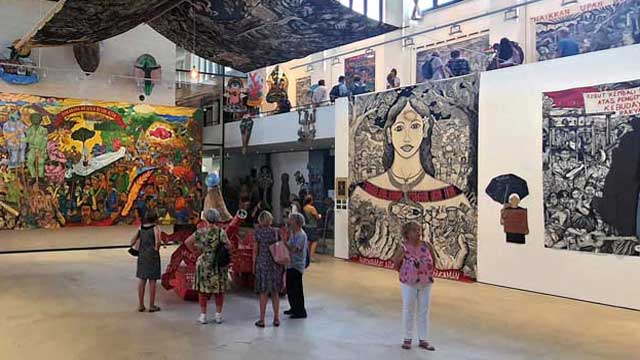
-
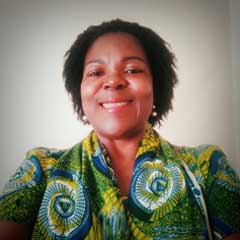 Jane Otieno
Jane Otieno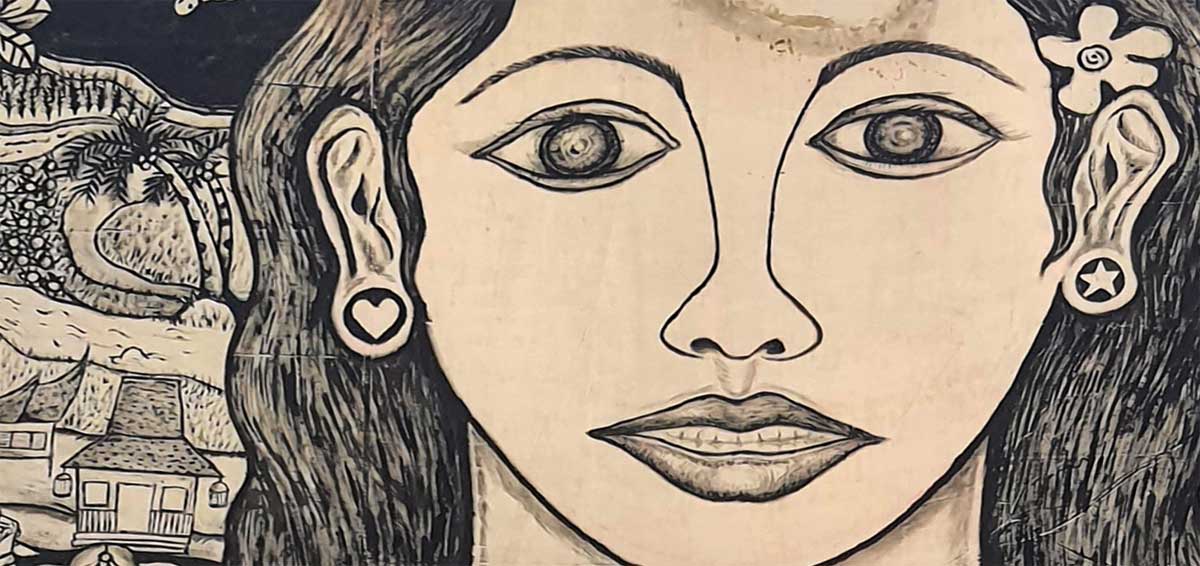
Detail (Photo: Avi Sooful)
The woman who seems to be in a reflective mood, shows a reserved demeanor and sadness. The face is not shaded, maybe to allow the viewer to project themselves more into the work and to give a clearer interpretation of the mood. The work done in ink probably with a filt-tip or a ball pen by use of line technique is effectively rendered in flowing, horizontal, curved and vertical manner to project her character and what she stands for.The good grasp of the leading lines sets the work in time and emotion. It creates a feeling of harmony between the individual and her surroundings and successfully portrays an element of resiliency in the midst of uncertainties. The subject’s predominance intimates to the viewer her feeling of absolute command of her surroundings with her well-coordinated and symmetrically placed figure. The woman communicates beyond the physical likeness and tells the viewer something about her character. There is no reason not to believe that she is protective of her space, bears compassion, at the same time, not afraid to share her feelings, pain, emotions and empathy that connects with others in openness.
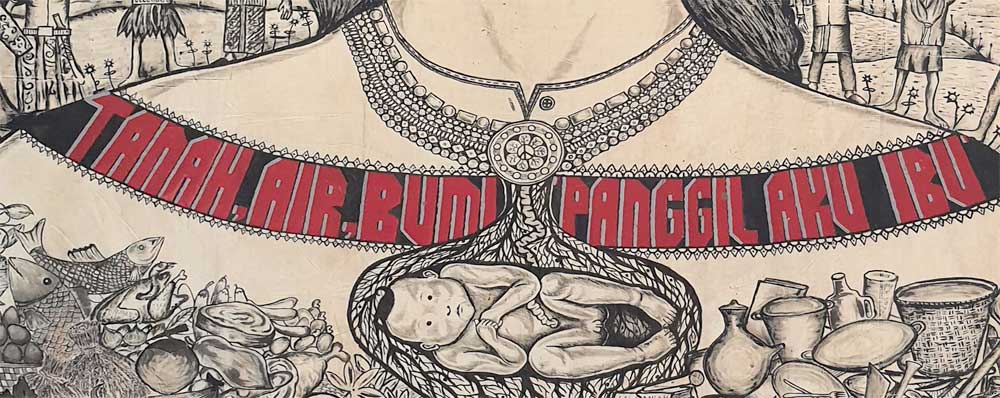
Detail (Photo: Avi Sooful)
The writings written in red color, that reads ”Tanah, air, bumi, panggil, aku ibu” (Indonesian, to be translated as ”land, water, earth, call me mother”) around the neck is glaring and tends to hold the entire work in place. It is a strong message intended to communicate to the viewer on environmental awareness and conservation of natural resources. Perhaps a deliberate attempt by the artists to draw attention to the area, helping to convey thematic ideas that distinguish the woman from the rest of the picture. The necklace has a pendant with a distinct shape of a baby, probably in the womb, is a symbolic reflection of continuity and a cry for protection for all, including the unborn. They too matter! The fine textured background has other people, holding hands in solidarity, a sign of peaceful co-existence and social commentary on issues faced.

Detail (Photo: Avi Sooful)
The woman is against the destruction of what she holds dearly, and can foresee everyday activities such as fishing destroyed. The trees create balance in the work, while Rhythm and movement run across the canvas with reflection of real life situations, with a natural background that enhances the theme. The work’s portrayal of versatility and fluidity cannot be ignored. The relationships and interactions between the activities in the background and the main figure creates a complex meaning on nature’s importance for the human survival. The creatively rendered items held on both hands form part of the attire, thus creating a visual interest that has symbolic value. The firm, full, protective hands, held close to her heart, are symbolic of the strength of a woman, giving an impression of a mother, caregiver and a nurturer. The woman, in her use of direct gaze says “This is who I am” with her direct expression. She attempts to explain herself, to unravel her character, to invite the viewer to her space even if only for a moment.
The drawing which is both engaging and intriguing, depicts the experience of understanding the environment and its connection to everyday life, “the goodness of mother earth”. It shows unity of purpose whereby different cultures from different continents come together in solidarity to support a common cause as the bottom inscription says: “Masyarakat adat merayakan keberagaman” translated “Indigenous people celebrate diversity”. The work substantially cultivates through an emotional approach the development of a connection of various cultures with nature for a common good. It underscores the importance of art as best suited to examine human existence, and that of earthly surrounding that reflects in everyday experiences and confronts the terror of the universe.

Detail (Photo: Avi Sooful)
Portrayal of how women play important roles in the construction of social and cultural meaning of different societies is evident. The realization of the goodness of Mother Earth is also shown to be a collective responsibility of all. The subject, executed from frontal view, is a woman in deep thought and a suggestion of underlying hidden pain and struggle for social justice that is explicit in various cultures. Her pain in addressing the social evils is captured more in her facial expression. Art as an expression of what it means to be human, is seen in the work that has religious expression, cultural undertones and creative energy. The artwork depicts a mysticism that is fabricated and intertwined in the socio-cultural realm, religious beliefs within different cultures. A view shared by Kumail (2017) who notes that art is a product of society’s members and so also reflects the culture and traditions of that society. Community members help to shape and evolve their culture through their efforts in the production of art. At the point when a society establishes its own particular character, the next generation is born, absorbs this identity, helps to spread it, and educates the world about it.
The black and white drawing portrays collective and creative abilities among different artists, with a show of a sense of togetherness that gives an idea of communal activity. The huge drawing distinctively points to the art of collaboration and understanding between different artists coming together for a common goal, which in turn, bonds them towards a shared future. The artists show their understanding of not only an aesthetic sensibility, but also an astute understanding of the local context, relationships and a co-creation process that engenders collective participation and ownership. The group work is a clear indication that artists do not function in isolation, and can use the visual language to transform a society. The work gives an impression of artists having good time as they work on one project thus creating a unique value of an artistic approach to community life and development. Lee, Lim, Liang, Zainuddin and Alhadad (2020) concur by stating that social issues are often unpacked when artworks are presented for sharing, eliciting further response, offering new opportunities for clarification, and imagination. The process thereby facilitates co-creation and joint decision-making because the finished product is not actually ‘finished’ as it continues to elicit reflection and dialogue. The arts are able to engage community in imaginative ways, creating a space for dialogue on community issues faced and also expanding the horizons of possible solutions.
CONCLUSION
Art is depicted in this work as a means of dealing with uncertainties and envisage of better future. The work expresses emotions that are not necessarily spoken but are powerfully rendered. The subject, overwhelmingly is suggestive of what the innate emotion is. The work brings in the significance of women’s voices and contributions as very critical in advancement of our societies. The artwork shows the diversity of artistic expression and how artists collectively use the visual language to transform a society. Different artists working together in one canvas, bring in different perspectives to properly convey the woman’s story that cuts across different cultures. The collaboration among the artists is a sure way of harnessing strengths and sharing resources through processes that foster mutual respect, shared decision-making and open communication. The artists show their understanding of not only an aesthetic sensibility, but also an astute understanding of the local context and a co-creation process, that gives rise to collective participation and ownership in development of society. Can interdisciplinary approaches to art appreciation widen perspectives of and sensibility to the meaning of art? Can collaborative creation of artworks across many media offer many avenues of self-expression and, is it an effective way in the teaching and learning of art in our institutions? How can art educators work collaboratively and explore the use of multicultural and cross-disciplinary teaching strategies in art education?
REFERENCES
- Kumail M. Almusaly (2017). Painting our conflicts: A thematic analysis study on the role of artists in peacemaking and conflict resolution. Nova Southeastern University. Department of Conflict Resolution Studies. College of Arts, Humanities and Social Sciences.
- Lee, Lim, Liang, Zainuddin and Alhadad (2020). The unique value of the arts in community development: A case study of ArtsWork Collaborative. Institute of Policy Studies, Lee Kuan. Yew School of Public Policy, National University of Singapore & Singapore University of Social Science.
Photo credits
Belinga, R.C. Institute of Fine Art Foumban, University of Dischang, Cameroon & Sooful, A., University of Pretoria, South Africa.

-
 Stefan Eisenhofer
Stefan EisenhoferGodfried Donkor is now considered one of the most renowned British artists with numerous acclaimed solo and group exhibitions in Africa, Europe, North and Latin America, including "Around the world in 80 Days" at the ICA (London), "Pin Up" at the Tate Modern (London) and "Authentic/ Excentric" at the Venice Biennale 2001. His multimedia visual art practice incorporates collage, printmaking, photography, film and performance. He is joint founder of "AISS-Art in Social Structures" and has participated in a number of residency programs in Africa, Europe, the US, and the Caribbean. In his works, Donkor creates visual references to the buried and repressed relationships between "black and white", between the upper and lower classes.
Based on profound research, he tells multifaceted counter-histories that reveal the hidden principles of production and exchange in historical and modern societies. At the core of his work are questions about the stereotyping of black people and their reduction to their physicality - firstly in slavery, then in sport, in the fashion- as as well as in the sex industry. In his work "From Slave Ship to Champ" (1992), for example, the slave ship, contrasted with images of black boxers in classic prizefighter poses, becomes a kind of "womb" and „uterus“ of particular types of racism. In Donkor's work, the historical slave trade also becomes a metaphor for current degrading mechanisms of the globalised world and leads to the question: How far is it from slave ship to champion - is it very far, or not far enough?
He questions the supposed "neutrality" of stock market prices and statistics in his series "Financial Times", in which he uses the serious-looking stock market pages of this newspaper as a background and alienates them collage-like with black and white images or full-colour glossy magazine figures of boxers and African women.
"The black body“ as a commodity in Western culture is also the focus of his "Southern Vogue" series. He traces the ways in which women's bodies, in particular, were and are degraded into marketable commodities and how people were and are degraded into financial objects. Donkor's work has much to do with the fragile and ever-threatened dignity of human beings. He asks questions about victimisation and innocence, about the balances and imbalances of the world, but does not allow for one-dimensional quick answers. Rather, he creates not only alternative histories, but also alternative icons. In his "Browning Madonna", "Black Madonna" (2002/6) and "Birth of Venus" series, for example, he takes up Western pictorial motifs, "africanises" them and thus creates a field of tension between the elevation and exploitation of - not only black - women and men.
Donkor's conceptually multilayered works are often inspired by places that played an important role in the historical slave trade. The artist uses the architecture of these places and the goods that were and are produced there to refer to the social conditions and interactions that lie behind them. This is exemplified by "Once upon a time in the West there was lace" (2007), with which Donkor reflects parallels between modern day and historical slavery through cotton and lace in Nottingham (UK). The luxury good lace, that is still synomymous with this English city, stands for the lavish lifestyle of the elites of the 18th and 19th centuries and at the same time for the exploited manufacturers who were often forced to live in great poverty. Donkor links this status symbol with his horrific history, and at the same time refers to the exploitative mechanisms of the current economic world.
The location also plays a leading role in the performance/fashion/video installation "Jamestown Masquerade" (2004). The Ghanaian coastal town of Jamestown is one of the first communities to make contact with Europeans in the 18th century. In Donkor's work, this place now becomes an archetypal city for commerce exchange and a symbol of the cultural interplay between Europe and West Africa from the 18th century to the present. In this performance, Present day Jamestown becomes the setting for a masquerade of fashion and memory in which African performers wear English costumes from the 18th century and are accompanied by music by Handel and Mozart. In this way, Donkor also points out that the meeting of two cultures does not necessarily have to be destructive, but can also offer a great deal of creative scope for both sides.
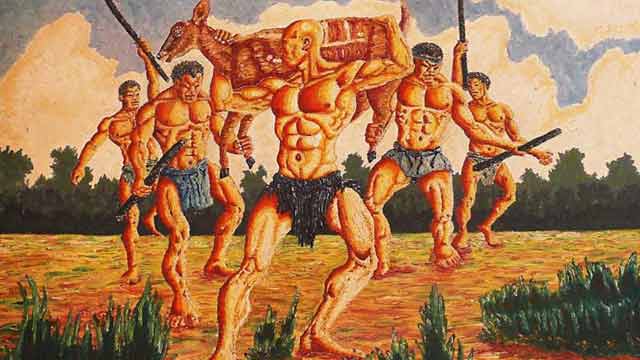
-
 Emmanuel Aklasu
Emmanuel AklasuOwusu-Ankomah’s painting at first glance reveals a foreshortening company of energetic warriors, muscular framed with broad shoulders, muscled chest, and a narrow waist in a chiselled physique. The hunters were portrayed with huge hands, clenched fist, knuckles, strong legs visibly revealing biceps brachiis and dabs of varicose veins on the arms, thighs and legs evident of powerful and efficacious men. Before modern society, the average male spent most of their time hunting, protecting, and engaging in physical activities that increased their muscle mass and maximize their muscular proportions. Owusu-Ankomah’s production exhibits masculine competitiveness and a sense of adventure – the brave team were a-fire with passion, armed with sticks in a leopard-like graceful movement as the captain leads carrying a captured antelope shoulder high.
The warriors are noticeably naked with only a string of grass costume wrapped around the private parts which is the formal and ceremonial attire for the ancient culture. Owusu-Ankomah’s choice of colour in rendering the human figures lends credence to the fact that colours have a strong position in identifying humans while hunting. Wearing hunter orange is the best way to ensure other hunters see you and don’t accidentally mistake you for game in complex backgrounds that are often green or brown. The artwork reveals harmonizing brown colours which tend to create a central focal point in the entire picture frame to evoke earthiness, emotions, security and safety related to the natural world. The tints and shades of hues enhanced the main features in the painting to vividly communicate the intended message as well as create an illusion of depth.
A thick flora forms the background of the painting evident that the hunting expedition was carried out in a thick forest. As the fearless, able-bodied men advance through shrubs in high spirit of mission accomplished, an earthly scent swirled around them coupled with a sense of eagerness to meet a welcoming, expectant and jubilant community. Hunting is an extremely important mode of human-nature interaction closely linked to culture patterns and value systems. This engagement with wild animals is thought of as part of a deeper unity with nature, which means being part of nature in physical sense (Lowassa et al., 2012). Sustainable hunting prescribes taking as much as needed and as much as the habitat and the population can regenerate. Suffice to say, when hunting for a game form the basis of a year-long survival of a people, it calls for a deeper reflection. Owusu-Ankomah’s painting comes on the back of an ancient heritage of a distinct tribe in Sub-Saharan Africa.
‘Aboakyir’ translated ‘deer hunt’ is a festival uniquely celebrated by the Effutu (Simpa) people of Winneba in the Central Region, southern coast of Ghana, West Africa. The festival which is celebrated annually on the first Saturday in May has the historical antecedent of the replacement of a human sacrifice to a tribal god with a leopard – an alternative which resulted in the loss of many more lives than the sacrifice of a single slave. Consultations with the deity for a more humane alternative resulted in the “Wansan” (the deer) as a practicable and most acceptable substitute. The capture of a live deer, like the leopard, required many more hands than the members of the royal family could find. The additional hands required were solicited from the local militia as a service to ‘the stool – a symbol of chieftaincy, royalty, custom and tradition’. It was this change in form; that is, the involvement of the local militia, that the annual consecration and appeasement of the deity became a public, state-wide affair. This marked the birth and hence the origin of the “Aboakyer” festival.
The design of the Effutu State emblem tells this story; the ‘stool’ on which the King is installed sits on the “Wansan” (the deer).

Emblem of the Effutu state (Source: Palace of Oma Odefe)
The festival is therefore important for the ‘stool’, its occupant and the entire royal stool family. It is a religious duty and an obligation for the general citizenry to ensure its celebration annually is sustained to honour the ancestors and protect their historic culture for posterity on the back of removing evil and predicting a good harvest for a prosperous life in the coming year. The week-long activity begins with two traditional warrior groups known as the ‘Asafo’ companies consult their shrines for clearance, protection and early catch. The warrior groups clad in distinct costumes with distinct musical instruments — the ‘Tuafo' and ‘Dentsefo’, move to their respective hunting grounds at dawn on Saturday, wielding sticks and clubs amid chanting of war songs. No weapons, other than clubs and sticks are used to catch the deer, as it must be brought back alive.
By far, the relevance of Owusu-Ankomah’s painting is not in doubt as it fosters a deeper understanding of the historical and societal roles of hunting within Ghanaian communities. The painting holds both cultural and educational significance which sparks discussions on conservation, sustainable practices, and the preservation of cultural heritage. Consequently, bridging the gap between present generations and the rich tapestry of cultural and environmental history. The sight of the painting in Ghana’s National Museum serves as a poignant reflection of the nation’s cultural heritage and connection to nature. In this visual narrative, the core of historical period of a distinct society is unearthed.
References
- Lowassa, A., Tadie, D. & Fischer, A. (2012). On the role of women in bushmeat hunting – Insights from Tanzania and Ethiopia. Journal of Rural Studies 28(4):622–630.
Further Reading
- Anane-Frimpong, D. (2022). Aboakyir: Deer hunt festival. Link Retrieved on April 10, 2023
- Rubiano, W. (2017). Planting trees for the aboakyer festival 2017. Link
Published March 2024
 Barbara Lutz-Sterzenbach
Barbara Lutz-SterzenbachAn energetic scene. Five men in a flat landscape approach the viewer. Their bodies are naked - except for their loincloths - their faces grim. Muscles in the bright light stand out under the skin, their chests bulge voluminously - they are timeless heroes. The men do not look at the viewer of the picture. With their long, dark sticks firmly in their strong hands, they gather symmetrically around the bald man in the foreground. He presents himself with an antelope in his raised arms. His bald skull points to the left, as does the antelope's head.
On closer inspection, some things are irritating. Are the men dancing or walking? Where is the animal spatially located? Somehow it is on the shoulder of the man, but the legs are captured by the men behind, who would be much too far away for that. Is an event, an episode (as in a photograph) depicted? Or does the symmetry of the composition speak more of a constructed symbol, a sign, as in an emblem? The latter would support the strict division into horizontal planes: with the islands of grass in the foreground, the flat, ochre-coloured plane in the middle ground and the forest with sky in the background. But then again many design principles undermine this order: the tense, energetic movements of the figures, the strong brushstrokes, the irregular shapes of the white clouds and the tufts of grass, the dynamic accents of the sticks.
We know from our Ghanaian colleagues that what is depicted here, the catching of the animal, is part of a ritual celebration and a festival (the Aboakyer Festival). Here the moment is shown when the men have stepped out of the dark, hermetically sealed forest in the background with their prey and now present themselves in the bright light with their success. A comparison with the results of an image search on the internet for “Aboakyer festival” (Fig. 2) shows that this is the iconic moment. Here the idea of the festival seems to be condensed. And this also explains the emphasis on muscles: the hunters must be well trained to match the animal's speed and strength.

Fig. 2 (Google search for "Aboakyer Festival" on 9.9.2023 - the first page of results) Screenshot: Ernst Wagner
Owuso-Ankomah's painting focuses on the men with the animal. At first glance, the painting shows above all the strength of the men. The space thus becomes the backdrop for their performance. Their bodies are not only idealised but theatrically exaggerated, their muscles as if illuminated by a spotlight. The geometric centre of the picture, through which the horizon also passes, brings the loincloth of the leader into focus (see fig. 3) - perhaps an allusion to male potency?

Fig. 3: Composition sketch (horizon and geometric centre) Photo: Ernst Wagner
A comparison with photos on the same theme from the Heritage Centre in Winneba (see Fig. 4-6) shows clear differences to the depiction in Owusu-Ankomah's painting. In the artwork, both animal and hunter have their mouths open, exhaustion is evident in both. In this way, too, man, animal and landscape are connected - despite hunting and death. The artist uses the warm ochre tones in such a way that the earth, the human body and the animal hardly differ in colour. Since the animal is still alive, its head does not have to be held. Thus, visually, it seems to elude a depiction of "being trapped", also due to the ambiguous spatiality described above. It could almost just as easily be understood as a triumphant appearance of the animal, to which the men are subordinate as bearers and assistant figures - comparable, for example, to Jan van Eyck's depiction of the lamb (see fig. 7), which also marks a mediating position between victim and victor, between human beings and God.

Fig. 4-6: Photos from the Heritage Centre Winneba Photos: Ernst Wagner

Fig. 7: Van Eyck, Lamb of God, Image Detail: Ghent Altar. Oil on wood, 350 x 461 cm
Cathedral of St Bavo, Ghenthttps://commons.wikimedia.org/w/index.php?curid=109213 [28.10.2024]
This image sets against each other contradictory concepts: static-symmetrical-ordered vs. dynamic; accidental situation vs. deliberate staging; documentation vs. sign; hyperrealism in body and space vs. symbolic charge. It sets these contradictions against each other in the unity of the painting.
Reference
Published March 2024
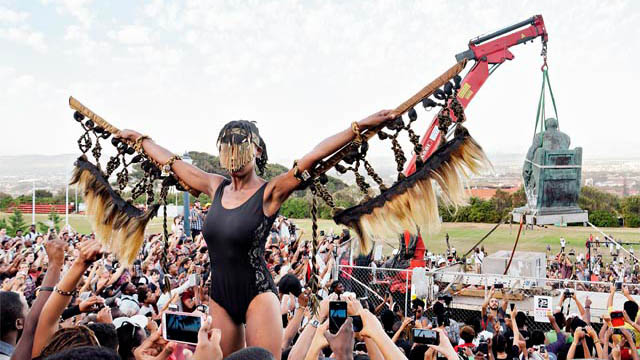
-
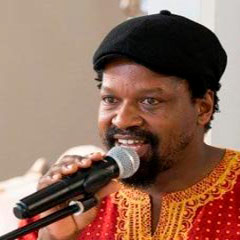 Bongani Mkhonza
Bongani MkhonzaIn this chapter, I trace the original source of the image that inspired the artwork by Sethembile Msezane titled, ‘Chapungu- The Day Rhodes Fell (2015). I envision that to get to the bottom of it, the etymology of the word ‘chapungu’ as used in the title of the artwork will have to be retraced and given context. The second section of the chapter discusses the content of the artwork in relation to how it endeavors to employ the old classical imagery in an attempt to negotiate new meanings. Lastly, borrowing from a family of critical discourse analysis theories (Fairclough and Wodak 1997; van Dijk 1997; Wodak 2001b) the strategies of monumentalisation as constructed by the dominant political culture will be analysed.
What is in the title? The etymology of the word ‘chapungu’.
The word chapungu is associated with a language used by the Shona people found in Zimbabwe. The Shona language developed as part of the greater Bantu heritage populating the central and southern Africa. According to the online VaShona project dictionary, the word chapungu refers to: “Any large, rapacious bird of the Falcon family, esp. of the general Aquila and Haliaeetus. The eagle is remarkable for strength, size, graceful figure, keenness of vision, and extraordinary flight” (https://vashona.com/en/dictionary/sna/chapungu). The Shona tribe of Zimbabwe created myths about the chipungu bird. Some elements of those myths seem to have been inspired by other world’s mythologies of birds with mythical powers. In the beliefs of the Shona, “the bird called chapungu (bateleur eagle) is a good omen, bringing protection and good fortune to a community” (Muzari 2013:1). The chapungu bird is also seen as a symbol of strength hope and renewal. The attributes used by the Shona people to describe the myths and beliefs about the chapungu bird seem to flow into the metaphor of a phoenix bird. Accordingly, I maintain that the context is key in recapturing the derivation of meaning behind the title of Msezane’s artwork. Shedding light on the etymology of the word ‘chapungu’ brings us to appreciate the connection between Cecil John Rhodes and the Shona people of Zimbabwe. Of course, to assume that the title ‘Chapungu - The Day Rhodes Fell’ (2015) is not connected to Cecil John Rhodes might be too farfetched. Evidence drawn from history shows that there is a direct relationship between Rhodes and Zimbabwe (formerly known as Rhodesia). Moreover, when you ask the Shona people where does the word Zimbabwe originate from, they will inform you that it is a Shona word for ‘Stone houses’. Stone houses are a “historical stone structure known as Great Zimbabwe, which is the second largest in Africa after the Egyptian pyramids” (https://www.sahistory.org.za/article/role-cecil-john-rhodes-british-south-african-company-conquest-matabeleland). Cecil John Rhodes and the British South African Company (BSAC) invaded Zimbabwe in 1890. After the invasion, the lands were named the Southern and Northern Rhodesia, to honour Cecil John Rhodes (https://www.sahistory.org.za/people/cecil-john-rhodes). This connection enlightens us in terms of what might have probed the artist to use the Shona word, ‘Chapungu’ as part of a title of her work.Old image new meanings
The foreground of the artwork depicts an image of the artist spreading her arms far wide projecting a takeoff position. It is known knowledge that humans will never fly by flapping arms with wings. Therefore, this self-defining act transforms her incapable human physicality into a metaphysical creature that is capable and ready to fly. The act by this metaphysical creature can also be received as its yearning for freedom and justice. Moreover, it also becomes a creature that is able to defy and transcends time and space. In her artists statement Msezane (2016) concedes that “she employs strategies of creating self-definition that are deeply rooted in looking at her own past, be it through spirituality or relearning South African history and its alternate narratives” (Msezane 2016). The image of this creature is strategically deployed for the audience to perhaps liken its agency to that of a myth of the phoenix rising from the ashes.Associated with the temple of the Sun in Egypt, and re-invented in Greek mythology, the story of the phoenix has been appraised as one of the world’s most-loved stories. It is the mythology of the world of modern monsters as told and retold by writers, philosophers, artists and poets through generations. Tacitus and Ovid are the two great authors from the classical period who stand out when painting a picture of the phoenix mythology. Perhaps it is mostly because of the way that Tacitus ventures out to humanise the attributes and actions of the phoenix and he refers to it as ‘he/him’. While, Ovid negates the phoenix of subject pronouns which are only used when referring to people. In telling his story, Ovid refers to the phoenix as ‘it’.
Tacitus narrated the story in the following detail, “in the consulship of Paulus Fabius (A.D. 34) the miraculous bird known to the world by the name of the Phoenix, after disappearing for a series of ages, revisited Egypt. It was attended in its flight by a group of various birds, all attracted by the novelty, and gazing with wonder at so beautiful an appearance. The first care of the young bird as soon as fledged, and able to trust to his wings, is to perform the obsequies of his father. However, this duty is not undertaken rashly. He collects a quantity of myrrh, and to try his strength makes frequent excursions with a load on his back. When he has gained sufficient confidence in his own vigour, he takes up the body of his father and flies with it to the altar of the Sun, where he leaves it to be consumed in flames of fragrance” (Bulfinch 19AD:[sp]).
Ovid’s story is almost similar the one told by Tacitus. Ovid’s version is narrated as follows: “Most beings spring from other individuals; but there is a certain kind which reproduces itself. The Assyrians call it the Phoenix. It does not live on fruit or flowers, but on frankincense and odoriferous gums. When it has lived five hundred years, it builds itself a nest in the branches of an oak, or on the top of a palm tree. In this it collects cinnamon, and spikenard, and myrrh, and of these ‘materials builds a pile on which it deposits itself, and dying, breathes out its last breath amidst odours. From the body of the parent bird, a young Phoenix issues forth, destined to live as long as its predecessor. When this has grown up and gained sufficient strength, it lifts its nest from the tree (its own cradle and its parent’s sepulchre), and carries it to the city of Heliopolis in Egypt, and deposits it in the temple of the Sun” (Bulfinch 19AD:[sp]). To this end, Msezane’s (2015) artwork references a known classical image of the phoenix to negotiate her struggle to recover her lost forms of visibility as a black woman in South Africa. In this way, it can be said that she is born again. Msezane (2016) is quoted as expressing that, “by examining past and present representations of black women…, in public and private domains, [she] focuses on the omission of iconic black women in history and mythology” (Gallery Momo 2016:[sp]).
At the background, the stage of the statue of ‘Rhodes falling’ is set. The site is loaded with the ambience of euphoria, yet almost similar to the scene of tragedy; it also gives you a baffling feeling of trepidation. A sense of uneasiness perhaps also emanates from an inferred ever presence of violence. Intended or imagined, the violence is visibly signaled by a force of a crane removing the statue. To anyone with eyes and curiosity, the crane’s arm also propounds an idea of a machine-gun. Unlike Camus’ (1942) existential theatre of the absurd, this background theatre in Msezane’s artwork seems to seal the fate of Rhodes, as if ‘he’ was going to be destroyed either way. Either by the truck that is physically depicted removing ‘him’ to a point of obscurity or by the machine gun.
Monuments and dominant political power
In concluding notes, monuments form part of a critical discourse in the legitimisation of a dominant political power structure. The public installation of powerful elites as iconic figures is either a precursor or descendant of the formulation of a nation. Either way, monuments and monumentalisation are a political construct that is trapped within the discourse of inclusion and exclusion. In response to this dilemma, Msezane’s artwork (2015) deploys a struggle to affirm the existence of the excluded in the formulation the powerful symbols for the nation. Most of all, her work challenges the percieved role of national symbols and commemoration spaces as key features in the portrayal of women as invisible subjects in history. As a young women growing up in Cape Town South Africa, Msezane looked around and saw no reflection of herself represented in public space such as the statues and monuments. Her performance piece where her female black body stands upright holding her wings straight out to the sides as if a phoenix rising from the ashes is indeed an act of self-affirmation. Msezane asks for no permissions but use the re-imaging as a strategy to re-insect her female black body as evidence of her existence.Bibliography
- Birch, D. 2009: The Oxford Companion to English Literature (7 ed.) The Theatre of the Absurd (1942). Oxford University Press.
- Bulfinch, T. 2019: AD Bulfinch’s mythology: the age of fable: the age of chivalry: legends of Charlemagne. New York: Modern Library.
- Fairclough, N. and Wodak, R. 1997: Critical discourse analysis, in T. van Dijk (ed.), Discourse Studies: A Multidisciplinary Introduction. Vol. 2. London: Sage, pp. 258–84.
- http://www.krugerpark.co.za/africa_bateleur_eagle.html (Accessed 20 January 2019).
- https://www.sahistory.org.za/article/role-cecil-john-rhodes-british-south-african-company-conquest-matabeleland (Accessed 19 January 2019).
- https://www.sahistory.org.za/people/cecil-john-rhodes (Accessed 19 January 2019).
- http://www.unwomen.org/en/news/in-focus/women-and-the-sdgs (Accessed 23 January 2019).
- https://vashona.com/en/dictionary/sna/chapungu (Accessed 20 January 2019).
- Msezane, S. 2016: Artist statement. Gallery Momo, Johannesburg.
- Msezane, S. 2017: Kwasuka Sukela: Re-imagined Bodies of a (South African) 90s Born Woman. Exhibition catalogue 2017, Gallery Momo, Cape Town
- Muzari, G. 2013: When a luck-bringing bird falters. The Standard News. Zimbabwe.
- van Dijk, T. (ed.) 1997: Discourse Studies: A Multidisciplinary Introduction. 2 Vols. London: Sage.
- Wodak, R. 2001: What CDA is about — a summary of its history, important concepts and its developments, in R. Wodak and M. Meyer (eds), Methods of Critical Discourse Analysis. London: Sage, pp. 1–13.
published November 2019
 Janina Totzauer
Janina Totzauer"Rhodes Must Fall" - Personal Experiences of a Guest Student in Cape Town
The protests around Rhodes Must Fall were a unique and cathartic experience for me as a German guest student in Cape Town in 2015. When I arrived in January, the city was on fire. Literally, because it was the hottest summer in a long time and Table Mountain had caught fire; figuratively, because something was boiling under the students. While the fire-fighting helicopters thundered over our heads, I caught up within a few weeks what the German school books on colonial history denied me. Cecil Rhodes, great colonial ruler and self-proclaimed philanthropist, had once donated large tracts of land to the University of Cape Town, securing for himself an imposing statue on the main campus. Sitting on a throne, the eternal bronze image gazes down from the heights of Table Mountain to the plains of Cape Town, the so-called Cape Flats, where even today many of the poorest of the poor live. The only problem with his patronage is that he illegally appropriated the building land that secured him the eternal gratitude of the university, befitting a colonial ruler. In other words, he stole the land from the locals and drove them out.
Twenty-one years after the fall of Apartheid in South Africa, it seems overdue that such a ruler be overthrown. The first generation of "Free Borns", all South Africans born in free South Africa after 1994, had reached their third year at the University of Cape Town and they yearned for this reminder of the colonial past to fall.
I remember hot afternoons spent in the streets. We demonstrated; all of us, white and black, "coloured" or "Indian" as they say in South Africa. Water bottles were passed around, the heat brought some of us to our knees. By the second demonstration, there were many more of us, hundreds. The driveway to the university was blocked. We were better organised. Water bottles, oranges and yoghurt were passed around. When I squinted puzzled at the countless milk cartons, they explained to me that they were there in case we had to wash our eyes out if the police would shoot at us with tear gas. I was still laughing. Later that afternoon, I provided milk to screaming faces and watery eyes. Art students staged performances and the main leaders fired up the crowd through the megaphone. "Rhodes Must Fall!", "Decolonise our University!" In between, old struggle songs were sung in Zulu. Songs that once accompanied the fall of Apartheid. I didn't understand a word, yet the power of the crowd pierced me. Something big was happening here, the history of the country yearned to be rewritten in the coming weeks.
I pushed my way to the student-organised congress about the next demo on the main campus. I wanted to know where to help. The atmosphere was heated. There was a lot of shouting. Anger spoke from many speakers. I wanted to get involved and raised my hand when, after a while, it was announced that no white people were allowed to speak today. I couldn't believe it at first. I was raging inside. I was on your side. I had been forbidden to speak and I was outraged. To this day, that small and subtle moment is a big turning point for me. Over the next few weeks, I worked my way from indignation to the realisation of what a privilege life I must have lived if I was so outraged to be banned from speaking for once. What a democratic paradise I must have grown up, if I take it for granted that I am allowed to speak and be heard. The fact that the ban was issued because of my skin colour brought me back into the prevailing conflict. If this one ban on speaking upset me so much, how must the majority of people in South Africa have felt during Apartheid. A trauma that even the first generation "Free Borns" have not yet let go of.
We were standing in front of a government building - I don't remember which one exactly - when the howling grenades went off. We were only about 40 students that day. I knew many of them from the art campus. It was hot and they kept sending white students forward to demand water from the government building's securities or to stand in the front row as a buffer against the police who besieged us. Skin colour as a defence mechanism. The demonstrators implied that whites were less likely to be attacked by the police. That they would be treated more politely and thus have their water bottles refilled. Just two small examples of grievances that seems to be out in the open in South Africa, but disappear under the colourful emblem of the "Rainbow Nation". When a small scuffle broke out between the young demonstrators and the few police officers, there were suddenly two bangs. So loud that the world seemed to sink into eternal silence afterwards. Everyone bursted apart, a young man sunk to the ground. He held his ears. He was later taken to hospital in a taxi.
It is the 9th of April when the protests are heard. The university has been closed for weeks because of the demonstrations, but today everyone gathers on the main campus. Cecil Rhodes is going to fall. We can't believe it yet. A crane is ready and thick winches hang around his body. Mr Rhodes' head is dripping with red paint, his jacket decorated with graffiti for weeks. We stand on the steps at Cecil's back, also looking down on the city. The city that in a few minutes will be a bit more free. More decolonised. There is singing and dancing. For the first time in weeks, the mood is exuberant. There are hundreds of us, representatives of all political parties take the microphone again and again, wanting to make sure they were there at this historically important moment. And then it happens, the statue is lifted from its pedestal. The crowd screams, drones circle in the air. Smartphones capture everything for eternity. And when the construction fences can no longer hold back the crowd, people also dance on the truck that slowly drives a Cecil Rhodes crowned with a dirty bucket off campus. The crowd continues to dance into the evening hours and as classes tentatively resume at the university the following week, the spirit of revolution is in the air. "We have been heard". To this day, the fall of Cecil Rhodes stands for a first strike in the struggle for the decolonisation of South Africa, not only on university campuses.Published December 2021Translation by Matthew Bremner

-
 Paul-Henri Souvenir ASSAKO ASSAKO
Paul-Henri Souvenir ASSAKO ASSAKOThe logo takes on the formal look of the chips used in the “Abbia” game. It is a traditional game that was played only by men in the South Cameroon Plateau until the beginning of the colonial period. In its general form, the logo is comprised of two main parts: an upper part which bears the phrase “The University of Yaoundé 1” (in French and in English) and a lower part that is defined by the slogan in Latin words “sapientia collativa cognitio” (wisdom is collected cognition).
The central part of the upper component of the logo features four human figures organized around a table. The rigid geometrization of the composition of the logo and the regularity of the lines give great expressiveness to these graphics. The treatment of the shape of the logo exhibits remarkable influence by traits of the “Abbia” token. The geometric schematization of the pattern and the ogival shape of the logo scrupulously drawn by regular lines determine the elements that mark this influence.
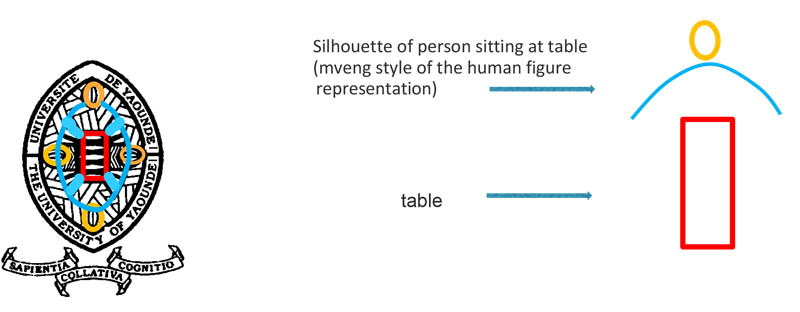
The name of the game “Abbia” refers to “hazard”, “a game of chance where bets are placed, which may be a simple gourd of palm wine, a human being (woman or child), livestock, or the player's farm or plantation etc.” (Cyrille Bela, 2006). These are not just simple tokens but a characteristic artistic expression that is pertinent to the sculptural heritage of South Cameroon’s population. These tokens obtained from the pits of the sapotaceous fruit (Mimusops le-testui), present on their smooth faces a wide variety of anthropomorphic, zoomorphic, geometric subjects, etc. minutely engraved in bas-relief by the artists. In addition to their use for the game, Abbia tokens are also ideograms and pictograms that have sometimes been associated with divinatory practices (Maurice Pervès, 1949: 27). Designing a logo that is inspired by them is significant from a dual aesthetic and symbolic perspective capable of inspiring elements of content to national identity.
On the independence trajectory of the 1950 – 1960 period, the year 1957 is significant. It is marked by the creation of Cameroonian citizenship and the adoption of the first symbolic acts of the nation. After the investiture of André Marie Mbida, the first Prime Minister of the State of Cameroon on May 15th, 1957, the Legislative Assembly of Cameroon (ALCAM), on November 10 of the same year, chose the first national emblems: national anthem, flag, and a motto. From that moment, the visual and artistic elements revealed themselves and displayed their importance very early in the narrative of the history of the Cameroonian nation and the constitution of its heritage. The adoption of these national identification symbols is not unequivocal. We note with regret the anonymity of the authors/creators of these national emblems: “but we must nevertheless state the fact that no specific and nominal mention was made of the Cameroonian authors of the national anthem thus chosen. Later in 1960, the same silence will be reserved for the author – also Cameroonian, of the seals of the Republic of Cameroon, without us fully understanding the meaning to be given to these oversights” (J. E. Pondi, 2012: 65).
The trauma created by the sanctions imposed by the colonial powers on the various forms of reference to local iconographic and symbolic culture could justify the timidity of an exaltation of visual culture and its authors. The elements of visual and symbolic language such as the logo will come from an experience of distant memory and sporadic circumstances for several years. We observe, for example, that for several years the University of Yaoundé remained without a logo. The covers of the University’s annals of 1969 and 1970 illustrate this and bear only the words “Federal University of Yaoundé”. During the same period within the intellectual elite of the aftermath of independence, a nostalgia for traditional artistic culture is expressed in a literary modality. For example, one of the most important cultural journals created by this elite in 1962 is called Abbia in reference to the art of “Abbia”.
The absence of details on the date of creation and the conditions for the adoption of the logo of the University of Yaoundé does not exclude the probability that it was designed and produced by Engelbert Mveng between 1983 and 1987. Everything suggests that Mveng's legitimacy to take credit for the creation of this logo has not been subject to any reservations. As a Jesuit priest and artist/researcher, Engelbert Mveng’s cultural sensitivity, his academic reputation and his important artistic promotion action must have facilitated the adoption of the logo by the University’s administration. (Engelbert Mveng was Director of Cultural Affairs at the Ministry of Education and Culture from 1966 to 1974. Then, from 1983 to 1987, he was Head of the History Department at the University of Yaoundé.)The 1993 University Reform with the establishment of new state universities in Cameroon was also a significant factor in the creation of this logo. In Yaoundé, for example, the presence of two universities undoubtedly required the elements of visual identity capable of distinguishing the University institution from the others.
Universities are considered by politicians as the contexts for the conception of modern culture with identity characteristics for the young nation. Mveng (1930-1995) does not lose sight of this perspective. This is how he undertakes the re-appropriation and integration of traditional knowledge and skills in the creative process of the logo. The author applies his theory of the “loi de creation esthétique” (aesthetic process of creation) to the graphic design of the University of Yaounde’s logo.
The simplified form of this process is “OLMC” where O represents “natural object”, L represents “essential line of the object”, M is for “motif”, and C represents “composition”. This process was inspired by a methodological scheme of synthesis that Mveng (1980) notes by studying traditional artistic practice in several African societies. Mveng observes a recurrence of certain principles of creation: the observation of the natural object, the graphic representation of the object limited to the essential line and finally the use of the essential line as motif / sign in the composition of the works of art. The practical applications of this process favoured the development of an iconographic style and a production of works with a characteristic and very singular visual identity. This style is characterized by a schematic reinterpretation of the elements that surround us in patterns that we arrange in the compositions, which we transpose on different supports. In 1966, Mveng, inspired by the idea of modernizing “traditional African art”, created the “Art Nègre” workshop in Yaoundé. This workshop became a veritable laboratory for graphic design of iconography called to mark a cultural renewal.
Thanks to the privileged social and political position held by Mveng (priest, academic and artist), the Negro Arts Workshop succeeded in producing several works (paintings, drawings, sculptures, collages, etc.) both in Cameroon and in the diaspora. The workshop brings together artisans from various regions of Cameroon. It created a form of co-incorporation and also developed an important part of the production of religious art there. On the same methodological principles of “aesthetic creation”, the workshop produced the first liturgical imagery which presents the characteristics of the phenomenon of inculturation in the Cameroonian Catholic Church.
The University which the logo identifies is an educational context that predicts the future of society. The development of this society depends on the quality of training/education, skills and values that the school gives to young people. Education extends to everything from economic expansion to civic spirit. It engages the individual and collective prosperity of the country recalled in 1965 by Ahmadou Ahidjo (first president of the Cameroonian republic). The motto of the University in Latin: “sapientia collativa cognitio” displays the ideas that are dear to this institution whose mission is to train each Cameroonian well, to make him an artisan of prosperity and to make him a participant in the management of the state (J. C. Bahoken and E. Atangana, 1975).
The mention in French and English of “Université de Yaoundé 1/University of Yaoundé 1”, which follows the contours of the upper component of the logo, mainly reflects the bilingual nature of the Cameroonian University. Of course, this bilingualism is one of the symbolic markers of the political and cultural history of the unity of Cameroon. It expresses national political unity and guarantees openness to the participation of the Cameroonian University in transnational and intercultural dialogue that is essential for the development of the country. To use President Ahmadou Ahidjo's words during the inauguration of the said University on November 17, 1967, the University is an instrument of “dialogue with all nations of good will”.
Nowadays, the vices which characterize Cameroonian society such as corruption, the weakening of the patriotic and nationalist spirit in favour of ethnic and regional withdrawals, the weakening of the civic spirit, the inadequacy between training and employment and unemployment, to cite only these examples, expose the weaknesses of the education system in the country. The factors responsible for such an assessment are inter alia linked to the problems of immaturity of educational references very often adopted in a circumstantial manner (at random). Learning suffers from a lack of ingenious practices linked to the social transformation project. In other words, the educational project has a hard time building learning methods that take into account the socio-cultural, political and economic flows and bridges now established between here and elsewhere, today and tomorrow. As George E. Hein (2011) wrote, understanding learning as a social activity is a principle for considering successful education. An educational project which does not take this into account would venture to commit the fate of society at random as in the scenario of the game of “Abbia” where the most important goods of the players were randomly bet.
Download Paul-Henri Assako Assako's presentation on the origin of the logo by following this link.
References
- BAHOKEN J.C. et ATANGANA Engelbert. 1975. La politique culturelle en République unie du Cameroun, Éditions Les Presses de l’Unesco.
- BELA Cyrille. 2006. l’art des abbia : une forme d’expression sculpturale des pays pahouin, in « Afrique : archéologie et arts », 4 | 2006, p. 83-90.
- George E. HEIN. 2011. Constructivist learning theory//1991, in education, documents of contemporary art, London, Edited by Felicity Allen.
- MVENG Engelbert.1980. L’Art et l’Artisanat Africains, Éditions CLE, Yaoundé.
- PERVÈS Maurice. 1949. Parmi les Fangs de la Forêt Equatoriale : le jeu de l’Abbia, Revue de géographie humaine et d’ethnologie n° 3, p. 26-41.
- PONDI Jean-Emmanuel, 2012, (Re)découvrir Yaoundé ! Une fresque historique et diplomatique de la capitale camerounaise, Yaound Ed. Afric’Eveil.
- https://journals.openedition.org/aaa/1373.
- https://www.osidimbea.cm/cameroun-okoba/cameroun-1967/
published February 2020
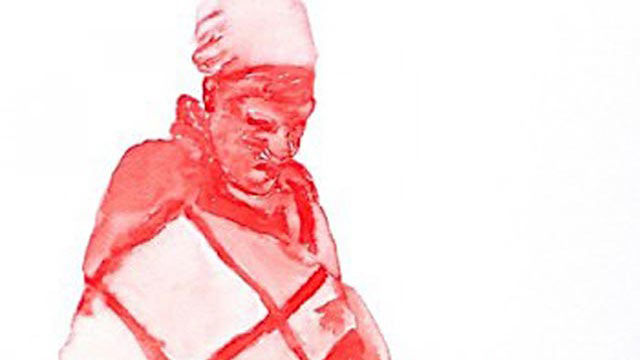
-
 Elfriede Dreyer
Elfriede DreyerOver the last three-and-a-half centuries, South Africa has experienced volatile and turbulent histories of a colonial, postcolonial and global kind. These brought on substantial nomadic movement of people, leading to political and social displacement, and hybrid identities. Since 1652, as a multifariously colonised country South Africa has shown cultural patterns of movement in and out of the country, and from place to place. The country is extraordinarily rich in mineral resources and gold, which has brought about massive wealth, but also instability. Johannesburg was established in 1886, due to the so-called gold rush, with fortune seekers and diggers flooding from all over the world to the country. Since then, the gold mines have attracted an influx of locals as workers, which contributed to much nomadism, but ironically – especially since 1948 during apartheid – such mine workers were allowed to work underground but once above ground they had to return to townships outside the large cities. During apartheid, non-whites or ‘people of colour’ were removed from the city and forcibly established in townships outside the city; they were only allowed as workers into the city; and had to carry passbooks (identity documents) on them all the time.
Such nomadic identity as a result of marginalisation and displacement is still presiding, but for different reasons since 994 and the end of apartheid. From this time onwards there has been a immense influx of people from all over the African continent to South Africa in search of greener pastures. Whereas during apartheid many intellectuals and people ‘of colour’ emigrated from the country, over the past two decades there has been an outflux of people due to a strong degree of political uncertainty and actions of political redress in the post-apartheid constitution, or to convicted beliefs of ‘not belonging’ to the new political dispensation.
Senzeni Marasela’s series of works entitled Waiting for Gebane (2015-2016) entails a continuation of her previous work, such as the embroidery series Theodorah in Johannesburg (2006) and Sarah, Senzeni and Theodorah come to Joburg (2011). In the latter works she explored her relationship with Johannesburg as city and experiences her mother had when she first arrived there. She used embroidery as technique and thread due to its associations of fragility, and conceptually she considered the issue of black women in migration to the cities. Theodorah was depicted as travelling to the city with the aim to finding out exactly what it is that has made many people disappear into Johannesburg. She is uncertain of what she is actually looking for. In the 2014 exhibition catalogue for Nomad bodies at the Wintertuin gallery of the Royal Academy of Fine Arts in Antwerp (curator: Elfriede Dreyer), Marasela stated that “I continuously return to the city, looking and relooking as it undergoes massive transformation. Having grown up in a catholic environment, penance informs a great deal of methods which are labour intensive. The city of gold is important as a transitory space: people go through the city, they come to the city and many dream of this city. There is something impermanent about this city, and it is precisely at this point that I began to write my own histories. The social climate of the city has never been favourable to the women that enter it. It is deliberate that I leave the city arid, without indications of lived experiences, as I seek to build the Johannesburg I can safely occupy.”
However, in Sarah, Senzeni and Theodorah come to Joburg the artist includes herself and Sarah Baartman also as nomads or pilgrims in the city. The three women’s plights are fundamentally different – Theodorah is on ajourney looking for her lost son Gebane; Senzeni is on her journey finding her foothold as individual, and colonial Sarah was displaced to Europe from the Eastern Cape– but they are one in their search for a place, recognition and restitution. They are each other’s doppelganger in their journey through the city of Johannesburg which forms the backdrop to the works. The metaphor of the rhizome is of particular interest to an engagement with nomadic identity in the context of a continent such as Africa. Already in 1987 Deleuze and Guattari (1987:7). coined the idea of rhizomatic being, stating that the “rhizome itself assumes many diverse forms, from ramified surface extension in all directions to concretion in bulbs and tubers”. Living on a vast continent, Africans are accustomed to long journeys; however, poverty, violence, civil wars, imperial infiltrations and oppression have resulted in a generalised nomadic condition where people are constantly moving and travelling in the search for a better life and even survival. However, in a wider sense, globally, Rosi Braidotti (2011:3) states that the nomadic predicament and its multiple contradictions have come to age in the third millennium after years of debate on the “’nonunitary’ – split, in process, knotted, rhizomatic, transitional, nomadic – so that fragmentation, complexity and multiplicity have become everyday terms in critical theory.” Braidotti has been engaged since the 1990s with the question as to what the political and ethical conditions of nomadic subjectivity are, grounded in a “politically invested cartography of the present condition of mobility in a globalized world” (Braidotti 2011:4).
Zygmunt Bauman (in Hall & Du Gay 1996:19) views the ontologies of nomadic identity as becoming critical when there is uncertainty as to where one belongs, a view that is crucially relevant to emerging urbanising African identity. `the figure of Theodorah can be aligned with the idea of the flâneur, which Bauman appropriates in his presentation of the stereotype of the pilgrim who as a stroller is on a teleological journey – ordered, determined and predictable (Bauman in Hall & Du Gay 1996:21). Comparing the contemporary world to a desert through its fragmentation, Bauman views it as being inhospitable to the notion of the pilgrim, being unable to leave a footprint in the sand. The forward march of the pilgrim (Theodorah) is equally compromised and in the context of the wind effacing footprints (of Gebane) and the rhythmical similarity of the desert environment, the pilgrim goes in circles (Bauman in Hall & Du Gay 1996:23). “The overall result is the fragmentation of time in episodes, each one cut from its past and from its future, each one self-enclosed and self-contained. Time is no longer a river, but a collection of ponds and pools” (Bauman in Hall & Du Gay 1996:25).
As in these afore-mentioned works, in the series Waiting for Gebane the artist’s mother is depicted as going from her rural environment to the ‘big city’, Johannesburg, in a search for her son Gebane who left for the city and never returned. She becomes a nomad in her searching ritual, but it is a dystopian journey, providing no teleological “good ending” and leading nowhere, since she cannot find him. The works depict a potent image of Africans searching for a better life elsewhere, but simultaneously failing in finding answers to their economic and other dilemmas. Waiting for Gebane explores cultural and artistic mappings of the social and political power geographies and complexities that dominate cities. Of pertinent interest here is how people’s decolonial transition from rural to urban contexts have been voiced, claimed, renegotiated and contested, especially in the context of capital cities as locations where there is a conflation of global and local influences. Mendieta (2001:15, 23) argues that cities have become the “vortex of the convergence of the processes of globalization and localization … [and] epitomes of glocalization, to use Robertson’s language (1994)”; and that the “city is the site at which the forces of the local and the global meet: the site where the forces of transnational, finance capital, and the local labour markets and national infra-structures enter into conflict and contestation over the city.”
In Marasela’s work, contemporary African identity is characterised by particular cultural histories, as well as by identifiable patterns of transitivity and how people construct their identities psycho-geographically. Dispossession of the embodied and embedded self is articulated so that the city and placelessness become sides of the same coin (Braidotti 2011:6). Braidotti (2011:7) argues that “The contrast between an ideology of free mobility and the reality of disposable others brings out the schizophrenic character of advanced capitalism”, which is nowhere more visible than in the political and social extremities in South Africa. Marasela’s work expresses the idea that meaning is created through the crossing of space and distance between bodies, or as Soja (1989:133) argues, “To be human is not only to create distances but to attempt to cross them, to transform primal distance through intentionality, emotion, involvement, attachment.”
New decolonised Identities emerge through movement through in the world and interfaces with alterity. Often, it is a sense of alterity or the attraction to the exotic other that produces nomadism. Waiting for Gebane thus presents the ambivalent Baumanian idea of the pilgrim-tourist who keeps going in circles, driven by a non-teleological sense of survival and looking for a better life, which might not lead to a ‘good ending’. Nomadic identity is essentially rhizomatic here, and in South Africa – also in an amplified sense on the African continent – the drive to belong and the utopian quest for a better life have resulted in identity being redefined, renegotiated, rerooted and sprouting in many directions.
Senzeni Marasela is a female South African artist of Zulu origin, born in Thokoza, KwaZulu Natal in 1977. She is currently completing a MA degree in Art History from Wits University (SA); she has exhibited widely in the national and international contexts; and she has been awarded several grants and residencies, for example from Devon Arts Residency (Scotland) The Ampersand Foundation and Axis Gallery in New York; The Thami Mnyele Foundation in Amsterdam; and the Kokkola Art Academy in Vasa. Her artist website is found at http://www.senzenimarasela.com.
References- Bauman, Z. ‘From pilgrim to tourist – or a short history of identity’. In Hall, S and Du Gay, P (eds). 1996. Questions of cultural identity. London/New Delhi/Thousand Oaks: SAGE.
- Braidotti, R. 2011. Nomadic subjects: embodiment and sexual difference in contemporary feminist theory. Second edition. Gender and culture: A series of Columbia University Press. New York: University of Columbia Press.
- Deleuze, G & Guattari, F. 1987 [1980, French original]. A thousand plateaus. New York: University of Minnesota.
- Hall, S and Du Gay, P (eds). 1996. Questions of cultural identity. London/New Delhi/Thousand Oaks: SAGE.
- Mendieta, E. 2001. Invisible cities: a phenomenology of globalization from below. City: analysis of urban trends, culture, theory, policy, action 5(1):7–26.
- Soja, E. 1989. Postmodern geographies: the reassertion of space in critical social theory. New York/London: Verso.
published February 2020
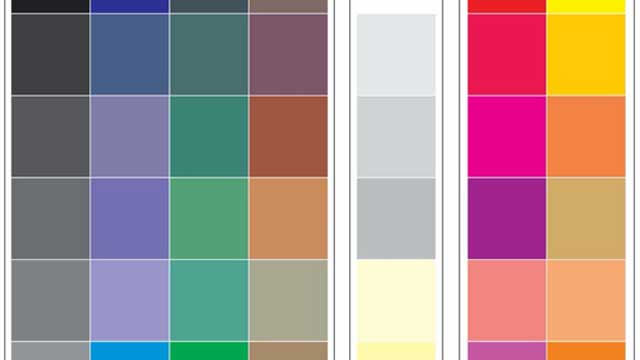
-
 Patrique deGraft-Yankson
Patrique deGraft-YanksonAkan definition of Colour
The Akan people have no precise terminologies that assign a ‘name’ which interprets into the meaning of colour the way it is understood in English and other languages. In other words, most of the answers to the question ‘what is colour’ makes very little meaning to a pure Akan speaker whose understanding of colour transcends a scientific definition. In spite of several efforts by contemporary linguists to subject the Akan concept of colour to nomenclatural consideration, the traditional Akan people continue to describe hues by their relationship with similar colours in nature.
Consequently, terminologies in Akan, which are associated with the word colour, are likely to describe what a hue looks like in association with the natural (or in few occasions, manmade environment) or how a hue makes one feel, think or behave. Among numerous attempts at coming up with an Akan word for ‘colour’, the ones many respondents settled on were yɛbea, subea, su, husuo, ahusuo and bↄbea. These words, which mean almost the same in Akan, literally describe the nature, quality or, probably more precisely, the physical look/appearance of something. By implication therefore, the terminologies deduced are more general and their usage go beyond the description of just the colour of an object or a situation under discussion.
Colour names
Colour names among the Akan people, are often given directly after identifiable objects within the known environment. Therefore, names given to colour in Akan have the tendency of affecting the perception, understanding and accurate adaptation of colour among the Akan people. Name, like colour itself, has strong cultural significance. Therefore, names that are understood in one’s language are likely to have better cultural associations and connections with their people than those that sound foreign.
In this regard, many Akan people are of the opinion that all efforts at identifying names for colours should continue with the culture of associating colours with the local names of known objects among the Akan people. For instance, if there are names such as ahabanmon (fresh leaves) for green and akokↄ serade/akokↄ aŋoa (chicken fat) for yellow, there could also be names like ahabanfunu/ahatawfun (dead leaves) for brown, gyafrane/gyanframa (fire flames) for orange, gon/dwene (gray hair) for gray, etc.
Number of colours
The number of colours recognizable by a traditional Akan are as many as those identifiable and describable in nature. As already indicated however, recognized Akan colour names and their identification are mostly in relation to those discernible in nature, for which reason their descriptions are broadly categorized. The following are colours available in the traditional Akan language.
- Kↄkↄↄ (Red)
To a very large extent, kↄkↄↄ, the sound of the name of the colour identified as red among the Akan people is more onomatopoeic than semantical in interpretation. Kↄↄ, the root word, visualizes the sensation of the word glow. Therefore, kↄkↄↄ actually connotes more to complexion with a strong bright colour. It commands an ambience of hot brightness, usually with scorching visual sensation, rather than a simple colour name. For this reason, kↄkↄↄ is attributable to all objects that emit some warmth in their visual ascriptions. Therefore, whilst a ripe pepper is described as kↄkↄↄ, ripe mangos, ripe oranges, glittering gold, burning coal, sunny skies, flames, the skin of a ‘white man’, etc. are all kↄkↄↄ as well. In the Akan colour scheme therefore, colours that could be placed analogous to kↄkↄↄ include red, orange, pink, wine and the like.
- Fitaa/Fufuw (White)
Fitaa/fufuw is white, light, plain, spotless, clean, neat, pure, holy, untainted and incorrupt. Moreover, fitaa/fufuw is always associated with cleanliness, purity, victory and spirituality. It denotates white coruscating brightness, visual spotlessness and stainlessness. No matter where it is spotted, the associated psychological and spiritual experience comes naturally, and this is inert in almost every Akan.
Another dimension of fitaa/fufuw is its direct association with light especially when it reflects bright objects to shine. When something shines or sparkles, or hyerɛn as it would be said in Akan, it is associated with brightness and for that matter, white. In this regard, a spark that would be lighted by any colour to give the feeling of brightness will be described as fitaa. The reason is that the psychological feeling of brightness invoked by the sensation is more important than its sensation on the eye.
- Tuntum
One does not need to understand the word tuntum to be able to link its semantic association with weight and heaviness. Tuntum connotes darkness and visual weight, and technically expressed, all the cool colours on the colour wheel fall within the brackets of colours in this category. Tuntum connotes darkness, gloom and heaviness. To the Akan, tuntum does not only stand for black, but absence of lightness, brightness, shine, glow, gaiety, happiness and sparkle. This is not to say that tuntum in Akan spells doom. Just as with all the other colours, the reason behind its application is what matters most to the Akan. For instance, the weight and compactness of tuntum also represents unmatched strength and solidity. Hence, expressions such as black power, black beauty, black star and black magic connote the highest levels or degrees attainable in the referent condition. So, whereas tuntum or dark colours are used in the expression of gloomy and moody conditions or situations, they are also considered for situations that require seriousness, formality, deep concentration, calmness, maturity, strength and energy. Again, in its association with darkness and stillness of dark night, tuntum also connotes calmness, coolness, rest, quietness and serenity.
The Akan Colour Chart: Minimal Dimensions of the Akan Colour Scheme
The following charts present attempts at putting into perspective the minimal dimensions of the Akan colour scheme. As mentioned earlier, everything that qualifies to be described as colour from the Akan point of view can be located within three broad colour spectra—tuntum (dark), fitaa (white) and kↄkↄↄ/memen (glow, spark, shine), and they physically manifest in the shades and tints of black, white and red. Right from this point, it is clear that colour among the Akan is perceived more with feelings than just the light sensation it emits. Therefore, the colours that fall under these themes are believed to share more physiological, psychological and spiritual feelings than aesthetical feelings (even though that is an integral part). In the examples of natural colours associated with colour names in the tables below therefore, the ripeness of pepper, mango, orange and tomatoes are all described as kↄↄ, establishing the overall feeling they evoke. The greenness of a virgin forest, the darkness of rain clouds, the depth of the deep blue seas and the blackness of charcoal are all tumm or tuntum (dark) because of their command of psychological heaviness. The bright skies, the white flower, cotton and the grey hair are all fitaa because they share similar ambience and invoke the same feeling of brightness. It should also be noted that apart from tuntum (black, dark), fufuw/fitaa (white, bright) and kↄkↄↄ/memen (red, glow, spark, shine), none of the associated colours has a name in Akan. What they have, at best, could be discussed as descriptions. In other words, colours of objects are rather described than named.
The following charts illustrate colour from the perspective of the participants in this study, as illustrated by the author:
Figure 1: Akan colour category Tuntum and its natural colour associations. (Photo: the author)
Figure 2: Akan colour category Fitaa/Fufuw and its natural colour associations. (Photo: the author)
Figure 3: Akan colour category Kↄkↄↄ/Memen and its natural colour associations. (Photo: the author)
From the above charts, the Akan colour reference scheme above was derived.
Implications for design and design education
Cultural understanding of colour from Akan perspectives will direct how colours could be appropriately grouped under the appropriate themes to enhance effective appreciation of design as well as effective communication. It would also ensure that the role of language and cultural interpretation of colour is given due recognition in the design education process.
Reference
- deGraft-Yankson, Patrique (2020), ‘Of the Akan people: Colour and design education in Ghana’, International Journal of Education Through Art, 16:3, pp. 399–416, doi: https://doi.org/10.1386/eta_00041_1
published November 2020

-
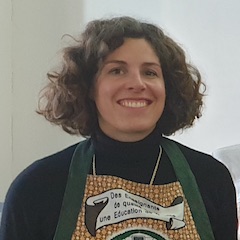 Annette Schemmel
Annette SchemmelThe photo at hand was shot in Paris in the 1920s. We are looking at a beautiful young woman with very fair skin who seems to have sunken her head on a table as if for a rest, while her left hand is carefully exposing a polished mask made from dark wood. The woman is Kiki de Montparnasse alias Alice Prin (1901 – 1953), Man Ray’s lover, a model for many painters and herself a successful artist. Supposedly, Kiki was central for the myth of the Montparnasse as an artistic enclave in Paris.3 The mask is simply “African” in the eyes of my pupils at first. I want them to learn that we are looking at a portrait mask4 of the Baule people in Ivory Coast. Pupils should also understand that such carved portraits served to honor an important member of a Baule society, a woman in this case. A dancer wearing a similar mask would incorporate the portrayed notable at the occasion of ritual dances, thus celebrating her achievements.5 This specific mask’s features are balanced and dignified, harmonious but not realistic, a point to which I will come back later.
Meanwhile I shall argue that Man Ray’s picture thrives on carefully staged contrasts. The title that has come to stick with this photograph hints not only at black-and-white photography itself, but also at the most obvious contrast, at the White and Black6 skin or surface of the picture’s protagonists. Yet there are further opposites linking the lady and the mask in the picture, namely the opposites of young, ultra-modern and lively versus ageless, “primitive” and inanimate, matt versus shiny, skin versus wood, a seemingly passive woman versus the upright face of the mask, holding versus being kept. The photo historian Wendy Grossman has described how these opposites relate: “Almost as if it were a direct cast, the vertical mask, with its shiny black patina, is a negative mirror image of the reclining model’s ovoid face, echoing her pursed lips, closed eyes, and tautly styled coiffure. Parallel symmetrical shadows extend beneath the two perpendicular forms, coupling face and mask in a shallow and austere space.”7
Clearly, Man Ray has smartly staged the Black and the White. By the time he shot this picture, Man Ray was making a living of object photography in Paris, then the world capital of fashion. It might therefore come as no surprise that this picture made its first appearance in an early print medium dedicated to beauty and fashion, the Vogue magazine. When the issue came out in 1926, everything “exotic” was fashionable in Paris, especially arts from (indirect) African origin, such as Jazz, Josephine Baker or, well, the mask in Man Ray’s photograph.8
Beyond its uncontested fashionable appeal “Noire et Blanche” unveils some deeper, more unsettling meanings, some of which I intend to unfold here. A simple reading is ready at hand if one places this artwork in the historical context of the colonial era. In 1926, the mask’s country of origin belonged to Afrique Occidentale Française. On this backdrop, the dreamy woman holding the mask in Man Ray’s picture appears to be a Freudian slip in the form of a photograph, an unconscious idealization of colonial domination. Are we looking at a personification of the imperial power of France carefully embracing its colony Ivory Coast?9
Next, we could follow a feminist lead towards interpretation. This photograph stages two females, whilst an important third actor of this mise-en-scène is invisible, the male photographer. Through his camera, the male artist is looking at the passive naked woman und at the artefact of a culture that is foreign to him. Obviously, the mask has become passive, too, once removed from its original context. In this reading, Man Ray’s photograph appears as a staging of the desire for submission – the submission of the idealized female and that of the cultural “other”. As viewers, we are lured into this voyeuristic pleasure, unless we take some critical distance.
Following a suggestion of some South African colleagues, we shall now look at this photograph through the lens of the Martinican author Franz Fanon. In his famous psychoanalytical text “Peau noire, masques blancs”, Fanon is pointing at the phenomenon of the essentializing construction of a Black soul (“l’âme noir”).10 Following Fanon, Man Ray’s photograph can be considered one of those efforts by European (and certain African) artists of the classic Modern era to catch hold of an imagined essence of Black culture. This effort needed to objectify Blackness in order to make this construct palpable and acceptable. Arguably, in “Noire et Blanche” the ’black soul’ lies in the hand of a white person and is reduced to an object, the sculpted mask. Furthermore, it could be argued with Fanon that Man Ray used the Blackness of the wooden object, the “noir” that is readily associated with the ‘continent of darkness’ in the collective imagination of Westerners,11 in order to highlight his girl-friend’s Whiteness. We know that contrasts help at intensifying and it is no secret that White is a color (of skin) that Europeans tend to associate with innocence and purity.12 Arguably, this racialized contrast of the “Noire” and the “Blanche” served to celebrate qualities that Man Ray projected onto Kiki de Montparnasse, his partner.
So far, I have tried to make clear that the artwork “Noire et Blanche” is not only a showcase of female attractivity, but that this photo also has a violent dimension to it because it relies on certain colonial mechanisms of distinction. As an art teacher, it is my ambition to make this picture’s ambivalence understandable for my pupils. I know that pupils are more likely to learn if they are allowed to make their own discoveries,13 for instance by exploring ‘real’ scientific data through the Internet. From our classroom, we can access the Metropolitan Museum’s online collections, which include a comparable portrait mask.
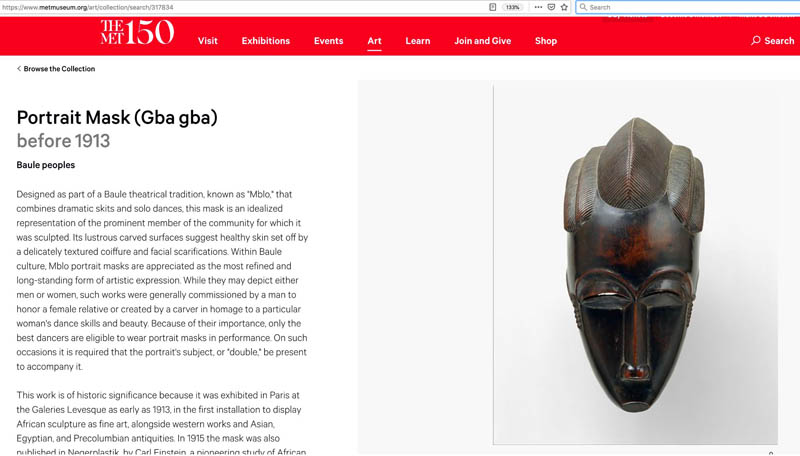
Website of the Metropolitan Museum, New York
Other than the black-and-white photograph by Man Ray, the museum’s more recent color picture unveils the fine shades of brown and red tones that are characteristic of the tropical wood used for Baule masks. Obviously, such masks are not Black in reality. Furthermore, pupils can learn from the provenance info that the Baule mask in the Met’s collection was famous amongst art lovers and artists in Paris and Berlin already before WW1.14 This insight helps to understand why Man Ray might have chosen a similar object for his photograph: artists tend to learn from each other.
As a continuation, I like to encourage my pupils to sum up the museum’s text about the characteristics of portrait masks by the Baule by means of notes in German language. In doing so, the learners realize that these masks are carved according to a complex canon of beauty, that the forehead is high for a reason, namely in order to represent intelligence, that the polished surface signifies good health and that a representation of a person can convey dignity even if the proportions of its face have been exacerbated. This is new to many youngsters, whose frustration with their own efforts at realistic drawing has shaped their preference for artists’ realistic skills. Pupils also learn from the online information that this mask can only be brought to live as part of a performance, thus discovering a problematic aspect of its preservation in a museum.
Coming back to “Noire et Blanche” with this new knowledge, my pupils realize that Man Ray’s photograph is concealing much of the knowledge that is available today. They understand that it is worthwhile to research background information for non-European art, even if this requires leaving their textbooks behind and going an extra mile with their foreign language skills. In the course of the classroom discussion that follows we are wondering why a Baule community would have let go of their precious mask, a question leading to recent restitution debates.15 Furthermore, the teenagers understand that the coquettish presentation of the mask in the hands of a naked European woman might be read as a sign of lacking respect by members of its culture of origin. At this point of the discussion some pupils have experienced a change of perspectives. This experience of assuming a position previously perceived as ‘other’ in the course of a lesson is the very purpose of our engagement with this artwork at school, arguably it is also the purpose of looking at art altogether.
Let me summarize this approach. Comparing Man Ray’s photograph “Noire et Blanche” with the mask from the Metropolitan museum’s collection is a way to scrutinize a canonical picture from a critical perspective without denying the aesthetic appeal of the historic photograph. By way of this lesson I hope to enable changes of perspective and to build sensibility for post-colonial readings of pictures amongst pupils. Taking a bold stance, I shall claim that such lessons are conducive to a more general type of visual competence because I like to think that my pupils’ experience with the implications of this attractive historic picture might encourage them to also critically scrutinize any other picture in the future.
References
[1] For a thorough photo-historical analysis read Wendy A. Grossmans insightful article “Unmasking Man Ray’s Noire et blanche”, American Art, Vol. 20, No. 2 (Summer 2006), pp. 134-47.
[2] For instance, Man Ray is mentioned in the widely used text-book Epochen der Kunst. Von der Moderne zu aktuellen Tendenzen (Hsg: Robert Hahne, Oldenburg Schulbuchverlag GmbH, 2013, S. 150/51). In this book, information about him and the photo “L’Enigne d’Isidore Ducasse” (1920) are featured under the header of „Fotografie und Film im Surrealismus“. It can be argued that „Noir et Blanche“ is surrealistic as well, since it seems to be illustrating Lautréamonts famous phrase “beautiful as the chance meeting on a dissecting table of a sewing machine and an umbrella” (Lautréamont alias Isidore Lucien Ducasse, „Die Gesänge des Maldoror“, 1874.), with Man Ray’s “chance meeting” bringing together a white woman and a wooden mask.
[3] en.wikipedia.org/wiki/Alice_Prin (last accessed on August 26, 2019).
[4] Wendy A. Grossman’s article “Unmasking Man Ray’s Noire et blanche leaves no doubt that the mask in the picture is actually an airport art version of a Baulé mask, by the way (p. 136).
[5] Collection Records of the Metropolitan Museums (Baulé Masken), www.metmuseum.org/art/collection/search/317834 ((last accessed on May 3rd, 2017), also https://www.metmuseum.org/art/collection/search/319512 (last accessed on August 26, 2019)
[6] In this text, I will spell Black and White with capitals in order to highlight the cultural construct of Race.
[7] For the complex history of the title see Wendy A. Grossman, “Unmasking Man Ray’s Noire et blanche”, pp.140.
[8] More about this fashion in en.wikipedia.org/wiki/Josephine_Baker (last accessed on August 26, 2019).
[9] Research on Man Ray does not support this easy hypothesis however. In Wendy A. Grossman’s article from 2006, the origin of the photograph is described as an open-ended artistic process partly sparked by commercial interest, partly by a collaborator, but not by political intention. However, I would like to argue that art works tend to transmit more or less unconscious convictions of their authors and their peers, which makes of artworks valuable witnesses of their times.
[10] Frantz Fanon, “Schwarze Haut, weiße Masken”, translated by Eva Moldenhauer, Wien: Turia + Kant, 2013, p. 14, 147.
[11] Fanon makes this point in “Schwarze Haut, weiße Masken” (2013), p. 158.
[12] “Symbolik der Farben, Formen, Zahlen” in Lexikon der Kunst, Bd. VII. S. 153-154, E.A. Szeemann Verlag, Leipzig 1994.
[13] I am here referring to pupils from eleventh grade of the Bavarian Gymnasium, whom the syllabus obliges to explore aspects of the body in art during half a year.
[14] Collection Records of the Metropolitan Museums (Baule masks), www.metmuseum.org/art/collection/search/317834 ((last accessed on May 3rd, 2017), also https://www.metmuseum.org/art/collection/search/319512 (last accessed on August 26, 2019)
[15] For a thorough introduction to this question read Felwine Sarr’s and Bénédicte Savoy’s “restitution report” commissioned by the French state. http://restitutionreport2018.com/ (last accessed on April 1, 2020).
published April 2020
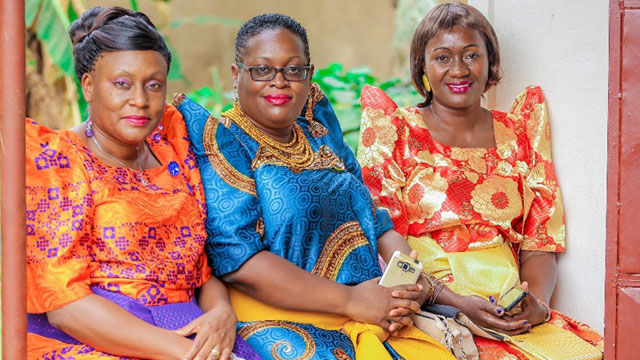
-
 Esther Kibuka-Sebitosi
Esther Kibuka-Sebitosi“Decolonizing self” is a photo demonstrating the complexity of cultures and how inter twinned African and western cultures have become. The photo was taken at a traditional wedding in Kanyanya village, where African cultural practices like sitting down on the mat are proudly demonstrated. Paradoxically, decolonizing the self-starting with the dress, is not an easy process as pieces of the western culture are clearly visible, for example the sunglasses, the necklace and ear rings all show the interlinkages between cultures. The example is excellent in showing culture, history and evolution of the traditional dress and political economy for educators. The mood of the gaze is best described by former President Thabo Mbeki in his poem,” I am an African” as he proudly says, “ “Today I feel good to be an African”.
In unravelling decolonizing self, I want to start with explaining colonialism; Torres (2007) refers to colonialism as, “ a political and economic relation in which the sovereignty of a nation or people rests on the power of another nation”. He refers to coloniality as a long-standing patterns of power that emerged as a result of colonialism but that define “culture, labour, intersubjective relations and knowledge production well beyond the duration of colonial administration”. Hence, coloniality, he argues, survives colonialism and is maintained through books, music, academic performance, cultural patterns, in self-image and aspirations of self and is lived every day. It follows therefore that decolonizing self would have aspects of culture, language and daily practices that one has to get rid of. Taking an example of cultural dress, I dress in my traditional dress called the busuti or Gomesi. The image shows the dress and the Shaath (cream colour that is used to tie it). The necklace is modern shining with stones. The accessories are also western. I am sitting down on a mat made out of sisal and “nsansa- palm tree leaves. Sitting down is a cultural tradition and practice that dates back for generations. This is also a gender demonstration of roles of women who would sit on the mat to greet visitors who had come to be introduced. The practice of paying lobola (bride price) is common in Southern Africa and traverses the African continent. In the photograph, everybody dresses in the traditional dresses. It is a way of saying “I am an African” and I dress like this, “Look how smart my dress is lovely”.
Ironically, long ago, the traditional dress was made of out of the Mutuba tree- Fig tree Ficus species. They got it from the bark of the tree, which they smashed until it became flat. It was dried and then rolled out. The cloth (Kikunta or Lubugo) comprised only of a sheet, which was wrapped around, the shoulders. Over the years, the Kikoyi replaced the kikunta as it was made out of cloth- cotton. Linked to the traditional dress, is the decorative materials from India. Inside the dress is another wraparound Kikoyi that together with decorations were also from India. The image shows the material of the dress- silk with beads. This material is from India or Dubai. The modern materials are no longer traditional (Kikunta and kikoyi). The local industry has adapted to make traditional dresses out of new materials linen, nylon, chiffon or a mixture instead of cotton or Lubugo from the Mutuba tree back.
The image also demonstrates the mostly western sunglasses or gaggles. The sunglasses show the western culture I have adopted over the years. The Europeans normally put on sunglasses to protect their eyes from the sun. The occasion was held during the day as the sun was shining. It is not traditional practice to wear sunglasses. However, they help protect the shy people, as they do not have to look at all the guests. The gaze in the image is that of a woman comfortable in her body, sitting down with pride and taking pride in her tradition. This particular image was selected because it reveals the culture in transition. It is contemporary culture- a traditional wedding- a place where African Culture is luxuriously displayed. Paradoxically, the dress is traditional but the accessories are western showing the entangled nature of coloniality- the tradition African culture and the western culture, practices, all intertwined in intercultural interactions. The sunglasses may also demonstrate the cover up- hiding of self in the modern practices. Based on the above, it is not surprising that Decolonization is a layered process, which takes time and patience.
Thabo Mbeki wrote a poem, “I am an African” expresses the objective of the constitution, “It is a firm assertion made by ourselves that South Africa belongs to all who live in it, Black and White”.
As I sit on the mat and watch the bride and groom give gifts to each other, I remember the words of the former President of South Africa, “Today I feel good to be an African”.
In decolonizing self, “decolonization” that has become the rallying cry for those trying to undo the racist legacies of the past, according to Achille Mbembe. Starting with cultural dressing is the first form of decolonizing self. Other forms include decolonizing power and decolonizing knowledge.
published January 2020
 Katharina Knaus
Katharina KnausBeyoncé’s and Jay-Z´s Video „Apeshit“ discusses post-colonial exhibition art
My first contact with art history was by reading E.H.Gombrich „The Story of art.“ (1909-2001). When starting my studies of art history in Munich, this was the book they recommended as standard literature. The cover text describes it as „the most famous and popular book on art ever published“. Although it claimes to be an introduction in art „for reader of all ages and backgrounds“ Gombrich tells a very one-sided story. Beyoncé’s and Jay-Z´s Video „Apeshit“ discusses post-colonial art historiography by exposing the Louvre as a white – dominated space.
„Two black women are sitting on the floor wearing light brown tights and body-hugging beige vests. They are in profile, facing away from each other, and positioned at either side of David’s painting of the famous 19th Century French socialite. Linking the two women together is a flowing piece of white material, each end of which they wear on their heads like a turban.
Above them, Madame Récamier reclines on her antique sofa, dressed in a simple sleeveless white dress, her head turned towards the viewer. The design of the sofa is similar to that of a sleigh-bed, with rising wooden ends. It is these bed ends that the women on the floor echo, the variance in the darkness of their skin matching the different tones of the wood in the painting.
The cloth that links them represents the dress worn by the painting’s subject. The message is clear: It was on the backs of subjugated black people from the French colonies that Madame Récamier was able to enjoy her life of leisure and pleasure.“ (Will Gompertz)
The Carters’ Louvre takeover isn’t just about protest; it is about power too. But the overall point is powerfully put. The game is up for those institutions – be it Hollywood, Broadway or the Louvre – which have ignored black artists, refused them a voice, or a seat at the top table.
published January 2020
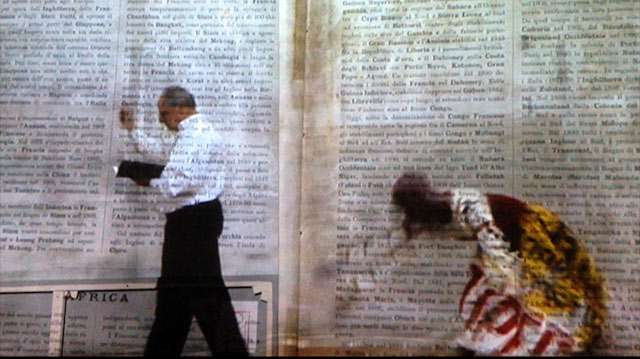
-
 Elfriede Dreyer
Elfriede DreyerOriginally, South Africa was discovered by the Portuguese in 1488, but this was not permanent, just like the Dutch settlement in 1652 that is generally viewed as the birth date of the country. In 1795 the Cape Colony fell under British rule again; it reverted back to Dutch rule in 1803; and again to the British in 1806. From the onset of colonisation, the transatlantic slave trade was immense and especially South-East Africa was a main source of slaves. The colonisation of Southern Africa had as main purposes the setting up of refreshment posts where food and other essential stock could be collected, as well as the trading of slaves. The indigenous nations were subject to the whims and fancies of the colonisers, and they were sexually and labour-wise exploited; families were broken up and those who resisted were punished and often killed by whipping, shackling, hanging, beating, burning, mutilation, branding and rape. In many cases the slave ships themselves were killer machines since the slaves were packed into the haul like sardines with little attention to hygiene.
In addition, South Africa is extraordinarily rich in mineral resources and gold, which has brought about massive wealth, but also instability. Johannesburg was established in 1886, due to the so-called gold rush, with fortune seekers and diggers flooding to it from all over the world to the country. Since then the gold mines have attracted an influx of locals as workers, which contributed to much nomadism, but especially since 1948 during apartheid, such mine workers were ironically allowed to work underground but once aboveground they had to return to townships outside the large city.
Since 1948 when the country became locally governed by the Afrikaner-dominated right-wing National Party, whilst still regarding Queen Elizabeth II as head of state as a relic of British imperialism, attempts were made to throw off the colonial yoke permanently, and on 5 October 1960 the country became an independent Republic. At all times there have been resistance to the ruling governments by groups of all cultural origin, but especially during the 1980s and early 1990s there was severe resistance to the ruling policy of segregation: a period that saw much abuse, violence and many incarcerations. In 1990 Nelson Mandela as leader of the oppositionist African National Party was released from prison and in 1994, as part of a peaceful handover, he was inaugurated as the new president of the country with the ANC as government.
It is clear that, as a country, South Africa has been torn apart by politics, and especially by the impact of colonisation. The postcolonial impulse is therefore inordinately robust in this part of the world. The notion of the postcolonial is closely linked to that of the postmodern, and according to Gen Doy (2000:204), author of Black Visual Culture: Modernity and Postmodernity, much of current art practice is “often relating to issues discussed in postcolonial theory such as identity, displacement, mixing of cultures and peoples (hybridity) and indeterminancy.” Post-colonialism could be viewed as a response as well as a resistance to colonialism, whereby issues such as historical events, beliefs, traditions, conventions and languages are evaluated and critiqued in an attempt to uncover the superiority and centrality of certain systems of thinking. Ideas of superiority and power relations play a core role in postcolonial investigations, but a main problem in much postcolonial theory is to nurture the idea of static black culture, which in reality is constantly changing and adapting to new developments and ideas. Decoloniality or decolonialism originated as a Latin American movement which focuses on understanding modernity in the context of a form of critical theory applied to ethnic studies. Similarly it is a response to colonialism. It seems to be more radically critical than postcolonialism which indicates more of a general resistance. Coloniality is generally understood as the sentiment and logic essential to the evolvement of Western civilisation from the Renaissance to today. Foundational to decoloniality is the deconstruction or decoding of the coloniality of power. This logic is commonly referred to as the colonial matrix of power and has its own set of theories and methodologies.
Since the 1980s, the work of internationally renowned South African artist William Kentridge (b. 1955, Johannesburg) has mainly served the purpose of commenting on socio-political issues in the country. He is best known for his prints, drawings, operas and animated films. A work of special interest is his The refusal of time of 2012 (hereafter referred to as ‘TRT’), since it presents a clear image of postcolonial legacies and decolonial sentiments that have resulted in an eclectic mélange of narratives, experiences and events. Particularly interesting is also how the artist mixes various kinds of technologies in sophisticated way.
TRT premiered at Documenta 13 (2012) in Kassel, Germany, specially commissioned by the curator of Documenta 13, Carolyn Christov-Bakargiev, and since then it has been exhibited at various other venues in Japan, Italy, Australia, the United States, Brazil, Holland and Finland. The work was produced in the artist’s studio in the Maboneng district in downtown Johannesburg and as a prelude to Documenta 13, a series of notebooks entitled 100 notes – 100 thoughts was published by Hanje Katz in 2011. In South Africa, the artistic production was shown first from November to December 2014 at the Johannesburg Art Gallery and then at the National Gallery in Cape Town in 2015. A collaborative piece, the artwork entails teamwork with Peter L. Galison, Philip Miller and Catherine Meyburgh. The chamber opera, Refuse the Hour (made in collaboration with Miller, Meyburgh, Dada Masilo and Galison) - with an international cast of eleven, including dancers, musicians, performers and vocalists - is the theatrical accompaniment that laid the groundwork for the artwork and is also an independent production. Prominent in the production is the artist presenting a lecture-performance on productive procrastination, myth, entropy, empire, black holes, the ancient Greek myth of Perseus and Einstein, surrounded by animations, swirling dancers, singers with megaphones, instrumentalists and a solitary physicist (BAM | Refuse the hour 2015).
As an installation, TRT comprises five digital film projections on thirty-minute loops and a large automaton, occupying the entire space of a single, large hall. In the dark enclosed space of TRT, a hive of moving figures and intersecting stop-frame imagery ensues in the five film projections, creating an impression of vibrating energy. The complex imagery includes the artist as one of the performers, walking, reading and performing acts such as changing hats; a female figure, dancing and producing ‘wagon wheels’ and other acts; figures in comical scenes in colonial rooms à la George Méliès; figures in a laboratory-like space, maybe busy with experiments; dispersing and flying anamorphic fragments becoming human figures, representing a kind of chaos rendering; a rhinoceros; silhouettes; ticking metronomes and clocks; and imagery of inter alia megaphones, starry skies, stop-frame animations and drawings. On the other hand, chaotic time is presented as humanly, existentially and imaginatively inferred. Mortal conceptions of the physical body appear in the form of chaos imagery of disintegrating matter; and swirling moving figures, transgressed boundaries, and fleeting script and words render an awareness of temporality and transience in order to defy conceptions of certainty and fixed systems. The moving human agents in TRT ‘transgress’ the confines of the delineated boundaries of each projection by walking across the edges, and by so doing become displaced and emplaced in in-between, liminal zones.
Kentridge positions the human body centrally in TRT. Technically, his scientific and conceptual method levies each projection that transforms intermittently from the graphic, more abstract imagery into the stop-frame animations to human figures (including the artist himself performing), clothed idiosyncratically in contemporary as well as traditional outfits. Other transmutations include a turn to colonial comical scenes with actors performing in rooms with historical architecture; walking and dancing figures; and figures in shadow procession, recalling some of Kentridge’s well-known earlier works. The sculptural automaton and ticking metronomes are given equal presence in the five film projections, which generates the comment that technological development has shown progress from elementary, handmade technologies to advanced digital technologies, but that the embedded techniques and processes are equally relevant.
In TRT, preference is given to a conceptual engagement with the human technological condition instead of a lofty statement about science itself. Kentridge ‘relegates' science to technology and succeeds in generating comment and meaning through the very processes of the techniques used. In the five ancillary virtual ‘rooms’, an artificial environment has been created, entrenched in the technologies of the digital age, which has borne witness to emerging engineerings such as electronic communications, artificial intelligence and biotechnology. Symbolically comment is generated in terms of politics as ‘experimentation’ and human beings as the victims thereof. Set in virtual reality, the rooms in the Méliès-type comical scenes in TRT resemble colonial architecture, but notably these are graphically hand-drawn. Through very technique of the linear and expressive sketching of doors, windows and other paraphernalia, heterotopic ‘frames’ are created that resonate with the racial and gender regimes of the histories of colonial culture in South Africa. Several spaces are represented in the work, but in a dualistic sense they are both material and immaterial, and ambivalently premised.
The flying particles in TRT subtly reveal thin red lines, crossing and indicating geographical points of intersection, but without explanation of what they represent. Metaphorically they could function as boundaries, relational reference points, historical markers, psychographical moments or points of reference wherefrom the ‘walk’ into time takes place or even the liminal ‘place’ where life and death meet. The particles become chaotic and finally disintegrate, almost in reflection of the processes of memory and how everything fades in time.
References
Doy, G. 2000. Black Visual Culture: Modernity and Postmodernity. Gen Doy London: I.B. Tauris.
About the artist
William Kentridge (born 28 April 1955) is a South African artist best known for his prints, drawings, and animated films. His political perspective is expressed in his opera directions, which involves different layers: stage direction, animation movies, influences of the puppet world. He has staged Il retorno d’Ulisse in patria (Monteverdi), Die Zauberflöte (Mozart) and The nose (Shostakovich). Berg's Lulu premièred at the Metropolitan Opera in New York, and in 2017 Wozzeck (Alban Berg) premiered at the Salzburg Festival.
published February 2020

-
 Patrique deGraft-Yankson
Patrique deGraft-YanksonFortunately, contemporary Ghanaian artists like Vincent Akwete Kofi and Kofi Antobam, who by their training, developed both the skills and the mindset to create and fully appreciate African arts have played major interventional roles. They, through rigorous production of masterpieces over the years, led the move to redirect the wavelength of Ghanaian artistic expressiveness along the paths of decolonization. A typical example of these arts is the Crucifix, the selected object for this discussion.
The Artist – Vincent Akwete Kofi
The Crucifix is a sculpture in the round, measuring 45x10x19 inches, and was created by Vincent Akwete Kofi, a Ghanaian artist who lived between 1923 and 1974. Characteristically, Vincent creates outstanding sculptures in humanistic forms. His sculptures speak to traditional African philosophies, ideals and beliefs (Grobel, 1970), and he through his works, seeks to reinforce the beauty, dynamism and complexities of African art. Indeed, Vincent’s artistic posture was largely informed by his training in the then Achimota College in the Gold Coast (now Ghana), an educational institution which sought to bridge the gap between European and African forms of knowledge (Woets, 2014).
Description and interpretation
The Crucifix was carved in tropical hard wood, one of Vincent Kofi’s preferred media, with the style and subject matter reminiscing his belief in the creative and objective fusion of lessons from the history of modernism in the arts by an immersion in his Ghanaian heritage. Like his earlier sculptures therefore, the choice of this Euro-Christian theme throws lights on his Pan-Africanism and decolonization intents.
The sculpture is a depiction of a free-standing human figure with features that conform with his earlier wood carvings, such as depiction of enlarged head and heavy feet which are more representational than naturalistic. Again, the entire form is seen as being directed by the limitations of the tree trunk deliberately chosen for the work. This, of course is one of Kofi’s traditional wood carving styling.
The Crucifix is postured in a clasped forward-bent lower limb. Like the lower limbs, the upper limbs of the figure which are raised over the head and stretched backwards, are also clasped together, depicting the entire image in a rather discomforting posture. Further strengthening the feeling of distress and discomfort in the image is the dropped and lifeless face and facial features of the image. The long thick beard of the image with the tightly fitting cylindrical hat on the head, carved after one of those won by royals among some sections of Ghanaians, give the figure an elderly look.
Other significant features of the image are the exaggerated clasped, forward-bent and wobbly elephantine feet, dropped face with shuttered eyes, flaccid body/skin/muscles (which is visible even in wood), and the heavy beard.
In trying to understand the presentation of the Crucifix, it is important to note that Ghanaians have stories about characters who lived and suffered similar fates as that of the Christ. The Fante people (a section of the Akan ethnic group), for example have records on a man called Ahor, who offered himself as a sacrifice to the gods, when the life of a human being was demanded as an antidote to a calamity which befell the people. Up to today, Ahor is celebrated in a festival called Ahorbaa to commemorate his brave and sacrificial feat. Other ethnic groups in Ghana have similar stories which render the Passion of the Christ not just a familiar phenomenon, but a lived experience recorded in the history of the people.
Also worthy of notice is the familiarity of the various themes which characterize the story of the Christ, such as his kingship, miraculous personality, sacrificial journey and his eventual torture and death. The Crucifix therefore, was Vincent Kofi attempt at depicting the passion of the Christ in a way that would make it familiar and relevant to the people.
The image in Kofi’s Crucifix was therefore needed to be presented as a man with royal personality, as depicted in the cylindrically shaped cap, which is symbolic of some of the Ghanaian royal millinery that depict kingship and authority. This is reinforced by a heavy beard to portray wisdom. Wisdom which is reserved for kings and aged people.
Analysing from the experiences of a people whose history was not devoid of unpleasant experiences, such as enslavement, brutal torture and execution, the image presented in the Euro-Christian Crucifix could not have been a complete representation of the Man of Sorrow described in the Christian holy book (Isaiah 53:3). Kofi therefore saw the need to present a figure which paints a real picture of a man who had gone through an extreme physical pain. Those strong and heavy, yet wobbly feet were a symbol of a man overburdened with sorrows and sins of the world.
Indeed, the man on the Crucifix was dead, with no chance of maintaining a smooth and shiny skin as seen in the Euro-Christian crucifix. In Vincent Kofi’s Crucifix, therefore, he, even in wood, managed to present a flaccid body/skin and muscles which, with the closed eyelids, dropped and lifeless face gave an impression of an extremely tired dead body. Probably an artistic rendition that comes close is Mel Gibson’s crucified Christ in his movie, the Passion of the Christ.
Conclusion
Early missionaries introduced the Christian religion with its attendant icons, images, stories and language in 1400s. Semblance in religious icons, images, stories and their associated functions made the acceptance of Christianity easier among indigenous Africans/Ghanaians. Vincent Kofi’s Crucifix could therefore be considered as a great effort towards connecting foreign Christian belief systems to known religious experiences, thereby making Christianity much more relevant to the African than it has been.
References
- African Artists in America (1978). African Affairs, 11 (3), 84-85.
- Frank, B. (1999). The Visual Arts of Africa: Gender, Power, and Life Cycle Rituals by Judith Perani and Fred T. Smith (A review). African Affairs, 11 (3), 14-16.
- Kwami, A. (2016). Kofi, Vincent Akwete (1923–1974). In the Routledge Encyclopedia of Modernism.: Taylor and Francis. Retrieved 31 Dec. 2021, from https://www.rem.routledge.com/articles/kofi-vincent-akwete-1923-1974. doi:10.4324/9781135000356-REM845-1
- Moore, G. (1967). The Arts in the New Africa African Affairs, 66 (263), 140-148.
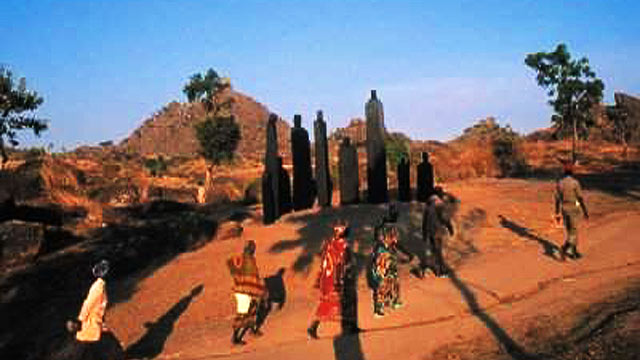
-
 Paul-Henri Souvenir ASSAKO ASSAKO
Paul-Henri Souvenir ASSAKO ASSAKOThe image is a photograph showing details of the French artist Christian Lapie’s public installations in 2001 in the city of Ngaoundéré, capital of the Adamawa Region in Cameroon. The work consists of five modules composed of nine figures, ranging between 150 and 450cm each and laid in a semi-circular radius of 1000 cm. The pieces are made of wood and placed vertically in an upright position. The upper end is shaped like a head, giving each piece the appearance of a human silhouette. Arranged like a gathering of people dressed in local traditional attire, called boubou (a long, loose-fitting garment worn by both sexes in parts of Africa), the works are aligned in a semi-circular arc.
The work’s detailed structure is closely linked to its title Djaoulérou, which means "traditional space, place of meeting and reception". The artist echoes customs in a context where the relationship between traditional practices and Islam remains ambiguous. Islam provides an opportunity for certain members of local society to acquire privileged positions under the auspices of religion. Religion’s role in the political game has proven to be so important that post-colonial politicians have laboured to maintain control of the religious sphere in every region. Religion presents challenges for politicians in terms of governance and control. Maud Lasseur (2005, 95), echoing this sentiment, maintains that: “During the colonial period and under the regime of President Ahidjo (1960–1982), Christian missions were thus contained to the south of Cameroon so as not to hinder the Muslim aristocracy of the Far North or thwart the unifying political project of the first Cameroonian president”.
The monumental character of the work, the rhythm and movement suggested by forms treated with little attention to detail, the variations in volume and the different dimensions of each silhouette make the installation look both impressive and expressive. Each individual group of statues, displayed at the same time in different places in the city, shows how the "mysterious objects" made by a foreign artist present unfamiliar traits regarding the city’s socio-cultural imagination. The work breaks taboos: an unusual appearance that creates artistic experience, tradition and beliefs, which have become subject to manipulation and political propaganda within the society.
The work’s destruction reflects the fragility of a slavish society instrumentalized by politically motivated religious arguments in the 2002 legislative elections in Cameroon. The fact that a French artist has carried out an unusual and iconoclastic installation project in this city is seen as a provocation, particularly by the Muslim cultural authority. This religious and political authority occupies a very influential social position as "guardian of the temple" (custodian of traditions) and is in a position to incite people to commit acts of such magnitude. In addition to setting fire to the works and proceeding to uninstall them, public authorities definitively closed down the Franco-Cameroonian alliance of Ngaoundéré because of the social unrest the works provoked. This cultural centre for Franco-Cameroonian cooperation had supported the artist's installation project.
The act of vandalism perpetrated on Christian Lapie’s work exposes Cameroon’s national society in search of landmarks. Art, and particularly sculpture, has played an important role in expressing belief systems. The cosmogonic universe and the world view of the populations that have succeeded one another in this territory have been revealed through artistic representation. The bold production and reproduction of anthropomorphic, zoomorphic, geometric and imaginary forms is typical of these societies. As in many countries in sub-Saharan Africa, art has helped what people see, think, imagine and believe (J.P. Notué, 2005). Because of the lack of critical understanding of their history and the changes they experienced, societies are confronted with major shocks that have an impact on their development. Among these shocks are an ambiguous relationship to religion. Its consequences are the religious and political manipulation that societies are sometimes subjected to. One historical reason for this is the attitude of missionaries who made no discernment in the positive values of the tradition and the absence of doctrine and deep convictions of these values (E. Mveng, 1985).
Cameroon’s colonial religious legacy is one of the most important sources of the ethical foundation of its society in the 21st century. The generalization of the religious profession of faith/conversion seems to have fostered a latent form of "alienation" among the urban society. There is a superficial knowledge of both the principles of modern culture and the traditional environment, two references whose slavish play of opposites have political stakes. In Cameroon, the policy of conviviality between Islam, other religions and local cultural practices implemented by Sultan Njoya in the Kingdom of Bamum presents elements of inspiration for a compelling form of social emancipation. The policy of inculturation and multi-confessionalism has favoured the cultural openness of society and preserved, for example, the sustainability of the region’s remarkable creative industry. Art, belief systems and politics are all values of cultural expression fundamental to society.
The work breaks taboos: the artistic experience created by its unusual appearance calls upon traditions and beliefs that have become subject to manipulation and political propaganda within the society.
References
- Mveng Engelbert. 1985, Histoire du Cameroun, tom 2, Yaoundé, Ed. CEPER.
- NOTUE Jean-Paul, TRIACA Bianca, 2005, Bandjoun, Trésors royaux du Cameroun, Milan, Ed. 5 continents.
- Maud Lasseur. 2005, in « www.cairn.info/revue-afrique-contemporaine-2005 ».
- Assako Assako PH.S. 2011, l’art au cameroun du XXe au début du XXIe siècle : étude des expressions sculpturales en milieu urbain, thèse de Doctorat/Ph.D. en histoire de l’art, Université de Yaoundé 1.
- www.christianlapie.net/oeuvres/16/djaoulerou
- www.christianlapie.net/mobile/news/326/.%20http:#news
- www.christianlapie.net
published February 2020
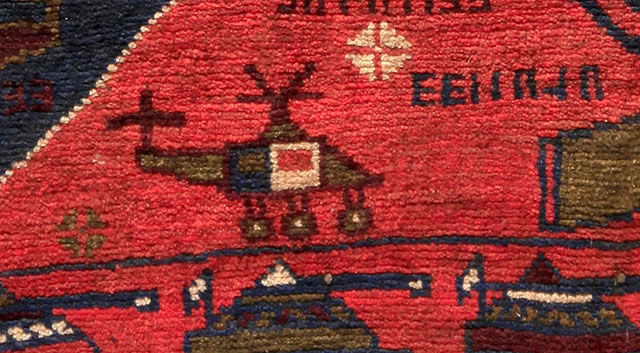
-
 Zoe Schoofs
Zoe SchoofsThe oriental carpet — in Europe it was once proof of the owner's long journeys or good trade relations, but in the regions of origin it was an everyday object used everywhere, often with a reference to paradise. With the invasion of Afghanistan by Soviet troops, the aesthetic concept changed — instead of lively gardens and elaborate arabesque patterns, suddenly there were tanks and weapons — so-called war rugs were created. Not only, but also for European viewers, whose idea of carpets is decisively influenced by classical Persian appearances, these new conventions of representation represent a break with the familiar. Soldiers, diplomats and war correspondents brought such pieces with them from their stays in Afghanistan and made them known in Europe and the USA. Enthusiasts and museum staff were quickly found to create collections of these objects, including the collectors Hans Werner Mohm, Till Passow and Enrico Mascelloni, as well as the Museum für Völkerkunde in Freiburg and Die Neue Sammlung – The Design Museum in Munich.
Carpets from the Orient were already popular at European courts in the 13th century, as they referred to the good trade relations with the Near and Middle East and served as prestigious items of the interior. Carpets were imported, but were also knotted directly in European court manufactories. With the enthusiasm for the Orient that emerged in the middle of the 19th century, the perception of carpets, whose origin had been relatively irrelevant until then, changed to a meticulous, scientific analysis, especially with regard to origin and iconography. World exhibitions and museums made them accessible to an ever wider public. While up to then carpets from courtly and urban manufactories had been the object of desire, over time those with a nomadic context became the centre of interest (Jansen 2001: 138). While this interest had already subsided on the part of the ruling dynasties in the 17th century, carpets for decorative use were produced for the bourgeoisie in the course of the industrial revolution. In 1861 William Morris founded his company Morris & Co. in Great Britain. "Over time, the carpet became part of an aesthetic 'spatial concept'. The technique and decorative motifs were first adopted from the Orient, but then adapted to Western tastes.“ (Bristot 2011: 32) They embodied "[...] the romantic ideal of the free and combative nomad in boundless expanse [...] the Turkmen carpet could be regarded as a sign of this independence sought among men.“ (Jansen 2001: 64) Thus the carpets found their way into male smoking rooms and libraries, also as blankets, cushions and seat covers when cut into pieces. The relocation of the production to factories brought with it simplifications of the motifs and thus further changes. The luxury good was now accessible to a broad section of the population and was thus the object of everyday use.
Carpets from these contexts, unlike woven textiles, are often knotted. They can be found in many different cultures all over the world. Basically, a distinction is made between courtly and urban works and works of the rural and nomadic environment, although there are of course blurred lines. While in the case of courtly and urban carpets all work processes were carried out by the respective specialists (spinning, dyeing, designing, knotting, etc.), all work processes for the carpets from the rural-nomadic environment were in one hand. These objects were primarily produced for the company's own needs and in some cases for the small local market. Courtly and urban carpets, on the other hand, were mostly commissioned works, intended for export or as envoy gifts and made in manufactories. The respective environment had a decisive influence on the appearance of the knotting work. In contrast to rugs made in manufactories, those produced in private homes or a rural community where meant for the local market.
The objects that today are commonly known as classical oriental carpets mostly originated from the Persian Empire and are therefore also known as Persian carpets. At this point, however, it should be noted that a large number of ethnic groups which were united under Persian rule knotted those carpets and that therefore there a large number of different aesthetic concepts. Those from northwestern Persia are most likely to correspond to the European idea of a particularly valuable carpet. The basis for this was an enduring period of peace under Shah Ismael in the 16th and 17th centuries, which is why sufficient resources were available to create works with particularly elaborate motifs (Bristot 2011: 56). In addition to purely ornamental patterns, numerous representations of gardens were created; vases, flowers and trees of life often referred to paradise.
On one hand, various textiles are ubiquitous in many societies: in tents and yurts, carpets have been hung on walls and lain on the floor as thermal insulation since ancient times and hung at the entrance as a substitute for doors. On the other hand, carpets were made in a (semi-)nomadic context in memory of the deceased. These carpets were placed on walls and, in addition to their insulating function, also had the function of commemorating the ancestors. The prayer rug was of central importance for the performance of religious practices. Thus, textile products shape the visual perception of craftsmen and users, and on the other hand, everyday things also find their way into the art of knotting (Frembgen/Mohm 2000: 15).
When Soviet troops invaded Afghanistan on Christmas Eve 1979, war became part of everyday life for many people there; in the course of the years, a civil war broke out. “As early as 1981, the war took on genocidal dimensions. Young and old, men, women and children were affected by unspeakable atrocities.“ (Knauer 1994: 27) "The cultural policy of the [Prorussian] Afghan government was aimed at destroying the traditional ties of Afghan culture to the Islamic world and at adopting the Soviet ideology.“ (Knauer 1994: 28)
As a reaction to these developments, women began to process these impressions into carpet art. The aim was not only to report on specific events, but also to motivate resistance against these conditions and the political system. The resulting carpets originated from the nomadic rural environment. In contrast to large manufactories, in which the knotting and design process was usually carried out by different people, these experiences could be directly converted.
In Figure 1, three horned hexagons arranged one above the other in a light background dominate the main field, which is lined by a wide, sixfold border. In the inner field of the rhombuses representations of three to four prayer rugs, several stylised mosques and a centrally placed ZSU-23-4 tanks were arranged. Although the tank immediately catches the eye, the carpet looks very calm, there are no other war instruments depicted. This impression is reinforced by the many geometric borders and the structure of the main field, whose symmetrical arrangement is reinforced by the triangles placed on the sides. The similarities to Mushwani carpets from the west and Baluchi carpets from the south are striking (cf. MacDonald 2017: 77 / 78; Parsons 2016: 166/167). The carpet measures 160 x 88 cm and was probably knotted in Pakistan in the 1980s. Since the carpets were mostly in use before they came to the bazaar and to Europe through traders, only estimates can be made in this respect. Since it didn't take long for international buyers to become interested while there was also a market in Afghanistan and Pakistan, such carpets were soon produced in Pakistani refugee camps to generate income.
In Figure 2, a border of BTR-60 tanks frames the midfield, on which two identical representations are arranged one above the other: A hand underneath hammer and sickle is directly related to the map of Afghanistan. Below is the inscription جهاد (Dschihád). This motif of map, hand and writing can be found twice in the carpet. On the right side two AK-47 rifles were placed. On the left side there are two representations of trucks each with a ZPU-4 rifle (heavy multi-bore anti-aircraft machine gun) and also a Mi-24A combat helicopter with glazed bow. The field is filled with pseudo-cyrillic writing.
In addition to the motifs shown here, there are many other illustrations that can be found on such carpets. Some point out the changes in day-to-day business by depicting weapons, others illustrate specific attacks on cities. But what was the purpose of those carpets whose motifs depict violent everyday scenes? In this respect, too, only speculations can be made. Scientists around the world hold different views on this question. What is certain however, is that the aesthetic change from classical ornamentation to specific depictions was also accompanied by a change in function.
Surely the desire to process the experience played an important role. According to Jürgen Frembgen, it can be ruled out however, that carpets depicting objects of war have found their way into the family space. Instead, he assumes that the carpets were used in the men's house, hujra, or in the reception room of a house reserved for male visitors, otaq — rooms in which conversations and discussions took place. "The use of space and spatial presence are [...] the expression of social interaction and include shared experience. Spaces thus become zones of identity building.“ (Issa 2009: 83) In such a place they could also serve as a call for resistance. The aesthetics of Object 2 resemble anti-Soviet leaflets that circulated in large numbers, often showing the head of state Babrak Karmal, appointed by the Russians, represented as an (Afghan) puppet whose strings were pulled by the Russian hand. In Carpet 2, only the hand and the Soviet symbol were taken from this illustration. A carpet that makes war the subject of discussion could stimulate conversation and strengthen the idea of community. In addition, the homeowner positions himself on the side of the mujahideen. Pursuing the same purpose, they have been presented "in the houses and tents of some mujahidin commanders (sic!) and wealthy people — as ornaments and probably also out of pride about victories won.“ (Frembgen/Mohm 2000: 46) Accordingly, the objects would have been bought and used as "art within resistance" (Frembgen/Mohm 2000: 46). With the resignation and presumably also a further deteriorating economic situation, the objects later came back onto the market and were then purchased by international buyers.
At first glance, it may seem surprising to be processing everyday life in a carpet. Since particularly Persian pieces are often seen as an investment, timeless patterns or representations of traditional legends are more common. These representations of realities of life therefore mark an aesthetic idea of Modernism in which "the textile is already understood as a pictorial surface in the sense of narrative, sometimes even realistic iconography.“ (Baumhauer 2016: 156)
Since their creation carpets with war motifs have served various purposes: to contribute to financial survival, to express political messages, to represent a medium of processing war. At a time when issues concerning refugee policy in Germany make up a large part of the political debate and there is disagreement about how to deal with migration of all kinds, the carpets have not lost any of their actuality. They are contemporary witnesses of the beginnings of a war that is hardly remembered today. Globalized relationships have made it possible for them to be known to experts around the world. Using various narrative concepts, the carpets with their „pictures against oblivion“ are meant to serve as a reminder of the conditions in the country for the following generation" (Frembgen/Mohm 2000: 45) – thus another purpose can be added, not only in Afghanistan, but all over the world. Although they were not explicitly created for this specific purpose, they could gain it through their display in museum spaces.
References
- Baumhauer, Till Ansgar: Kunst und Krieg in Langzeitkonflikten. Visuelle Kulturen im Dreißigjährigen Krieg und im heutigen Afghanistan, Berlin 2016.
- Bristot, Monique Di Prima: Bildlexikon Teppiche, Berlin 2011.
- Frembgen, Jürgen Wasim / Mohm, Hans Werner: Lebensbaum und Kalaschnikow: Krieg und Frieden im Spiegel afghanischer Bildteppiche, Blieskastel 2000.
- Issa, Christine: Baukultur als Symbol nationaler Identität: Das Beispiel Kabul, Afghanistan, Dissertation zur Erlangung des akademischen Grades Dr. rer.nat im Fachbereich Geographie, Gießen 2009, https://geb.uni-giessen.de/geb/volltexte/2010/7483/pdf/IssaChristine_2009_12_08.pdf [15.12.2018], S. 83.
- Jansen, Simone: Von der Jurte ins Herrenzimmer. Reisen von orientalischen und zentralasiatischen Teppichen, in: Dietrich, Andrea / Herbstreuth, Peter / Mannstein, David (Hrsg.): Orientale 1. Recherchen, Expeditionen, Handlungsreisen (Kat. Ausst. ACC Galerie, Weimar 2001), Weimar 2001, S. 58–71.
- Knauer, Karin: Afghanistan. Krieg und Alltag (Kat. Ausst. Museum für Völkerkunde, Freiburg 1994), Waldkirch 1994.
- MacDonald, Brian: Tribal Rugs. Treasures of the Black Tent, Woodbridge 2017.
- Mascelloni Enrico: War Icons, in: Mascelloni, Enrico / Sawkins, Annemarie (Hrsg.): Afghan War Rugs. The Modern Art of Central Asia (Kat. Ausst. Memorial Art Gallery, University of Rochester 2016), https://mag.rochester.edu/exhibitions/afghan-war-rugs/ [19.11.2018], S. 15–20.
- Parsons, Richard: The Carpets of Afghanistan, Woodbridge 2016.
- Passow, Till / Wild, Thomas: Geknüpftes Gedächtnis. Krieg in afghanischer Teppichkunst (Kat. Ausst. WILD Teppich- und Textilkunst, Berlin 2015), Berlin 2015.
- Schlammiger, Karl / Wilson, Peter L.: Persische Bildteppiche. Geknüpfte Mythen, München 1980.
published February 2020

-
 Werner Bloß
Werner BloßAdministrative, esoteric and patriotic purposes until the first half of the 19th century
After an initial sighting the clothing can still prove to be expectable in the context of its time and regionality. While the medieval weapon seems useful for the guard's task, the hat's purpose can be seriously doubted. But peculiar as the outfit might be, it must have identified its possible former wearer as a civil servant, who was authorized, e.g. to punish violations of the rules. To protect the vineyard, a Saltner had to be reliable, vigilant, fearless, persuasive and loud. In addition to this executive function, there was also an esoteric one: Myths have developed claiming that a Saltner is able to defend himself successfully not only against thieves and ravenous animals, but also against attacks from the otherworld. Thus, the formerly more modest hat might have taken on a fetish-like function as well, alongside an expectedly Christian context — similar to the magic „Hexenkreuz“ (a shoe-length iron forged in the shape of a cross, von Hörmann 1872, p. 41-47) which should be part of the equipment of a Saltner too.
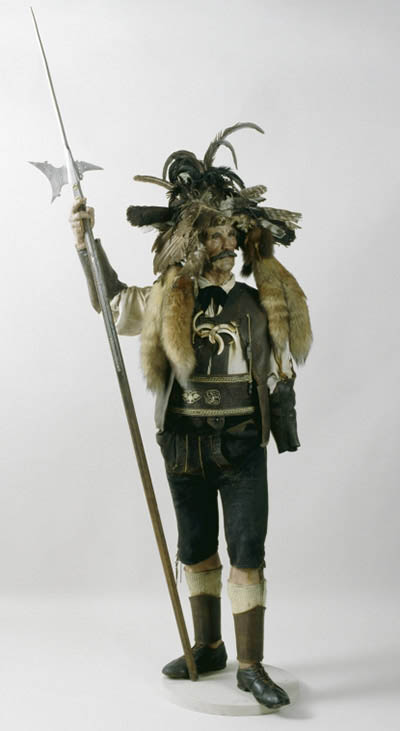
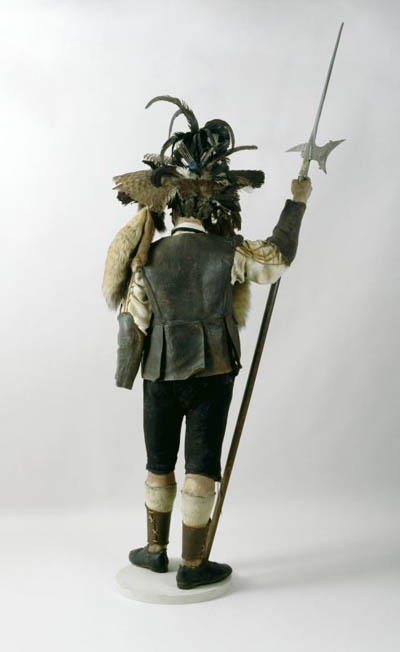
Fig. 1, 2: Meraner Saltner, Germanisches Nationalmuseum, 1875/1899 © Germanisches Nationalmuseum
In addition, there are other striking features of the costume. Apart from the hat, many handed down costumes of vineyard keepers look very similar to that of an outstanding Tyrolean folk hero. As to the beard, most vineyard keepers on contemporary pictures also come very close to Andreas Hofer, the leader of the Tyrolean popular uprising of 1809 (fig. 3). Thus, two hero constructions could be woven into the image of these objects: the brave guardian with supernatural powers and the defiant folk hero who successfully defended his country against the Bavarian occupiers (at least for a short time).
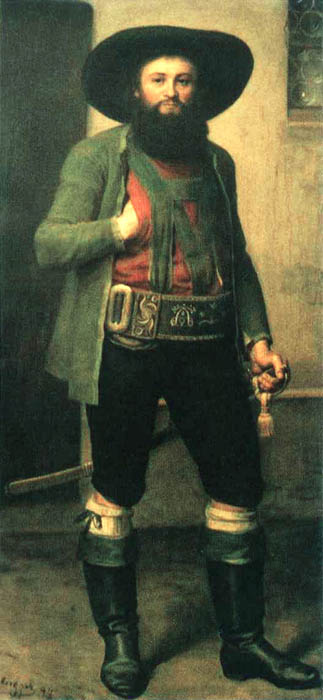
Fig. 3: Franz Defregger: Andreas Hofer, 1894, oil on canvas, Tiroler Kaiserjägermuseum, Innsbruck (© CC-BY-4.0 CC)
Tourist purposes in the course of 19th century
A steady evolution of this appearance towards hypertrophic splendor (cf. Ramming 1997, p. 119) could be observed. Whom did the vineyard keepers want to impress? Did the scary outfit or its models also have the function of a lure, even a courtship dress? One could speculate a lot about this, as well as the question of the addressees and the success of this posing in the rural environment. Indeed, there were harsh rules that state how vineyard keepers had to behave towards women (cf. von Hörmann 1872). Like the myths of nocturnal seduction attempts by witches in the vineyard, they also point to the possibility of their transgression (Matscher 1933, p. 217). The clearest indications of courtship even in the sexual are found indirectly where the vineyard keepers discovered their tourist attractiveness in the later 19th century. Here it was not only a matter of inspiring the exoticism expected from the outside. The Saltner in the role of „Papageno“ (Halbritter 2005, p. 88) offered a masculine performance to a changing — even female — audience, too. And the public, frightened by the wild man in the vineyard, gladly paid for this thrill with the usual, officially regulated tax for trespassing — and then sent a postcard with a picture of such a strange imposing guy out into the world (op. cit. p. 88-104, fig. 4).
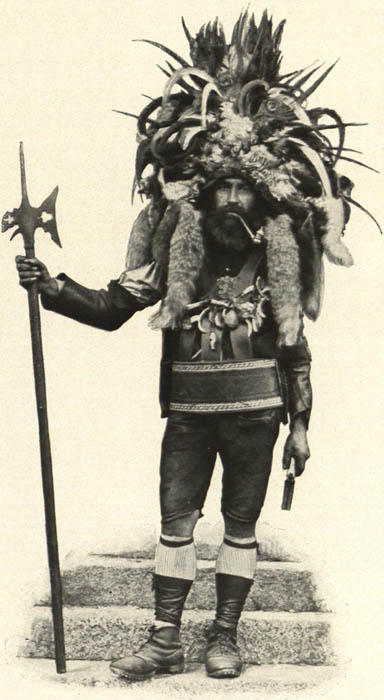
Fig. 4: Meraner Saltner. Postcard sent 1907. © CC-BY-4.0 austria-forum.org
Use in the attempt of nation building until after 1900
The emergence of traditional costumes in the 19th century was due to an increased interest in regional distinctiveness. The dependence on supra-regional trade, a corresponding desire for a special appearance and the burgeoning tourism in picturesque South Tyrol drove this development further. The purchase of the object by the GNM in 1899 was completely in line with the museum's historistic concept. Unique characteristics were to be collected to support the idea of nation-building in the German-speaking area which includes parts of South Tyrol (Austria till 1918, then Italy) too. The interest in the costume can thus be attributed to an implicit concept of „Großdeutschland“, the desire for identification even far beyond the national borders of that time (and also today). In 1905 the Saltner-figurine became a part of a multi-figure panorama of German traditional costumes in the museum. But 100 years later Jutta Zander-Seidel, curator of the exhibition „Kleiderwechsel“ (that means "change of clothes") at the GNM judged harshly about the former exhibition practice: Neither does the object represent the peasant costume of the past in its historical authenticity, nor does it reach beyond documents of historicized festive culture at that time (cf. Zander-Seidel 2002, p. 76).
From carnival use to cultural appropriation and appreciation
On top of that, the object wasn't even bought in South Tyrol at all, but from a Munich costume fund. The painter Franz Defregger is said to have worn it at a Munich artists' masked ball in 1883 (Ramming 1997, p. 16-18). Was it merely a product of his imagination, made to poke fun at the strangers across the near borders, at those archaic mountain people with their culture, which at the time was perceived as weird, backward, even exotic? There is evidence that Defregger designed costumes too (Irgens 2010, p. 14).
Then it would also be possible that parts of the costume were actually copied, e.g. by using early photographs of Native Americans, perhaps to make the appearance seem even more exotic. The foxtails hanging down on both sides of the face, the necklace of wild animal teeth or the splendor of the feathers come quite close to such cliché images. And Franz Defregger showed great interest in Chief Rocky Bear, for example, whom he met and portrayed in 1890. Rocky Bear had come to Munich (Bavaria) with Buffalo Bills' Wild West Show as a living exhibit (Assmann e.a. 2020, p. 123). But this was seven years after the masked ball. In addition, the object at the GNM is said to have been touched up in the early 20th century, so that it could fit the cliché of the pictorial and written sources of the 19th century even better (Selheim 2005, p. 274).
In the same supposedly colonialist view, Defregger made a painting for an Austrian encyclopedia called „Kronprinzenwerk“ (1885-1902, fig. 5). In this illustration, the figure of the Saltner is used just as clichéd and exoticizing for his country, Tyrol, as we know it, e.g. from images of snake charmers and the Indian subcontinent. But the picture shows a man who looks much like both the Nuremberg specimen – and the artist himself. Could this still be a form of self-exaltation, an act of othering (Said 1985)? If we take into account that Defregger himself was a native Tyrolean, this perspective escapes its chauvinistic dress and shows us a completely opposite form of individual expression and a corresponding search for identification: When abroad, the successful painter dressed like a person of status in his native country.
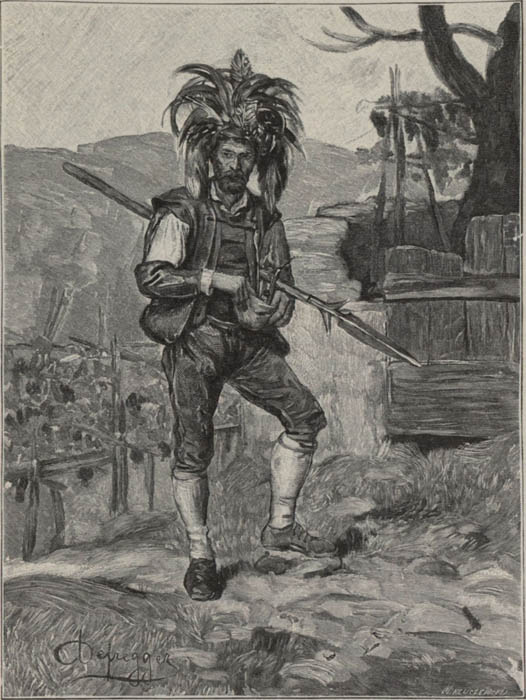
Fig. 5: Franz Defregger: Ein Saltner bei Meran. 1890, Xylography by M. Kluszewski. © CC-BY-4.0 austria-forum.org
Conclusion
It has taken one century for this change in function to be clearly named in the GNM (cf. Zander-Seidel 2002, p. 148): from an uncertain practical object of use to a product of tourist expectations, from a carnival costume to a decided construction of national identification and back again. The outfit of the vineyard keeper is neither particularly artistic nor valuable. But the questions it is able to generate lead far into a dense field of visual communication across times, national borders and continents, to ideas of foreignness and (self-) exoticization and ultimately to the question of how we deal with them today. The costume of the Saltner and its related outfits seem to come from the supposedly “good old time“. But they illuminate a rather fleeting moment in which historical upheavals in Europe (e.g. early globalization, increased emigration, advanced secularization, consequences of colonialism, desperate search for identity and nation building) are reflected in a peculiar object. They can lead to the question of how to deal with other traditions on the one hand or with the individualization of (male) appearance (e.g. in the later star cult) on the other. The fact that a whimsical hat can still serve an extremely dubious yet visually powerful purpose today was demonstrated by the million-fold shared footage of the self-proclaimed "shaman" storming the Washington Capitol in early 2021.
Special thanks to my students at Gymnasium Wendelstein who enriched this analysis with plenty of valuable questions and discoveries.
References
- Assmann, Peter/Irgens-Defregger, Angelika/Hess, Helmut. 2020. Defregger. Mythos — Missbrauch — Moderne. Innsbruck, München: Hirmer.
- Ramming, Jochen. 1997. Weinberghüter und Heimatwächter. Der ‚Meraner Saltner‘ zwischen Amt und Emblem. In: Jahrbuch für Volkskunde 20. Paderborn. München. Wien. Zürich: Schöningh. p. 116-141.
- Halbritter, Roland. 2005. Saltner – Weinberghüter – Touristenschreck – Vogelscheuche – Papageno – Alpenindianer. „Ihm gebe Kreizer a comprar tabacco; dann still sein gut Freund“. In: Der Schlern, Bozen. August edition 2005, p. 88-104.
- Irgens, Angelika. 2010. Was Tiroler und Indianer im Herzen verbindet, Bayerische Staatszeitung (BSZ). 23.04.2010 (ePaper) and: Unser Bayern 4/2010, München (Verlag Bayerische Staatszeitung)
- von Hörmann, Ludwig. 1872. Die Saltner. In: Der Alpenfreund, Monatshefte für Verbreitung von Alpenkunde unter Jung und Alt in populären Schilderungen aus dem Gesammtgebiet der Alpenwelt und mit praktischen Winken zur genußvollen Bereisung derselben. Dr. Eduard Amthor (ed.), Volume 5, Gera, p. 41-47, proofread for SAGEN.at by Mag. Renate Erhart, august 2005. Spelling carefully reworked and brought up to date: http://www.sagen.at/doku/hoermann_beitraege/saltner.html. Called on 7.02.2021
- Matscher, Hans. 1933. Der Burggräfler in Glaube und Sage. Bozen 1933. Found at sagen.at and carefully reworked by Leoni Wallner. December 2005. http://www.sagen.at/texte/sagen/italien/meran/burggraefler_matscher/wimmetzeit.htm. Called on 7.02.2021.
- Said, Edward. 1985. Orientalism: Western Conceptions of the Orient. London: Penguin Books.
- Selheim, Claudia. 2005. Die Entdeckung der Tracht um 1900. Die Sammlung Oskar Kling zur ländlichen Kleidung im Germanischen Nationalmuseum. Published by Germanisches Nationalmuseum Nürnberg.
- Zander-Seidel, Jutta (ed.). 2002. Kleiderwechsel. Frauen-, Männer- und Kinderkleidung des 18. bis 20. Jahrhunderts (Die Schausammlungen des Germanischen Nationalmuseums). Published by Germanisches Nationalmuseum Nürnberg.
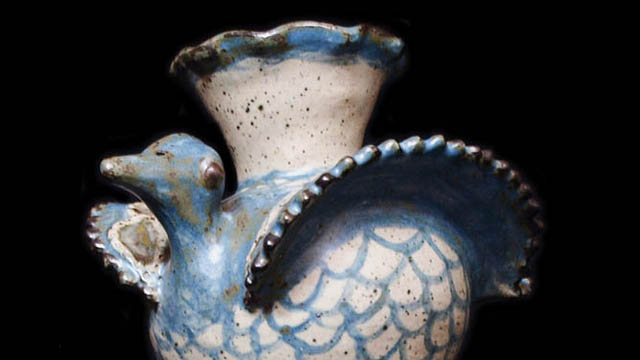
-
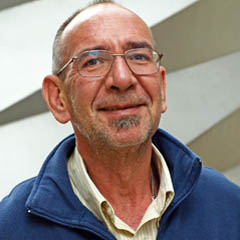 Ronnie Watt
Ronnie WattThe discriminatory apartheid politics in twentieth-century South Africa were designed to advance the political, social and economic empowerment of the white citizenry; the entrenchment of Western culture and values; to transform the black populace into a labour force and limit their education and training. Within that white supremacist dogma, black material culture’s only footing was its anthropological and ethnographic interest. The output of the pottery, weaving and print workshops of Rorke’s Drift came to stand in symbolic defiance of all of that.
Rorke’s Drift grew from the missionary work of the Evangelical Lutheran Church in South Africa’s KwaZulu-Natal Province Under the initial management of Peder and Ulla Gowenius who were recruited from Sweden, the centre was conceptualised for the training of black members of the local community to produce art and crafts as a means of self-support. The pottery workshop at the centre was established in 1968 by the Danish potter Peter Tyberg.
Whilst the Zulu culture is predominant in the province, it also accommodates other cultural groups. The majority of the initial group of women recruited for the pottery workshop belonged to the Sotho group and had the skills to produce utilitarian pottery for brewing, cooking and storage in traditional forms, decorated with applied motifs and incised elements (Fig 2).h The women were also familiar with traditional Zulu pottery forms in monochromatic colors (hues of black and brown) and decorative motifs that included pinched surfaces, geometric designs and raised linear coils. These were and continue to be produced with hand-building techniques and pit-firing.
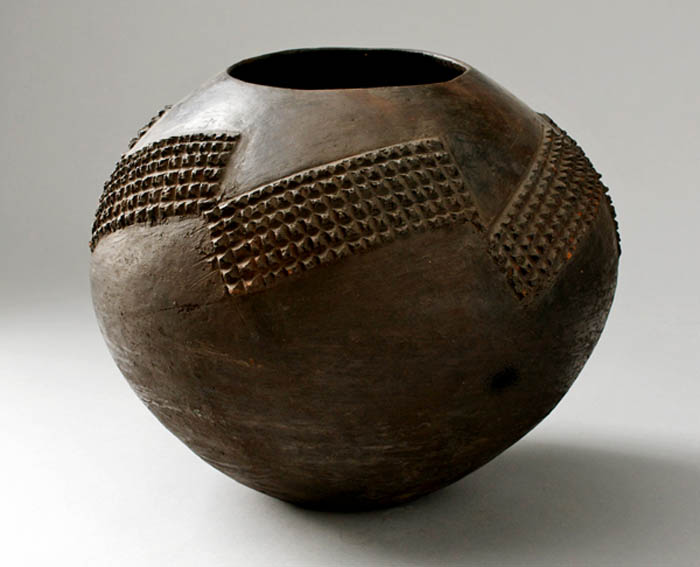
Figure 2
A traditional vessel (ukhamba) for the serving of beer in the Zulu culture, 1965, hand-built, burnished and decorated with applied raised designs (amasumpa), collected in Melmoth in KwaZulu-Natal Province, South Africa, 24 x 29 cm, Collection of Iziko Museums of South Africa, Cape Town, ©Michael Hall
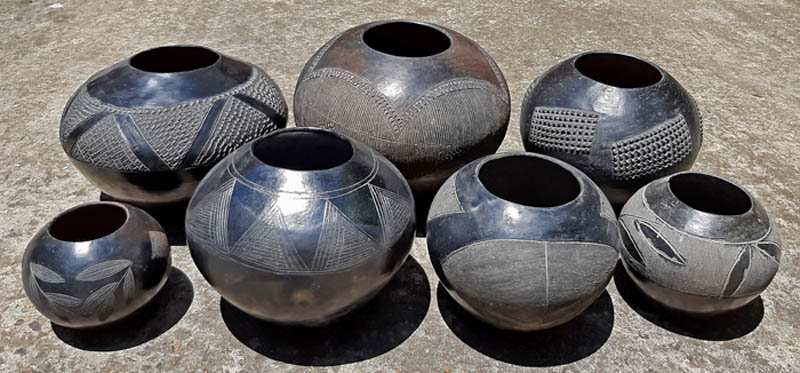
Figure 3
Traditional Zulu vessels collected in KwaZulu-Natal Province, South Africa, c.1990 to 1996, various potters, hand-built, burnished and decorated with incised and raised designs, Collection of Ian Garrett, ©Ian Garrett
The potters were introduced to Western production techniques, materials and kiln technology at the workshop. They were also shown books and magazines that exposed them to pottery forms outside of their culture and convention such as of Pueblo Indian and Nigerian pottery (Hosking, 2005, p. 33 and Gers, 2015, p. 268). It was the dictum of Rorke’s Drift to promote individual expression flowing from “an innate naivety and conceptualism” (Leeb-du Toit, 2012, p. 79) but the resulting works had to have appeal for Western consumers. In the pottery this culminated in a “composite globalised identity” (Hosking, 2005, p. 57) that married Scandinavian late-modernism and indigenous African knowledge systems. Freddie Motsamayi (2012, p. 24) described it bluntly as an example of an invented tradition in which new forms of African expression were produced for the benefit of Western patrons.
Whilst staying for the most part within the parameters of traditional Sotho and Zulu forms, the women potters created their versions of Western forms of bowls and vases and also vessels that approached sculptural forms or were distinctly sculptural forms. The decorations which referenced indigenous culture usually covered most of the surface and were applied as incised or built features and painting in layers of slips. The works became progressively more intricate and composite with richly painted and texturally decorated surfaces (Hosking, 2005, p. 96).
A new form that emerged in the workshop oeuvre was the “bird pot” introduced by Judith Mkhabela who worked in the studio during the 1970s. This was a pot with a pedestal base to which the head, wings and tail of a bird were added. Whether this form was Mkhabela’s own innovation is not a certain fact. It might have been modelled on the nineteenth century European hen-on-nest form (Maggs and Ward, 2011, pp. 155–156) that served as a container for fresh eggs. It is equally likely that the pot referenced two other indigenous cultural vessel forms, namely the bird-shaped earthenware vessels made by the South Sotho cultural group for possible use as water containers, water coolers or egg storage (Riep, 2011, p. 185) and the other being the totemic pig and elephant vessel forms made by the amaHlubi tribe associated with the Basotho cultural group (Garrett, 2020).Over the years this form was adapted by some of the other potters such as Elizabeth Mbatha (Fig 4).
Figure 4
Elizabeth Mbatha at work in the Rorke’s Drift pottery workshop in 2014, ©Ronnie Watt
Rorke’s Drift pottery was first . Two years later, the gallery acquired hand-built and thrown works from the studio for its permanent collection. This was significant for being the first ceramic works by black South African artists to be acquired for inclusion in a public collection during the apartheid era. The best of the pottery was selected to be sold in overseas outlets with Sweden and Germany as prime destinations. The potters set a precedent amongst South African black potters by signing their works on the feet of the pottery and further adding the date and kiln data alongside the leaf logo of Rorke’s Drift (Fig 5). This practice copied Western potters who identified their works with potter’s marks, signatures or monograms.
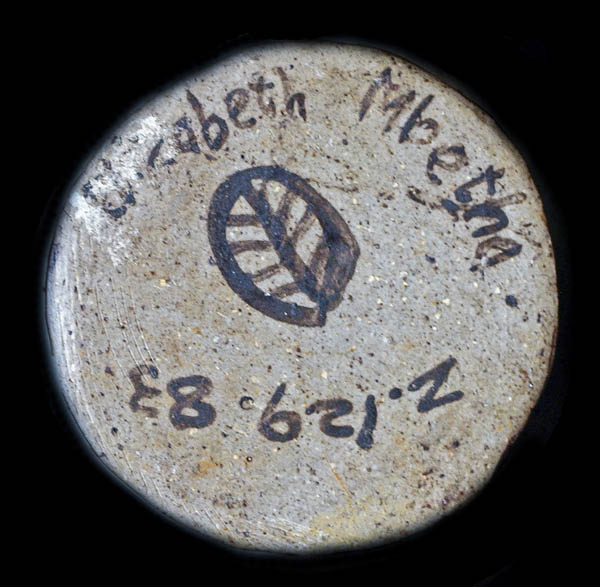
Figure 5
The foot of the double bird vase bears the name of the potter Elizabeth Mbatha [sic], the kiln data and the leaf-form logo of the Evangelical Lutheran Church Centre for Art and Craft at Rorke’s Drift, ©Ronnie Watt
As a collective and as individuals, the potters defied tradition and convention, Western perceptions and expectations of traditional pottery. The potters preserved elements of indigenous form and designs in their pots alongside the non-traditional features and sculptural appendages (Figs 6, 7). This illustrates the statement by the ceramics art historian Elizabeth Perrill (2008, [Sp]) that Indigenous Knowledge Systems (IKS) of materials, methods, forms and values are not monolithic and permit an expansion of innovative aesthetics within and as a continuation of a culture.
Figure 6
Lephina Molefe, Stacked vessel, 1980, hand-built and glaze-decorated reduction-fired stoneware, 26 x 17 cm, Evangelical Lutheran Church Centre for Art and Craft at Rorke’s Drift, South Africa, private collection, ©Ronnie Watt
Figure 7
Euriel Mbatha, Figurative vase, 1984, hand-built and glaze-decorated reduction-fired stoneware, 21 x 13 cm, Evangelical Lutheran Church Centre for Art and Craft at Rorke’s Drift, South Africa, Collection Minette Zaaiman, ©Ronnie Watt
The demand for Rorke’s Drift pottery started to wane in the 1990s for several reasons. Dealers and collectors broadened their interest to include the other indigenous potters who had since come to the fore. Problems with the management of the centre and financial constraints detracted from the promotion of the pottery and the recruitment of new potter talent. The quality of the pottery deteriorated after the introduction of commercial clay bodies and glazes and there was little variance in the forms and their decorations. The potters were no longer producing for the local and international collector market but had to produce works that met the expectations and budgets of tourists.
As “tourist art”, the twenty-first century pottery of the ELC Art and Craft Centre at Rorke’s Drift reveals forms and decoration intended to meet buyers’ tastes and budgets. The purposeful re-orientation towards the tourist market to tap into that source of revenue, is not a slur on the history, aesthetics or ethos of the studio. As in the earlier works, the more recent works illustrate an entanglement of the maker and the made, relevant to a new context of time and circumstance.
References
- Garret, IW. (2020). Personal correspondence.
- Gers, W. (2015). Scorched earth: 100 Years of Southern African pottery. Johannesburg: Jacana.
- Hosking, S. (2005). “Tradition and innovation: Rorke's Drift ceramics in the collection of the Durban Art Gallery, KwaZulu-Natal.” Unpublished MA (Fine Arts) dissertation. University of KwaZulu-Natal, Pietermaritzburg.
- Leeb-du Toit, J. (2012). Rorke’s Drift ceramic traditions in context. In J. Stretton (Ed.), All Fired Up: Conversations between storerooms and classrooms (pp. 77-81). Durban: Durban Art Gallery.
- Maggs, T. & Ward, V. (2011). Judith Mkhabela: An inspirational potter from KwaZulu-Natal. Southern African Humanities (23), September, 151–71.
- Motsamayi, MF. (2012). “The Bernstein Collection of Rorke’s Drift ceramics at the University of KwaZulu-Natal: A catalogue raisonné.” Unpublished MA (Art History) dissertation. University of KwaZulu-Natal, Pietermaritzburg.
- Perrill, E. (2008). Indigenous Knowledge Systems (IKS) & Zulu Ceramic Arts: Azolina MaMncube Ngema, One Woman’s Story. Interpreting Ceramics 10, [Sp]. Retrieved from www.interpretingceramics.com/issue010/articles/01.htm.
- Riep, DMM. (2011). “House of the Crocodile: south Sotho art and history in southern Africa.” Unpublished PhD thesis. University of Iowa, Iowa City. Retrieved from https://doi.org/10.17077/etd.0dzbhfvg.
published November 2020

-
 Ngugi Waweru
Ngugi WaweruPreparation in Nairobi
The Wakujuu collective (link) was invited to Documenta in 2022. The process that started from there has been long, not only to make the art work to be presented in Kassel, but also to become part of Lumbung, the concept the curators proposed. We went through a long process coming up with ideas, collecting materials, shaping it, discussing among ourselves as artists and also with the artistic team from the Lumbung Network. In addition, we decided, before we take our exhibition to Germany, we do it here in Nairobi to share it with our community, fellow artists and other people. Thus, we started local workshops with different people, artists, photographers, musicians and community members. These workshops led to a huge festival in the community in 2021 which was part of our offsite project for documenta, together with the exhibition we did in Nairobi. The idea was to share with our community what we bring to Kassel.

Workshop in Nairobi (Courtesy the artist)
It’s important to mention that in our collective, all individual artists have their own ideas. So, we started to look at the objective for the whole collective. We discussed and then we decided that every individual artist does his own artwork, but we discussed as a collective, supporting each other, giving ideas, criticizing.
Preparation in Kassel
When we came to Kassel, we brought some material with us and we found other material there. At the Documenta we were supported by a team. It was challenging, but still most enjoyable and it created a lot of learning.
For instance, we were excited to work together with Instar from Cuba, Britto-Arts Trust from Bangladesh and Wakali Wood from Uganda, as we were sharing the same spaces. The idea of Lumbung is sharing. And it doesn't matter what you're sharing: stories, food, materials or tools. We got to sit together and discuss also with Jatiwangi Art Factory. We lived like a family. And this is the most memorable thing that I will take with me forever, not only with the Lumbung members, but with the Kassel community. It's a thing you wish to repeat over and over.
When we were invited to come to Germany the first time in 2021, there were incidents of racism. And I started feeling I don't want to go to Europe. But this time it was different, apart from the antisemitism accusations that seemed to halt the whole event. Even with the German people with whom we worked at Documenta halle we just connected immediately; we just became family.
Our art works at documenta
The different artworks we made for Kassel had different themes, but all tackling what is happening in the world, not only in Mukuru slum (where we are based in Nairobi[1]). The world is one big village and we all have the same challenges that are affecting us as humans, like climate change, war, economic hardship, failed systems, pandemics and so on. When you look at the world, it's fragile, it's dangerous, and it’s not livable. Everything is tough. But there are also good stories.
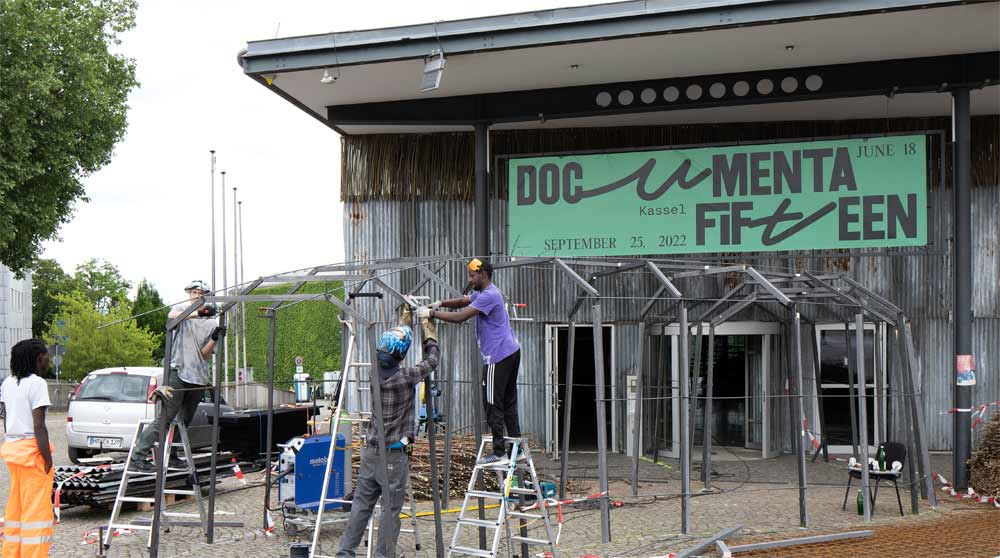
Construction of the tunnel in Kassel (Courtesy the artist)
The tunnel
For the entrance to Documenta Halle, where we exhibited our works, we used the corrugated iron sheets that the houses are made from in Mukuru. Our installation started with a tunnel, built by Kimathi Kaaria and Lazarus Tumbuti from our collective. You enter the tunnel and hear a sound. You go inside and you don't see anything. There is just darkness, and you hear this sound, recorded randomly in the streets in Mukuru.
The title of the installation is “Wakija Kwetu… ”. It is a Swahili name that means: “When they come to our home they get to know us better.” The sound is bringing you to Mukuru. The idea is to move you from Kassel to Mukuru and give the impression how it feels like to be in the streets there. And when you go inside, you see the corrugated iron sheets, you see the walls of our houses. You have this feeling of being in Mukuru.
Inside you are welcomed by three installations, ‘misingi wa nyumani’ by Joseph ‘Weche’ Waweru, ‘wrapped reality’ by Shabu Mwangi and ‘kahio kugi gatemaga o mwene’ done by Ngugi Waweru.
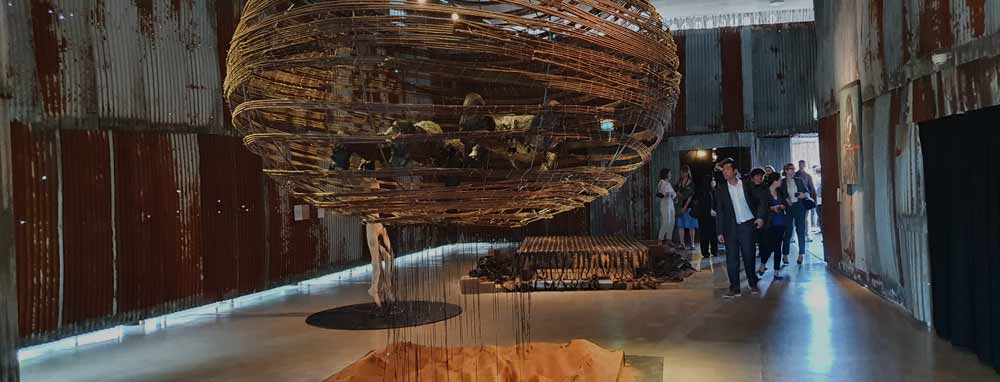
Inside the tunnel (Courtesy the artist)
Ngugi Waweru. Kahio kugi gatemaga o mwene. Used knives, motorbike chains, corrugated iron sheets. 2022
The situation of the world is the theme of my work “kahio kugi gatemaga o mwene”, in which I used old knives. I heard from many people, that the world is beautiful and brutal at the same time, it's scary. And I said to them: “Exactly, it's scary now to be in the world.” There was COVID, there is war, there is hunger - it's scary. It's like you are surrounded with death or illness.
 Ngugi Waweru. kahio kugi gatemaga o mwene. Used knives, motorbike chains, corrugated iron sheets. 2022 (Courtesy the artist. Photo Avi Sooful)
Ngugi Waweru. kahio kugi gatemaga o mwene. Used knives, motorbike chains, corrugated iron sheets. 2022 (Courtesy the artist. Photo Avi Sooful)My artistic process always starts in the brain and how I feel when observing the surrounding. For my Documenta work, I was studying those people who come to the community in Nairobi to sharpen knives for the butchers. I realized that they sharpen the knives over and over again until they are worn out. That led me to knives and I started collecting them long time ago. I didn't know what I will do with them. But, when we started talking in our collective about the exhibition, I came across a proverb: Kahio kuhiga muno gatemaga o mwene. It is a Kikuyu proverb that means “When a knife is too sharp, it cuts the owner.” I remembered that I had these sharp knives. This is how I came up with this idea of my art work for documenta fifteen.
In the older days before we were colonized proverbs were used to educate or warn people. In this case I used the proverb to warn people. This Kikuyu proverb warns against the possibility of being harmed by one’s own decisions. The human quest for advancement in various spheres (technology, education, religion, economies, or colonizing other planets, etc.) is also marked by a growing distance between people and the qualities that makes us human beings – our capacity for love, kindness, care, understanding, sharing, community. Just as a knife is eroded as it is sharpened repeatedly, so are we made less and less human by the actions we take to adapt and survive within our present society.
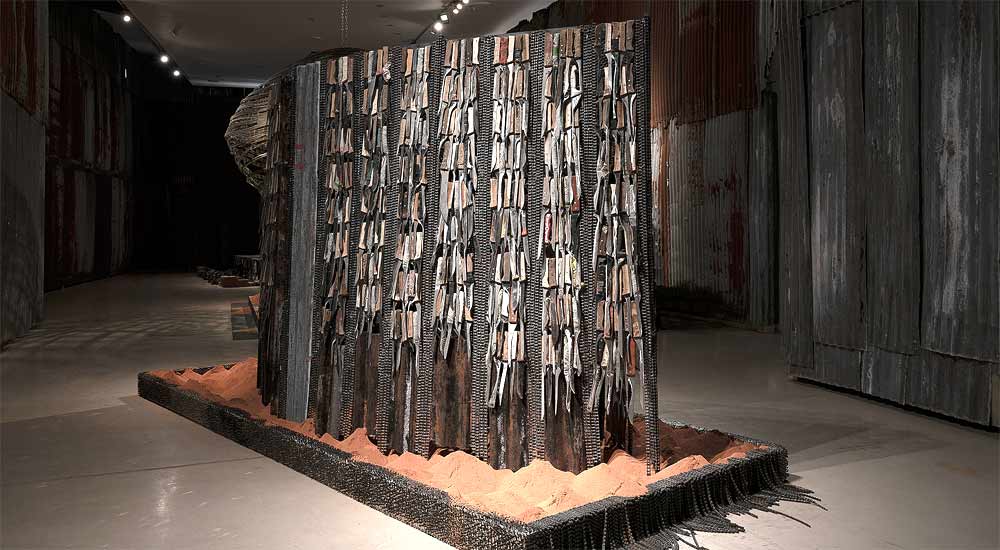
Ngugi Waweru. kahio kugi gatemaga o mwene. Used knives, motorbike chains, corrugated iron sheets. 2022 (Courtesy the artist. Photo G. Tenter)
Background
But we have also good stories, the Wajukuu story, our story, e.g.. This story is creating hope where there is no hope. Building community and togetherness. Sharing is what we are doing to solve our issues, as artists, as a community. The world can learn from us. It doesn't matter where you come from, it doesn't matter what you have or what you don't have: We all have challenges. We have to come together and find solutions.
Before the white man came to Africa, art was part of our life. When a child was born there was a ritual, a dance and a song to welcome the child into the family/community. In other traditions there was painting of the house. When the white man came, all of this was demonized. They forced us to start living their life. Even in school, we learn about Picasso or Leonardo da Vinci, but there were African artists whom we never heard from. They were masters, and the elders taught the young. Since we went through the white man’s education, art is defined according to the name. Now it's art, before it was our lifestyle.
When the colonizers came, they took away three most important things, our land, our freedom and our religion. When they left they gave back our land and some part of our freedom but they never gave back our altars. What the white man also left is capitalism. But, with capitalism there is no way to connect with our Gods and our planet. Capitalism creates appetite for profits. With this appetite we destroy our home, our earth in the quest for riches. The capitalism system all over the world is suppressing our spirituality, our creativity, and our being human. It's making people to be workers, not free people or free thinkers. It took millions of colonizers’ soldiers, hundreds of years to disconnect us from our true being and our true Gods. What we are doing as Wajukuu Artists is like a tear drop in the ocean, but we are able to ignite a spark that will connect us to our roots. Our role in the community is to ignite a spark of change and alternative way of thinking.
When we started to make art in Mukuru, the kids came where we were worked. At first we chased them away. But they would come again and again, because kids are attracted to the good things and art attracted them. After a few unsuccessful attempts to chase them away we decided to take them in. We realized if we don’t take and train them they will grow with the same vices we grew up with. For us, it's not about teaching them to be artists, but to create a platform for the kids to express themselves and give them an alternative education. We intend to find land to start practicing agriculture, teaching kids how to take care of the soil, to take care of the plants, the trees, and the environment, and also to reconnect with our spirituality, with our roots. This means, we teach kids our traditions. We also incorporate traditional dancers and traditional instruments in order for us to go back to our ways, not necessarily exactly, but to have a connection with our past.
published February 2025
 Johannes Kirschenmann
Johannes KirschenmannDocumenta
For over half a century, documenta in Kassel was considered the most important exhibition of contemporary art in Europe and beyond. It marked the respective current state of the art discourse in and for the Global North. The documenta in 2002, curated by the Nigerian-American Okwui Enwezor, corrected the existing narrow focus on art mainly from America and Europe for the first time.
Twenty years later, in 2022, documenta was curated (again for the first time) from the Global South and additionally by a collective: ruangrupa from Jakarta. ruangrupa organized this documenta under the theme “lumbung”, the Indonesian name for a shared rice barn. Applying the lumbung ideal to the art world means that artists and collectives should work together sharing knowledge, resources and ideas. Instead of the purely market-oriented art business, the exhibition should focus on social, ecological and economic sustainability. Thus, the curators did not only ask the artists to present artworks, but offered support for their collective work in the public space. This is one of the reasons why, in addition to the existing museum spaces, numerous other places such as old factories or churches in Kassel were included as shared spaces.
An outstanding example of the implementation of the Lumbung concept was the Wajukuu Art Project working in the slums of Nairobi. (Wajukuu is Kiswahili for grandchildren, or other relations of the second generation.) Wajukuu's installations at Documenta drew on used materials, furniture and everyday objects from the slums. In this way, they offered an aesthetic as well as socio-political examination of questions of identity:

Entrance to the Documenta Halle through Wajukuu's tunnel (Courtesy the artist)
Anyone who wanted to visit the documenta-Halle in Kassel, a modern hall with a glass façade built in 1992, first had to pass through an installation by Wajukuu: a tunnel-like, dark corridor made of corrugated iron, rusty Mabati, a building material commonly used in the Mukuru slum. “In reference to the vernacular architecture of Maasai housing, the meandering tunnel that contained the installations was covered by thin dark-brown reeds.” (https://www.textezurkunst.de/de/articles/eric-otieno-sumba-documenta-sell-the-vision/) The contrast between this noisy, dark scrapyard atmosphere and the light-flooded modernity and transparent rationality of the documenta hall could hardly be starker. In the tunnel, you could hear dogs barking, engines rattling and sirens wailing.
During the creation process two other worlds collided: “In a ‘Post Documenta Artist Talk’ (Link) on October 13, 2022, two members of the collective reported that it took some negotiation to obtain clearance to build the tunnel without professional architectural guidance. The artists convinced the two firms that had been commissioned for construction to allow the structure to be built outside of construction norms and standards.” https://www.textezurkunst.de/de/articles/eric-otieno-sumba-documenta-sell-the-vision/#id4

Inside the tunnel (Courtesy the artist)
At the far end of this tunnel, visitors (with their predominantly Western-influenced view) stood in front of enigmatic sculptures. These were again made from used materials from the slum. Together with videos on screens, they encouraged visitors to reflect on life in the slum and prompted speculation about their possible use and meaning. Soft materials, for example, formed a resting place in the size of a typical one-room dwelling (Joseph Waweru Wangui). Next to it was another installation by Shabu Mwangi: a mirror set in a bed of sand, with a cloud floating above it, a wickerwork of bent woods, with two human figures. Behind them emerged two half-arches, formed from used sharp knives: the work of Ngugi Waweru “Kahiu kogi gatemaga mwene” (“If a knife is too sharp, it will hurt the owner”).
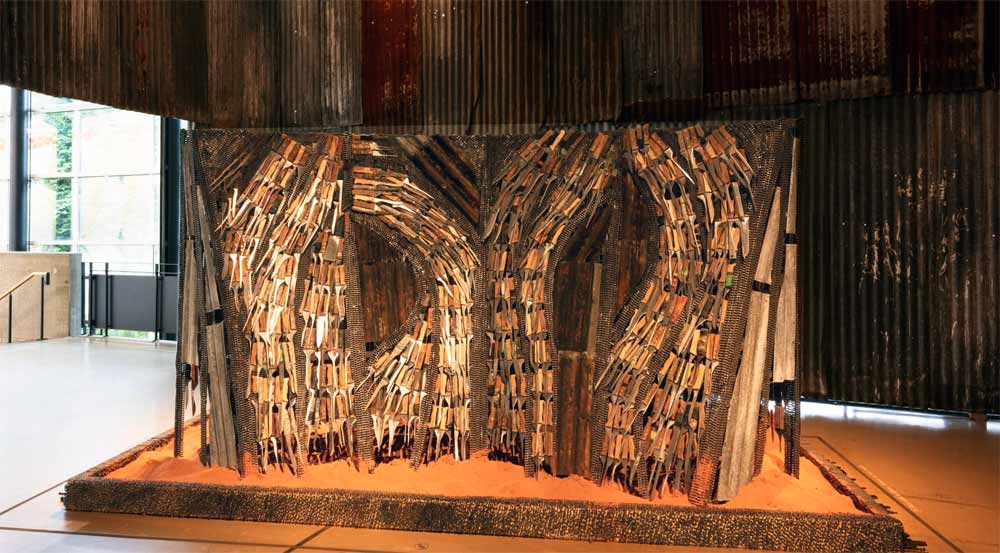
Ngugi Waweru. kahio kugi gatemaga o mwene. Used knives, motorbike chains, corrugated iron sheets. 2022 (Courtesy the artist. Photo Avi Sooful)
This work of art, which is not quite two meters high, stands in a basin filled with reddish, sandy earth - the edge of the basin is covered with motorcycle chains. On this "pedestal" is a construction made again of corrugated iron, which is covered with more motorcycle chains and, above all, sharp meat knives. In two large fields at the front, which are at a slight angle to each other, 'streams' of knives each frame a large opening in which the rusty corrugated metal construction is visible. For the viewer, it is above all the knives that make an impression. (They can also be found - less ornamentally arranged - on the back of the sculpture). This effect is certainly due to the fact that - as with El Anatsui e.g. - their ornamentation and the glitter of the flashing blades unfold their splendor from a reduced colorfulness. A splendor, however, which - with the narrow, long blades - is quickly associated with violence and destruction, torture and death, threat and power.
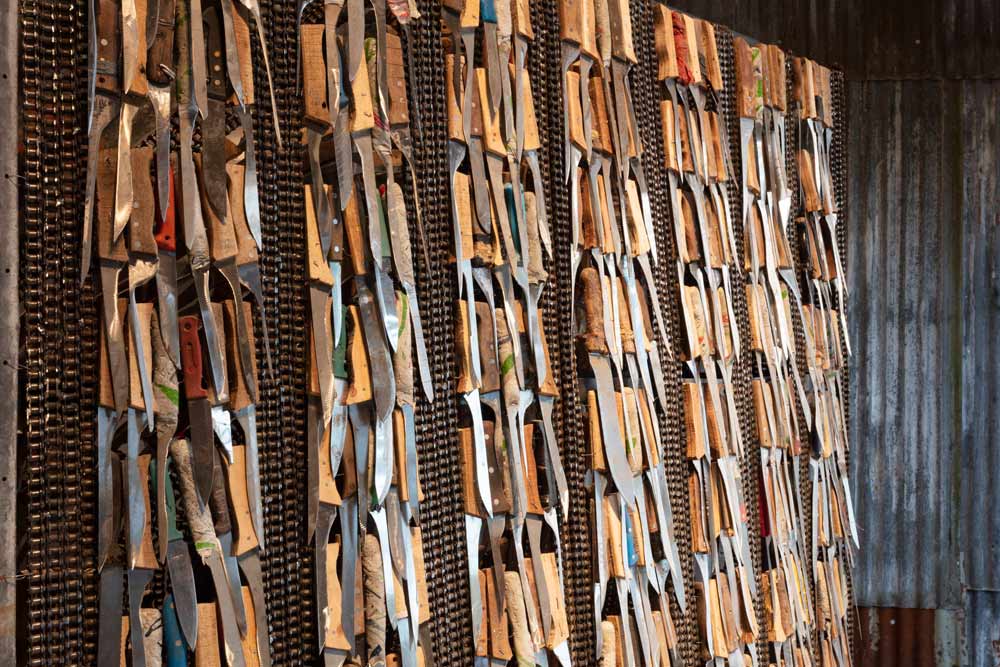
Ngugi Waweru. kahio kugi gatemaga o mwene. Backside (Courtesy the artist. Photo Ernst Wagner)
In respect to these associations, images from European cultural memory come to mind, from Caravaggio's Beheading of Holofernes by Judith to Arman's "accumulations" with knives or Marina Abramović's performances. Immediate impact and these associations play together to steer a perception between beauty and threat - in the given context obviously a symbolic expression of the slum experience. This specific form of aestheticization has also been questioned by art critics: is the work about the authenticity of the real experience or does it not rather serve a certain cliché of African slums? (https://www.textezurkunst.de/de/articles/eric-otieno-sumba-documenta-sell-the-vision/)
However one decides, the impression of the work that it leaves behind remains, for which its artistic quality (according to the standards of the Global North) is decisive: it is visually striking, formally consistent and coherent, it draws on familiar aesthetics while at the same time is innovating, and it remains open for interpretation, the viewer is invited to. This artistic quality was certainly also decisive in Wajukuu being awarded the Arnold Bode Prize in 2022, a prize that is awarded every two years by the city of Kassel to outstanding contemporary artists. The concept of creation, the relationship between the work and its anchoring in the social process in the slum was certainly a decisive factor as well. Thua, the jury of the Bode Prize has also honored an important social project and acknowledged the work to improve living conditions in the slum.
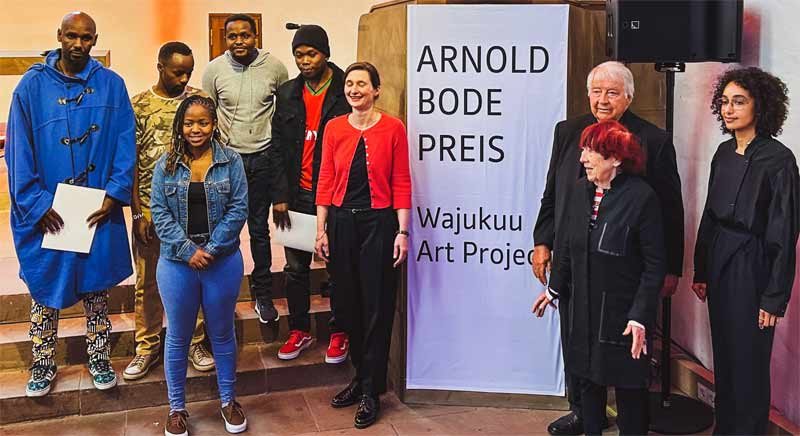
Award ceremony in Kassel 2022 (Courtesy the artist)
With the awarding of the prize, all the voices that did not see "l'art pour l'art" thinking in the Wajukuu Project, but rather the will to change something in the reality of life with the help of art, were heard once again. "The Art Project uses art to create a future that shapes and improves the path for the next generation. Art forms the core of Wajukuu, not just as a practice, but as a way of life with tangible implications in the lives of its community." (Ann Mbuti: From beginnings. Laudation for the award of the Arnold Bode Prize 2022; source of the text: Cultural Office of the City of Kassel)
Finally, the city of Kassel purchased this particular work by Ngugi Waweru, "Kahiu kogi gatemaga mwene", for its collection in the Neue Galerie (https://www.kassel.de/buerger/kunst_und_kultur/documenta/index.php). Now, it is isolated as a single work by a single artist, which was originally a contribution to a group presentation of a collective and which (together with the corrugated iron tunnel) was perceived as a unit. The transfer of the sculpture to the museum thus raises questions about the loss of context and the resulting transformation of meaning: Collective art practice and social commitment become (another) work of art in a museum, which at best still documents the Lumbung approach of 2022. Without context, without informative videos about the artists' work, without the other sculptures by the Wajukuu artists, we are confronted with an aesthetic object that continues to fascinate, but has lost an important dimension, its context.
Accordingly, the interpretations of Waweru's now solitary sculpture were strangely sparse. The title of his work was interpreted in all publications as a warning to people in a meritocratic and consumer society, according to Ann Mbuti in her tribute at the award ceremony. Not a word about the sculpture itself, its materials, its atmosphere and effect. Not the question of what we see and feel. Arnold Bode, the ingenious stager of modern art, would also have awarded the prize to Wajukuu, but he would have strongly objected to the isolated presentation of Waweru's sculpture after the documenta.Published February 2025

-
 Amanda du Preez
Amanda du PreezThe first selfie selected is taken by a reporter Yuzrig Meyer who reported for the Bushradio blog and is taken in Cape Town with students congregating in the background. The second selected image is taken by Michelle Gumede for the student paper Wits Vuvuzela of a student of the University of Witwatersrand (Johannesburg) enrolling in January 2016, while the university campus is locked down by security guards and police officers after bloody clashes between students and police.
The two selfies should be differentiated as the first image is an actual selfie (image maker and taker are the same person) while the second is an image of a selfie-taker (Image maker differs from image taker). In the first image the direction boards towards CPUT CT (Cape Town University of Technology) campus, and the Damelin building (Private Tertiary Training Institution) in the background are clear indicators of its location. The selfie-taker is visible in the righthand side of the image forming a montage by merging his own image with that of the protestors in the background. The second selfie-taker is wearing a T-Shirt with the slogan #FeesMustFall while making a typical selfie ‘duckface’ with the security guards looking on in the background. She is provoking the security guards by asserting her presence as a protestor in their midst.The two images are selected to engage with the growing selfie scholarship also in the field of image studies. The selfie has predecessors in the rich tradition of artists painting portraits and self-portraits, and then democratized further with the invention of photography as a means of self-expression to include a broader audience and artistry. Until finally in the contemporary moment anyone with a smartphone can create a self-portrait or rather, take a selfie. The two images sampled here showcase the expressive and participatory possibilities of selfies as voicing dissent against the powers that be on the one hand, and on the other hand, showing solidarity with those uprising. As such they form part of a new visual activism that is created via online participation and images.
Interpretation(s):
The selfie is notorious for its insertion of the human subject into the digital sphere that appear ubiquitously on social media platforms. More than any other mediating technology the front-facing smartphone has enabled the human subject to create and capture images of the self as never before. The immediacy and the circulation of selfies are extraordinary.
Depictions of the self is however not a new venture within the history of images, in fact, any reflective surface has sufficed as a tool for creating self-images in the past. Most notably the mirror which shares an intimate relationship and history with self-portraiture and self-representation. The progenitor of the selfie can probably be found in Andy Warhol’s self-portraits taken in photo booths (circa 1964-1965). The selfie that became a substantial category on its own since 2012 and 2013 has elevated self-expression to a new level. The two selfies collected here fall within the insertion of agency within the image, as both photographers insert themselves and their subjects within political events. In the first selfie, the creator can only be seen in the bottom half of the image so that the world behind him becomes visible. In the second selfie, the photographer also puts the selfie-taker on display surrounded by an environment of contestation. The images state: look at me but even more importantly, look over my shoulder at the world behind me. I am a witness to these events, and by sharing this image with you, you are also now becoming complicit and a witness to the event. It is a calling forth of a visible agency.
The attempt of the artists to show his or her witnessing of an event – being there – is also not a new endeavour in the history of images. We are reminded of Jan van Eyck’s (1390-1441) signature and presence left in the small mirror in The Arnolfini Portrait (1434), and later Diego Velázquez’s (1599-1660) mocking presence in the company of royalty in Las Meninas (1656). In all these instances, the artists insert or interject themselves into the picture plane. In the case of Ernst Ludwig Kirchner’s (1880–1938) Self-Portrait as Soldier (1915) we see the artist inserting himself into the horrors of war, with an arm lost (although only imaginary), trying to work through the aftermaths of terror. Granted it is not the same interjection we see as in the case of the selfies but one may argue that something of that tradition of witnessing, making present, announcing an event is already born in these earlier examples from Western art history.
The selfies selected here as part of the #FeesMustFall events testify to being present to a historical event and also to being interpellated into the activities. Interpellation as used by the French Marxist philosopher, Louis Althusser shows the status of the individual as always already being a subject subjugated in terms of power and ideology. The selfie makes that power hegemony visible as the subject negotiates his or her status apropos the powerful and ideological hegemony. There is an awareness in the #FeesMustFall selfie that not only bears witness to the riotous event but also positions the self in a particular participatory and supportive position towards what is happening. As Yuzrig Meyer euphorically states about his participatory #FeesMustFall selfie: “I may not have been around in the apartheid era in freedom struggle as an active participator, but from my experience of today I (sic) may have a better understanding to what it was like to be in the atmosphere of passionate comrades and the feeling of camaraderie in the air.” It is both an act of uncovering how power works, by making power visible, especially in the second selfie, and showing solidarity with the riots by inserting the face of selfie-taker as a montage onto the events in the background, as in the case of the first selfie.
These two selfies could also be interpreted as decolonising images as they disrupt what can be considered to be colonizing powers and assert themselves as agents of what Nicholas Mirzoeff (2011) terms “the right to look” and moreover, asserting “the right to be seen”. These two images refuse to look the other way by pretending nothing is happening. Instead, they inject themselves into the event and confront us as viewers with their message.
Discussion of the interpretations:
If we accept the interpretation that these two selected examples of selfies create a new decolonized agency by inserting themselves as both witness and participant of the #FeesMustFall events, it can be suggested that selfies allow for an expansion to the gamut of the traditional self-portrait. The contribution or democratic expansion of the selfie to the history of self-portraiture can be identified in at least the following three categories, namely skills required, immediacy, and generating a broader reach expanding the self-portrait genre. These three categories are not exhaustive but add to the meanings attributed to the two #FeesMustFall selfies.
In the case of skills, one does not require much talent or particular artistic skill to take a selfie. Where the self-portrait traditionally required set skills in the medium utilized for creating the self-portrait, whether painting, sculpture, etching or photography, the artists had to master basic techniques. This is not the case for producing a selfie. One merely requires a front-facing smartphone and the willingness to share in order to create a selfie. In this respect the selfie can be interpreted as a democratizing tool.
Similarly, whereas the creation of a traditional self-portrait mostly implied time (duration) and space for the artwork to be executed and to be exhibited, the selfie can be immediately uploaded online and shared. The selfie also potentially has a far broader reach than the traditional self-portrait as it can be viewed by hundreds (conservatively estimated) of viewers immediately after being shared. The selfie thus further democratizes the self-portrait by being available instantly and anywhere. The selfie is not bounded by time or place and space, as is the traditional self-portrait – it crafts a tele-presence.
Although, like all images the selfie is a complex and multi-layered occurrence and therefore not all selfies produced can be considered as democratizing and destabilizing agents. What is however accurate for most selfies is that they expand the genre of self-portraiture in significant ways.
published November 2019
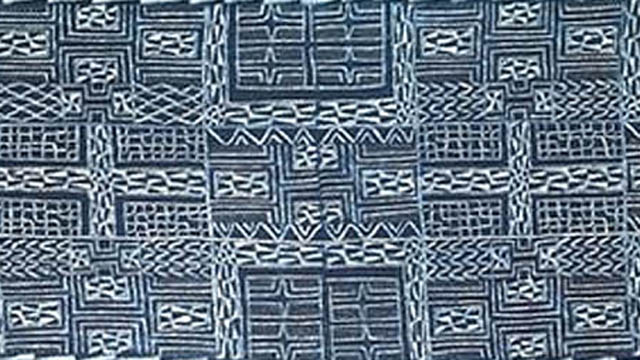
-
 Osuanyi Quaicoo Essel
Osuanyi Quaicoo EsselIn my encounter with the exhibits of the Permanent Exhibition of the African Collection in the Museum Fünf Kontinente, one of the African textile collections that striked me from a distance, and possess high tendency of inviting viewers attention is the ndop fabric. I moved closer to the exhibit to observe its uniqueness in terms of its structural and surface characteristics. From my curious observation, I realised that the ndop fabric has simple geometrical linearity and patterns, yet, spiced with complex dynamism of the arrangements of these patterns that evoke the artistic principles of variety, harmony and technical constrast. This treatment breaks monotony and creates multi-sectional visual interest in the fabric design despite its monochromatic colouration. These observable details, characteristic of authentic African fabric, pulled my visual curiosity to the exhibit. Indeed, it is an epitome of authentic African fabric.
Africans had long developed unique structural and surface decorative techniques for creating fabrics. Structural decorative techniques concern itself with the basic forming or construction of the fabric. Weaving, bonding, netting, lacing and felting include the structural decorative technique. Surface decorative techniques deal with the colourations and other embellishments to improve the surface quality or appearance of the fabric. Examples are dyeing, painting, printing, embroidery and applique. The ndop fabric was struturally woven with handspun cotton yarns in plain weave format in the form of stripes. The stripes were joined together with the aid of a needle to form a wide sheet of fabric after which the sheet of fabric was subjected to resist dyeing to create attractive patterns. In resist dyeing, portion of the fabric are prevented from dye absorption. Techniques used in resisting dye penetration include tying, tritiking (sewing), waxing, folding, twisting and coiling, and or a combination of these techniques. In the case of the ndop fabric, tritiking technique was used where raffia fibre cordage was used to stitch the desired patterns such that it could resist dye penetration after which the fabric was immersed into indigo dye solution locally extracted from plants. After the required time for dyeing, the fabric was removed from the dyebath, rinsed, dried and unstitched to reveal the patterns.
The skilful use of regular geometry in seemingly irregular and asymmetric arrangement style complemented by the handmade rendition, the technical finesse in stitching to create the intricate pattern and the entire arrangement of the geometrical shapes in simple repetitive format create high visual appeal of the surface quality of the fabric. Per its visuality, one may see it as a printed fabric, yet, it was created using resist dyeing effect. The slight unevenness in the dye absorption resulting in patchy shades of the indigo at certain portions of the fabric adds to its creative uniqueness. The varying border designs of the fabric bond well in creating a sense of unity in the entire composition.
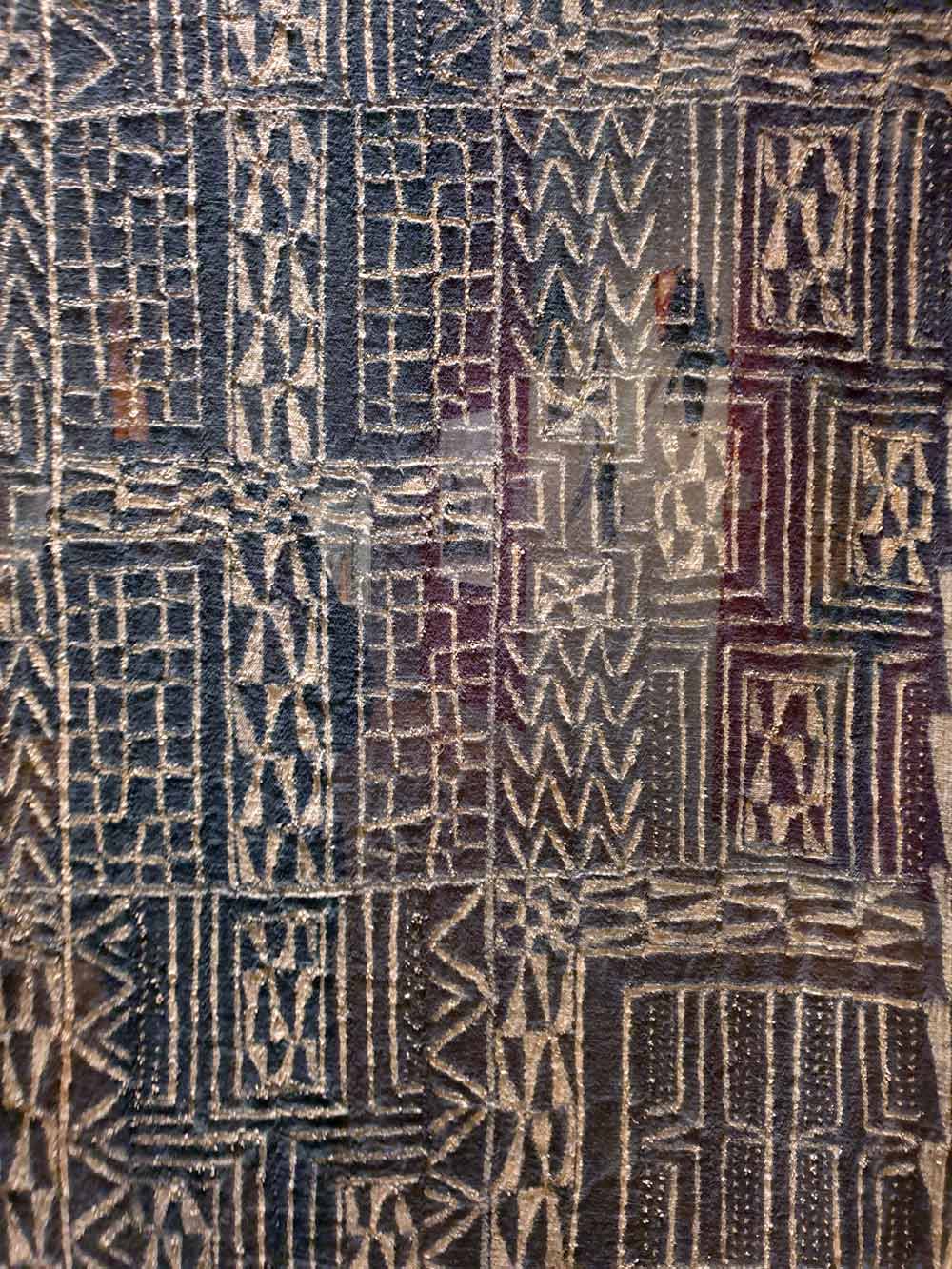
Ndop fabric. Detail. (© Museum Fünf Kontinente / Photo Ernst Wagner)
Besides the observable trenchant characteristics of the fabric, it also has social and cultural contexts in the Bamum society. The ndop is more than just a fabric in terms of its usage and communicative significance. The fabric is symbolically linked to death, afterlife, and powerful spirits connected to life. Consequently, it is worn during funerals and traditional religious rites. Apart from this, it is worn for its aesthetical reasons.
The ndop fabric falls within the repertoire of indigenous and authentic African fabric creation and decoration culture, which include the Korhogo Cloth (Ivory Coast), Adire (Nigeria), Bogolanfini (‘mud cloth’ from Mali), Kente and Adinkra (Ghana), Smock or fugu (Ghana) and Dogon Cloth. Common to these fabric printing technology of Africa is that the fabrics used are usually cotton, with ocassional usage of silk or velvet. In the case of Ghana, Adinkra printing is made with cutout stamps which are dipped into dyes and transferred on the fabric to register the designs while in Kente and fugu, the hand spun cotton yarns are dyed in different colours and used for weaving. The ndop is dyed. Availble records indicate that indigenous dyeing of fabrics in Ghana, in many instances, were done by uniform application of dyes to the entire fabric. This means that fabrics were immersed without resisting some portions. Kobene (brick red) and Birisi (blue-black) fabrics of the Asante people of Ghana are examples.
As a textiles and fashion educator and artist, I guide learners to examine the hand-made indigenous fabric decorative characteristics of Africa including the ndop fabric in order for them to understand and apply them in their fabric design. In this sense it inspires my fabric designs and that of my students. I also empower them through my teaching with historical knowledge about the contributions of Africa to the global textiles design culture. This is because the unique patterns and characteristics found in the repertoire of indigenous and authentic African fabric technological culture have been imitated with computer effects and printed by some European and Asiatic fabric brands, mostly sold in Central and West Africa. These foreign brands have been deceptively labelled with an umbrella term, African prints, to lure and deceive buyers. The ndop fabric has valuable educational relevance in teaching and learning and historical understanding of African fabric making technology in this context.

Presentation at the museum 2021 (Photo Ernst Wagner)
This article is part of a gallery: Perspectives from Ghana on Museum Objects in Germany. Published in January 2021
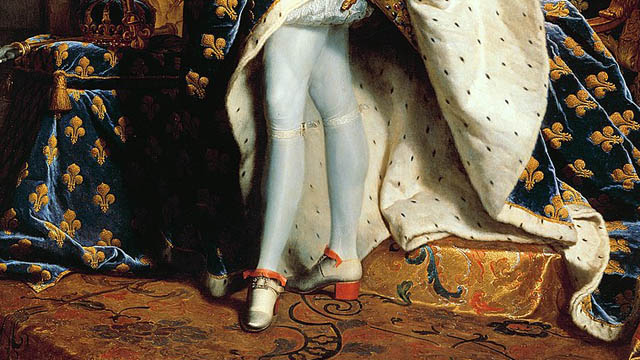
-
 Bea Lundt
Bea LundtLouis XIV (1638-1715), King of France, was painted by Hyacinthe Rigaud (1659-1743) in his palace in Versailles near Paris in 1701. The oil painting was larger than life: 277 cm in height and 194 cm in width. The official title reads: Portrait de Louis XIV en costume de sacre. The painting is exhibited at the Louvre in Paris (INV 7492, open access), and a copy is in the Bavarian State Painting Collection in Munich.
In this portrait, the king is shown dressed in the official royal robes of the monarch, posing magnificently in front of his throne, which is placed in the background. In the painting are gathered together all of the traditional symbols of a ruler: the crown, the sword, and the ermine cloak, which uses the fur of this most precious animal.
Hyacinthe Rigaud was a famous and experienced court painter and had many assistants in his big atelier, so we do not know which parts of the picture are actually done by him. Since photography was not yet established at the beginning of the 18th century, every court employed artists specialising in portraiture to show people what their ruler looked like, or rather how he was expected to look or wanted to be seen in order to legitimise a political programme of monarchy. Specific iconographic symbols and accoutrements were used to demonstrate the tradition of rulership, which was thought to be bestowed by divine right. Rigaud fulfilled the wishes and orders of his patrons, but he also showed subtle characteristics of the people he painted.
‘Absolutism’: Paradigm of a ruling structure that today is considered a myth
Nowadays, the portrait is often used for educational purposes to visually substantialise Louis XIV as the most important representative of ‘Absolutism’ in Europe, the regime of direct rule with no control by a parliament or council: ‘L’etat c’est moi’ (‘I am the state’), he is said to have described his understanding of his place in the world. Research has discovered that he never really defined his role in this way (first in Bernier, 1988, p. 110). However, it is true that he was attributed with the image of being the central part of nature and the cosmos: as the ‘Sun King’, he was staged as the genesis and focus of all energy whence all life originates.
Scholars of the early modern era (Henshall, Wrede, Reinhard) consider ‘Absolutism’ to be a myth constructed in the 19th century. Since Gerhard Oestreich observed the ‘non-absolutistic elements in absolutism’ in 1969, many studies have pointed out that the king depended on an influential elite as well as a number of committees. A complex and effective network of groups existed as the executive authority controlling the political system, as Althoff and Stollberg-Rilinger have shown in their groundbreaking books on the political organisation of the late medieval and early modern states in Europe. In their publications, they describe the ritualised methods used in communication between the influential groups in order to find a consensus. As result of that scholarly discussion of the topos of ‘Absolutism’, Wolfgang Reinhard, like other scholars, recommends, ‘that one should abandon the term’ (p. 40). But, as it is rooted quite deeply in the historical consciousness, this does not seem so simple. Martin Wrede complains in his article ‘Absolutismus’ in the handbook Enzyklopädie der Neuzeit of the continuation of the topos, namely ‘the cliché, still firmly anchored in popular views of history as well as in textbooks, of the all-dominant, all-regulating, arbitrary state built on princely power and with a splendid façade’ [‘das in populärem Geschichtsbild wie Schulbuch nach wie vor fest verankerte Klischee des alles beherrschenden, alles reglementierenden, auf fürstliche Macht gebauten Willkürstaates mit prachtvoller Fassade’] (p. 33).
The portraits of Louis XIV and other kings are used to prove the existence of this colourful glory, whilst in reality, the monarchs were representative figures and personal symbols. During Louis’s lifetime, France expanded its territory in Europe and overseas, which brought extreme losses and financial burdens to the people. Because of that disaster, it was necessary to produce a reputation of honour for the king.
Interpreting the portrait
The portrait shows Louis XIV at the age of 63, at the height of his success. But he does not appear as a strong and resolute ruler who travels around in his country, nor an active fighter who leads battles to defend his people. Pupils today always miss a specific physical ‘masculinity’ that they expect from a king They fault this person for not being able to move, run, or ride in his heavy clothes, high heels and white tights. He is forced to stay indoors, surrounded with sumptuousness. They perceive him as ‘feminine’, as the only part of his body he is presenting is his legs, much like a young woman in a miniskirt, and the grandiose wig with its long hair hinders many activities. The entire image seems ridiculous to today’s pupils. What we see here is an old, ill, vain man who is dressing up to fulfil representative duties. What pupils remark is not just some disrespectful observation but is in line with what we know about reality. Rigaud is a superb artist to show the man in his demonstration of the ritualised courtly pageant of luxury.
There are more paintings showing Louis at different phases of his life. As all royal children, he was kept in the same pretty clothes as girls during the first six years of his life. Portraits show him even at the age of ten with facial features and accessories we perceive as feminine and fanciful, not suited to preparing for the life of a strong ruler. The official regent for Louis until he turned 22 was his mother, Anna of Austria. Louis strengthened the Catholic church but did not follow her order of monogamy: besides his six legal children, he had eleven illegitimate ones, all of whom he cared for (Bernier, Tischer, Wrede).
The ideal of masculinity during this time was the mixed one of early modern times, when gender was more hybrid than in the 19th/20th centuries, and life concepts were not sharply polarised between men and women in different spaces, placing men in the public sphere (Dinges, Lundt). Also, the central symbolic figure for the state was not necessarily masculine; there were very influential wives, concubines, and even female rulers.
Conclusion
In the educational process, it is important to dismantle prejudices about past ideals for masculinity as being strong, powerful and heroic. The historic examples of individual men’s glorious performances on European thrones need to be questioned. Pictures like the one of Louis XIV can help to construct a different understanding of courtly life. If it is understood against the background of a plurality of life concepts for ruling men and women, it can help us to see the limitations of their power.
References
- Gerd Althoff: Rules and Rituals in Medieval Power Games, Brill Academic Publ. 2019.
- Olivier Bernier: Ludwig XIV Die Biographie, Albatros Verlag 1988. English edition: Louis XIV, New Word City 2018.
- Ida Blom, Catherine Hall, Karen Hagemann: Gendered Nations. Nationalisms and Gender Order in the Long Nineteenth Century, Bloomsbury 2000.
- Martin Dinges (ed.): Männer-Macht-Körper. Hegemoniale Männlichkeiten vom Mittelalter bis heute, Frankfurt am Main 2005.
- Karen Hagemann: Gender, War, and Politics: Transatlantic Perspectives 1775-1830, Palgrave Macmillan 2020.
- Nicholas Henshall: The Myth of Absolutism. Change and Continuity in Early Modern European Monarchy, London 1993 (first published in 1992).
- Bea Lundt: Die Grenzen des Heros. Vielfältige Männlichkeiten in Mittelalter und Früher Neuzeit. In: Martin Lücke (ed.): Helden in der Krise. Didaktische Blicke auf die Geschichte der Männlichkeiten, Berlin 2013, pp. 67-102.
- Gerhard Oestreich: Geist und Gestalt des Frühmodernen Staates, Duncker & Humblot-Verlag 1969.
- Wolfgang Reinhard: Geschichte des Modernen Staates, München 2007 (and elsewhere).
- Barbara Stollberg-Rilinger: Des Kaisers alte Kleider. Verfassungsgeschichte und Symbolsprache des Alten Reiches, C.H. Beck Verlag 2nd edition 2013.
- Anuschka Tischer: Ludwig XIV, Stuttgart 2016.
- Martin Wrede: Absolutismus. In: Enzyklopädie der Neuzeit vol. 1, Stuttgart 2005, cols. 24 -34.
- Martin Wrede: Ludwig XIV. Der Kriegsherr aus Versailles, Darmstadt 2015.
Translated from German by Kelly Thompson.
published September 2020
 Bea Lundt
Bea Lundt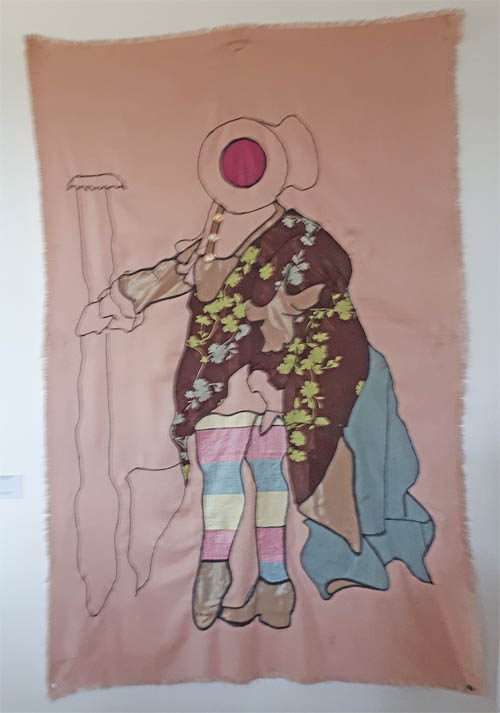 Prince Osei Owusu Bempah, from the exhibition "Orderly Disorderly" - End of Year Exhibition, KNUST (Kwame Nkrumah University of Science and Technology) in Kumasi, Ghana, Museum of Science and Technology in Accra, 2017, © Prince Osei Owusu Bempah
Prince Osei Owusu Bempah, from the exhibition "Orderly Disorderly" - End of Year Exhibition, KNUST (Kwame Nkrumah University of Science and Technology) in Kumasi, Ghana, Museum of Science and Technology in Accra, 2017, © Prince Osei Owusu BempahThe artist Prince Osei Owusu Bempah from Ghana artistically examines in two art works the portraits of Louis XIV (and below a typical European equestrian portrait of a ruler, like e.g. Charles V, painted by Titian 1548, today at the Prado Museum in Madrid). "Bempah appropriates historical images in the form of painting, sculpture and photography. Considering images as a multiplicity, he is now drawn to news from social media, television, radio and newspaper. Information is crucial to the making of his works which extends beyond the visual representations. He reinterprets them in tapestry, embroidery, banners and uses plastic sacks, curtain accessories, second hand table cloths and silk in different configurations. He substitutes certain elements of the original images with mortars and pestles" (leaflet of the exhibition).
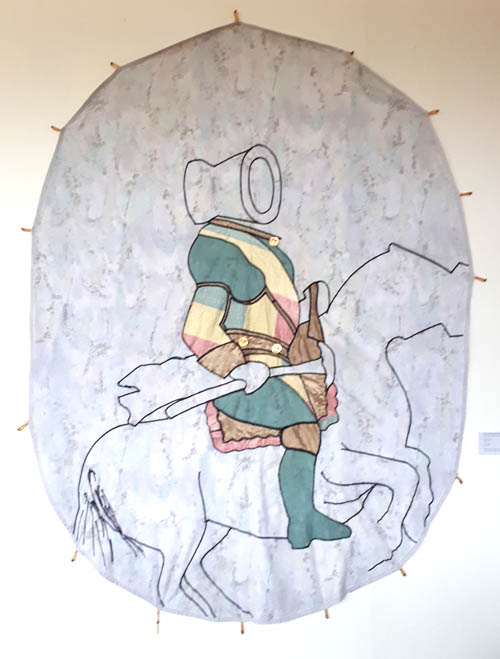
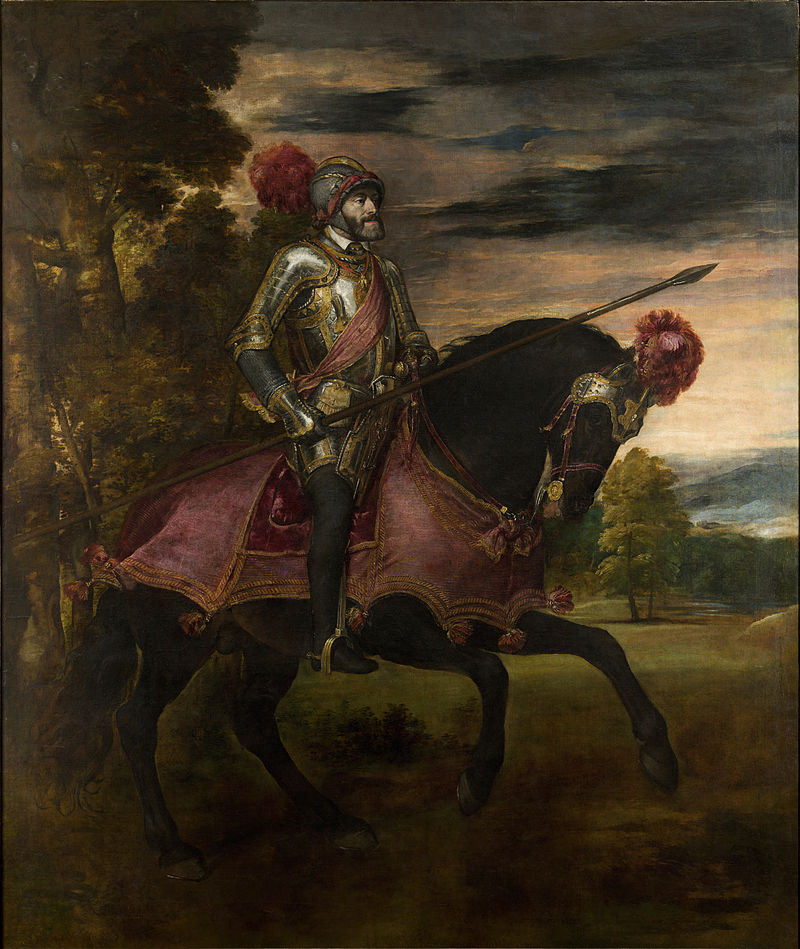
Image 1:Prince Osei Owusu Bempah, from the exhibition "Orderly Disorderly" - End of Year Exhibition, KNUST (Kwame Nkrumah University of Science and Technology) in Kumasi, Ghana, Museum of Science and Technology in Accra, 2017, © Prince Osei Owusu Bempah. (left)
Image 2: Tizian, Carlos V en Mühlberg, 1548, H: 335 cm, W: 283 cm, Oil on Canvas, Museo del Prade. (right)
published November 2020
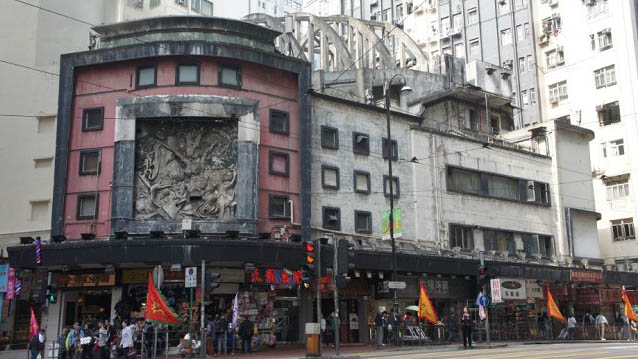
-
 Prudence Lau
Prudence LauState Theatre, originally named Empire Theatre, was opened in 1952. According to interviews with veterans from cultural circles, the Theatre was the “very origin of Hong Kong’s entry to the world of high arts” (South China Morning Post, Jan 11, 2017). It was Hong Kong’s cultural hub and only to be eclipsed by the City Hall that opened four years later in 1962. Located in North Point on Hong Kong Island, it was founded by a Russian-Jewish impresario Harry Odell, a legendary giant in the history of Hong Kong entertainment. Odell had started a film distribution company ‘Harry Oscar Odell’s Commonwealth Enterprises Corporation Ltd.’ in the post-war years and arranged for internationally acclaimed artists to perform in Hong Kong and in the theatre, including the late Taiwanese famous pop singer Teresa Teng, the late British tenor Peter Pears and Katherine Dunham’s Broadway dance company (South China Morning Post, March 2, 2016).
The Theatre was also a popular venue for live shows such as Chinese drama, opera and musical performances. The roof of the auditorium is suspended from external parabolic concrete roof trusses, which are exposed to the public and serves as a prominent feature and trademark of the building. This ingenious design also freed the auditorium from pillars and allowed for flexible internal arrangements. Designed by a Chinese architect S.F. Liu, the Theatre is moreover fronted by a large decorative relief panel with the artwork by renowned Lingnan artist Mui Yu-tin featuring the ancient Chinese tale of ‘The imperial warlord Dong Zhuo and the legendary beauty Diao Chan’. Together with the framed squared architraves and banded windows harmoniously fronting the elevation of the Theatre, there is a distinct Modernist and Art Deco quality to the whole building.In 1959, it was renamed State Theatre, and due to practical reasons the building has since then been converted into a theatre-cum-shopping complex, and a multi-storey block with shops, residential flats and a night club was opened in the adjacent site. The Theatre finally ceased to operate in 1997, and has today changed its use to a billiard centre with removable partitions sealing off the upper deck of the auditorium. The rest of the complex currently consists of a rundown shopping mall, still in function, and small residential flats.
In July 2015, a local property developer started to purchase various property rights within the State Theatre complex, and rumours of demolition and redevelopment of the site started to spread. Eventually, after substantial consolidated public efforts towards the Theatre, it was finally given a Grade 1 historic building status in March 2017. The State Theatre, narrowly escaping demolition, is only the third building after the Bank of China (built 1952) and the City Hall (built 1962) listed as a Grade 1 historic building in Hong Kong that is built after 1950, indicating a flaw in local heritage policy to value modern built heritage.
published January 2020
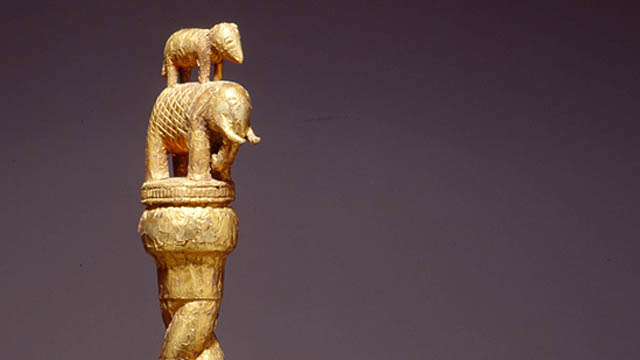
-
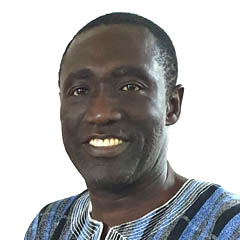 Yaw Sekyi-Baidoo
Yaw Sekyi-BaidooThe Akan linguist1 staff icon represents various aspects of the philosophy, values and symbolism of clan, town or ethnicity. The elephant icon, like other symbols of the Asante empire, is used in fabric and stool designs as well as the finial of the staff (Sarpong (1971:24), which is an important group formal identity symbol. Users of the staff include storytellers, clan linguists, and, most characteristically state linguists. Yankah has this to say about the state linguist staff:
“Every Akan chief or king has two or more staffs. The higher a chief’s status the wider the range of staffs, since and important chief deals with a greater variety of social and political situations and has to match various situations with relevant messages (1995: 33).”
The meaning and artistic significance of the finial of the linguist staff may be seen by considering the choice and artistic design of the finial, the identity of the user, and finally, the context in which the staff is used. The identity of the user, in this context, is the linguist of the King of Ashanti, a very powerful Akan monarch, whose influence and control is acknowledged over centuries and across different parts of Ghana.
The paper examines the motivations for the choice and representation of the Elephant-Calf symbol, and the overall cultural and social significance of the use of this symbol.
The Symbol in Context
Two aspects of the image might are important for our current discussion: the finial itself, and the upper shaft on which sits the base carrying the finial. The upper shaft consists of two veiny lines which with a wisdom knot in their middle. The next is the finial – Mother Elephant with its Calf Standing on it.
The choice of the elephant is based on the preeminence of the elephant as an animal. The elephant is universally used as a royal symbol of power and strength, and among the Akan of Ghana, Kwarteng (2006) reports that the paramount chiefs of Denkyira, Eguafo, Abura, Ajumako, Abeaze, Offinso, Wassa Amenfi have elephants as their royal symbol. The elephant is called ‘sono’ in Akan, and the morphological connection between the name and the Akan expression for immensity ‘so’ seems to emphasize the natural immensity of the elephant, which is also be expressed in the following:
‘Ɔson akyi nni aboa.’
(There is no animal beyond the elephant).
The leadership and protection associated with the elephant is represented in the saying:
'Wodi esono akyi a hasuo nya wo. '
(When you follow the elephant you are safe from the early morning dew of the bush)
The Akan see the immensity of the elephant from the social, political and spiritual perspective also. Socially, the flesh of the elephant is socially significant as it, unlike all other animals, provides meat for the whole community for an extended period. Politically, its parts, skin, ears and tusks are crucial aspects of the insignia of royalty. Again, spiritually, among animals, the elephant is seen to have the greatest ‘sasa’, a kind of spiritual force normally associated with humans. The ‘sasa’ is a spirit which protects its possessor through life and which assails its killers after its death. Sekyi-Baidoo (1994) reports of extensive activities for preventing the ‘sasa’ of the elephant from escaping from the carcass to assail its killer. Overall, the elephant stands for physical, spiritual and social preeminence among the Akan.
The Representation
The Upper Shaft
According some traditional consultants, the veiny lines, as seen above, represent the demands of the governance of the empire, which are controlled by the knot, symbolising the cohesion, control and direction of the Asantehene.
The Parent Elephant
The finial representation captures the side view of the elephant, showing major aspects of its immensity and power - the body, which showcases its immense size, the heavy legs, showing its matchless stability, strength and force; the trunk, with which it breathes, smells, grasps and lifts objects and produces sound; and the tusk, with which it digs, lifts, gathers, attacks and defends itself. The limbs and the trunk are presented in neutral posture: both feet firm on the ground and the trunk lowered – not picking anything nor blurting - suggesting placidity. On the other hand, the tusks, bigger than natural, are lifted, pointing to an ever-readiness - not to attack, but to defend. It is on this placid but defence-ready image of the elephant that the dependant calf is placed - for optimal comfort and security. It is explained that this image symbolizes the prosperous relationship between the Asantehene and the people over whom he rules - not intimidating them with his supreme power and authority, but ensuring their peace and security.
The Calf
Interestingly, unlike the elephant, the calf is presented panoramically - without the details of ears, tusk and trunk - its source of perception, control, nourishment and defence, for which it would depend on the mother. This is understood to symbolise the governance relationship in the Ashanti Kingdom where the subjects look to the Asantehene for intelligence, protection and support.
According to traditional informants, the elephant-calf image is sometimes interpreted as symbolizing the permanence of the supremacy of the Ashanti Empire - from 1701 to present – perhaps, unlike others powers which rise and fall.
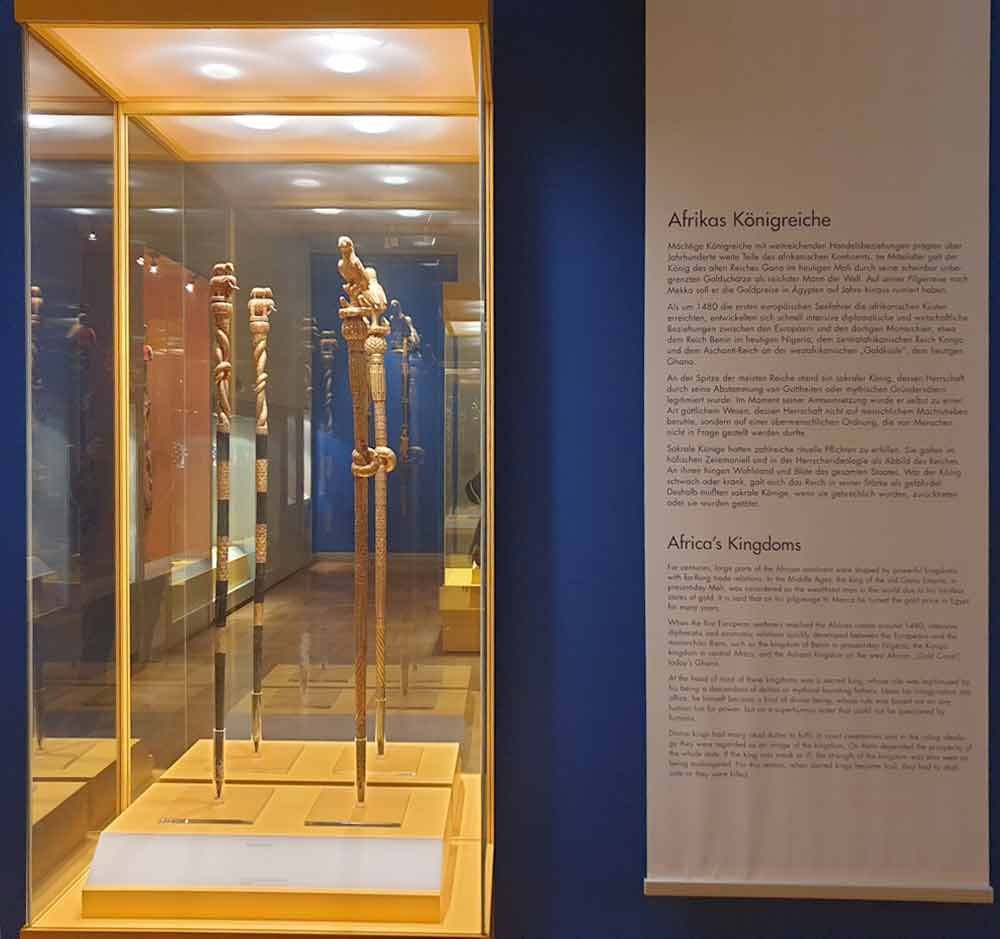
Significance
As intimated above, beyond its art and royal attraction, the elephant-calf image of the Ashanti royalty reflects ethnic and universal ideals of effective leadership, which is for cohesion and protection and, rather than for oppression. This is evident in the symbol of the wisdom knot and the image of the elephant carrying the calf. This education on the effective use of power is relevant to majority/minority and local as well as international rich/poor contexts. On the reverse, it also points to the Akan and universal idea of responsible followership - submission and trust, and is easily utilised for the education of children. The image, thus, represents an effective blend of governance, culture and education.
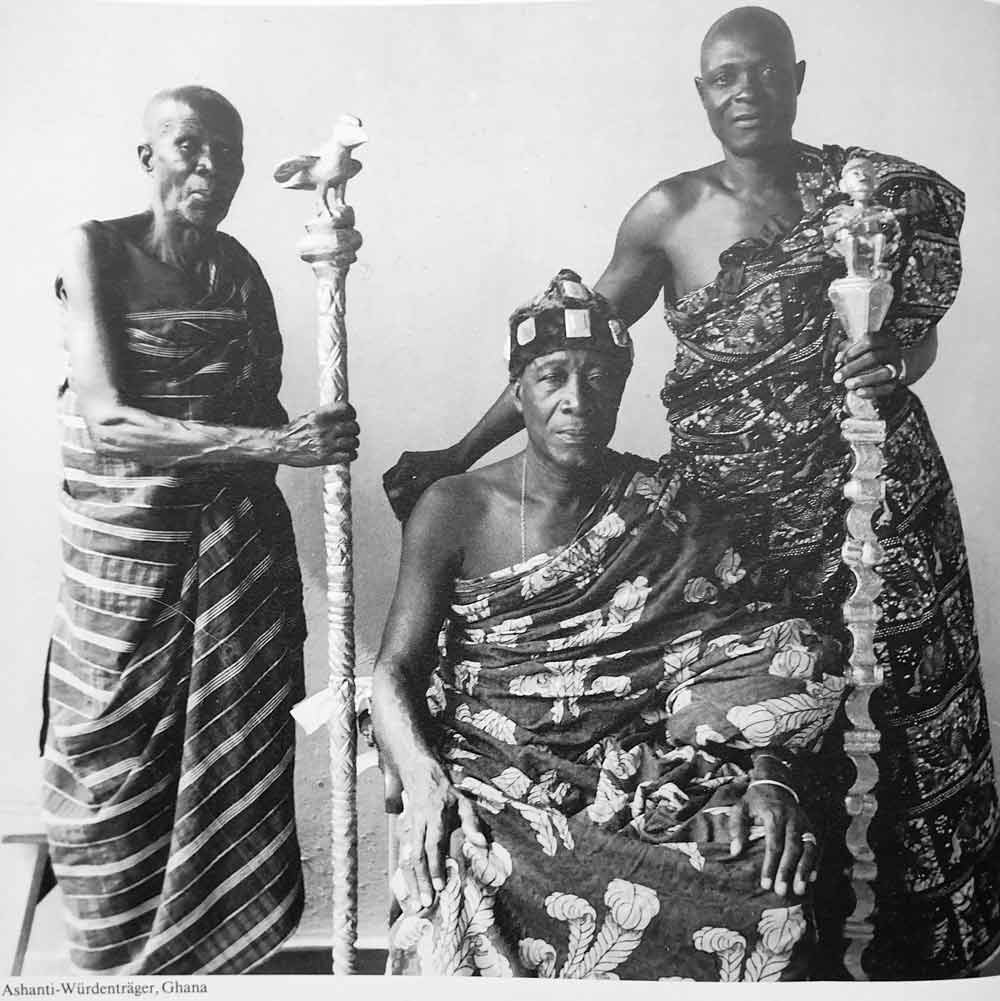
References
- Kwarteng, K. O. (2006). The elephant in pre-colonial Ghana: Cultural and economic use values. Journal of Philosophy and Culture, Vol. 3 (2) June 2006: 1 -32.
- Sarpong, P. (1971). The sacred stools of the Akan. Accra: Ghana Publishing.
- Sekyi-Baidoo, J. Y. (1994) The Aesthetic and cosmological features of the Akan hunters’ song. MPhil Dissertation, Institute of African Studies, University of Ghana, Legon
- Yankah, K. (1995). Speaking for the chief: Ȯkyeame and the politics of Akan royal oratory. Bloomington & Indianapolis: Indiana University Press.
Footnote:
1) The term „linguist“ has been adopted in Ghana for the Akan designation „Okyeame“ in an attempt to find an English equivalent for the role of the chief´s or king´s diplomacy attendant. This may have arisen out of the acknowledgement of the linguistic capabilities displayed by the attendants, whose main resource was language.
published January 2021
This article is part of a gallery: Perspectives from Ghana on Museum Objects in Germany
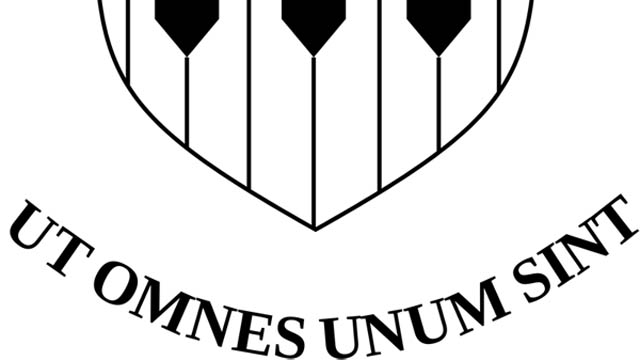
-
 Patrique deGraft-Yankson
Patrique deGraft-YanksonSchool crests, school logos or school emblems as they are variously referred to are a popular feature in the functions of all academic institutions in Ghana. They are normally designed to visually reflect the key ideologies and philosophies upon which educational institutions thrive. In determining a logo for academic institutions therefore, efforts are put in place to ensure that they serve an appreciable level of visual representativeness. By this, school logos in so many ways establish emotional connections with parents, students and other stakeholders, whose interpretations and perceptions determine their level of confidence and trust in the institutions.
This logo, by its very visual appeal, informed by the familiarity of the key compositional element and simplicity, generates a point for discussion. Moreover, the popularity and the history of Achimota College always makes it an important destination for various studies pertaining to senior high school education in Ghana. In my current interest in the study of icons and symbols therefore, the Achimota School crest comes handy, worthy and accessible.
The designer of the Achimota School crest is not really known as most of the literature on the school's history is silent on the subject. However, judging from the fact that the key concept behind the logo emanated from a popular quote from Dr Emmanuel Kwegyir Aggrey, the Old Achimota Association attributes both its origin and design to him (OAA, 1973). The creation of the Achimota School crest follows strictly the conventional crest design procedures which inform the design of several school crests in Ghana. It is composed of a classic narrow base shield, with the all-important motto of the school, ut omnes unum sint (Latin phrase meaning ‘that all may be one’), rendered in an arc form below the shield to provide a mantling and support of a sort to the design. In a rather minimalistic fashion, the key element of the design which also represents the main ideal of the school (the piano keyboard) has been rendered in amazing level of simplicity which makes it easy to perceive and reproduce by all graphic reproduction methods.
By this design process, the Achimota school logo offers a depth of meaning without being too literal in its composing elements. It has a pleasing contrast between dark and light, and connection to the existing school structures. Most importantly, the logo has sustained the semiotics and narratology which students, parent and stakeholders have always responded to since the establishment of the school.
It can be said that the logo of the Achimota college is more than a visual representation of the ideals of an educational institution. By mere consideration of the diversity in the caliber of people who masterminded its foundation, the school’s logo could indeed be described as the very foundation upon which the school was built. The logo seems to echo silently a belief that underscores the essence of peaceful coexistence of all manner of people, as exemplified in the collaboration of people of different colours from different parts of the world coming together to establish an institution of that caliber. It must be noted that the use of black and white keys of the piano to signify the harmony that comes along with peaceful co-existence of people of all races mean a lot more than anti-racial advocacy. It is obvious that Aggrey, drawing from his own experiences as a black young man who has been able to successfully attain the feats that could be equaled to what any white young man of his age could attain, was drawing the attention of the African youth to their own strength and capabilities. This is because Aggrey lived in a time when the “black man” looked up to the “white man” as an embodiment of all wisdom and custodian of all the goodies that mankind needed for their existence. The idea that he, as a black young man could attain a higher education just as the white man had not been very much considered. Aggrey making himself a case for the possibility of the black race mixing up perfectly with the white race to produce something good therefore seemed to be the underlining principle for the creation of the logo of the Achimota school.
The question of Aggrey creating this logo not for some cooperate body or a church is also an interesting factor to consider. As far back as 1924, Aggrey sought to established the efficacy of ‘education’ in the promulgation of ideals, principles and philosophies. This is deducible from the efforts he put in co-founding the Achimota College with Sir Frederick Gordon Guggisberg and Rev Alec Garden Fraser; opening up the college for both male and female; and ensuring that teachers were made up of blacks, whites, males, females. This indicates Dr Aggrey’s confidence in education as an important avenue for the promotion of peaceful co-existence and harmonious living. He believed strongly that quality education would contribute to balance and a peaceful society, and promote his conviction that ‘black keys of the piano give good sounds and the white keys give good sounds, but the combination of the two gives the best melody’. What a beautiful reason for all mankind to live as one!
Considering ongoing efforts towards the achievement of a coherent global community, as well as the premium laid on education as a single unit that can be used to achieve the sustainable development goals, it could be concluded that the relevance of the Achimota school logo is important today more than it has ever been. It therefore makes a whole world of sense to argue that the logo of the Achimota school could be considered as a strong icon for well-balanced education and a perfect advocate for education for sustainable development (ESD).
References
- Old Achimota Associstion (1973). Dr Aggrey. Retrieved August 3, 2020, from Retrieved 03 https://sites.google.com/site/oaa1973akoras/home/founders/dr-aggrey
- Wada, K. (2010). Achimota School. Retrieved August 3, 2020, from https://www.blackpast.org/global-african-history/achimota-college-achimota-school-1924/
published August 2020

-
 Joseph Essuman
Joseph EssumanChoosing this object stemmed from my experience I had when my mother passed away in my arms. It was a painful reminder of mum's death when I saw the facial expression of the object. The question was; ‘So after all the painful moments she went through, she could not stay a little longer for me to pamper her before she died’? I therefore want this to be part of the project so that the world would appreciate responsible mothers and motherhood no matter the circumstance.
To be a mother marks female social completion in Africa especially among Ghanaians where motherhood is a pride. Without it, one is not quite an adult, or certainly not an adult who receives full respect. Images of this nature, especially in most communities of Ghana are very significant because of the belief systems of the indigenous people before conversion to Christianity or Islam. Though not so common today as a result of modernization and or Christian and Muslim religion as compared to a decade or two ago, it is still believed that, regardless of the changes in time and technology, these beliefs are still as revered as it used to be.
This work is a wood carving in the round portraying a standing, heavily-pregnant woman with her left hand on the chin; but laid on the left breast with the right-hand providing support beneath her belly. The legs are bent at the knees and she has a painful facial expression.
It is a semi-abstract form of work that is 161cm high which stands firmly on a pedestal. The pose of the figure gives an idea of life and death. The opened wide mouth indicates the pain she must be going through and the hand beneath the belly indicates a support for the weighing pregnancy and support for the unborn child.
The concept behind this piece of work depicts strain and stress most women go through before giving birth and it symbolizes fertility and good health. The elongated breasts suggest the vulnerable state of the woman though it has lots of breast milk to feed the unborn child.
This carved image is a representation of a pregnant woman which signifies life. This figure could be interpreted to represent several ideas in different cultures. However, Costa (2019) opined that, a wooden figure of a nude pregnant woman, which has been present at events, is not the Virgin Mary, but a female figure representing life.
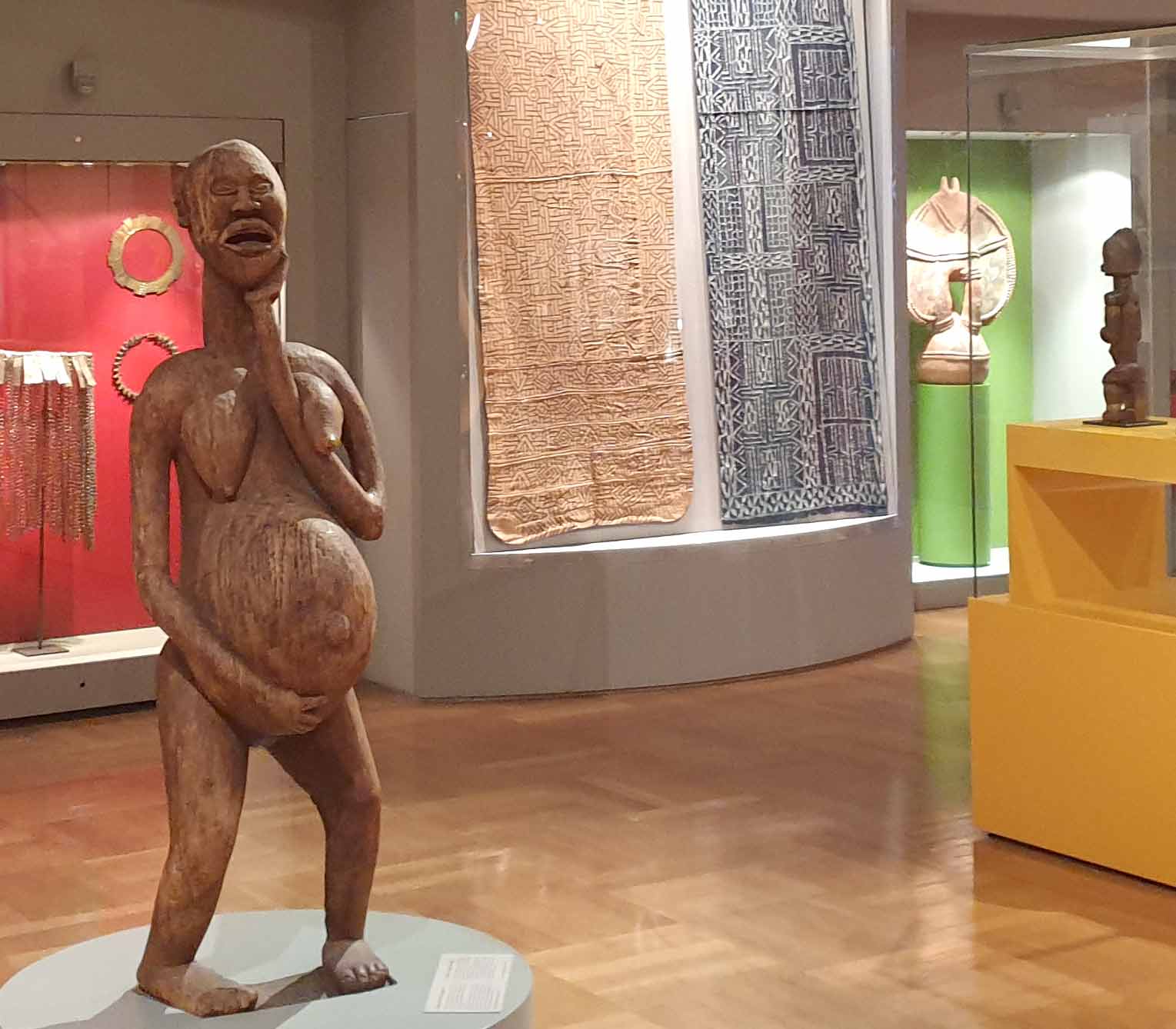
Anonymous artist, first half of the 20th century, wood, 161 cm, Bamileke, Cameroon (Photo Ernst Wagner)
In a similar narration, Costa (2019) said that, a wooden figure of a pregnant woman has been described as both a Marian image and as a traditional indigenous religious symbol of the goddess Pachamama, or Mother Earth. Costa maintained that it is an indigenous woman who represents life; it is a feminine figure and is neither pagan nor sacred but represents life through a woman.
Fundamentally, many indigenous Ghanaians believe that women are like trees that produce and reproduce to sustain life continuity. The woman is also believed to be a fertility goddess. It is with high esteem therefore that Ghanaian women who are capable of giving birth are exalted. As a result, these images or similar ones have been used to ‘serve’, particularly in the Akan and Ewe dominated communities in Ghana. They are seen as religious figures, an expression of health, fertility and grandmother goddesses, and they have over the years served as ritual or symbolic function.
Without children one cannot have a traditional funeral nor become an ancestor. While these issues relate to men as well as women, infertile men can acquire children through cooperative wives who ensure they become pregnant. Unfortunately, per the traditions of Ghana, women do not have that option. In practical terms, wives who are childless may be divorced or have to accept a co-wife. They have no support in their old age, if their husbands die, because that is the duty of children. In extreme cases, they are sometimes ejected from the husband’s house no matter their economic or social status and endure the pity or mockery of family members, friends, and acquaintances.
In most communities in Ghana, it is believed that babies born after a longed-for conception often bear names that reflect their mothers’ anxiety. For example, ‘Brenya’, which literally means “suffer and get” is such a name from the Akan people of Ghana. Also, ‘Nukomeko’, which literally means “I just laugh” is one of the names from the Anlo-Ewe of southern Ghana. These names are among many examples that reflect joy, triumph and satisfaction in a successful delivery after the pain of barrenness. Other names pointedly refer to previous distress and are meant as retorts to those who might have tried to block their pregnancy or had made fun of them. Examples are; ‘Dzitorwoko’, literally means “Only those who have the heart”, Azunukpenawo “It will be shame unto them”, or Nyavedzi “Matter that grieve the heart”. There are other unpleasant names that parents give their children as a mockery in return for what they suffered from either family, and/ or for child mortality. This has been buttressed by Agyekum, when he says that,
“the Akans, like other cultures in West Africa, believe that if a mother suffers constant child mortality, then the reason is that it is the child’s mother in the underworld that does not want the child to stay in the living world. To combat such an unfortunate situation, the parents give the child a weird name (2020: 221).”
For instance, a name such as ‘Asaaseasa’ which literally means ‘the land is finished’ is one of the many names that is used to combat such a situation. This suggests how important pregnancy and childbirth are revered in most communities in Ghana.
So, in the olden days in Ghana, just like in many parts of Africa, girls have received doll-like figures to care for – not as playthings when they are children, but as teenagers preparing for marriage. This sometimes occurs during initiation practices, when their attentiveness may be assessed. In the meantime, the girl would be detached from her family and allowed to stay alone in a small structure. The doll serves as her sole companion, and she “feeds” it, washes and oils it, decorates it with seed beads at neck or hips, and otherwise tends it like the infant she hopes to bear. Most of these dolls are made of females, as their breasts and genitals indicate. The reason being that, female children are especially desirable in order to increase the size of the matrilineage despite the desire that fathers always want their names to remain as a memorial for generations yet to come.
In direct reference to the subject under review, it is suggested that the woman is undergoing some form of pain. But as to whether it is a labour pain, abdominal pain, or crumps, could be a subject of debate depending on individual’s discretion.
It is good that technology has improved greatly over the years and there is a complete education on pregnancy as I try to analyze this piece of artwork. It is therefore necessary to note that these forms of education are very essential and there is no doubt that it will remain useful and also see tremendous improvement with time. Most of these challenges are normal occurrences during adulthood as stated earlier. It is in sharp contrast to what is used to be the case among other people across the globe where such issues are most often associated to evil spirit attacks hence creating fear in prospective mothers and a potential threat to motherhood.
It is relevant to note that womanhood is an undisputable way to ensure life’s continuous existence. In that regard, one can conclude that this artwork is tangible, contextually realistic (though physically semi-abstract) and precise to address the question of whether it communicates, represents or symbolizes the argument in the text. The world today and future will find its educational and cultural relevance as outlined in the context above. It is also appropriate to conclude that the interpretation of the meaning of the object was based not only in the belief systems of Ghanaian communities but transcultural significance and sensitivity to cultural aspects with regards to tolerance and respect as subjects of consideration.
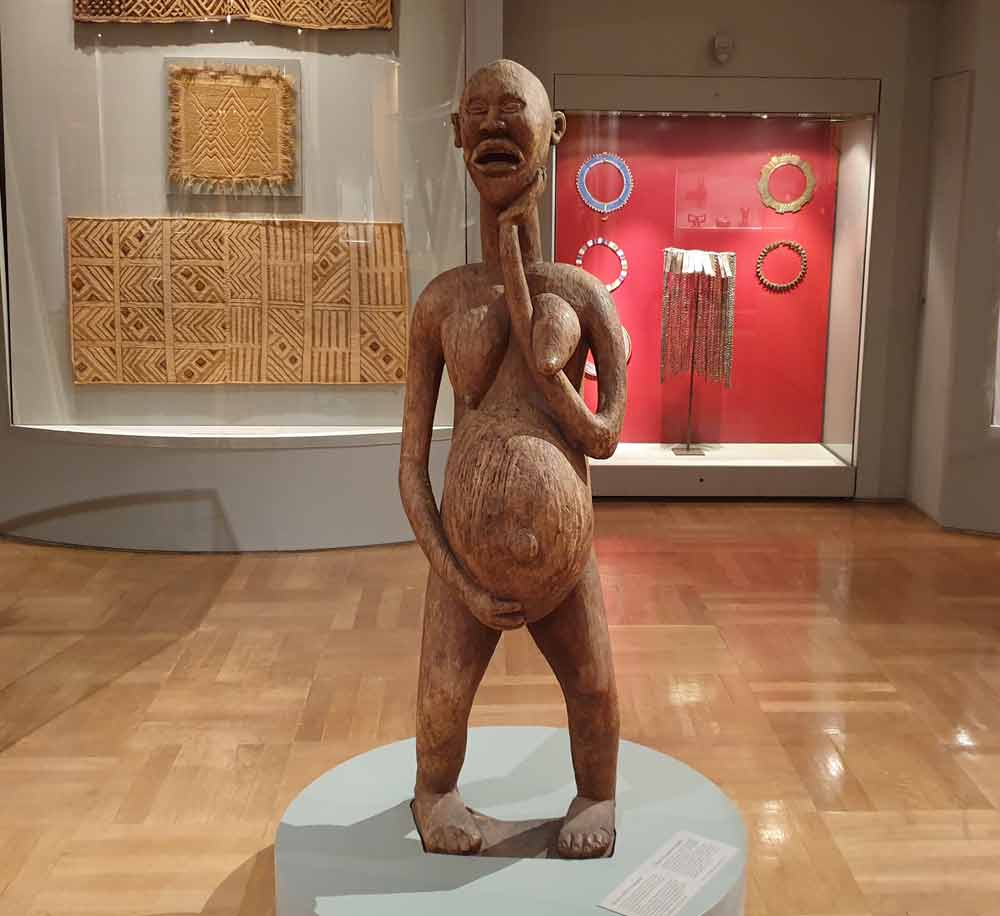
Anonymous artist, first half of the 20th century, wood, 161 cm, Bamileke, Cameroon (Photo Ernst Wagner)
References
- Costa, G. (2019). A communications official for the Amazon synod: https://www.catholicnewsagency.com/news/amazon-synod-final-report-an-instrument-communications-official-says-36081. Retrieved On the 19th March, 2020.
- Agyekum, K. (2006) The Sociolinguistic of Akan Personal Name: http://www.njas.helsinki.fi/pdf-files/vol15num2/agyekum.pdf. Retrieved On the 19th March, 2020.
This article is part of a gallery: Perspectives from Ghana on Museum Objects in Germany, published January 2021

-
 Mary Claire Kidenda
Mary Claire KidendaKenya is extraordinarily rich in creativity, materials, and ideas sources of inspiration reflected in their artefacts which has evolved to its current prosperous state over the centuries. The Kenyan culture can be seen in the visual arts, applied arts, food, music, dance, sports, fashion, literature, and theatre. The artefacts are an extraordinary source of inspiration and nourishment for the artist. Their designs embody African design aesthetics that have retained traditional designs as they also reflect elements of innovation, hybridity, sustainability and modernity (Maina et al., 2017). The artefacts reflect religious beliefs and cultural values – two inseparable elements enmeshed in Kenyan craft. The Kenyan traditional art is fundamentally functional, meeting some specific utilitarian purposes, whereas its aesthetic consideration is typically regarded as having some secondary significance. Art was integrated into everyday aspects of life from formal ceremonies and religious rites to daily household tasks. The arfetacts were produced by skilled experienced crafts persons who were found in the societies. Art is an expression of a particular community or culture through the employment of local materials and craftsmanship.
The Jua Kali manufacturing subsector is the predominant creator of craft products in Kenya (Maina et al., 2017). Jua Kali is a self-organising community of practice producing goods. It is comprised of artisans running micro and small enterprises that are not fully integrated into the mainstream formal economy. The artisans learn skills through traditional apprenticeship (TA). Apprenticeship training is regarded as a critical contributor to skills supply, fostering economic development in Kenya. It involves the transmission of the tacit rather than the explicit knowledge and is the most tangible exhibition of the intangible cultural heritage. It facilitates the transmission of skills from a custodian of knowledge, the Master Craftsman. It combines ethnic design and aesthetics and contemporary styling in craft production in Kenya. Involves the transmission of the tacit rather than the explicit knowledge through observation, imitation and reputation. Besides, apprenticeship ensures that the knowledge and skills that relate to the craft are passed down to future generation so that they continue to be produced within their communities. The learning of the Kenyan design, aesthetics is therefore, an intergenerational phenomenon.
Kenya's ethnic groups can be divided into three broad linguistic groups Bantu, Nilotic and Cushite. The Nilotic tribes in Kenya include Luo, Kalenjin, Maasai and Turkana (Hino et al., 2019). The Nilotic speakers migrated from Sudan and Egypt. They are traditionally pastoralists and fishermen and reside in Kenya's vast Rift-Valley region and around Lake Victoria (Madut, 2020). Each of these communities has its traditions, customs, and practices, imbued with multiple layers of culture, colonial legacies, and migration that add to the rich Kenyan cultures (Deisser & Njuguna, 2016) . The distinctness and confluence of these cultures have served as artistic inspiration for many a cultural product creatively fashioned out of raw materials primarily sourced from the natural environment.
The Luo or Lwoo (also called Joluo, singular Jaluo) are an amalgamated agro-fishery and Nilotic Dholuo ethnolinguistic groups in Africa that inhabit an area ranging from South Sudan and Ethiopia, through northern Uganda and eastern Congo (DRC) (Ojwang, 2021; Prince & Geissler, 2008), into western Kenya, and the Mara Region of Tanzania west Kenya, eastern Uganda, and in Mara Region in northern Tanzania. The name Luo or Low means "God's life-bearing exhalation.' The past economic activities of the Luo included fishing and cattle farming (Ndeda, 2019). Agriculture, especially that which involves staple crops such as maize and beans (Ojwang, 2021). Nilotic communities such as Turkana and Pokot (ekicholong) and even Bantus such as Kamba (mumo ya muthamia) and Taita (kifumbi) in Kenya have traditional stools that have been used for various cultural and functional purposes (Somjee, 1993).
This paper discusses the Luo Traditional Three-Legged Stool called “Kom Nyaluo” in the Luo tribe (Hoehler-Fatton, 1996). My interest in this stool arose because I am a Luo lady married to a Luo man who owns the stool.
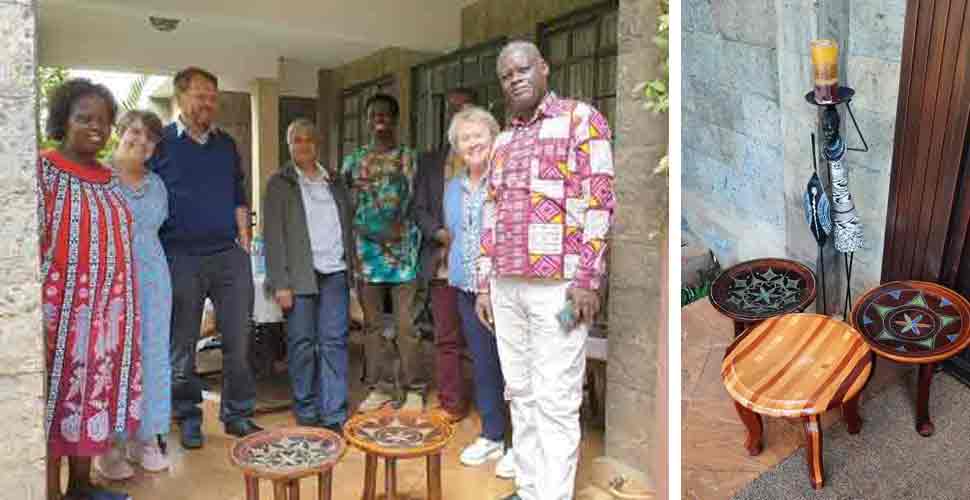
Kidenda, “Domestic Exhibition of Kom Nyaluo to EVC Expert Panel Discussing the Versions of the Traditional Stool”, Wood and Beads, 2022 Karen, Nairobi
The circular top of Kom Nyaluo symbolises the round universe and a miniature universe on which the husband reins in a home. It is a sign of prestige and leadership, reflecting the status or power of men or the husband within society and a reflection of the round traditional Luo huts. Its legs embody male masculinity and virility (Biko, 2010). Only the father was qualified to sit on the seat as he had requisite authority and was the owner of all the women he brought forth life with. He would sit on it when addressing issues; women and children would sit on the ground.
The traditional Kom Nyaluo was small, with a height of about 30cm from the ground and decorated with beads (Hoehler-Fatton, 1996). Each elder had their stool, and women and children were forbidden from sitting on it. Kom Nyaluo is associated with the authority the elders wielded and the respect that they were accorded in their homes and society. The stool design reflected the traditional activities of men and women. The men worked and socialised outside the home, and the women mostly worked inside and around the house and garden (shamba). A married young man with a few children applies for an eldership position in a ceremony where he hosts community elders. He would be dressed in traditional regalia, carry a spear and fly whisk. The elders would sit him on Kom Nyaluo and crown him as an elder.
Most traditional Luo homes were polygamous, and the stool played a significant role in controlling the wife, which enjoyed marital favours and childbearing. The husband or man of the house would send the stool to the woman's hut. He would want to spend the night in her hut. The stool would be sent secretly, and early the following day, the man would sneak back into his hut so that the other wives would not know whom he slept with. This brilliantly averted obvious petty jealousy will arise from a polygamous home. If one wife felt that she didn't have the stool in her house often enough, she would ask the first wife to intervene on her behalf. "If the first wife didn't like her, she would ensure her complaints did not reach their husband. The seat symbolised love and joy and sustained life in a traditional Luo homestead. Literally and figuratively, of course. Kom Nyaluo did not only represent the authority of the man but also love and joy and sustained life in the traditional Luo home (Biko, 2010).
Kom Nyaluo was used during the levirate ceremony or "tero", where a widow was remarried to a relative of their deceased husband. The levirate union is consummated by sexual intercourse on the first night. If the widow invited the elders for a drink the day after the night of "ter", it was a sign that the night had been successful. During the drinking session, there was the enthronement ceremony of the new head of the home onto the stool of the deceased, "Kom wuon dala" (seat of the homeowner). With the enthronement, it was as if the dead man was alive again (Lutta, 2015). After marrying and having a few children, a Luo man applies for elderhood by hosting the elders at a party where he will be crowned and dressed in traditional regalia. Signs and symbols of authority that include a spear fly whisk and a three-legged stool are given to the elder.
Production Process
In this case study, the Kom Nyaluo is produced by an artisan from Siaya County Jua Kali Association craftsman. He learned his father's craft skills through traditional apprenticeship and made his products on demand. The Luo traditional stools are carved with logs from ober (mvule tree), ngo'wo (fig tree), duwa (oak tree) and the member (mango tree). The logs are chopped by a power saw and dried for one week. These are hardwood types that are strong, durable and water-resistant. They also feature unique colours and grain patterns that create a stunning display. Oak is light yellowish-brown and generally straight-grained; it is also hard and durable. Mvule wood comes from the African teak, known in Nigeria as the iroko tree; it is challenging, dense, and durable. Fig tree wood sometimes contains latex, which can be toxic or an allergen. Since the fig trees seldom grow straight, their boards tend to be shorter. However, the wood is soft and not very strong. Mango wood is relatively easy to work with; it is easier to shape, plane and sand while still strong and durable. It is also friendly to waxing and staining, making it excellent for furniture or other household objects.
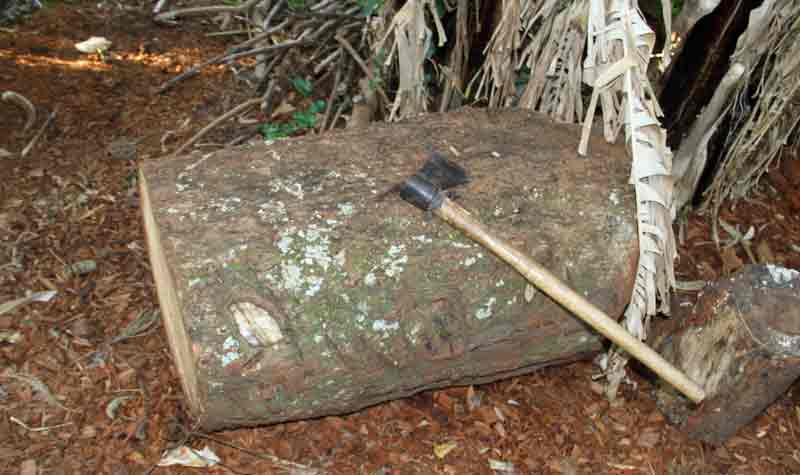
Kidenda, “Wood Logs used for curving out Kom Nyaluo”, 2013, Siaya, Kenya
Each log costs the artisan ten thousand Kenya shillings (Ksh. 10,000), equivalent to sixty-seven (67) euros. The stool is carved from a single block of wood, the wood between stem and roots, which has twisted grains that are more durable and cannot break or crack. The stool is made without using joints or nails. The seat takes the shape of a log. The carver uses Koyo (adze) to fashion Kom Nyaluo from the log, which does not require nails or joints.
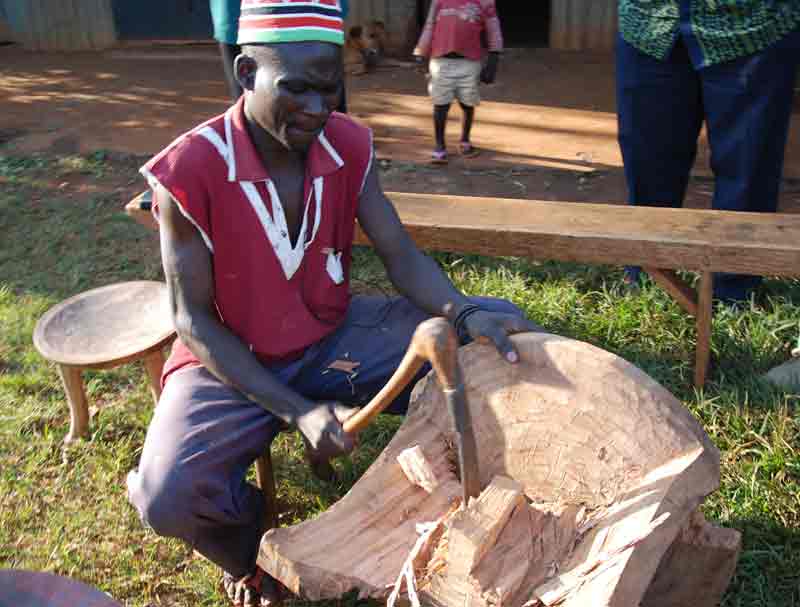
Kidenda, “Curving out the Kom Nyaluo from a log”, 2013, Siaya, Kenya (photo by Mary Clare Kidenda)
Its top takes the circular shape of the log, and after carving, it is smoothened with a furr (metal scrapper for smoothing wood).
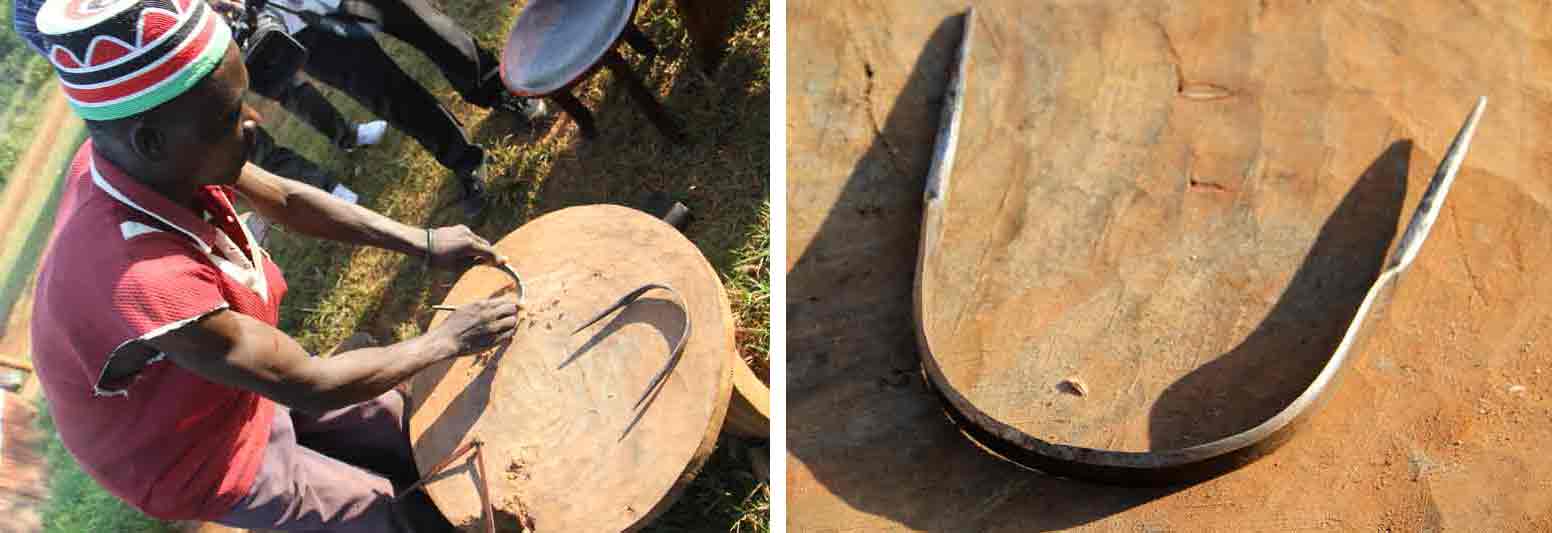
Smoothening the Circular Top Using Furr, 2013, Siaya, Kenya; Furr, the handmade metal tool used to smoothen the top of Kom Nyaluo, 2013, Siaya, Kenya (photos by Mary Clare Kidenda)
They are then sandpapered and vanished using paintbrushes.

Sandpapered and vanished sets of Kom Nyaluo, 2013, Siaya, Kenya (photo by Mary Clare Kidenda)
A compass is used for drawing geometrical patterns on the top of the stool.
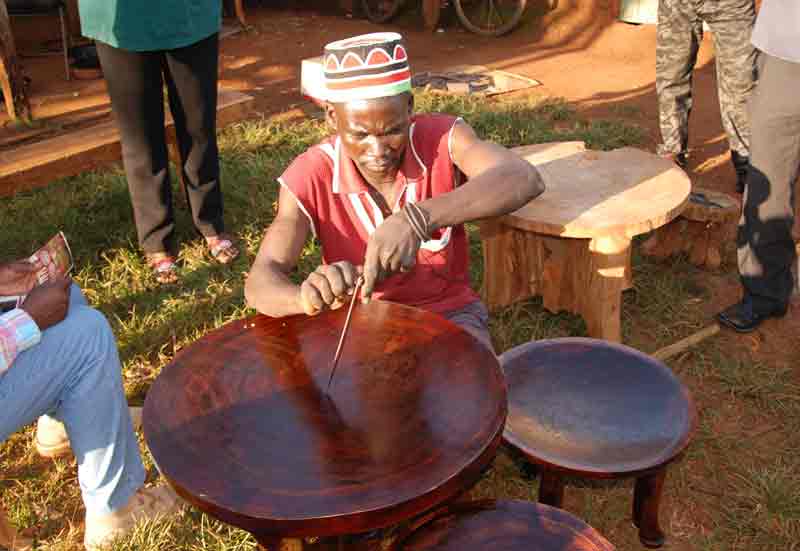
The drawing of geometrical patterns using a compass, 2013, Siaya, Kenya (photo by Mary Clare Kidenda)
Supposedly the design is inspired by a parquet floor in a European-style house owned by Tom Mboya. The wire inlay practised by the Kamba may also have been a model. Thereafter, wood, glass beads, metal, and colourful Maasai beads are banged onto the top, providing intricate decorative artwork.
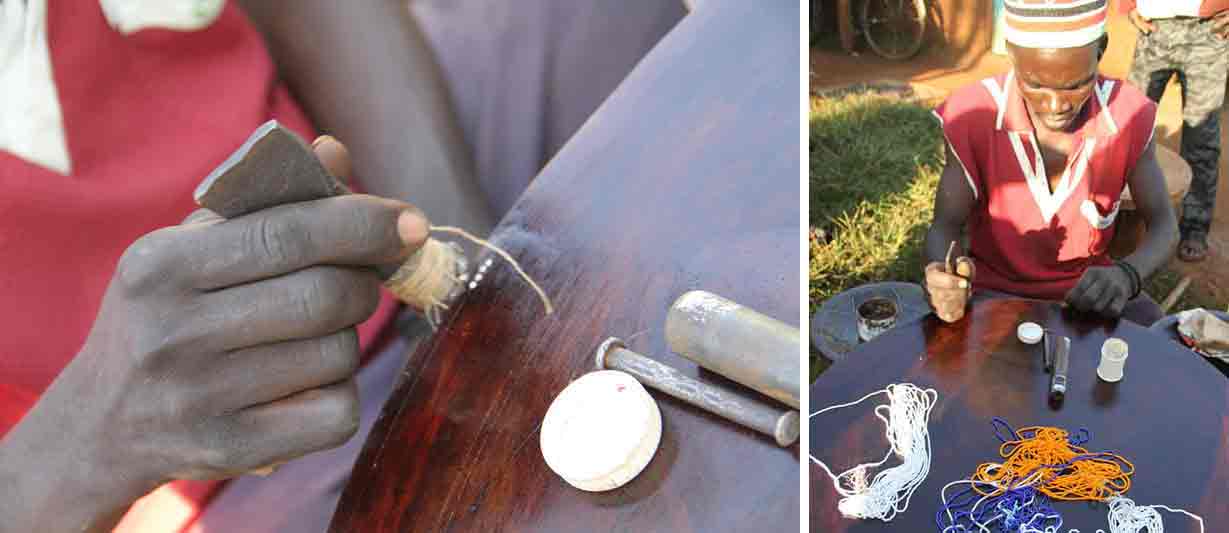
The inserting/banging of beads into the top of Kom Nyaluo, 2013, Siaya, Kenya (photo by Mary Clare Kidenda)
Finished: A Luo Dignitary Stool “Kom Nyaluo”
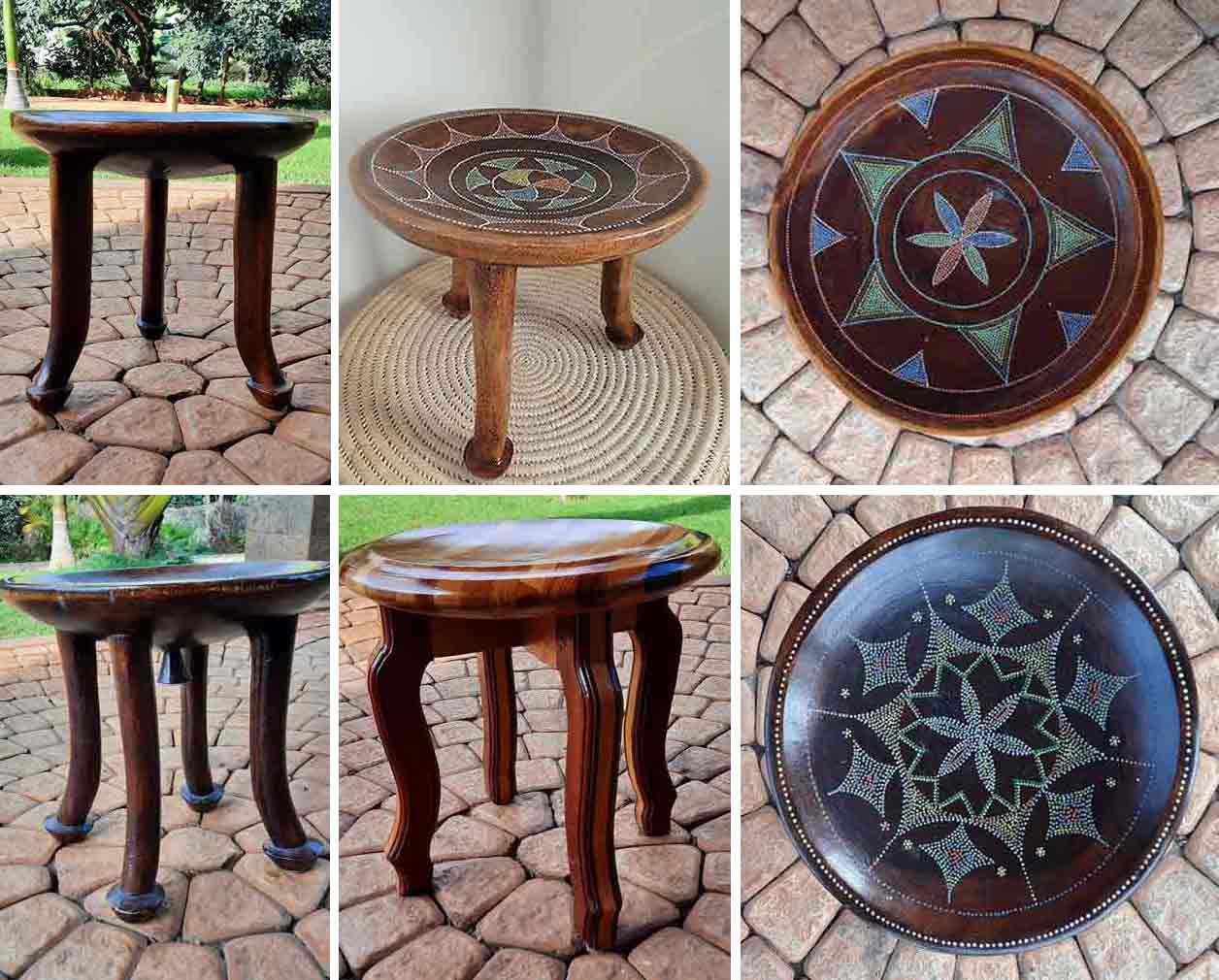
Variety Designs of Finished Kom Nyaluo, 2019, Karen, Kenya (photo by Mary Clare Kidenda)
When Sara went to the US for the inauguration of Mr Obama as president in January 2009 Mama Sarah carried a similar stool. In 2015 when President Obama visited Kenya, he was given a traditional Luo stool (Langat, 2015).
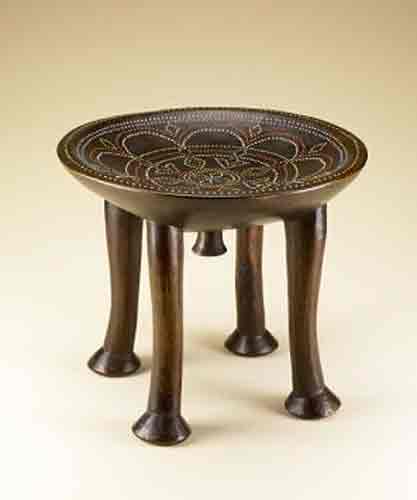
Kom Nyaluo Created by Luberastus Onyango, Wood, glass beads, metal, 2020 Smithsonian National Museum of African Art.
Luberastus Onyango was a renowned Kom Nyaluo craftsman (he died in 1988) whose stools have been given to at least 2 US presidents as gifts President, including John F. Kennedy and Barrack Obama.
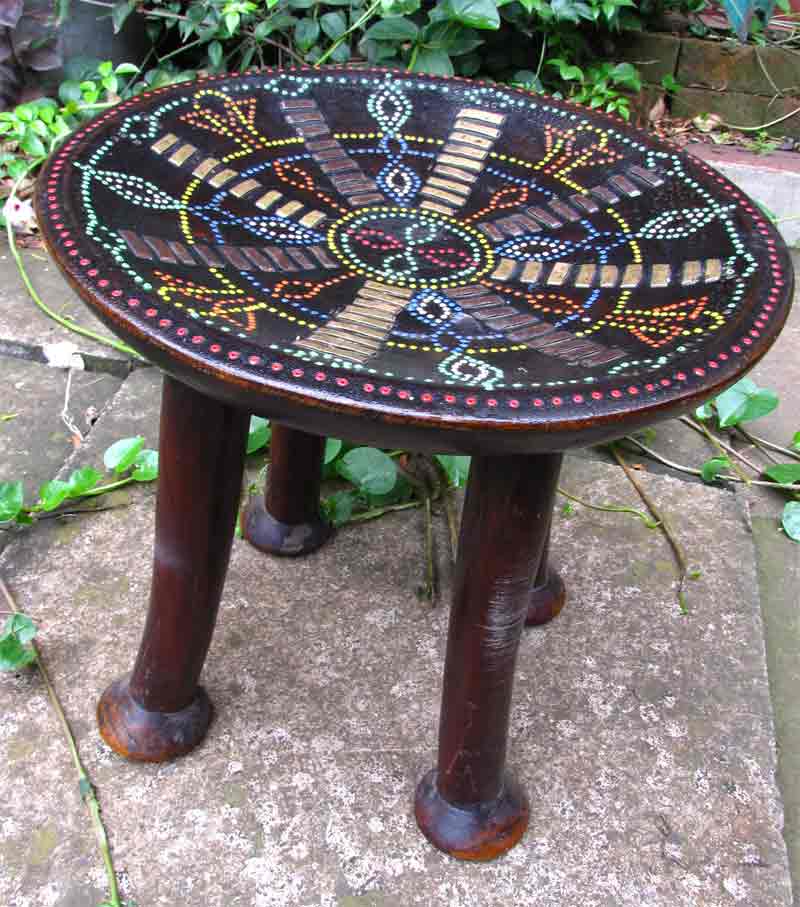
Variety Designs of Finished Kom Nyaluo, 2019, Karen, Kenya (photo by Mary Clare Kidenda)
A generation of Kenyan artists and designers are translating their view of Kenyan design into beautifully crafted products and creating an aesthetic diverse as the tribes and cultures that make up Kenya. This is evident in the JKS in the preservation and modification of the designs like Kom Nyaluo through a traditional apprenticeship that is the critical training methodology of apprenticeship used in Jua Kali Associations. This is evident with the continued production of Kom Nyaluo because of for its cultural utility and aesthetic functionality in the contemporary modern spaces. Artisans and designers are to re-direct and co-create new narratives that re-position philosophical discourse on aesthetics, among other contemporary debates. A generation of Kenyan artists and designers are translating their view of Kenyan design into beautifully crafted products and creating an aesthetic diverse as the tribes and cultures that make up Kenya.
References
- Biko, J. (2010). When in Kisumu, make sure you visit the museum. Eastern African Publication. https://www.theeastafrican.co.ke/tea/magazine/when-in-kisumu-make-sure-you-visit-the-museum--1297986
- Deisser, A.-M., & Njuguna, M. (2016). Conservation of natural and cultural heritage in Kenya: A cross-disciplinary approach. UCL Press.
- Hino, H., Langer, A., Lonsdale, J., & Stewart, F. (2019). From Divided Pasts to Cohesive Futures: Reflections on Africa. Cambridge University Press.
- Hoehler-Fatton, C. (1996). Women of fire and spirit: History, faith, and gender in Roho religion in western Kenya. Oxford University Press.
- Langat, P. (2015). Mama Sarah reveals her special gift to Obama during visit. Nation. https://nairobinews.nation.africa/mama-sarah-reveals-her-special-gift-to-obama-during-kenyan-visit/
- Lutta, C. (2015). The Traditional Levirate Custom as Practiced by Luo Of Kenya. University of Gavle.
- Madut, K. K. (2020). The Luo people in South Sudan: Ethnological heredities of East Africa. Cambridge Scholars Publishing.
- Maina, S. M., Rukwaro, R. W., & Onyango, W. H. (2017). Infusing Design In The Jua Kali (Informal Sector) Production Processes. Journal of Humanities and Social Science, 3(2), 1–12.
- Ndeda, M. A. J. (2019). Population movement, settlement and the construction of society to the east of Lake Victoria in precolonial times: The western Kenyan case. The East African Review [Online], 52.
- Ojwang, H. H. (2021). A study of Luo Ethnobotanical Terminology with implications for Lexicographic Practice. Lifelong Education Material Publishers.
- Prince, R., & Geissler, W. (2008). Becoming “One Who Treats”: A Case Study of a Luo Healer and Her Grandson in Western Kenya. Anthropology & Education Quarterly, 32(4), 447–4.
- Somjee, S. (1993). Material culture of Kenya. East African Educational Publishers.
 Osuanyi Quaicoo Essel
Osuanyi Quaicoo EsselPan-African collective memory: Sociocultural power and identity making on indigenous stools from Ghana and Kenya
Indigenous stools play significant roles in Ghanaian and Kenyan cultures and societies, especially, among the Akan and Masai ethnic groups in the two respective countries. Stools in the sociocultural context serve many functions. One of the primary functional roles is that, it serves as object for sedentary purposes. It is used as a utilitarian object for sitting, welcoming visitors, relaxation for people, for example, family and friends. In Ghana, it is customary to offer a visitor a chair (stool) by way of welcoming, serving him/her water, before asking the visitor of his/her motive for the visit. In the first instance, a visitor is given a sit to relax, followed by cup of water for drinking before asking the visitor to give purpose for the visit. Offering a visitor a chair shows an overt acceptance and respect for his/her presence. This traditional etiquette of serving visitors is ingrained the sociocultural life of both Ghana and Kenya.
Amongst the Akan of Ghana, a visitor is usually given a traditional stool as a seat that may befit his/her status in the traditional society or culture. A family may have different stools: those for showcasing power and authority of its user, honouring guests, and everyday usage by the household. The usage of stools in this context depicts its status-defining tendencies.
Apart from signifying status of individuals, stools, among the Akan of Ghana symbolises the authority of the ethnic or nation states. Stools in Ghana, generally serves as a symbolic soul of the society which links people to the traditional leadership (Antubam, 1963; Amenuke et al, 1991). The stool carries authoritative presence and signifies leadership concept. Warriors, clan heads, chiefs, kings used it to signify their status.
Stools serve as scared and authoritative object in the traditional chieftaincy institution of the southern part of Ghana. Kings/chiefs are enstooled in southern Ghana while those at northern part are enskinned. This implies that in the cultural rituals in the making of Kings/chiefs, stools are inevitable. Amongst the chiefdom, there are several ritualistic uses of stool. Some stools in the court of a chief may be used only once in his or her lifetime. Some are also used once a year during traditional festivities while some are used on daily bases.
As an object strongly connected with power and authority, the Ghanaian stool has three basic parts: the arc-shaped top, the middle portion and the flat base. Its arc-shaped top symbolises loving embrace of women or the concept of motherliness (Amenuke et al, 1991; Antubam, 1963). The middle portion usually gives the stool its name based on the symbol used in representing a concept or idea. The name of the of a stool could be based on a proverb, Adinkra symbol (Figure 1), traditional emblem or idea. For example, the stool in Figure 1 derived its name from the Adinkra symbol which has been stylised to occupy the middle portion, hence the name Nyansapow Stool.
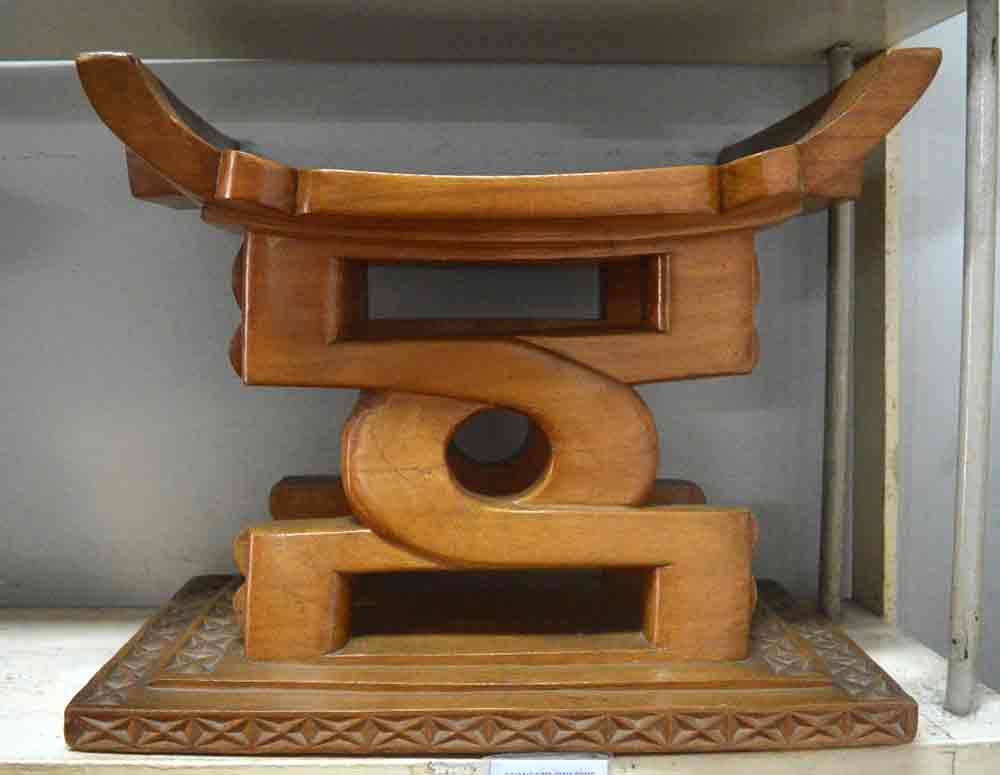
Figure 1: Nyansapow (Wisdom knot) stool, wood, Ghana National Museum, Photo: the author.
The recognition of the presence of God in the society, gender roles and the presence of children is also acknowledged by the middle part of the stool. Design of a stool may adopt basic beliefs and practices of symbolic significance to the society in general. The symbolic adaptation speaks to the visual presentation of Ghanaian societal values including concept of societal functions, cosmic beliefs, family and gender roles.
As a utilitarian object, the stool plays vital roles in the rites of passage (birth, puberty rites, marriage and death) in indigenous Ghanaian and Kenyan cultures in different context. In indigenous Masai culture, stools are used by husbands as object of announcing their eminent visit to their wives on rotational basis. In many African societies, marrying more than one woman is an accepted norm just as same sex marriage are acceptable in other continents of the world. African society holds polygamy as a culture and not in negative perspective as non-African wrongly perceives it. Masai men with more than one wife usually build their houses in circular orientation, allocating a room each to the wives. The house of the man is situated in the middle of the circular-arranged houses. With this traditional set up, the stool is used as a preserve for the husband to signal his presence and authority. To announce his official intention of visiting one of the wives in the same compound, he sends his messenger to send his stool to one of the wives he intended to visit. By seeing and receiving the stool, the wife interprets this symbolic gesture to mean official announcement of her husband’s visit.
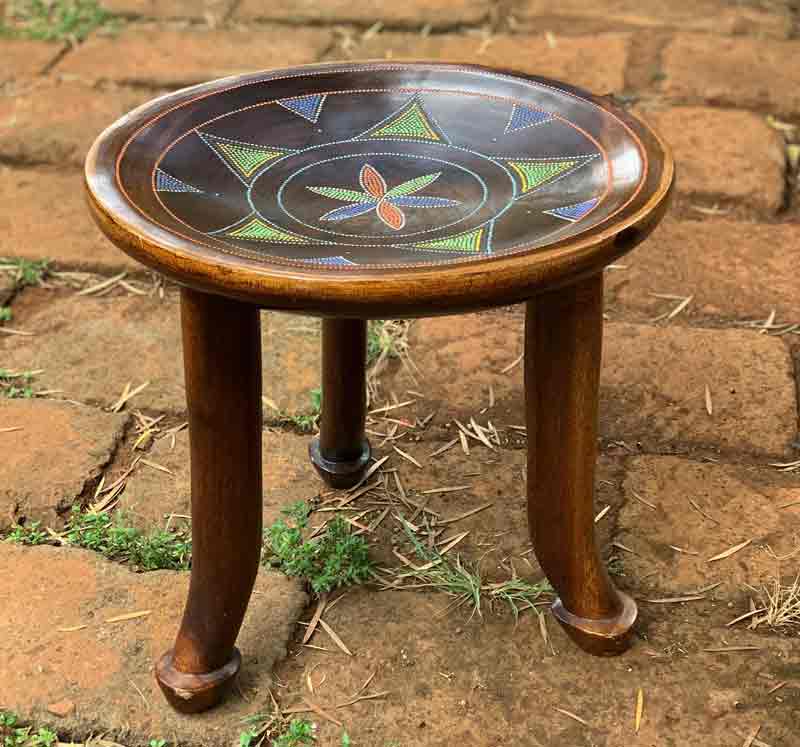
Figure 2: Traditional Kenyan stool used in negotiating visitation to wives, Found in the personal collection Mary Clare Kidenda. Kenya, Photo: the author.
The design of the Masai stool of Kenyan (Figure 2) varies from that of the Akan of Ghana. The Maasai stool features a circular-shaped top and prominent three-legged phallus-shaped upright stands. Usually decorated with traditional Masai beads, the top of the stool has bowl-shaped surface that serves as a comfortable receptor of the buttocks of the user. The tip of the phallus-shaped stands touches the ground and gently bends inward, and depicts crown-shaped cork memetic of the phallus. These observable characteristic features symbolise the presence and potency of the manhood in procreation. Despite its simplistic appearance, the stool creates a collective memory of marital relationships and the supervisory power of males and the loving embrace of women. Interestingly, this depiction to the African, is not a show of chauvinism but a reminder to males to protect and care for women within their power. Generally, having secret rendezvous or extra marital affairs is frond up by society. Performing official marital rights to marry a lady is the traditional expectation rather than having them as mistresses.
In Ghana, the head of a clan, warrior, chief/king and queen mothers uses the stool to symbolise authority. For that matter, the presidential seat was fashioned with inspiration from the shape of the stool. Despite the difference in design concept of the Kenyan and Ghanaian stools, both signify a collective memory of marital relationships, idea of procreation, leadership authority and the loving embrace of women in the society.
References
- Amenuke, S. K., Dogbe, B. K., Asare, S. K., Ayiku, F. D. & Bafoe, A. General knowledge in Art for senior secondary schools. Evans Brothers Limited.
- Antubam, K. (1963). Ghana’s heritage of culture. Koehler & Amelang.
- Asihene, E. V. (1978). Understanding the traditional art of Ghana. Associated University Presses
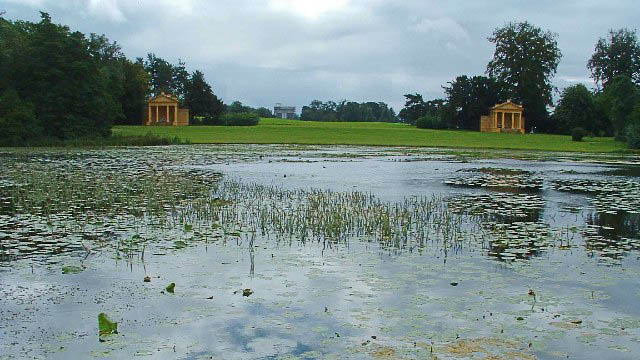
-
 Ernst Wagner
Ernst WagnerThe English Garden perceived as harmonious, lovely, picturesque or graceful to visitors in our present day, is charged with political resistance, struggle for power, projection of social utopias or flight into resignation. Like many interesting creations, these gardens are microcosms full of contradictions – particularly during the time they were created in the early 18th century: utopia and idyll, a mirror of society and its antithesis, dream and melancholy, imitation of nature and going beyond nature.
Stowe House Park, less than 70 miles northwest of London, is considered to be the first and most definitive site of an ‘English Garden’ – Lancelot Brown (1716 – 1783) who was employed there was the first person whose life-long occupation was that of a landscape gardener. The Stowe gardens embodied the ‘English Garden’ paradigm like no other and Benton Seeley’s guidebook (1742), the first garden guidebook to be published in the world, helped to spread Stowe’s influence throughout the 18th century as the model for the ideal English garden.As a country estate of the Temple family, it was – many decades before the redesign – first committed to Baroque, i.e. French models: symmetrically laid out, geometrized nature, combined with the pompous splendor of the manor building. The early model was abandoned and the new complex design of 26 hectares followed more innovative principles, for good reason; however, it still remained a status symbol of the wealthy family.
Thus the many buildings that were built in the park are demonstratively not Baroque. After all, Baroque embodied absolutism, which was despised. Instead, they were inspired by Renaissance, Gothic, antiquity, or Chinese architecture, pre-baroque styles or styles found geographically outside the borders of England. Each style tries to evoke its own mood: Gothic stood (and stands) for the morbid, the unearthly, China for the exotic, antiquity for the free citizenry.
In this sense, the names of the garden parts can be understood as allegories: Temple of Concord and Victory, Grecian Valley, Stauen von Saxon Deities (Germanic Deities) or Homer and Socrates, Gothic Temple, Elysian Fields and many others refer to cultural regions that represent a different, supposedly better social order. It is about an alternative concept to the absolutist principles, about freedom. The dedication inscription on the Gothic Temple makes this very clear: “To the liberties of our Ancestors”.
This directly decipherable political iconography is complemented by a differentiated iconology of forms. For example, the grass around the Temple of Ancient Virtue is subtly maintained as a lawn, while the grass around the ruins of ‘contemporary virtue’ grew wild until the ruins disappeared completely. The outdoors devours the contemporary, decadent, (neo-) absolutist tendencies. Thus nature was liberated from geometrizing corsets just as society was liberated from absolutism. As in free nature outside the garden with its unbridled forms, the garden becomes a free landscape in which free people move freely.
This conception of how such a landscape garden should look was influenced by three main sources: from the personal memories of nature that English nobility brought back with them from their Grand Tours through Europe; various descriptions of exotic Asian gardens; and, finally, from the classical landscape paintings by Ruisdael, Lorrain or Poussin.
Areas in the garden were designed for such three-dimensional pictorial stagings, which in Stowe featured over 90 selected scenes (or one might call them intriguing or harmonious compositions) that could be experienced from certain spots or areas in the garden. The visitor had to and has to set out to walk in order to experience all the spaces and perspectives along the way. Winding paths, which repeatedly open up to surprising glimpses of the unexpected, lift the visitor from everyday life and put him in a special mood. Hence, the course of the path is the central means of the landscape designer to develop his own dramaturgy. He steers the visitor and controls what he sees and when. What the visitor doesn’t see are typical walls. Instead the use of ha-has, a recess in the landscape similar to a sunken ditch, creates a vertical barrier while preserving an uninterrupted view of the landscape. The fine line between art and nature disappears.
The ever-changing weather, light and appearance of the plants, and the multifold of views along the way, allow the visitor to immerse himself again and again in an entirely new visual experience. This sensual experience should have a purpose. In the five-volume Theory of Garden Art by Hirschfeld, published 1779-85 in Leipzig, the aims are clearly outlined: On the one hand, the education of the observer through the enjoyment of art (“inner true cheering up of the soul, enrichment of the imagination, refinement of feelings”) and on the other hand, the “beautification of an earth which is our home for a time”. The aim is thus the refinement of nature by man as well as the refinement of man by nature.
The Temple family had initially acquired its immense wealth through sheep farming, and on the basis of its economic success it provided members of the English parliament for generations, including four prime ministers. English politics in the 18th and 19th centuries would be inconceivable without its influence. Richard Temple, 1st Viscount Cobham (1675 – 1749), who was a key figure in the founding of the park at Stowe, was initially a successful army commander in the War of Spanish Succession against France. In the early 18th century, however, as a supporter of the ‘Glorious Revolution’ (1688/89), which had led to the abolition of absolutism in England, he was marginalized by internal adversaries, which made the development of his garden so important for him.
In search of an aesthetic alternative to the ideologically rejected French garden (as the embodiment of absolutism), Chinese or Japanese gardens offered a central source of inspiration. William Temple had already published a book on Asian gardens in 1690. These gardens were above all a counter-model to the symmetrical arrangement of geometrically limited flowerbeds, the prototype of which was the park of Versailles. The irregular, free composition of trees, plants, stones, and water in Asian gardens was the model for a natural appearance that was as natural as possible and, in turn, created with the highest degree of craftsmanship, that is, artificially. In 1738, this enthusiasm for Asian gardens led to the construction of a Chinese house in Stowe – the first in garden history – an innovation that found its successors in many gardens throughout Europe.
Reference
Sibylle Hoimann, Garten; in: Fleckner U., Warnke M., Ziegler H. (eds.), Handbuch der politischen Ikonographie, Vol. I, München 2011 (Beck), pp. 388.
published January 2020
 Prudence Lau
Prudence LauAt the moment, I find it fascinating that such English and Chinese or Asian cultural exchange upon the built environment started so early on in the 18th century. It reminds me of the Chinese garden that focuses also on landscape, and an emphasis for reflection and escape from the outside world.
published January 2020

-
 Elfriede Dreyer
Elfriede DreyerMatiyane depicts cities of the world in the form of large mixed-media panoramas, utilising a naïve style of schematic outlining and an almost unsophisticated usage of coloured pencils and crayons, not unlike the early travelogues of the Renaissance and colonial explorers. In his panoramas, the landscape is flattened out into a subjective urban picturesque adorned with the city’s commercially most well-known markers functioning as a concise overview of or introduction to its most important historical events and its icons. Although Matiyane generally presents wide panoramas of cities, thus ‘walking’ multi-viewpoint compositions, he often creates panopticon-like designs in which he functions as a kind of ‘watchman’ surveying the city from a single point of observation – his own. In the late eighteenth century, the English philosopher and social theorist Jeremy Bentham coined the idea of the panopticon as a particular type of institutional building design that could allow surveillance by a single watchman in such a way that the entire institution could be surveyed from a single angle. The term ‘panopticon’ has been derived from Panoptes in Greek mythology that was a giant with a hundred eyes and known as a very efficient watchman. Bentham's architectural designs were very much aimed at the design of institutions such as prisons, for instance, or corporate environments, where inmates or workers could be surveyed without them realising it. Bentham’s ideas acted as precursor to twentieth-century technology such as closed-circuit television (CCTV).
Having been territorialised under the apartheid regime of segregation and living in Attridgeville a township outside Pretoria, the country’s administrative capital, Matiyane embarks on a kind of symbolic remapping of these histories. Operating without sufficient transport and with minimal equipment and art materials places limitations on his mobility and professional practice; within the context of the strenuous context of his daily battles, the spectacularity of powerful world cities and their apparent glitz and glamour to him seem like places of pleasure and the world like a global utopia where poverty and agony can be forgotten. In his Panorama of Africa: Cape to Cairo, Matiyane expresses a particular sense of place and a human condition, echoed in Alice Ming Wai Jim‘s (2008:264) description of Hong Kong in ‘Mediating place-identity: Notes on Mathias Woo’s A Very Good City’:
Over the last decade, contemporary art in Hong Kong, informed by travel(ing) theory, the special administrative region’s ambiguous (post) colonial-national-global connections and its inimitable set of historical and cultural situations, has been preoccupied with the themes of mobility, transition, and location in its representations of the city. This fixation, or, rather, the urgency of its mediation in not only artistic but also cultural, economic, and political arenas is inextricably linked to an ongoing elaboration of a Hong Kong identity. But assertions of “who we are” are often intimately related to suppositions of “where we are,” and ideas captured in the environmental psychological concept of place-identity.
Matiyane’s sense of identity and notion of ‘who he is’ is similarly tied to ‘where he is’, but virtually he can be anywhere. In every panorama, the artist traces the contemporary city’s ontology of mobility and transitivity in images of technology, airplanes, trains and boats. To him these images represent power, positive energy and dynamism, being tropes of transition and movement towards improvement, development and transformation. His utopian imagery can be interpreted as being populated by a multitude of heterotopic elements, such as powerful personae and images of transitivity represented by trains and boats that function autonomously but concurrently in close relation to their socio-cultural and geopolitical contexts; as liminal instruments connecting space and place; and as vigorous agents of change. In a work such as Panorama of Gauteng (2014), for instance, the artist included images as well as the life history of Nelson Mandela, interpreted as the as an iconic symbol of transformation and change, and in Panorama of Africa: Cape to Cairo, he once again presents Mandela as the most powerful legacy in Africa. It becomes a stratagem of power mediation to point out the country’s instruments of advantage within the global sphere of competition. His vision radiates optimism and hope and deconstructs the notion of the processes of historisation as categorically fixed, predetermined and non-negotiable.
Through the act of being empowered to depict any place in the world, the artist constructs his identity in the domain of the global self that utopianistically interacts with perceived spectacular environments. By mostly depicting cities that he has never been to, Matiyane expresses a desire and a longing for the exotic Other, yet his relationship to place is transmutative in essence. He imagines places where the home of the place–identity involves a process in which the self and local become metamorphosed into the global world. The artist becomes a ‘nomad’, displaced and diasporic in his pursuit of fame, wealth and global stardom through the fusion with ‘famous’ and ‘successful’ cities in his depictions. Global psychogeography is created in which cultural disparities are flattened in renderings of cities and their surrounding landscapes, each endowed with air and ground transport, patterns of housing, own histories, a national flag and a city centre. Becoming ‘playful masquerading’, the artist’s presentation of panoramic landscapes imbued by factual information makes the real, perceived and imaginary differences between cities, cultures and worlds fall away. Surveyed through the panopticon framework of his panoramas, there are superficially neither perceivable binaries of have and have-not, poverty and wealth; nor anxieties, losses or racial discrimination. East meets West meets Africa in a global blueprint of urban patterning.
By crossing the borders of the self and the local in his depiction of cities, Matiyane becomes a virtual flâneur of the cities of the world and a cartographer of imagined spaces.
Reference
Ming Wai Jim, A. Mediating place-identity: Notes on Mathias Woo’s A very good city, in Asselin, O, Lamoureux, J, Ross, C (eds). 2008. Precarious visualities: New perspectives on identification in contemporary art and visual culture. Montreal & Kingston/London/Ithaca: McGill-Queen’s University Press.
About the artist
Major exhibitions since 2008
2018, Venice Architecture Biennale, Japan Pavillion
2018, Titus Matiyane’s Cities of the World, ZAM, The Hague
2014, Cool Capital Biennale, curated by Elfriede Dreyer and Adele Adendorff. Panorama of Pretoria: Mamelodi to Soweto
2014, Reserve Bank, Cool Capital Biennale exhibition. Panorama of Pretoria: Mamelodi to Soweto
2013, Royal Academy of Fine Arts, Artesis University College, Antwerp. Group exhibition, Nomad bodies curated by Elfriede Dreyer
2012, Stevenson Gallery, Johannesburg. Panorama of Polokwane to Sasolburg
2012, Fried Contemporary Art Gallery, Pretoria. Group exhibition, Me 3, curated by Elfriede Dreyer
2011, La Société générale, Casablanca, Morocco. Cities of the world exhibition and Panorama of Western Cape. Curated by Annemieke de Klerk
2010, Fried Contemporary Art Gallery, Pretoria. Group exhibition, Cities in transition, with Eric Duplan and Lucas Thobejane, curated by Elfriede Dreyer
2010, Lille Métropole Museum of Modern, Contemporary and Outsider Art. Panorama of Lille
2010, Big 5 Festival, Teater aan het Spuy, The Hague. Panoramas of Cape Town, Berlin, Tanzania, Mali, Dubai, Johannesburg, Mpumalanga and KwaZulu Natal. Curated by Annemieke de Klerk
2009, UJ Gallery. Cities of the world. Panoramaas of New York, Pretoria, London, Dubai, Kwazulu Natal, Pietersburg to Sasolburg
2008, Aedesland, Berlin. Cities of the world. Curated by Annemieke de Klerk
2008, National Museum Of Mali, Bamako. Cities of the world. Curated by Annemieke de Klerk
2008, Fried Contemporary Art Gallery, Pretoria. Group exhibition, On the globe, with Pieter Swanepoel and Diek Grobler, curated by Elfriede Dreyer
2008, Delft University of Technology, Faculty of Architecture, Delft. Cities of the world. Curated by Annemieke de Klerk
Publications
- Annemieke de Klerk, Melinda Silverman, Stephen Hobbs, Wytze Patijn, 2007. Catalogue for the exhibition, Titus Matiyane: Cities of the World. Afdeling Bouwkunde, Technische Hogeschool Delft. 010 Publishers. Published for the purposes of the Cities of the World travelling exhibition, 2007- 2008 and the manifestation "African Perspectives" held December 6-8,2007, both commissioned by the Faculty of Architecture of Delft University of Technology.
- Makorakora: Shaping wire into vehicles. 1985. SA Today. Article featuring photograph of model of spacecraft “Challenger” made by artist.
- Rankin, E. 1994. Images of metal: Post-war sculptures and Assemblages in South Africa. Johannesburg: Wits University Press.
published February 2020
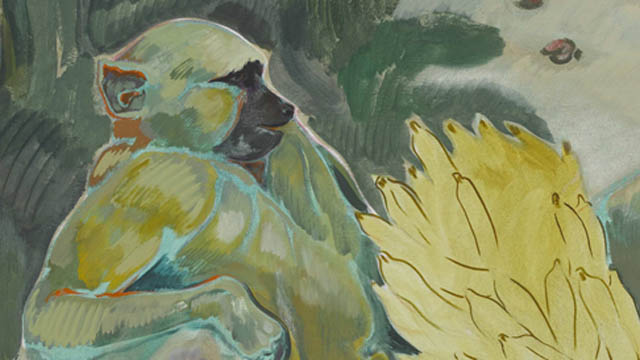
-
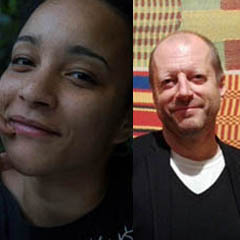 Leonie Chima Emeka & Stefan Eisenhofer
Leonie Chima Emeka & Stefan EisenhoferBorn 1984 in Nairobi (Kenya), Armitage received his artistic training in London (UK). Living and working in both places today, he praises each of these cities as substantial to his creative practice. His inspirations spring from many different sources – from political events, mass media affairs and pop culture to personal memories and experiences as well as from Eastern African and European folklore. He merges together the stories and experiences of two cities and weaves them into a narrative of interregional interest. Often starting with Kenyan local myth he is developing global tales of political critique and rebellion concerning global demands on democracy, data protection, ecological and human rights — always overlaid by the meaning of the break between the “West and the Rest”, between human and un-human, between the exploitation of life and its inviolable dignity. In his work, Armitage investigates the idea of Africa as a mirror for Western phantasies and success stories of the Global North: the wild and untamed nature on the one side and the violated racialized bodies and political and ecological catastrophes on the other.
The painting “Baboon” was on view in the exhibition "The Paradise Edict“ at Haus der Kunst in 2020 as part of a series of five oil paintings depicting tropical animals. On tropical background various monkeys in erotic posture invite the viewer to an examination of sexuality at the boundaries between animality and humanity, erotics and exotics. Also the “Baboon” strikes the eye with its suggestive sexuality. In the clearing of an overgrown rainforest, the monkey lies on the ground in a very human attitude. A bare stone supports its right arm as if the ape was resting on a natural chaiselongue. Within the apparently wild environment, the animal seems rather cultivated.
The baboon oscillates between human and animal; not only in its posture but also in its physique: Feet and face are animal, while the rest of its body looks almost human; it has no fur or hair but pronounced muscles on his bare chest. Despite its muscles the ape’s body looks youthful and slightly lanky. It reminds to Michelangelo’s David for which it is commonly known that the legs and arms are extra-long compared to his body in order to mark his youth. Like a juvenile not yet fully grown the baboon, too, has long arms and legs. Neither a child nor yet a man, both an ape and a human body, the baboon hovers between child and man, between man and animal, between innocence and animal sexuality.
Instead of the characteristic fig leaf of early modern European sculpture, there is a large bundle of bananas between the monkey's legs. The individual bananas, sketched on the yellow surface, are quite phallic in shape and the banana bundle tends to overemphasise the male sexual organ, while the ape’s physical penis is hidden behind it. The banana is probably the most common fruit in the Global North that still bears the tag ‚exotic‘. It is not the monkey’s body, that is sexual; but the bundle of bananas both hides and emphasises the phallic and states an allegory for the conceptual connection between exotic and phallic.
Its absence makes it ever more present, as its leaves the concretisation of sexuality to the viewer’s imagination. In fact the image could be both innocent or sexual, as not only the penis is hidden behind the bundle, but also the ape’s left hand that reaches out to his underbelly. We can not see, but only guess where it rests, and what it is doing there. In his suggestiveness Armitage opens a space of confusing erotic tension and a critique of the sexualisation of race. With the figure that hovers between youth, man and animal, Armitage challenges the relations between black masculinity and sexuality in the Global North. It was Franz Fanon in "Black Skin-White Masks“ (1952), who once posited, that in European Subconscious "the Negro“ is the genitals par exellence, reduced to a giant penis. In this painting Armitage investigates the complex relations between blackness and phallus in Western concepts of masculinity.
Like many of Armitage’s paintings also the “Baboon” presents an overlay of heaven and hell and is taking up the title of the exhibition “Paradise Edict”. They are referring to African and European as well as global paradise fantasies and hopes. They are aiming often at an ordered, decreed and prescribed paradise. They reveal the mandatory and obsessive aspects of these Garden of Eden-Imaginations, disillusioning global Out-of-Africa-fantasies, distorting eternal and natural laws to man made illusionistic laws.
Armitage uses lubugo, a fabric made from fig-tree bark, in lieu of canvas for his paintings. This cloth is Ugandan in origin and has a long history of social, religious and political meaning and use there. Armitage first came across lubugo in 2010 on a Nairobi tourist market. The use of this now somewhat Pan-East-African-material corresponds with his visual vocabulary. Armitage combines European with Eastern-African materials, forms and strategies and waves them into complex, yet alluring compositions that remember the entangled history of painting through the ages and continents and rewrites new relations in between.
published January 2021
About Michael Armitage's initiative in Nairobi "Nairobi Contemporary Art Institute (NCAI)" see Link.
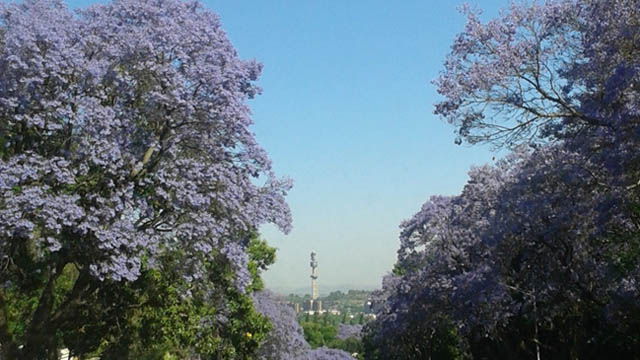
-
 Esther Kibuka-Sebitosi
Esther Kibuka-SebitosiThe image shows the deciduous large Jacaranda tree that grows up to 20-30 m high. The leaves are bipinnate produced in conspicuous large panicles, each flower with a five-lobed purple corolla. The fruit is oval flattened capsule containing numerous seeds. The Jacaranda in Pretoria flowers between September to November with purple flowers that paint the whole City purple. For this reason, Pretoria is called the Jacaranda city.
Known for its alluring lilac blossoms, the Jacaranda tree (Jacaranda mimosifolia) is native to South America and was introduced for decorative purposes way back in the 1800s to South Africa. In Pretoria, the Jacaranda was first introduced in Arcadia in 1888. Its beautiful flowers are characteristic of the springtime in Pretoria, City of Tshwane, Gauteng Province, where it fascinates the residents by putting a light purple carpet all over the roads.
Although the purple flowers remind the University students of the exams that take place around that time of the year, the elegant beauty of the Jacaranda flowers calms down the souls of many residents. Legend has it that when a flower from the Jacaranda tree drops on top of your head, you would pass all of your exams. Therefore, students wish for on eof the soft blossoms to drop one of its tubular flowers on their heads as they pass under this magical tree. The seeds, on the other hand, are enclosed in a brown, oval and flat capsule, which bursts open when dry, releasing flat winged seeds. They disseminate via wind dispersal to the savannah, woodlands, rocky ridges, riverbanks and all sorts of habitats.
To the conservationists, this deciduous beauty is an invasive species. Its origin is reported to be South America, particularly Argentina and /or Brazil because of the name’s Guarani origin in Argentina. The tree is regarded as an invasive species in South Africa and Australia. In South Africa, it is labelled as preventing growth of native species. However, in other parts of Africa such as Zambia, Zimbabwe and Kenya, the species is also present without being considered invasive yet.
In Pretoria, City of Tshwane, Gauteng province, the Jacaranda trees are enormous and line the pavement of the streets and inhabit roadsides, as evident in the images above. When they flower, they paint the whole City purple and it is spectacular to witness. The images portray the beauty and elegance of the tree that perhaps is draining the native ecosystem, which not to many are aware of.
Jacaranda blossoms are stunningly beautiful, but hidden underneath is the contradiction of the tree being an alien species that prevents indigenous trees from growing. Indeed, not “all that glitters is gold”. For this reason, the Jacaranda tree is no longer allowed to be planted in Pretoria.
Water scarcity is the most alarming problem of the twentieth century next to climate change in conservation. The sustainable Development Goal (SDG) 15 aims to protect, restore and promote sustainable use of terrestrial ecosystems, sustainably manage forests, combat desertification, and halt and reverse land degradation and halt biodiversity loss. In the meantime, SDG goal 11 promotes sustainable cities and communities. The dilemma of keeping the City green with trees and balancing the water ecosystems with the proper tree planting is a challenge that must be tackled through a multi-inter and trans-disciplinary approach to sustainable development. The Jacaranda tree is an example of this contradiction.
Apart from being beautiful ornamental trees, the Jacarandas' wood is used for furniture and other crafts. Meanwhile, programmes to address the social economic problems in communities were linked to alien species like the Jacaranda. These programmes aim at the sustainable management of natural resources through the control and management of alien invasive plants, by removing the species and thereby bringing employment to the youth, as part of the expanded Public Works Programme. The objective is to reduce the impact of invasive alien trees on water resources.
All over the world, trees and plants are introduced for various purposes. These trees contribute to multiple services for instance fodder, timber, medicines, fruits, shade and ornaments. Now as resources become scarce - especially water -, conflicts are beginning to emerge. Benefits and costs of these species are weighed against the endurance of the people and impact on the environment. Many strategies involve physical removal of alien vegetation. The benefit-cost analyses conducted so far have shown that the investment in clearing invasive species cost for example R116 in riparian areas, which equals about 6,40 US-Dollars (Marais and Wannenburgh (20008). However, it is important to remember that clearance seldomly results in total elimination.
References
- Jacaranda Jacaranda mimosifolia, retrieved from http://www.invasives.org.za/legislation/item/265-jacarandajacaranda-mimosifolia
- Marais, C and Wannenburgh, A.M. (20008) Restoration of water resources (natural capital) through the clearing of invasive alien plants from riparian areas in South Africa — Costs and water benefits.
- South African Journal of Botany 74 (2008) 526–537
- https://www.news24.com/Archives/Witness/Theyre-beautiful-but-jacarandas-can-do-harm-warns-expert-20150430
- Bolsmann, E. (1997). Jacaranda – Pride of Pretoria. Pub Be My Guest Publishers, Pretoria pp. 40.
- Potgieter, M.J and A.Samie (2019). Ethnobotanical survey of invasive alien plant species used in the treatment of sexually transmitted infections in Waterberg District, South Africa, retrieved from: https://doi.org/10.1016/j.sajb.2019.01.012
published May 2020
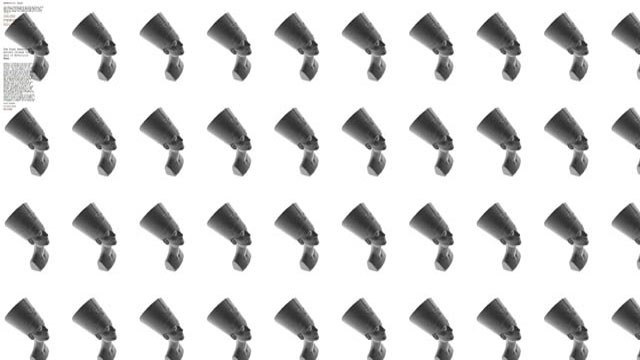
-
 Niklas Wolf
Niklas WolfIn ancient Egypt there was an elaborate system of reproduction around representative works of art. Gypsum casts of royal statues ensured that images of rulers were comparable and consistent nationwide. The formal type of a portrait bust, however, is as special as the material of Nefertiti’s representation. Stone figures, combined with a publicly effective installation, corresponded to ideas of permanence and a ruler’s longevity. The stone bust’s surface is coated with gypsum, which enabled a particularly fine design, and brightly coloured paint. The latter is preserved in its original condition (Tyldesley 2018).
Technology, material, surface and the design of the object play an important role in Nora al-Badri and Jan Nikolai Nelles’ project The Other Nefertiti (Pinther 2018). This project intentionally raises a number of questions that refer to discourses about provenance and access to both one’s own and foreign cultural assets, as well as their relocation. Moreover, it points towards a possible democratization of globally significant, mobile artefacts. What happens to a visual object when it is reduced to the essence of its digital data? How can digital processes and media be part of such discourses, and even possibly their solution? As part of an artistic intervention, the two artists penetrated the space of the museum and photographed the bust with concealed scanners, from which they were able to generate a multitude of detailed data to create a 3D print. Within the framework of a Common Creative License, this data is accessible online to the general public and provides “immaterial material” for future images as well (Nelles 2016). Anyone with access to the Internet and a 3D printer will therefore be able to print a copy that corresponds to the shape of the original, thereby democratizing the cultural asset. This gesture directly counteracts how strongly the accessibility of such assets are typically regulated – not even amateur photographs are permitted in a museum context, as the Berlin State Museums (Staatliche Museen zu Berlin) retain sovereignty over the object and its image. Both the generation of the data and the symbolic return of a Nefertiti copy and its burial in the Egyptian desert were documented on film. The project thus becomes part of a discourse critical of museal practices such as those of the Berlin State Museums: in reaction to the publication of the data, they referred to the legality of ownership, the ban on photography and the possibility of various – strictly regulated – accesses to the object and its reproductions. (SPK 2016)
Questions of accessibility and the relocation of cultural assets were also the topic of a seminar held at the Ludwig Maximilian University in 2019. A female student, who gave a lecture on the relocation of Nefertiti, contributed to the discussion by printing a Nefertiti bust using data from the Nefertiti hack. In contrast to the Berlin original and a printout based on Nelles and al-Badri’s data, this bust was greatly reduced in size and made of fluorescent material. A significantly expanded conception of art developed amidst questions of reproducibility, reproduction, aura and figurative trademarks. Unlike the officially signed copies produced by the Berlin Gipsformerei, these replicas are made at a greater distance from the original. No direct contact is necessary, the distribution is globally possible. There are several processes of translation and transformation that create new networks between bust and recipient. First, an immaterial object – the data set – is created, which gains new materiality through printing. The latter is freely scalable, a series of enlarged or downsized reproductions can be made, which would nevertheless correspond in scale to the dimensions of their source; materially, a Nefertiti created that way would never (want to) correspond to the bust of Nefertiti. Artists thus become the authors of new “truthful” objects. The story of the original begins to overlap with the narrative of its reproduction: the intriguing story of outwitting and interrogating the museum becomes an immaterial and performative work of art, which exists on an equal footing with the shapeless dataset and the multitude of printed and altered Nefertiti busts.
What can an object do as a representative? Which discursive spaces does it operate within? What kinds of questions can be asked of the original and copy? Which terminologies are capable of describing new metamorphical translation processes and aesthetics?
Critical comments on the Nefertiti project point out that simple, transportable scanners would not be able to capture images that would allow such high-resolution data sets. It is possible that Nelles and al-Badri gained access to professional scans commissioned by the Berlin State Museums or that they themselves had a replica of the bust scanned (SPK 2016). Both remarks are difficult to verify after the fact and do not affect the intention of the project.
Little is known about Nefertiti’s life; she encountered the global visual memory through a singular object, the portrait bust exhibited in Berlin, which stands for timeless glorified beauty and power in its own right. Questions about the accessibility of such images are already inscribed in the contexts in which they were created. In the ancient Egyptian tradition of exhibiting, powerful pictures worked between showing and concealing, they functioned as temporarily enlivened representatives of royal or divine power (Hornung 1971). Closely bound to constantly changing contexts of religion and rule, they had a constitutive memorial function in society, represented absent power, and were threatened by iconoclastic destruction. With the beginning of the colonization of the African continent by Western powers, Egypt’s cultural heritage was of particular archaeological and political interest to both public and private collections, as well as the art market.
(Read more on the history of the Nefertiti bust and the concept of partage...)
In contemporary terminology used to discuss ancient Egypt, terms of similarity (likeness) were summarized in discourses between original and copy: tut means (perfect) similarity; image, role and model coincide in one object and correspond to each other. Tut ankh is a living image (Tyldesley 2018) – (…) conceptual art was designed to represent the exact nature of a thing or person in the simplest way possible (…) (Tyldesley 2018). Perhaps the busts of Nefertiti – the dislocated cultural artefact in Berlin, as well as the multitude of possible reproductions from 3D printers worldwide – fall into very similar transcultural categories of representative likeness.
Delve deeper into the reception history of the bust.
References
- Hornung 1971: Hornung, Erik. Der Eine und die Vielen. Altägyptische Götterwelt, Darmstadt 1971
- Nelles 2016: Nefertiti Hack. Artist homepage: http://nefertitihack.alloversky.com (25.01.2019)
- Pinther 2018: Pinther, Kerstin; Weigand, Alexandra (Hrsg.). Flow of Forms / Forms of Flow. Design Histories between Africa and Europe, Bielefeld 2018
- SPK 2019: Stiftung Preußischer Kulturbesitz: „Nefertiti Hack” ein Schwindel?, 09.03.2016. http://www.preussischer-kulturbesitz.de/meldung/article/2016/03/09/nefertiti-hack-ein-schwindel.html (25.01.2016)
- Tyldesley 2018: Tyldesley, Joyce. Nefertitis Face. The Creation of an icon, London 2018
published February 2020

-
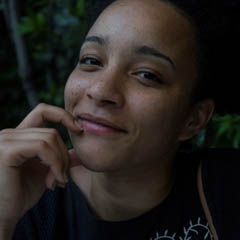 Leonie Chima Emeka
Leonie Chima EmekaIn 1682 a prominent French portraitist named Pierre Mignard (1612-1695) painted a large canvas of Louise de Kéroualle, Duchess of Portsmouth (1649-1734), one of many mistresses to King Charles II of England. The artist depicts her in a richly adorned dress, sitting on an upholstered bench against the background of a stone balcony that opens to a stormy sea. With one hand Louise de Kéroualle gently embraces her page, an African child. The fashion to hold black slaves, especially children, climaxed in the late fifteenth century, but also throughout the seventeenth century slaves were present in wealthy European households as servants.
Mignard’s painting lines up with other paintings of prominent provenance featuring African pages as an attribute of wealth: Titian’s Portrait of Laura Dei Dianti from ca. 1523 and Cristovao de Morais’ Portrait of Juana of Austria from 1535-1537 both depict an Italian respectively Portugal-based noblesse in company of an equally well dressed young African page. Like the duchess Louise de Kéroualle, Duchess of Portsmouth the young female page, whose name is not conveyed, is dressed in beautiful European clothes. More peculiar however is the child's expensive pearl necklace. In the late seventeenth century pearl necklaces were a fashionable accessory for European women of extensive wealth. Imported from the Caribbean, Pacific and Indian Oceans initially by Iberian traders — later also by British and other European traders — the white, oval shaped pearls were an important trading good and symbol of prosperity and wealth. As such the valuable jewellery seems rather out of place on the neck of the page. It seems much more appropriate on the neck of the Duchess.

Fig. 1, detail
Compared to her page, the Duchess’s jewellery appears almost humble, as she wears the same pearls on small earrings. In a much higher amount, the same pearls are mirrored in a shell that the laughing child offers to her serious looking owner. In the other hand the page holds a red coral; a material that has become exceedingly valuable in many regions of West Africa. The most famous example is the kingdom of Benin (today in the region of Nigeria), where the red coral rose to a symbol of royalty and was appointed for the exclusive use of the Oba (Benin sovereign) and his household. The red coral in the hand of the African child connects the picture to the intercontinental trading network between Europe and Africa.
European merchants traded red corals from Mediterranean regions with West African traders or sovereigns in exchange for goods such as gold, ivory or slaves. In all her appearance, from her beautiful dress to her valuable attributes the representation of the African page refers to the trading network, which preceded her presence in the picture next to the Duchess. The servant acts as an attribute of wealth — well-dressed she represents the wealth of the person and house to whom she is made to belong to.
On the other side of the equator, there can be found relief works to a similar effect that allows us to further investigate the historical intercontinental trading network. Many brass reliefs, produced by the royal brass workshop in the kingdom of Benin in the 16th and 17th century, acted as attributes of economic and political power of the royal court. They represented the influence of the sovereign and the wealth of the palace where they were exhibited. A large corpus of brass plagues adorned the palace, which was the economic, religious, political and administrative centre of the kingdom of Benin. One example, currently in the collection of the anthropological Museum in Berlin, depicts two dignitaries flanked by two Omadas (palace servants) before the background of the royal palace. All of them wear pearl ruffs and headgear made of corals. Similar to Mignard’s painting, the corals also function as indicators of the far reaching diplomatic relationship of the Benin palace and symbols of the interregional economic influence of the royal household. The main trading partners to the kingdom of Benin had been Portugal and later Great Britain to whom they sold slaves, gold and ivory in exchange for brass, corals and weapons. However dissimilar the artistic technique of oil painting and brass relief might seem, in the coral they share iconographic meaning. The commodity of red corals make reference to the trading network between Europe and West Africa.
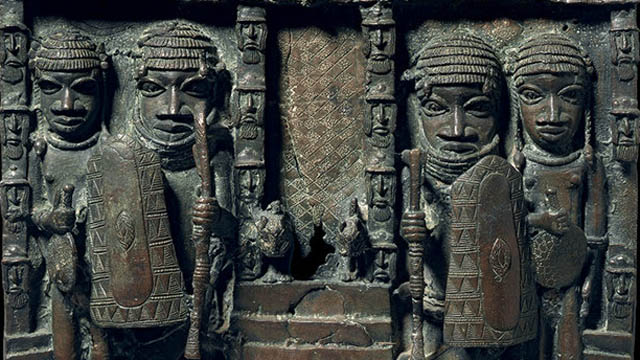
Fig. 2, detail
The trading relationships between Great Britain and Benin which were highly profitable for the rich and powerful in both kingdoms would change successively to an exploitative relationship; the final step to colonial subjugation was the British punishing expedition in 1897, which ended in the destruction of Benin and the robbery of the brass relief plaques to London, from where they were sold to institutions and private collections in Europe, the two Americas and Australia. Until today the royalty of Benin as well as the state Nigeria ask for restitution of the brass relief plaques and other works which were taken by the colonial power of Great Britain.
Peculiar about the Benin brass relief are the Portuguese heads that are engraved on the four palace columns in the background of the effigy. The Portuguese have a distinctive appearance with long straight hair and astonishingly long, pointed noses. In other reliefs the Portuguese are often depicted with Manillas, a ring in the shape of a horseshoe. The foreign metal of brass was imported to Benin by Portuguese traders. The valuable material, an alloy of copper and tin, supplemented cowrie shells as currency in the kingdom. As such the reliefs which adorned the royal palace were made of a material that circulated as money. The Portuguese merchants are depicted on a material which was an important means of their trade. Similar to the child holding the means of her enslavement in her hands, also the Portuguese heads are represented on and with the commodities which preceded their appearance in the imagery. Also British traders were depicted on brass reliefs, mostly with the attributes of armours, weapons and helmets.
At first glance the painting and the brass relief do not have much in common and a comparison seems rather pointless. One is an oil painting by one of the most famous portraitist of his time. The other was made by the prestigious royal brass workshop of the kingdom of Benin. When taking a closer look, however, one finds that both images — however different the outcome — both reveal similar means of constructing an image and its motive behind. The assets and people flanking the depicted patronages in the center of each image — on the one side the pearl necklace, red coral and the enslaved child, on the other the red corals, the manillas the Portuguese heads — build a network within the image that reflects on the economic trading network between both kingdoms. As both images were produced in the context of a royal court, and both intend to depict their far reaching trading relations, they may serve as documents to the complex histories and relations between the two kingdoms and if seen as such, may illuminate an important part of shard history that preceded the colonial era.
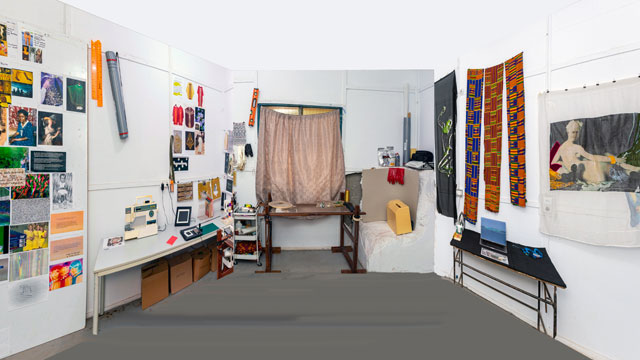
-
 Priscilla Kennedy
Priscilla KennedyCONNECTING THE DOTS
A Pilgrimage.
My studio is literally a skein; an element that forms part of a complex whole. Everything that forms part of its composition to me is like a thread being pulled through the eye of a needle to form a tapestry of narratives as body of works. I have absolutely no idea of what impact the connection of these dots/knots will fabricate or the entirety of its arrival and that to me is where I get immersed in roller coaster of jouissance. That is how the idea of process even in the most pleasurable way becomes an integral part of the context in which I work as an artist.
Unravelling.
Here, I connect the dots/knots within the current situation running through my artistic journey. The space in itself has multiple sub spaces I call ‘moods’’. I swing in-between these moods literally in pursuit of a certain expression towards my interests and concerns. These mood swings take off from my IDEA BOARD (https://www.explore-vc.org/en/galleries-content/idea-board.html) where my thoughts appear partially in flesh. That for me becomes my point of departure into streams of decision making. In totality, it’s a snapshot of all my thoughts as a cohesive whole where I can make choices guided by my ultimate motivation at a given time, on a particular body of work.
Then I swing into my RED BOOK (https://www.explore-vc.org/en/galleries-content/red-book.html) where I narrow down my thoughts into writings as part of a research. In transition from the previous mood of writing to this new mood is the optimum to my purpose, which refers to the making or the tangible expression. I deliberately swing back and forth between these two moods to create a certain dialectical relationship between them as a deliberate and crucial aspect to my practice. This opens up my explorations and discussions of the subject of the body, the politics of marginalization and subjugation from a feminine perspective with the use of materials and techniques connected to a certain body presence (craft).
Enchanted by the Familiar.
I see the body as a fluid material that morphs with time or momentarily based on certain conditions or instances. It is like that one thing that is connected to several things. I am interested in that materiality of the body that allows it to be transient. And in terms of that materiality, what it can become and what it can do.
So, to me, the idea of the female body aside its continuous flux is my interest in something about it that creates a permanent or ongoing relationship with itself. That is how the idea of the hand with regards to craft becomes crucial to my practice. This is in reference to its past and present subtle association with subjugation or oppression or basically how the idea of subjugation and oppression is tied to work categorized in the frame of the domestic. That sense of marginalization or the coupling of an idea to a body that makes it lay claim to a certain power absence is of interest to me.
With the hand, I rethink the value of craft.
Through that there is already an acknowledgement of a certain distance that is brought back to close proximity with the body through intimate artistic approaches like thread embroidery and tambour beading. This is where I swing to my TAMBOUR TRESTLE SPACE (https://www.explore-vc.org/en/galleries-content/tambour-trestle-space.html), here, I make laborious and intimate embroideries that feature beads. I perceive this process of beading as a metaphor in reclamation of the self, while highlighting the residue of power that still lingers within the very same system of subjugation. It is a subtle performance that happens in the studio yet inherent to the context.
A thousand Yards Away and Within.
I am tempted to refer to my whole studio as a bigger idea board where certain themes and artistic strategies come together to form narratives and contributions to subjects of interest. In constant exploration and experimentation, a mash up of all these themes and artistic strategies may birth a work of art that offers a blend of fabric cut-outs merged with beaded patterns or forms in the current state of my practice. Yet, I am open to exploring diverse forms of expressions in relation to the context as time goes on.
Absorbing the Far Fetched.
I connect with materials from a perspective where I perceive them as political instruments that exist in time and not only as objects of enjoyment. I believe in the idea of a common vocabulary in the use of familiar materials and objects because they inherently possess personal and cultural meanings from spaces they have been.
In Pursuit of…
If I’m to imagine my destination (the ideal work) from the swinging I’ve been doing for some time now, I assume I’m going to arrive at a magical tapestry composed of fabric cuts outs of feminine bodies fused with other forms of embroidery that may features threads and beads. These materials and artistic approaches may be composed to create fantastical characters, emerging out of a playful hybridization of the human body and sometimes other life forms.
My destination may not be a narrow one, I believe, but one of diverse interesting processes where I can achieve limitless possibilities in my creative projects. The narratives within the symbolic realm of imagery seek to emancipate the oppressed feminine body through a material and technique culture.
 Ernst Wagner
Ernst Wagner
Fig.2 & 3: Table in front of the window with bead embroideries (Photos: Priscilla Kennedy)
In the photo we see the artist's studio; in it, work tools (such as rubber gloves, a sewing machine, rulers), materials to stimulate the artistic process (e.g. image sources, sketchbooks, materials) and artistic work results. The room is painted white, even the crumbling block in the right-hand corner. This echoes the idea of the "white cube" with neutral walls as a currently still valid basic model for exhibition spaces of contemporary art. Everything is very clean and tidy. On the three tables in the room, materials and tools are arranged like in a still life. For example, on the table in front of the (curtained) window, an arrangement showing, among other things, a round embroidery frame with a bead embroidery that is not yet finished: work in progress. Everything is obviously deliberately placed in this museum-like working space, which thus develops a programmatic expressiveness.
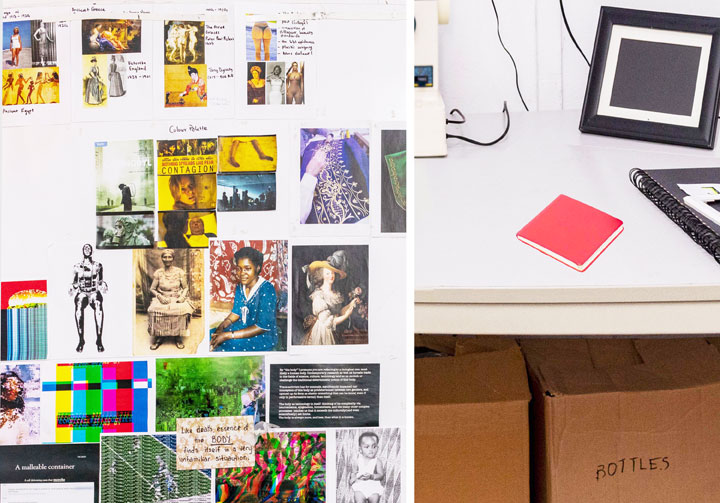
Fig. 4 & 5: Print outs on the wall, red book (Photos: Priscilla Kennedy)
Fabrics, textiles play a major role in this scenario. They are simply material (the kente fabrics on the right) or supports for the two larger works (also on the right). But they also play a major role in the many pictures (DIN A 4 printouts on the left wall), now as depicted clothing: women's dresses in older prints, on works of art (from ancient Egypt) to more recent photographs. Surprisingly, there are images of the vestments of Catholic priests and, beyond that, abstract fabric patterns, ornaments. Working with fabric (which also includes the embroidery frame) is repeatedly found as an important field of work for feminist-oriented artists or for a feminist-oriented visual language in contemporary art.
The DIN A 4 printouts are partly annotated in writing, which reinforces the impression that we are dealing with a "picture atlas" in the sense of Aby Warburg or an "atlas" in the sense of Gerhard Richter, i.e. an often surprising compilation of pictures which in this combination can or should provide very systematic suggestions for pictorial design and for reflecting on contexts.
This also includes the other collections of pictures in the room, in the photo album, on the computer or in transparent sleeves (on the right-hand table), which are obviously often biographically oriented, for example through the baby and children's photos, or through images of their own artistic works.
The overall picture is thus dominated by central aspects of current "global art", an art that could just as easily be shown in Berlin or New York. In this one, however, site-specific aspects, i.e. aspects related to Kumasi, Ghana or West Africa, emerge again and again: the kente fabrics, the photos in the album, even the materiality and construction of the walls speak of the place of origin.
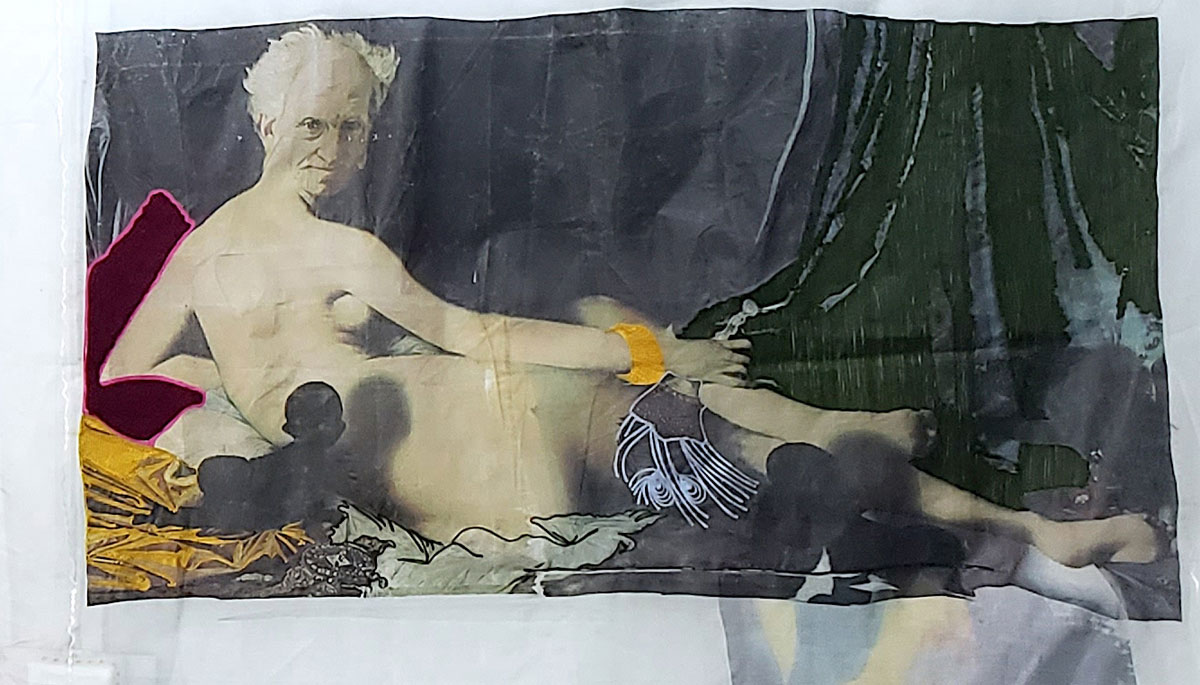
Fig.6: Priscilla Kennedy, o.T., experimental study (courtesy the artist)
This coming together of different thematic layers becomes clear once again in a detail, the painting that the artist presents in her studio on the right wall and which she herself sees as a technical experiment (see illustration below).[1] It shows an adaptation of Ingres' painting "Great Odalisque" from 1814, now in the Louvre. The superimposed head of an older white man (Arthur Schopenhauer) is reminiscent of the same pictorial strategy that the Guerilla Girls successfully tried out with the odalisque in 1989 by putting a gorilla head on it ("Do women have to get naked to get into the Met. Museum?"). While the other elements of the work vary the forms from Ingres' painting, mainly in colour and technique, there is one crucial addition in this work: a small baby in silhouette, black, looking up at Schopenhauer and casting a shadow on the pale odalisque body. The whole thing is printed or embroidered on a transparent, light fabric that throws folds.
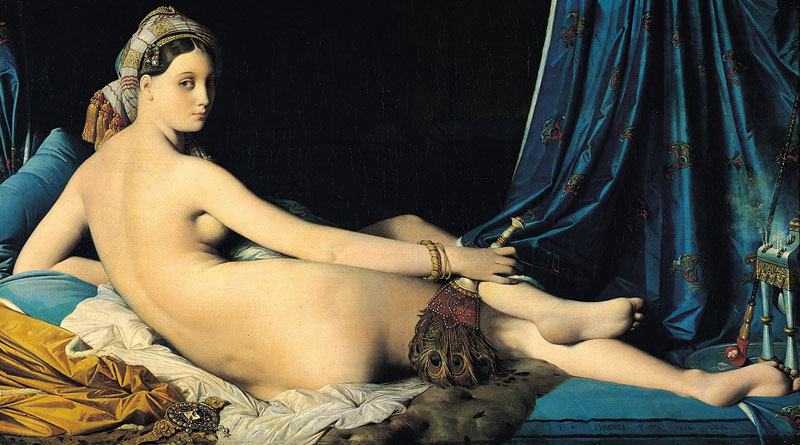
Fig. Ingres, The Great Odalisque, oil on canvas, 1814, Louvre (Copyright CC)
These references make the picture seem familiar to Europeans, but in its combinatorics and with the harsh contrasts it is enigmatic, just like Kennedy's studio itself. Here, an icon of Western art is cheekily alienated, here the canvas becomes a thin nettle, here the woman becomes a man, the soft cushion becomes a hard wedge, the white woman gets a black baby. On the one hand, objects and their meanings are thus unambiguously designated and named, but at the same time, through the artistic formulation and its combination, they are placed in an enigmatic resonance space, which immediately eludes the unambiguous settings that have just been made. An "in-between space" between black and white skin colour, man and woman, opaque and transparent, old man and young child, European (old) art and West African (young) art.
If one looks back through this image (which is taken here - against the artist's intention - as a key image) to the studio, one finds very similar constellations there: empty chasubles of Catholic, i.e. male priests against female bodies in erotically charged clothing, falling, soft fabrics against rigid measuring instruments from geometry lessons, physicality against abstract patterns and ornaments. With such contradictions Kennedy creates an experimental constellation, she spans a field that reports on possibilities in between without letting them culminate in a final work. The open, unfinished field of experimentation thus becomes the actual "work".
[1] "This work does not have a title. I considered it as an experiment to try printing with a blend of embroidery. What is actually piercing through from the back is also part of the experimental process where I made heat transfers again behind the fabric to see the interplay of images from various directions of the material. I do not consider it as a work but as an experiment. " (Information from Kennedy to the author via email on 5.10.2022)
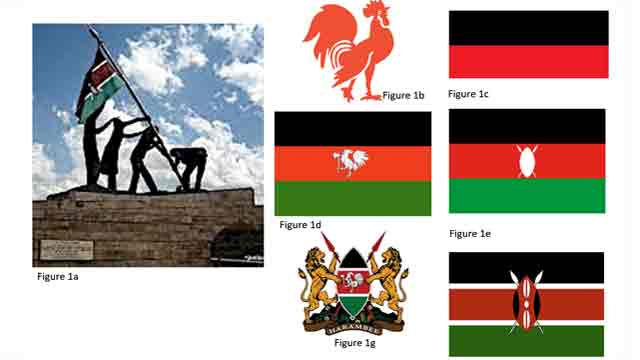
-
 Donna Pido
Donna PidoKenya’s Independence monument resides at Uhuru Gardens in Nairobi (Figure 1a), most likely because this is where received Independence (Kiarie 2022). Though only a few people visit Uhuru Gardens and get to see the monument, it reminds us of 12 December 1963, the day of Independence and when Kenya Army soldiers first raised the national flag on Mt Kenya. Mau-Mau and other guerilla soldiers see hoisting the flag as a visual symbol of military victory over King’s African Rifles and their British collaborators though some felt it is the same collaborators who inherited power from the British (Branch 2007). In this context, Independence is remembered as a military defeat of the British sense of military invincibility. However, a political class comprised of ‘under-educated’ intelligentsia saw Independence as an intellectual contest and a defeat of so-called colonial arrogance. Rural dwellers, on the other hand, seemed spectators with the view that Independence was coming ready with ‘owners’ (politicians, businessmen and educated elite). That Independence has owners who enjoy it while rural remain on the sideline is evident the persistent poverty thriving in rural Kenya (Njeru 2018). So, even Uhuru Gardens and the Independence Monument have ‘owners’ who are not rural dwellers; it is clear that the monument is the collective memory and visual culture of its ‘owners’.
It seems the majority of rural dwellers understood Independence according to what politicians said- wealth as the accumulation of money, health as getting treatment in hospitals, education as attending school and passing examinations (Kenya African National Union 1969). We are not sure they are able to read and understand the Independence monument at Uhuru Gardens. Why KANU did not install the rooster at Uhuru Gardens draws considerable curiosity. That is beyond our scope here. One with a thick African cultural knowledge could easily choose the image of a rooster instead of that of hoisting the national flag because KANU was a nation-wide party and the rooster has cultural meanings nationwide. Among the Luos of Western, establishing new homesteads entailed carrying an axe and rooster to the site of the first house; this ideology is well-represented in the KANU flag (figure 1d). In other parts of Kenya, the rooster is a symbol of manhood required to make many children (Wikipedia. 2022). By crowing early in the morning, the rooster does not simply announce time but also sets the work-eat-rest rhythm of life in rural areas.
Before discussing WWII monument and of pre-Independence flags, we want to briefly address meanings in choices of colors and other elements in party flags and the national flag. The black, red and green stripes in KAU, KANU and the national flag have the same meanings. The black stood for the indigenous population, red for the common blood of all humanity or blood shed during the struggle for Independence. Green symbolized the nation’s fertile land or landscape of the country, while the weapons were a reminder that organized struggle was the basis for future self-government (Smith 2001). No doubt the shield and spear are common traditional Kenya tools of offence and defense. It is said that white represented unity and peace. It is rather clear that a section of Kenya’s coat of arms is modeled on KANU’s flag- colors and the rooster carrying an axe. Meanings herein are similar to those we mentioned in our discussion on KANU’s flag; the shield and spears also bear the same meanings as we mentioned when discussing the national flag.
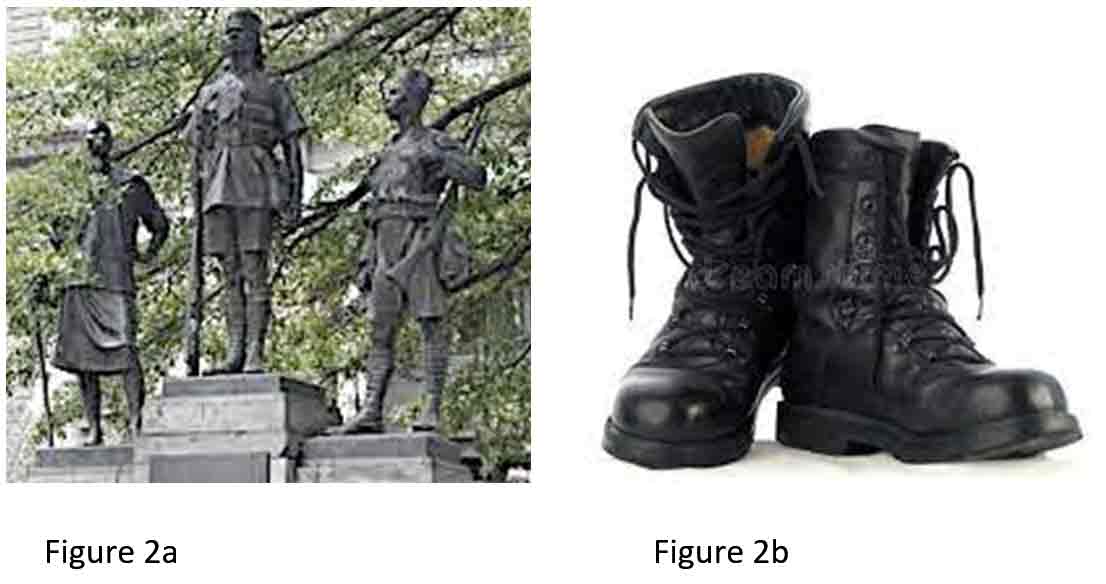
The combat boots (Figure 2b, Internet sources) tend to strike a note that is closer to the Acholi collective memory of WWII because they refer to it as too bin (Acholi for ‘come ye death’). Among the Acholis of Northern Uganda, the combat boots symbolize the massive death in the War and the sacrifice of people forced to be loyal to the King of England. There is quite a stark contrast between the intended collective memory and the actual one. At least among the Acholi, the boots are infinitely more meaningful that the bronze images so hapless servant/soldiers.
Many of us in Kenya may not be able to remember the pre-Independence flags presented here because they were in use a long time ago. Between Indonesians, Indians and Arabs, we are not sure on who first visited Kenya. However, Arabs came in greater numbers over a longer period, intermarried with the local population and eventually set a government with the Sultan of Oman as its emperor or king. We included the flag of the Sultan of Zanzibar (3a, Internet sources) as a part of the visual culture of Kenya. The flag does not fly anymore but Arab dhows and their sails are prominent visual feature at the coast of Kenya. History has it that the Portuguese followed and displaced the Arabs and built Fort Jesus- we included Portuguese flag (3b, Internet sources) of that time since we consider it a part of the visual culture of Kenya at that time. Apart from Fort Jesus in Mombasa and the Vasco da Gama monument in Malindi, there seems no outstanding visual feature that rigorously reminds us of the Portuguese.
We turn now to the World War II monument standing on Kenyatta Avenue, Nairobi (Figure 2a, Internet sources). Our action was driven by the thought that the monument is also a reminder of how Africans were roped into a war they did not start, meaning, they did not have any special interest in the war. While the British saw this monument as honoring the regional war dead, we remember our own who died in North Africa, Burma or elsewhere as WWII raged. In any case it would have served us Kenyans more meaningfully if the monument had represented Kings African Rifles in action instead of as the transport company that was its main function. The figures of this monument are just standing as if posing for a photograph.
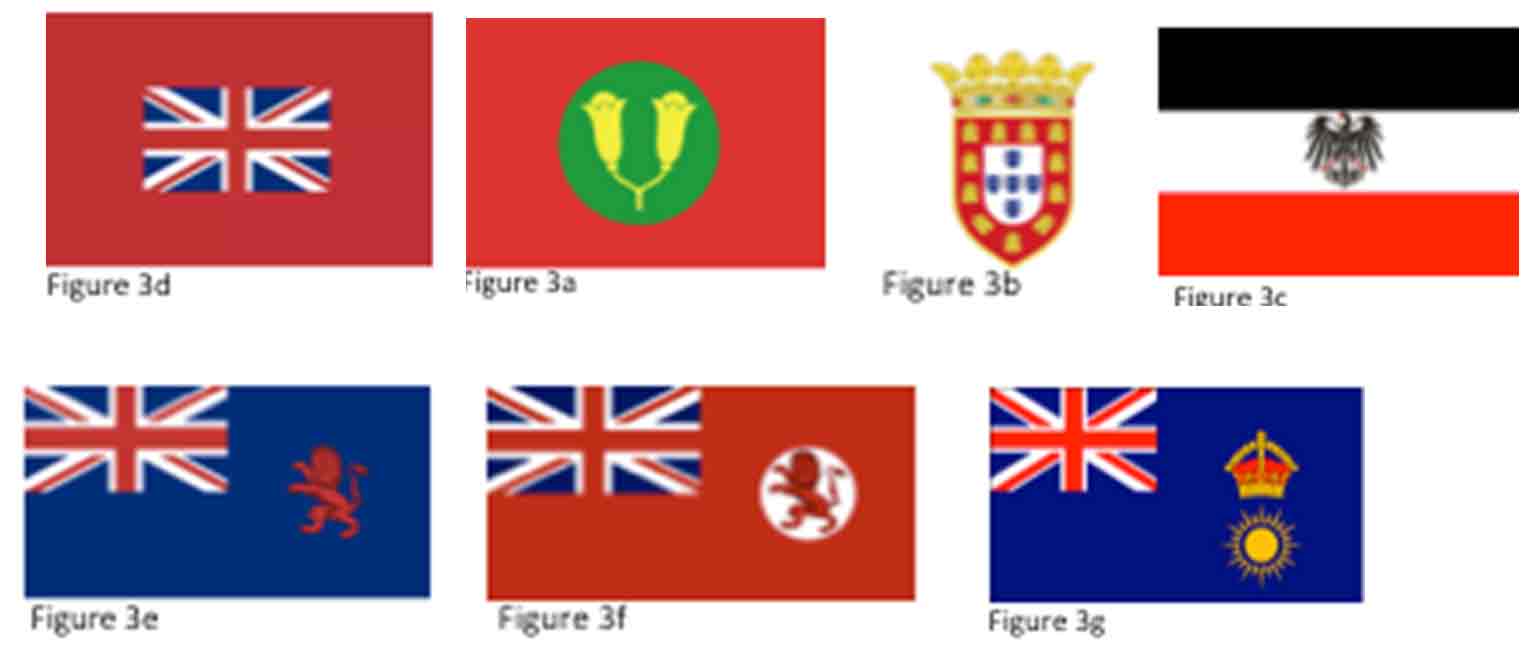
The eagerness related to the partitioning of Africa and the establishing of colonies saw the Germans come to Kenya and German East Africa (Tanganyika) where the German flag flew (Figure 3c). Heller, the German coin is the most outstanding collective memory of German East Africa; old folk still refers to coins as heller (hela, eeera, Figure 4a and 4b, Internet sources). Though rupee was more popular as an Indian coin, it was also used in German East Africa and its name was integrated into many languages that still use it to mean ‘money' (Figure 4c, Internet sources).
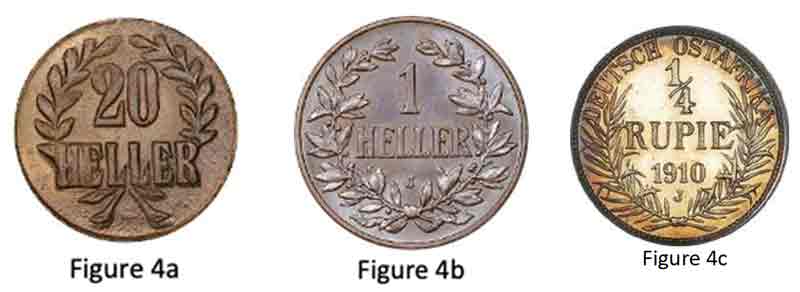
Some people think that if Germany had won World War I (WWI), East Africa would have been a German colony. But that was not to be; various parts of East Africa were under Brisstish rule until Independence in the early 1960s. The Witu flag (Figure 3d) was hoisted soon after the British drove Germans out of East Africa, this was followed by the British East Africa flag (Figure 3g, Internet sources) and flags (Figures 3e and 3f, Internet sources) were used in Kenya colony, specifically. The Union Jack was prominent in flags for British East and Africa and Kenya Colony. British influence is massive in Kenya and related visual culture is so massive that it deserves more attention that is possible here. Meanwhile we note that the structure of Kenya’s coat of arms is similar to emblems and related devices that were in use when Kenya was a colony.
Summary of Discussions
We embarked on writing this article hoping to add to on-going efforts in exploring collective memory in Africa. Our short article touched on political collective memory including but not limited to past and existing monuments, flags, coat of arms and emblems. It is difficult but possible to argue that pre-Independence devices form a part of Kenya’s visual culture; we argue thus for believe that the past makes today as the present makes tomorrow. Heller, the German coin of colonial Kenya, provides one example of how past visual culture persists through time to be a part of the present and does so with little cultural transformation.
In this article, monuments, flags, emblems, coats of arms and coins provided fodder for discussions. It seems the Independence monument is a Government object that only officers of Government and the intelligentsia communicate with and use it to remember Independence and WWI. Kenyans who paid the price of WWI and Independence have yet to enjoy whatever benefits may accrue from the two. The once very powerful KANU that received Independence from Great Britain is now a pale shadow of the political party it was. However, its rooster remains a visually powerful emblem that speaks of time, space, majestic manhood and connection with the universe.
We do not know why KANU’s rooster is dwarfed in the coat of arms and is absent in the national flag. The absence or minimizing of such a powerful symbol can raise questions. For example, is it a part of continued colonization that thrives on suffocating local expressions? Or was it a matter dictated by non-Kenyan concepts of design? These questions need addressing soon and with more concerted efforts.
References cited
- Branch Daniel 2007: The Enemy Within: Loyalists and the War Against Mau-Mau in Kenya, in Journal of African History, Volume 48, Issue 2, July 2007, Cambridge University Press
- Kenya African National Union 1969: The K.A.N.U Manifesto, University of Virginia
- Kiarie Maina 2022: http://www.enzimuseum.org/museums-of-kenya/monuments/uhuru-gardens
- Njeru Timothy Njagi 2018: What is Driving Persistent Poverty in Rural Kenya, in: The Conversation https://theconversation.com/whats-driving-persistent-poverty-in-rural-kenya-99765
- Smith Whitney 2001: https://www.britannica.com/contributor/Whitney-Smith/4445
- Wikipedia 2022 Cultural References to Chickens: https://en.wikipedia.org/wiki/Cultural_references_to_chickens
- Woods Steven Paul, Weinborn Michael, Ryan Yangi Li, Hodgson Erica, Amanda R.J. Ng, Bucks Romola S. 2015 Does Prospective Memory Influence Quality of Life in Community-Dwelling Older Adults? in: Neuropsychol Dev Cogn B Aging Neuropsychol Cogn https://www.ncbi.nlm.nih.gov/pmc/articles/PMC4537668/
For further reading: Lydia Waithira Muthuma. How Public are Public Statues? (Public statues in Nairobi)
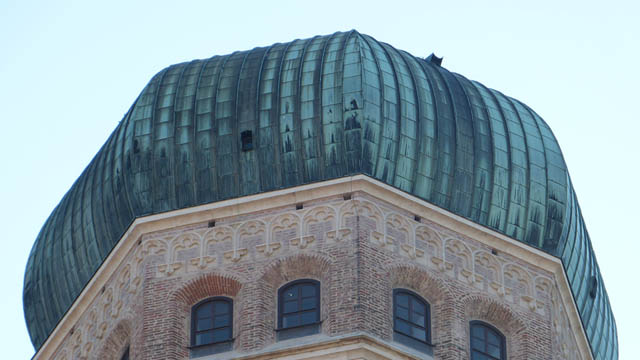
-
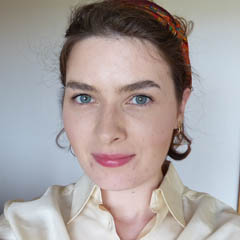 Rosa Pfluger
Rosa PflugerThe Eiffel Tower in Paris, the Sydney Opera House, the Empire State Building in New York – it is not uncommon for innovative and striking buildings to become symbols of the cities they were built in. Architectural landmarks turn into trademarks of their cities. They shape the city’s silhouette and make it recognizeable.
In Munich, a big city in the South of Germany and provincial capital of Bavaria, one of the most striking buildings is the Frauenkirche, which loosely translates to “Church of Our Lady”. It is dedicated to Virgin Mary, the Mother of Jesus Christ, who plays a big role in Munich as she is said to be the patroness of Bavaria. Its 99 meter (324 ft) high twin towers with the characteristic cupola roofs rise high over the inner city (as it is still prohibited to build any higher than them within the inner city). It is - by all means - not the biggest or even most beautiful church of its kind. Neither is its location in the city center, on plane ground and narrowly surrounded by pubs, shops and historic residential houses, spectacular.
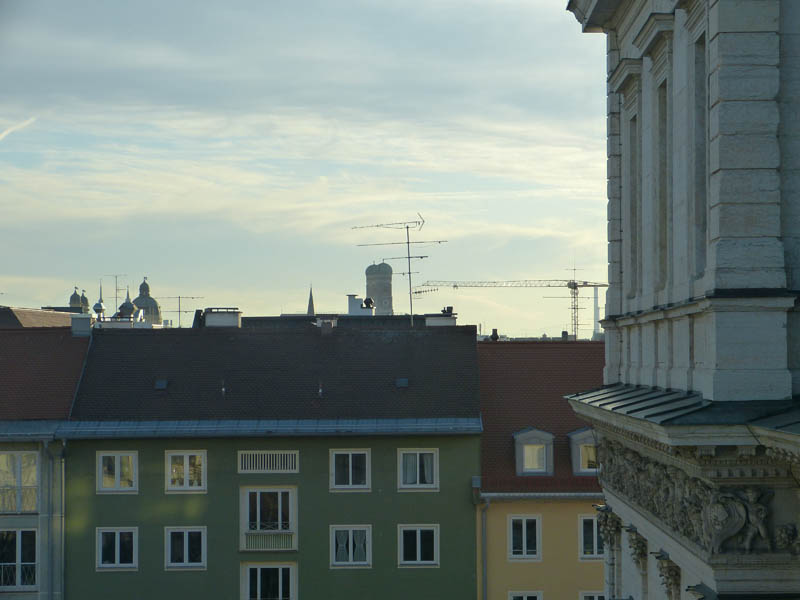 Up to this day, the Frauenkirche is the tallest building in Munich's inner city. View from the Academy of Fine Arts, Munich ©the author
Up to this day, the Frauenkirche is the tallest building in Munich's inner city. View from the Academy of Fine Arts, Munich ©the authorStill: The citizens of Munich have great sympathy with the brick building and identify strongly with it. There are several reasons for that: First of all, about 30% of the people living in Munich identify as roman catholic Christians and therefore have a religious connection to the 500-year-old church that is still in use for almost daily services. But the number of Catholics decreased drastically since 1925, when more than 80% identified as Catholic. In conclusion, there must be other reasons why this church is so important for Munich.
A people’s church
What makes this church indeed quite unique is the way it came to be: Munich didn’t lack any churches at all. In 1468, when the construction of the Frauenkirche was started, only 13,000 people resided there and there already was (and still is) a cathedral in the city center: Saint Peter’s church, or simply: Alter Peter (Old Peter). The Frauenkirche was enormously large compared to the city’s size and can house 20,000 standing people. It was built within only 20 years, which is faster than any other church in Europe at that time. The construction was probably initiated by the citizens – and can therefore be seen as a sign of confidence and emancipation of the common people in regard to the ruling class. (Which makes it all the more tragic that the towers were abused early on as platforms for cannons during the Landshuter Erbfolgekrieg at the beginning of 16th century, a war between two aristocratic families contending for heritage.) As a side note, Germany’s supposedly very first photography, taken in 1839, shows the twin towers of the Munich church.
Muslim towers on a German church?
The two cupola roofs made of oxidized copper give the cathedral its unique and unmistakeable shape. Originally, it was meant to be topped by gothic pinnacles (comparable to those of the cathedral in Cologne, Germany). But at the beginning of 16th century, architectural (and overall artistic) style changed drastically with the advent of the Italian renaissance. Pointed church spires suddenly seemed old-fashioned. And so, for more than 30 years, the two towers of the Frauenkirche remained “headless”.

Bernhard von Breydenbach, Peregrinatio in terram sanctam, 1486, woodcut (Creative Commons); The Temple area, 1920, Library of Congress; Blick auf die Türme der Frauenkirche vom Odeonsplatz aus. 2017, D. Fuchsberger (Creative Commons)
Lukas Rottaler, who was assigned with the construction of the roofs, was long thought to be inspired by Venetian churches, precisely the cathedral Madonna dell’Orto. Indeed, the 14th century Italian church has a high brick tower with a cupola roof that might look a little like the Frauenkirche, if you turn a blind eye. But the origins of the onion-like shape are assumed to reach way back and way farther: Rottaler probably saw a woodcut of Jerusalem, which shows the Dome of the Rock. This dome, erected in the 7th century and therefore the oldest edifice of the Islamic world, marks a place that is equally important for Muslims, Christians and Jews – the dome itself though is Muslim. That didn’t keep Rottaler from taking inspiration from the Dome of the Rock for his building project at a Catholic church in Munich. Hence, the Frauenkirche is shaped by originally “oriental” roof tops.
Moreover, many churches in the rural outskirts of Munich, which were built in the following centuries, are oftentimes crowned by bulbous cupola roofs. This drop shape, which contrasts the villages’ common saddle roofs, now naturally is a part of the landscape as well as of the baroque style.
The devil, a Munich sense of humor, kitsch, tourism and modern lifestyle
One more reason why the Frauenkirche is so important for the Munich identity are the many legends surrounding it, which are an inherent part of many children's upbringings. The story of the bet between the devil and the constructor of the church, master bricklayer Jörg Ganghofer is widely known among Munich citizens. Ganghofer bet his soul that in this church there would be no windows. As soon as the church was complete, the devil entered the back of the church through the main portal and looked around. Indeed – there were no windows visible! Of course, the church has big windows which let an even stream of light enter the gigantic room. Ganghofer skillfully placed the massive pillars framing the middle section of the nave so that they cover all windows from a certain point of view – and thus won the bet! The devil was outraged and stomped his foot on the ground. This footprint is still visible in floor tiles (image below). In his temper, lucifer left in a rush, which caused a chilly gust of wind that up to this day blows around the church.
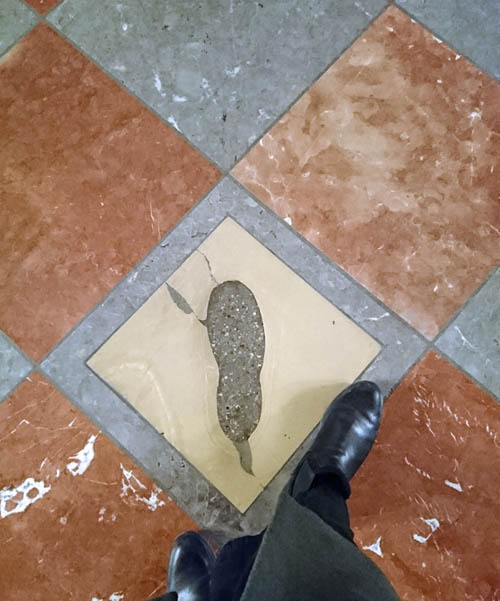
The "Devil's footprint" ©the author
There are many more legends like these surrounding the historical center of Munich. The fact that they are not forgotten but very much part of social life shows how much the people of Munich value their ancient traditions and customs. Also, these legends – and the legend about Jörg Ganghofer is a prime example for that – often showcase a certain sense of humor, mischievousness and boldness. Possibly typically Munich qualities.
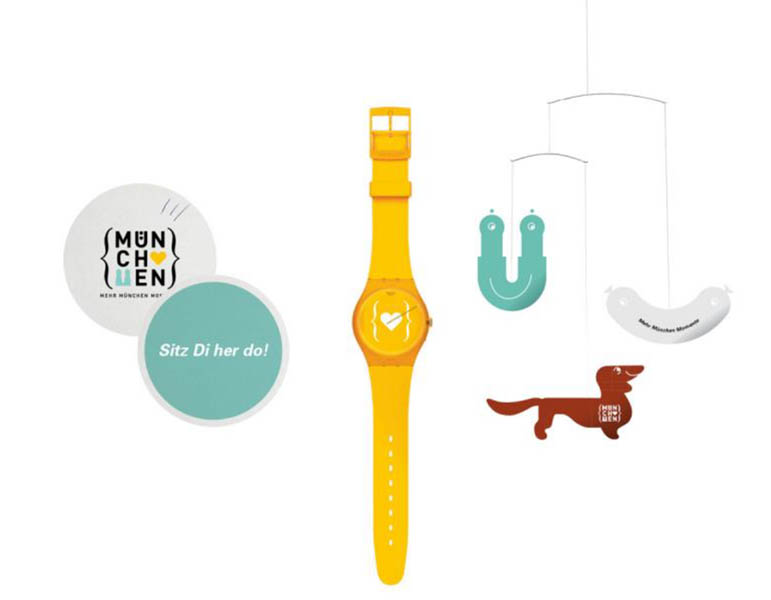
The unique twin towers as logo: A design for a Munich tourism agency ©Georg Schatz, schatzdesign.de
Today corporate logos, kitschy souvenirs but also everyday products reference the Frauenkirche’s silhouette. The Munich tourism agency „München Tourismus“ markets the city with the slogan “simply Munich”: approachable, hospitable, relaxed. It’s all about “Genusskultur, Kulturgenuss”, which translates to „culture of enjoyment, enjoyment of culture”. According to the agency, tranquility, love for old things and the so called “Bavarian cosiness” are trademarks of the Munich way of life. Compared to the daringness of Lukas Rottaler and Jörg Ganghofer, the constructors of Munich’s biggest cathedral, these qualities seem rather tame.
References:
- Forschungsgruppe Weltanschauungen in Deutschland: „München: Religionszugehörigkeiten 1925-2018“, https://fowid.de/meldung/muenchen-religionszugehoerigkeiten-1925-2018
- E. Wagner, S. Wimmer, L. Sedghi: Isar-Arabesken – Spuren des Orients in München, München (Alitera), 2013
- https://stadtfuehrung.info/stadtfuehrungen/zeitreise_muenchen_anhand_alter_fotos_und_bilder
- https://www.muenchen.travel/artikel/ueber-uns/die-marke-muenchen
- https://www.historisches-lexikon-bayerns.de/Lexikon/Frauenkirche,_M%C3%BCnchen#Der_Neubau_im_15._Jahrhundert
- https://www.venediginformationen.eu/kirchen/kirchen-in-venedig-teil-3/madonna-dellorto/madonna-dellorto.htm
- https://de.wikipedia.org/wiki/Tempelberg#Islamische_Bebauung:_al-Masdschid_al-Aqsa
- https://de.wikipedia.org/wiki/Frauenkirche_(M%C3%BCnchen)#Bau_der_sp%C3%A4tgotischen_Kirche
published November 2020
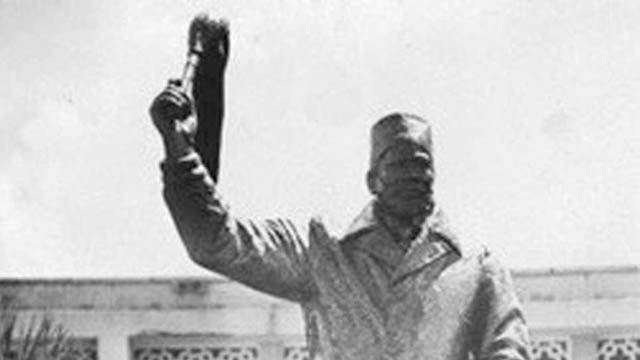
-
 Lydia Waithira Muthuma
Lydia Waithira MuthumaThe two statues
Walking around the rest of Nairobi’s city centre one comes across other statues that have no viewing restrictions. I comment on two of these that resonate, in a particular way, with the narrative of founding postcolonial Kenya: Kenyatta’s 1973 and Kimathi’s 2007 statues.
Kenyatta (c.1894-1978) the first president and founding father of postcolonial Kenya, had a second statue made out of cast iron, by James Butler, a British national. It was finished in 1969, shipped to Kenya and unveiled in 1973. It depicts Kenyatta wearing the robes of a university chancellor –he was the chancellor of University of Nairobi from 1970 to 1978. It stands in City Square.
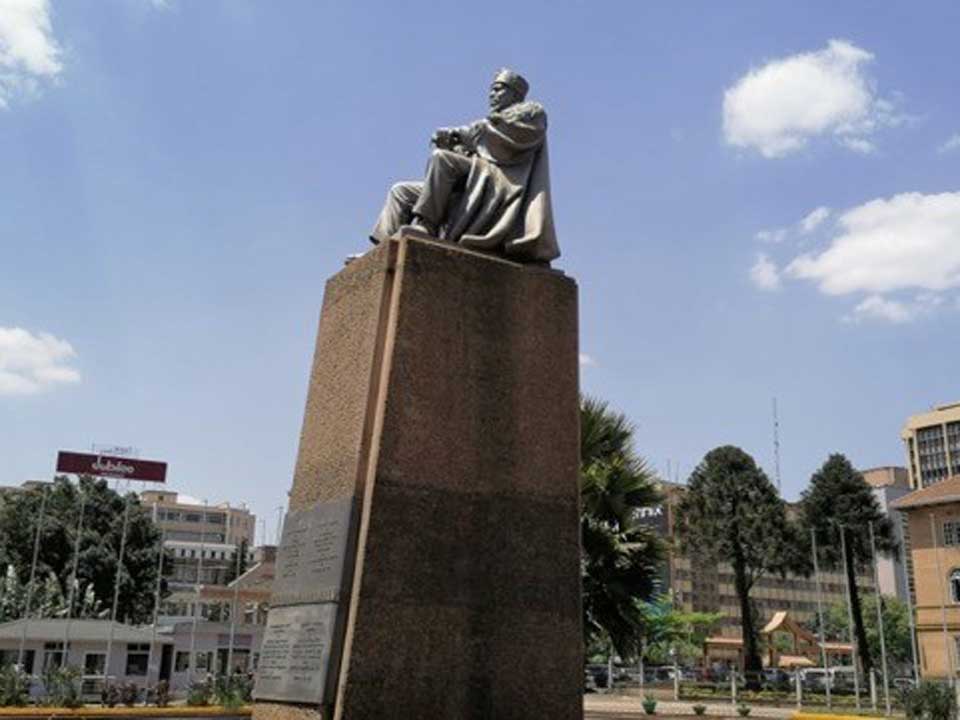
Figure 2. James Butler, Jomo Kenyatta, Nairobi, City Square, 1969 (unveiled in 1973), Bronze, 750 cm © Lydia Muthuma
Kimathi (1920-1957) also has a statue installed along Kimathi Street. He is the self proclaimed Field Marshal of the anti colonial Kenya Land and Freedom Army (KLFA) colloquially known as the Mau Mau. This movement was proscribed in colonial times and during the era of the first and second presidents of Kenya (1952-2003). But in 2003, Kenya’s third president, Mwai Kibaki, eventually unbanned Mau Mau and commisioned a statue in honour of Kimathi. The sculptor, Kevin Oduor, at the invitation of Kenyatta University's Department of Fine Art, made this statue.

Figure 3. Kevin Oduor, Dedan Kimathi, 2006 (unveiled in 2007), Bronze, 450 cm © Lydia Muthuma
The two statues (excluding the 1964 one) have similarities and differences that can be considered within the context of political history or through the artistic lens since they form part of Nairobi’s visual urban landscape. These statues represent two political figures, considered national heroes and therefore meriting public showing. Mass and volume, employed as the basic building blocks, are used to express emotional energy in a bid to engage the viewer’s affects. The chosen site of each statue (the situ) mediates the public’s affects.
Siting the statues
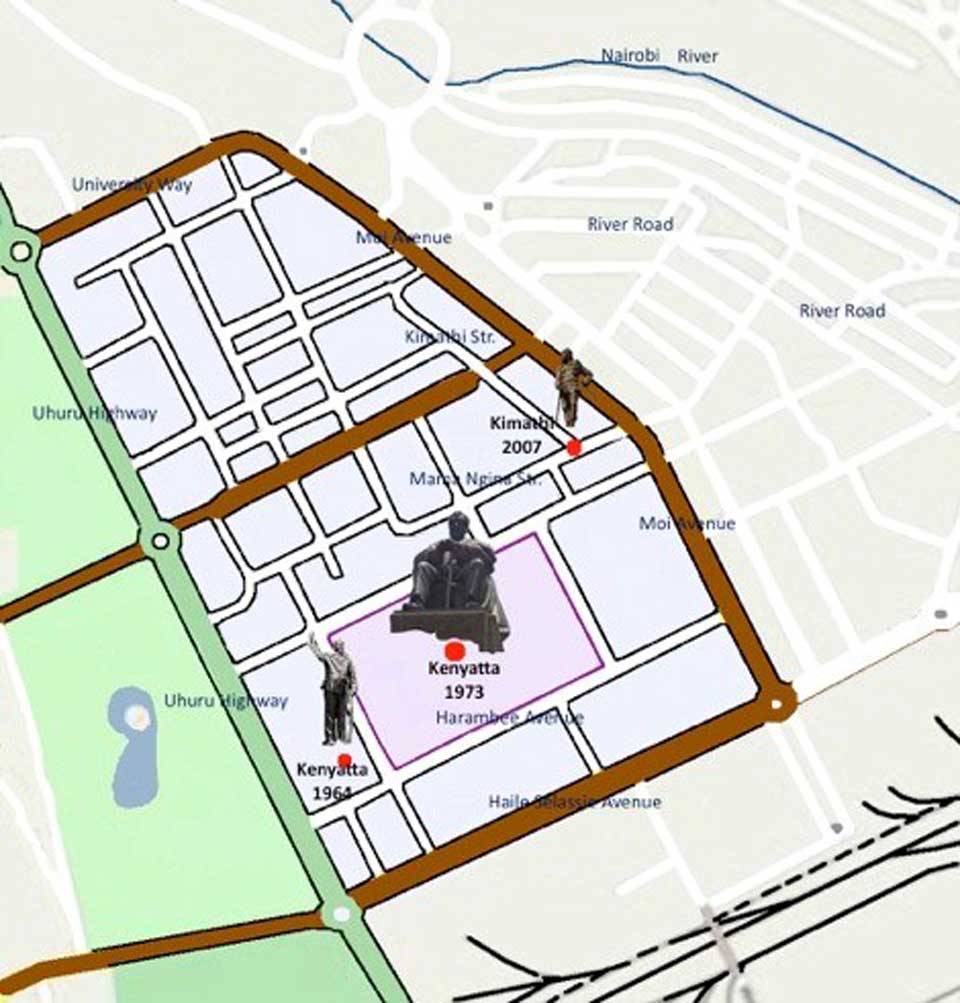
Figure 4. Location of the different statues © Lydia Muthuma
Jomo Kenyatta’s 1973 statue is placed in City Square with about one acre of land setting him apart from the surrounding buildings. Anyone walking into City Square, walks into this statue because it is the focal point. In traversing the square or accessing nearby buildings, one must pay visual homage to Kenyatta’s 1973 statue because of its setting; the geographical centre of the square (cf. figure 4 & 5).
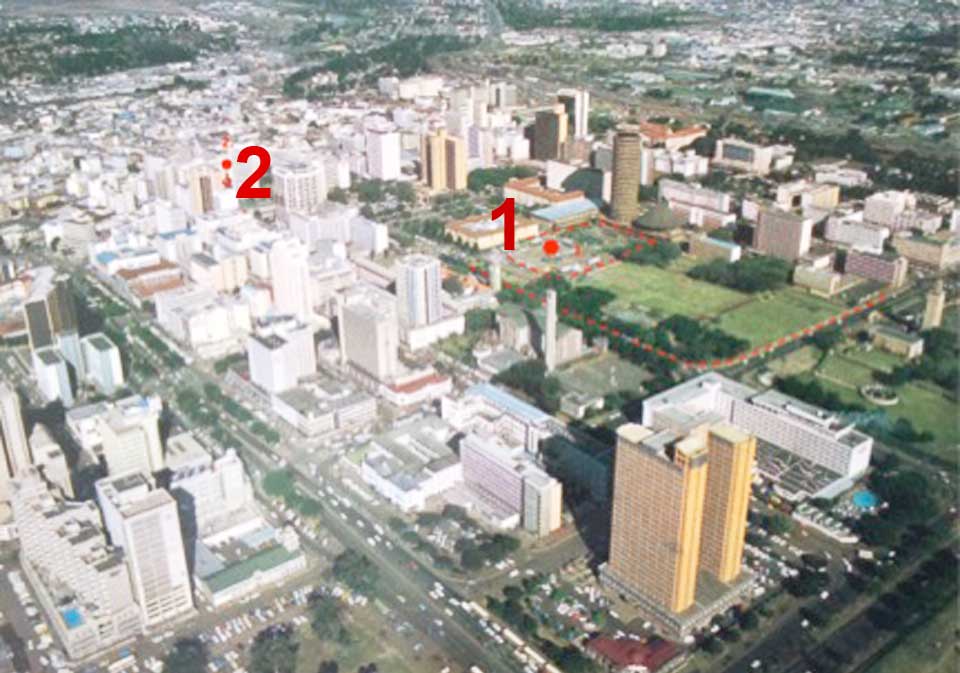
Fig. 5 City Square
Kimathi’s statue is set in different surroundings. By the year 2007 when Kimathi’s statue was installed, empty 1-acre plots, other than City Square, were not to be had in Nairobi’s centre. In fact a heroes' corner was designated about 5 km due west, in 2006, but was deemed unsuitable for Kimathi's statue. The street named for him, right in the middle of the city, was the preferred site. So on a tall plinth, Kimathi stands at the southern end of Kimathi Street. (cf. figure 4 & 5) There is hardly any viewing distance because Kimathi’s statue stands on a tiny traffic island, amidst tall buildings like Corner House (15 stories) and the Hilton Hotel (20 stories). The statue is in the middle of a busy traffic junction – where Mama Ngina Street meets Kimathi Street. And because it is immersed in both vehicular and pedestrian traffic, viewers are treated to short interrupted glances of Kimathi, atop a pyramid-like plinth that was designed by members of Kenyatta University’s Department of Fine Art. Fleeting, staccato snap shots that punctuate the flowing vehicular traffic comprise the everyday viewing experience. Lack of space, attendant hubbub and noise are inextricably bound up with Kimathi’s statue.
Meanwhile ample space and limited, if any, vehicular or pedestrian traffic, are the elements surrounding Jomo Kenyatta’s 1973 statue. He is represented twice life size to Kimathi’s mere life size. Unlike Kimathi, Kenyatta sits comfortably on a tall rectangular plinth. No wonder some say of Kenyatta's 1973 statue, “he is majestic, aloof...”, they are responding to—among other factors— the viewing experience, the physical placement and context of this sculpture. (cf. Figure 4 & 5)
Through the artistic lens
Statues of great men are often linked to significant historical happenings. Investigating their historical context is one way of ‘reading’ them. But it is not the only one. They can also be viewed as artistic components of the landscape they inhabit.
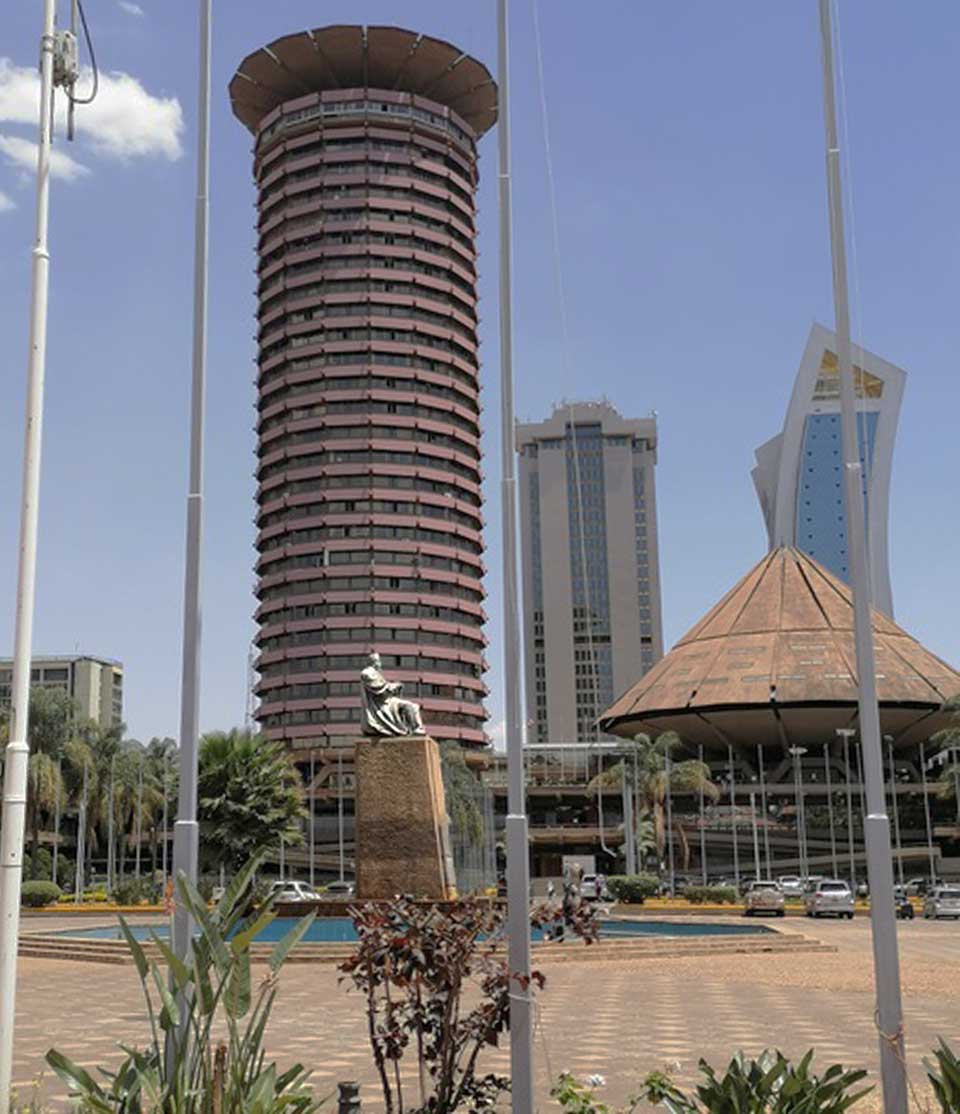
Figure 6 Kenyatta’s 1973 statue surrounded by the iconic Kenyatta International Convention Centre and Times Tower. © Lydia Muthuma
While the 1964 statue of Kenyatta was installed to mark the attainment of the country’s Republic status, (cf. figure 1.) it does not form the main subject of this article because of its inaccessibility to the ordinary Kenyan.The second statue of Jomo Kenyatta, which is the subject of this paper, was installed in City Square in 1973. Its situ (the 1973 statue) is about half a kilometer away from the Parliament buildings as shown in figure 4. It is curious that ten years after unveiling the first statue of Kenyatta (1964 to 1973) a second statue of the very same president was installed in City Square, near the first one. One wonders what prompted the erection of this second statue. Was the first lacking in any way? Because contemporaneous historical happenings do not supply a plausible answer, I turn to reasons artistic to account for the ‘double representation’ of Jomo Kenyatta.
City Square was designed in the 1930s as Nairobi’s most central public space. During this era, the colonial government was working hard to convince London that Nairobi could become the capital of a ‘federated’ East Africa with internal self rule. Kenya was to go the way of Australia or Canada within the British Empire. Nairobi Town Square (now City Square) was designed to show off the High Court (now Supreme Court). The visual focal point of Town Square was a statue of the then reigning monarch, King George V of Britain. But when the second world war signaled the beginning of the end of the British Empire, and the Mau Mau rebellion, similarly signaled the end of colonial rule in Kenya, the statue of King George V had to come down. Change in political leadership caused change in displaying of statues. Therefore from 1964, when this statue was dethroned, City Square was without a focal point – visually.
Even with the addition of the Kenyatta International Convention Centre (KICC) building, as a visual extension of the Supreme Court, the square still lacked visual balance and focal point. Thus in 1973, a second statue of Jomo Kenyatta was installed in order to solve this aesthetic problem. It took up the place that had borne King George V. The sculptor of this second statue, James Butler, was to fabricate work for a given site.It is in this sense that Kenyatta’s 1973 statue is considered site specific –the site was incomplete without the statue because previously it had held the statue of King George V, which was removed in c. 1963. Between 1963 and 1973, this spot was without a statue. Re-filling the gap, in this site, supplies a rationale for the repeated representation of Jomo Kenyatta –outside parliament in 1964 and in City Square in 1973; same person in the two statues.
Dedan Kimathi’s statue is not site specific: it was first fabricated then a site decided upon –later. In comparison to Kenyatta’s 1973 statue, Kimathi’s, while smaller in size, is provided with little, if any, viewing distance. It is placed amongst tall buildings at the intersection of two busy thoroughfares. However, whatever its artistic (de)merit, it comes with a wealth of historical re-imagining. Kimathi’s statue is considered an active element in the processes of decolonisation today. (Mwangi, E. 2010)
Again, unlike Kenyatta’s 1973 statue, Kimathi’s was not fashioned during his life time. It is posthumous since Kimathi was condemned to death by hanging, in 1956, for the crime of unlawful possession of a firearm. In reality though, his crime was rebelling against colonial rule as leader of the KLFA also known as the Mau Mau. The sentence was carried out in 1957 and his body deposited in an unmarked grave.Fifty years later – 1957 to 2007 – Kimathi’s statue was unveiled. The time lapse calls for a scrutiny and rationalization of ‘re-calling’ him from the dead. Why the need to represent him, by installing a statue, 50 years after his death? Political history is rife with explanations that are still on-going. (Julie MacArthur, 2019)
An artistic probing of Kimathi’s statue; if it brings back this Mau Mau hero to life and whether it was meant to, presents several challenges because the statue appears more symbolic than an actual re-presention of Kimathi. This is because of its size and situ. Its scale, in comparison to the adjacent built environment, is miniscule. It does not command viewership although it is right in the middle of the public. Its size renders it pedestrian and somewhat not worth more than a passing glance. There is little about it to catch the eye of a passerby. It can be mistaken for one more ‘live’ pedestrian attempting to cross the street. It is ‘camouflaged’ by its size which makes it blend into the pedestrian traffic. Its success, in engaging the viewer’s affects, is debatable. And a significant contributor is the statue’s site.Once Kimathi’s statue was completed, a decision was arrived at to install it at the junction of Kimathi and Mama Ngina Street, within busy vehicular and pedestrian traffic. Viewers are treated to snap shot sights of it amid the unending caravan of commuter buses. This style of ‘seeing’ is easily translated into a similar mode of remembering; snap shot, unclear memories of Kimathi – who was he again?
Conversely, in City Square, Jomo Kenyatta sits in the absence of interfering traffic; in the absence of impinging tall buildings and with ample viewing distance. Commendations like: “the statue (Kenyatta’s 1973) is an island by itself and can be approached from multiple areas both visually and physically which is a valuable status within space defining elements (…) It has the unmistakable character of an icon and can easily be the best defined statue in the country (Kenya),” are not unusual. Truly, the site of a statue influences the viewer’s response. http://www.archidatum.com/projects/jomo-kenyatta-statue-james-butler/
Conclusion
Perhaps because of the historical circumstances the two statues –Kenyatta’s 1973 and Kimathi’s 2007 are viewed differently. They also evoke varied responses. What cannot be overlooked is that their siting (situ) contributes to their visual perception, which in turn influences the remembrance and mental picture retained by the public.
The siting of both statues corresponds with Kenyatta being the central character in Kenya’s decolonisation narrative while Kimathi occupies the more peripheral position. Kenyatta (1973) sits in City Square while Kimathi is amid the hubbub of downtown Nairobi.
References
- http://www.archidatum.com/projects/jomo-kenyatta-statue-james-butler/
- Mwangi, E. (2010). The incomplete rebellion: Mau Mau movement in twenty-first-century Kenyan popular culture. Africa Today, 57(2), 86-113.
- Shanguhyia, M. S. (2019). Julie MacArthur, ed. Dedan Kimathi on Trial: Colonial and Popular Memory in Kenya’s Mau Mau Rebellion. Athens: Ohio University Press, 2017. xxvi+ 406 pp. Bibliography. Index. Paper. ISBN: 978-0896-803176. African Studies Review, 62(2), E12-E15.
published October 2020
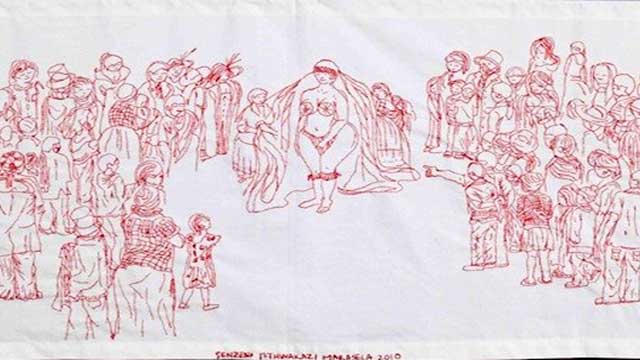
-
 Elfriede Dreyer
Elfriede DreyerA colonial figure, Baartman’s birth date is unknown – she was born in the Camdeboo Valley somewhere in the 1770s and died in Paris on 29 December 1815. In 1810 Baartman was taken to London by her employer, Hendrik Cezar, a free black man of slave descent, and William Dunlop, an English doctor who worked at the Cape slave lodge. There she was put on display on stage, mostly in the nude, and became known as the ‘Hottentot Venus’, acquiring status as a peculiarity due to the ‘abnormal’ size of her genitalia and buttocks. In 1814 Henry Taylor (Hendrik Cezar) took her to Paris where she was sold to an animal trainer, Réaux, who made her amuse audiences. Specifically Baartman’s steatopygia – a common feature of the Khoikhoi female body – was the curiosity. (Mastamet-Mason (2014:113) argues that the Victorian bustle dress silhouette, which became fashionable in 1870 in Europe, can be attributed to Baartman’s physique, since Baartman was displayed in Europe between 1810 and 1815, and the bustle dress was only introduced in Paris in 1880.)
Baartman came to be viewed as an anthropological freak and a sexual novelty, and she had to perform certain acts (such as mimicking savagery) against her will – first in carnivals, later in aristocratic salons and finally in brothels where she ended up as a prostitute. Georges Cuvier, Professor of Comparative Anatomy at the Museum of Natural History at the time, encountered Baartman in this context and started studying her in terms of scientific racism, mainly with the objective to establish a missing link between animals and human beings. Tragically, Baartman died in 1815 as a result of exploitation and abuse. Her genital parts and brain were initially preserved in Europe for further study, but after much deliberation (driven by Nelson Mandela) her remains were repatriated to her homeland, the Gamtoos Valley, and buried on 9 August 2002 on Vergaderingskop, together with the return home of other disenfranchised individuals under apartheid (Moudileno 2009).A number of problematics issue from this narrative. Firstly, Baartman’s body was considered to be abnormal and animal-like; yet the Europeans found her sexually attractive enough to have intercourse with her. The implication here is bestiality. In 2012, in I critiqued an article entitled ‘Africa’s repulsive charm’ of French anthropologist Jean-Loup Amselle (2008) in which he launched an unmitigated review of perceived predominant Western perceptions of Africans, describing them inter alia as “intellectually degenerate”; “underdeveloped”; “descendants of the Old Testament Ham” and his “cursed and blood-infected progeny”. In short, he describes Africa as “a continent of utter horror, a theatre of primitive cruelty”, the very reason why “we” (the West?) think of Africa in a “libidinous and viral” [my emphasis] way, generating a line of thought so deep and wide that it “permeates the economic, social, cultural and religious domains”. I argued that Amselle’s polarisation of the relationship between the West and Africa – as deeply ambivalent and postulated as the attraction of opposites and ‘sexual intercourse’ – represents a prime example of Othering hate speech towards African people and reaffirms the continuing deep and wide divide between the West and Africa, which still undercuts Africa as a secondary role player and displays a modernist binary view of history. Baartman represented a sexual Other in the context of such a so-called libidinous attraction between Europe and Africa.
Secondly, the Hottentot Venus was a figure of oppression and in feminist perspective she became a supreme symbol of objectification being subjected to the tyranny of the white male colonial gaze. Mastamet-Mason (2014:115) argues that until the twenty-first century, full-figured African women were considered “attractive, were respected, and their bodies represented wealth, fertility and good health”. (There are fattening houses used specifically to fatten women in West African countries, highlighting the fact that some African countries still value and idolise full-figured women (Mastamet-Mason 2014:115)).The Othering gaze is pertinently racial here, not only in personal terms in the Othering of body shape, or in terms of gender in the Othering of gender difference, but mainly in terms of cultural Othering in the European gaze at the nude African woman. The colonial, Westernised view on nude Africans is described by Benjamin Talton (in Jackson et al 2009:82) as follows: “Within European discourses on African cultural characteristics, African women were ‘silent icons of the primitive – the ultimate “others”’. Left largely undefined by Europeans obsessed with categorising people and places, African women became the epitome of Africa’s ‘darkness’. … Public ‘nudity’ was [considered as] symptomatic of a general lack of moral restraint among Africans; an outgrowth of their unbridled sexuality, and a testament to their need for Christian redemption.” The colonial European view was based on subjective perception, lack of factual information and mythologising of ‘dark Africa’, a view that seems to be persisting yielded by the cited Amselle’s article. In many African countries, limited economic and natural resources played a formidable role in determining people’s access to cloth and clothing that had nothing to do with intellectual capacity, intelligence or sexuality. In fact, since the 1950s there were several anti-nudist internal campaigns in Ghana and elsewhere. Men became clothed long before women, which formed part of the cultural view of woman as possession, but it was also due to lack of financial means to acquire clothing. Africa is vast, and it took long for traders to transport and distribute their wares. However, in the case of Baartman, a very different scenario was playing out: she was deliberately unclothed and exploited in the nude for sexual and entertainment reason, and her nudeness thus did not present as part of her cultural tradition.
Thirdly, the Baartman narrative manifests as a discourse on ‘disposable’ bodies as ‘waste products’ of the colonial impulse. Following Braidotti (2011:6), it can be argued that the “disposable” bodies of “women, youth, and others who are racialized or marked off by age, gender, sexuality, and income, reduced by marginality, come to be inscribed with particular violence” in the regime of such powers. Baartman was not only perceived as an object of curiosity, but also as abject, representing those elements and groups of people in society that are perceived to be unwanted and should be eradicated. Politically and culturally the nurturing of notions of abject is potentially dangerous and a concept that in the past has led to genocidal regimes such as Nazism and apartheid. Currently the migrant crisis that many countries are facing has once again stirred such sentiments and actions, and in certain cases has even led to inverted racism or abjection in the redress of the past.
The use of red water colour in Marasela’s Covering Sarah series conjures chilling reminders of the pain and suffering inflicted by the constructs of Othering and abjecting. The artist’s drawing lines on one hand remind of colonial travelogues inscripted with handwritten anecdotes, descriptions of journeys and scenes, and linear drawings of people, the land and other curiosities; on the other hand, it simulates running blood, pain and torment. The use of embroidery in Theodorah, Senzeni and Sarah I ambivalently harks back to both Victorian pastime and African women’s well-known craft of embroidery. Embroidery as an activity evokes associations of quiet meditation, but also of violence through the needle’s rupturing of the cloth. In the latter work there is suggestion of evocation, redress and reconstruction in the physical covering of Sarah with a cloth of some sort, thus a restitution of the past. The cloth becomes like a kind of honorary cloak, as evidence of Baartman’s elevation to celebrity or sanctified status.
The Covering Sarah series affirms the volatility of cultural perceptions and conjectures about others, as well as the socio-political changes that have occurred in Africa affecting the discourses around body types and the clothed/unclothed body. The work reminds us of the dangers and vulnerabilities lurking in obsessive Othering and radicalising difference.
About Senzeni Marasela
Senzeni Marasela is a female South African artist of Zulu origin, born in Thokoza, KwaZulu Natal in 1977. She is currently completing a MA degree in Art History from Wits University (SA); she has exhibited widely in the national and international contexts; and she has been awarded several grants and residencies, for example from Devon Arts Residency (Scotland) The Ampersand Foundation and Axis Gallery in New York; The Thami Mnyele Foundation in Amsterdam; and the Kokkola Art Academy in Vasa. Her artist website is found at http://www.senzenimarasela.com.
References
- Amselle, J-L. 2008. Africa’s repulsive charm, translated by R. Baldinelli. Critical Interventions: Journal of African Art History and Visual Culture Volume 2, Spring, 2008:11 – 18.
- Braidotti, R. 2011. Nomadic subjects: embodiment and sexual difference in contemporary feminist theory. Second edition. Gender and culture: A series of Columbia University Press. New York: University of Columbia Press.
- Dreyer, E. 2012. Functionality and social modernism in the work of untrained South African artists. Third Text (Vol. 26:6, November):767–780.
- Jackson, S, Demissie, F, Goodwin, M (eds). 2009. Imagining, writing, (re)reading the black body. Pretoria: Unisa Press.
Mastamet-Mason, A. 2014. The Saartjie Baartman body shape versus the Victorian dress: the untold African treasures. Open Journal of Social Sciences 02(08): 113- 120. DOI: 10.4236/jss.2014.28017. - Moudileno, L. 2009. Returning remains: Saartjie Baartman, or the “Hottentot Venus” as transnational postcolonial icon. Forum for modern language studies 45(2): 200-212.
- Talton, B. ‘All the women must be clothed’: The anti-nudity campaign in northern Ghana, 1957 – 1969. In Jackson, S, Demissie, F, Goodwin, M (eds). 2009. Imagining, writing, (re)reading the black body. Pretoria: Unisa Press.
published March 2020
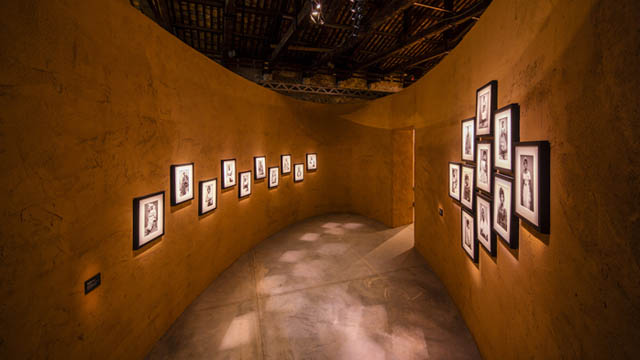
-
 Kwasi Ohene-Ayeh
Kwasi Ohene-AyehThe Ghana National Pavilion at last year’s 58th International Art Exhibition of La Biennale di Venezia served to augment the fervent energy of contemporary art already simmering in its locality. The Pavilion staged a stellar intergenerational selection of six “multi-local”1 artists from Ghana— Felicia Ansah Abban, El Anatsui, John Akomfrah, Lynette Yiadom-Boakye, Selasi Awusi Sosu and Ibrahim Mahama— whose works range between photography, painting, film, video, and installation. Stationed in the Artiglierie within the Arsenale, the Pavilion displayed the artists' works in continuous cylindrical enclosures designed by architect David Adjaye, and executed with laterite soil couriered from Ghana. The nation’s debut outing at the Biennale, titled Ghana Freedom, summoned the “boundlessness” and euphoria in the spirit of self-determination promised in its mid-century Independence moment and epitomised in such cultural events as the World Festival of Black Arts— the first being Festival Mondial des Arts Nègres (FESMAN) which took place in 1966 in Dakar, Senegal, and then the Festival of Arts and Culture (FESTAC) which happened in Lagos, Nigeria, in 1977. “There is no longer any need to look back in the same way as an act of reclamation or reaction”, writes the curator Nana Oforiatta Ayim, since “these pathways remain with us and evolve”(Ayim, 2019, pp. 31).
The emancipatory ideal summarised in the titular of the exhibition is a poignant basis for this evolution given the colonial mediation of Ghana’s formal education in general, and art education in particular (seid’ou, 2014; seid’ou, 2016). In this regard, Ghana Freedom could be said to have countenanced an approach to the practice of art that is unconstrained by the de-contextualised imposition of the beaux-arts tradition which became ingrained through colonial instruction in the Gold Coast (pre-independence Ghana) from the late-19th century to the late-1950s, and which prevailed in the postcolonial mediation from then till the first decade of the 21st century. Exhibitions of this dispensation predominantly lacked curatorial direction. Indeed, the Ghana Pavilion, however obliquely, can also be said to have announced the inventiveness of emergent exhibition practices in the country. For example, Ibrahim Mahama’s early site-oriented and itinerant exhibitions in public places is a pragmatic and critical response to the derelict infrastructural conditions an art practitioner in the country has to contend with. Mahama’s attitude to this systemic neglect is traceable to the interventionist ethic and affirmative politics of blaxTARLINES KUMASI.2
It goes without saying that the spectacular occasion of the Pavilion accumulates cultural capital for the nation in asserting a compelling place and reputation as far as the global mainstream of art is concerned— more especially for a nation which has been treated as a footnote in literature on the history of art in Africa. It is therefore our task to, so to speak, “brush history against the grain” (Benjamin, 1969, pp. 257) by practically intervening in it through such exhibition making ventures. In this vein, the success of the Pavilion highlights two major points for discussion.
The first is a dialectical situation. At a time when cultural institutions and producers are enduring famishing conditions as far as state support or infrastructural systems are concerned, the state has demonstrated that it is possible to alter this fate— seeing as the Ministries of Finance and that of Tourism, Arts, and Culture, respectively supported and commissioned the Pavilion. But now that the impossible has happened, one would have thought that prioritising a National Pavilion would pave the way to launch serious longterm cultural policies ensuring continued presence in Venice itself, and also to invest in and build the necessary economic and cultural support structures for those local practitioners who are in dire need of it. As this is yet to happen, it will be crucial for Ghana to sustain the legacy of the Pavilion beyond the rhetoric of representation, even if it turns out to be a one-time affair.
Secondly, turning our attention to local relevance, the intention of the organisers to, later that year, bring the exhibition to the National Museum of Ghana to be able to show it to local audiences and to generate new knowledge has yet to materialise, for whatever reasons.3 This is unfortunate given the curator’s unequivocal concern for institution building and the “possibilities of artistic development in Ghana itself” (Ayim, 2019, pp. 140). If we keep in mind, apropos Borges, that every exhibition, at any given moment, based on its arguments or claims, “creates its own precursors” and therefore holds the potential to alter our conceptions of both past and future within that genealogy,4 then it presently counts as a missed opportunity not to have optimised Ghana Freedom in terms of creating history rather than solely staging one. What I mean is that the exhibition could have served as an epistemic site through which to actively produce and update the history of contemporary art in Ghana. For example, by citing5 or acknowledging the timeliness in the return of the exhibition to the National Museum falling on the 20th anniversary of South Meets West6 — the seldom talked-about contemporary art exhibition of African artists based on the continent and in the diaspora which also took place at the National Museum in 1999 with an artist lineup including Atta Kwami, Tracey Rose, and Yinka Shonibare— in addition to such “precursors” as FESMAN, FESPAC and “Authentic/Ex-centric".7
Such an instance would have contributed to the intellectual legacy of Ghana Freedom in fulfilling the task of theorising the newly emergent curatorial and artistic paradigms in Ghana, all the while establishing the critical connections, differences, and evolutions between postcolonial and transnational antedatings of such political attitudes to exhibition making. This is especially important when we take the emancipatory promise of contemporary art seriously by considering the exhibition as a system that is not only meant for [re]producing spectacular displays, while taking the commodification of art for granted, but as one which deploys the convergence of symbolic and material consequences enveloped in the immanent tensions of history and power. Particularly when we acknowledge that the National Pavilion structure of the Venice Biennale impedes the institution from turning towards the non-imperialist substance of contemporary art.8
It remains to be seen how far representation of culture as the sole basis of participating in such blue-chip events as the Venice Biennale can get us9 (or any nation with egalitarian aspirations for that matter). Let us also not forget that biennales have not always existed, nor should they necessarily always exist in the future.10 Accepting this, at least, cautions us not to take its existence as well as what it promises for granted. If we succeed in the latter it breeds conformism which can be opposite to true freedom. To boot, the present COVID-19 pandemic has gone a long way to expose the fragility of existing exhibition conventions as it threatens to revolutionize our economic, socio-cultural, health and political sectors on a planetary scale. The institutions by which we traditionally associate the production, circulation and experience of art— i.e. galleries, museums, the art market, etc.— have all suddenly ground to a halt and are facing the challenge to structurally rethink their modus operandi. Therefore the future of exhibition making, as we know it, is what is currently at stake. We are confronted with the task, now, as in previous times in history, to be more inventive with the exhibition form. Bonaventure Soh Bejeng Ndikung, artistic director of Sonsbeek (2020-2024), articulates this grammar of contingency well enough in the epigraph.
Where Ghana goes from here in verifying art as an egalitarian universality and creating particular models to suit its locality is entirely up to us, its protagonists. And so the question becomes, when such real threats and crises have paled the superficiality of representation (in other words, when all the pomp and pageantry of Ghana Freedom has disappeared), what will its historical substance be posthumously based on?
About Selasi Awusi Sosu's presentation at the pavilion see: Link
About Ibrahim Mahama's "Savannah Center for Contemporary Art" in Tamale see: Link
Footnotes
1Taiye Selasi uses this term in her essay Who is Afraid of a National Pavilion? in Ayim (2019 pp.38-44).
2Both Mahama and Selasi Sosu are alumni of KNUST and active protagonists of blaxTARLINES who espouse these transformations. This internationally networked collective has been functioning as the contemporary art incubator in the Department of Painting & Sculpture in Ghana’s foremost Art College at the Kwame Nkrumah University of Science & Technology (KNUST) since 2015, and has radically upended the hegemony of salon style display formats erstwhile ubiquitous in commercial galleries, hotel lobbies, and other spaces which had contrived the realisation of artistic potential primarily for the patronage of tourists.
3Nana Oforiatta Ayim confirmed in her lecture in ibid. (in June) after its opening on May 11th that the show would be at the National Museum of Ghana later that year.
4I appropriate this thought from Jorge Luis Borges in his essay Kafka and his Precursors (1951).
5By citing, I do not mean merely mentioning (since the curator succeeded in mentioning FESMAN, FESPAC and “Authentic/Ex-centric” as precursors), but through curatorial research, and coming to terms with their historical, theoretical, and aesthetic substance and formulating an argument that deals critically with the claims and implications of these events through an analysis of their significance to our own epoch.
6South Meets West is an exhibition organized by Kunsthalle Bern and Historical Museum of Bern in collaboration with the National Museum of Ghana which happened in Accra in 1999 and travelled to Bern in 2000. The exhibition curators are Dr. Bernhard Fibicher (Kunsthalle Bern, assisted by Eszter Gyarmathy), Dr Yacouba Konaté (Université d’Abidjan-Cocody, Côte d’Ivoire), Dr. Yvonne Vera (National Gallery Bulawayo, Zimbabwe). Participating artists are Jane Alexander, Fernando Alvim, Meshac Gaba, Kendell Geers, Tapfuma Gutsa, Atta Kwami, Goddy Leye, Zwelethu Mthethwa, Tracey Rose, Yinka Shonibare, Pascale Marthine Tayou, Yacouba Touré, Minnette Vári, and Dominique Zinkpe. The catalogue included texts by Oladélé A. Bamgboyé, Dr. Bernard Fibicher, Kendell Geers, Clive Kellner, Dr. Yacouba Konaté, Atta Kwami, Simon Njami, Prof. Joe Nkrumah, Tonie Okpe and Sarah Zürcher. See South Meets West (2000).
7Oforiatta Ayim acknowledged her debt to Salah Hassan’s and Olu Oguibe’s curated exhibition at the 49th Venice Biennale in 2001, Authentic/Ex-centric: Africa In and Out of Africa. See Ayim (2019. pp. 140).
8Oforiatta Ayim commented on the problematics of this in our public conversation in op. cit. @thestudioaccra. (2019). Taiye Selasi also points at this issue in her catalog essay.
9The curator of the Pavilion, Nana Oforiatta Ayim, states her motivations for realising the Pavilion as such: “One of my driving forces [for being in Venice] is this idea of representation— of voice, of narrative— of who gets to speak the narrative.” She made this statement in a public conversation I had with her at @thestudioaccra. (2019, June 27). Ghana Pavilion Venice Biennale: Conversation with Nana Oforiatta Ayim. [Facebook post]. https://web.facebook.com/accrastudio/photos/a.1118364178194088/2491384694225356/?type=3&theater. Audio of lecture is in author’s archives, courtesy @thestudioaccra.
10I appropriate this thought from Walter Benjamin who, in a similar spirit of contingency, was speaking particularly of the novel form in literature. See Benjamin (1998. pp. 89).
References
- Ayim, N. O. (Ed.). (2019). Ghana Freedom: Ghana Pavilion at the 58th International Art Exhibition La Biennale di Venezia [catalogue]. Koenig Books.
- Benjamin, W. (1969). Theses on the Philosophy of History. In Hannah Arendt (Ed.) Illuminations: Essays and Reflections. Schocken Books.
- Benjamin, W. (1998). The Author as Producer. In Understanding Brecht: Walter Benjamin. Verso.
- Mitter, S. (2020). Art Biennials Were Testing Grounds. Now They Are Being Tested. 2020. https://www.nytimes.com/2020/05/01/arts/design/art-fairs-biennials-virus.html. Accessed 6th May, 2020.
- seid’ou k. (2006). Theoretical Foundations of the KNUST Painting Programme: A Philosophical inquiry and its contextual relevance in Ghanaian Culture [Unpublished PhD Thesis]. Kumasi: KNUST.
- seid’ou, k. (2014). Gold Coast Hand and Eye Work: A Genealogical History. Global Advanced Research Journal of History. Political Science and International Relations ISSN: 2315-506X Vol. 3(1). pp. 008-016.
- South Meets West exhibition catalogue. 2000. Kunsthalle Bern, NÀWÁO. ISBN 3-85780-124-7.
published May 2020
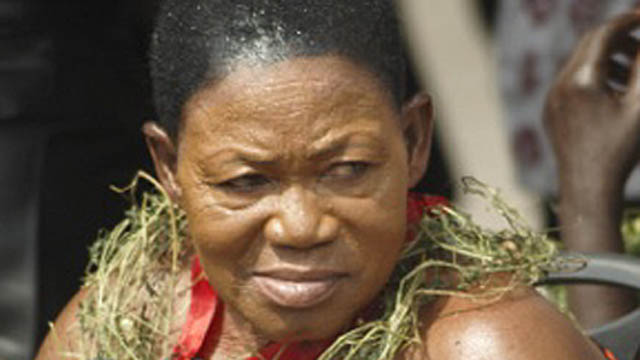
-
 Osuanyi Quaicoo Essel
Osuanyi Quaicoo Essel
Africans, including Ghanaians, had their peculiar way of life long before they encountered the colonialists. They had a robust governance structure (kinship system), laws and standards of beauty inherent in their beauty culture practices. The African society was orderly organised to the extent that there were minimal deviants. They had built no prisons for offenders, rather, their sense of communalistic living and religious practices shaped their modest way of life. Based on their customary laws and taboos, offenders atoned for their wrongdoings through rites and rituals which were enough corrective measures. In some cases, the corrective stigma associated with particular wrongdoing was enough deterrent to possible offenders. For example, someone who stole a bunch of plantains was made to carry the plantain on the head, and matched by multitudes through the streets of the community, announcing the offenses s/he has committed. Sometimes, offenders were sent to the chief palace for settlement of the case. The society was so organised and cultured to the extent that when the community became aware of the wrongdoing of an offender, s/he may not find a spouse or suitor in that community. Before arranging for marriage, the families of both parties engaged in serious investigation about the socio-moral backgrounds of both suitors regarding their behaviours in and outside the community. When a suitor had criminal records, the family of the suitors disallowed such a marriage. In personal communication with M. Opoku-Mensah (12th June 2020), he referred to a purported address of Lord Macaulay to the British Parliament on 2nd February 1835 which confirmed what pertained in precolonial Africa. Lord Macaulay reportedly said:
“I have travelled across the length and breadth of Africa and I have not seen one person who is a beggar, who is a thief such wealth I have seen in this country, such high moral values, people of such calibre, that I do not think we would ever conquer this country, unless we break the very backbone of this nation, which is her spiritual and cultural heritage…”
Just as any society, this statement suggests that Africans also had the way of life, including the standard of beauty and makeover practices.
Precolonial Ghana, as in the case of other Africans, held in high esteem their indigenous beauty culture standards. They held a complex standard of beauty embodied in their ‘Afrocultural aesthetics’ (Essel, 2017, p.25). Afrocultural aesthetics has to do with the conceptual and contextual hybridity of aesthetics that celebrate ideas expressed in artworks (Essel & Acquah, 2016) and the intended purpose of art, be it functional, symbolic or decorative. A work of art is considered good or beautiful once it served the purpose for which it was done. This implies that beauty is judged in context as well as the concept. The Afrocultural aesthetics also apply to the beauty culture practices of the people. One of the beautyculture practices precolonial Ghana held high was hair grooming aesthetic ideals. Hair occupied a central position in the scheme of social standing to the extent that it sent a message about the status of its wearer to the audience who understand such a language. One could differentiate a married woman from the others based on her hairdo in Ghanaian society. Hair was treated with natural hair softeners, conditioners, colourants, and accessories such as comb. Special combs that helped the people to keep the hair in good shape were fashioned by sculptors from wood, bones and metal. The combs were artistically shaped with symbolical essence just as the hair itself. What the precolonial African society did not do was to stigmatise the hair type and texture of their fellow Blacks.
The advent of the slave trade, colonialism and Western education began to sew the inferior seed of black hair stigmatisation and discrimination. Gradually, this ‘inferior seed’ (Morrow, 2014) sewn has entered the educational institutions which should be the agent of change, centre of Black consciousness, character reformation centre and panacea of pan-Africanism has rather turned into Afrosaxons colonialist surrogates perpetuating Afrocentric hair stigmatisation against their educands (Essel, in press). In the effort to decolonise the bastadised and proscribed Afrocentric hairstyle practices in Ghanaian schools, this article explores the conflicting tensions in the process on the part of the school authorities, students and the parents.
Decolonisation theories is central to this study. There exists different perspective on the subject matter of decolonisation. Some have looked at it from Euro-American perspective while others argued that the process remains incomplete when it is one-sided instead of two-sided, that is, looking at it from the perspective of the colonised and the coloniser. On this path, Wenzel (2017) examined the multiple objects and aspects of decolonisation namely, political economy, epistemology, culture, language and nature, and theorised that there exists unevenness and incompletion of the decolonisation process. By studying the various roles played by the colonisers, anti‐colonial nationalists, and Cold War superpowers in decolonisation, Wenzel (2017) observed that postcolonial independence did not necessarily bring national liberation. This liberation in my view includes mental emancipation, and redefinition of Africanness, believing in
ourselves.
In the encounter of the colonialists with the colonised, the former has painted monstrous and negative perceptual image about the latter which has affected the way of life of the latter.The colonialist projected their standards of beauty and art to the colonised and spoke ill of that the colonised to retard social progress and prolong colonial domination of the latter (Nkrumah, 1963).By so doing the colonialists’ beauty culture standards have been ingrained and practised in academic institutions and everyday life and has seeming override indigenous beauty culture standard of the colonised. In line with this, the decolonisation concepts that guides this study is that, the African needs to be measured by his/her cultural beauty standards that does not breach the fundamental laws of his nation or state. The African must gain national cultural consciousness and must not be necessarily be measured with the standards of the colonialist (Nkrumah,1963; 1964). Before the Black Hair Stigma in Precolonial Ghana There are different types of hair ranging from type 1(a, b, c), 2(a,b,c), 3 (a, b, c) and 4 (a, b, c). The types were classified according to the straightness, waviness, curl patterns and kinky look. Hair may also be described in terms of its texture, density, porosity and colour. These characteristics of hair
differences may manifest in individuals, groups, society or race. Despite the differences in hair type, all people of the world belong to one race, that is the human race (Elliot, 2016). Even among Blacks, there are differences in hair type. Precolonial Ghana was made of different ethnic groups of which the Akan were the majority. Though they were of different ethnicities, they did not discriminate against each other on the basis of their hair type or hairstyle. The people wore different hairstyles based on their ethnic affiliations, beliefs and practices, social status, and to celebrate events such as festivities and or funerals. Sometimes the hairstyles were worn for art sake. The hairdos had performative importance, semiotic power, and engendered identity. For
example, queen mothers wore a kind of hairdo named dansinkran (Figure 1) known for its iconic stature amongst the chiefdom.
Figure 1: A woman wearing the dansinkran hairstyle. (Image courtesy: Godhit, 2017).
The hairstyles of the people ranged from natural dreadlocks popularly called rasta (known in Akan language as mpɛsɛmpɛsɛ), Afro, braiding, plaiting, shaving and African wigs. Though the word rasta is regarded more as a Jamaican phenomenon, mpɛsɛmpɛsɛ (which was named rasta) existed in some parts of Africa including Ghana in precolonial times. Some were born with the rasta. People born with rasta were considered by society as special beings, for that matter sacred. Apart from that, some priests and priestesses wore dreadlocks or afro. Cowries were placed in the rasta or afro hair of some priests and priestesses for symbolic, decorative, religious and ritual purposes. In this article, the term rasta is used in the context of both natural and artificial dreadlocks in precolonial, colonial, postcolonial and contemporary times. Again, the term Afro was introduced in the 1960s in reference to African American grown hair. From this word came Afrocentric. It is worthy of note that the enslaved Africans who were taken ashore had relatively long and grown hair. This was one of the hairstyles associated with males in precolonial Africa. The colonialists negatively described that hairstyle as bushy. Meanwhile,the long hair of the colonialists did not merit such a negative description. Till now, the term bushy hair connotes an offensive description of overgrown African hair. Many young Ghanaian people would prefer the term Afro to mean fully-grown hair than to describe their hair as bushy. Though the term Afro emanated from the US, the hairstyle was long in practice in many parts of Africa.One could differentiate between a maiden and a married woman just by looking at the hairstyles they wore. The people also used natural hair treatments that conditioned and softened it to keep it in good shape. The Akan often said ɔbaa n’enyimyam nye ne tsirhwin which literally means ‘The glory of a woman is her hair.’ This expression underscored why women in precolonial Ghana cared so much about their hair. They spent a great deal of their time in pursuance of their hair beauty culture practices. During puberty rites, female adolescents are given special education on hygiene, good grooming and hair beauty culture practices and treatments because of the premium society placed on the hair. Consequently, hair became a significant communicative symbol used to express moods such as bereavement, joy; and in some cases, power and authority. For example, a male child who lost his father, mother or close relation cut the hair down to the skin (Figure 2). He appeared hairless on the head as a sign of bereavement. Some Akan female adults wore a hairstyle called takua, done by holding the hairs together atop the head and with thread to stand upright. To them, such a hairstyle is design-less and simple in paying homage to the dead.
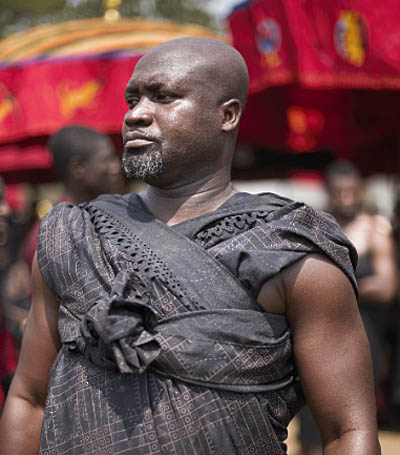 Figure 2: Man with hair cut to the skin as a signal of bereavement. (Image courtesy: Godhit, 2017).
Figure 2: Man with hair cut to the skin as a signal of bereavement. (Image courtesy: Godhit, 2017).Slave Trade, Colonialism and Western Education in Black Hair Stigmatisation
Precolonial Ghana had its own well-established form of education, evolved by the people themselves (Sampson, 1932; Essel, 2019) before their encounter with the colonialists. They trained the young ones through a rigorous enculturation process and apprenticeship system. They passed on the artistic culture and way of life from generation to generation through the robust apprenticeship system which is formal education and training (Essel, 2019). Training of the young ones was the duty of the immediate and extended families as well as other people in the community. It was for this reason that the precolonial society was described as living a communalistic life. In personal communication with M. Opoku-Mensah (12th June 2020), he referred to a purported address by Lord Macaulay’s to the British Parliament on 2nd February 1835. Macaulay had found that the people had strong cultural institutions that rule their socio-moral lives. In the said statement as pointed out by M. Opoku-Mensah (12th June 2020, personal communication), Lord Macaulay said to the British parliament:
"I propose that we replace her [Africa’s] old and ancient education system, her culture, for if the Africans think that all that is foreign and English is good and greater than their own, they will lose self-esteem, their native culture and they will become what we want them, a truly dominated nation."
Macaulay’s statement was recognition of the plausibility and relevance of the precolonial form of education that catered for the good socio-moral upbringing of the people which seemed impervious. As he suggested, the way forward was to introduce their culture including the language and beauty standards which they did, and used the slave trade, colonialism and Western education as a weapon to achieve their malevolent ideological and social-imperialism agenda. With the advent of Western education in the 1500s, learners with afro and rasta were asked to cut their hair before they were permitted to enrol. Afro and rasta hairstyles were considered unkempt and cutting them signalled cleanliness. The Euro-Christian churches planted in precolonial Ghana also asked new Black converts with rasta or afro to cut them as a sign of born again. The mission schools also proscribed
these hairstyles. In the name of religion, this practice continuously ate into the social-moral fabric of the society, especially, amongst the so-called Christian elite. In effect, this gradually contributed to afro and rasta hairstyles’ stigmatisation (Alhassan, 2020; Whiteman, 2010, Whiteman, 2007)). Those who wore these hairstyles, especially, the middle-class males and adolescents, were perceived as rascals, vagabonds, smokers, and unclean.
Based on rereading of scholarly information and archival sources on Black hair, interviews and focus group discussion as a method of data collection, the study provided insight into the hair decolonisation process in Ghanaian Senior High Schools and the conflicting tensions associated with the process. The focus group consisted of Senior High School teachers with more than five years of teaching experience at that Senior High School level. Descriptive and explanatory case study designs constituted the research design for the study. The descriptive aspect was for the purpose of describingthe phenomenon (the ‘case’) in its real-world context while the explanatory case study aimed at explaining how or why some condition came to be (Yin, 2018).A sample of twenty-eight (28) participants consisting of heads (2), teachers (20), and students (6) were purposively sampled from the accessible population of fifty (50). Simple descriptive analysis formed the method of analysis. To ensure the confidentiality of participants, pseudonyms were used to conceal their identity.
Conflicting Tensions in Black Hairstyles Decolonisation There have been reports of discrimination against the hairstyle of Black students in and outside Africa. During the 2015 West African Senior Secondary School Certificate Examination (WASSCE), three students of the St John’s Wesley Grammar School, Accra, Ghana were disallowed to write because they were wearing afro hair (Citifmonline.com 2015). In 2016, there were students protest in South Africa that questioned discrimination against African natural hair in class (Mwaura, 2016). Perry (2019) also reported Black hair stigmatisation which she sees as a vestige of segregated past that deemed blackness inferior and the emulation of whites as the route towards assimilation. This discriminative happening tells that black hair stigma persists in Africa even after colonialism. With the school as an agent of enforcing colonialists’ legacy of anti-Afrocentric hairstyle practices in primary, junior and senior high schools, specifically, rasta and afro, the practice
has become deep-rooted to the extent that attempt by parents and learners to question it proves futile. Students are not happy with the enforcement, and at some point in time prove adamant to school authorities. Mirekua narrated her story:‘I attended primary and Junior High School at Opah Municipal Assembly School from 2009 to 2012. There was a time I had to hide under my desk to avoid being sacked by the headmistress. I was given a warning at the assembly grounds to go and barb my entire hair. In my second year in Junior High School, I was told to go home and barb my hair because it would hinder me from taking part in the Basic Education Certificate Examination. I stayed home for a week because [after I cut my hair for] the fear of being mocked by friends seeing, as it was my first time of having a down cut.’
Mirekua’s accounts reveal the feeling of uneasiness and low self-esteem she developed as a result of being reprimanded to cut her long hair. Her hair was cut because she must be in school or face sacking sanctions. Students who go contrary were labelled as bad or stubborn. Maame Esi, was a student in a Senior High School in the Western Region of Ghana. She completed in 2014. She confessed that she complied with the rules and regulations governing hair beauty practices in her school because she feared being suspended, sacked or disgraced at the assembly grounds of the school. Not complying with the dictates of school authorities on hair in itself is a stigma. The enforcement of these anti-Afrocentric hairstyles has been internalised to the extent that some members of the society may cast aspersion on those who wear such hairstyles. A male participant said his best friend was
advised by the parent to Part Company with him because he left his hair to grow long. ‘My grandmum told me to keep my hair… One of my friends developed a cold attitude towards me afterward. When I asked, he told me that the parents have asked him to keep his distance from me because… I have become a bad boy. Only bad boys leave their hair without cutting it’, he said.
These vignettes of the students revealed that students kowtow to the hairstyle enforcement to avoid negative labelling by the school authorities and their own colleagues. There were others who also left the public school to attend a private school who were lenient with Afrocentric hairstyle restrictions. In a focus group discussion among 20 Senior High School teachers drawn across eight regions of Ghana, the issues that emerged were that students who wore afro and rasta are perceived as deviants and ill-mannered people who do not abide by the rules and regulations of the school. This is because the school proscribes wearing of these hairstyles. To
the teachers, students appear as adults when they wear afro and rasta hairstyles which do not distinguish them from the teachers. Succinctly put, ‘They appear like mothers and fathers’ than students in those hairstyles. In addition, they argued that wearing such hairstyles in school generates competition amongst the students as they may strive to put up flashy hairstyles and put little or no concentration on their academic work. As a result, they only permit students to wear rasta or afro on health and religious grounds. As explained earlier, hairstyles have religious implications in Ghanaian society. For example, afro and rasta have a strong affinity with African Traditional Religion, which is the authentic religion in precolonial Africa. A teacher explained that: Well, from my little knowledge, I know that … priest and priestesses do not barber. Secondly, some students have soft scalps making it easy for them to catch cold anytime their hair is down. These categories of students could be allowed to wear dreadlocks or afro to school. A teacher who aligned to the Christian faith perceived these hairstyles as unacceptable. He said, ‘My religious background wants us to have a close [hair] cut as a Christian man.’ The teachers said the culture of the school does not allow afro and rasta. So, they normally use scissors on students’ hair. They also admitted asking students to go and shave their hair but when the students refuse, they sacked them from the examination hall or class, since they were not ready to shave their hair without any tangible reason. Students who wear afro are perceived as ‘weed smokers’. On the contrary, four of the teachers argued that wearing afro or rasta is normal since it
borders on individual differences, and generally accepted in Ghanaian society. The issue is that these hairstyles become unacceptable when worn by students at the primary, junior and high school levels.
In response to the question of rules and regulations regarding hair beauty culture standards of students in public schools, a teacher said:What happens is that the housemasters, housemistresses, and some teachers on duty often send scissors to the various classes or examination halls to give students awkward hair cut against the will of the students to force them to shave their grown hair. This is
a kind of punishment given to the students for leaving their hair to grow. Some students, out of pain and dislike for such treatment, leave their hair in its awkward form as done by the teachers. Such students are often refused access to classes or examination
halls; canned, suspended or asked to weed as punishment. Students comply in order to take classes or
examinations.One of the participants has taught in five schools covering primary, Junior High School and Senior High Schools, with twenty-four years of teaching experience. She has taught in Ashanti and Central regions of Ghana, and currently a headmistress of a Senior High School. She opined that:
With twenty-four years of teaching, what the schools consider a neat haircut is down cut. Rasta isn’t allowed. Any child who came to school with grown hair is either driven home or the parents are invited to the school and advised to shave the hair of the ward. Some
parents come to explain to the school authorities that cutting the hair of their children has spiritual implications that may cause sickness to the child, so, the hair should not be cut. If the authorities disagree with them, it occasionally brings quarrels. Parents who
disagree are told that their children could not fit in the school... Personally, I think those who smoke marijuana wear rasta [dreadlock]. Once they come into the school with this hairstyle, their mannerism, their characters are influenced. They might not be smoking, but other students, sometimes, see them as marijuana smokers… Actually, for my long years in teaching, most of our recalcitrant students, most of our problematic students, when you look at them from head to toe, you realise that the sort of dressing speaks to their characters too.
The views of the headmistress-participant confirmed the thoughts of the teachers. The school expects learners to wear down-cut hairstyles as institutionalised by the colonialists. The school has done little or nothing to question the etymology of this self discriminating and self-stigmatising act they enforce hook, line and sinker. This negative enforcement has been instituted through a complex network of colonial apparatus namely Euro-Christianity, Slavery, colonialism and Eurocentric education making it difficult in decolonising the process. Any attempts to decolonise are faced with vehement opposition from Blacks to their fellow Blacks. Educated Blacks (Negroes) as pointed out by Woodson (1933, p. 7) ‘hope to make the fellow negroes ‘conform quickly to the standards of the whites and thus remove the pretext for the barriers between the races.’ Caucasians who attend Ghanaian public schools are exempted from this rule. Myjoyonline.com (2019, para 2, line 2 &3) reports of a leading member of a teacher union in Ghana who said: “what I gathered was that when Caucascians [Caucasians] students cut their hair to the level of black ladies, it makes them look very ugly and it can even affect their looks so Caucasian students are not allowed to cut their hair. There is no rule in the Ghana Education Service concerning Caucasians in Ghana because we are not Caucasians, we are negroes.”
Some teachers also argue that when students are allowed to leave the hair to grow long, it attracts lice, eczema and dandruff. These comments demonstrate the anchored conflicting tensions in the decolonising process. Diseases associated with hair are curtailed when students are properly groomed by the school to follow body and hair hygiene protocols. Their hair does not attract hair and skin-related diseases because it is black or not good. Hair and skin diseases are no respecter of colour or race. Good hair has nothing to do with its texture, density, porosity or colour. It is a hair of any type that is well maintained and kept healthy. The position of the school teachers and authorities brings to mind Carter Woodson’s (1933, p. xiii) assertion that:
When you control a man’s thinking you do not have to worry about his actions. You do not have to tell him not to stand here or go yonder. He will find his ‘proper place’ and will stay in it. You do not need to send him to the back door. He will go without being told. In fact, if there is no back door, he will cut one for his special benefit. His education makes it necessary.With this, Woodson looked at how the Negro has been miseducated to the extent that s/he exhibited ‘attitude of contempt to their own people’ (p.1). He also focused on the minds of Black people giving the right kind of education that would contribute to high self-esteem to their people. There are tensions and conflicts that ensue between school authorities and students on one hand, and school authorities and parents on the other hand. Students feel that such negative enforcement deprives them of their self-esteem, selfconfidence and uniqueness as individuals. Yet, they must abide by the colonialist monolithic mentality of wearing down-cut hair as a signal for obedience, neatness and smartness as required by the school to have access to education since noncompliance attracts harsh sanctions. Some parents who disagreed with the school authorities on the position of hairstyles, pick quarrels with the school authorities. Parents have the option of kowtowing or taking their wards from the school. One particular instance of a parent taking the school on is what happened in Achimota School on March 19, 2021, which became a national debate for more two weeks, and took a centre stage on social media, Ghanaian print (newspapers) and electronic media (radio, television, internet). One parent named Raswad Menkrabea took to his Facebook page to pour out his frustration about his son being denied admission on the basis of his rasta hairstyle. Raswad Menkrabea wrote:
This morning, the school authorities of Achimota School claimed that their rules do not allow students with dreadlocks to be admitted. The school authorities denied two brilliant dreadlock students from being admitted after having been posted there by the Computer School Placement System [Computerised School Selection & Placement System]. My son was one of the affected children and the other student was also refused on the same grounds. We have no option but to battle against this gross human right violation. As a child he has every right to his culture in so far as such culture do not breach the 1992 Constitution. He equally deserves the right to access education within his culture just like other cultural believers. As a Rastafarian, I think that dreadlock do no way cause any
harm which should even be a basis to be asserted by the school authorities. The fundamental questions to ask is what does our law
say about right to one’s culture? Do you deny a child access to education based on his/her culture? Do public school rules override the supreme law of the land?
This issue, which became a national debate in public transports and markets, attracted the attention of Ghana’s parliament in March 25 2021, based on which the Education Minister, Dr Yaw Osei Adutwum assured the house that the Ghana Education Service (GES) will soon issue policy guidelines on students’ admission to all Heads of Senior High Schools in Ghana to bring finality to the issue.
Wearing long or short hair plays no role in distracting students to focus on their academics. There are many renowned private schools in Ghana that do not proscribe students from wearing rasta or Afrocentric hairstyles. The school whether public or private has the primary role of grooming students to be creative thinkers with good time management skills. The hair students keep has nothing to do with their academic performance and socio-moral conduct.
From the discussion, it has emerged that the public schools proscribe Afrocentric hairstyles with no substantial scientific evidence that wearing afro and rasta inhibits the acquisition of creative and innovative thinking, and academic performance or progress of the students. Neither have the schools established from their arguments that wearing Afrocentric hairstyles negatively impacts the socio-moral and cultural wellbeing of the Ghanaian society or indigenous culture. They point to no sound research that establishes the relationship between academic performance and hairstyle worn, and the relationship between hairstyle and social conducts of students. The conflicting tensions around the hairstyles cut across precolonial, colonial and part of global fashion, and create multiple conflicting meanings within the many-sided existence of Ghanaian hairstyles. This helps to show how unstable, changing, and multiple the meanings of the hairstyles can be. Yet the Ghanaian public schools enforce the colonialists’ discriminative legacy of stigmatising Afrocentric hairstyles in Ghanaian schools with monolithic mentality without questioning the roots of such segregative practices. Teachers have challenges with students because when they wear rasta, afro and other Afrocentric hairstyles, they do so to show seniority. In other words, do so to signal that they have come of age. Therefore, wearing afro or rasta by the public school
students becomes a sign of rebellion and badness, while for the teachers they are signs of authority and respectability while this is not the case in the private school students. The difference between the public and private school policies creates a class division in the meaning of the hairstyles, where the Rasta and Afro styles become a sign of privilege.
Again, the teachers also deprived students of their Afrocentric hairstyles because they think it makes students susceptible to skin and hair diseases. These reasons deduced from the argument of the teachers and school authorities are not convincing to parents and students which leads to student-teacher and parent-teacher conflicts. Students gained continued access to education only when they shave their hair. Their education is threatened when they refuse to conform to the rules and regulations on hair. Students wear rasta, afro or long hair for several different reasons. Some wear it for spiritual/religious obligations, aesthetics and for fashionability purposes. This interesting practice challenges the so-called tradition and modernity opposition since a pre-colonial religious meaning and a fashion meaning can coexist in the same style and space. It is discouraging that six decades after independence from the colonialists, there are pitfalls in an attempt to decolonise the Afrocentric hair stigma created by the colonialists through the churches and schools they established. Surprisingly, the public-school authorities in Ghana have tended to be colonialists’ agents enforcing the discriminative Afrocentric hairstyles in schools. It is recommended that the Ghana Education Service and the Conference of Heads of Assisted Senior High Schools (CHASS) must work together to review the hair policies for students, so that it will not be a bottleneck for students to have access to education, which is their fundamental right enshrined in the 1992 constitution of Ghana.References
- Alhassan, S. W. (2020). “We Stand for Black Livity!”: Trodding the Path of Rastafari in Ghana. Religions, 11, 374, 1-10. doi:10.3390/rel11070374
- Citifmonline.com. (2015). School bans students with ‘unkempt’ hair from writing WASSCE. http://citifmonline.com/2015/04/22/school-bans-students-withunkempt-hair-from-writing-wassce/
- Essel, O. Q. & Acquah, E. K. (2016). Conceptual art: The untold story of African art. Journal of Literature and Art Studies, 6(10),
1203 – 1220. - Essel, O. Q. (2017). Searchlight on Ghanaian iconic hands in the world of dress fashion design culture (Unpublished Thesis).
University of Education, Winneba. - Essel, O. Q. (2019). Decolonising Ghana fashion education and training history. International Journal of Humanities & Social
Studies. 7(7), 381 – 392. - Essel, O. Q. (In press). Hair and body fashion identity narratives in ‘the Return of the Slaves’ exhibition.
- Elliot, J. (2016, May 26). Elliot Jane on the Rock Newman show. https://www.youtube.com/watch?v=fF9s0as_d_4
- Morrow, W. (2014). 400 years without the comb: Sewing the inferior seed. https://www.youtube.com/watch?v=SH7nNdz3ImY
- Mwaura, W. (2016). South African schools under attack over Afro hairstyles ban. https://www.dw.com/en/south-african-schoolsunder-attack-over-afro-hairstyles-ban/a-19513159
- Myjoyonline.com. (2019). Let it grow: Why the policy against long hair in schools must beabolished. https://www.myjoyonline.com/opinion/let-it-grow-why-the-policyagainst-long-hair-in-schools-must-be-abolished/
- Nkrumah, K. (1963). The African genius. Speech delivered by Osagyefo
Dr. Kwame Nkrumah, President of the Republic of Ghana, at the Opening of the Institute of African Studies on 25th October, 1963 - .Nkrumah, K. (1964). Consciencism. Panaf Books Ltd.
- Perry, A. (2019). “Stay out of my hair”: Black students need the federal government to tell schools to leave their hair alone.
https://hechingerreport.org/stay-out-of-my-hair/ - Sampson, M. (1932). Gold Coast men of affairs.
- Wenzel, J. (2017). Decolonization. In I. Szeman, S. Blacker, & J. Sully(Eds.), A Comparison to Critical and CulturalTheory.
https://doi.org/10.1002/9781118472262.ch28 - White, C. M. (2010). Rastafarian repatriates and the negotiation of
place in Ghana. Ethnology, 49(4), 303 – 320 - White, C. M. (2007). Living in Zion: Rastafarian Repatriates in Ghana,West Africa. Journal of Black Studies, 37(5),677-709.
- Woodson, C. (1933). The mis-education of the negro. Khalifah’s Booksellers & Associates.
Yin, R. K. (2018). Case
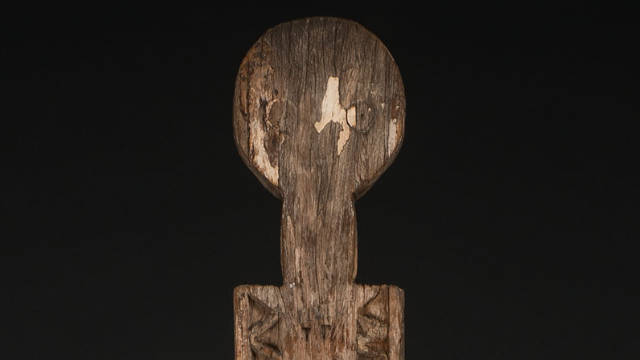
-
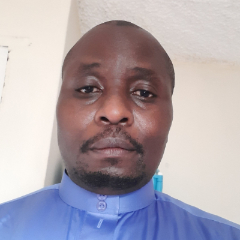 George Juma Ondeng
George Juma OndengGiven the ownership structures of museums in countries such as Germany, the local politicians will never support repatriation requests if they still solely understand objects as pieces of art/craft. It is high time we appreciate spirit, soul and body of these objects. To illustrate this point, I will use the three funerary posts, the vigango (singular kigango) from the Giriama Community in Kenya which are part of the museum collection in Munich. Museum audiences and art enthusiasts in the Global North admire the artistic side of these objects. The truth is, they are not objects according to the producing community. Vigango are souls of the departed elders and thus an integral part of the Mijikenda community. Vigango are also significant to the Giriama as a way of communicating with Mulungu (God). The vigango serve as media of communication with Mulungu since they are no longer trees (wood) but humans (spirits). The vigango are very tall and are made largely for those who have attained the highest status in the society. Vigango are anthropomorphic carvings. They are made using valued indigenous species of hard wood through a lengthy ritual process. There are also strict rules to handle a fallen kigango. Thus their presence in museums collections are highly contestable!
Perhaps Western museums ought to exhibit the processes involved in making of these objects more. To have a better understanding of these objects it is important to learn how they are used in their original community. To make a kigango, an appropriate hardwood tree is selected and prayers made to sanctify it and transform it from being a tree to a human spirit. Vigango are normally handled with great care usually wrapped with white cloth and erected when it is still dark (around 5am).
The vigango provide protection to the community and ensure the education and progress of the family and members of the community in general. The living Mijikenda believe that the dead members of their community not only have influence on them but also that their special needs must be met for which they would receive blessings of good health, abundant rainfall and bountiful harvest. Otherwise they would cause trouble to them when neglected as indicated by the presence of termites or snakes in the house. When a kigango falls down it is left to rot away, under no circumstance it can be picked up and given to a museum or treated as part of a museum collection. A new kigango would be made to replace it. They can be erected somewhere in the kaya or in homestead and as much of the kigango is under ground as above the ground.
Understanding vigango therefore should move beyond the motifs and patterns shown in them and look at the cultural significance and what they represent in Giriama community. As human spirits, Vigango are revered in Kenya and thus treated as human remains. Therefore no one dares to tamper with the fallen ones for fear of the repercusions. Besides, it is locally known in Giriama society that those community members who were complicit in removal of vigango for sale as works of art met early death. While such assertions may be hard to ascertain, it shows how valuable they are to the local Giriama community. It is worth noting that this community reveres the remains of their elders in exactly the same manner they treat vigango. Which brings the question, if they are considered as human spirits by the makers, should museums keep them in their storages? Should they not be treated as part of human remains because the process of working the trees into vigango transforms the trees into anthropomorphic characters with special influence over the living?
If that was to happen, first, the only vigango that should remain in Western museums could be those purposely commissioned by holding museums for purposes of advancing their artistic values. If such a kigango is to be exhibited, it should be accompanied with a community documentary which gives the community an avenue to explain to the world the role of the object in their community including changes through time and space.
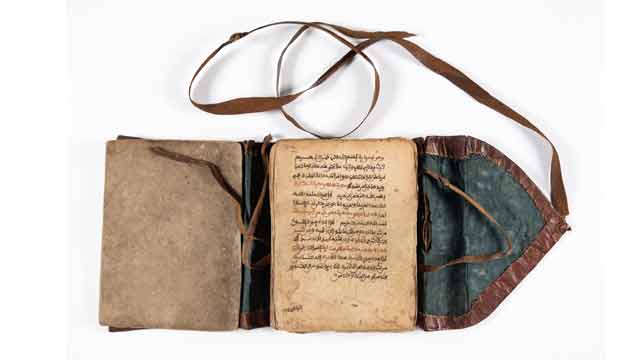
-
 Mahmoud Malik Saako
Mahmoud Malik SaakoThe Qur'an is typical for the time and the West African region in general. The idea originated in North Africa such as Morocco and Algeria. But the writing was later, influenced by the Hausa and Mande scholars in West Africa. The texts in this Qur'an are the same as the original from Arabia. But there are differences in the kind of calligraphy found in these Qur'ans and those found in Arabia. One important aspect of these Qur'ans is the calligraphy that comes after the beginning of a new chapter or Surah. Again, the use of red, gold and black colour in writing the Qur'an makes them unique.
Artistic features of the Qur'an
- The leather cover used to protect the Qur'an was designed with some relief using black ink. It shows that leather workers were very important in society. Similar covers are made but in a form of a bag for the Qur'an while others are wooden covers with a leather thong used to hold the wooden covers together with the Quran.
- The Holy Qur’an has Ayahs (words or verses) and Surahs (chapters). There is Bismillah before each Surah. The Qur'an has 114 Surahs or chapters.
- Calligraphy works in some portions of the Qur'an. Calligraphy as the art of beautiful, decorative writing has existed in Islam since the word of God, the Qur'an, began to be written. In West Africa which was known to the Muslim world as Bilad-al-Sudan (land of the blacks), Islamic calligraphy naturally came with Islam. They are just symbolic to honour the holy text.
- The use of three colours in writing such as gold, red and black: This shows how versatile the person was in giving an artistic impression of the Qur'an based on the Kanemi
- A large decorated sign known as shurafah (ennoblement) is written at the end of every fifteen hizb (that is the division of the Qur’an into parts and portions). This is done as a means of honouring the holy text. (See images below.)
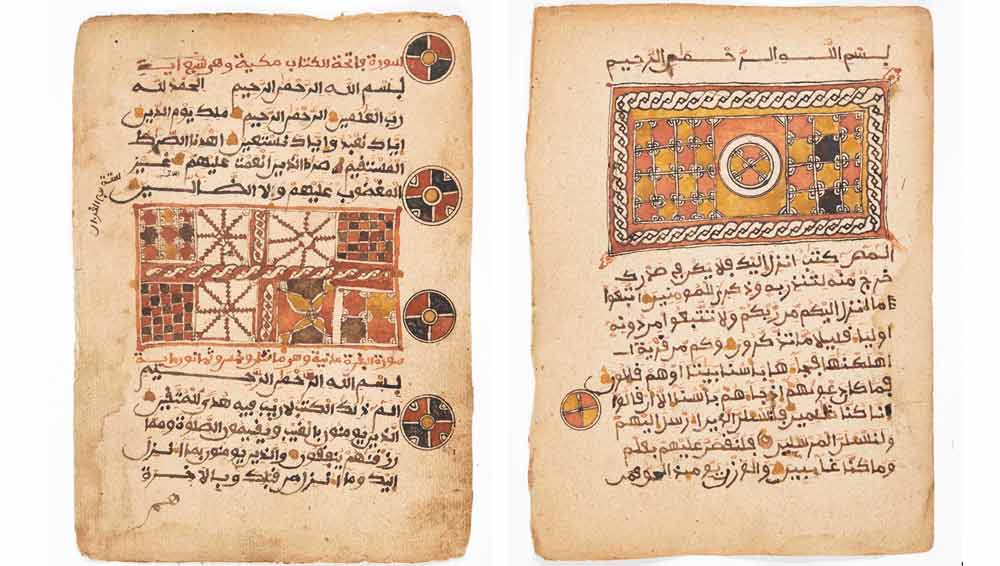
The shurafah or ennoblement at the beginning or end of a chapter (surah) is indicated in the two images. The gold, red and black colours are used to give it a splendid look. (Qur’an. 16th-17th century. Mossi in Togo. Museum Fünf Kontinente Munich. Courtesy Museum Fünf Kontinente. Nr. 20-3-1. https://onlinedatenbank-museum-fuenf-kontinente.de/detail/collection/b77d064f-c603-493c-af03-fc167f739586. [Stand: 08.08.24]. Photo: Nicolai Kaestner)
Material used for the Qur'an
The paper used is brown and a bit hard as compared to today’s paper used for printing. The ink is mixed in a variety of colours. There is jet-black ink that shines. Then there is a colour of black mixed with red and another colour which is neither black nor red. The ink is obtained through the following method. The roots of the desert date tree are collected and burnt into charcoal. This charcoal is then scraped into fine powder. The powder is filtered through a light piece of cloth. Water and gum Arabic are then added and the whole mixture is left to warm up in the sun. The mixture once prepared in this way gives out a very nice smell and its taste is very sweet.
Another method employed to produce the calligrapher's ink is to obtain the chaff of bulrush-millet (Pennisetum Spicotum), chips of the gum-yielding acacia (sieberiono), pods of the plant Egyptian mimosa (Acacia Arobico), slag from smithy and some bits of iron. All these items are then mixed with water. The mixture is filtered and boiled and once it is cooled it becomes ink. If the calligrapher wants a reddish colour or magenta colour imported dye of green or magenta colour is added. This type of ink is meant for the writing of the alphabet only and is always done in pure black. The ink is usually stored in small clay ink pots or small round gourds. The recent time, the ink is kept in small bottles.
What are the general specifics of these early Qur’ans?
The Qur'an is the holy text of the Islamic religion. In Islam, the Qur'an is believed to be the book of God’s words. The holy text remains sacred and unchanged since the beginning of time. The Qur'an is known as the most powerful text in Islam. Islam is a monotheistic faith and people of the religion take great pride in believing in pure monotheism. As followers of the Qur'an, Muslims must believe there is no one else besides Allah because Allah is the only one we worship sincerely, thus he is seen as the most powerful figure in the religion of Islam.
The Arabic text of the holy Qur'an in a book is known as the mus-haf (literally "the pages"). There are special rules that Muslims follow when handling, touching, or reading from the mus-haf. The Quran itself states that only those who are clean and pure should touch the sacred text. It is indeed a Holy Quran, a book well-guarded, which none shall touch but those who are clean... (56:77-79). The Arabic word translated here as "clean" is mutahiroon, a word that is also sometimes translated as "purified."
It was only Muslim believers who are physically cleaned through formal ablutions should touch or handle the pages of the Quran. Again, the Qur'an should be closed and stored in a clean or respectable place. Nothing should be placed on top of it, nor should it ever be placed on the floor or in a bathroom. Furthermore, when copying the Qur'an by hand, it should be legible with good handwriting. If you are reciting it you need to use a clear and beautiful voice. A worn-out copy of the Quran, with broken binding or missing pages, should not be disposed of as ordinary household trash.
Acceptable ways of disposing of a damaged copy of the Quran include wrapping it in cloth and burying it in a deep hole, placing it in flowing water so the ink dissolves, or, as a last resort, burning it so that it is completely consumed. But the translated Qur'an according to some scholars can be handled either by Muslims or non-Muslims.
Uses of the Qur'an
The Qur'an is meant for reading or recitation known in Arabic as taliwa. The recitation of the Qur'an is a highly honoured performance in Islam in which Allah blesses both the reciter and the listener. A person who memorizes the whole Qur'an is given the honorary title of a Hafiz (memorizer of the Qur'an). Again, the reproduction of the written Qur'an is as important as oral recitation. Two early calligraphic styles evolved in the writing of the Qur'an, Kufic (the more boxy, angular, heavy, and formal script) and Naskhi (the more elongated, rounded, cursive script).
The words in the Qur'an are regarded as the words of Allah and, therefore, handled with respect. Muslims also hold the view that some of the words contain mystical properties and as a result, Muslim religious scholars are sometimes consulted by people who have spiritual or psychological problems. They write verses from the Qur'an to ward off such evil spirits or for protection. The Qur'anic verses are often accompanied by diagrams drawn on a board and then washed off and given to the client to drink. As a result, these boards have high values based on the extent they have been used. It is believed that the older the board the more efficient it would be and vice versa.
At the Museum, there is one of the Qur'anic writing wooden boards that have verses from the Quaran on one side and diagrams on the other side. This board is brown and round at the base with a handle in a form of an animal beak. The surface is smooth while some old writing has remained and can be seen (see image below).
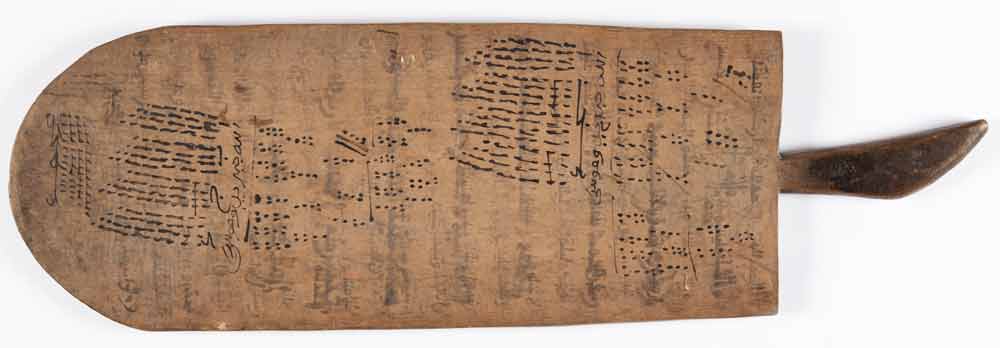
Board (Courtesy Museum Fünf Kontinente. Nr. 9-48. Photo: Nicolai Kaestner)
Where is the Qur’an kept?
Old Qur'ans were usually placed in two wooden covers before the use of leather cases or bags. It was easy to carry it once it was placed either in the wooden covers or in the leather bag. This is very important not to mess up the loose papers of the Qur'an. The two wooden covers after the Qur'an is placed and bound with a thong. There are two holes in the middle edge of the covers where the thong is passed through to bind the two wooden covers with the Qur'an. This method of bounding the Qur'an with wooden covers was practised during the early Abbasid period. Many of the early Abbasid manuscripts were copied into several volumes based on the Kufic script which was fairly heavy and not very dense. The Qur'ans of this early period were bound in wooden covers, structured like a box enclosed on all sides with a movable upper cover that was fastened to the rest of the structure with thongs. In this period, the Quran was arranged into 20 Juz or parts instead of the original 30 Juz during the Umayyad period. These wooden covers can be found at the Museum Fünf Kontinente (Inventar Nr 15-17-148).

Wooden cover of a Qur'an. Museum Fünf Kontinente. (Courtesy Museum Fünf Kontinente. Nr. 15-17-148. Photo: Nicolai Kaestner)
Appendix
When is it read and how?
It is read during the five daily worship by Muslims, at leisure times, during periods of hardship, during important occasions etc. However, in West Africa, it is read even at funeral celebrations. In many instances, the whole Qur'an is shared among those who can read, or the 30 Juz are shared among 30 people who recite or read it.
Islam in West Africa
Islam as a religion was revealed to the Prophet Mohammed in the 6th century in the Arabian Peninsula. Africa was the first continent into which Islam spread, from the Arabian Peninsula in the early 7th century. By the 10th century, the Berbers of West Africa were converted to Islam by their North African counterparts. It was the Berber Muslims who began to spread Islam into Western Sudan by the end of the 10th century through their trading activities. The Berbers of West Africa also converted some of the Manding-speaking traders to Islam, and they also began spreading it alongside their commercial activities. It was the Mande traders who began to spread Islam into many parts of West Africa through trading activities. The nature of Islam made it easy for the indigenous people to accept it as adherents were able to tolerate, to some extent, some of the local beliefs.
Later, the Hausa from northern Nigeria were also involved in the Kola-nut trade in the mid-15th century. The rulers of many of the Western Sudanese States encouraged the trans-Saharan trade and extended hospitality to both traders and visiting Muslim clerics. The most crucial factor in the diffusion of Islam into many parts of West Africa was the conversion of some of the rulers to Islam. Between the 14th and 16th centuries, many rulers of the Mali and Songhai empires were Muslims and performed the annual Islamic pilgrimages to Mecca to establish trade relationships with the Muslim world. It was during the era of European colonization of West Africa that led to the spread of Christianity among the locals.
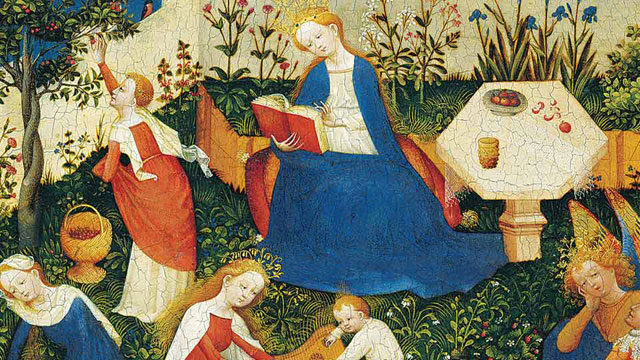
-
 Constanze Kirchner
Constanze KirchnerThe motif Paradiesgärtlein originates from Christian imagery. It was painted many times in the 15th century, especially in Italy and along the Rhine. The enchanting devotional picture shows Our Lady enthroned on a bright red cushion in the middle of the garden, tall, in a radiant blue robe, as the figure dominating the picture. Her head is bowed and she is reading a book. A crown with leaves distinguishes her as the Queen of Heaven.
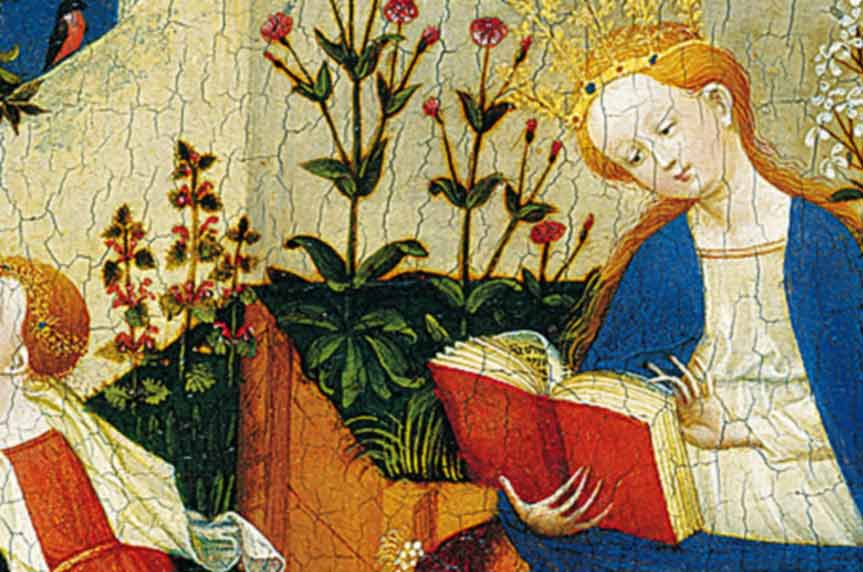
The Christ Child is playing at her feet. The other female figures in the left half of the picture are also to be understood as Holy Virgins because of their splendid clothing. A clear assignment of these saints is uncertain (Keazor 2001, p. 231 ff.). St. Barbara is probably drawing water with a golden spoon from the (life) well in the foreground on the left, because legend attributes to her miraculous powers in overcoming a period of drought. And it could be St. Dorothea who picks cherries from the (life) tree and puts them into the basket, although – according to the legend – the cherries are handed to her (ibid.). The figure holding the plucked instrument (psaltery) to the infant Jesus is interpreted as St Catherine of Alexandria or St Agnes. She is distinguished by a golden diadem with floral decoration and by her flowing hair (ibid.).
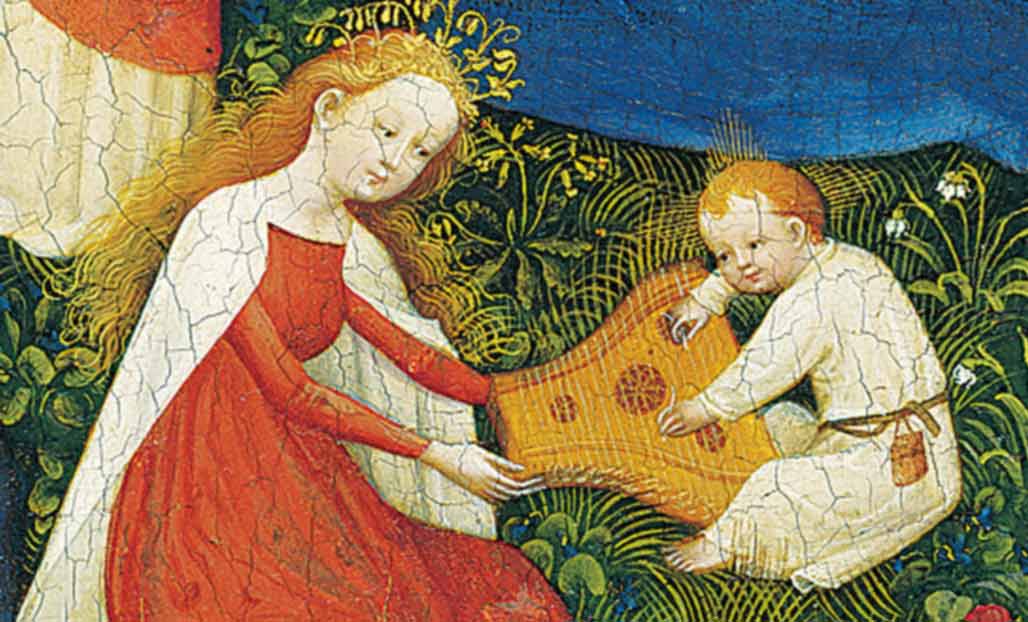
The group of figures on the right consists of the pensive Archangel Michael, also crowned with a golden plant, and – facing him – St. George in chain mail, next to whom lies a small dead dragon. A third figure, probably St. Oswald, bends down to both of them, as a raven peeps out from behind his knee (ibid., p. 233). He is holding on to the tree of knowledge. Saint George has of course already conquered the dragon, which stands for evil, and looks expectantly at Mary. Under another tree sits a frightened monkey with the distinct features of the devil.
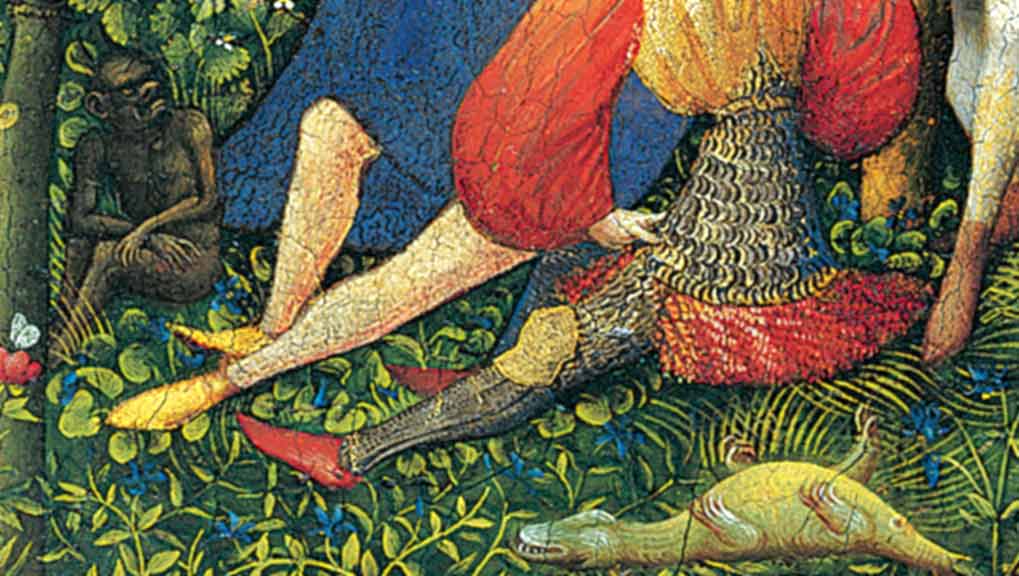
According to biblical legend, he is held in check by the Archangel Michael, the fighter against evil and guardian of paradise. The apples mentioned in the creation story, which tempted to sin, lie ready on the hexagonal, bright white stone table. Wine and bread refer to the Last Supper. The table is compositionally remarkable, dividing the male group of figures from Mary.
Both paradise and the garden stand for a protected, enclosed and bounded place that provides food and water as well as peace and quiet. In the garden, flowers, herbs, fruits and grasses blossom and grow, spanning a supra-temporal, idealising arc from spring (lily of the valley) to midsummer (roses). Especially the white-flowered plants, such as the lilies, stand for the purity of Mary. Just like the plants, twelve birds of different species are depicted in detail and realistically - and thus identifiable (Brinkmann/ Kemperdick 2002, p. 93).
Compositionally, the colour scheme dominates the picture: the secular blue sky frames the graceful Mary leaning towards the book, whose blue robe corresponds with the blue clothing of St Barbara and that of the archangel. The white garments of the saintly figures, the wall in white tones and the light-coloured table enclose the baby Jesus, also dressed in white, in their midst. At the same time, the bright red of the virgins' robes, the red of Mary's book, her seat cushion, St. George's sleeves, the blossoms and fruits reinforce the clear composition, which is additionally underlined by the complementary green of the plants and once again places Mary at the centre of the picture's action. The spatial effect is essentially determined by groupings and overlaps of the figures and pictorial objects; there are no shadows in the heavenly world.
The figures appear relaxed, peaceful and serene, the colourfulness and the abundance of vegetation with springing water embody serenity and earthly happiness. The Holy Virgins are engaged in an occupation that does not cause any trouble. The clothing and hair ornaments are reminiscent of courtly life in a well-tended castle garden. This is also indicated by the killed animals, which are not usually part of the heavenly world, as well as a tree of knowledge that does not bear fruit. This combination of the divine world as a heavenly paradise with the impression of earthly reality characterises the picture to a great extent and thus lends it a peculiar mood, explosiveness and tension in its contemplativeness.
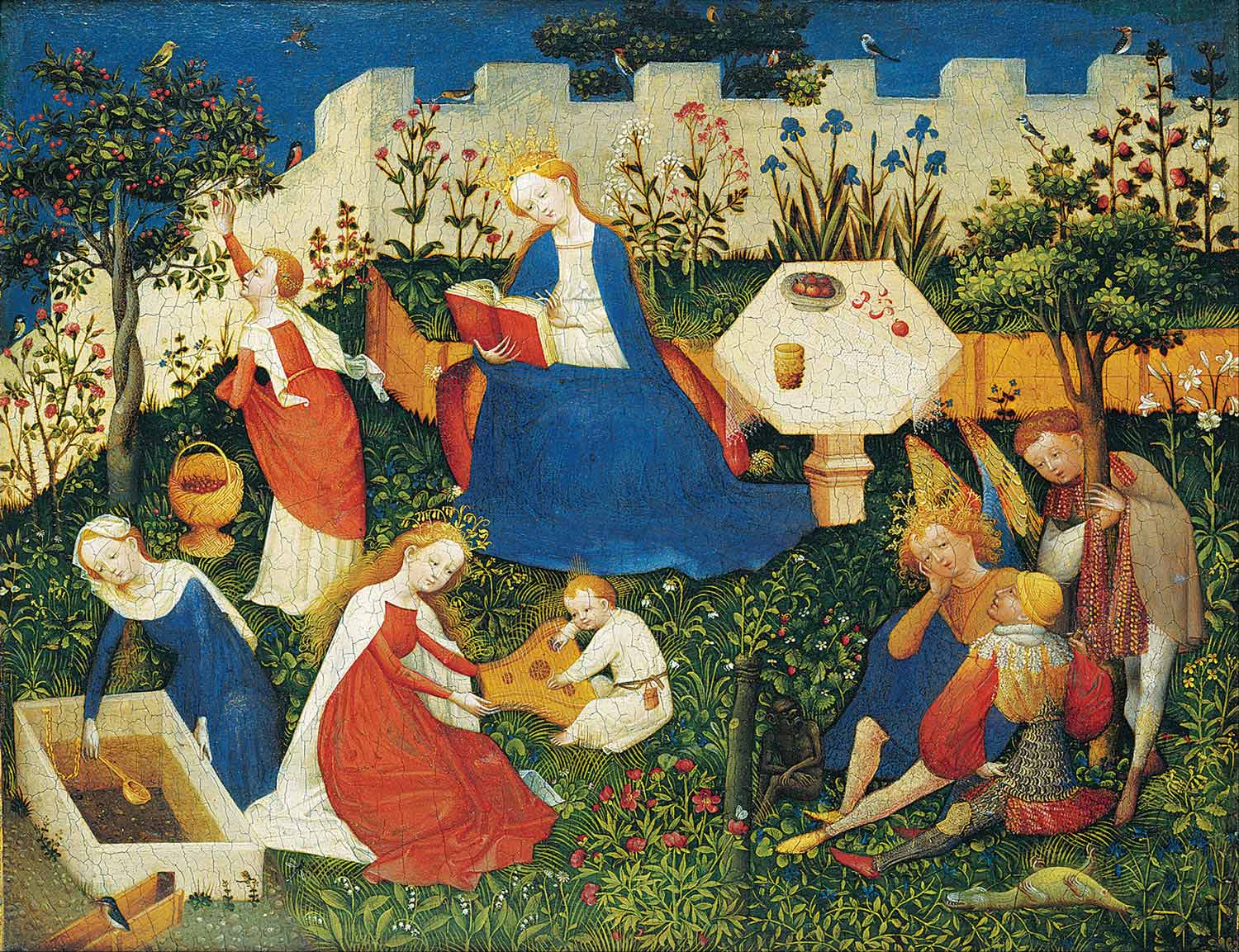
There are numerous studies on the painting technique, the use of colour, the symbolism, the identification, function and activities of the saints, the plants and animals. Also research has been done on provenance in the monastic context or on the attribution of the picture type as ‘hortus conclusus’ (closed garden as a symbol of Mary's virginity). ‘Hortus conclusus’ is often alluded to in paintings of Mary - a garden with an enclosure and with certain plants that refer to Mary (lily, rose, but also lily of the valley or strawberries) - as can also be seen in the Paradiesgärtlein. At the same time, however, the Paradiesgärtlein evokes associations with the gardens of pleasure and love, as found, for example, in engravings by the Master of the Gardens of Love in the mid-15th century (http://bildersammlung-prehn.de/de/node/946, 06.03.2019) - and in this ambivalence once again clearly emphasises the link between divine and earthly worlds of life.
What does the Paradiesgärtlein mean?
The Paradiesgärtlein defies a clear interpretation. The duality of good and bad is hinted at, but the victory of good in paradise over evil or sin – represented by the dead dragon and the vanquished devil – is clearly emphasised. However, the ideal state in paradise is not unbroken: With their tilted heads, the figures in the painting appear pensive, as if they know that there is a life of tormenting reality outside their shelter. The garden as a retreat from the dangerous outside world protects, where in everyday life there is oppression, fear of hunger or sudden death. With the devotional image, religion offers comfort in the promise of salvation to a paradisiacal existence in which the threatening is banished. The imponderable reality is countered by the protective enclosure of the massive wall – outside, the world is full of danger.
The devotional image builds a bridge from this world to the hereafter and vice versa. It opens up a view into eternity and thus into a transcendental space of experience that lies outside finite everyday experience. Visual means are used to create access to the divine, an access that at the same time recalls one's own experience of the world and yet enables the imaginative experience of transcendence.
As an anthropological constant, the idea of a transcendent reality, which usually characterises life after death, runs through many cultures. Experiences of transcendence are described in many ways and often refer to extrasensory perceptions and supernatural forces to which the respective belief is tied.
Why is the painting interesting for art education?
Transcendence and spirituality are often at the core of cultural traditions - in this case Christian heritage. It could be exciting to enter into a conversation about this and to draw on examples of non-European cultural testimonies of faith from the 15th century. In this way, world history can be opened up and a Eurocentric perspective on the history of Western art can be expanded. (As the epitome of European beliefs about the Garden of Eden, the work also stands at the end of the medieval conception of nature and art.)
The image announces divine truth: In paradise, the world is in order. Outside the garden, man lives in untamed nature and is exposed to all incalculable events. With its religious context of origin, the painting's function is primarily to depict an otherworldly, divine order that illustrates the promise of salvation after death in contrast to the earthly hardships of the late Middle Ages. But the pictorial interweaving of earthly and heavenly life already points beyond the late medieval conception of the image. The shielded divine world view experiences ruptures, opening and change.
Not only can the work paradigmatically explain the end of the Middle Ages and the development of art history. Furthermore, the it invites discovery: plants can be identified, animals and groups of figures with their actions tell stories that can be researched, re-enacted, developed further and transformed into the present day. And last but not least, the linking of divine and earthly reality allows analogies to virtual and real, individual and global worlds of life.
References
- Brinkmann, Bodo/ Kemperdick, Stephan (eds.): Das Paradiesgärtlein. In: German Paintings in the Städel: 1300 - 1500, Catalogues of the Paintings in the Städel Art Institute. Frankfurt am Main/ Mainz 2002, pp. 93 -120
- Leaflet of the Städelsches Kunstinstitut on the work: "Das Paradiesgärtlein", c. 1410-1420. Upper Rhenish Master, mixed media on oak, 26.2 x 33.4 cm. Städelsches Kunstinstitut, Frankfurt am Main o.J., o.S.
- Historisches Museum Frankfurt am Main, Prehn'sches Kabinett. http://bildersammlung-prehn.de/de/node/946 (06.03.2019)
- Keazor, Henry: "Manu et voce". Iconographic Notes on the Frankfurt Paradise Garden. Original publication in: Bergdolt, Klaus/ Bonsanti, Giorgio (eds.): Opere e giorni: studisu mille anni d'arte europea dedicati a Max Seidel, Venezia 2001, pp. 231-240. http://archiv.ub.uni-heidelberg.de/artdok/2344/1/Keazor_Manu_et_voce_Ikonographische_Notizen_zum_Frankfurter_Paradiesgärtlein_2001.pdf (07.03.2019).
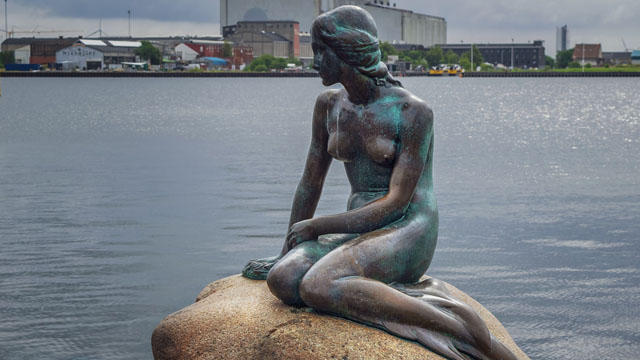
-
 Bea Lundt
Bea LundtA helplessly wretched female figure: The “Little Mermaid” in Copenhagen
Well known worldwide is the monument of the „Little Mermaid“ in Copenhagen. The figure is called a “national symbol” for Denmark and a “landmark” for Northern Europe. The bronze sculpture of 125 cm height was constructed by Edward Eriksen in 1913. It shows a naked young woman, her feet like the tail of a fish. The intention of the sculptor was to honour and remember Hans-Christian Andersen (1805-1875), the Danish author of the story „Den lille Havfrue“ (The little mermaid). The place which had been chosen for erecting the monument is a rock in the water near the open sea; the figure turns her face to the shore of the Danish capital Copenhagen.
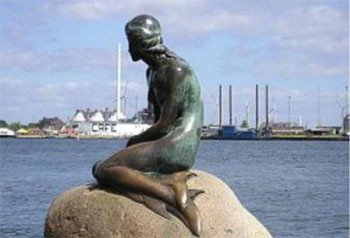
"Little mermaid" by Edward Eriksen 1913, 125 cm, Copenhagen harbour,
https://dreamguides.edreams.de/daenemark/kopenhagen/die-kleine-meerjungfrauWith this installation the country accentuates its identity of being involved in the element water and its representation in literature and culture. The famous piece of art transports different messages and reactions, has its own life and a specific history.
The narrative behind this figure, a fairy-tale for children, is well-known in Europe: A young mermaid wants to get into contact with a prince she loves. But he never recognizes her and marries a noble woman. The mermaid dissolves to foam, which flows back in the ocean. But also she is transformed to stay as a ghost in the air, where she can be part of earthly life and earn an immortal soul.
As a being of the nature the mermaid is part of the “other” of civilization and as subordinated to human and especially masculine beings. The title marks her to be “little”, not having a name and individuality. She did not receive any respect and interest, not even for her female beauty. By this ignorance she is killed, with no traces of her life. The story shows the most helplessly wretched female figure in literature we can imagine.
Within a memory-culture the monument might help a region of seafarers to feel superior over the sea and the beings involved with this element. Denmark was a colonial power. From overseas came goods and wealth on trading-ships. People from West Africa were deported as slaves to the Danish colonies Carribean Islands, where they had to grow sugarcane. The Molasses, the essence of this plant, was brought to Northern Europe, where Rum was made from it, the central product which made towns very prosperous. In visualizing a sentimental mythical story from the period Biedermeier the monument helps to divert from this context or even to suppress it. But the symbolic meaning might also be an accusation against (male) neglection of the nature and a warning for girls to hope to win the dream prince. It also can be seen as a protest against monarchy, aristocratic lifestyle and the glorified royal history of the country.
Performance and public reactions
Many tourists visit the monument every day and there are activities and actions around it. It stimulates the wish of giving the mermaid the attention she did not get in the story, as a symbolic compensation. There are also anonymous acts of aggression and destruction against the statue (see examples). Feminist groups protest against the offer of a voyeuristic view on a naked woman in this exposed location, this is also done by conservative circles in a prudish mentality. The statue also provoked campaigns of environmentalists who added her slogans demanding protection of other creatures being under control of human power like the whales for example.
An independent queen in Premodern Times: Melusine
The fairytale of Andersen is a modern adaptation of older stories and there are lots of distinctions within the development of this symbolic figure. Very common throughout several European languages is a narration about a female figure with the name Melusine, which is derived from the french word “mere” (mother) of the Lusignans, an influencial family, living in France and in Cyprus, from where the legend might have reached Africa. In the shape of a woman she marries a nobleman and rules over the country, building it up in an innovative way. When her husband discovers her in the bathroom being half a dragon, she flies away. In the official belief she is said to be a dangerous demon with no soul, destroying Christian families. But in aristocratic traditions the mermaid is understood as the ancestress of their gender and put in their heraldry. In illustrations in books she is depicted as a courtly lady with half the body of a fish, standing in a basin; the destructive element of water being abolished. She is not a victim, but the active part in the plot; when she leaves, her big family suffers and the country loses its strong ruler with her outstanding creativity.
The twofold character of Melusine represents very well the beginnings of noble families: Polygamic life was common, and when the institution of the Christian marriage was imposed, one of the spouses of a ruler needed to be sent away. The element water might hint at the origin of the mistress from a village near the river outside the castle, which is on top of a hill. In popular narrations she was given an aura of mystery, having the body of a dangerous monster.
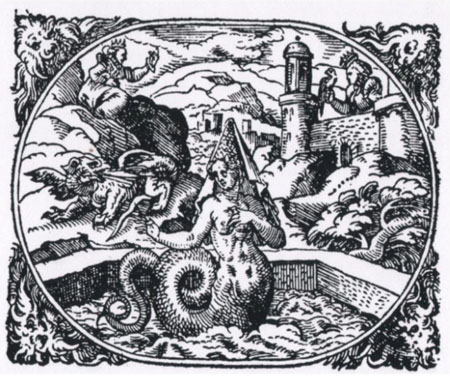
Melusine. The mermaid as a court lady and the ancestress of noble families (woodcut and illustration of a manuscript 15th century), Thüring von Ringoltingen: “Melusine”. In der Fassung des Buchs der Liebe (1587), hg. Hans-Gert Roloff, Reclam Verlag Stuttgart1991, S. 3.
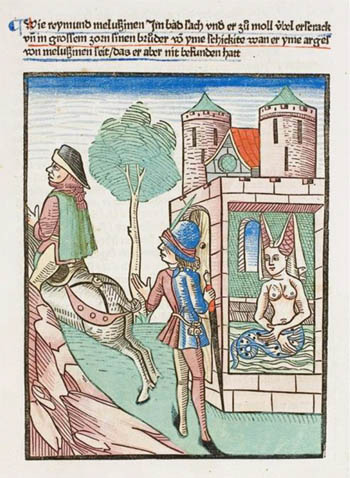
She is discovered having half a fish-body (book illustration 15th century), Thüring von Ringoltingen: „Melusine“ First printing Basel: Richel, around 1473/74. digit. ULB Darmstadt urn:nbn:de:tuda-tudigit-35087
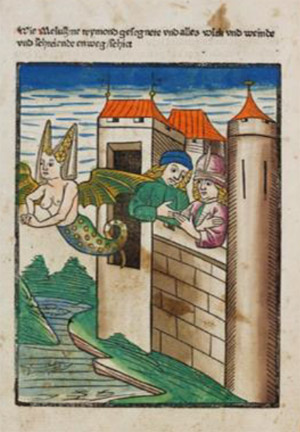
She flies away (book illustration), from "der Seelen Wurzgarten“. St. Peter pap. 23, Coburg bei Schwäbisch Hall 1467 (digitized by the ‘Badische Landesbibliothek Karlsruhe’, 65v.)
The modern tale of a beauty killing her lover: Undine
With the name “Undine” (lat. “unda”: wave) in Romanticism the mermaid-figure develops vampiric qualities, killing her lover by a kiss when he marries another woman.
This motif inspired many paintings. They channel phantasies and visions about the chances and problems of a partnership between persons from different origin and about death as the consequence of an unsuccessful encounter. How can strange-looking persons, which come from or over the sea, be integrated?
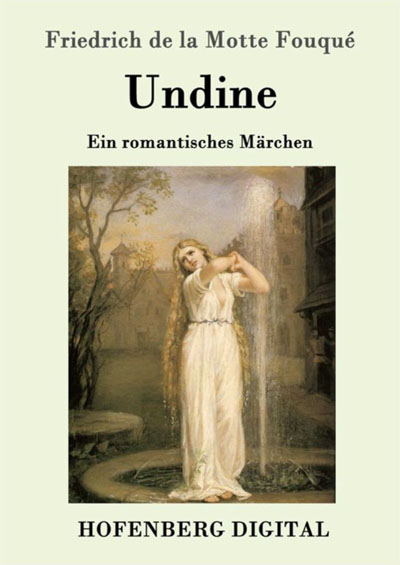
Friedrich de la Motte Fouqué (1777 – 1843), novel, 1814, published by Karl-Maria Guth. Berlin 2015, Painting by John William Waterhouse 1872.
Conclusion
Premodern times reflect the mermaid mainly as bringing fertility from nature to mankind, hoping to gain a soul through marriage with a human being. There are systematic changes to this story during modernity, which might result from the background of colonialism as absorption and subjugation of everything different and “strange”. Men are longing for its attractiviness, but also fearing that this inclusion of a natural being might cause protest and fury. The European tradition can be said to be a parable about migration and exchange between different worlds, the mermaid being a symbol-figure for the futile attempt of colonizing the other.
The task of a transcultural comparison: Mami Wata
In Ghana I learned about Mami Wata, a traditional African figure, the patron of fishermen. In Quidah (Benin) I saw her as a goddess of the python, the holy snake. She has her own shrine where specifically educated priests pay tribute to her to keep her merciful. The name is interpreted to be a pidgin-version of „Mother of the water“. Scholars from Europe assumed that Melusine was carried on ships' bows in the 15. century from Europe to the West-African coast, where her narrative interlaced with local narrations with their own long tradition of water-goddesses. But: It might also be the other way round, from West-Africa to Europe, probably on the trade-roads through the Sahara. There, the legend emerged much earlier and arrived in Europe as early as the 12th century, when the mermaid-stories began to gain popularity. How is a figure transformed when it is transferred to a region with such different history and traditions?
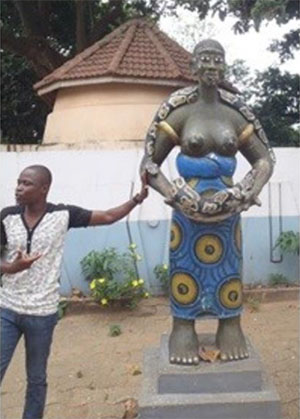
Temple of the Python, “Holy Forest”, Quidah (Benin) 2015 Foto: Nina Paarmann
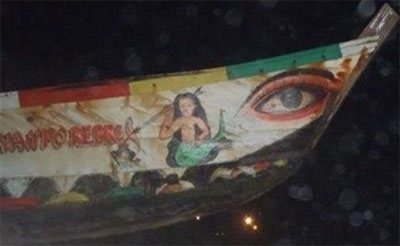
Fishing boat in Winneba (Ghana) 2012, Foto: Nina Paarmann
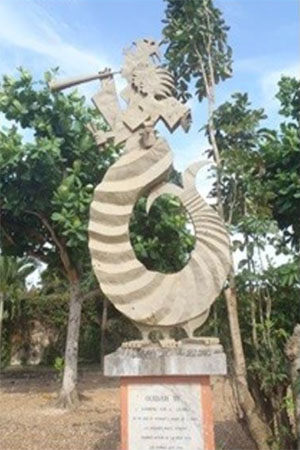
Quidah (Benin) 2015: “Slave Road”, Text: “memorial for the ‘tree of forgetting’ which had to be orbited, nine times by the male and seven times by the female slaves”, Foto: Nina Paarmann
References
- Hans-Christian Andersen: „Den lille havfrue“ (The little Mermaid) fairytale, in: Sämtliche Märchen 1-2, München 1974 (hg. Nielsen, E.).
- Bea Lundt: Melusine und Merlin im Mittelalter. Modelle und Entwürfe weiblicher Existenz im Beziehungsdiskurs der Geschlechter. Ein Beitrag zur Historischen Erzählforschung. (Diss. 1990), Fink-Verlag München 1991.
- Bea Lundt: Wassergeister als universales Motiv. Paracelsus’ Deutung der Nymphengestalt und die Figur Mami Wata in Afrika. In: Nova Acta Paracelsica. Beiträge zur Paracelsus-Forschung (NF 28). Hg. Pia Holenstein Weidmann. Bern u.a. 2018, S. 9-40
Edited by Kelly Thompson.
published February 2020
 Esther Kibuka-Sebitosi
Esther Kibuka-SebitosiMermaids at the East African coast
The Mermaid in Copenhagen reminded me of the stories I heard when I visited the coastal town of Mombasa, East African coast in Kenya. This was back in the University days when I accompanied my friend Salome to visit her mother in Mombasa. We travelled by bus all the way from Kampala through Nairobi to Mombasa, a long journey of over 24 hrs. We landed at “Mwembe Tayari” Kiswahili translation “ripe mangoes”- this market is a vibrant place with all sorts of mangoes to eat. It was a market of all diverse cultures: Arabic, Swahili, Bantu and the main language was Kiswahili- a mixture of Arabic and Local Bantu languages. The myths, stories and folklore are all mixed taking origins from Arabic and African descent.
Back to the Mermaid stories, once upon a time, a man went to have a drink at one of the Mombasa bars. He drank and went home with a woman. Before they slept, the mermaid wangled her fins to switch off the lights. He ran out of the house and told the whole town up to Malindi, a faraway town.
Mermaids are both a mystery and envy because they are told to be very beautiful women who come, seduce men, and then disappear in the night. Another story was that the mermaids were “Genie” or ghosts, which are really demons of the sea. When my Pastor friend, the late Lule went to preach the gospel in Mombasa, he had to cast out many. He told me that one night he slept only to be woken up a mermaid to command him to go and leave town. He just prayed in the name of Jesus and she left without a trace in a closed door. He said, when you see one, you need to do some spiritual warfare; use the Name of Jesus and the Blood of Jesus as weapons of mass destruction.
Stories of mermaids are varied but when told by a Swahili woman; you need to sleep over, as they never end. You need to have some “mandazi” (sweet like a doughnut) and African Tea with Masala (spices) as you listen to these rich African tales. Will keep you posted when I visit again.
References
- http://blog.swaliafrica.com/mami-wata-the-mermaids-in-african-mythology/2/
- Dona Fish, Angola, ca. 1950
published February 2020
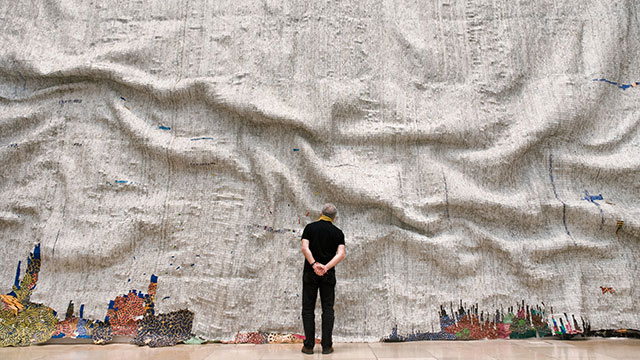
-
 Patrique deGraft-Yankson
Patrique deGraft-YanksonThe Rising Sea by El Anatsui is a naturalistic presentation of an ocean in turbulence, which elicit attention through both grotesquery and finesse. The work, which covers an area of about 14,38 by 6,90 meters, is made up of several pieces of flattened aluminum bottle tops stitched together with copper wires into a massive sheet of grey wall overlay.
To achieve the intended illusion, the artist manipulated portions of the metal fabric into large series of ridges of different sizes that combine into an irregular rhythm randomly positioned across the surface of the sheet to simulate sea waves. Beyond supporting the movements of the sea waves, the rhythm created by the raised portions of the work also provides narrow range of values that effectively bring out the three-dimensionality of the work and transforms the otherwise flat sheet into an illusionistic volume.
Like the texture of oil paints in Van Gogh’s Starry Night, the texture of the stitched pieces of metals sheets introduce energy into the work, bringing out the fluidity of the sea and the potency of the mesmeric sea waves. Indeed, improper disposal of those materials used (and many others) is causing a lot of nuisance in his home country and other parts around the globe, with the sea being the most affected. Therefore, right from the materials used to its marvelous finishing, it is not difficult to discern a blend of severe censuring and admonition in the voice of the artist. The sea is, in the way presented, depicted as rising against improper treatment; and El, by the pains taken to stitch every piece of material together, seems to emphasize the need to make it our business to salvage the sea from improper handling.
The sea, which has served as an important source of livelihood for Ghanaians over the centuries invokes multidimensional viewpoints and draws out divergent responses and reactions depending on its relationship with the people. Among the coastal dwellers (and indeed a very great population of Ghanaians), the sea is considered an important resource for commercial activities, an arena for entertainment and recreation and grounds for spiritual exploits and worship.
He himself being born in the coastal town of Anyako in the Volta Region of Ghana, El seems to know so much about the sea. Growing up, he most likely experienced the sea being perceived, treated and utilized in many different ways. Besides its major use for commercial activities and other useful ventures, he might have listened to many stories about the sea as a god (with other inhabitants), as a provider and as a friend. He might have learnt about how the sea and her inhabitants contribute to the fortunes of the people. He might have witnessed how people got healed as they bathed in the sea, or had their fortunes turned around as they threw some coins in the ocean and made their requests known to the sea.
Beyond this, he might have also been warned about the consequences of flouting the taboos and other prohibitions that regulate the “use” of the sea, including forbiddance from desecrating the sea with unhealthy practices such as defecating in the sea, throwing filth into the sea or wearing sandals or shoes in the sea and the need to observe the tabooed fishing days, and so on. Besides, another important thing which Ghanaian coastal dwellers take very seriously is the need to adhere to physical signs and conditions of the sea, which have various local interpretations and implications. For instance, there are periods when the sea is considered as “full”, during which times the sea waves “rise” and become more intense and turbulent. Fisher folks are supposed to take a rest from “climbing the sea” (as they say in the local parlance) as the sea is likely to be unfriendly, and therefore unconducive for fishing.
Factors that cause the “rising” of the sea may not be ordinarily known. However, according to coastal dwellers, there is always something sinister about a rising sea – either somebody got drowned, or someone or a group of persons might have violated the rules of the sea god – and what motivated El in his presentation of the Rising sea might not be any different from what are traditionally believed. Probably the sea is fed up with deliberate dumping of wastes and toxic materials into her bowels. Therefore, she must rise!
But the “full” or “rising” sea is not as unfriendly as it sounds. Though it prevents fishing activities, which might be one way of punishing the people for disrespecting her, it also affords the people the opportunity to dry up their canoes, mend their nets and relax in the beautiful view of the sea along the coast. The occasions of the rising sea also witness other people who just move along the shores to observe the large waves that gather in the deep ocean, roll angrily towards the shoreline and dissolve tumultuously at the shore in a creamy white lather. The views at the seashore during these periods are nothing short of aesthetical experience that is shared by different kinds of observers with different perceptions, questioning, discussing, enjoying.
In so many ways therefore, the spectacle of observers in front of El Anatsui’s gigantic reconstruction of the Rising Sea gives so much semblance to the natural phenomenon, and this is a fundamental underpinning to the success of El’s work.
Culturally, the Rising Sea could be perceived as an allusion to the dynamisms in life, which sometimes rise against human tendencies and restrict mundane behavior, at the same time ensuring regularization of natural behaviors. What is important is to identify what is causing what, and how to seek for the right solutions.
For it to be presented as an aesthetic piece of work, El is probably saying that, the Rising is Sea is frightening; it is confusing; it is chaotic. But she is still beautiful, because in the right time, when given the right treatment, she will calm down so we have nothing to fear. She is still our god, our friend, our provider and our protector.
published February 2020
 Ernst Wagner
Ernst WagnerEl Anatsui (* 1944) created 'Rising Sea' 2019 specifically for a particular wall in a comprehensive solo exhibition of his oeuvre entitled “Triumphant Scale” at the ‘Haus der Kunst’ in Munich. Like many of his other works, “Rising Sea” is a large-scale piece comprised of thousands of flattened liquor bottle caps (extrapolated approx. 190.000) that have been tied together with copper wire. It hangs like a large tapestry from ceiling to floor and though it looks solid, it is flexible and has a seemingly textile structure. The effect is monumental and magnificent; it impresses by the sheer size as well as by the sensual materiality of the almost infinite number of small, shimmering pieces of tinplate.
To see the composition we need to view the work from a distance. The sculpture is divided into three starkly contrasting horizontal zones. A vibrantly colored strip runs along the bottom. It appears fragile and becomes thinner and interrupted as it runs toward the lower right corner. The broad, massive, monochrome grey zone in the middle falls with heavy folds. The third zone at the top is a narrow, shiny, silver and smoother appearing plane that rises from its lower edge on the left in a sharp line upwards to the right, like a ‘Silberstreif’ (i.e. glimmer of hope).
Nearing the work, we discover bright flecks of color that emerge out of the shimmering mother-of-pearl gray middle zone. While some of the flecks appear to build concrete figurations others seem to be randomly dispersed. In the lower right corner small speckles of color gravitate toward and buzz around a concentrated cluster of speckles. We are enticed to move closer and to discover more details. Individual bottle tops become recognizable out of a speckled ‘field of pixels' or 'threads in the fabric’. One recognizes and reads the labels "Turn to open" and the names of African high-proof alcoholic beverages that are popular in Ghana or Nigeria where El Anatsui lives and works (KP Beverages, Bacco , etc.)
As with an impressionist painting, this work enables and requires two different viewing positions: close up and from a distance. Both perspectives tell different stories. In contrast to impressionism, El Anatsui’s stories address political and social issues of highest relevance. From a distance, the rising water level caused by global warming is addressed, to which the title of the work 'Rising Sea' refers. “Reading” from left to right, sculptural folds in the large gray middle area remind us of mighty waves that are in the process of destroying the narrow, speckled strip on the floor that we may associate with human dwellings and their fragile situation. The ‘Silberstreif’ is dwindling and so is hope. Obviously, this meaning is addressed directly and in all clarity.
The inscriptions on the bottle tops tell another story, the story of alcohol and slave trade during European colonialism in West Africa. Thousands of Africans were sold and taken across the Atlantic in ships to cut sugar cane in the Caribbean plantations to make rum. The rum was shipped to England and then later sold to Africa. Rum with its high alcohol content became another means of dominating an already exploited people. In the course of time, West Africans commonly used rum and other forms of alcohol for libations. However, El Anatsui only uses discarded bottle caps from liquor made in Africa today.
In turn, the process of 'sewing' the individual metal pieces together is an important, additional cultural-historical referral to El Anatsui’s roots in West Africa where there is a long tradition of weaving colorful textiles.
The close-up view of “Rising Sea” thus speaks of the past in West-Africa. Whereby the view from the distance, speaks of the future, a future that directly and indirectly affects the world globally. The narrative strands are connected by the idea of upcycling: discarded bottle caps become art, the cheapest material becomes sumptuous beauty, the past becomes present and future, regional colonialism becomes the narrative of a global threat.
It is important to remember that it is a black artist from Ghana exhibiting this threatening beauty in a space that was built in Munich to serve National Socialist racism. The title of the exhibition 'Triumphant Scale' alludes directly to this context, which Okwui Enwezor, the initiator of the exhibition, was certainly aware of. The Nazi regime, a regime without scale, built the Haus der Kunst, a building that broke all scales. El Anatsiu’s magnificent, grand scale triumphs over the excessive Nazi scale.
Challenging the Western concept of art
As an artist, El Anatsui is a representative of the Global South as well as of global art. He displays past and present catastrophes in decorative splendor. We can understand this message through classical analysis and interpretation on the base of the iconography of material and motifs. This system of decoding is familiar to us and confirms our Western expectations of a work of art. However, the simple explicitness of the content of El Anatsui’s work, poses a challenge to Western expectations of open, complex, self-contradicting art.
According to the latent notion of the community of art experts, if there is a clear content in art it should be as ironic, witty or distanced as possible. Hence, the intrinsic value of art (l'art pour l'art) eludes ideological appropriation and art gives no instructions for action. None of these tenets of Western art is is evident in Anatsui’s work. "Turn to open” with an arrow pointing up or down is the instruction repeated thousands of times in the middle section of “Rising Sea”. The sentence can be read as a directive for us to act on the challenges of our time.
El Anatsui thus negates the ‘prohibition' of unequivocal, direct symbolism and narration in the Western concept of art and its associated prohibition of politics and agitation. As a global artist, he challenges this concept. In addition, it is interesting to note that El Anatsui, unlike most Western artists, often leaves the responsibility of installing his work in exhibitions to the respective curators. In every exhibition, the same works look a little different, or quite different: folds will fall differently, pieces will be grouped differently and work that has been previously exhibited hanging on the wall may even be presented lying on the floor. With this artistic strategy, he formulates an unmistakable position from the Global South. Thus Western dominance loses its normative power in art and culture in general. The world becomes more diverse and polycentric.
Learn more about El Anatsui.
published February 2020
 ISB_Team
ISB_TeamTwo perspectives on one work of art
In 2019, a large solo exhibition of the Ghanaian artist El Anatsui, initiated by Okwui Enwezor, took place at Munich's Haus der Kunst. It was the occasion for Patrique deGraft-Yankson and Ernst Wagner to write together about one of the works there. deGraft-Yankson and Ernst Wagner agreed on a parallel writing process in order to minimise any mutual influence of their respective approaches. Thus, they knew nothing of each other's point of view. The resulting texts can be read above.
The result of this exercise is surprising and fascinating. In some aspects, of course, the interpretations of the work coincided, but in others they differed considerably. What they had in common, for example, was the appreciation of the production process and the impressive effect of material, size and surfaces. Also that the issue of environmental pollution plays a central role in the interpretation of Rising Sea. But it was precisely here that the first differences, even mutually exclusive approaches, emerged: for example, when deGraft-Yankson referred to the sea as a deity, a deity that can sometimes be friendly, but also unfriendly. Understood in this way, the sea in its immediate effect is simultaneously frightening and beautiful, it threatens and at the same time invites aesthetic enjoyment.
Ernst Wagner could easily relate this aspect to the Western aesthetic of the sublime, however, the difference becomes quite clear when we look at the underlying concept of what an art work is. deGraft-Yankson's text takes the work of art as its point of departure, but it always speaks of the sea itself, while Ernst Wagner always speaks of the work - and not of the sea. This different focus marks a fascinating difference: deGraft-Yankson is concerned with the sea, which he brings to us through his discussion, while Ernst Wagner is concerned with a work of art that simply has the sea as its subject. For deGraft-Yankson, the sea is "in" the work, it is really present. For Ernst Wagner, the sea is a represented motif, it lies "behind" the work, so to speak. It serves as a theme or a point of reference.
This has consequences for the methodology: while Ernst Wagner delivers an analysis of form, deGraft-Yankson focuses on contextualising the art work; he describes the significance of the sea for the people on the Ghanaian coast today. This difference is probably also due to the different perceptions of what the sea itself is: in his text, deGraft-Yankson speaks of the sea as an independent, souled entity, an acting being or a god that enters into a relationship with people. For Ernst Wagner, the sea - as part of the ecosystem - is also in relationship with humans, but he does not ascribe an independent will to it.
These different understandings of the relationship between human beings and the world are then echoed in an obviously equally different concept of what art or an art work is. In deGraft-Yankson's text, the work of art, like the sea itself, is charged with energy. The sea appears, as it were in the work, indeed it is present there. In the work, then, the sea materialises as something we perceive directly. In this sense, the work and the sea appeal to us to "preserve it from improper treatment [...] or it will be desecrated."
This approach of deGraft-Yankson, in which everything interpenetrates, is contrasted with Ernst Wagner's approach, which analytically separates everything: proximity and distance, splendour to be enjoyed and admonition to be taken seriously, discourse on colonialism and ecology, work and motif, art system and ecology, art system and colonialism, and so on. In the end, Ernst Wagner achieves a synthesis, but it only works on a meta-level by addressing the irritation of the Western concept of art through Anatsui's work. An irritation that dissolves or at least relativises the fundamental separation in Western understanding of viewer and object, of sign (the concrete work) and signified (the rising sea), of spirituality and reality, of art and ethics.
Annette Schemmel, then member of the ISB group, wrote to the the authors in 2020:
"Dear Patrique, dear Ernst,
Your texts are a great read and so complementary! For me, writing from Munich, the aspects raised by Patrique have opened up an entirely new reading of this marvellous piece of art, which I was lucky to contemplate at the exhibition of Haus der Kunst. What you're telling about Ghanaians' relation to the sea is unveiling and beautiful, thank you for unfolding these narratives here! Thank you all the more for sharing a piece of local wisdom (how the sea can react angrily) and linking these narratives to the global challenge of saving the sea, a challenge with impacts on localities all over. On another note, the evocation of "Starry Night" caught my eye at once and does make a lot of sense to me. I will be using it in my art classes, if you don't mind.
Ernst's reading of the piece is much more familiar to me, obviously. He is telling about the context of the exhibition on site in Munich, a context that is so highly charged! When exhibited at this specific museum, Anatsui's work can't but comment on our German history, laughing at its racism by means of its "immoderate" dimensions and calling for a long-due revision of our role in colonialism and in exploitative global circuits of goods like alcohol. It is for this potential of speaking to a place that artworks should always be seen in different locations!
I would also like to point out that Ernst is exemplifying a familiar method of accessing artworks here, a method that I am happily teaching to my pupils. This method from academic art history wants you to start from close observation and description of formal aspects of the work before risking an interpretation. By means of this strategy arguments about a work of art are meant to become more solid, even if this visible gesture of searching for the right interpretation makes a text less smooth. Thus, Patrique's and Ernst's approaches are totally complementary.
This said, I am not agreeing with Ernst in the way that "Rising Sea" is explicit in a way that certain Western art lovers might want to criticize. They might, but they would be very wrong. Let me explain: to me, the reproach of explicity rhymes with simplicity and a lack of layerdness. As you both have shown, "Rising Sea" does have multiple layers of possible interpretation and certainly some more, which have not been addressed here. These layers are visible, not only but most clearly, if the work is read against the backdrop of different locales. Artworks from our global age command us to look at them with changing perspectives. If certain Western art lovers can't be bothered to do this, they will forever be missing the point. Their fault. Let me add that you might even spot a good deal of irony in the way that El Anatsui has made this piece outstandingly beautiful, caressing the eye to the degree that every exhibition visitor wanted to take a selfie in front of it, while at the same time pointing to some very painful and threatening truths about today's humankind. Therefore, I would like to uphold that this artwork's relation to the viewers and to its places of exhibition is complex and challenging rather than simple or explicit.Annette"
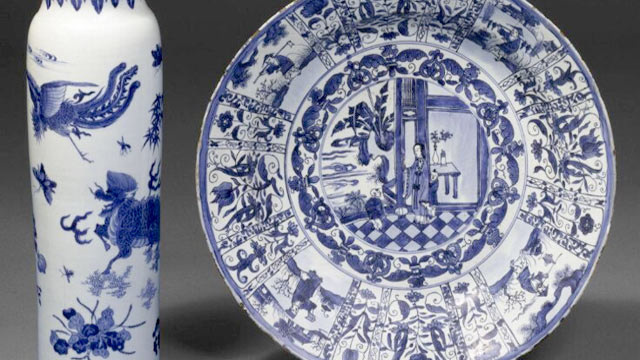
-
 Dong Xiaoling
Dong XiaolingIn the 13th century, when traffic and information were sparse, Marco Polo, a Venetian, came to China by land and served the Chinese Yuan imperial court from 1275 to 1295. The white Chinese porcelain vases, which he took back to his motherland and which are archived at San Marco Museum in Venice today, are reputed as a symbol of the Chinese vogue that went viral in Europe 300 years later. The Travels of Marco Polo has stirred European’s imagination of China[1] , and also promoted Europe's maritime exploration.
However, before the opening of the new sea route between China and Europe in the 15th century, Chinese porcelains were rarely exported to the European market as a commodity. The trade of Chinese porcelains to Europe was monopolized by Arab merchants, while European merchants could only obtain fewer Chinese porcelains from West Asia and Egypt in the form of intermediary trade. Unlike silk and spices, which were easy to carry and transport, Chinese porcelains were mostly sold locally by means of land transportation because of their fragility and weight. They were closely connected with local culture, after which they were imprinted with local aesthetic characteristics and shipped to Europe. However, Chinese porcelains were not what they had always been. Forerunner of great geographical discoveries as he was, Zheng made seven large-scale ocean voyages during Ming Dynasty from 1405 to 1433, but did not establish direct contact with Europe.
Comparatively, European humanism and capitalism were at an embryo stage. From the 15th century to the 17th century, European fleets represented by Portugal, Spain and the Netherlands carried out sailing explorations in order to seek new trade routes and trading partners as well as develop the capitalism in Europe.
First, Chinese porcelains were shipped to Europe as ballast. However, the European upper class favoured them by virtue of their smooth texture, delicate and hard casing and exquisite emblazonment. European royal nobles and bishops all were keen on owning Chinese porcelains to show off their wealth and status. European royal families’ love to Chinese porcelains did not ease in spite of the fact that they had little understanding of the materials and techniques and far away China. Philip II of Spain (1527-1598) had a collection of 3,000 pieces. Although Europe started importing Chinese porcelains on a big scale, a mysterious atmosphere always clung to these exquisite utensils. At that time, some people in Europe even thought that Chinese porcelains could play an anti-virus effect.
The French doctor Loys Guyon (1527-1617) and Sir Thomas Browne (1605-1682) of England studied Chinese porcelains. Père Francois Xavier d'Entrecolles (1664-1741), a French missionary, was in Jingdezhen, China, for 7 years during the 17th century. In 1712 and 1722, he wrote reports on the details of Chinese porcelains making which he observed and inquired into and mailed them back to the Jesuits in Europe, making it possible for French to imitate porcelains locally.
Already in 1575, Italian Medici Grand Duke Francesco's factory made an attempt to produce porcelains, which was the first imitation recorded in Europe. Such a kind of Medici pottery bottle with blue and white patterns is collected in the Louvre. Both the white glazed blue painted pottery in Delft, the Netherlands, and the Nevers kiln in France have imitated the decorative style of Chinese porcelains. However, in terms of materials, they came in pottery or soft porcelain. The alchemist Bottger did not calcinate the earliest European porcelain at Meissen, Germany until 1709. In this process, the aesthetic taste in Europe had gradually changed. The fashion of loving oriental artifacts had gradually spread from nobles to rich bourgeoisie. As the demand for relatively cheap goods had also become more and more vigorous, porcelains had gradually turned a part of the daily life of the common. The nature of Chinese porcelain had gradually changed from collectibles to daily commodities.
In order to meet the needs of European society, East India Companies in European countries imported a large number of porcelains from China in the 17th and 18th centuries. In China, this kind of porcelain for export was called export-purpose Chinese porcelain.[2] From the change of shape and pattern the export-purpose Chinese porcelains can be roughly classified into traditional styles, hybrid styles and foreign styles.
1. Traditional styles (The shape and decoration of porcelain have not been influenced by foreign styles, and are no different from products on the Chinese market.)
From the opening of the new sea route in the 16th century to the lift of the ban on maritime trade in 1684, it was illegal for Chinese to export porcelains. As per the ban on maritime trade in the Ming Dynasty, non-governmental maritime trade was strictly prohibited, while official tribute trade was allowed with strict restrictions. Foreign countries could only conduct limited official trade with the Ming authorities. Since then, the Qing authorities have repeated the ban on maritime trade. The production and shipment then were at great risks.
Merchants usually purchased Chinese porcelains in Guangzhou and then shipped them abroad from Macao, making the export-purpose Chinese porcelains dominated by traditional Chinese style at this stage. It influenced the early stage of the Chinese style in Europe as well as the reproduction and imitation of Chinese porcelain with soft pottery in Europe. Chinese porcelains were mainly used as daily necessities, such as dishes, bowls, bottles and pots. But there were few ornamental porcelains as well. The decorative patterns mostly came in cloud-dragons, deer, horses, cranes, monkeys, flying butterflies, birds and insects, folding branches and flowers, fairy ladies with babies, city walls with mountains and waters, auspicious characters, etc.
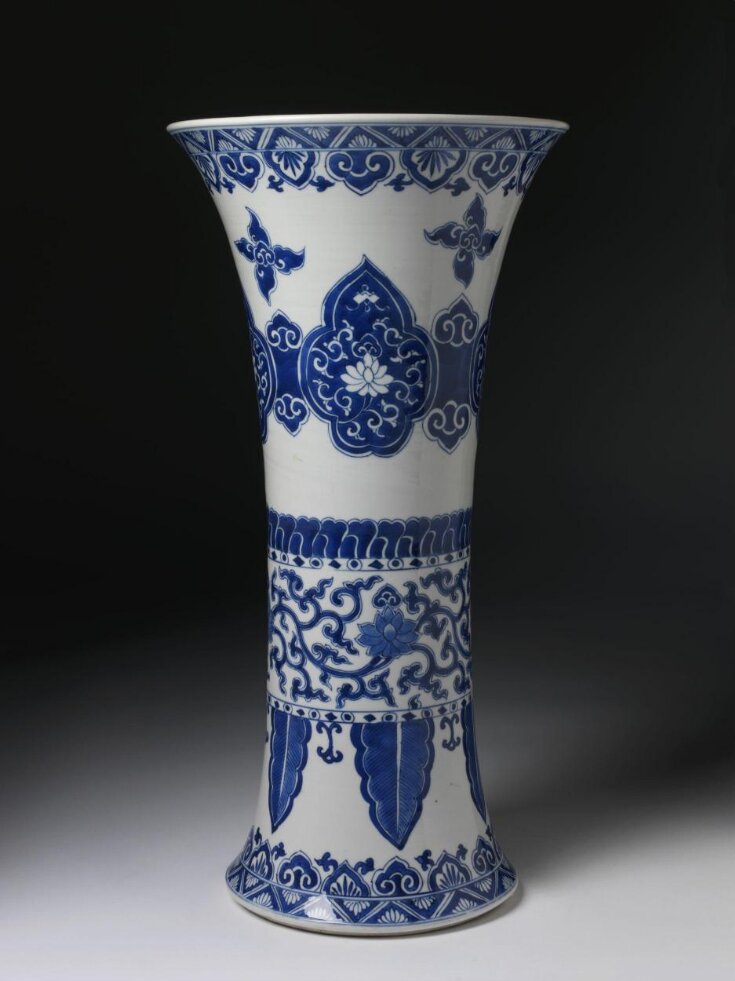
Unknown, Blue and white porcelain vase, 1700-1710, Victoria and Albert Museum London.
The style of blue-and-white porcelains represented the life of the easterners to Europeans. A great number of Chinese porcelains of this kind are recorded in the archives of Dutch East India Company.
On the one hand, few Chinese porcelains were exported to Europe with a higher price; on the other hand, the pure oriental shape made Chinese porcelains deviate from the daily needs of Europeans. For example, easterners’ habit of eating rice and using chopsticks makes bowls the most common utensils in the East, while westerners’ custom of eating bread and using knives and forks has not made bowls, with a deep-walled shape, the mainstream of European tableware by far. Because the typical Chinese tableware consists of fewer parts compared to Western dining habits, Chinese porcelain dishes could only be used for holding cakes and pastries in Europe. For example, porcelain pen containers were used as wine cooler, and porcelain fish tanks were used as flowerpots... Chinese porcelains were constrained in terms of use, and often modified or displayed as ornaments. Therefore, a new style came out in the course of development.
2. Hybrid styles. (Chinese traditional style couples with foreign ornaments and vise versa, or Eastern themes couple with Western ones for hybrid ornaments.)
It is the stage of free transformation of Chinese style porcelains. Among this type, porcelain with traditional Chinese themes, or a mixture of different themes from China and Europe, combined with European shapes is the most representative. Part of the changes in the shape of European porcelain came from metalware, and part from the changes in lifestyle brought about by trade. For example, since the 17th century, Europeans have been importing black tea and coffee from the East and chocolate from Mexico. These hot drinks come brown in color after brewing, and white Chinese porcelains serve as the most suitable drinking utensils. The emergence of new eating habits has promoted the transformation of Chinese porcelain utensils. The Dutch enlarged the size of traditional Chinese small teacups and designed a lug.[3] Kraak porcelain[4] and Mandarin style were the most representative.
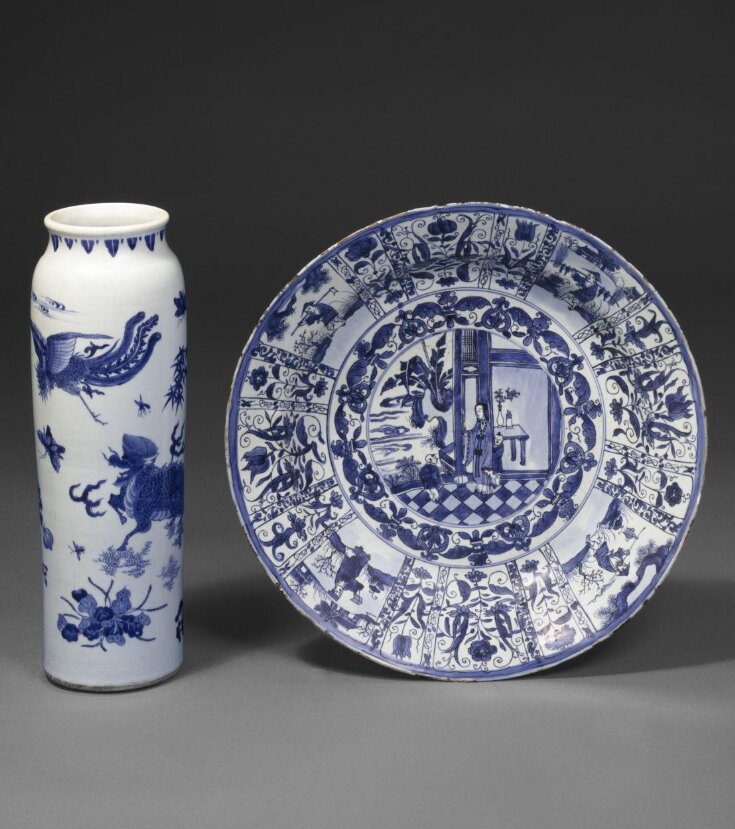
Unknown, Dish, ca. 1635-1655, Kraak Porcelain, Diameter: 47,5 cm, Bibliographic Reference: Clunas, Craig (ed.). Chinese Export Art and Design. London: Victoria and Albert Museum, 1987, p. 38, fig. 16.
Kraak porcelain is a form of blue and white porcelain exported from Wanli Period of Ming Dynasty (1573-1620) to early Qing Dynasty. It was mainly shaped in dishes, bottles and bowls, and represented by trimmed patterns. These patterns came round, diamond-shaped and lotus petal-shaped, with designs of flowers, birds, fish and insects, landscapes, figures and auspicious mascots commonly seen in Chinese porcelains. Later, exotic religious myths and social life themes appeared in trimmed patterns. In terms of techniques, the traditional way of drawing the outline of the pattern on the surface of the porcelain body with a writing brush and then filling it in with color was adopted. Kraak porcelain is a kind of export-purpose porcelain with the largest quantity and the longest influence period of more than 100 years. After that, blue and white porcelain in Kangxi Period (1662-1722) of Qing Dynasty came in western rendering techniques in drawing, showing a maximum of eight or nine color gradations on the porcelain body. And it drew much popularity among westerners.
The word “Mandarin” was a name for Chinese officials when Portuguese traded with Chinese merchants in the 17th century. In the 17th and 18th centuries, many missionaries and painters came to China and recorded their experiences there, including their life and work with Chinese officials in addition to preaching.
Most of the decorative patterns depicted the life of officials and wealthy merchants in Qing Dynasty, who enjoyed a rich and leisurely family life. These descriptions and landscape paintings further aroused European‘s curiosity about live in China. Aiming at this market opportunity, Guangzhou Porcelain Workshop launched Mandarin style products for European and American markets. Some patterns use the perspective technology of European oil paintings, and the expressions of the characters are vivid, which conforms to the aesthetic orientation of Europeans. These patterns presented a desirable pastoral oriental atmosphere for westerners. Playing in picturesque courtyard gardens, hunting in enchanting springtime, harmonious coexistence between human beings and nature, and vivid home life scenes embodied elegant Chinese costumes, fascinating home decoration, exquisite garden scenes, and charming family happiness. These themes greatly satisfied Europeans’ curiosity and yearning for the East.

Unknown, Three Vases, 1700-1720, Procelain, Jingdezhen, Staatliche Kunstsammlungen Dresden.
3. Foreign styles. (Chinese porcelains satisfying the requirements of European merchants in terms of shapes and patterns, calcined elaborately to serve European consumers’ needs. Most of the patterns were drawn in strict accordance with the prints and patterns as required by customers, so they were usually called custom-made porcelains.)
One type was produced in the 17th century. Since Europe had not yet mastered the technology of porcelain-making, Chinese porcelain workers imitated the pottery of European style according to the requirements of European merchants. Chinese Porcelain competed with European pottery in this way and earned a lot of silver used as currency.
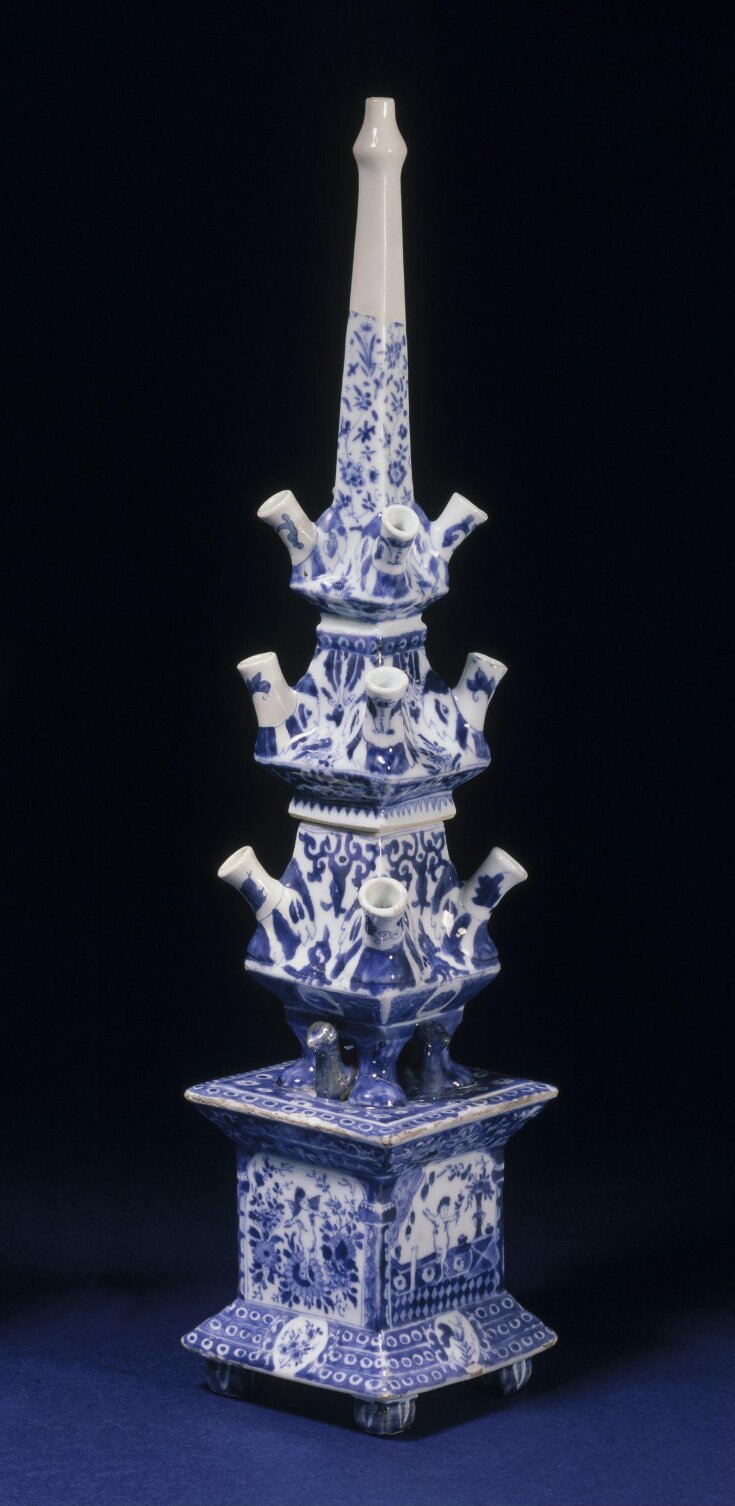
Unknown, Vase with Angel, 1700, Porcelain, H: 36cm, Victoria and Albert Museum London. Bibliographic Reference: Clunas, Craig (ed.). Chinese Export Art and Design. London: Victoria and Albert Museum, 1987, p. 60, fig. 40.
Another type emerged when the Chinese style in the West reached its peak in the 18th century and Chinese characters and landscapes imagined by Westerners appeared in the patterns. The pictures are humorous and interesting, while the number is quite limited. In addition, there were porcelain carvings, figures and animals.
The pattern was typically formed by heraldry (the special signs of European and American aristocratic guilds, groups, etc. In the 18th century, China sold up to 600,000 kinds of heraldry porcelain to Europe). In addition, characters (out of Greek or Roman fairy tales, the Bible, European customs-based sketches), ships, landscapes, flowers, etc. used to be popular themes among Europeans. Besides, European living habits were taken into consideration in terms of modeling.
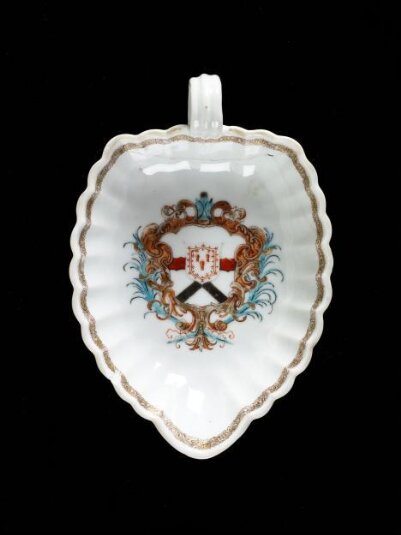
Unknown, Souceboat, ca. 1740, Porcelain, L: 18,4cm, Victoria and Albert Museum London. Bibliographic Reference: Howard, David Santuary. Chinese Armorial Porcelain. London: Faber and Faber Limited, 1974, p. 295.
Apart from blue and white, multicolored and famille rose ones were among this kind of style. Because of the higher cost, longer period of capital occupation, more complicated procedures and greater commercial risks, this variety did not turn a mainstream among export-purpose Chinese porcelains in spite of their distinctive features. Especially in 1769, the first production line of British Wedgwood Porcelain Plant rolled off, when European porcelain production began to leap from the handicraft era to the industrial era. Since then, importing Chinese porcelains has grown unprofitable, and the porcelains in Chinese style turned gradually out of date.
In the course of trade development for nearly 300 years from the 16th century to 19th century, from “Made in China” to “Making Chinese Porcelains”, the Chinese vogue going viral in Europe represented a process of Europeanization of Chinese cultural practices. In this process, lacquerware, woven carpets, clothing, furniture, wallpaper and garden architecture were as well used for reference, quotation and modification in Europe, and finally integrated into the social context of Europe, influencing and even changing the artistic outlook of Europe. Nowadays, the shortened distance and accessible information across the world enable us to see the diversity of cultures more quickly and accurately. More possibilities for cultural exchanges will definitely be springing up in the future.
FOOTNOTES
[1] China in the 13th-19th centuries was only a Far East country geographically along with India, Southeast Asia, South Korea and Japan
[2] Due to the limited space, the export-purpose Chinese porcelain in this paper refers specifically to the exported ones to Europe.
[3] Lin Lin's, Research on Porcelain Trade of Dutch East India Company in the 17th-18th Centuries, pp 31-34.
[4] Its name probably originated from Portugal Caraack, meaning “giant merchant ship”.
REFERENCES
- WangYong, A History of Art Exchange between China and Abroad, Beijing, 2013
- Shanggang, A new compilation of the history of Chinese arts and crafts, Higher Education Press , 2007
- Etiemble, L’Europe Chinoise. The Commercial Press, Beijing, 2013
- Liwei, Through the silk Road, Beijing, 2018
- Hugh Honour,Chinoiserie: The vision of Cathay, Peking University Press, 2017
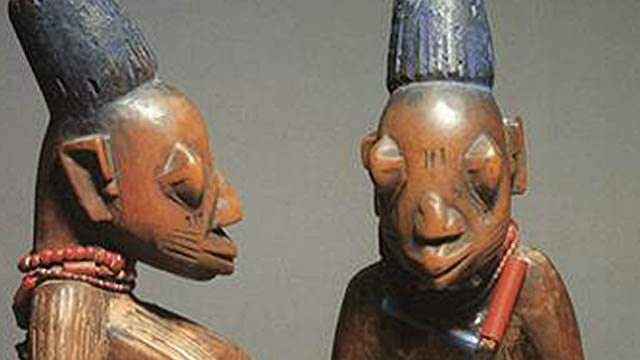
-
 Ebenezer Kwabena Acquah
Ebenezer Kwabena AcquahHistorical link between the Ga and the Yoruba
It is believed that the Ga-Adangbe came from Ile Ife at Yorubaland in Nigeria through Seme, a settlement on the border between Nigeria and Republic of Benin of today. According to popular oral traditions, the groups migrated together crossing the Mono River but scattered after crossing the Volta River (Nortey, 2012). They settled on the Accra plains within the south eastern corner of Ghana (Kilson, 1974). Their initial administrative capital was Ayawaso but was later moved to Accra, as Ghana gained its independence in 1957 and Accra became the capital city of Ghana.
Indigenous belief system among the Ga and Yoruba
The Ga, like other ethnic groups in Ghana and Nigeria, believe in life after death. They demonstrate this belief through comprehensive funeral rites. The type of occupation the deceased engaged in on earth while alive is believed to continue in the next world and as such a coffin is carved to depict the work of the deceased for their burial. The Ga, just like the Yoruba people, belong to Islam, to Christian faith or to traditional religious beliefs (Leroy, Olaleye-Oruene, Koeppen-Schomerus, & Byrant, 2002). They believe in the immortality of the soul and on its re-birth, which are both essential to the Ibeji twin belief.
The Ibeji sculptural figures in perspective and their aesthetic considerations
The Ibeji figures among the Yoruba provide an insight into the recognition of twins within the Yoruba society. The visual sculptural form presents the viewer with a glimpse of what the Yoruba society cherishes through the lens of visual culture. The two figures are presented in semi-abstract forms showing a male and a female (based on genital characteristics). It also shows the relevance of beads in body adornment as found in their usage in the form of necklace, wrist-bands, and waist-bands. On the heads of the figures are scarifications (marks on the body) and both figures are holding a string of cowries.
Cowries were extensively used during pre-colonial times in Africa as symbol of wealth and used as currency and medium of exchange, for symbolic messages, as objects of divination, as jewelry and as a religious accessory, as well as a powerful force that represents the eye of the gods and the womb of the goddess (Yiridoe, 1995; Wayne, 2010; Odunbaku, 2012). Also, the projection of the breasts of one figure is an indication of a female with youthful exuberance.
The pronounced shapes in the figures are curves with minor angular forms in feet and ears. Both figures also show projecting and rounded forehead which are basic characteristics of many African figures. The head-gear is cylindrical and this is similar to that of the Dipo initiates among the Krobo of Ghana who are related to the Dangme.
Though the basics of African aesthetic differ across cultures, the common ones would include symbolism, togetherness, luminosity, craftsmanship, self-composure, and youthfulness (Molokwane, 2010; Vogel 1986). In the Ibeji figures, it is envisaged that a culture of teamwork was involved in the production process, from the felling of the tree through carving to the finishing of the statuettes, building a sense of communal unity. The craftsmen usually work with a master-craftsman. In terms of craftsmanship, the figures are sculpted intricately, with exquisite details, body adornment, and to excellent finish that has made them stand the test of time.
Symbolism is embedded into traditionally African made objects and the Ibeji figures are no exception. They have elegant glossy finishes that portray purity and well-being/good health. The author considers the statuettes (reference to the Ibeji figures) as being young: vibrant, healthy, and a source of strength.
Recognition of twins in Yoruba and Ga societies
In many traditional African societies, twins are considered of supernatural origin and raised emotional reactions ranging from fear and dislike to hope and joy (Leroy, 1995). It is believed that twins are able to grant happiness, health and prosperity upon their family. As such, their nurture is far more venerated than that of other children (Stoll & Stoll, 1980).
Another similarity in terms of belief and practice between the Ga and the Yoruba is that twins share the same combined soul, and it is envisaged that when a new-born twin dies, the life of the other is exposed because the balance of his soul has become disturbed. To forestall any danger, a special ritual is carried out. Though the Yoruba carve a small wooden figure as a symbolic substitute for the soul of the deceased twin, the Ga only perform the ritual. If both twins have died, two of these figures are made among the Yoruba. These statuettes are called Ere ibeji (from ‘ibi’, meaning born and ‘eji’, two; ere means sacred image).
The Ga believe that the twins are special messengers from the Supreme god and therefore highly revered. They also believe that they could bring either a good or bad omen to the society based on the way they are treated. The Yam Festival which falls on the Friday of the Ga Homowo festival celebrated in August, presents a special occasion for twins in the Ga community who are presented with special feast in a form of sumptuous meal and mashed yam with eggs. It is honouring the twins in the traditional families (Nortey, 2012).
During the Homowo festival celebration on Friday, twins carry herbal mixture (leafy concoction) called “baa woo” that is prepared in metal containers and they move through the township in a frenzied manner amid singing and chants. The special concussion is believed to induce fertility and as such people bath themselves with it with the hope of bearing twins.
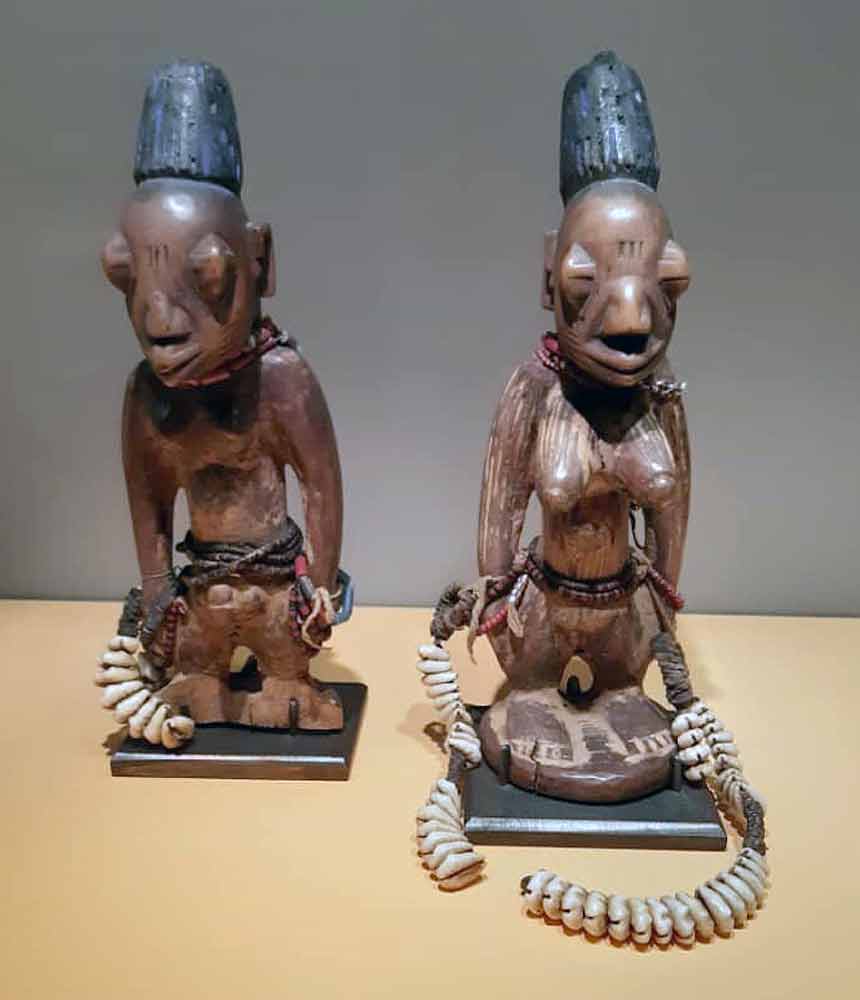
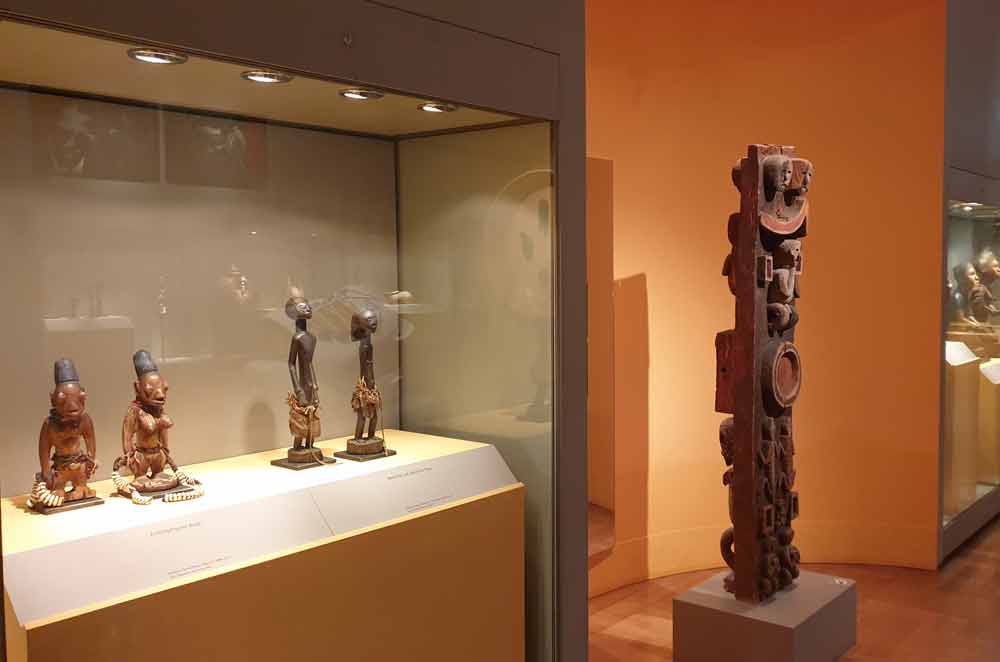
Unknown artist. Ibeji Twin Figures of the Yoruba. Presentation in the museum. First half of the 20th century. Wood, red chalk, cowries, glass. Height 27,5 cm. Museum Fünf Kontinente, Munich. © Museum Fünf Kontinente
Conclusion
The belief in reincarnation and life after death are linked to the Ga and Yoruba ancestor belief. As part of the veneration of twin in families, the Yoruba carve Ibeji figures that has symbolic and spiritual relevance among the people. Among the Ga and the Yoruba, twins are revered and honoured. Furthermore, the two societies believe that every human soul has a chance to return to earth as a new-born, mostly within the same family. The wellbeing of any family is dependent on that of its ancestors and twins. Therefore, periodic prayers/rites are said and sacrificial gifts are presented to ancestral deities, including the Ibeji figures.
References
- Kilson, M. (1974). African Urban Kinsmen, The Ga of Central Accra. London: C. Hurst and Co. Ltd.
- Leroy, F. (1995). Les jumeaux dans tous leurs états. Louvain –la - Neuve [Twins in every state], Belgium: DeboeckUniversité.
- Leroy, F., Olaleye-Oruene, T., Koeppen-Schomerus, G., & Bryan, E. (2002). Yoruba Customs and Beliefs Pertaining to Twins. Twin Research, 5(2),132-136
- Molokwane, S., & Shorn, B. (2002). The African aesthetic as it informs the product form. In:Computer-Based Design. Proceedings of the Engineering Design Conference, King’s College, London, 9 -11 July 2002.
- Nortey, S. (2012). Artistic Evolutions of the Ga Mashie Twins Yam Festival and Its Cultural Implications. Arts and Design Studies, Vol. 2, 2012.
- Odunbaku, B. J. (2012). Importance of Cowrie Shells in Pre-Colonial Yoruba land SouthWestern Nigeria : Orile- Keesi as a Case Study. International Journal of Humanities and Social Science, 2(18), 234-241.
- Vogel, S. M. (1986). African Aesthetics. New York: Center for African Art.
- Yiridoe, E. (1995). Economic and Sociocultural Aspects of Cowrie Currency of the Dagaaba of Northwestern Ghana Aspects. Nordic Journal of African Studies, 4(2), 17-32.
This article is part of a gallery: Perspectives from Ghana on Museum Objects in Germany
Published January 2021
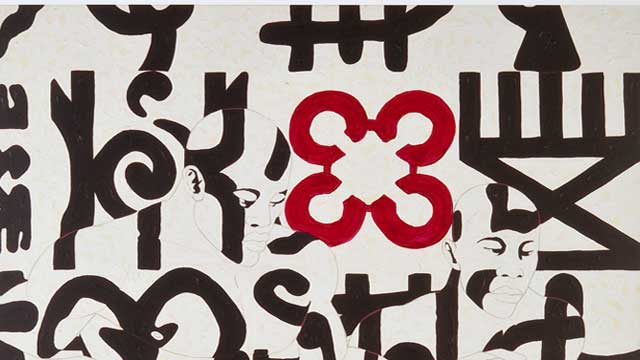
-
 Stefan Eisenhofer
Stefan EisenhoferOwusu-Ankomah received his basic training at Ghanatta College of Art in Accra. He was thirty years old when he moved to Bremen in Germany, where he still lives and works today. Characteristic of Owusu-Ankomah is his devotion to painting. For him the act of painting is a kind of highly concentrated ritual in which the medial properties of his body are used as memory store and energy-field generator, rather in the manner of an action artist.
In the course of his life, Owusu-Ankomah's artistic work has passed through several distinct phases. From an iconographic point of view, his early work is strongly influenced by mask and rock painting traditions from all over the African continent. But it was not long before human bodies, especially his own, became the dominant subject of his work. Naked bodies in his paintings, represented in idealized and naturalistic perfection, demonstrate a shameless and very close physicalness and often seem to radiate superhuman energy. Owusu-Ankomah plays here with the beauty of the human male body and with the harmony of flowing, clear lines. These works also evoke a range of ideas inspired by the human body – the body as instrument of the soul and instrument of communication, as a universal symbol and point of intersection between the physical and the metaphysical, and as a means by which the individual constructs himself, presents himself to others, and negotiates the conditions of his belonging to the world.
In his recent works up to 2008, the figures are covered with markings and signs. They originate from a variety of sources: the artist has combined traditional West African symbols, such as adinkra cloth signs, with symbols from China, America and Oceania, well-known popular logos, and symbols of his own invention. The figures melt into the backgound which consists of the same symbols, and thus become almost invisible.
With these symbols and human figures that compete for space on the canvas and for the attention of the viewer, Owusu-Ankomah has created some highly dynamic and truly pulsating compositions. The works also raise questions concerning self-determination and heteronomy, the tension between the wisdom of collective worldviews and individual creativity, and the personal potential of the individual. This is particularly striking in works showing the Sankofa bird. This mythical bird is well known in large parts of West Africa and embodies the concept of "flying forward while looking back". It symbolizes the idea that one should remember the past in order to shape one's life positively in the present and the future. With its name meaning "go back and pick", the bird also stands for one of Owusu-Ankomah's guiding principles: to look for useful traditions in all parts of the world. Accordingly, Owusu-Ankomah borrows a great variety of elements from very different cultures and periods in his works. He is influenced by adinkra symbols, together with their worldviews and philosophies, but also by Michelangelo, video games and designs by popular contemporary graphic artists. In his ambition to unite elements from very different regions in one great human universal, his works become something that overcomes the borders separating individual cultures. In his search for an existential utopia, he creates a symbiosis out of these heterogeneous elements in fantastic and futuristic spaces. Thus he aims at a common "world consciousness" and global visions of the establishment of universally longed-for values, such as harmony, solidarity and non-violence.
An interpretation of an early work by the artist from 1975, "Deer Hunt", can be found under the following link.

